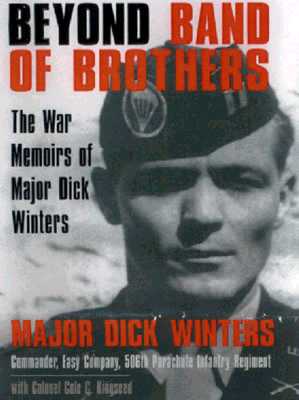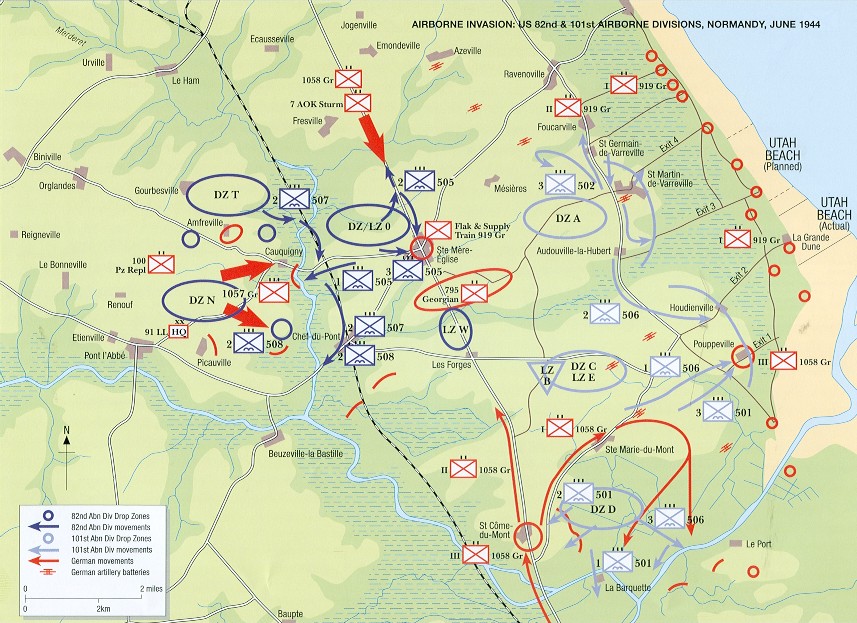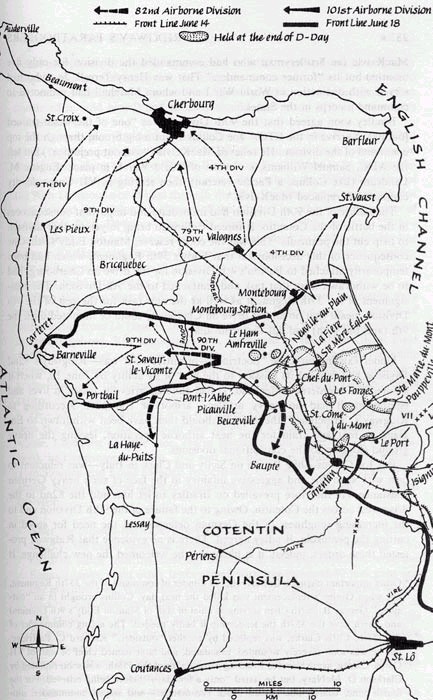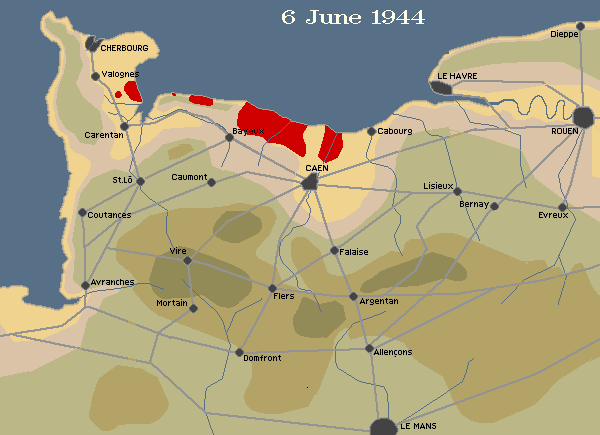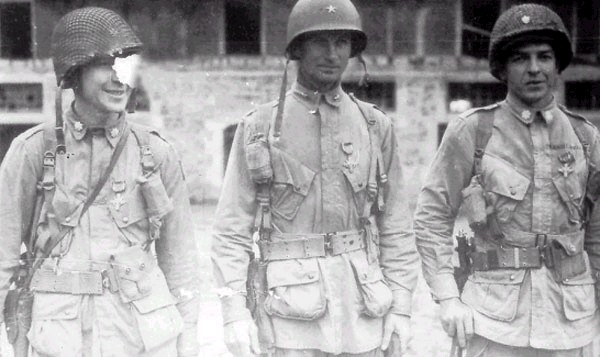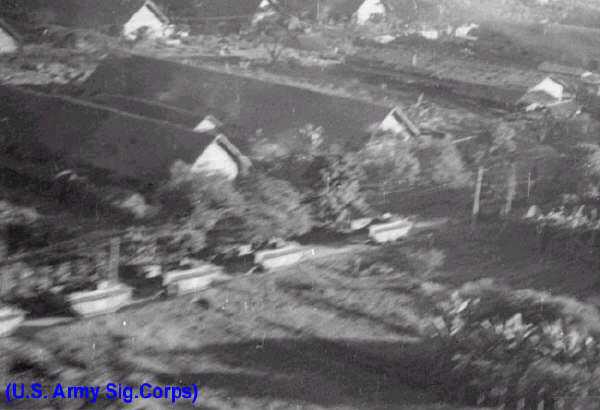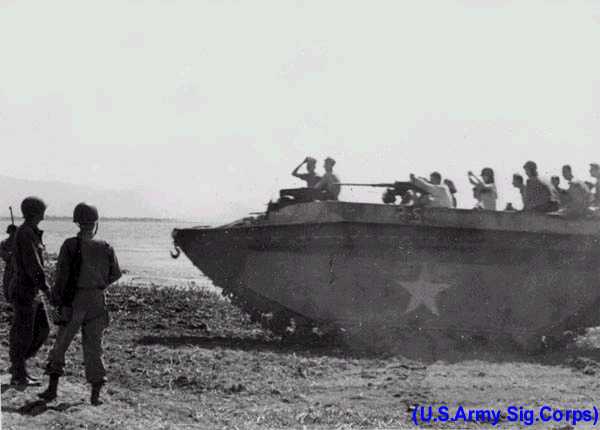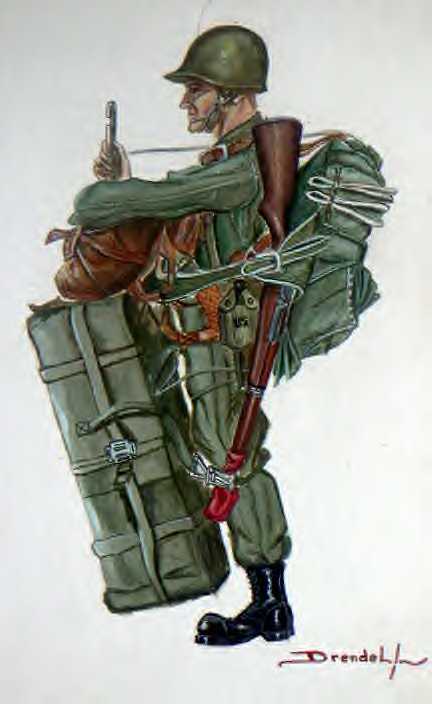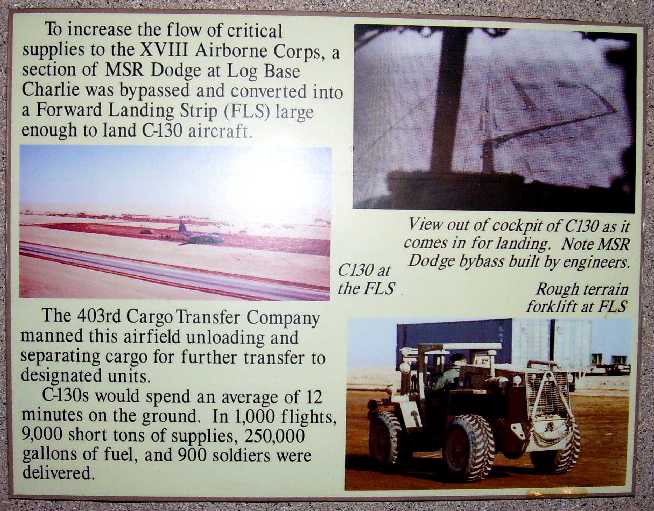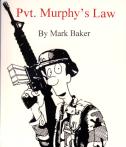
GAVIN'S PARATROOPERS : THE TYPE OF MEN
UPDATED 1 August 2012
Actual Video clip of U.S. Army Paratroopers exiting a C-141B Starlifter
Actual Video clip of a C-130 Hercules combat equipment jump
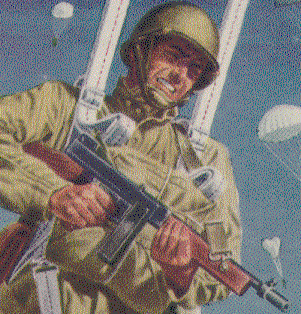
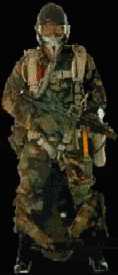
 youtube.com/watch?v=1nk5doxubyg
youtube.com/watch?v=1nk5doxubyg
THE RULE OF LGOPs
(LGOP = Little Groups of Paratroopers)
After the demise of the best Airborne plan, a most terrifying effect occurs on the battlefield. This effect is known as the rule of the LGOPs. This is, in its purest form, small groups of pissed-off 19-year-old American Paratroopers. They are well-trained, armed-to-the-teeth and lack serious adult supervision. They collectively remember the Commander's intent as "March to the sound of the guns and kill anyone who is not dressed like you..."
...or something like that. Happily they go about the day's work........
"Show me a man who will jump out of an airplane, and I'll show you a man who'll fight."--General James M. Gavin
"American Parachutists...devils in baggy pants...are less than 100 meters from my outpost line. I can't sleep at night; they pop up from nowhere and we never know when or how they will strike next. Seems like the black-hearted devils are everywhere..."
(An entry in a German officer's diary found after the Battle of Anzio)
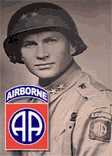
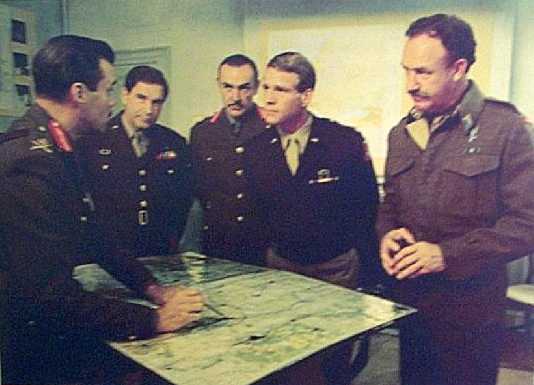
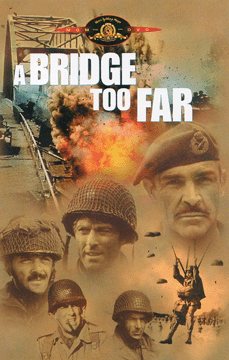
Movie Trailer
 youtube.com/watch?v=DKDPX8PEiVk
youtube.com/watch?v=DKDPX8PEiVk
NEW!
"Individuals had to be capable of fighting at once against any opposition they met on landing. Although every effort was being made to develop the communications and techniques to permit battalions, companies, and platoons to organize promptly, we had to train our individuals to fight for hours and days, if necessary, without being part of a formal organization. Equipment had to be lightweight and readily transportable....Since the beginning of recorded history, Soldiers have been drilled repetively to de-emphasize their individual behavioral traits and force them to adapt to larger combat formations. Perhaps the greatest efficiency in transforming each individual, squad, platoon, and so forth into a cog in a larger machine was demonstrated in the armies of Frederick the Great, and although machine weapons had changed all this, between World War I and World War II countless hours were spent on wheeling about and moving squads to the right and to the left, as though they were preparing to fight the wars of a century ago.All this had to be discarded as we sought to train the Paratroopers to the highest peak of individual pride and skill. It was at this time that the use of nameplates was adopted, the purpose being to emphasize the importance of an individual's personality and reputation. To the Soldiers of another generation, it seemed to suggest too little discipline and too much initiative given to individual Soldiers. We were willing to take a chance that this would not have a disrupting effect on larger formations. It did not, and there were many occasions in combat when the Paratroop officers, and NCOs effectively took over the command of larger formations of other units. Aside from the impact of this type of training on the Airborne formations themselves, it had a tremendous significance to the Army as a whole. The morale of the Airborne units soared, especially after their first combat, when they could see for themselves the results of their training".
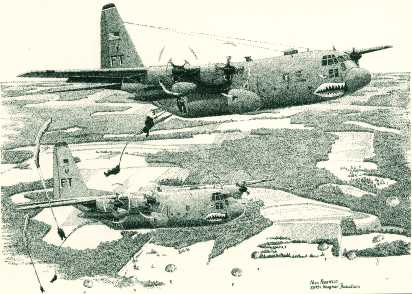
Are you of the "another generation" ilk? Wedded to obsolete traditions? Who says we have to use silly, useless D & C to instill fighting discipline in Soldiers? Why not in the field like Gavin did? Learning SERE skills? The usmc didn't even put nametapes on its individual member BDUs (camies) until after the Gulf War TV coverage embarrassed them into it. How about this for 19th century robotics?
Think about it.
"Zero defects" mentalities do not inspire the men to give their best, we must create an atmosphere where subordinates can use their personality and initiative to get the mission done. Mission-type orders not robotics. To win on the future, non-linear urbanized battlefield, where we had only just arrived within hours by AIR will require the Soldiership like that of Chamberlain and his men on Little Round top. These men must be able to communicate freely and truthfully without concern over their ego, peer status or career concerns.
"The Mongols, a classic example of an ancient force that fought according to cyberwar principles, were organized more like a network than a hierarchy. More recently, a relatively minor military power that defeated a great modern power--the combined forces of North Vietnam and the Viet Cong--operated in many respects more like a network than an institution; it even extended political- support networks abroad. In both cases, the Mongols and the Vietnamese, their defeated opponents were large institutions whose forces were designed to fight set-piece attritional battles.
To this may be added a further set of observations drawn from current events. Most adversaries that the United States and its allies face in the realm of low-intensity conflict, such as international terrorists, guerrilla insurgents, drug smuggling cartels, ethnic factions, as well as racial and tribal gangs, are all organized like networks (although their leadership may be quite hierarchical). Perhaps a reason that military (and police) institutions have difficulty engaging in low-intensity conflicts is because they are not meant to be fought by institutions. The lesson: Institutions can be defeated by networks, and it may take networks to counter networks. The future may belong to whoever masters the network form."
"Cyberwar is coming" (Scroll down to Selection 3) by John Arquilla and David Ronfeldt International Policy Department RAND
[Editor's note: These guys are right on target at the source of our temporary foreign policy "loss" in Vietnam 1975-1991(?). However, war is not just a lethal sporting contest among combatants, its about whose IDEAS will dominate, in the case of FREEDOM, in the end the truth has won out over communism. However, if the forces of freedom were more open-minded and "networked" like the John Paul Vann did until he died stopping the 1972 NVA invasion or the enemy in general did, we could have won the struggle sooner on the battlefield and not just wait for cultural changes to do it for us. The men who fought in Vietnam need to know that their sacrifices did count-just ask the people of Thailand. But if we are to learn from our war there, we must not make excuses that the politicians "did this or that" when there is plenty to do at our own level within the military to network and "out guerrilla the guerilla".]
A noted Army writer and tactician responds:
"Mike:Nationally syndicated columnist and decorated Army officer, retired Colonel David Hackworth writes:
It's interesting that the two great Army developments of WWII were Armored warfare and Airborne warfare. (We'll leave aside marines and SOF for the moment.) A field-trained individual who can play LGOP really works well.I sure do agree that all of that D & C and similar obsolete stuff serves little purpose. Guess it makes someone feel good..."
"Gavin was such a good Soldier. Thx Mike."
An Army weapons analyst and Lieutenant Colonel writes:
Later,"Most of the Airborne troops were very well trained infantry, first. They already went through the "depersonalizing and rebuilding" process so that they would be competent 'cogs of the machine.' Then, and only then, were they given special training to bring them to a higher level.
On another level, the Airborne WANTED to mirror a straight infantry division, with infantry regiments, divisional artillery, etc., etc. Their challenge was not only the lack of adequate communication, but the technical inability to to be consistently dropped in a cohesive formation at a specified drop zone. In practice, they were scattered and lost all over the battlefield and fought in little groupings of individuals and squads that wandered about until blundering and melding into ad hoc platoons and companies. Fortunately, such confused wandering also wreaked confusion upon the enemy, with reports and sightings coming in from EVERYWHERE!! This alone tied down considerable enemy forces, in addition to the troopers' sniping, ambushing, and other interdictions. Then, once the ground effort (which the Airborne drop was supporting) broke through for a linkup, all was forgotten in the glow of a successful operation (the ground effort)".
http://imabbs.army.mil/cmh-pg/104-13.htm
Airborne operations
army.mil/cmh-pg/documents/abnops/tabb.htm
North Africa, Sicily, Normandy, and Eindhoven and Nijmegen
pim.nl/mg/pega1.htm
reocities.com/CapeCanaveral/Hangar/4602/kreta.htm
Crete
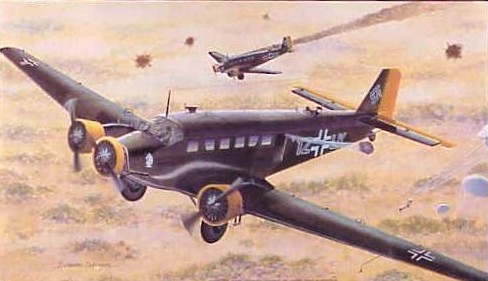
With today's technology jump delivery is very precise and Drop Zone selection can be done instantly from space and the air recon means. Crete was a costly victory for the Germans because of the "Ultra Secret" (German codes broken to reveal all classified messages) told the Allies exactly where their DZ and drop times were....yet the Allies were still pushed to the sea. It was still a victory and proof deep Airborne operations can work in spite of no amphibious forces around to help. If you click on the hypelink above or here on Crete, you'll see the Royal Navy sank the amphibious forces that the Allied Commander defending the island thought were necessary to win. He was wrong. Years later, on Grenada the same thing happened, the enemy expected sea attack from marines, but instead, the Rangers and 82nd Airborne came from long away and caught them by surprise. The invasion of Panama was a "deep" Airborne operation that worked as was The Russian seizure of Afghanistan and Czechoslovakia, though in the latter, ground forces were en route for link-up.
Had the British jumped south of Arnhem bridge, instead of 8 miles away at a 1 mph foot-slog, the entire battle would have been an undeniable Allied "deep" Airborne victory. Dien Bien Phu was a poorly selected firebase in the low ground, many other poorly defended positions have been over-ran that were established by ground and sea transport, also. In the Second Indo-China war, the U.S. set up better defended fire bases that were kept going by airdrop, most notably Khe Sanh. Deep airdrops of combat power can work, its what you do afterwards on the ground that is the key. If you sit still, the enemy is likely to gain the initiative whether you walked, flew or motored there. After the Paratrooper lands he must be MORE MOBILE than any enemy and that can be done by speed-marching, solving the Soldier's load, human powered vehicles and airdropped armor.
We are pushing hard for light Armored Fighting Vehicles (AFV aka TANKS) like the M113A3 Gavin and the M8 Ridgway Armored Gun System to be organic to the Airborne so it can fight actions like a Bostogne successfully and not end up like a 1943 "Cisterna" or 1993 "Somalia".
Good point about WWI: the U.S. Army Air Service was doing "Close Air Support" (CAS) to sweep the enemy during the 1918 offensives under the leadership of General Billy Mitchell personally directing the battles from SPAD XVI aircraft long before the usmc boasted "it invented CAS in the 1920s". By the end of the war, we were combining arms as we would have to do again in WWII.
"On the next day, before dawn, Pershing's main attack hit the Germans along the southern edge of the Saint-Mihiel salient while French Colonial troops under his command and the United States 4th Division pushed eastward from the salient's western edge. Overhead, our planes gave close air support and bombed and strafed supply installations and troop columns in the rear of the German lines. French tanks manned by Americans supported the infantry assaults. The United States Army's first modern battle had begun."Fighting Generals by Curt Anders, 1965, G.P. Putnam & Sons, NY
"Mike-
Interesting site. Thanks for showing me. Please keep me in mind for future areas of similar style. Although why anyone would want to jump out of a functional aircraft is still a mystery to me-"
XXXX XXXX
(Stillborne!)
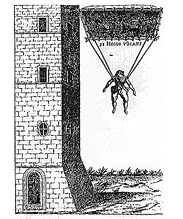
God's design of the creation could easily be studied to find the principle of air resistance in action to gently descend from the air to the ground: leaves falling from a tree are a good example. It is believed that Chinese acrobats used parachute-like devices as long ago as 1306. The principle was recognized by several writers, and Leonardo da Vinci proposed the basic idea for parachutes in 1495. Leonardo da Vinci sketched a man-sized parachute with a man in mind to be lowered by it, even though no one had ever flown. He visualized it as a tool to escape from tall buildings and structures in event of fire. The dimensions he calculated as necessary to safely land a person 300 years before one was ever used are very close to the ones used today.
The first person to demonstrate the parachute in action was Louis-Sébastien Lenormand of France--in 1783 he jumped from a tower with two parasols. A few years later other French aeronauts jumped from balloons. André-Jacques Garnerin was the first to use a parachute regularly. He made a number of exhibition jumps, including one of about 8,000 feet (2,400 meters) in England in 1802.
In 1785, a French balloonist named Pierre Blanchard used a pet dog for his first idea of a parachute and dropped the dog several hundred feet, the dog ran off with the parachute and was never seen again.
In the 1800s, acrobats were dropping from balloons that resembled a parachute and a trapeze, they did this to liven up their act, because balloons got boring after awhile and they needed something else to keep the crowds interest, people watched mostly hoping to see a fatality.
The parachutes were rigid with stiffening rods to maintain there shape and tied to the bottom of the balloons, when it came time to jump a helper would cut the rope and they would ascend in their particular contraption.
It was an era of do it yourself designs some worked and some didn't. The ones that didn't were the unlucky ones (this could be considered an understatement).
One of the first parachutes was invented in 1837 by a man named Robert Cocking. Cocking developed a parachute like an upside umbrella, he felt being upside down it would control oscillations ( to bad he didn't know about an apex hole) He demonstrated in 1837 in England suspended from a balloon named Nassau, and piloted by Charles Green, who cut him loose.
The canopy was covered with linen and used stiffeners made of thin metal tubes to retain it's shape, the only trouble was it weighed 223 pounds . It worked fine at first, but the stiffening tubes started to give way , then a hole developed in the canopy, then it collapsed (it was the first parachute fatality).
After that England's interest in parachutes declined, but continued in America and Europe.
In 1884 the Baldwin Brothers developed a parachute similar to the one used today, it had no stiffeners, just a fabric canopy that was folded and stuffed into a soft container. The canopy was not attached to to the jumpers but to the balloons rigging and a harness was worn by the jumpers and attached to the chute, it was several years in development before they had a full size model and was first tested from 3000 ft, instead of being guinea pigs they used sand bags instead for the first drop, the parachute worked perfectly and they considered it a success.
They decided to demonstrate it publicly, and sold tickets for the event at Golden Gate Park in San Francisco, California on January 30, 1887. Thomas Baldwin the younger brother got elected for the task, the brothers took the balloon to 5,000 ft. before a sellout crowd.
Tom jumped and the chute worked perfectly opened within five seconds and he drifted slowly to the ground, and landed safely.
This do-it-yourself design also applied to airplanes with a lot of fatal results.
The Wright brothers finally got one to fly and it has been the "skies the limit" (Pilot, Engine, Airframe--PEA) every since, until the planes crash.
Now the interest in (and need for) parachutes really "took off".
Early parachutes were made of canvas, and later of silk. The first successful descent from an airplane was made by Capt. Albert Berry of the United States Army in 1912. In World War I, parachutes were used by observers to escape from captive balloons but were considered impractical for airplanes. Only in the last stage of the war were they finally used in aircraft.
In April 1914 Charles Broadwick invented the back pack container, his design resembled a sleeveless coat, the canopy and suspension lines were stowed on the back, the apex was attached to a static line on the back with a breakaway tie and a static line that could be hooked anywhere available, it similar to the design used today.
He demonstrated it to the army just a few months before WW 1, with his adopted daughter Tiny, then twenty years old. She had been jumping since she was fifteen years old.
She jumped from a Curtis biplane and used the risers to steer to a perfect landing. After that jump she was never seen again.
This amazed the General and his staff. The Generals report to the Army was great, but they ignored it, and later American pilots flew into combat without parachutes because the Generals thought they would abandon their planes at the very slightest chance of trouble, hence no parachutes.
During the war only Germans provided parachutes for their pilots, it was a canopy and suspension lines stored in a container. When it came time to depart the aircraft, they lifted the container from under the seat, stood on the seat and tossed the container over the side, then followed it, a little crude but it worked and all the other pilots envied them, especially since they had to ride theirs down in flames.
From the book, Into The Valley, by Col. Charles H. Young:
1918: Isolated French raids in WW I during which two-man demolition teams parachuted behind German lines to destroy communications.
1918, July-October: Small-scale Allied airborne resupply during the Mihiel and Meuse-Argonne campaigns.
Colonel Billy Mitchell attempted to get parachutes for his aviators, without success, but the Army did conduct some tests, and they were still testing when the war ended in 1918. But Colonel Mitchell thought of others ways to use parachutes. To him goes the distinction of suggesting the first Airborne parachute assault forces.
The idea of parachutes for military personnel to employ for 3D maneuver was first suggested by the late Colonel William (Billy) Mitchell, U.S. Army Air Corps during WWI even before they had chutes for American flyers!
His idea was to assign infantrymen to the Air Force and to jump them behind the enemy to cut them off and use the air force to protect them, but his idea was not used.
This is a letter I found in a book written by Colonel Billy Mitchell about his meeting with Gen. Pershing:
"I proposed to him that in the spring of 1919, when I would have a great force of bombardment planes, he should assign one of the infantry divisions permanently to the Air Force, preferably the 1st division; that we would arm the men with a great number of machine guns and train them to go over the front in our large airplanes, which would carry ten or fifteen Soldiers. We could equip each man with a parachute, so when we desired to make a rear attack on the enemy, we could carry these men over the lines and drop them off at a prearranged strong point, fortify it, and we could supply them by aircraft with food and ammunition. Our low flying attack aviation would then cover every road in the vicinity, both day and night, so as to prevent the Germans falling on them before they could thoroughly organize the position. Then we could attack the Germans from the rear, aided by an attack from our Army from the front, and support the maneuver with our great Air Force."
The war ended twenty five days after the meeting. The idea came from the mind of a visionary who wouldn't live to see his ideas come into being. But he was proven right.
Recent reports indicate the ITALIANS actually dropped Paratroopers in WWI! The first use of Paratroops goes back to WWI when Italian officers landed behind Austrian lines for reconnaissance.
Colonel Young continues:
1928: Italian pilots dropped supplies by parachute to the dirigible Italia, stranded at the North Pole.
1929-30: Italian paratroopers made mass jumps in North Africa.
1931: The U.S. Army Air Corps flew a field artillery battery complete with equipment to Panama as a demonstration of "hemispheric defense." Two years later, in keeping with U.S. tacticians' preference for airlanding rather than parachute delivery during this period, the maneuver was repeated in Panama, but with a full battalion. Then, in maneuvers near Fort DuPont, Delaware, AAC Capt. George C. Kenney "astounded his colleagues" by airlanding an infantry detachment behind "enemy" lines.
 youtube.com/watch?v=yPv8Bm-aE9o
youtube.com/watch?v=yPv8Bm-aE9o
1933, 18 August: Soviet demonstration, Moscow; 46 paratroops jumped from two large bombers, and also dropped a small combat tank by parachute.
1935, 1 March: During Soviet airborne maneuvers at Kiev, two battalions of infantry were dropped; three 18-passenger gliders were also landed on these maneuvers. Gliders had been towed 1,170 miles-in triple-tow. All pilots involved were women.
1936, September-October: Soviet mass drop of 1,200 paratroops at Minsk, while 5,200 paratroops jumped in maneuvers at Moscow.
1938, 7 October: Germans airlanded a complete infantry regiment of 2,800 men in a wheat field near Freiwaldau, Silesia.
The American Army didn't completely abandon development of the parachute, and in 1919 a board was established at McCook Field to determine which type of parachute was suitable for American aviators. The board was headed by Maj. E.L. Huffman, who sent letters to known jumpers in the country to demonstrate equipment and techniques that might be purchased by the government.
One of the respondents was a circus performer known as "Sky High" Irvin, who had been jumping since the age of sixteen and had logged numerous jumps over the years. He presented the first free-fall parachute, a concept that required the jumper to manually release the canopy with a rip cord instead of a static line. The Irvin model used a harness instead of a coat. The canopy was thirty two feet in diameter, with twenty four suspension lines. Instead of being extracted by a static line, the canopy was deployed by a pilot chute that sprang from the container when the jumper pulled the rip cord.
Until this time, it was believed that free falls couldn't be tolerated by human beings, who would either be immobilized by the force of the airflow or by fear of the situation. Irvan proved them wrong by making a delayed-opening jump from 1,500 feet, which convinced the board to sign a contract with him for 300 parachutes. By 1922 a parachute was a required part of the uniform of the military and airmail pilots, and the design remained unchanged for the next fifty years.
The first nation to form a real Paratroop unit was Italy, which makes sense if they had dropped Paratroopers in WWI. The Initial collective drop was made at Cinisello Balsamo, near Milan, on 6 November 1927 from CA-73 troop carriers of the Regfa Aerornautica. The Italians used the Salvator static-line parachute and used no reserve, a policy decision that must have seemed mistaken to the unit's General Gutdoni as he fell to his death a year later, his Salvator streaming above htm m the dreaded "Roman candle" In the late 1930s, the Italians raised complete parachute battalions, and these later expanded into the Folgore and Nembo Divsions, destined to fight with distinction--but never to partake in full-scale Airborne operations during WWII.
During the 1930s the Russians and Germans started using Airborne troops. The Russians even had bombers and gliders to deliver tanks and "people pods" on the wings of early aircraft to deliver Airborne troops.
The Russians formed Airborne units in 1935 and the Germans in 1937. The French also started in 1937, however the French were defeated before they could use them.
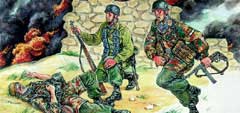
VIDEO: Paratroops in WW2 Europe & North Africa
Paratroopers
Part 1: German Airborne successes in Norway, Holland, Belgium
 youtube.com/watch?v=Rrg4pCZAfu4
youtube.com/watch?v=Rrg4pCZAfu4
Part 2: British Paratroops created by Churchill, Corinth canal attack by German Paras
 youtube.com/watch?v=6z_C4Wiypgc
youtube.com/watch?v=6z_C4Wiypgc
Part 3: Germans attack Crete continued, American and British Airbornes drop on North Africa and Sicily
 youtube.com/watch?v=3Bl_bVQ5bjk
youtube.com/watch?v=3Bl_bVQ5bjk
Part 4: Russian Airborne used extensively, Italian fighting German Paras bitterly resist allies, American Airborne saves beach head at Salerno
 youtube.com/watch?v=oqCd4r1apXk
youtube.com/watch?v=oqCd4r1apXk
Part 5: Monte Cassino, D-Day, wrongly implies heavy equipment did not arrive when most did by glider including Tetrarch light tanks and Bren gun APCs
 youtube.com/watch?v=xxvT0cF0OXk
youtube.com/watch?v=xxvT0cF0OXk
Part 6: Arnhem bridge operation, incorrectly states "armored" jeeps were lost, Battle of the Bulge
 youtube.com/watch?v=j7hxl2ur3kY
youtube.com/watch?v=j7hxl2ur3kY
Part 7 Battle of the Bulge, Operation VARSITY
 youtube.com/watch?v=PlJ4HztWi_s
youtube.com/watch?v=PlJ4HztWi_s
The success of the German Paratroopers in Holland, Belgium and Crete caused the United States to form an Airborne unit.
The first thing the United States did was to design a chute that could be used for military jumps since most chutes were only used by stunt jumpers.
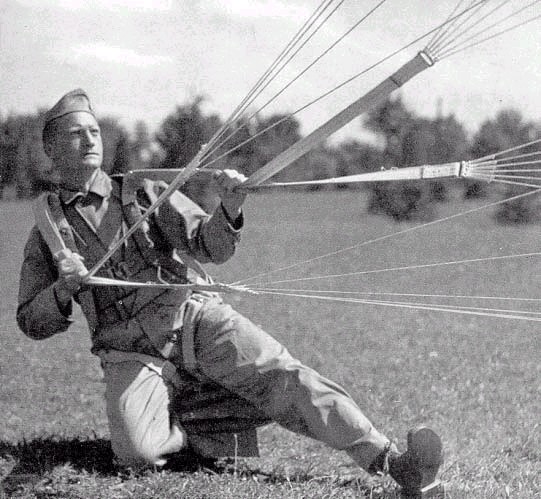
The "AIR CORPS TEST CENTER" was commission to design and develop a chute for mass military jumps. They designed what was then called the T-4 and was the first chute to have four risers so it could be steered. They also developed the reserve parachute, something only the U.S. Airborne had. No other nation, at that time, used reserves.
German Fallschirmjaeger parachutes were hooked to a single "D" ring and hooked to the harness behind their head. The jumpers were unable to steer them and they landed where ever the wind took them, and contributed to many casualties and battlefield losses.
In April 1940, following the controversies, the War Department approved plans for the formation of a test platoon of Airborne Infantry to form, equip, and train under the direction and control of the Army's Infantry Board. In June, the Commandant of the Infantry School was directed to organize a test platoon of volunteers from Fort Benning's 29th Infantry Regiment. Later that year, the 2nd Infantry Division was directed to conduct the necessary tests to develop reference data and operational procedures for air-transported troops.
In July 1940, the task of organizing the platoon began. First Lieutenant William T. Ryder from the 29th Infantry Regiment volunteered and was designated the test platoon's Platoon Leader and Lieutenant James A. Bassett was designated Assistant Platoon Leader. Based on high standards of health and rugged physical characteristics, forty-eight enlisted men were selected from a pool of 200 volunteers. Quickly thereafter, the platoon moved into tents near Lawson Field, and an abandoned hanger was obtained for use as a training hall and for parachute packing.
Lieutenant Colonel William C. Lee, a staff officer for the Chief of Infantry, was intently interested in the test platoon. He recommended that the men be moved to the Safe Parachute Company at Hightstown, NJ for training on the parachute drop towers used during the New York World's Fair. Eighteen days after organization, the platoon was moved to New Jersey and trained for one week on the 250-foot free towers.
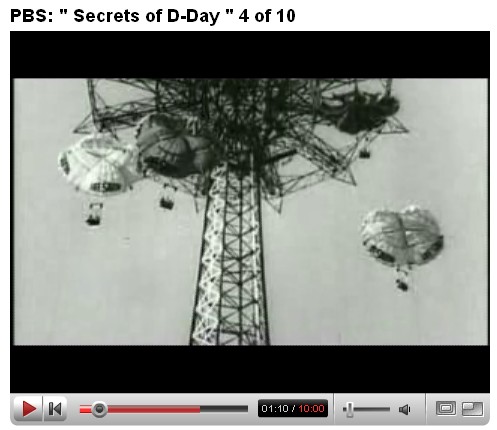
The training was particularly effective. When a drop from the tower was compared to a drop from an airplane, it was found that the added realism was otherwise impossible to duplicate. The drop also proved to the troopers that their parachutes would function safely. The Army was so impressed with the tower drops that two were purchased and erected at Fort Benning on what is now Eubanks Field. Later, two more were added. Three of the original four towers are still in use training Paratroopers at Fort Benning. PLF training was often conducted by the volunteers jumping from PT platforms and from the back of moving 2 1/2 ton trucks to allow the trainees to experience the shock of landing.
Less than forty-five days after organization, the first jump from an aircraft in flight by members of the test platoon was made from a Douglas B-18 over Lawson Field on 16 August, 1940. Before the drop, the test platoon held a lottery to determine who would follow Lieutenant Ryder out of the airplane and Private William N. (Red) King became the first enlisted man to make an official jump as a Paratrooper in the United States Army. On 29 August, at Lawson Field, the platoon made the first platoon mass jump held in the United States.
The first parachute combat unit to be organized was the 501st Parachute Battalion. It was commanded by Major William M. Miley, later a Major General and Commander of the 17th Airborne Division, and the original test platoon members formed the battalion cadre. The Civilian Conservation Corps cleared new jump areas and three new training buildings were erected. Several B-18 and C-39 aircraft were provided for training. The traditional Paratrooper cry "GERONIMO!" was originated in the 501st by Private Aubrey Eberhart to prove to a friend that he had full control of his faculties when he jumped. It was from a western movie they had seen the night before, so on a dare PVT Eberhart yelled the Indian warriors name so all could hear. That cry was adopted by the 501st and has been often used by Paratroopers since then.
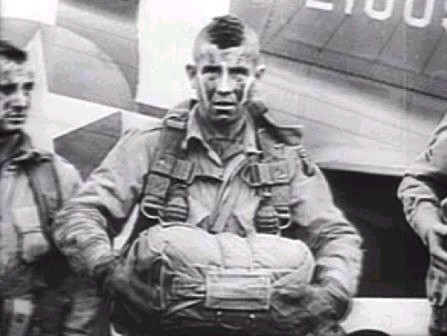
The 502nd Parachute Infantry Battalion, commanded by Lieutenant Colonel William C. Lee with men from the 501st as cadre, was activated on 1 July, 1941. The 502nd was far below strength, and 172 prospective troopers from the 9th Infantry Division at Fort Bragg, NC were needed. The response to Lieutenant Colonel Lee's call for volunteers was startling: more than 400 men volunteered, including many noncommissioned officers who were willing to take a reduction in rank ("take a bust") to transfer to the new battalion.
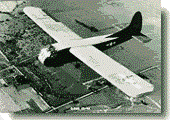
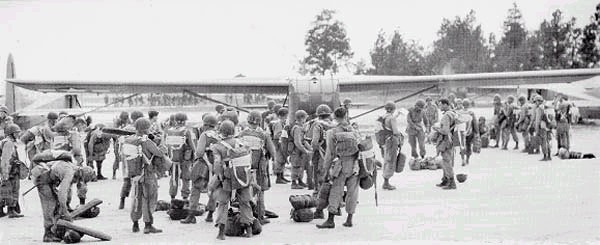
Airborne experimentation of another type was initiated on 10 October, 1941 when the Army's first Glider Infantry battalion was activated. This unit was officially designated as the 88th Glider Infantry Battalion and was commanded by Lieutenant Colonel Elbridge G. Chapman, Jr. Lieutenant Colonel Chapman later became a Major General and commanded the 13th Airborne Division.
As more Airborne units were activated, it became apparent that a centralized training facility should be established. Consequently, the facility was organized at Fort Benning on 15 May, 1942. Since that date, the U.S. Army Parachute School has been known by a variety of names: The Airborne School (1 January, 1946); Airborne Army Aviation Section, The Infantry School (1 November, 1946); Airborne Department, The Infantry School (February, 1955); Airborne-Air Mobility Department (February, 1956); Airborne Department (August 1964); Airborne-Air Mobility Department (October, 1974); Airborne Department (October, 1976); 4th Airborne Training Battalion, The School Brigade (January, 1982); 1st Battalion (Abn), 507TH Parachute Infantry, The School Brigade (October, 1985); and the 1st Battalion (Abn), 507TH Infantry, 11th Infantry Regiment (July, 1991).
The first Airborne Regiment, the 501st was formed in April of 1941 and the first U.S. Army jump school was started at Ft. Benning, GA. The idea for the 250 foot towers came from Coney Island, N.Y. They were built for the 1940 World's Fair, and are still there today. The rest were put together from scratch. With the advent of World War Two, the United States Armed Forces foresaw a need for highly mobile units that the Allies could quickly insert into the theater of battle. An experiment began at Fort Benning, Georgia where a group of volunteers began jumping out of "perfectly good aircraft" while in flight. Thus was born the American Paratroopers. Following great debate and an arduous command decision, the United States Army began forming Airborne units for combat. On 14 March 1941, Company "A", 504th Parachute Battalion was constituted and then activated on 5 October 1941 at Fort Benning, Georgia.
Early Paratroops at the Louisiana Maneuvers



The 504th moved to Fort Bragg, North Carolina for training in February 1942, and became part of one of the Army's first Parachute Infantry Regiments. The 503rd and 504th Parachute Infantry Battalions were joined together to form the 503rd Parachute Infantry Regiment, with the 504th being renamed Company "D", 503rd Parachute Infantry on 24 February 1942.
Although several types of headgear insignia have been worn by parachute and glider organizations since 1942, an insignia peculiar to the Airborne was not authorized until 1949 and did not appear in Army Regulations until 1956. The authorization was first mentioned in AR 670-5 (dated 20 September, 1956), which stated, "Airborne insignia may be worn when prescribed by commander...The insignia consists of a white parachute and glider on blue disk with a red border approximately 2 1/4 inches in diameter overall."
In December, 1943, the all black "555th Parachute Infantry Company (Colored)", later re-designated Company A, 555th Parachute Infantry Battalion (and remembered by many as the "Triple Nickel"), arrived at Fort Benning for Airborne training. This training event marked a significant milestone for black Americans in the combat arms. The first troops in the unit were volunteers from the all-black 92nd Infantry Division stationed at Fort Huachuca, Arizona. After proving their skills, the battalion was not sent overseas, but was deployed to the western United States for "Operation FIREFLY," dropping in to fight forest fires set by Japanese incendiary balloons in the Pacific Northwest. During this mission, the 555th earned the nickname the "Smoke Jumpers." In 1948, after full integration of the Armed Forces was finally effected, black Americans were finally given their full rights as American combat Paratroopers and made their first combat jump while attached to the 187th Regimental Combat Team during the Korean War.
As an independent battalion, the 503rd sailed to Scotland in June 1942, becoming the first American parachute unit to go overseas in World War Two. It was attached to the British 1st Airborne Division for training. The training included mass tactical jumps from C-47 aircraft at 350 feet, extensive night training, and speed marching for 10 miles to and from the training area daily; and on one occasion, 32 miles in 11 hours. On 2 November, as the 503rd was staging for Operation TORCH, the invasion of North Africa, it was reorganized and re-designated as Company "D", 509th Parachute Infantry. On this momentous day, as C-47's flew over the English countryside, the 509th Paratrooper was born.
The first U.S. Army Airborne Divisions were created on August 15 1942. The 82nd and the 101st. Then came the 11th, 13th and 17th Airborne Divisions. The following listing/descriptions takes this history to the present day. An "AIRBORNE" operation defined here as either airdropping with parachutes and/or airlanding from fixed-wing aircraft into "drop zones" or "assault zones".
Worldwide the beret of the Paratroops is bordeaux-red. This goes back to 1944 when a British Paratrooper suffered a head injury through a jumping accident. When he put his olive-green beret onto his head it changed with the colour of his blood into bordeaux-red. It was then decided that the colour should be changed into bordeaux-red because of the fact that Paratroopers have to get along with extreme dangers. Over the years more and more armies in the world copied these berets and so did the Bundeswehr in 1970. The U.S. Army Airborne wears a maroon red beret.
Gavin's paratroopers in WW2 were handicapped by civilian DC-3s that couldn't carry an intact platoon of men and easily caught fire without armor or self-sealing fuel tanks resulting in preventable losses of the 22 it did carry. Unable to carry intact towed guns much less parachute dropping ground vehicles, this forced DC-3s to tow gliders that could carry either a towed gun or a jeep---but not both. This meant open area landing zones had to be secured for the gliders to roll to a stop. Without armament, the DC-3s were vulnerable to enemy fighter planes so Gavin revolutionized airborne operations by night jumps which also protected the planes from anti-aircraft fires. To overcome the confusion of being in the dark, Gavin had his men memorize terrain features and sand table rehearse plans and contingency plans and be self-reliant and able to take the initiative in non-linear battlefield situations not be lemming marines. He created pathfinders to mark drop zones in the dark to improve assembly on top of objectives so they didn't have to walk far. Studying the German's troubles jumping from the very small JU-52 jump door, he exploited the large C-47 jump doors by having every Para jump complete weapons and equipment and minimize separate container drops to just 75mm pack howitzers in pieces--but roped together for fast re-assembly. Because supplies could only be dropped through small fuselage openings or underwing shackles, they were spread out all over and difficult to recover from open areas where the enemy could fire, and paras lacked vehicles with armor protection.
All of these conditions are not true today so there is no excuse why the U.S. Airborne is still handicapped! The current U.S. Airborne is a disgrace to the memory of the Airborne forefathers sitting on laurels bought and paid for by others and accepting self-serving handicaps that don't exist.
GPS insures that t-tail aircraft not only drop EXACTLY where we intend, but tell paras on ground exactly where they are. No need for rolling open fields for gliders to roll, a single nitrogen inerted fuel tank C-17 t-tail ramp aircraft can drop 80 tons on supplies on pallets, and M113 Gavin light tracked armored fighting vehicles (aka light tanks) can be on these pallets to not only recover the supplies with forklifts but also transport para infantry and anti-tank weapons ready-to-fire on the vehicle not towed---at 60 mph under armor protection. Air refueling enables fighters to escort our t-tail transports but our transport aircraft could and should be armed with their own air-to-air missiles and radar-guided cannon to swat SAMs in self-defense. Delayed opening timer parachutes with small drogue chutes would enable every para to jump if needed from high altitudes around 10, 000 feet above enemy air defense and have his main chute open at low altitude for a normal jump. Furthermore, with M113 Gavins paras need not land on top of heavily defended objectives but can take them by surprise from indirect drop zones. An American Airborne that foot-slogs or rides in road-bound, wheeled trucks when it has the most airlift of any force in human history---more than enough to have hundreds of amphibious, cross-country-mobile light tracked AFVs in use---is a disgrace.
All of the handicaps of the WW2 Airborne are solved, we just need people with 21st century minds in today's Airborne who want to execute 3D maneuver warfare as a Gavin "Sky Cavalry" not sit on their asses and do seize & hold re-enactments pretending they are crippled when its all in their minds.
Furthermore, reading the war diaries of the British light troops surrounded near Arnhem below:
pegasusarchive.org/arnhem/war.htm
Its increasingly clear that 3D maneuver troops must have a "hard shell" in the form of their own light tracked armored fighting vehicles (LTAFVs) so enemy high explosive pounding of them will not attrit them to where they cannot hold a position. These light tracked AFVs should also have back hoes attachments so overhead cover fighting positions and hull-down vehicle positions can be created to bolster the baseline vehicle armor. LTAFV armored mobility also insures airdropped supplies---however they are scattered---can be recovered so even though the 3D force is in a non-linear situation with enemy all around, their fighting strength can be perpetuated indefinitely 'til the heavier 2D forces link up or they themselves implode the enemy resistance by their own maneuver actions.
The other handicap light troops have against heavier enemy troops is that they don't have the supplies to artillery duel with them to keep them from laying down mortar, rocket and artillery pressures upon them since the latter has home field advantage of greater supplies in hand. The air-mechanized light force needs to never be outgunned and LTAFVs enable this because they can self-propel in a ready-to-fire manner tube and rocket/missile artillery that can through clever design keep the enemy's artillery shut down. Also notice how CAS fighter-bombers when overhead silence enemy guns---the AMS force should have its own "hip-pocket" air force of fighter-in-a-box (FINAB) aircraft in ISO container BATTLEBOXes delivered by KIWI pod aircraft right there on the scene operating from their airhead to do CAS as well as interdict enemy fighter-bombers and pesky UAVs from surveilling overhead to help target for the enemy.

Grenada 1983: Rangers jump under 500 feet to take Point Salines airfield
Date: 8 November 1942
Unit: 509th Parachute Infantry Battalion (PIB)
Operation: Torch
Troopers: 556
Country: Algeria
Dropzone: Tafaraquoi, La Senia
Aircraft: C-47
Type Air delivery: Day Mass low-level tactical personnel static-line jump after long-range deployment from England.
In the first U.S. airborne operation of the war, the 60th Troop Carrier Group of the 51st Wing flew 39 x C-47s non-stop in a night flight from England to points near Oran, carrying the 2nd Battalion of the 503rd Parachute Infantry (soon redesignated the 509th Parachute Infantry Battalion), whose task it was to capture key airfields in advance of the amphibious Allied invasion force. Confusion regarding the intentions of the French forces in the region quickly compounded problems associated with poor planning, failed communications, excessive distances, and inadequate training. Soon, however, a number of small, improvised airborne operations were developed for key points, mostly airfields, across Algeria and eastward in the race for Tunis. These operations were conducted by the 60th, 62rd, and 64th Groups of the 51st Wing, commanded by then-Col. Paul L. Williams. Airborne troopers for these operations included the 509th and the British 1st Parachute Brigade (comprising a total of three battalions), which began arriving in Algeria on 11 November, transported by the 62nd and 64th Groups.
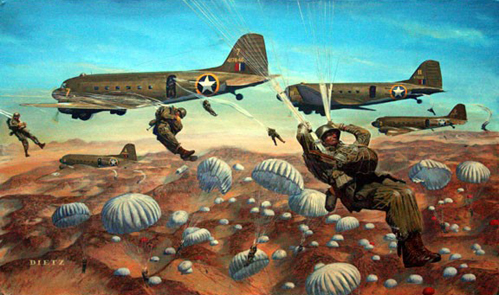
"You Have Your Orders" by Jim Dietz
The training paid off when the 509th spearheaded the Allied invasion of North Africa. The longest Airborne operation in history (so far) occurred 8 November 1942. After a C-47 flight of over 1600 miles from England, the battalion seized Tafarquoi Airport in Oran, Algeria by parachute assault. On the night of Saturday, November 7th, 1942, just eleven months to the day, after the Japanese attack on Pearl Harbor, 556 Paratroopers of the 509th Parachute Infantry Battalion, under the command of Lieutenant Colonel Edson Duncan Raff, took off from England to jump into French Northwest Africa in the initial step to liberate Europe from German occupation. The battalion's mission was to seize two French airfields at Tafaraqoui and LaSenia to deny their use by enemy fighters. Operation Torch, as the amphibious landing in North Africa was codenamed, was an unusually complex military operation. Without any secure bases in the operational area, Allied forces had to deploy from bases in England and travel a great distance to the landing areas. In the Airborne plan of Operation Torch, the 39 x C-47 aircraft of the Paratroop Task Force, commanded by Colonel William C. Bentley, flew 1500 miles over the mountains of Spain, across the western Mediterranean Sea, to arrive badly scattered over the North African coast west of Oran, Algeria, at dawn on November 8th. Nearly out of gas, several aircraft landed in the desert without dropping their Paratroopers, several aircraft were shot down by enemy fighters, several planeloads jumped early and were captured in Spanish Morrocco, while the main force with Lieutenant Colonel Raff also jumped early some 35 miles east of the objective airfields. Although he broke several ribs in a hard landing, Lieutenant Colonel Raff continued to lead his Paratroopers toward their objectives. After a full day and a night forced march, a company of weary Paratroopers reached the airfield at Tafaraoui on the morning of November 9th. Both airfields had already been captured by Allied amphibious forces.
Date: 15 November 1942
Unit: 509th PIB
Operation: Torch
Troopers: 350
Country: Algeria
Dropzone: Youks les Bains
Aircraft: C-47
Type Air delivery: Day Mass low-level tactical personnel static-line jump
One week later, after repacking their own chutes (every man was his own Rigger in those days), the battalion conducted their second combat jump on 15 November 1942 to secure the airfield at Youk-Les-Bains near the Tunisian border. From this base the battalion conducted combined operations with various French forces against the German Afrika Korps in Tunisia. At 9:30 a.m. on November 15, 1942, 350 Paratroopers from the 509th Parachute Infantry Battalion jumped onto the enemy occupied airfield at Youks Les Bains in Algeria for the battalion's second combat mission in just seven days. In spite of the injuries sustained on his earlier jump, Lieutenant Colonel Raff, the 509th Battalion Commander, led this mission as well. The Paratroops landed on a cleared area adjacent to the runway. Within twenty minutes the Paratroops had assembled, secured the airfield, and accepted the surrender of the French Third Zouaves Regiment, which defended the airfield. Lieutenant Colonel Raff ordered his Company "D" to dig in around the airfield and dispatched his Company "E" on foot to secure another airfield at Tebessa, fifteen kilometers away. Soon after the Paratroopers secured the second airfield at Tebessa, again without opposition, a German JU-52 transport attempted to land there but was shot down. After a week, the Paratroopers of the 509th Parachute Infantry were reinforced by an American tank destroyer company and some British engineers. With this added force, Lieutenant Colonel Raff's Paratroopers began conducting sorties across the border into Tunisia to attack German Paratroop and Italian forces around Gafsa. The aggressive actions of the 509th Parachute Infantry Battalion from Tebessa southward to Gafsa succeeded in protecting the Allied flank during the drive eastward towards Tunis. The 3rd Regiment of Zouaves (French Algerian Infantry), awarded their own Regimental Crest as a gesture of respect to the American Paratroopers. This badge was awarded to the battalion commander on 15 November 1942 by the 3rd Zouaves' Regimental Commander, and is worn today by all members of the 509th Infantry.
Date: 24 December 1942--
Unit: 509th PIB, Hdqt's. Co. Two French Paratroopers-
Troopers: 32 -
Country: Tunisia
Dropzone: El Djem
Aircraft: C-47
Type Air delivery: Day, Mass, low-level tactical personnel static-line jump
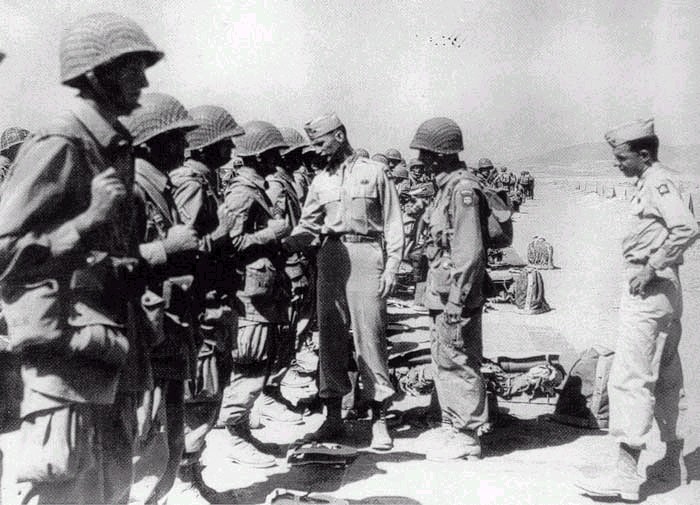
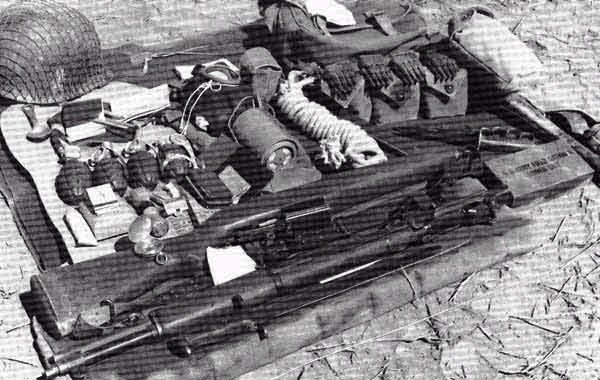
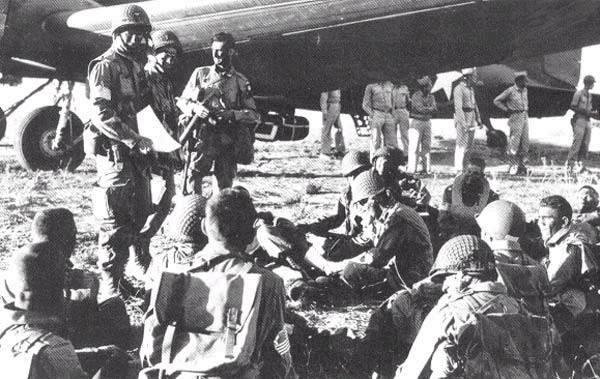
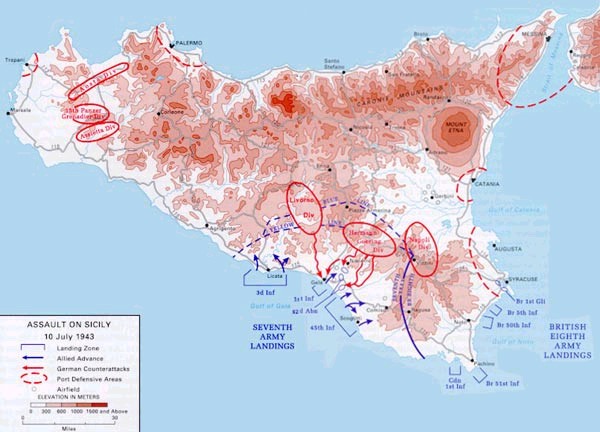
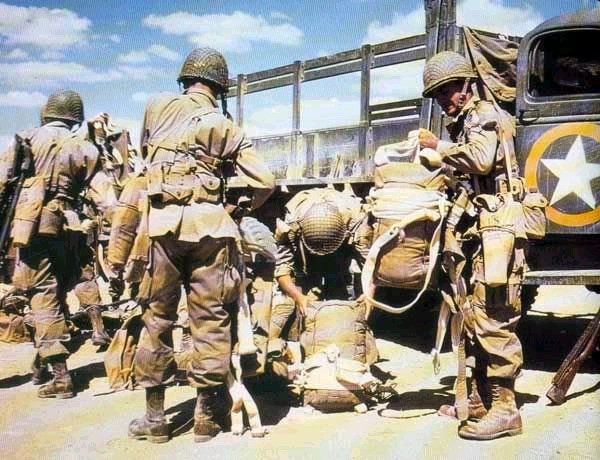
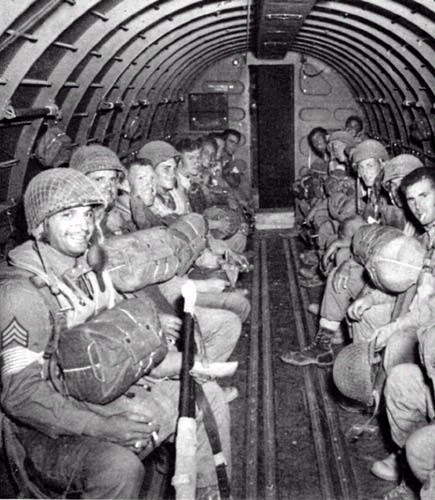
Date: 9 July 1943
Unit: 504th Parachute Infantry Regiment 3rd Battalion (Jumped first); 505th Regimental Combat Team (RCT), Includes: 505th PIR, 456th PFA & Co. B, 307th Engr.
Operation: Husky I
Troopers: 3,406
Country: Italy
Dropzone: Gela, Sicily
Aircraft: C-47
Type Air delivery: Night Mass low-level tactical personnel static-line jump, wing shackle bundle drops, Gliders
Date: 10 July 1943
Unit: 504th Regimental Combat Team (RCT), Includes: 504th PIR, 1st & 2nd Btn.; 376th PFA & Co.A, 307th Engr.
Operation: Husky II
Troopers: 2,304
Country: Italy
Dropzone: Gela, Sicily
Aircraft: C-47
Type Air delivery: Night Mass low-level tactical personnel static-line jump, wing shackle bundle drops, Gliders
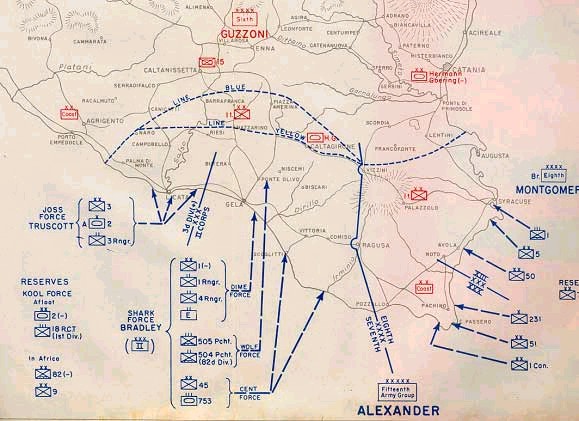
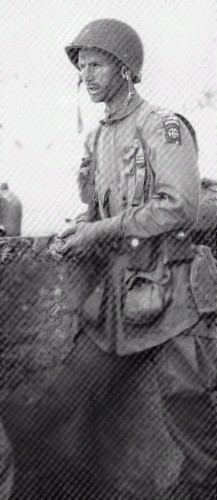
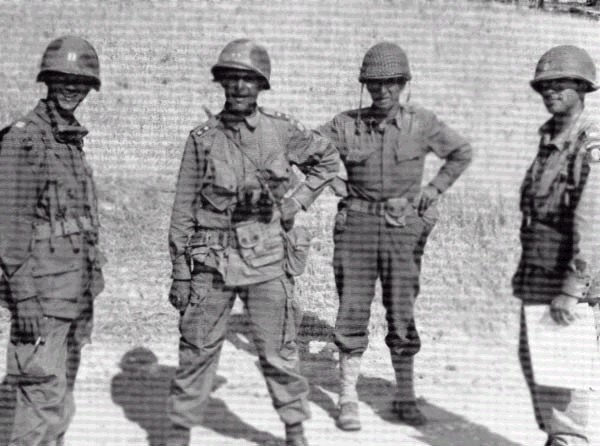
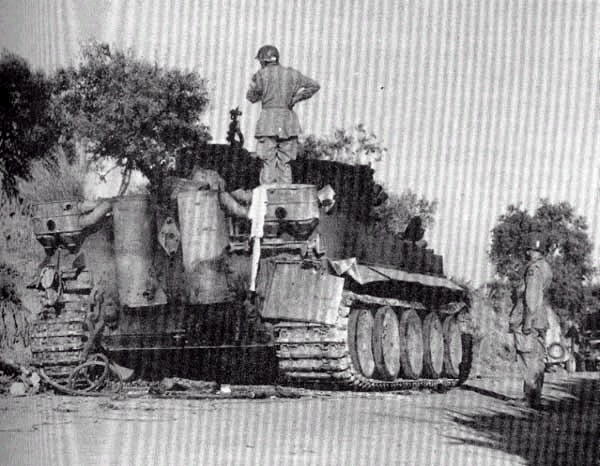
Date: 5 September 1943
Unit: 503th PIR and 2/4th Australian Infantry Force
Troopers: 1,700
Country: New Guinea
Dropzone: Nadzab, Markham Valley
Aircraft: C-47, A-20s (smokescreens)
Type Air delivery: Day Mass low-level tactical personnel static-line jump, wing shackle bundle drops
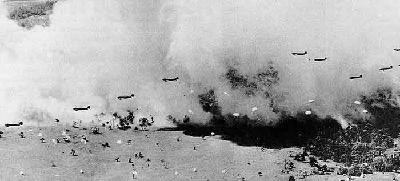
 youtube.com/watch?v=wuz0TpzqwWY
youtube.com/watch?v=wuz0TpzqwWY
First American airborne operation in the Pacific took place at Nadzab, New Guinea. The American 503rd PIR dropped from 85 x C-47s of the 374th and 375th Troop Carrier Groups, 54th TC Wing, in a mission to secure the airfield at Nadzab and prepare it for airlanding the Australian 7th Division, which was to then push toward Lae from the west and link up with Allied amphibious invasion forces moving in from the east. The same aircraft that carried in the 503rd and some Australian artillerymen who were hastily trained as parachutists, also airlifted 420 planeloads of infantry Soldiers by 11 September. The paradrop, which took place in daylight as General MacArthur circled above in a B-17 observation bomber, was well coordinated, accurate, and effective. Along with several key Troop Carrier maneuvers in the States during the summer and late fall, strong support by General Ridgway, and in conjunction with the soon-to-follow emergency missions at the Salerno beachhead, this mission contributed to a renewed commitment to Airborne-Troop carrier by American military leaders.
1st R.A.R's lineal history goes back to the 65th Battalion, 2nd Australian Imperial Forces (A.I.F.), engaged in the fight against the Japanese. That unit was a part of the Australian 7th Division A.I.F. In 1943 a U.S. unit was to jump on a Japanese fortified area in New Guinea, elements of the 7th Australian Division, A.I.F were hastily chosen to jump with them in the form of and Australian Artillery Section of 2 x 25 Pounders, from the ranks of the 7th Australian Division, A.I.F. came a Section of 2/4th Artillery Battery under command of Lt Pearson. The 33 men in the Section had two days hasty Parachute Training prior to the big day, at which time 2 of the originals were injured and ruled out. They were replaced on the day by two that had not jumped at all. On the Big Day, 5 September 1943, The U.S. 503rd Parachute Infantry Regiment (P.I.R) went through the door over NADZAB in New Guinea, the 2/4th Artillery Section went out the door with them. The jump master considered they were not trained well enough and thus made them jump without side arms. Their side arms/small arms went out the door in a pannier, after hitting the Landing Zone, they had one of their guns up and firing within 2 hours of the jump. Those gunners of the 7th Australian Division, A.I.F., didn't know then that they were setting the pace for another Australian Unit to join with the 503rd, some 22 years later on another foreign airstrip when 1st R.A.R. whose lineal history goes back to the 7th Australian Division, A.I.F., were to join with the Sons of the 503rd P.I.R. at Bien Hoa, Vietnam.
Airlift historian and Vietnam C-130 combat veteran, Sam McGowan writes:
"...the Airborne assault on Nadzab, an airstrip in the Markham Valley in Papau New Guinea in the fall of 1943. If there is a single World War II battle that deserves to be studied by modern advocates of Airborne and Airland operations, Nadzab is it.The attack on Nadzab was planned and executed by the air staff of the Fifth Air Force, the air element of the Southwestern Pacific Command of General Douglas MacArthur. Lt. Gen. George C. Kenney, the Fifth Air Force commander, conceived the attack as a means of catching the Japanese forces at Lae in a pinch between Airborne and Airlifted troops attacking from the northwest and infantry attacking up along the Huon Peninsula (sometimes called the Lae Peninsula) from the southeast. Nadzab was the fruition of a plan Kenney conceived in early 1943 after American and Australian troops, many of whom had been airlifted across the Owen Stanley Mountains, defeated the Japanese force at Buna, a village southeast of Lae. Kenney conceived an Airborne attack at a time when he had no Airborne forces at his disposal. During a visit to the United States in the spring of 1943 Kenney requested the assignment of an Airborne Division to his command. Instead of a Division he got a Regiment, the 503rd Parachute Infantry (the 11th Airborne Division arrived in the Pacific in time for the invasion of the Philippines.)
During the interim prior to the arrival of the first American Paratroops in the Southwest Pacific, Kenney ordered the construction of a secret advanced airfield on the north slopes of the Owen Stanleys less than a hundred miles south of Lae. The new field, at a village known as Tsili-Tsili (and pronounced Silly-Silly) was constructed entirely by airlift. Engineers and construction materials were flown into an existing strip at Marlinan, about four miles from the new site. (The Marlinan strip was not suitable for use by fighters, but it was suitable for C-47s.) Originally the engineers planned to use jeeps and trailers to transport materials between the two bases, until someone came up with the idea of sawing Army trucks in half and transporting the halves in C-47s, then reassembling them in the field. It was not until the base was ready for fighters that it was detected by the Japanese. An attack caught a formation of C-47s as they were approaching to land. At least one transport was shot-down before U.S. fighters broke up the attack.
The Nadzab attack was planned as a two-fold operation. American Paratroops airlifted from Port Moresby would jump onto an existing, but lightly defended, airstrip and secure the field while the C-47s returned to Marlinan to pick up/airland Australian infantry who had been prepositioned there by airlift in anticipation of the operation.
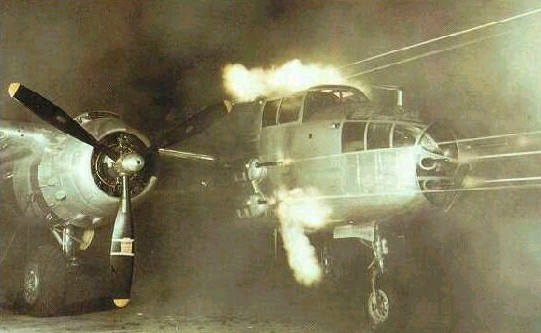
On the morning of the attack the drop formation of some 90 x C-47s from the 374th, 317th and 375th Troop Carrier Groups took off from Seven Mile Aerodrome at Port Moresby and assembled over the field. While the C-47s were assembling into drop formation, then heading out for the drop zone at Nadzab three groups of powerfully armed B-25 strafers were taking off from other airfields in the area. Though factory produced versions of the B-25 gunships would later serve in the Pacific, the airplanes at Nadzab were mostly conventional B-25 medium bombers that had been converted in the field into forward-firing gunships. The bombardier's position was removed from the airplane and the nose was filled with a battery of eight .50-caliber machineguns while additional guns were installed in pods mounted on the sides and bottom of the bombers, giving each B-25 a battery of 12-14 .50-caliber Heavy Machine Guns firing forward along the longitudional axis of the airplane. In addition to the machineguns, each B-25 carried a bomb-bay full of small parachute-fragmentation bombs, bombs that floated to earth beneath parachutes to detonate right above the ground, spraying fragments in every direction.
Minutes before the C-47s arrived over the Nadzab drop zone, a very large force (as many as 90 ships) of B-25 gunships hit the airfield. After strafing the drop zone, the B-25s dropped their loads of parafrag bombs. As the last B-25 left the field a flight of A-20s came over and dispensed a cloud of smoke around the DZ to conceal the troopers from the enemy postions in the trees. Above the airstrip a flight of three VIP-carrying B-17s observed the operation. General Kenney was in one airplane, General Douglas MacArthur (who was erroneously referred to by some of his men as "Dougout Dug") was in another. A fighter cover of P-38s and P-39s kept the Japanese fighters at bay.
The Paratroopers landed under the concealment of the smoke without taking a single casualty from enemy fire. Within minutes after they were on the ground, the Japanese on the airfield surrendered with very little resistance. The Paratroops hurriedly secured the airfield perimeter and prepared the airstrip for the arrival of troop carrying C-47s that began arriving in the afternoon. As the C-47s arrived, the Australian infantry assembled and, along with the American Paratroops, began attacking toward Lae.
Now that, folks, is how an Airborne operation is supposed to work, as conceived by General Billy Mitchell and further developed in the minds of men like Kenney, who had served as an observer in Europe in 1940. The Airborne attack was swift and sure, and it followed behind a massive aerial attack by heavily armed fixed-wing gunships who literally swept the area with heavy machinegun fire. The Allies had previously achieved aerial superiority, the gunships suppressed the fire of the Japanese troops who were in the vicinity of the previously determined-to-be lightly defended area and the troops jumped onto a DZ where they met little resistance.
I might also add that the operation was planned and executed, not by a massive staff in Washington, at Fort Bragg and at Scott or Eglin, but by a commander and staff in the field who knew the area and the military situation, and who tailored their operation for the conditions. In fact, the whole thing was carried out by a single command that included heavy bombers, medium bombers, fighters and transports as well as Airborne forces and infantry. And it worked.
The U.S. Army Paratroopers of the 1/503rd PIR roar over the smoke in C-47s and jump in at an incredibly low 250 feet! The airfield is taken over quickly with light casualties as the Kenney/MacArthur, Air/Ground team began their amazing run of spectacular victories against the Japanese without the thousands of friendly casualties the frontalist approach used by the Navy/mc in the North Pacific received.
ibiblio.org/hyperwar/USA/USA-P-Rabaul/USA-P-Rabaul-11.html
Nadzab: The Airborne InvasionThe Jump
Capture of Nadzab had been spectacularly effected on 5 September. This mission, assigned to Col. Kenneth H. Kinsler's 503rd Parachute Infantry Regiment, was coupled with the additional mission of preparing the airstrip for C-47's carrying Maj. Gen. George A. Vasey's 7th Australian Division from Marilinan and Port Moresby.[17]
www.youtube.com/watch?v=5zo4PTMg9uA
Reveille for the men of the 503rd sounded early at Port Moresby on the morning of 5 September. The weather promised to be fair, although bad flying weather over the Owen Stanleys delayed take off until 0825. New Guinea Force had prepared its plans flexibly so that the seaborne invasion on 4 September would not be slowed or altered if any threat of bad weather on 5 September delayed the parachute jump, but Kenney's weathermen had forecast accurately.
The paratroopers and a detachment of
--207--
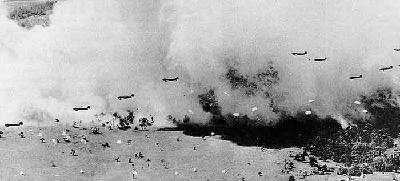
C-47 TRANSPORT PLANES LOADED WITH PARACHUTE TROOPS for the drop at Nadzab. Two men at left are General Kenney and General MacArthur.
2/4th Australian Field Regiment which was to jump with its 25-pounder guns reached the airfield two hours before take off. [18] There they put on parachutes and equipment. The 54th Troop Carrier Wing had ninety-six C-47's ready, and the troops boarded these fifteen minutes before take-off time.
The first C-47 roared down the runway at 0825; by 0840 all transports were aloft. They crossed the Owen Stanleys, then organized into three battalion flights abreast, with each flight in six-plane elements in step-up right echelon.
An hour later bombers, fighters, and weather planes joined the formation over Marilinan, on time to the minute. All together 302 aircraft from eight different fields were involved. The air armada then flew down the Watut Valley, swung to the right over the Markham River, and headed for Nadzab. The C-47's dropped from 3,000 feet to 400-500 feet. The parachutists had stood in their planes and checked their equipment over Marilinan, and twelve minutes later they formed by the plane doors ready to jump.
In the lead six squadrons of B-25 strafers with eight .50-caliber machine guns in their noses and six parachute fragmentation bombs in their bays worked over the Nadzab field. Six A-20's laid smoke after the last bomb had exploded. Then came the C-47's, closely covered by fighters.
The paratroopers began jumping from the three columns of C-47's onto separate jump areas about 1020. Eighty-one C-47's carrying the 503rd were emptied
--208--
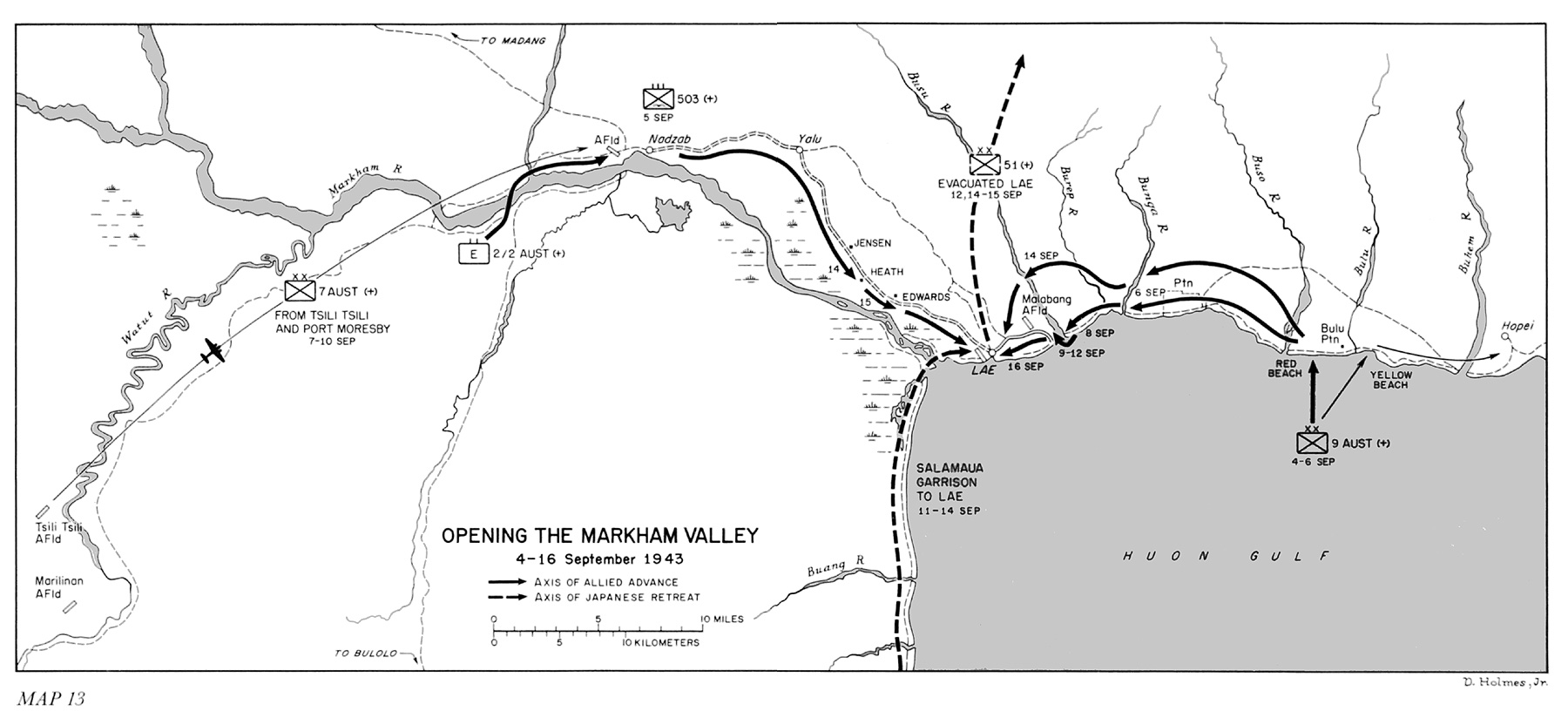
AIRDROP AT NADZAB, MORNING OF 5 SEPTEMBER 1943. The paratroopers began jumping from C-47's onto separate jump areas about 1020.
in four and one-half minutes. All men of the 503rd but one, who fainted while getting ready, left the planes. Two men were killed instantly when their chutes failed to open, and a third landed in a tree, fell sixty feet to the ground, and died. Thirty-three men were injured. There was no opposition from the enemy, either on the ground or in the air. Once they reached the ground, the 503rd battalions laboriously moved through high kunai grass from landing grounds to assembly areas.
Five B-17's carrying supply parachutes stayed over Nadzab all day. They dropped a total of fifteen tons of supplies on ground panel signals laid by the 503rd. The Australian artillerymen and their guns parachuted down in the afternoon. The whole splendid sight was witnessed by Generals MacArthur and Kenney from what Kenney called a "brass-hat" flight of three B-17's high above. MacArthur was in one, Kenney in another, and the third B-17 was there to provide added fire power in case the Japanese turned up.
The 503rd's 1st Battalion seized the Nadzab airstrip and began to prepare it to receive C-47's. The 2nd and 3rd Battalions blocked the approaches from the north and east. As soon as the parachutists had begun landing, the Australian units that had come down the Watut River--the 2/2d Pioneer Battalion, the 2/6th Field Company, and one company of the Papuan Infantry Battalion--began landing on the north bank of the Markham. They made contact with the 503d in late afternoon and worked through the night in preparing the airstrip.
--209--
The next morning the first C-47 arrived. It brought in advance elements of the U.S. 871st Airborne Engineer Battalion.
Twenty-four hours later C-47's brought in General Vasey's 7th Division headquarters and part of the 25th Australian Infantry Brigade Group from Marilinan, where they had staged from Port Moresby. Thereafter the transports flew the Australian infantry and the American engineers directly from Port Moresby. By 10 September the well-timed, smoothly run operation had proceeded fast enough that 7th Division troops at Nadzab were able to relieve the 503rd of its defensive missions. Enough American engineers had arrived to take over construction of new airstrips.
The 503rd's only contact with the enemy came in mid-September when the 3rd Battalion ran into a Japanese column at Yalu, east of Nadzab. The parachute regiment was withdrawn on 17 September. It had lost 3 men killed jumping, 8 men killed by enemy action, 33 injured jumping, 12 wounded by the enemy, and 26 sick.[19]
This was, comparatively, small cost for the seizure of a major airbase with a parachute jump. Nadzab paid rich dividends. Within two weeks the engineers had completed two parallel airstrips six thousand feet long and had started six others.
The Advance Against Lae
The 25th Australian Infantry Brigade Group moved eastward out of Nadzab toward Lae on 10 September while General Wootten's 9th Division troops were forcing a crossing over the Busu River east of Lae. The Markham Valley narrows near Lae, with the Atzera Range on the northeast and the wide river on the southwest. A prewar road in the Atzera foothills connected Nadzab with Lae, and a rough trail on the other side of the Atzeras paralleled this road from Lae to Yalu, where it intersected the road. Thus while some troops blocked the trail at Yalu, and the 2/33rd Australian Infantry Battalion guarded the line of communications, the 2/25th Australian Infantry Battalion advanced down the road and part of the 2/2nd Australian Pioneer Battalion moved down the north bank of the river.
When a small group of Japanese offered resistance to the advance at Jensen's Plantation, toward the lower end of the valley, the 2/25th Battalion drove it back and on 14 September captured Heath's Plantation farther on. The 2/33rd Australian Infantry Battalion then took over and pushed on toward Lae. By now the Australians had come within range of Japanese 75-mm. guns and found the going harder. But an assault the next day cleared Edward's Plantation and enemy resistance ended.
The advance elements of the 25th Brigade entered Lae from the west the next morning, 16 September. In the afternoon the 24th Brigade, which had advanced from the east and captured Malahang Airdrome on 15 September, pushed into Lae and made contact with the 25th Brigade. Lae had fallen easily and speedily. The Japanese had vanished.
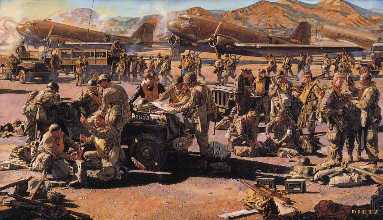
"Eight hours to Glory" by legendary artist Jim Dietz shows the 505th PIR getting ready for the Salerno jump
Date: 13 September 1943
Unit: 504th Regimental Combat Team (RCT) Includes: 504th PIR, 376th PFA & Co. "A" 307th Eng.
Operation: Avalanche
Troopers: 1,300
Country: Italy
Dropzone: Paestum, Salerno
Aircraft: C-47
Type Air delivery: Night Mass low-level tactical personnel static-line jump
Date: 14 September 1943
Unit: 505th Regimental Combat Team (RCT). Includes: 505th PIR, 456th PFA & Co.B 370th Engr.
Operation: Avalanche
Troopers: 2,105
Country: Italy
Dropzone: Salerno, Paestum
Aircraft: C-47
Type Air delivery: Night Mass low-level tactical personnel static-line jump
Salerno was one of the bloodier, more critical operations of the Second World War. For a time the action hung in the balance as strong enemy counterattacks smashed and threatened the very existence of the initial beachhead. This was the opening struggle of the long and bitter Italian campaign.
The Fifth Army held the beachhead at Salerno for four days but were danger of losing it to advancing German assaults and needed assistance quick. The only choice was to utilize the 504th Parachute Infantry Regiment, which had been performing mock assaults, in an effort to provide relief to the dwindling forces of the Fifth Army.
On September 13, 1943 1st and 2nd Battalions were alerted that they would be performing a parachute assault. "Another dry run", was the cynical comment of most men. Nevertheless, each man gave his equipment a last minute check - just in case. Early chow was eaten and immediately afterward the troops fell in at their bivouac areas in the appointed plane loading formations; then marched to the battered and roofless hangars where they picked up their chutes.
The first troopers to board planes were the Pathfinders of the 504th who would be establishing and mark the drop zone which was located in the middle of the Fifth Army. These men devised a plan to mark the drop zone with a flaming "T" using sand and gasoline.
While the Pathfinders were on their way to the fight, the rest of 1st and 2nd Battalion were hard at work. Officers were checking maps and information to decipher the best course of action to help save the Fifth Army and save the beachhead. Noncommissioned officers had Soldiers hard at work issuing parachutes, performing maintenance checks on weapons, and starting to load planes. None of these paratroopers knew the location of this jump or what type of fighting was expected. It was not until the men were seated in the planes that the mission was disclosed. In probably the quickest briefing of any comparable operation of the war, men of the 504th were informed that the Fifth Army beachhead in Italy was in grave danger of being breached and that the 504th was to jump behind friendly lines in the vicinity of the threatened breakthrough in order to stem the German advance.
Under the cover of darkness the planes left for the beachhead. Flying in a column formation they passed over the clearly marked DZ and unloaded their much needed support. With the exception of eight planes which failed to navigate properly to the DZ, but whose planeloads were subsequently accounted for, there was little difficulty or confusion experienced in completing the operation. The regiment assembled quickly and moved to the sounds of cannon and small arms fire within the hour. Later checks revealed that, amazingly, only 75 men had suffered injuries as a result of the jump. In exactly eight hours the 504th had been notified of its mission, briefed, loaded into planes, jumped on its assigned drop zone, and committed against the enemy.
By dawn the regiment was firmly emplaced in a defensive sector three miles from Paestum and Southwest of Albanella. The days of the 14th and 15th of September were spent in anticipation of a tank attack that threatened from the Calore River region to the North. The 2nd Battalion assisted in the repulsing of one tank attack across the Sele River while E Company, on a reconnaissance in force of the same area, encountered scattered and small elements of the enemy. The regimental recon platoon patrolled the area several miles to the front and battalions also sent out reconnaissance and combat patrols of their own with particular emphasis on the Altavilla sector. Hostile artillery fire was spasmodic and largely interdictory in character. Air activity was confined principally to friendly craft, though the enemy in groups of two and three would occasionally make an appearance over 504th positions only to be driven off by intense fire from supporting anti-aircraft units. On the morning of the 16th, the regiment marched four miles to occupy the town of Albanella, where at noon, Colonel Tucker issued to the battalion commanders the order to seize and hold the high ground surmounting Altavilla. The area in the region of Altavilla for several years had been a firing range for a German artillery school; consequently there was no problem of range, deflection, or prepared concentrations that the enemy had not solved long before the advent of the Americans. Needless to say, hostile artillery and mortar fire was extremely accurate and capable of pinpointing with lethal concentrations such vital features as wells, trails, and draws. During the three days that the 504th occupied the several hills behind Altavilla, approximately 30 paratroopers died, 150 were wounded, and one man was missing in action.
The days that followed were, in the words of General Mark Clark, Commander of the 5th Army, "responsible for saving the Salerno beachhead." They included repelling tank attacks and small enemy forces. As the 504th took the high ground at Altavilla, the enemy counterattacked, and on the night of the 17th, it became evident that help had to be secured if the 504th, now completely cut off from friendly forces, was to hold these key positions so necessary for the security of the beachhead. The Commander of 6th Corps, General Dawley, suggested the unit withdraw. Epitomizing the determined spirit of the Regiment, Colonel Tucker vehemently replied, "Retreat, Hell! -- Send me my other battalion!" The 3rd Battalion then rejoined the 504th, the enemy was repulsed, and the Salerno beachhead was saved. This, the first contact with the enemy for men of the 504th since Sicily and the first time that the regiment had been committed as a unit in any single tactical operation, was a battle that turned the tide of the German onslaught on the Salerno beachhead and frustrated their attempts to contain the Fifth Army within the confines of the coastal plain reaching as far as Altavilla. On 1 October 1943, the 504th became the first infantry unit to enter Naples and 3rd Battalion became the first U.S. parachute unit to receive a Presidential Unit Citation as a result of the fierce fighting.
The 504th fought hard in all battles they encountered in Italy. Nothing reflected this more than a diary entry of a German officer found at Anzio. The passage read:
American parachutists...devils in baggy pants...are less than 100 meters from my outpost line. I can't sleep at night; they pop up from nowhere and we never know when or how they will strike next. Seems like the black-hearted devils are everywhere...To this day the paratroopers of the 504th PIR are still known as "The Devils".
Date: 14 September 1943
Unit: 509th PIB
Operation: Avalanche
Troopers: 640
Country: Italy
Dropzone: Avellino
Aircraft: C-47s
Type Air delivery: Night Mass low-level tactical personnel static-line jump
While the 82nd Airborne Division dropped inside American lines to reinforce the Salerno beachhead, the 509th was assigned the mission of cutting enemy supply lines behind the German defensive positions. The 509th launched its third parachute assault at Avellino, Italy, only to find that the valley DZ was occupied the night before by the 6th German Armored panzer Division. The 509th operated independently for some two weeks behind German lines in company and platoon size elements disrupting the German rear area. Separate units scrounged for food and water among the Italian civilians until the unit finally reassembled in Salerno on 28 September 1943. Total casualties were 123 killed or captured including the 509th commander and his entire staff.
Date: March 5-May 17 1944
Unit: Chindits and 1st USAAF Air Commandos
Operation: Thursday
Troopers: 15, 000 men
Country: Burma
Landing Zones: "Broadway" and "Pacadilly"
Aircraft: C-47s, Waco gliders
Type Air delivery: Night Daylight glider assaults and resupply landings with mini-bulldozers to clear landing strips for C-47s to airland troops, pack mules, pack howitzers
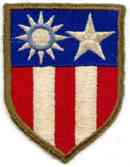 1944, 5 March-17 May: American glider missions into Japanese-held Burma; first use of double-tow in combat. At the Quebec Conference of August 1943, British Major General Orde Wingate was assigned the task of assisting U.S. General Joseph W. Stilwell's two Chinese divisions in opening up the supply route from India through northern Burma into China. Since the spring of 1942, airsupply from the Assam valley of India over the high, rugged, and remote Himalayas had offered the only viable means of supplying forces in the region around Kunming, China. For these purposes, the Air Transport Command, in conjunction with assigned troop carrier and combat cargo outfits and British RAF transport units, delivered tons of vital supplies through extreme conditions-including attacks by Japanese fighter aircraft-over "the Hump."
1944, 5 March-17 May: American glider missions into Japanese-held Burma; first use of double-tow in combat. At the Quebec Conference of August 1943, British Major General Orde Wingate was assigned the task of assisting U.S. General Joseph W. Stilwell's two Chinese divisions in opening up the supply route from India through northern Burma into China. Since the spring of 1942, airsupply from the Assam valley of India over the high, rugged, and remote Himalayas had offered the only viable means of supplying forces in the region around Kunming, China. For these purposes, the Air Transport Command, in conjunction with assigned troop carrier and combat cargo outfits and British RAF transport units, delivered tons of vital supplies through extreme conditions-including attacks by Japanese fighter aircraft-over "the Hump."
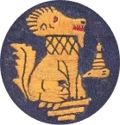
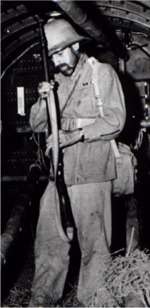
Legendary British Major General Orde Wingate
In preparation for Wingate's Burma operations, to begin in early 1944, a special AAF unit which came to be known as the 1st Air Commando Group was formed lead by Colonel Phil Cochrane...
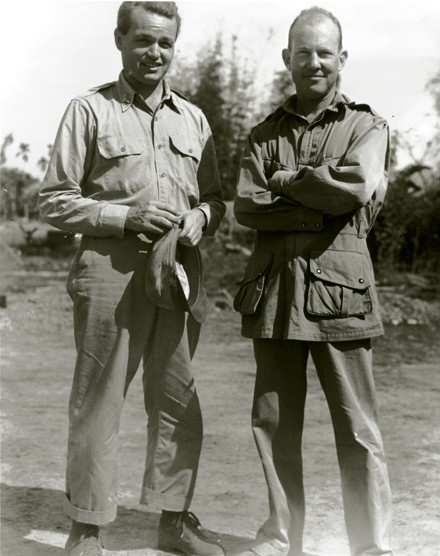
Colonel Phil Cochrane and a Paratrooper
and went into training for purposes of flying Wingate's troops into battle, evacuating the wounded, providing airsupply and direct air support.
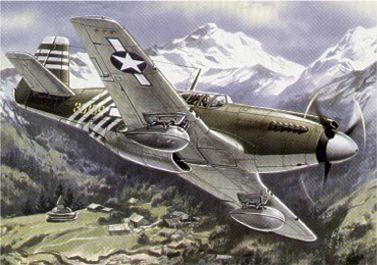
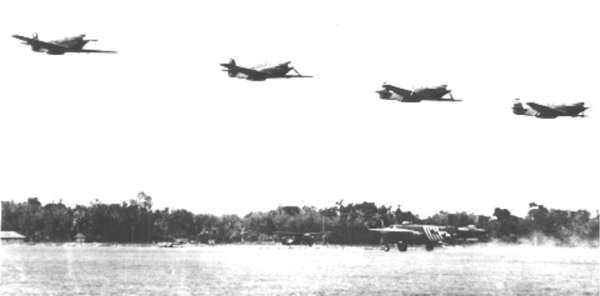


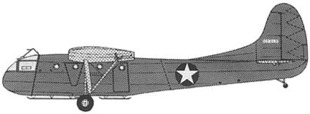
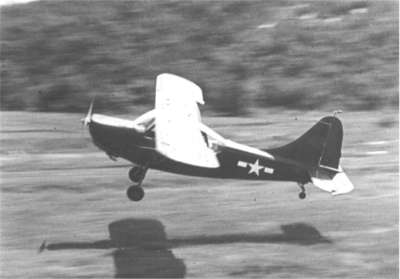
This elite unit included contingents of Troop Carrier, Fighter, Medium Bomber, and Reconnaissance outfits, and totaled more than 500 men. Aircraft in the Group included C-47s, P-51s, B-25s, observation aircraft, and CG-4A Waco gliders. After Stilwell's offensive had penetrated well into Burma in February 1944 and were reinforced by the American regiment that came to be known as Merrill's Marauders, Wingate got his orders, which included the establishment of his forces in Burma to cut the supply lines of Japanese forces opposing Stilwell's units. Wingate's plan called for a forced march by one of his brigades through jungle terrain deep behind enemy lines, to be resupplied nightly by 1st Air Commandos. Next, beginning in early March, came the transport by glider of two of his brigades up to 165 miles behind enemy lines, where they would quickly carve out airheads, build up their forces, and set out to complete their primary tasks. Wingate's forces, trained as guerrillas and known as the Chindits, included British, Gurkha, Burmese, Indian, and Nigerian troops. The Troop Carrier operation, which began on 5 March, authorized overloads for the Wacos (4,500 lbs payload rather than the standard 3,750 lbs). Eighty gliders were to fly double-tow for more than 250 miles and then make a night landing at a large clearing near the village of Indaw. A total of 34 x C-47s and CG-4As took off and climbed to 8,000 ft., a feat that took some 80 minutes at full throttle on double-tow. Due primarily to overloading, most gliders broke loose, and only 31 made it to the LZ. Casualties were heavy among those who made it to the target: 31 men dead, 30 seriously injured. No resistance was encountered upon landing. The mission, preceded by a Pathfinder unit, delivered 539 men, along with 65,972 lbs of cargo and three mules. Glider-borne engineers cleared and leveled the field and by nightfall had built a runway 5,000 ft. long and 300 ft. wide. During this same night the first C-47s landed, delivering 500 more Soldiers, ammunition, and supplies; by 11 March, more than 9,000 Chindits had been flown into this airstrip. On the night that C-47s began landing at the first airfield, 12 more CG-4As-on single tow-were delivered to a nearby location, and within two days engineers there had built a new 3,000 ft. strip. During the next two months, the 1st Air Commando Group flew 96 more glider sorties-most at night. Glider snatches were also performed, and most of those took place at night as well. Northern Burmese objectives were secured by Stilwell's forces near the end of August 1944, and up until that time, the Troop Carrier crews continued to fly airsupply missions to the Chindits and others in the Allied offensive in Burma.
To read more about the amazing CHINDITS:
 VIDEO! on the CHINDITS
VIDEO! on the CHINDITS
Part 1
Japanese masters at jungle warfare bicycle infiltrate and outflank British taking Malaya/Singapore, demoralized in restive India, Wavell calls for maverick Wingate who lead Israeli Special Night Squads and Gideon Force to victoria in Ethiopia, he creates long-range penetration groups resupplied by air to out-junglefight the Japanese, attacking their supply lines
 youtube.com/watch?v=BB1KJn_IPvw&sdig=1
youtube.com/watch?v=BB1KJn_IPvw&sdig=1
Part 2
300 man columns with 100 mules, RAF radiomen with each column to insure resupply, 90 day operations, 2 columns sent south to divert Japs, 5 columns under Wingate head east to cut rail lines, bad weather prevented resupply so columns went without food for 10 days, men got sick, had to eat their pack mules, need for SERE skills to gather food and lightweight rations or rice seems evident, seriously wounded men shot when should have been air-evaced by STOL grasshopper planes, 1, 000 men out of 3, 000 died, of 2, 000 survivors, 600 were unable to return to duty, wily Winston Churchill has Wingate accompany him to Canada to get Americans and Canadians to create their own Special Forces, 1st Air Commandos created to better support CHINDITS and American Galahad penetration force that became Merill's Marauders now the Army's 75th Rangers
 youtube.com/watch?v=j-sP7JRALnI
youtube.com/watch?v=j-sP7JRALnI
Part 3
Colonel Phil Cochrane's Air Commandos well-equipped with P-51 fighter-bombers, C-47s and 100 x Waco gliders to infiltrate without having to march in, gliders carrying tiny tracked bulldozers to improve landing areas so C-47s could airland with mules and the rest of the men
 www.youtube.com/watch?v=7sbYl88SblM
www.youtube.com/watch?v=7sbYl88SblM
Part 4
Operation THURSDAY: multiple CHINDIT brigades in strong points deep inside Jap-held Burma, Wingate liases with his brigade commanders by STOL grasshopper but switches to a longer-range B-25 bomber to return to headquarters that crashes, killing him. Cochrane's fighter-bombers offer maneuver air support to help ward off Jap attacks
 www.youtube.com/watch?v=a2OckZaiNJI
www.youtube.com/watch?v=a2OckZaiNJI
Part 5
Air resupply and CASEVAC by Sunderland seaplanes on the river, CHINDITs ordered to take Mogang to assist Stillwell's taking of Mytykinkya town after taking the airfield, Slim's 14th Army with Bren gun carriers and light and medium tanks repulses Jap offensive, Stillwell and CHINDITs link-up and latter are flown back to India, Ledo road connected to Burma road to resupply China, Japs in retreat, CHINDITs disbanded and stupid idea that resources would have been better used with Slim's predictable advance is non-sense, without Stillwell and CHINDITS UNHINGING the Japs from the inside-out, Slim wouldn't have got anywhere
 www.youtube.com/watch?v=px1U8egyJDE
www.youtube.com/watch?v=px1U8egyJDE
A good Hollywood depiction of CBI Paratroop/Glider Airborne operations, see Errol Flynn's 1945 movie, "Objective Burma" which features actual combat footage including a CG-4A glider snatch at the end!
1944: D-Day
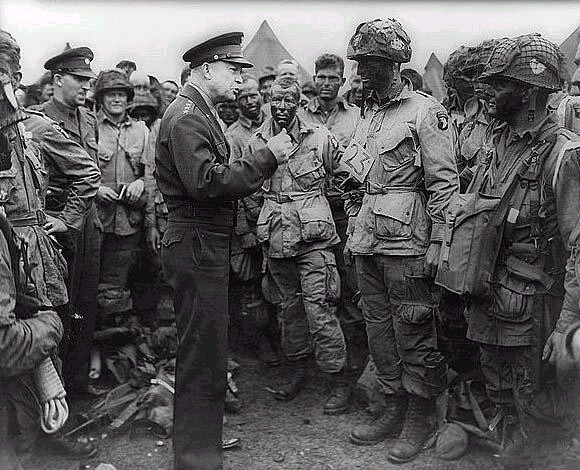
VIDEO ONLINE FOR FREE:
www.cinemanow.com/TitleDetail.aspx?titleID=26509&grpID=435&device=0&cpt=0
Geronimo: The U.S. Airborne in World War II
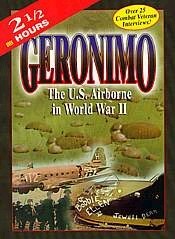
Available for Windows PC
Stream - Standard (700K)
Synopsis: The United States Airborne played a major role in the success of Allied operations throughout World War II. From their first jumps in North Africa and Sicily, to the massive drops in Normandy and Holland, the Airborne was an important part of Allied military strategy. Initially conceived as an assault force able to parachute behind enemy lines, to seize and hold strategic areas until ground forces could link up with them, the Airborne unites were used in many different ways. From dropping in to capture key positions behind enemy lines in Normandy and Holland, to fighting as tough ground forces at Anzio and the Battle of the Bulge, the Airborne was ready for anything. Elite, confident, and ready for action, the men of the United States Airborne were the best trained and best conditioned fighting force of the war. These men represented the finest combat troops America had to offer and they proved it in the face of unbelievable odds and under the most extreme conditions.
This Documentary is THEIR story. Told entirely through veteran and historian interviews and supported by rare archival footage, this set features the stories and experiences of the Paratroopers in their own words, creating a uniquely personal perspective of the United States Airborne forces during World War II.
MPAA Rating: NR
Length: 2hr. 43min
Windows Media Player 10 Required
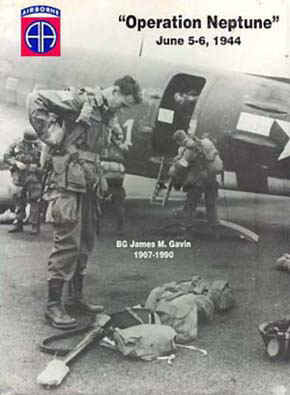
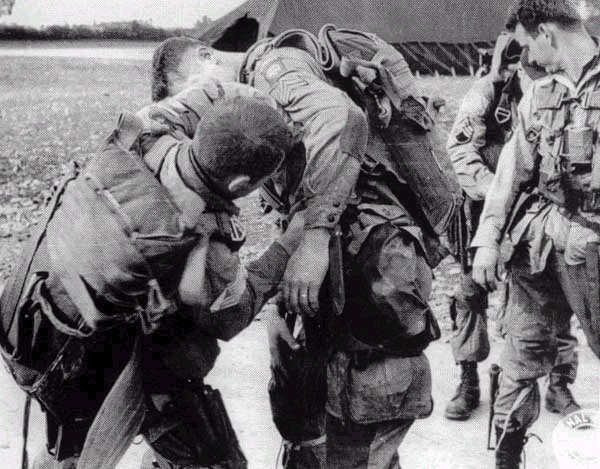
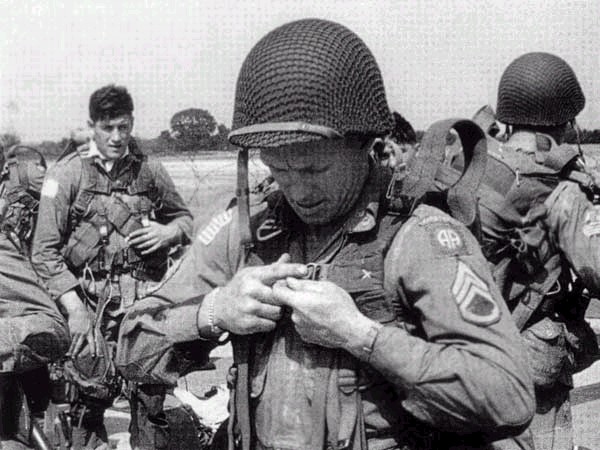
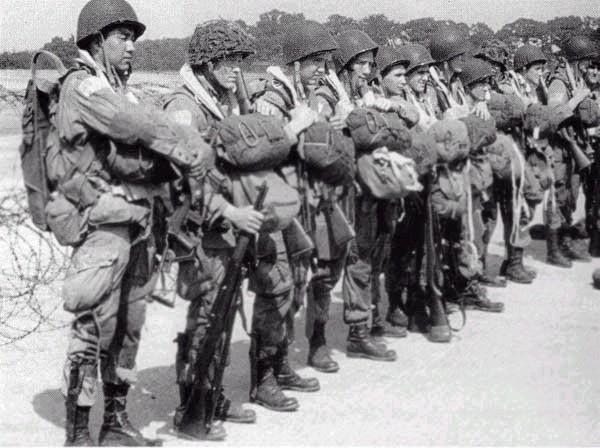
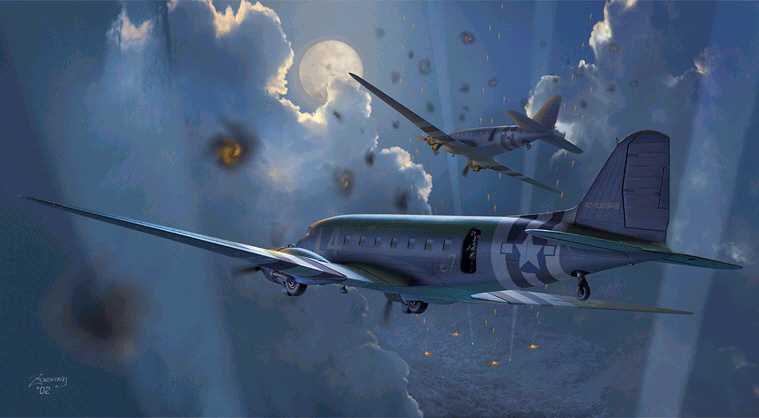
Legendary General James M. Gavin "chutes up" for the D-Day jump. Compare his equipment with today's; particularly that as a fighting General he jumped with BOTH a .45 caliber automatic pistol and a full-size M1 Garand 7.62mm x 82mm semi-automatic, 8-shot main battle rifle with minimal padding while today too many officers are content with just 9mm pistols. General Gavin would lead by personal examples with his rifle as would other great Airborne Infantry leaders like Major Richard Winters of "E" Company, 2/506th PIR "Band of Brothers" fame. You don't see these successful combat leaders in a CP mouse-clicking e-memos, do you? For a leader to have moral influence and to decide the issue at the most critical moment, he must BE THERE with the men, leading-the-way.
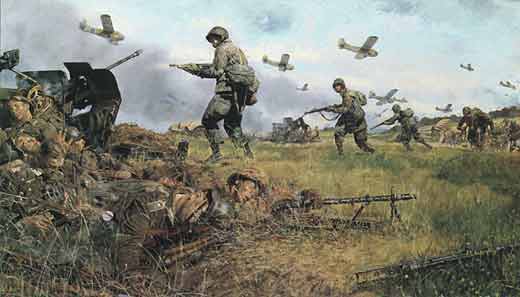
The "Red Devils" of the 508th storm from the sky and knock out German anti-aircraft guns for the gliders to land safely...
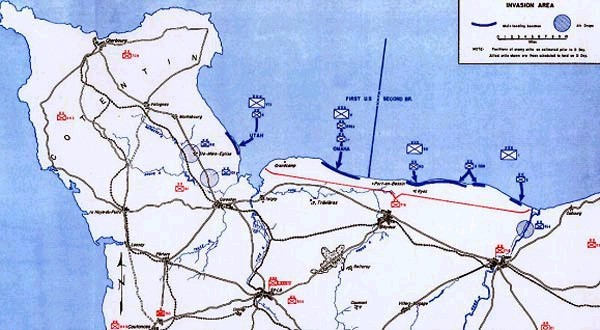
Date: 6 June 1944
Unit: 82nd Airborne Division (507th, 508th) 505th RCT, Includes: 505th Parachute Infantry Reg., Co. B/307th Engineer Battlion & 456th Parachute Field Artillery Batalion. 28 Pathfinders, 504th PIR, (7 returned).
Aircraft: C-47
Type Air delivery: Night Mass low-level tactical personnel static-line jump, wing shackle bundle drops, Gliders
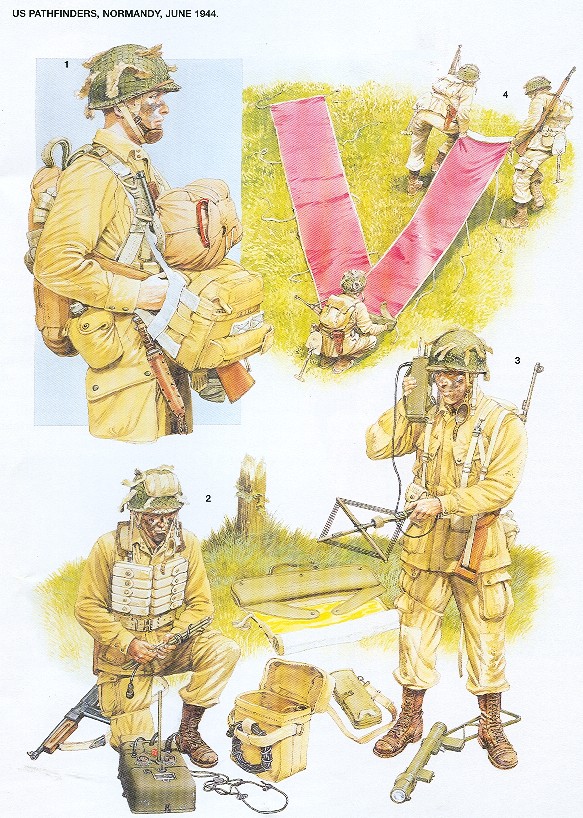
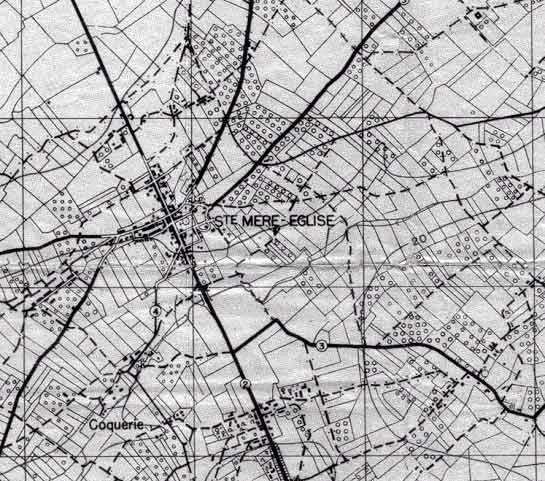
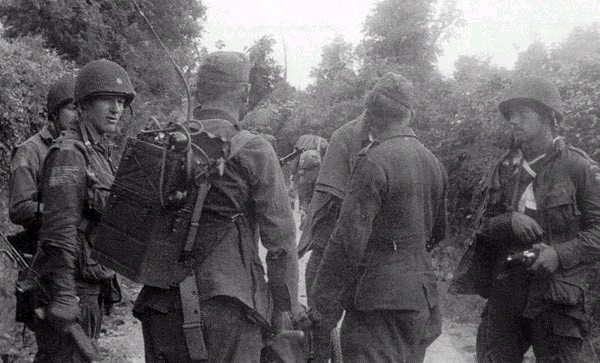
Captured German prisoners pushing hand cart for the Paras
Operation: Titanic (Dropping of parachute dummies, "Oscar").
Operation: Overlord
Troopers: 6,418
Country: France
Dropzone: Normandy
Aircraft: C-47
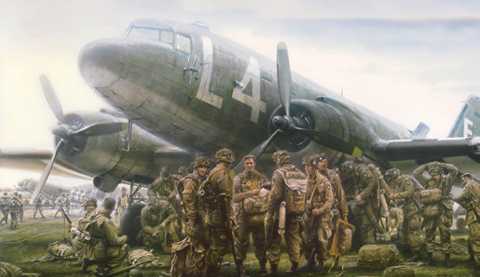
"We Were a Band of Brothers" by John D. Shaw, depicting the famed men of Easy Company, 2/506th PIR preparing for the fateful jump into Normandy on the 'night of nights'. After nearly 2 years in the planning and creation, Ghost Wings and Liberty Studios have had the honor of having the participation of over 14 original veterans of Easy Company in personally signing these lithographs. Each of these distinguished "Band of Brothers" participated in the D-Day jump on June 6, 1944, and continued on to make military history, immortalized in Steven Ambrose's bestseller and the award-winning HBO miniseries.
NEW BOOK: Beyond Band of Brothers: The War Memoirs of Major Dick Winters (Hardcover) by Dick Winters, Cole C. Kingseed
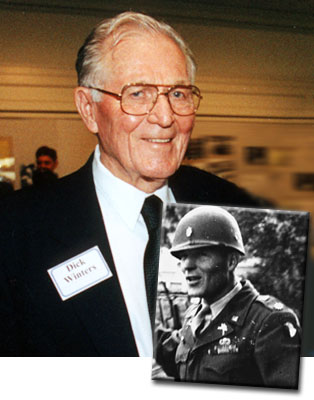
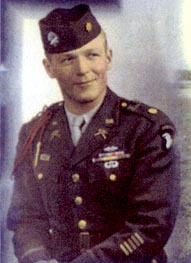
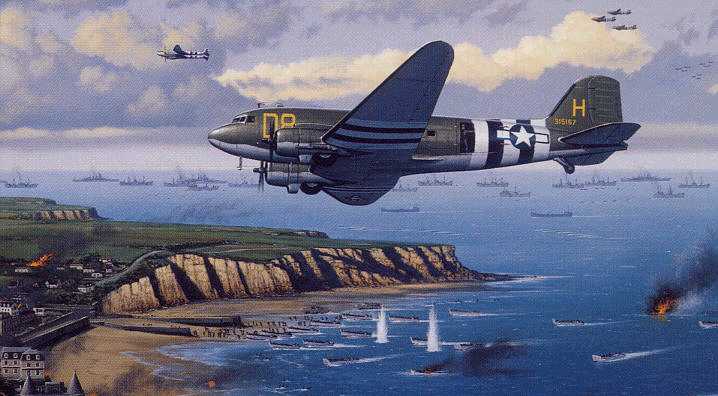
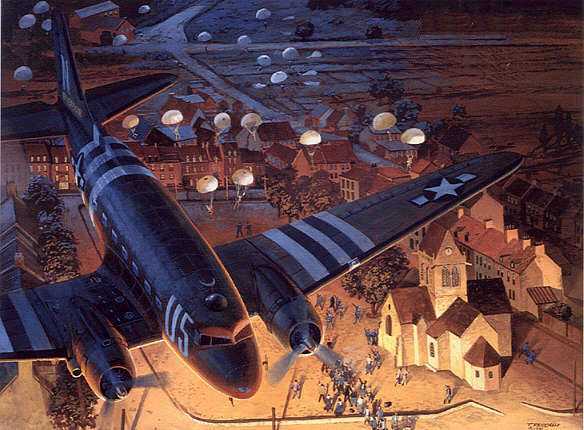
Date: 6 June 1944
Unit: 101st Airborne Division [326th, 377th, 501st, 502nd, 506th]
Operation: Titanic (Dropping of parachute dummies, "Oscar").
Operation: Overlord
Troopers: 6,638
Country: France
Drop Zone: Normandy
Aircraft: C-47
Type Air delivery: Night Mass low-level tactical personnel static-line jump, wing shackle bundle drops, Gliders
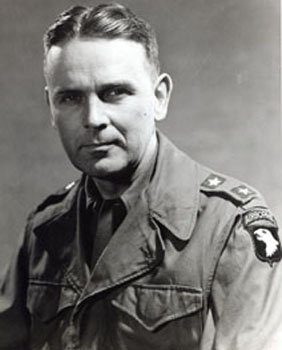
Brigadier General Maxwell Taylor, CG of the 101st Airborne during WW2
 www.youtube.com/watch?v=-O-bMTKtJlg
www.youtube.com/watch?v=-O-bMTKtJlg
Soon after D-Day, the Paras lead the way cleaning-up all Germans in Southern France
www-cgsc.army.mil/carl/resources/csi/Lewis/Lewis.asp
Jedburgh Team Operations in Support of the 12th Army Group, August 1944

Excerpts from Dr. S. J. Lewis' U.S. Army study on the activities of a number of Jedburgh teams operating in northern France during the last year of the war addresses this often-overlooked aspect of the war in Europe.
In the summer of 1944, Allied special operations teams known as Jedburghs parachuted into occupied Europe to cooperate with resistance groups behind German lines and to aid in the advance of Allied ground forces. Each of the ninety-nine Jedburgh teams consisted of three specially trained volunteers. Clandestine operations of the kind that the Jedburghs conducted often have been recounted in memoirs and novels, but only a portion of the actual operational records have been declassified. The Jeds, as they called themselves, were but one group charged with clandestine work. Individual agents, inter-Allied missions, Special Air Service (SAS) troops, and other such organizations will only be included in this study when they specifically influenced Jedburgh operations.
This study examines the operations of the eleven Jedburgh teams dropped into northern France during the summer of 1944, with particular emphasis on the degree to which they assisted in the advance of the 12th Army Group from Normandy to the German border. The treatment of these Jedburgh teams will be arranged chronologically, by date of insertion. The area of operations covered by these teams reached from the Belgian border in the north, south to Nancy. Jedburgh operations south of Nancy lie beyond the scope of this study. The operational records of the eleven northern teams form the core of the documentation for this study, although a good deal of the story told here has been gleaned from other sources, memoirs and interviews with Jedburgh veterans (see map 1). Regrettably, the records of the Special Forces Headquarters (SFHQ), the organization with General Eisenhower's Supreme Headquarters, Allied Expeditionary Forces (SHAEF), that provided operational command and control for Jedburgh teams, remain classified and, therefore, were not available for use in this study.
The sun was setting on 7 July 1944 at Harrington Air Base some fifty miles north of London. Captain Bill Dreux, a thirty-one year old lawyer from New Orleans, like his two partners, was weighted down by a .45-caliber pistol, carbine, ammo, binoculars, money belt, escape kit, flashlight, tobacco, and map case and could barely move. Over all this equipment, each man wore a camouflaged body-length smock. Dreux felt wrapped like a mummy and had trouble getting out of the station wagon. Finally, after the driver had assisted each out of the vehicle, the three tightly wrapped men waddled slowly in short, jerky steps toward a black-painted B-24 Liberator. The absurdity of the situation was not lost on the bomber's U.S. Army Air Corps crew, who succumbed to laughter. After a last cigarette, Bill Dreux, his partners, and the crew scaled the B-24 and took off for Brittany. Dreux and his two colleagues were Jedburghs. [1]
Jedburghs were volunteers specially trained to conduct guerrilla warfare in conjunction with the French Resistance in support of the Allied invasion of France. Bill Dreux and his two partners survived their mission. Their story has already been told, however, and with some skill, in one of the few published Jedburgh memoirs. This paper will examine the role of the eleven Jedburgh teams parachuted into northern France in the summer of 1944 whose story has not been told (see map 2). These eleven teams, like Dreux's, worked mostly with French teenagers and the few Frenchmen not drafted into German labor organizations or prisoners of war in Germany. Many Jedburgh teams had difficulty radioing London, and some that did contact London doubted that their reports were acted upon. After the Jedburgh operations in France concluded, the teams' after-action reports reflected a sense, not of failure, but rather of frustration. The teams felt they could have been used more effectively. The major reason for this frustration was a professional officer corps unfamiliar with, the capabilities of unconventional warfare and the multiplicity of secret organizations (several of them new) competing for recognition, personnel, funds, and missions.
Following the fall of France, in July 1940, the Chamberlain cabinet, in one of its last acts, created the Special Operations Executive (SOE). Independent of other British intelligence services, its charter was suitably unique: to foster sabotage activity in Axis-occupied countries. Two offices in the War Office and one in the Foreign Office had been studying the subject since 1938, and they combined to form SOE2. Although SOE ran intelligence circuits, it was independent of the Secret (or Special) Intelligence Service (SIS), which today is known as MI 63. In similar fashion, the Special Air Service Regiment remained independent of SOE and SIS. David Stirling, who created the SAS in 1941, summarized his organization's purpose as follows:
.... firstly, raids in depth behind the enemy lines, attacking HQ nerve centres, landing grounds, supply lines and so on; and, secondly, the mounting of sustained strategic offensive activity from secret bases within hostile territory and, if the opportunity existed, recruiting, training, arming and coordinating local guerrilla elements.4

MAP 2. Jedburgh teams deployed to northern France.
The United States approached World War II without a strategic intelligence organization. It first created the Committee of Information, a conspicuous failure that soon became the Office of Strategic Services (OSS). Its director, William ("Wild Bill") Donovan, allowed it to duplicate the functions and methods of the British intelligence organizations, to which it was closely tied. But whereas the British effort was marked by independent competing organs, Donovan attempted to unify the many facets of the secret world in his neophyte OSS. Following September 1942, the OSS special operations branch joined the SOE London Group to create a combined office known as SOE/SO on Baker Street in London. [5]
SOE's first director, Dr. Hugh Dalton, explained his organization's purpose as follows:
We have got to organize movements in enemy-occupied territory comparable to the Sinn Fein movement in Ireland, to the Chinese Guerillas now operating against Japan, to the Spanish Irregulars who played a notable part in Wellington's campaign or-one might as well admit it-to the organizations which the nazis themselves have developed so remarkably in almost every country in the world. This "democratic international" must use many different methods, including industrial and military sabotage, labour agitation and strikes, continuous propaganda, terrorist acts against traitors and German leaders, boycotts and riots.[6]
One of the most important personalities in SOE was Sir Colin McV. Gubbins, who eventually became its executive director. Born in Japan in 1896, Gubbins was a slight Scot who had served in the artillery on the Western Front in World War I, in Ireland during "the Troubles," and in northern Russia during the Russian Civil War. In 1939, in the War Office's small unconventional war section, he wrote two short pamphlets: "The Art of Guerilla Warfare" and "Partisan Leaders' Handbook."[6]
He created the "Independent Companies" (later renamed commandos) and successfully led several of them in Norway in 1940. May 1942 found him a brigadier general with the title of military deputy to head of SOE. [7]
In May 1942, SOE entered into talks involving its support of a future Allied invasion of northwestern Europe. The British Chiefs of Staff foresaw SOE activity occurring in two phases. In the first phase (cooperation during the initial invasion), SOE would organize and arm resistance forces and "take action against the enemy's rail and signal communications, air personnel, etc." During the second phase, after the landing, SOE would provide guides for British conventional units, guards for important locations, labor parties, and organized "raiding parties capable of penetrating behind German lines."[9]
Brigadier Gubbins and SOE developed the Jedburgh concept from these discussions with one paper, drafted by Peter Wilkinson, summarizing its activities as follows:
As and when the invasion commences, SOE will drop additional small teams of French speaking personnel carrying arms for some forty men each. The role of these teams will be to make contact with local authorities or existing SOE organizations, to distribute the arms, to start off the action of the patriots, and, most particularly, to arrange by W/T [wireless telegraphy] communication the dropping points and reception committees for further arms and equipment on the normal SOE system. Each Team will consist of one British Officer, one W/T operator with set and possibly one guide.[10]
On 6 July, Gubbins (recently promoted to major general) briefly explained the project to the head of the SOE security section, requesting a code name for teams "to raise and arm the civilian population to carry out guerrilla activities against the enemy's lines of communication."[11] The following day, the security section issued the project the code name "Jedburgh", after a small town on the Scots-English border.[12]
The Jedburgh project evolved along with the changing Allied invasion plans of the Continent. Later in the month, SOE resolved that seventy Jedburgh teams would be required, with the British and Americans each providing thirty-five. In August 1942, the British Chiefs of Staff informed SOE that there was no longer a requirement for Jedburgh teams to provide guides and labor or raiding parties, effectively eliminating phase two of the original proposal. On 24 December 1942, a meeting at General Headquarters, Home Forces, determined that Jedburghs would all be uniformed soldiers and that one of the two officers in each team should be of the nationality of the country to which the team would deploy. This signified that the project would require Belgian, Dutch, and French Soldiers. Furthermore, Jedburgh teams would be dropped to secure areas, where SOE agents would receive them. Each team would be given one or more military tasks to perform in their area. In addition, since it would take at least seventy-two hours to deploy a team and have them operational, Jedburgh teams would not be used to assist the tactical plans of conventional ground forces. Finally, SOE would provide twelve Jedburgh teams to further examine the concept's possibilities and limitations during Exercise Spartan from 3-11 March 1943.[13]
Exercise Spartan simulated an Allied breakout from the initial invasion lodgement area. SOE's Jedburgh teams attempted to assist the British Second Army advance, with the 8th Battalion of the Royal Welsh Fusiliers in the role of local resistance groups. SOE also used this opportunity to test the insertion of individual agents behind enemy lines and the role of SOE staff officers at army and corps headquarters. Each of these parties communicated via an SOE radio base in Scotland. Following the exercise, SOE concluded that Jedburgh teams should be inserted at least forty miles behind enemy lines to conduct small-scale guerrilla operations against enemy lines of communication. The exercise also demonstrated that each army and army group headquarters- required an SOE liaison and signals detachment. SOE also concluded that it should maintain a small detachment with the Supreme Headquarters.[14]
SOE and OSS, after compiling the Spartan lessons learned, both began the process of moving similar position papers through the British and American hierarchies, seeking approval, support, and personnel. On 19 July 1943, Lieutenant General Frederick R. Morgan, Chief of Staff to the Supreme Allied Commander, recommended that the SOE proposals be approved. To his understanding, SOE would provide small staffs and signal detachments to each army and army group headquarters (and the Supreme Allied Commander's headquarters) "for controlling resistance groups." [15] Jedburgh teams would constitute a strategic reserve in England until D Day "to provide, if necessary, suitable leadership and equipment for those resistance groups found to be in need of them." [16] Two days later, the British Chiefs of Staff approved the SOE proposal, with the Americans following suit on 24 August 1943. By October, SOE and OSS each agreed to provide sufficient personnel to field 35 Jedburgh teams plus 15 reserve teams-a total of 300 men in 100 teams.[17]
SHAEF created a special forces (SF) detachment for each army and army group headquarters to coordinate these operations with the field army. These detachments linked the field headquarters with SOE/SO. Each detachment fielded about twelve officers and twenty men. The senior OSS officer with the U.S. Third Army described the organization as follows: "The SF Detachment was an orthodox military staff organized to provide the Commanding General of the Army a direct means to exercise control over the organized resistance elements and to use these elements in connection with military operations." [18] The detachments, however, had no means of directly contacting those organized resistance groups and Jedburgh teams other than through SOE/SO. That organization summarized agent and resistance group reports and dispatched those summaries to the SF detachments.[19]
To integrate this effort with the Allied invasion of France, SOE/SO on 1 May 1944 became the Special Forces Headquarters responsible to SHAEF's G3 Branch. Although SOE had several sections running circuits in France, the most important were RF Section (circuits supporting General Charles de Gaulle) and F Section (which operated non-Gaullist circuits). De Gaulle's government in exile still remained at arm's length, but on occasion, its intelligence branch, Bureau Central de Renseignements et l'Action (BCRA), cooperated with SOE/SO. One such occasion was a 25 January 1944 London meeting to discuss the reception of Jedburgh teams in France. SOE, OSS, and the BCRA agreed to finance a mission for BCRA and F Section to establish reception committees and safe houses for Jedburgh teams. Through herculean efforts, de Gaulle's government managed to largely unify the many diverse French resistance groups, in March 1944 announcing the creation of the Forces Francaises de l'Interieur (FFI). The FFI included the Communist Franc Tireurs et Partisans (FTP-French leftist resistance organization), the largest and most active resistance organization. It remained difficult, however, for the many diverse French resistance organizations to cooperate without considering postwar political dilemmas.[20]
In July 1944, SHAEF directed de Gaulle's subordinate and personal friend, Pierre Koenig,[21] commander of the FFI, to gradually assume command over SFHQ operations in France. The transfer did not occur until 21 August. In any case, this was largely a political and cosmetic measure, because Koenig's deputies from SOE and OSS maintained the mechanisms of command, communication, and supply (see figure 1).[22] Most of the eleven Jedburgh teams examined here operated in eastern France, known as Region C to the FFI, commanded by District Military Representative "Planete." Region C consisted of the Ardennes, Marne, Meurthe-et-Moselle, Meuse, Vosges, Bas-Rhin, and Haute-Rhin Departments. This had been a difficult area in which to operate from the beginning, but in August 1944, it became even more difficult, as the Vichy police, the Milice, and its supporters fled east with the remnants of the defeated German Army.[23]
In mid-September 1943, with the Allied invasion of France just around the corner, no Jedburgh force existed. Over the next three months, SOE and OSS each recruited officers and noncommissioned officers (NCOs) with French language skills-all volunteers. The NCOs would serve as radio operators, the officers as either Jedburghs or staff officers of the SF detachments. Little is known of the SOE selection process, but the OSS qualifications for Jedburgh officers were as follows:
Officers recruited as leaders and seconds in command should be picked for qualities of leadership and daring, ability to speak and understand French, and all-around physical condition. They should be experienced in handling men, preferably in an active theater of operations, and be prepared to be parachuted in uniform behind enemy lines and operate on their own for some time. They must have had at least basic military training and preferably have aptitude for small arms weapons.[24]
Qualifications for the NCO radio operators were less stringent, requiring only a working knowledge of French and the ability to attain a speed of fifteen words per minute before leaving the United States. They, too, had to be in top physical condition. It would appear that the screening procedures were quite rigorous: of the fifty-five officers selected for further Jedburgh training in Great Britain, only thirty-five became Jedburghs. This signified that the OSS was forced to secure additional volunteers from U.S. Army units in Great Britain. Several of those volunteers did not join their colleagues until February, a good month after basic training had already begun.
Although SOE and OSS were theoretically coequals in SOE /SO (and later in SFHQ), SOE remained dominant. SOE provided the training sites and most of the instructors. The American volunteers arrived in Great Britain in late December 1943, with the officers spending two weeks going through psychological tests near Peterfield, south of London. The officers then split into three groups and rotated through the Special Training Schools (STS) No. 6 at Walsingham, No. 45 at Fairford, and No. 40 at Gumley Hall. The sixty-two American NCOs attended, the SOE communications school at Henley-on-Thames. Like the officers, however, they also underwent the ubiquitous psychological tests and practiced marksmanship, self-defense (taught by former members of the Shanghai Police), and physical training. In late January, all the Americans attended the Ringway parachute school, a three-day course, where they trained on parachuting through the small hole (joe hole) of an RAF bomber.[26]
Lieutenant Colonel Frank V. Spooner of the British Army established the Jedburgh training school at Milton Hall, a large estate four miles from Peterborough, England. Operational training for the Jedburghs began there in February 1944, emphasizing guerrilla warfare tactics and skills: demolitions, use of enemy weapons, map reading, night navigation, agent circuit operations, intelligence, sabotage, escape and evasion, counterespionage, ambushes, security, the use of couriers, and hand-to-hand combat. Almost all Jedburghs practiced French, Morse code, and long marches. The Jedburghs also received briefings on the history and organization of the resistance in France and other European countries. The final seventy French volunteers did not arrive at Milton Hall until March 1944, after SOE/SO had conducted a recruitment drive through the Middle East. From 31 May to 8 June, many Jedburgh teams participated in Lash, the last large-scale exercise. In Leicestershire's Charnwood Forest, the teams rehearsed receiving orders, linking up with resistance groups, and later leading attacks against targets designated by radio message. SOE/SO, or, SFHQ as it was now known, expressed pleasure with the exercise, although the simulated guerrillas had been observed moving during daylight in large groups. SFHQ concluded that the guerrillas should have approached their targets in smaller bands. In the, category of "minor criticisms," the guerrilla groups had received vague orders, which led to confusion. In addition, the groups had difficulty with their escape and evasion techniques.[27]
The Jedburghs formed their own teams in March and April, between the large-scale training exercises. In early April, Lieutenant Colonel George Richard Musgrave, British Army, became the new commandant at Milton Hall. By April, training was by and large complete, and on 2 May 1944, fifteen Jedburgh teams sailed for North Africa in preparation for insertion into southern France from Algiers. The teams remaining at Milton Hall continued to train while awaiting their alert or warning order. As a rule, upon receipt of their alert order, the team would be isolated and driven to a London safe house, where SFHQ representatives from SOE's country sections briefed the officers on the particulars of the mission, local conditions, and background information. Although most Jedburghs entered France wearing military uniforms, several teams were informed at the briefing that they would be parachuted into France in civilian clothes. Needless to say, if they were caught wearing civilian clothes, the Germans would treat them as spies. From there, the team was usually driven to Harrington or Tempsford Air Bases to await a flight that same evening. Other air bases were occasionally used, but Harrington fielded the modified blackpainted bombers of the U.S. Eighth Air Force's 801st (Provisional) Bomb Group (Heavy), while the RAFs 38th Group flew out of Tempsford. SFHQ maintained its supply and packing area (known as Area H) some thirty-five miles from Harrington near the village of Holme. Many of the Jedburghs heard of the D Day invasion while on Exercise Lash in Leicestershire. There was a general sense of disappointment upon the realization that they would be deployed not before, but after, the invasion. By the end of June, SFHQ had dispatched thirteen Jedburgh teams to France (six from England and seven from North Africa). At the end of July, the number of teams in France increased to twenty-five, although none had been dropped north of the Seine River. [28]
The Jedburgh concept had evolved considerably from Gubbins' original 1942 proposal. The number of teams mushroomed from 70 to 100, of which 93 would deploy to France and another 6 to Holland in support of Operation Market-Garden. From being a British force, the Jedburghs became an international one including Americans, French, Belgians, and Dutch. Basically, they constituted an, unconventional warfare reserve in theater to provide leadership, organization, training, weapons, supplies, and communication links to FFI resistance groups. They would, be inserted at least forty miles behind enemy lines and hence would not usually be in a position to provide tactical assistance to conventional forces. The teams would conduct unconventional warfare against German lines of communication, but not until told to do so by SFHQ. When Lieutenant General Frederick Morgan approved the Jedburgh concept in 1943, it was with the understanding that the special forces detachments at army and army group headquarters would control the organized resistance groups behind German lines. Furthermore, he believed it was the job of his army commander to exercise that control. How suitable, however, were the senior army officers for directing unconventional warfare behind enemy lines?
Modern professional officer corps, as a rule, have very little interest in unconventional warfare. That was certainly the case for the senior commanders and staff officers of World War II, trained in the branch schools and staff colleges of the 1920s and 1930s. Robin Brook, senior SOE adviser to SHAEF, observed that the regular officers he served with had little knowledge of or interest in unconventional warfare.[29] The SF detachments began to see similar patterns upon taking the field in France. As early as 12 July, when the commanders of the 10th and 11th SF Detachments met, one observed: "It appears from his experience and ours here that Armies working-under Army Groups are not very strategically minded".[30] The first response of the U.S. Third Army upon breaking-out of the Normandy bridgehead was to disarm the FFL. It took a directive from the 12th Army Group to establish that the FFI were allies and not enemies.[31] Basically, there was little interest in SF detachments or what was happening 160 kilometers in the enemy's rear. To complicate the situation further, the SF detachments could only contact Jedburgh teams and resistance groups through SFHQ. Another possible cloud on the horizon was the efficiency of communications between resistance groups, SFHQ, and the SF detachments. With more and more Allied special operations teams and resistance groups operating behind German lines, would SFHQ be capable of receiving and analyzing the increasing radio traffic and giving the SF detachments sufficient information to act upon?
Jedburgh teams were but one special operations instrument available to SHAEF in the summer of 1944. Current military doctrine emphasizes a rational construct of Special Operations Forces, an umbrella concept encompassing numerous organizations and functions ranging from psychological warfare and civil affairs all the way to elite special forces teams conducting direct-action missions deep behind enemy lines. In 1944, however, there was no such concept. Theoretically, SHAEF and its SFHQ provided the umbrella to encompass the many special-operations type forces. But as we have seen, the Allied special operations effort was marked by different organizations competing for funds, personnel, and missions. Although pledged to support SHAEF in the invasion of western Europe a number of organizations remained independent, the most conspicuous being British Intelligence and the Special Air Service Regiment. A number of Jedburgh teams in the field, when confronted with a mission beyond their means, specifically requested reinforcement by SAS parties. Unfortunately, SFHQ did not control the operational use of those forces. The modern concept of "deconfliction" (ensuring that simultaneous special or intelligence operations do not conflict or compromise each other) did not exist.
The experience and skills of FFI groups (and SOE agents inserted to work with the resistance) varied considerably. Some groups were rather familiar with the reception procedures (flashlight identification signals and two lines of bonfires) and had even used the procedures once or twice. Other groups would form their first reception committee to meet a Jedburgh team. A coded BBC message (known as a blind transmission broadcast) informed each FFI group of the impending arrival of a Jedburgh team. Some Jedburghs trained to receive a small aircraft in the field to evacuate the severely wounded. Jedburghs, however, were expected to remain in the field until they linked up with advancing Allied ground forces. This event was called being "overrun" and required no special procedures other than a Jedburgh showing his SFHQ dentification paper. The Jedburghs who would parachute into northern France followed the progress of Operation Overlord in the newspapers and BBC newscasts. Until they received their warning order and briefing in London, however, they did not know where they would be inserted. Of the 12th Army Group and its operations, they knew next to nothing.
The Allied invasion, of Normandy on 6 June 1944 succeeded at all points, and Allied control of the sea and air ensured the rapid buildup of follow-on forces. The German High Command erroneously believed the main invasion would come farther north, in the Calais area. This misconception, along with Allied air interdiction, slowed the arrival of German reinforcements. The feared German counterattack never took place. Instead, a battle of attrition developed a battle the Germans could not afford to fight. The strain on the German Army began to show by 13 June, when the U.S. VII Corps stretched the German line to the breaking point, severing the Cotentin Peninsula on 18 June and advancing north to capture the port of Cherbourg. The Allied armies in Normandy continued, to grow in strength and experience as they wore down the Germans, who still ably defended the difficult Bocage terrain. On 18 July, the U.S. First Army captured St. Lo, while the British Second Army engaged most of the German armored divisions near Caen. What was needed was one powerful thrust to break through the German line. That occurred with Operation Cobra on 25 July 1944, when the U.S. First Army broke through the positions of the German Seventh Army, ably exploiting the breakout and reaching Avranches on 31 July.
On 1 August, the Allied armies reorganized into two army groups. General Bernard Montgomery commanded the 21st Army Group, consisting of the Canadian First and the British Second Armies, while General Omar Bradley commanded the U.S. 12th Army Group, with General Courtney Hodges' U.S. First Army and General George S. Patton, Jr.'s, U.S. Third Army. Patton's Third Army swept across Brittany in a vain attempt to secure a usable harbor and then swung east against minimal opposition. SHAEF headquarters had been reading the most secret German signals communications and realized that Hitler, instead of allowing his forces to retreat to a defensible position, was about to counterattack at Mortain. This provided SHAEF the opportunity to surround and trap most of German Army Group B south of the Seine River. On 13 August, however, as the Canadian First and U.S. Third Armies were approaching each other to close the trap, General Bradley halted Patton's forces. Eventually, several days later, the trap closed, but the delay allowed many of the German troops to escape north across the Seine. A second attempt to destroy German Army Group B, by trapping it against the Seine River, also failed. Nevertheless, the Allies had largely destroyed the German Fifth panzer and Seventh Armies. On the morning of 15 August, the second Allied invasion struck, not at Calais, but along the French Riviera.
Although the German forces in the west had been thoroughly defeated, Hitler, from his headquarters hundreds of miles away, issued orders to defend the Seine River and later the Marne River, as if the defeat in Normandy had not taken place. He did, however, allow the German forces in southern France to withdraw north, which made possible their escape. For the German commanders and troops, each day was a struggle to survive. Faced with total Allied air superiority, the remnants of the German Army could move freely only at night or in rain or fog. To their rear, the French Resistance had risen in arms and posed a real threat to any German force smaller than a company. On paper, German commanders still acted as if they were obeying Hitler's orders, but in actuality, they were simply trying to save what was left of their battered formations. They marched east, mostly at night, taking shelter behind the successive river lines in northern France, hoping to get back to Germany.
The Allied commanders, like their German counterparts, fully understood the magnitude of the German defeat in Normandy. The only question remaining was how to exploit the situation. For the U.S. Seventh Army that had invaded southern France, this was rather simple: it would advance north up the Rhone River valley. General Eisenhower reexamined the preinvasion planning and decided to exploit the advance beyond the Seine River. He directed the 21st Army Group to advance northeast through Belgium and directed Bradley's 12th Army Group to protect the 21st Army Group's southern flank. General Patton's Third Army launched a subsidiary offensive due east towards Metz and Nancy. Both the western Allies and the Germans expected the war to end within weeks. The only shadow on the horizon was the possibility that the Allied system of logistical support would halt their triumphant procession to the east.
By 15 August, SFHQ had deployed only two Jedburgh teams in northern France in front of the advancing 12th Army Group. Nine more teams were soon to follow. Recent experience in Brittany demonstrated that U.S. Army field commanders were particularly impressed with the help of FFI guides and scouts. Therefore, most of the Jedburgh teams sent into northern France were instructed to be prepared to send FFI volunteers to meet the advancing field armies. SHAEF possessed abundant supplies to be parachuted to the SOF forces, but with resistance groups springing into action all across France, the limited air assets could not provide immediate delivery. SFHQ briefing officers informed most Jedburgh teams that deployed in northern France that it would take eight days for them to receive supply drops.
German Rear-Area Administration and Security
For the most part, the Jedburgh teams would not encounter German main-force combat units, but rather the rear-area security-administration and supply units of the Military Governor of France, the military government directly responsible to the German Army High Command. The German security forces observed a noticeable increase in French Resistance activity early in 1944, particularly in nocturnal English parachute drops of arms. As early as January and February, the Military Governor of France reported that his major effort was devoted to fighting the French Resistance with his security units, East Battalions (composed of Russians), and military police. By May, there was increased resistance activity in Brittany, which had earlier been rather quiet. The Germans believed that the major resistance activity was Communist inspired and centered in southeast France and Dordogne. German security forces knew the basic organization of the resistance, its radio links to London, and its mission to prepare for and assist the coming Allied invasion of France. They also concluded that the majority of the population sympathized with and provided support to the resistance. Furthermore, French police and security forces for the most part were merely going through the motions of tracking down the resistance and in some instances assisted the resistance. The number of French who willingly provided information to the Germans was actually quite small and presumably known to the resistance. German security soon began to form the image of French Communists, professionals, former army officers, and students lined up shoulder to shoulder against the occupation force. The Third Reich considered all resistance activity to be terrorism, which was to be met with counterterrorism: shootings, illegal arrests, and torture. To assist in the more unspeakable aspects of this policy, the SS provided Gestapo and other security offices in the larger cities across France.[32]
Besides the garrison of Paris, the Military Governor of France divided France into four sectors, each with a military commander: northwest, northeast, southwest, and south. Each military commander possessed basically one Feldkommandantur headquarters for each French department, usually commanded by a colonel or brigadier general and from 2,000 to 3,000 personnel. Most of those personnel, however, were administrators and sometimes civilians or women. The sector military commanders also possessed several security regiments and on occasion one or two East Battalions. The Jedburgh teams we shall examine in this study jumped into the sectors of either the Military Governor of Northwest France or Military Governor of Northeast France, the former's headquarters located at Paris and the latter's in Dijon. The experience of the Chaumont garrison indicated the inherent dilemmas of the German situation. Feldkommandantur 769 governed the Haute-Marne Department in northeastern France from the city of Chaumont and maintained a smaller headquarters (Aussenstelle) in Langres. One of its senior civil servants, a Dr. Achten, observed that Chaumont remained quiet and orderly through the German occupation. Since early August, the headquarters was responsible for constructing defenses behind the Marne River, its sector of the Kitzinger Line. Dr. Achten reported that about 60 percent of the French males in the area helped construct the fortifications and assisted the Germans in moving livestock and grain north of the Marne. He noted that the only difficulty was a tendency of the German vehicles to break down. It would appear that as long as the area appeared quiet and orderly, the German occupation forces were satisfied. In reality, the forced laborers along the Marne sabotaged both the German motor vehicles and fortification efforts. Many of those same workers weeks later helped guide U.S. Third Army units through and around the Kitzinger Line. In addition, by August 1944, the German occupation forces really did not want to know what was happening in the countryside. The threat of FFI ambushes led the occupation forces to send only large armed groups outside their garrison. In August 1944, there were vast stretches of France, particularly in the south, virtually unobserved by the Germans.[33]
Team Jacob, 12 August 1944
On the night of 12 August 1944, SFHQ dispatched Team Jacob to the Vosges area north of Epinal as the twenty-sixth Jedburgh team to, the Continent. They landed at about 0100 on 13 August near the village of La Petite-Raon. SFHQ had previously been unable to support the eastern area of France and in mid-August resolved to send a Jedburgh team to the area. The SAS resolved to dispatch the ninety-one-man Team Loyton to the area also. Jedburgh Team Jacob was to assist the local Maquis, cooperate with the SAS, but to remain under the command of SFHQ. They were to avoid open offensive action against Axis forces. Team Jacob consisted of Captain Victor Andrew Gough (British), Captain Maurice Boissarie (French), and Sergeant Ken Seymour (British). Gough was a pleasant young man from Somerset, who before entering the service had been a cartoonist. It was Gough who created the design for the Special Forces wings that the Jedburghs wore on their uniforms.[34]
On 15 August, Team Jacob radioed SFHQ reporting that they had landed safely and were with a Maquis two kilometers south of Vexaincourt. Sergeant Seymour injured his ankle in the jump, but they expected him to be ambulatory in seven days. Meanwhile, the team used the SAS radio operator and hoped to meet "Planete" in a day or two. Of the 800 FFI volunteers in the area, only 50 were armed. Some 600 were forced to remain as sedentaire, inactive in their homes. In two messages on 26 August, the team requested a large supply drop and indicated that their radio set was not functioning. On 5 September, Jacob reported that they had not yet received another radio but that they had contacted SAS Team Loyton. It would appear that several days earlier Jacob and SFHQ had attempted to conduct an arms drop that proved unsuccessful, resulting in numerous F'FI casualties when Axis forces attacked them on the drop zone (DZ). On the following day, Team Jacob canceled that night's arms drop, reporting that Germans were on the DZ.
SFHQ next heard from Team Jacob on 15 September, when it reported that Sergeant Seymour had been captured on 17 August and was rumored to have been shot on the 20th. In a recent battle, Captain Boissarie had been killed along with 100 Maquis. Another 100 Maquis had been captured with the remainder dispersed. On 16 September, Captain Gough (Jacob's sole survivor) radioed SFHQ stating that he had rallied 200 Maquis and with SAS assistance had armed them. He also reported that the transmitter and radio set recently dropped had broken during the drop. Gough said he planned to continue using the SAS set. At 1900, 18 September, Captain Gough sent his last message:
Have contacted 800 Maquis under Marlier. Sent message with SAS yesterday for arms drop. Gave ground. SAS will liaise [liaison] with you. Great difficulty working alone. Can't come up-on regular skeds [schedules]. Will come up on emergency when can. Please have your message ready for me on this channel. Have not had money yet. SAS having personnel drop to team here tomorrow. Please send money addressed to me with one of their officers.[35]
SFHQ continued to send messages to Team Jacob through 28 September. Captain Gough was captured in the days following 18 September and executed on 25 November 1944 at the Schirmek La Braque concentration camp in Alsace. He is buried at the Durnbach Commonwealth Cemetery near Bad Tolz, Bavaria. Captain, Boissarie (alias Baraud) apparently died in a skirmish on 4 September 1944 at Viambois Farm in the Vosges. Sergeant Seymour was captured by the Germans, survived incarceration in a concentration camp, and returned to England.[36]
Team Aubrey, 12 August 1944
SFHQ dispatched Aubrey as the twenty-seventh Jedburgh team to France from the United Kingdom. It was to assist the SPIRITUALIST network (code name for the organizer and circuit) in the Seine-et-Marne region east of Paris, providing an additional communication link to London, particularly for the delivery of arms and ammunition. The team consisted of Captain Godfrey Marchant (British), Captain J. Chaigneau (French), and Sergeant Ivor Hooker (British). They received their briefing in London on 11 August and left for Harrington Air Base at 1700. The team wore civilian clothes for the jump and took off in a modified B-24 from Harrington at 0015 on 12 August, followed by two more B-24s carrying weapons, ammunition, and equipment. At about 0155, the team parachuted without incident into a DZ near La Plessis-Belleville and were greeted by Major Rene Dumont-Guillemet, the leader of the SPIRITUALIST circuit, and a large reception committee from the village of St. Pathus (see map, 3).[37]
On the evening of 12 August, the team cycled to the village of Forfry, where they established themselves in a safe house. The following day, Sergeant Hooker developed a case of the mumps, and since there were no Germans in the village, he set up his radio and operated it from his sick bed throughout most of the remainder of the mission. On the 14th, SFHQ approved Captains Marchant and Chaigneau's request to shift operations to the suburbs of northern Paris, where Major Dumont-Guillemet had identified some 1,500 volunteers. The team believed it much safer to operate in the built-up suburbs than in the gently rolling hills of the Seine-et-Marne.
Captain Marchant secured Spanish identity papers and traveled daily throughout the suburbs, instructing small groups (including Parisian gendarmes) on sabotage techniques. The local resistance group provided Captain Chaigneau with false papers and a motorcycle, and he served as a liaison between resistance groups. On 21 August, Chaigneau and Marchant decided that with the German Army retreating from France, it was time to move to the Meaux area. When Marchant and the SPIRITUALIST radio operator, "Blaise," bicycled back to St. Pathus, however, they found an SS and a German Army field unit camped about the village. The Germans moved north on 24 August, and the following day, Major Dumont-Guillemet, on his own initiative, instructed his forces to rise in revolt. Within hours, however, SFHQ radioed to tell him that the revolt could not start until SFHQ sanctioned the rising. Major Dumont-Guillemet and Captain Marchant then conferred and agreed that to call off the uprising would only create confusion. They decided to go ahead with the insurrection.
Team Aubrey put on their uniforms again on 26 August and awaited the arrival of the FFI volunteers from northern Paris. The latter arrived the following morning in some twenty vehicles, having managed to avoid large German military convoys escaping to the north. This FFI group with Major Dumont-Guillemet and Team Aubrey attempted to set up an ambush position near Rougemont, between Oissery and Forfry. It was not a bad defensive position, resting upon a sunken road [38] with a good field of fire to the south, protected on the west by a heavy wood and on the east by marshy ground impassable to armored vehicles. The problems were twofold: the Maquis, were basically unorganized and untrained, and the men really had no idea what would be coming down the road into their ambush. Only two Bren guns were operational, and only the Jedburghs knew how to operate the four Piats (a hand-held antitank rocket). Even as the FFI column unloaded at the sunken road, a German armored car opened fire on two FF1 vehicles in Oissery. Seconds later, a German light tank opened fire on the vehicles in the sunken road. After about eighty minutes, at about 1230, with the arrival of additional Germans, Major Dumont-Guillemet directed a covering force to hold off the Germans while the remaining men dispersed. Captain Marchant said he would remain with the covering force and ordered Sergeant Hooker to leave the field. Hooker moved east along the streambed, where he met Major Dumont-Guillemet. They spotted Captain Chaigneau about thirty yards ahead of them. Captain Marchant and the covering force held their positions for a short while until another German tank approached and opened fire at close range, whereupon the covering force also fled. Marchant was forced to crawl north to a lake, where he hid for the next eight hours. The German armor continued to fire, killing Captain Chaigneau in the streambed, with a high-explosive shell. The mud in the streambed was rather deep, so Hooker, Dumont-Guillemet, and the others crawled some two kilometers through the mud until they finally reached the shelter of the woods. From there, the group dispersed, with Hooker (who had discarded his codes) and Major Dumont-Guillemet making their way to a safe house in Nongloire-par-Puisieux.[39]
Major Dumont-Guillemet and Sergeant Hooker spent the next day at the safe house. On the morning of 29 August, they awoke to the sound of machine guns and discovered a U.S. VII Corps column advancing down the road to Soissons. They received a ride from the Americans to Meaux, from where they returned to Paris. On the 30th, Sergeant Hooker borrowed a jeep and drove to Forfry, where he found Captain Marchant, and the two returned to Paris. Major Dumont-Guillemet had already returned to London, and the two surviving members of Team Aubrey followed soon after.
The German armored unit that Team Aubrey encountered belonged in all probability to the LVIII panzer Corps, which was responsible to the German First Army on 25-27 August. It consisted of the remnants of several severely battered divisions, including the panzer Lehr and 9th panzer Divisions. The LVIII panzer Corps concentrated its efforts on blocking the major road nets north of Paris until 27 August, when it was forced to retire to the line Beaumont-Survillers-Dammartinen-Goele-Meaux. In the nineteen days it was in the field, Team Aubrey provided valuable information to London, particularly targeting data on active Luftwaffe airfields north of Paris. In addition, although SFHQ probably knew of the withdrawal of the German's Paris garrison, Team Aubrey's confirmation of its departure on 19 August undoubtedly assisted in clarifying the situation. Captain Marchant estimated that the FFI lost eighty-six men and women killed in the 27 August engagement near Rougemont. Godfrey Marchant, originally from Buenos Aires, died in April 1945 when his B-24, bound for an SOE mission in Burma, crashed on takeoff near Calcutta. Ivor Hooker survived the war, returning to England to live in Suffolk County. He died in June 1988. [40]
Team Augustus, 15 August 1944
SFHQ dispatched Augustus as the thirty-fourth Jedburgh team to the Continent on 15 August 1944 to the Aisne region, where it was to assist the local Maquis and serve as an additional communication link to London (see map 4). Major John H. Bonsall, U.S. Army (USA), the team leader, was born on 11 June 1919 in Morristown, New Jersey. After attending a number of preparatory schools, he entered Princeton University, where he was in the ROTC program. He was commissioned an Army second lieutenant upon graduation in 1941, although he planned to follow his father's example and practice law. He was called to active duty in August 1941, arrived in England in December 1943, and was promoted to major in April 1944. Captain Jean Delwiche (French) and Technical Sergeant Roger E. Cote (USA) were the other members of the team. Delwiche was a professional officer born in Vivaise, a small village ten kilometers north of Laon. He was a profoundly quiet man, undoubtedly the result of the death of his wife and child to illness.
On the night of 15 August, the team flew from England with twenty-four containers weighing three tons and with no other passengers. Landing near the hamlet of Colonfay, about fifteen kilometers south of Guise, they moved to Le Nouvion-en-Thierache, the local resistance headquarters. On the afternoon of 16 August, they reached a farm near the village of Clary, which the resistance suggested would be much safer. The team radioed SFHQ on 17 August that the reception had gone perfectly. Two days later, they reported that they had successfully contacted the local resistance leader. At that meeting, they apparently decided to follow the suggestion of the resistance to conduct operations to the south near Soissons. On 20 August, the team radioed that the resistance movement in the Aisne Department was quite advanced, with 1,100 men armed and trained and 4,900 unarmed men.[41]
On 21 August, the team moved south about 100 kilometers to the village of Rugny. Through 24 August, the team sent London several reports on specific targets for the Allied air forces, mostly large German troop columns headed east for the German border or trains stuck between railroad demolitions. On the 25th, however, Augustus reported that there were so many German troops in the area that it would be unwise to form any Maquis and that hiding places were becoming harder to find. The following day, the team reported that the Germans were constructing field fortifications behind the Aisne River, although without minefields.
On 28 August, they learned that American tanks were in the vicinity and moved north to Soissons. There, they briefed staff officers of the U.S. 3rd Armored Division on German defenses in the area. The American officers displayed particular interest in the German camp at Margival. [42] SFHQ, on 30 August, sent Augustus the following message:
Have received order from Army commander for FFI to take all possible steps to preserve following Somme bridges from enemy demolition. All bridges Amiens area, also at Moreuil, Boves, Fiquigny, Conde, Longpre. You should attempt to preserve these bridges for about four days after receipt this message. This is important task. Count on you for fullest cooperation. If you need arms can drop from low-flying Typhoons.[43]
Team Augustus presumably received, this message. That same day, the team passed through the American lines north of Laon (south of Froidmont), an area well known to Captain Delwiche. A subsequent OSS investigation revealed that all three members were shot and killed on the night of 30 August at the village of Barenton-sur-Serre. Apparently, German troops stopped a horse-drawn cart and found the three occupants in civilian clothes, carrying false French identity cards, and equipped with weapons, a radio, and other equipment. Since the German troops were the remnants of an armored unit interested mainly in escaping to the German border, they undertook no further searches but merely shot the team and soon departed in the rain. The horse, still towing its cart, returned on its own to its stable in Mr. Magnien's barn, which was occupied by armed FFI volunteers. The return of the horse and empty cart created considerable consternation. Mr. Magnien and his colleagues found the bodies of Jedburgh I team Augustus the following morning, buried the three men at the Bareriton-sur-Serre cemetery, and subsequently erected a memorial in their honor.[44]
Team Andrew, 15 August 1944
Operations in eastern France and Belgium were particularly difficult for SFHQ owing to the great distance from England and the proximity of German training areas and Axis security forces. In mid-April 1944, SFHQ dispatched the first four members of the CITRONELLE* inter-Allied mission to the Ardennes. The mission's leader, French Colonel Paris de Bolladiere and seven more men parachuted into the area on 5 June. Their mission was to contact and assist Maquis on the French Belgian border of the Ardennes. The Germans soon launched a series of attacks in the area, and an American member of CITRONELLE, Captain Victor J. Layton, radioed SFHQ to report that a German attack on 12 June had scattered the resistance group. He reported 5 FFI members killed, 140 captured, and estimated that perhaps 100 remained.[45]
SFHQ on the night of 15 August dispatched Jedburgh Team Andrew to the southern Ardennes in Belgium, where they were to assist the FFI with arms deliveries and provide another communications link to London. The team consisted of Major A. H. S. ("Henry") Coombe-Tennant (British), Lieutenant Edouard Comte d'Oultremont (Belgian), and Sergeant Frank Harrison (British). Henry Coombe-Tennant was born on 9 April 1913 in the Vale of Neath, South Wales, and subsequently became a career officer, serving in the Welsh Guards. As a member of the, British Expeditionary Force in 1940, he was captured near Boulogne.
*Code name for twelve-man inter-Allied mission led by Colonel Paris de Bolladiere inserted into the Ardennes on 12 April and 5 June 1944.
In 1942, he and two colleagues escaped from their German POW camp near Warburg in Westphalia and were fortunate enough to link up with the COMET network in Belgium, which assisted their return to England. Upon his return to England, Coombe-Tennant attended a staff college and in 1943 served on the SOE planning staff on Baker Street. Soon thereafter, he volunteered for the Jedburgh project. One of the members of the COMET network was Count d'Oultremont, born on 27 September 1916 in Paris, a resident of Brussels, who was of medium height, well built, with blonde hair and mustache, and distinguished in appearance. In 1943, d'Oultremont followed the COMET escape route, shortly before the Germans rolled up the network. The two men were rather surprised to meet each other again at Milton Hall and decided to form their own team. With d'Oultremont on the team, they guessed they would be inserted into Belgium. The team received their alert on 8 August and on the 10th traveled to London for their briefing. The briefers informed them that the resistance forces in the Ardennes had recently lost 200 men in an engagement, and only 150 remained. SFHQ instructed Team Andrew to contact the CITRONELLE mission upon their arrival. Two French officers on a similar mission would fly with the team. In addition, a ten-man Belgian SAS force on an independent mission would then parachute with them (see map 5).[46]
On the night of 15 August, the group flew to the Ardennes skirting a storm with high winds. SFHQ dispatched two bombers to the Ardennes that night carrying thirteen parachutists and forty-eight containers weighing approximately six tons total. Upon approaching the DZ, the landing lights were clearly visible, and the SAS team jumped first, about two kilometers east of Revin. The aircraft turned around to make a second pass, but this time the landing lights could not be spotted. Upon being informed that they would either have to jump "blind" or return to England, Major Coombe-Tennant decided to risk the jump. The strong wind scattered the team, but during the remaining hours of darkness, they located each other and buried their chutes. The Belgian SAS team had disappeared to conduct its own mission. At dawn, Team Andrew marched through the forest until they found a woodsman's cottage, where they were offered shelter. On 17 August, a Maquis lieutenant arrived and took them to meet Colonel de Bolladiere's CITRONELLE mission. Along with some other equipment, Team Andrew lost its radio crystals in the drop and was therefore dependent upon CITRONELLE's radio for contacting SFHQ.
On 25 August, the de Bolladiere group received a request for help from a Belgian resistance group about five miles to the east that was in a skirmish with a German convoy. Colonel de Bolladiere took about sixty men with him and found the ambush site. Upon spotting women in the convoy, he ordered that it not be attacked; but it was too late, and a firefight ensued. The following day near noon, a German company from Belgium found and attacked the CITRONELLE group as they were having lunch. The Germans' use of 60-mm, mortars proved particularly effective, and the CITRONELLE mission lost eight men killed and twelve wounded, including Colonel de Bolladiere and Lieutenant d'Oultremont. The Germans, however, had not expected such firepower, and both forces simultaneously retired-the CITRONELLE group to a camp south of Tourbillon. The following day, Coombe-Tennant and Captain Layton returned to the scene of the engagement and observed that the Germans had not removed their dead. The CITRONELLE group subsequently remained deep within the forest about two miles north of the French border. Their main link to the outside world was a Capuchin friar, Anton Hegelmann, who periodically visited their camp. Since they had little ammunition, they remained at their hideout the following week.
Around 1 September, the group learned of the advance of the U.S. Army and decided to move south toward Charleville. Upon reaching Charleville, they discovered that the U.S. Army had already seized the town. The group did, however, set up an ambush and managed to intercept a group of Germans retreating east. U.S. First Army's 10th SF Detachment picked up the team on 8 September at V Corps headquarters and gave them a ride to Paris. Major Coombe-Tennant and Lieutenant d'Oultremont left for Brussels to rejoin their regiments, leaving Sergeant Harrison to file the final report. Team Augustus was in the field for slightly more than three weeks, working with the CITRONELLE inter-Allied mission. The CITRONELLE group obviously undertook direct military action prematurely and consequently was forced to spend one critical week in hiding. If the CITRONELLE mission materially assisted the advance of Allied ground forces, it was only indirectly: by tying down German forces and constituting yet one more possible threat to German forces retiring east.[48]
Major Coombe-Tennant returned to the Welsh Guards, served in the Middle East, and retired in 1956. In 1961, he joined the Benedictine Order. On 6 November 1989, he died at Downside Abbey. Edouard Comte d'Oultremont survived the war and returned, to Brussels, where he died on 3 February 1988. The Jedburgh community subsequently lost touch with Frank Harrison.[49]
Teams Benjamin and Bernard, 20 August 1944
SFHQ planned to dispatch Teams Benjamin and Bernard on the night of 19 August 1944 to the Meuse-Argonne area of northeastern France to assist the local FFI. Team Benjamin consisted of Major A. J. Forrest (British), Lieutenant Paul Moniez (France), and Second Lieutenant H. Kaminski (France) and was to operate east of the Meuse River. Team Bernard consisted of Captains J. de W. ("Jock") Waller (British), Etienne Nasica (France), and Sergeant Cyril M. Bassett (British). Each team parachuted with the standard Jedburgh radio set, with which they were to contact SFHQ in London to arrange the delivery of additional weapons and supplies. Following a request for such supplies, it would take an estimated eight days for delivery.[50]
Special operations personnel arrive at Tempsford Air Base for a takeoff later in the evening. The man in front is carrying the TR-1 suitcase radio
The two teams received a joint briefing on 17 August that proved suspiciously brief. Information on the state of the resistance in eastern France proved sketchy, and the teams were not provided with detailed maps of the area. The planned jump for 19 August did not transpire, but on the following night, each team took off in a bomber from Fairford Air Base. Both bombers found their way to the DZ, several kilometers south of Clermont-en-Argonne, but could not spot the landing lights until directly above them. As the six Jedburghs parachuted, they suspected that something had gone wrong in the reception committee (see map 6).
The FFI reception committee had no previous experience working with parachuted men or materiel so consequently had not selected or prepared a suitable DZ. They had picked a very small field surrounded by the Argonne Forest. Thus, five of the Jedburghs, along with sixteen packages and about thirty containers, landed in the trees. The reception committee had selected a DZ that was far too small and complicated the problem by placing the landing lights too close to the tree line. Furthermore, they had only fifteen men, so it took two days and three nights to assemble the scattered containers and parachutes.
On 21 August, two local resistance leaders escorted the Jedburghs to their camp on the edge of the Argonne, three miles south-southwest of Clermont, where at 0630, they established radio contact with SFHQ. They used Team Bernard's radio, since the other radio had been destroyed in the drop. They also decided to remain together in one large team until another radio could be supplied. It was not until 23 August that two senior FFI officials, "Colonel Aubusson" and "Angelet" (assistants of "Planete"), arrived to brief them on the local situation. They reported that "Planete" was in Nancy planning for a major operation in the Vosges and that he desired the FFI to harass the Germans in the Argonne region east and west of the Meuse. To accomplish this, there were about 600 men scattered about this rural area and another 300 in St. Mihiel. The Franc Tireurs et Partisans (FTP) had an estimated forty men in Stenay, 200 in Spincourt, and 50 in Souilly. To confuse the situation further, about 3,000 Russian POWs worked as miners in Bassin-de-Briey.
The two team leaders decided, therefore, to split up and return to their original plan. They would call for six priority parachute-supply drops at the beginning of the new moon: three in the Bernard sector west of the Meuse and three in the Benjamin sector east of the Meuse. They planned to arm a nucleus of 200 men in each sector. They consequently began preparations, contacting the local FTP leader to arrange his cooperation and to prepare for Team Benjamin to cross the Meuse. Then disaster struck.
The following morning, 24 August, the Gestapo and Milice, posing as FFI Maquis at the town of Les Islettes, arrested the local FFI leaders (see map 6). The two Jedburgh teams learned of this several hours later and began to carry off as much of their equipment as possible to a new camp. Later in the afternoon, 150 Axis troops led by an SS captain raided the Jedburgh camp evacuated only hours earlier. Through coincidence, an FTP patrol from Souilly, desiring to, coordinate with the Jedburghs and secure more arms, arrived at the camp to find not Maquis but a large enemy force. The FTP fled, losing ten men and, no doubt, some measure of confidence in their FFI colleagues. The Jedburghs abandoned their earlier plans, knowing now that they were being hunted. They consequently moved again that same night through the heavily wooded Argonne to the western side of the Biesme valley into the Foret Domaniale-de-Chatrices.
The move to the western side of the valley took three days, during which scouts attempted to determine the level of damage done by the Les Islettes incident. On 28 August, they learned that one of the FFI leaders had been captured with a map showing the planned supply DZs. The following day, the group met with Major Rooney's SAS group Rupert, both groups having selected the same DZ for that night's supply drop. After coordinating for a joint drop, the SAS canceled the drop later that evening. Probably on this same day, SFHQ informed Team Benjamin of the imminent arrival of American ground forces and requested that Benjamin send guides through the German lines to meet them.[51]
On 30 August, the guides dispatched by the Jedburghs, contacted the advancing American force (the U.S. 3rd Cavalry Group U.S. XX Corps), providing them with an estimate of the local situation. In the morning, the Jedburghs made three offensive patrols on the Ste. Menehould-Les Iglettes-Clermont road, hoping to cut off retreating German forces. They also desired to prevent the destruction of the railway tunnel and bridges of Ste. Menehould. The road patrol encountered no German forces. A second patrol found the railway tunnel abandoned and not rigged for detonation. The third patrol (consisting of Lieutenant Moniez, Commandant Dulae, and six men) entered Ste. Menehould, killing four Germans, but later withdrew at the approach of German troops. A party of eighty FFI that was supposed to assist at Ste. Menehould proved unable to fight through German forces.[52]
The U.S XX Corps began its advance on Verdun on 30 August, led by its 3rd Cavalry Group and the 7th Armored Division. The cavalry seized Ste. Menehould at 0545 on 31 August, and Combat Command A of the 7th Armored Division moved toward Verdun to capture a bridgehead over the Meuse River. The Germans had destroyed all of the Meuse River bridges in the area except the main bridge at Verdun, which was rigged for demolition and defended by a rear guard with two Mark V Panther tanks. As units of Combat Command A entered the town shortly after noon, a number of FFI volunteers ran under the bridge and managed to cut the wires to the explosive charge before the German sentries opened fire. Minutes later, the tanks of Combat Command A arrived, knocked out the two Panthers, and proceeded east to secure the bridgehead.
On 31 August, before the arrival of American forces, Captain Nasica was wounded in a skirmish with a German patrol at Futeau in the Biesme valley. The Maquis advanced along the Biesme valley, taking Les Islettes on 1 September. On 2 September, the group (about 100 men) entered Clermont and began to intercept German stragglers, killing or capturing about fifty men. The Jedburghs had turned over command of the Maquis to Commandant Dulac and on 31 August moved east across the Meuse toward Verdun. Upon reaching that historic town, they discovered troops of the U.S. XX Corps in force and decided to contact U.S. Third Army headquarters to receive new instructions. On the return drive as they approached Clermont, a German outpost opened fire on their truck, wounding everyone except Captain Waller and Lieutenant Moniez. The Jedburgh team fled, losing its truck, radio, and the last of its personal equipment. During the previous night, a regiment of the 15th panzergrenadier Division had driven the Dulac Maquis out of Clermont and occupied the town. The Jedburgh group infiltrated through the German lines and reached Epernay on 2 September, where Captain Waller met them. On the following day, they reported to Lieutenant Colonel Powell of the 11th SF Detachment at U.S. Third Army headquarters in Chalons.[53]
The Jedburgh group rested and reequipped, over the week. Captain Nasica and Sergeant Bassett were evacuated from local hospitals to England. On 11 September, Colonel Powell directed the group to assist the PEDLAR* circuit in the Chaumont area
*PEDLAR was an intelligence circuit led by Major Bodington that operated in the Chalons-sur-Marne area, see pp. 43-47.
(see Team Arnold report on PEDLAR). The group subsequently participated in a daylight supply drop at Gargonville on 13 September and, following the capture of Chaumont, assisted Major Bodington in the demobilization of his Maquis. From 18-22 September, Teams Benjamin and Bernard stored excess parachuted arms at Nancy. They returned to England on 2 October, observing that they should have been deployed at least two months prior to 20 August. They also noted that SFHQ had basically ignored the Meuse-Argonne region until August 1944, by which time it was too late to create an efficient organization. Teams Benjamin and Bernard served in France for roughly six weeks, although only nine days before the U.S. Third Army overran the area. Effective Axis security forced the two teams to hide from 24-30 August. Between 30 August and 2 September, four of the six Jedburghs were wounded, with two requiring evacuation.
In many ways, the story of Teams Benjamin and Bernard provides more questions than answers. Their after-action report makes no reference to the FFI of Verdun and the capture of the Verdun bridge, even though Verdun was only some thirty kilometers to the east. In similar fashion, U.S. Army records fail to mention any Jedburgh teams operating in the area. We also know that on 30 August, SFHQ directed Jedburgh teams to seize bridges in front of the U.S. First Army to assist the advance of the ground forces. There is no indication, however, that similar messages were sent to the SOF teams in front of the U.S. Third Army. How it came to pass that an FFI group knew when and how to cut the wires of the demolitions on the Verdun bridge remains open to question.
Team Alfred, 24 Aggust 1944
SFHQ dispatched Team Alfred on 24 August 1944 to the Oise River valley north of Paris to assist in organizing the local FFI, particularly through providing them an additional radio link to London and assisting in the delivery of arms. The team consisted of Lieutenant G. Herenguel (French), Captain L. D. MacDougall (British), and Sergeant Albert W. Key (British). The team left Milton Hall in somewhat of a rush on the morning of 9 August for London, after which they prepared for their jump. It was not, until 23 August that they received a rather hurried second briefing on the FFI and German situation in the Oise sector. They were also informed that it would take about eight days for the delivery of arms drops. The briefing officer told them that if they found themselves within forty miles of the battle zone, they were to recruit fifteen volunteers and move toward the Allied army, gathering tactical information along the way. Upon landing in France, they were to contact the local FFI chief, Dupont-Montura. The team was instructed to avoid open combat (see map 7).
That night at 2300, Team Alfred departed on a two-hour flight through a rather severe storm for the DZ at Le Moulin (in all probability about fifteen kilometers northeast of Compiegne), where the pilot dropped the packages and containers with some difficulty. He then gained altitude for a second pass so the team could safely jump, but amid fierce winds, he could not spot the landing lights and was forced to cancel the jump. The following night, they tried again, and after a fifty-minute search for DZ Moulin, the RAF bomber dropped both the Jedburgh team and their packages and containers. It proved an excellent drop, and it took little time for the reception committee to assemble the team and equipment and take them to the safety of a nearby quarry. As it turned out, the reception committee had secured the containers and packages dropped the previous night but had moved the equipment to a village some twenty kilometers away. Thus, the team would have to do without their personal kits for some time.
On the morning of 26 August, Lieutenant Herenguel traveled to Clermont, where he met Commandant Dupont-Montura, the FFI commander for the Oise area. Following their meeting, Team Alfred sent the following message to SFHQ: "Have contacted Chef FFI departmental. Five to six thousand partisans in area poorly organized but very enthusiastic and demand arms and yet more arms. 400 of total armed in area Compiegne Clermont. Area Beauvais destitute of arms." [56] That night, the team vainly awaited an arms drop at DZ Moulin. The following morning, word arrived that there were parachutists nearby at Francieres, so Captain MacDougall went to investigate. He returned later with five Special Air Service men. Their aircraft could not find the DZ, so the team dropped "blind," although the pilot did not drop the arms containers. The following day, Team Alfred radioed London, reporting the nonarrival of their arms shipment and stating that large bodies of disorganized German troops were moving north through Montdidier toward Lille. A coded BBC broadcast heralded another drop for that evening, so once again, the team assembled at DZ Moulin. This time, they waited until 0230, when a heavy thunderstorm struck. Team Alfred later learned that the arms shipment had been dropped some fifteen kilometers away, where the local Communist-Party-sponsored resistance group had retrieved it. [57]
At this time, German activity forced Team Alfred to seek a safer location each day. On 28 August, they took shelter in a cave located in a small wood. That same day, the team sent, SFHQ at least three messages, reporting that the Germans were destroying their air base at Creil, preparing bridges for demolition, and at several locations erecting antitank obstacles and minefields. The team also reported that it had dispatched five volunteers toward the Allied lines to gain tactical information. That same day, the team received its first message from SFHQ, enigmatically requesting exact map references-information the team was certain that agent "Pasteur" had already sent to London.
On 29 and 30 August, the team informed SFHQ that the Germans were preparing the Oise bridges for demolition and suggested that to prevent their destruction, London should send arms and an SAS group if possible. Team Alfred also reported that the Oise valley remained heavily congested with German troops and gave the location of forty tanks south of Compiegne. The team still hoped to set up several ambushes, even though it would have to use aged rifles and shotguns. Then at 1100 on 30 August, it received the following message from SFHQ: "Would like you to take all possible steps on receipt this message to preserve following Somme bridges from enemy demolition. All bridges Amiens area. Also at Moreuil, Boves, Fiquigny, Conde, Longpre. Try to keep bridges in state of preservation for about 4 days. This target of highest importance. Can drop arms to you from low-flying Typhoons if you need them."[58]
Team Alfred had still, not received any arms drops, so attempting to stop the German Army from blowing up a number of bridges proved a rather difficult task. The team on 31 August radioed London twice requesting arms drops and that evening set off to conduct two ambushes. Lieutenant Herenguel and Sergeant Key remained with the ambush party, while Captain MacDougall took the radio with a horse and cart and attempted to contact the FFI in Amiens. When he arrived in Ferrieeres at the same time as an American armored column, an American staff officer provided him with a vehicle so he could rapidly reach Amiens. But just as he was preparing to leave Ferrieres, word arrived that the British Army had already captured the town. Team Alfred's ambushes went rather well, at Francieres shooting up a German column while receiving few losses. The second ambush killed a small group of Germans while liberating thirty American prisoners of war. The following day, large U.S. Army forces overran the area. Team Alfred subsequently remained in the area working with the FFI attempting to locate German stragglers. After spending three days in Paris, the team returned to the, United Kingdom on 27 September.
The team concluded its after-action report with the following paragraph: "This was the tale of the team Alfred, not a very glorious one but not through any fault of the team. If we had been dispatched when we were first 'alerted' some two weeks previous to our actual departure (team was 'alerted' and 'briefed' on 9 August but did not leave until 24 August) we could have done something useful." Team Alfred spent four weeks in France, but only eight days before U.S. Army conventional forces overran the area. Perhaps their own postmortem was too critical, for the team did provide valuable information on German troop movements and defenses. [59] Lieutenant Herenguel died on 8 September 1945 in Nape, Laos. Albert Key died shortly after the end of the war. The Jedburgh community subsequently lost contact with Captain MacDougall.[60]
Team Arnold, 24 August 1944
The Marne Department of eastern France proved a difficult area for the French Resistance. SOE resolved to open an, intelligence circuit in this area and picked one of its more experienced operatives to lead it, Major Nicholas R. Bodington (almost always misspelled Boddington). A former Reuters Paris correspondent, Bodington had already undertaken several journeys to occupied France. SFHQ sent him to the Marne region in early July 1944 to reopen the PEDLAR circuit. Jedburgh Team Arnold would assist Bodington's circuit in late August (see map 8).[61]
SFHQ dispatched Team Arnold late in the evening of 24 August 1944 to the Marne area near Epernay to assist the local FFI. The team consisted of Captain Michel de Carville (French) of the French Colonial Infantry, Lieutenant J. H. F. Monahan (British), and Sergeant Alan de Ville (British). The team flew from Tarrant Rushton Airdrome at 2230 on 24 August in two Halifax bombers of the RAF's 38th Group, taking with them thirty containers of supplies.
They dropped at 0030 on 25 August in civilian clothes southwest of Epernay near the village of Igny-Comblize. [62] The DZ was easily recognized, and the team jumped without difficulty. Major Bodington (code-named "Nick") led the reception committee, which fetched the containers and retrieved all the equipment except Team Arnold's leg bags with their personal weapons, maps, uniforms, and crystals for the radio. As a result, the team could not contact SFHQ.[63]
Major Bodington provided a secluded hunting lodge [64] and several guides to the Jedburghs and suggested that they control the zone from Epernay west to Dormans. On 26 August, Team Arnold sent four agents (selected by Bodington) south to contact the advancing forces of the U.S. Third Army. The team also decided to form a Maquis as soon as possible. The local FFI had already armed some 200 men from parachuted arms and hoped to field 200 more. On 27 August, while the team was visiting local FFI leaders, the resistance group in Cerseuil shot and killed a member of the Organization Todt (a labor organization that performed construction for the Wehrmacht). Team Arnold decided to use this incident to raise the Cerseuil FFI to insurrection. On the way to Cerseuil, however, a German patrol spotted, the team and drove it into hiding. The team spent that night in the village of Try. In the morning, they were awakened by the sound of German Army columns crossing the Marne River bridge at Try. Team Arnold sent word for the FFI to assemble at Try. Later in the morning, elements of the U.S. 7th Armored Division's Combat Command B and the local FFI arrived and attempted to seize the Marne bridge. As the Allied forces approached, however, the German defenders blew up the bridge and successfully warded off a subsequent American attack. The FFI assisted the troops of the 7th Armored Division by providing a flank screen and taking care of the wounded.[65]
The German organization that prepared the defense of this sector of the Marne was Brigadier General Eckart von Tschammer und Osten's Feldkommandantur 531, which administered the Marne Department, but from some distance away in Chalons-sur-Marne. Its nearest office or outpost was in Epernay. In Chalons the Germans did not view resistance activity as very threatening and continued to work until American armor arrived on 28 August. The Germans concentrated on repairing roads and bridges and preparing demolitions. One major problem was transporting French collaborators and their families east, with some 200 leaving Chalons-sur-Marne only on 27 August. Besides assembling livestock north of the Marne, the Feldkommandantur was also responsible for constructing defensive positions behind the river's north bank. Only 7,690 of the requisitioned 12,000 French workers appeared on the first day. The Germans soon noticed that the French were sabotaging their vehicles. Lieutenant General Franz Beyer's LXXX Corps headquarters assisted in the construction of this sector of the Kitzinger Line. The German forces that crossed the Marne bridge at Dormans were the remnants of Lieutenant General Kurt von der Chevallerie's First Army retiring from the upper Seine. Included in this force was a battle group of the panzer Lehr Division.[66]
From 29 August until 2 September, Team Arnold collected weapons from the FFI. They reported no disturbances. On 2 September, along with Major Bodington and his Maquis, the team moved to Montier-en-Der, where they were to help collect German stragglers. The team discovered few if any Germans at Montier-en-Der, however, and resolved to move on to St. Dizier. They found that town occupied by about three companies of resistance troops and contacted Colonel de Grouchy, the head of the resistance in the Haute-Marne. Their tranquility was disturbed on 8 September, when news came down through FFI channels to prepare rapidly to move south. Team Arnold went to U.S. Third Army headquarters for more precise orders and in the hope of securing more arms. Personnel at Patton's headquarters instructed them to move on Chaumont with all available forces to prevent German forces from escaping to the north.[67]
Major Bodington dispatched one company from St. Dizier toward Chaumont on 10 September. The following day, Team Arnold followed with two half companies. They found FFI troops occupying villages on the road between Juzonnocourt and Boulogne, the latter village being ten kilometers north of Chaumont and the closest point to the German positions. The 2nd French Armored Division secured Chaumont on 13 September, ending any possible threat to Patton's southern flank.
On 14 September, the FFI forces returned home. Team Arnold reported in at Paris on the 19th and later continued on to London. They observed that they had been inserted far too late to organize and coordinate resistance activities, that it had taken too long for them to receive their requested arms drops, and that since they had been parachuted in civilian clothes, they should have been issued false identity papers. Team Arnold was in France only three days before linking up with the U.S. Third Army. Its remaining twenty-three days were devoted to collecting weapons and finally leading FFI troops to Chaumont.[68]
Team Archibald, 25 August 1944
Jedburgh training, as previously mentioned, proved quite rigorous and, at most times, injured Jeds could be found in the local hospital. In May, while the Jedburghs were forming their own teams at Milton Hall, Major Arthur du P. Denning (British), Lieutenant Francois Coste (French), and Master Sergeant Roger L. Pierre (U.S.), while in the hospital, resolved to form their own team. Denning was a rather imposing figure at six feet three inches in height, with a trim regimental mustache and ever-present pipe. Coste was a career officer in the French Army, a St. Cyr graduate, who was usually found smoking a cigarette. Roger Pierre was a nineteen year old New Yorker. Upon their return to Milton Hall, their "self selection" was approved, and they volunteered to jump into France in civilian clothes. After receiving their briefing in London, however, their mission was canceled. Finally, after waiting fourteen days in London, Denning and Coste received another briefing on 25 August. Team Archibald would jump in their uniforms near Nancy, contact "Planete", and assist the FFI through training, liaison, and delivery of weapons. Their premission briefing, however, was based on information six months old, and hence out of date. They were not informed that other Allied agents were operating in the same area nor that Team Archibald would be delivering a large sum of money to "Planete". The team was instructed to avoid pitched battles with Axis forces.[69]
That same day, the team drove north for Harrington and took off in a bomber at 2045. The pilot had difficulty identifying the DZ but dropped the team and equipment on the second pass at 0110 of 26 August in the Nancy region near the Foret de Charmes (see map 9). Two sixty-man reception committees, each desiring weapons, met the team. Major Denning gave half the weapons to each group and decided to join the Foret de Charmes, Maquis, which already possessed some weapons, was led by a Captain Noel, and was capable of some military action. On retrieval of the parachuted equipment, the team discovered that their radio set was destroyed and numerous weapons seriously damaged in the drop. Another agent from SFHQ, however, (code-named "Careful") was in the area and informed London that Archibald had arrived. Team Archibald received another radio with the first parachuted delivery of supplies.
Captain Noel led the team to his Maquis camp, where Major Denning and a former Yugoslavian captain attemped to repair the damaged firearms. Team Archibald also began to receive parachute drops-some expected, some a surprise. In the latter category was a ten-man Canadian SAS team with three jeeps led by a major code-named "Peter." After much handshaking and backslapping, the SAS team drove off toward St. Die and never returned. Team Archibald later discovered that the entire SAS team was killed in combat.
Archibald's guerrilla band soon rose to a strength of 300 armed and 250 unarmed men. "Planete" finally arrived to receive his 35 million francs, but he could offer little information on the resistance situation in the area. He promised, however, that one of his deputies would subsequently deliver that information. That deputy eventually arrived but only after the end of guerrilla operations with the arrival of U.S. Army field units. Upon learning of the approach of a German division, the group left 150 armed men to await further arms drops in the Foret de Charmes and moved the remainder to Lemenil-Mitry in the Bois de Chivoiteux.
The Germans subsequently swept the Forte de Charmes, burning the village of St. Remy. Maquis Noel lost much of its impetus when "Planete" called its leader away to Nancy. On 2 September, however, Captain Montlac led a resistance group to the German depot at Tantonville, in the afternoon ambushing a German column along the way and subsequently participating in an action at Tantonville. News received during the morning indicated that advancing U.S. Army field forces were only some thirty-five kilometers away, so Major Denning resolved to contact them. He encountered the 42nd Cavalry Squadron and gave them his interpretation of the situation, but on the return trip, he ran into a skirmish and received a slight wound in the thigh. Upon returning to the Maquis camp, Denning discovered that Captain Coste and several of the group had been wounded. Owing to the severity of their wounds, Denning sent the wounded behind German lines to a Catholic hospital in Luneville. If asked, the driver carrying them was to declare that they were "innocent victims of FFI terrorists." Denning remained with the Maquis, hoping to assist the U.S. Army in securing bridges over the Moselle.[70]
The only bridges between Nancy and Charmes not defended and rigged for demolition were at the towns of Charmes and Langley. Denning's group managed to capture the bridge at Charmes, driving off the small garrison in a coup de main in the evening. The U.S. Third Army, however, ran out of gasoline and was unable to push forward to Charmes. The Germans subsequently retook the town and destroyed the bridge during their defense of the Moselle. With the Americans temporarily out of fuel and German reinforcements now available, the front soon stabilized along the Moselle River. In early September, Patton's forces secured bridgeheads across the Moselle north of Bayon at Lorey, St. Mard, and Velle and asked the FFI for assistance. Major Denning consequently took four companies of Maquis across the river, placing one company in each village and a fourth in Domptail. Captain Noel meanwhile formed an 800-man mobile group that assisted in providing rear-area and flank protection in the no-man's-land between the U.S. Third and Seventh Armies. Following a brief trip to Paris, Major Denning returned to the Nancy area, but by and large, Jedburgh-FFI operations had come to a close. The French government intended to incorporate the Maquis into a field army, and SHAEF saw no further use for Jedburgh teams. Team Archibald made numerous requests for arms drops after 3 September, but SFHQ or the RAF managed, to avert the delivery of arms. Finally, on 31 October, the U.S. Third Army directed Team Archibald to return to the United Kingdom. Team Archibald served in the field for more than two months, although only nine days before the arrival of U.S. Third Army units. The team provided invaluable assistance in organizing a large Maquis that fought as a conventional infantry force with the U.S. Third Army along the Moselle River.[71]
Team Stanley, 31 August 1944
SFHQ dispatched Stanley as the fifty-third Jedburgh team to France on 31 August 1944 to the Haute-Marne region. It consisted of Captain Oswin E. Craster (British), Lieutenant Robert Cantais (French), and Sergeant E. J. ("Jack") Grinham (British). In addition, two French aspirants, Lieutenants Denis and Ely, jumped with Team Stanley and accompanied them throughout the operation, usually commanding platoon-size FFI groups. Oswin Craster had served since 1939 in the 5th Battalion of the Oxfordshire and Buckinghamshire Light Infantry. When it became apparent that his unit would not be sent into combat he and several of his comrades volunteered for operations behind German lines. Cantais was a regular in the French Army, who eventually retired as a colonel. Jack Grinham had previously served in the Royal Armoured Corps. Their mission was to assist the FFI near Chaumont on the Plateau de Langres-particularly in setting up air-supply drops. SFHQ also directed them to prevent the destruction of several engineering structures in eastern France. By this late date, SFHQ knew of the imminent arrival of Allied ground forces, so Stanley received instructions to immediately dispatch agents to serve as guides for the advancing ground forces (see map 10).[72]
Team Stanley was in a London hotel as late as 31 August, wondering if they would in fact ever be sent into action, when they received the alert notification. As they drove north for Tempsford airfield, Craster and Cantais received their briefing in the back of a truck. Team Stanley took off at 2045 on 31 August in a Stirling bomber. They parachuted shortly before midnight from too high an altitude, so the five parachutists and numerous cannisters, scattered considerably near Riviere-les-Fosses, about twenty-five kilometers south-southwest of Langres.
The reception committee assisted in the retrieval of the equipment and provided the team with shelter and transportation. They spent the night in the village and on the evening of 2-two kilometers northeast in the September drove about twenty rain to join an organized Maquis, which they found in the woods west of Bussieres-les-Belmont. On 3 September, the team reported that 300 armed Maquis were in the area along with three companies of the French 1st Regiment, which had defected to the Allies along with sixty French gendarmes. They estimated that another 2,000 Maquis could be raised if SFHQ dropped sufficient arms. The French 1st Regiment possessed only light infantry weapons and enough ammunition to last one day. The team also discovered that the Germans had already destroyed the facilities SFHQ had requested saved. An SAS troop in jeeps arrived one morning and asked to use the Jedburgh's radio, since theirs had been smashed on landing. Sergeant Grinham sent their message for them, and the SAS disappeared the following day.[73]
Through 14 September, Team Stanley provided excellent information to SFHQ on German forces in the area, including the heavy road traffic toward Langres (held by 8,000 Germans, with one general identified) and Chaumont (which the Germans were preparing for defense). The team attempted to avoid pitched battles as a result of insufficient arms and ammunition. Beginning on 7 September, however, they began to capture small groups of German troops attempting to escape east from the Bay of Biscay on the road from Champlite to Bonne. On 8 September, the team received its first message from SFHQ, which requested more information on a prospective DZ. The following night, however, the team received its weapons drop. On 11 September, a large body of German troops and their Russian auxiliaries occupied the villages of Grenant, Saulles, and Belmont. A platoon of the French 1st Regiment on its way to guard the Saulles Chateau ran into these German forces and was repulsed. Team Stanley radioed SFHQ and requested that Allied aircraft attack the Germans dug in around the Belmont cemetery. Three hours later, four U.S. P-47s arrived and inflicted considerable damage on the German force, particularly the motorized transports. Team Stanley reported that they had no idea whether the P-47s' arrival was a result of their message or simply a coincidence, but it certainly improved their relations with the Maquis.
On the following day, Team Stanley radioed London that the German forces around Belmont remained stationary and indicated that they would surrender to the U.S. Army, but not to the FFI. On the same day' the FFI captured five Indians in German uniforms (from the Indian Legion). On 13 September, the Maquis contacted reconnaissance elements of French troops of the U.S. Seventh Army advancing from the south. While the French unit attacked the three villages occupied by the Germans (Grenant, Saulles, and Belmont), Team Stanley and the Maquis helped mop up German stragglers in the woods, guarded POWs, and protected the unit's rear. On 15 September, SFHQ told Team Stanley that their mission was completed and to return to England via Paris.
It remains unclear when Team Stanley dispatched local FFI volunteers to contact advancing Allied ground forces. In all probability, they did so on 1 or 2 September, since the volunteers returned to inform Team Stanley that they had successfully made contact. Since Team Stanley jumped into the no-man's-land between the U.S. Third and Seventh Armies, they sent messengers in both directions.[74]
Team Stanley served in the field for fifteen days. Later, they reported that they had been dispatched to France at least a month too late. They obviously had little time to prepare the Maquis for combat. In addition, Team Stanley had instructions to prevent the destruction of several engineering, structures, but when they landed, the Germans had already destroyed them. The team also observed that while the former Vichy officers were far too passive, the young volunteers performed quite well. The team also felt that SFHQ ignored their messages, particularly their requests for arms drops and an undamaged radio set. The team suggested that in the future, such Jedburgh teams be capable of direct communication with Allied aircraft so that enemy columns could be attacked immediately.
Team Rupert-Philip, 31 August 1944
SFHQ dispatched Rupert on the night of 31 August as the fifty-first Jedburgh team to France. It was to enter the Meurthe-et-Moselle region, assist the local FFI, particularly with communications and resupply, and provide information to advancing Allied ground forces. The team consisted of Captain J. Liberos (France), First Lieutenant Robert A. Lucas (U.S.), and Specialist Third Class Joseph M. Grgat (U.S. Navy). Liberos was a career officer in his early forties, a St. Cyr graduate originally from Rouen. Robert Lucas was a twenty-seven year old infantry officer from Sheldon, Iowa, who had served in the Iowa National Guard and received his commission in 1942. Joseph Grgat was about twenty-one years old and from Union town, Pennsylvania. A young Frenchman in civilian clothes briefed Team Rupert in a safe house in the suburbs of northern London, telling them that their main mission was to prevent German sabotage of French utility structures between Nancy and Verdun. The team departed Harrington Air Base at 2125 of 31 August and flew east without incident. West of Mirecourt, they parachuted at about 0200, landed safely, and were met by a reception committee of about fifty FFI. Ten minutes later, another team of two French officers landed at the DZ from another B-24, so the area proved rather noisy and overcrowded. Team Rupert recovered all its gear except their civilian clothes, two carbines, and two bags including the cipher document. They decided to accompany the Offroicourt Maquis, which had three trucks and drove them most of the way to the camp (see maps 11 and 12).[76]
On Friday l September, SFHQ radioed Team Rupert to tell them the team's name was changed to Philip. The team's radio, however, had been misplaced by the Maquis during the move, so they were out of contact with London. They spent the day with the Offroicourt Maquis, which consisted of about 100 men organized in 3 platoons. They spent the night in Viviers-les-Offroicourt attempting to contact a representative of "Planete". The following day around noon, the team met a light column of the U.S. Third Army at Jevoncourt. Team Philip recovered its radio, but their search of the DZ did not produce the lost cipher document. The team spent the night at Forcelles-St. Gorgon and on the morning of Sunday, 3 September, set off to contact the Lemenil-Mitry Maquis. That Maquis, which worked with Team, Archibald (see pp. 47-51), had withdrawn from the Foret de Charmes and, consisted of about 300 armed and 400 unarmed men. Team Philip, at about 0900, found them at a large abandoned building, where they were under periodic fire from a German heavy-weapons platoon. In fighting west of Bayon and, south of the Bayon-Vezelise road, the Germans inflicted rather heavy casualties on the Maquis, including three officers. At about noon, Team Philip radioed SFHQ, stating that they were with Team Archibald at Lemenil-Mitry and requesting an arms drop for 500 men at a DZ 3 kilometers west-southwest of Bayon (see map 12).[77]
With the death of Captain Maurin and the absence of Major Denning, Captain Liberos of Team Philip attempted to prevent the Germans from destroying the bridges at Bayon and Bainville. Liberos sent two young French women on bicycles to determine if and how the Germans were defending the bridges. He also dispatched three groups of Maquis to the two towns to fire on the Germans if the latter attempted to blow up the bridges. In addition, he sent three volunteers to Bayon to sabotage the electric charges for its three bridges. At 1700, Team Philip radioed SFHQ, reporting that the bridge at Bayon was mined but not heavily guarded and that Majors Denning and Montlac had been slightly wounded. Major Denning returned at 2000 and approved Captain Liberos' actions.[78]
On Monday, 4 September, with the return of Major Denning, Team Philip prepared to travel to Nancy. The team left Lemenil-Mitry at approximately 1900 in a truck. As they were driving out of Houdreville at about 2015, a column of military vehicles approached from the rear and opened fire. The three Jedburghs and their French driver all jumped out of the truck to seek cover. The approaching column proved to be the Reconnaissance Platoon of the U.S. 25th Cavalry from the U.S. Third Army. Its lieutenant regretted firing on Team Philip, fearing that the gunfire had alerted the German column he was stalking on a parallel road. Captain Liberos, Lieutenant Lucas, and the driver remained uninjured, but they could not locate Specialist Grgat. They consequently spent the night in the Foret Domaniale-de-Serres west of Houdreville (two kilometers north of Vezelise) with an American platoon. The following day, as more U.S. Army field units passed through the area towards the Moselle River, the team searched for Specialist Grgat, but without success. In the evening, they entered their slightly altered truck and drove to Parey-St. Cesaire, where they spent the night. On Wednesday at noon, they radioed SFHQ, reporting that they were in the Foret de Goviller (five kilometers north-northeast of Goviller), that they had still not contacted "Planete", and again requesting resupply of their codes. That evening, as they were starting a trip to Toul, they encountered Colonel Charles H. Reed, commander of the U.S. 2nd Cavalry Group, and followed his advice that it would be best to spend the night in the forest.[79]
On Thursday, 7 September, the team drove to Toul, where they contacted the local Maquis leader and Lieutenant Ripley of the U.S. Third Army's 11th Special Forces Detachment. Team Philip radioed SFHQ in the afternoon, informing London that it was impossible to contact "Planete" in Nancy and requesting new orders. They awaited instructions from SFHQ until 9 September, when they drove to the headquarters of the U.S. Third Army. There, the Special Forces detachment commander informed them that Specialist Grgat had escaped and was on his way back to London. Lieutenant Colonel Powell gave Team Philip the following mission:
In liaison with the Chef de Bataillon Joly. Lieutenant Couton, F.F.I. Chief at Verdun, and Chef de Bataillon Duval, F.M.R. for the region Conflans-Briey-Longwy-Longuyon, to arm the Maquis of Verdun (2,000 men) and of Conflans (1,000 men). Once the men are armed and regrouped in the north, to protect the left flank of the 3rd U.S. Army.[80]
Team Philip operated out of Verdun for the next weeks and met with a local FFI officer in an unsuccessful attempt to obtain arms drops from SFHQ. On Sunday, 17 September, the 11th Special Forces Detachment at U.S. Third Army headquarters directed the team to report to the 12th Special Forces Detachment at the Hotel Cecil in Paris. Liberos and Lucas remained in Paris for several days and then returned to London.
Team Philip served in the field seventeen days, a period marked by repeated frustrations. Its members concluded that they had been dispatched to France far too late. They also observed that they were never able to contact "Planete" or his deputies and consequently were unable to reach Nancy. They noted that the Maquis from rural areas proved more reliable than their urban counterparts. Team Philip also concluded that the resistance volunteers were very enthusiastic but took too many casualties in combat. Robert Lucas subsequently served with the OSS in northern China. He left the U.S. Army as a captain in January 1946 and settled in the greater Kansas City area. After WorId War II, Joseph Grgat resided in Bowling Green, Ohio, where he died in early May 1988. Captain Liberos survived the war to retire as a colonel in Toulon.[81]
Conclusions
The operations of the eleven Jedburgh teams in northeastern France demonstrate a number of institutional failings. It would be altogether too easy to focus one's attention on radios that did not function, teams inserted too late, or army staffs without the ability to directly contact the special operations forces (SOF) teams on the paths of their advance. One major problem was that SOE and OSS were new organizations attempting to conduct special operations with the new means of radio and aircraft. It should not be surprising that new organizations breakingnew ground would encounter unforeseen difficulties. The second major problem was with the officer corps of the Allied armies, particularly at the senior levels, which remained unaware of the capabilities of SOF teams beyond postlinkup tactical assistance.
Most U.S. Army division, corps, army, and army group headquarters turned in favorable reports on both the French Resistance and the Special Forces detachments for the summer campaign of 1944. U.S. Army field commanders were particularly enthusiastic regarding the help provided by French guides who accompanied American units, briefed them on local conditions, interpreted for them, and led them around German positions. In short, U.S. commanders appreciated the tactical benefits provided by the French Resistance. There is scant reference, however, in the SF detachment summaries to Jedburgh teams or other special operations teams.[82]
The SF detachments themselves frequently remarked that army headquarters remained uncertain where they would be operating in the future, which naturally retarded planning. On 29 July 1944, the First Army's 10th SF Detachment planned ahead only as far as Chartres and Dreux, and they were still not examining the area north of the Seine on 2 August. One of the problems was that the American staff officers and commanders had been schooled to not extend their boundary lines beyond the front, a practice many still maintained in August 1944. On 24 August, the detachment observed: "The army tactical plan is still confused. Col(onel) Colby at this moment is conferring at 12 Army Group with Col(onel) Jackson and it is expected that he will bring back to this Hq future tactical plans of the American Armies on the continent."[83]
Besides a reluctance to plan ahead and inform subordinate headquarters of those plans, it would seem that the SF detachments did not always receive timely and accurate reports from SFHQ regarding resistance activities, as the following summary reveals:
Resistance Activities at V Corps: On arriving at this Corps on 7 September, we found them in the midst of the French Ardennes. They had just picked up the Citronelle Mission and Jedburgh Andrew. These missions proved very disappointing, as they had been quite inactive. From their reports to London which had been transmitted to us in the field it had never appeared that resistance was very well organized in the Ardennes. This was found to be the opposite of the truth, and it seems that it was the Citronelle Mission that was not well organized. The local FFI had been doing a marvelous job for the V Corps throughout the entire area. The G-3 assigned, through Major Broussard, areas of responsibility to the FFI. It was very interesting to see that on the G-3 operations map the boundaries laid out for the FFI, as well as for the regular regiments and battalions. Major Broussard had one group of almost 500 armed men whom he dispatched here and there to clean up German pockets. Where necessary the FFI groups were augmented by light tanks and on several occasions with Anti-Aircraft units. It is interesting to note that the AA units in this Corps were used mostly to clean up Germans and not in their normal role.[84]
This summary is revealing in several aspects. It tells us that the SF detachment was unaware of the difficulties in operating agents and networks in eastern France and Belgium, of the previous troubles SOE had encountered there, and of the very difficult time the CITRONELLE Mission (and Team Andrew) had in the Ardennes. The above-quoted summary also reveals that in spite of the difficulties, many French and Belgians came out to help the Allied cause once there was a realistic chance to participate without committing suicide. One might disparage such late election, but the volunteers provided valuable assistance that SHAEF's ground commanders appreciated. Furthermore, eastern France and Belgium proved one of the more difficult areas in which to operate, and premature revolts, as has been demonstrated, often led to catastrophe. Finally, the detachment's summary indicates certain preconceived notions about doing business, for example, a tendency to equate success with quantification: the number of armed FFI fielded, the number of POWs taken, or the number of sabotage actions. Those totals were usually associated with tactical missions. Operational significance, possibilities for further exploitation, or lessons learned tended to be deemphasized. It would appear, therefore, that the army headquarters were not the only ones thinking shallow and not deep.
The 11th SF Detachment of the U.S. Third Army used FFI troops to a far greater extent than the U.S. First Army. The U.S. Third Army used large bodies of resistance troops to assist in the reduction of German garrisons of the Breton seaports and subsequently used some 15,000 FFI troops to guard the Loire River line as the U.S. Third Army swept east toward the German border. Nevertheless, there are relatively few references in the 11th SF Detachment's summaries to Jedburgh teams, and those merely reported the linkup of ground units with the Jedburgh teams. The detachment observed the 4 September FFI capture of the Moselle bridge at Charmes, but failed to mention the participation of Jedburgh teams.[85]
As demonstrated in the reports of the eleven Jedburgh teams dropped in front of the 12th Army Group, most Jedburghs concluded that they had been inserted far too late. That sentiment was shared by many other Jedburgh teams regarding their own operations. Such spirit and aggressiveness speaks well for those Soldiers but raises a number of awkward questions. We have observed how inherently dangerous such operations were. What would the teams have accomplished had they in fact been inserted a month or two earlier? In all probability, they would have recruited, armed, and trained more FFI volunteers. Had that been done, it would have made it all the more difficult to restrain the FFI from premature revolt and also would have given Axis security forces greater opportunity to infiltrate the resistance. The teams would also have sent additional radio messages to London, which would have given the Germans a greater opportunity to locate the radios with direction-finding sets. There were many areas in occupied France where it was very hazardous for individual agents to operate. To have inserted three-man, uniformed teams into such areas probably would have been risking too much.
One of the major problems with SOF operations in 1944 was clearly communications. Jedburgh team reports indicate that radios packaged in 1944 had a tendency to break during parachute drops. During training exercises early in 1944, a number of problems became evident, but by August, those problems had obviously not been resolved. Jedburgh team reports also demonstrated the feeling that their radio messages were not being listened to or acted upon. It would appear that in August 1944, the SFHQ message centers were receiving so much traffic that it became impossible to analyze, act upon, and disseminate information. The difficulties in the field were best summarized in the report of the SF detachment officer operating with the U.S. 4th Armored Division in Brittany, who on 12 August observed:
In my estimation and in the Division's the FFI did good work. It was a great sense of security to see armed friendly civilians all around us. They served an excellent purpose in that they helped to guard our supply lines and that they rounded up and cleared the area of German stragglers. However, due to lack of communications between myself and this Headquarters, and myself and field, Resistance could not be controlled to the maximum effectiveness for use to the Division. Due to a lack of concrete orders, both concise and timely, from London, greater action on the part of Resistance in front of the Division was lost. All told, I would estimate that Resistance had been used at 50 percent efficiency in the Brittany campaign.[86]
In the area of communications, there were obvious problems with the radio sets. Furthermore, in August 1944, SFHQ receiving stations received too many messages to effectively evaluate and act upon. And finally, a real problem existed in the inability of the ground force headquarters to effectively communicate tactically with the SOF groups.
One problem not unique to operations in the summer of 1944 was the dilemma of SOF organization. As a number of Jedburgh team reports indicate, when teams requested reinforcement by an SAS party, they usually did not receive it. On the other hand, there were numerous instances of Jedburgh teams encountering unannounced SAS parties. In most instances, when that occurred, the two groups simply went their separate ways. These "private wars" of the SAS often hindered the resistance, drawing Axis retaliation against the resistance and local villagers, usually after the SAS party had already exfiltrated. One thing is certain, however, and that is that the creation of separate and competing organizations, such as the SAS and SFHQ, leads to overlapping functions and creates the opportunity for unnecessary friction.
At army and army group headquarters, staff cells did on occasion incorporate SOF into their future plans. Before the Operation Cobra breakout from Normandy, SHAEF developed a plan using a large portion of the SAS brigade to cooperate with ground units in capturing Quiberon Bay in Brittany. That, like many other plans, was soon outdistanced by events. When the 21st Army Group undertook the ill-fated Operation Market Garden in September, six Jedburgh teams deployed to support the operation.[87] In the Jedburgh team operations we have looked at, however, there was only one instance of an army or army group request for direct operational support: the 30 August request to seize and hold the Somme River bridges and those near Amiens for four days. Team Angustus was wiped out that evening, and Team Alfred was too far away and in too threatened a position to undertake the mission. The request itself, however, was far too ambitious. It might have been possible for each team to sneak in and blow up one bridge, but it would have been suicide to attempt to hold those bridges for any length of time.
Within the British special operations community, there was a feeling that the higher-level commanders, particularly Montgomery, failed to appreciate the possible uses of SOF. It remains difficult, however, to find a U.S. Army commander who had a firm grasp of those potentialities. One searches in vain through the published Patton Papers for a reference to SOF, finally discovering a transcript of a 7 September 1944 press conference where a correspondent asked how much support he had received from the FFI. Patton responded: "Better than expected and less than advertised." [88] In his diary, however, on 2 September 1944, he observed: "General 'Wild Bill' Donovan was in camp when I got back and was most complimentary. While I think the efforts of his cohorts (office of strategic services) are futile, I personally like and admire him a lot. I will now get set for the next move".[89] This is not meant to single out General Patton as one of the generals who stubbornly opposed the use of SOF. To the contrary, he proved one of the commanders open to new ideas. He in fact used the FFI and SOF teams from SFHQ to a greater extent than his colleagues. Nonetheless, he disapproved of them. If even the bold and imaginative commanders disapproved of operations in the enemy's rear, what chance did such operations have in SHAEF's future? The answer to that question was not long in coming; SHAEF began to disassemble the SF detachments during the first week of September 1944, and by the end of the year, most of the Jedburghs and a large number of other SOF personnel had been transferred to Asia. SHAEF justified its decision by observing that there was no prospect for successful guerrilla warfare in Germany. That was no doubt a correct assessment, but one also senses a certain relief, as if unwanted house guests had finally departed.
One is left finally with the impression that the concept of Jedburgh operations was ahead of its time. The requirements for radios, modified aircraft, and other specialized equipment and weapons pushed the limits of 1943-44 technology and were not entirely reliable. In the realm of organization, this concept was relatively new and of necessity grew out of SOE's experiences in intelligence gathering. Indeed, one of the most instructive examples from these operations was the use of intelligence gathering networks that provided guides and security for the insertion of the Jedburgh teams (what is known in today's Special Forces lexicon as "area assessment" or "pilot" teams). That SFHQ organization proved deficient in a number of areas (i.e., failure to develop networks in eastern France, late deployment of Jedburgh teams, and inability to rapidly resupply teams in the field) should not have come as a surprise since such a major undertaking had not been tried before. Furthermore, the inability of senior ground commanders to appreciate the value of SOF and operations in the enemy's rear must also be placed within the historical context. For the generals of World War II-educated in the military schools of the 1920s and 1930s guerrilla warfare tended to be an alien concept.[90] One of the most important lessons to be learned from these operations is that senior ground force commanders and their staffs must be fully educated in SOF capabilities and limitations.
It remains difficult to assess the effectiveness of the eleven Jedburgh teams dropped in front of the 12th Army Group in August 1944. Like the other teams dropped to the south, they provided organization, tactical expertise, and training to the FFI volunteers. Upon linkup with advancing Allied ground forces, they also provided well-documented assistance. The teams were designed, however, to work behind enemy lines, and it is on that basis that their performance must be evaluated. Viewed dispassionately, one must conclude that the operations of these eleven teams in northeastern France were only marginally successful. Their major contributions were indirect and defy quantification: their psychological effect upon occupied France and the German occupation force and their role in providing intelligence data, both to SFHQ by radio and by sending guides to meet the advancing Allied ground forces. That the teams could have been much more effective certainly was not the fault of the individual Jedburghs, who proved tough, resourceful, skilled, and highly motivated. It was not the job of these teams to single handedly defeat the German Army in the west, and in any case, three-man teams were absurdly small. In the event of even one casualty, operations became extremely difficult if not impossible. If the Jedburghs may be faulted for anything, it is perhaps that they were too willing to enter into combat.
It would be altogether too easy to describe the shortcomings of these operations as the result of an institutional failure, but there was no SOF institution per se to blame. SOE and OSS were brand new organizations inventing the scope, direction, organization, and methods of SOF operations. SOE and OSS were so new and insecure that they were both abolished in 1946 and therefore do not actually qualify as institutions. Upon reflection, it appears remarkable that SFHQ achieved as much as it did. One of the more important successes of the Jedburgh operations was the psychological impact, the teams had on the citizens of occupied France. Following years of occupation, the sight of uniformed Allied soldiers behind the lines was a harbinger of liberation and a call to action. As these Jedburgh team operations have demonstrated, that call did not go unanswered. The ultimate triumph of the Jedburgh project, however, was in the successful formation of teams of professional and nonprofessional soldiers from different nations who worked together toward a common goal. To make an accurate and fair evaluation of Jedburgh operations, it remains clear that more study is required, not only of Jedburgh activities in other parts of France but also their subsequent operations in China and Southeast Asia.
Date: 3 July 1944
Unit: 503rd PRCT, 1st Bn.
Operation: Table Tennis
Troopers: 739
Country: New Guinea
Dropzone: Noemfoor Island
Aircraft: C-47
Type Air delivery: Day Mass low-level tactical personnel static-line jump
Date: 4 July 1944
Unit: 503rd PRCT, 3rd Bn.
Operation: Table Tennis
Troopers: 685
Country: New Guinea
Drop Zone: Noemfoor Island
Aircraft: C-47
Type Air delivery: Day Mass low-level tactical personnel static-line jump
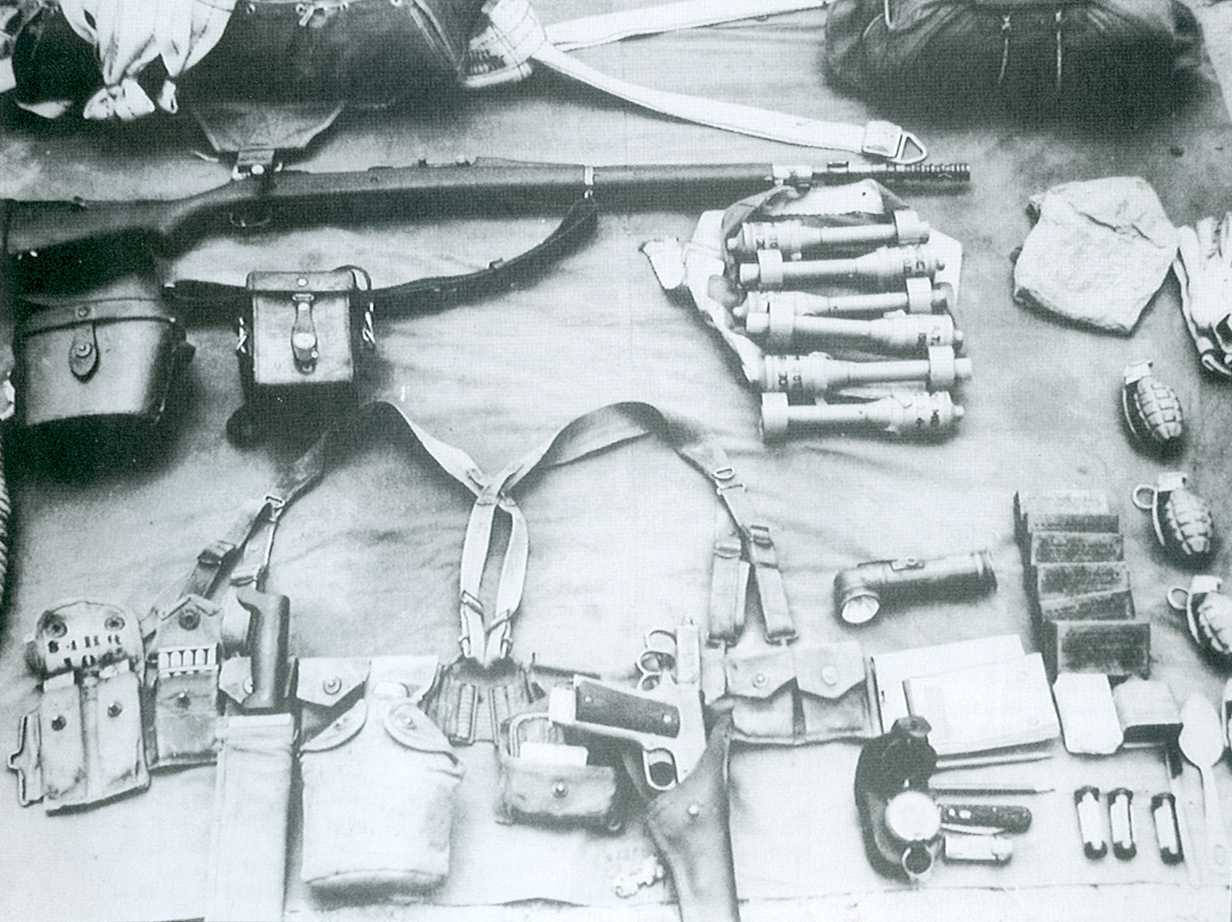
Gear lay-out for a 503rd rifle-grenadier Paratrooper for the reinforcement jump
Date: 15 August 1944
Unit: 1st Abn. Task Force (460th PFA, 463rd PFABn.; 509th PIB; 517th PCT; 551st PIB; 596th PC Eng. Co. Dropping of 300 paratroop dummies, prior to landing)
Operation: Dragoon
Troopers:5,607
Country: France
Drop Zone: Cote d' Azur, Riviera
Aircraft: C-47
Type Air delivery: Day Mass low-level tactical personnel static-line jump, wing shackle bundle drops, Gliders
Allied invasion of Southern France, staged from bases in Italy. Parachute and glider assaults provided the spearhead for an amphibious invasion of the French Riviera between Cannes and Toulon. The DZs and LZs were located inland near Le Muy, where troopers were to perform much the same tasks as in Normandy. Added to the list, however, was the job of preventing fleeing German forces from escaping into the interior. This operation, like Normandy, was successful. Most Troop Carrier crews flew two long missions on D-Day: one paradrop and one glider tow. More than 850 Troop Carrier sorties were flown, of which slightly more than half were on the parachute missions. Approximately 9,100 troopers were delivered, along with over 200 vehicles and 200 artillery pieces, plus approximately 500 tons of others supplies and equipment.
VIDEOS: Operation Dragoon
 www.youtube.com/watch?v=PhdMuDp-YGI
www.youtube.com/watch?v=PhdMuDp-YGI
Part 2
 www.youtube.com/watch?v=3PfUEWlGlc8
www.youtube.com/watch?v=3PfUEWlGlc8
Holland

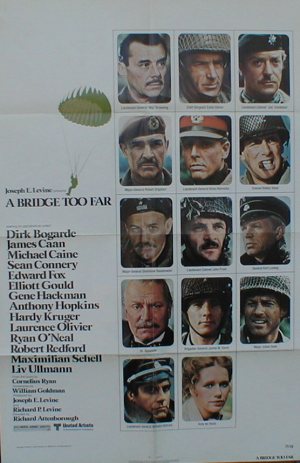

1st British Airborne Division General Urquart played by Sean Connery
Beginning
 www.youtube.com/watch?v=6pnv6odQ4oQ
www.youtube.com/watch?v=6pnv6odQ4oQ
Idiot Browning who miss-planned the operation
 www.youtube.com/watch?v=f4BT4S_peV0
www.youtube.com/watch?v=f4BT4S_peV0
Horrock's Briefing
 www.youtube.com/watch?v=Om0yG23KUpU
www.youtube.com/watch?v=Om0yG23KUpU
Take-Offs
 www.youtube.com/watch?v=dJuJBGIZtcc
www.youtube.com/watch?v=dJuJBGIZtcc
Jump Sequence from the Movie

 www.youtube.com/v/lfv-19f8ZG8
www.youtube.com/v/lfv-19f8ZG8

XXX/30 Corps Starts Attack Under Rolling Barrage--no Cavalry to Clear-out Anti-Tank Guns, ambushed repeatedly up single land road
 www.youtube.com/watch?v=7mjISsv5JYA
www.youtube.com/watch?v=7mjISsv5JYA
101st Loses Bridge that Slows 30 Corps Advance
 www.youtube.com/watch?v=Tt4WdpOF4yg
www.youtube.com/watch?v=Tt4WdpOF4yg
Rebuilding the Son Bridge
 www.youtube.com/v/oTrO-B9sx3g
www.youtube.com/v/oTrO-B9sx3g
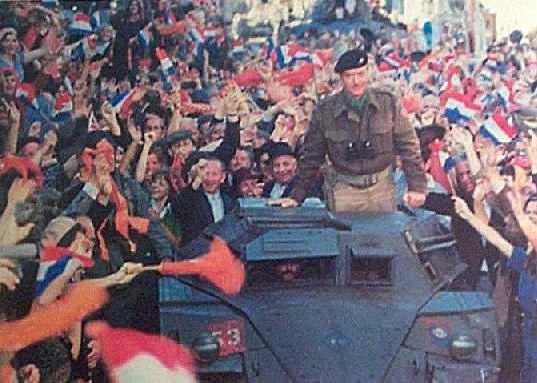
XXX Corps under Joe Vandeleur get stuck in traffic
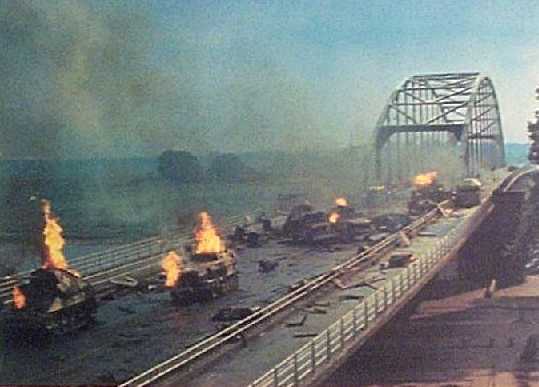
British Paras under John Frost annihilate German wheeled armored cars on Arnhem Bridge (predictable path can't go cross-country to out-flank the Brits)
Wheeled German Attack incinerated Over Arnhem Bridge
 www.youtube.com/watch?v=yiiUJ4sDuX0
www.youtube.com/watch?v=yiiUJ4sDuX0
General Gavin Acts Major Julian Cook to Assault Nijmegan Bridge
 www.youtube.com/watch?v=ACiWrHFMeYY&feature=related
www.youtube.com/watch?v=ACiWrHFMeYY&feature=related

82nd Airborne Paratroopers take Njimegan Bridge
A Bridge Too Far Nijmegan Bridge Boat Assault
 www.youtube.com/v/Lj6sbcyVsqw
www.youtube.com/v/Lj6sbcyVsqw
Date: 17 September 1944
Unit: 82nd Airborne Division (with 508th), 505th RCT, Includes: 505th PIR, 456th PFA, & Co. B, 307th Engr.; 504th RCT, Includes: 504th PIR, 376th PFA, & Co.A, 307 Engr
Operation: Market Garden
Troopers: 7,250
Country: Holland
Drop Zone: Grave & Nijmegen
Aircraft: C-47, CG-1 gliders
Type Air delivery: Day Mass low-level tactical personnel static-line jump, wing shackle bundle drops, Gliders
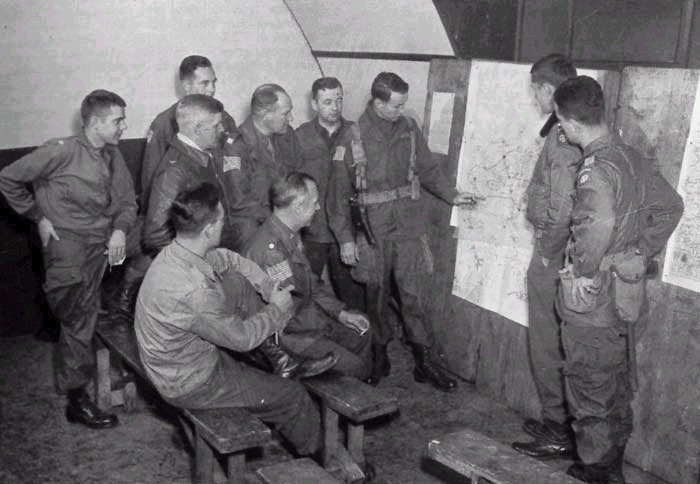
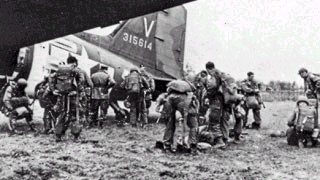
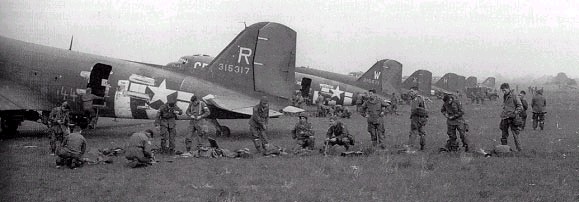
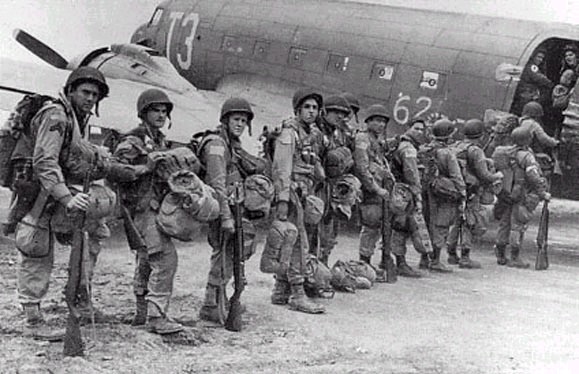
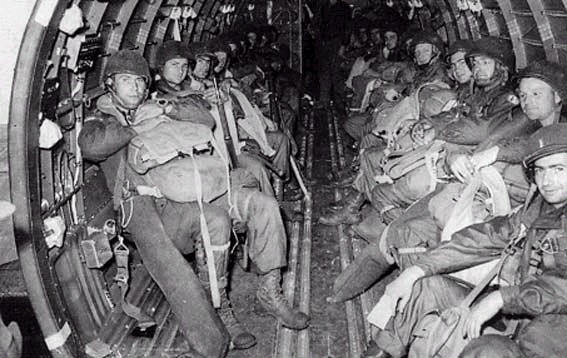
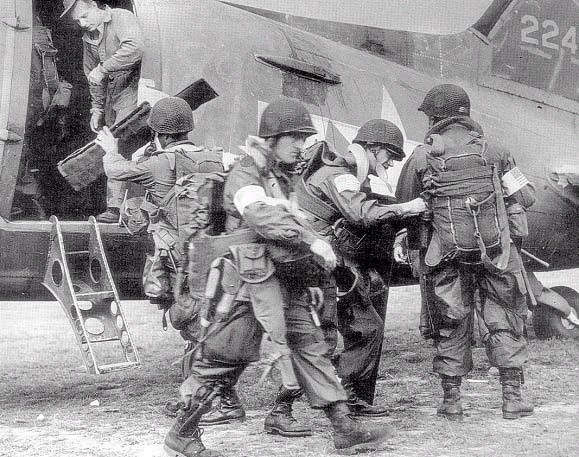
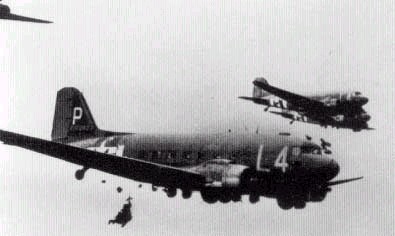
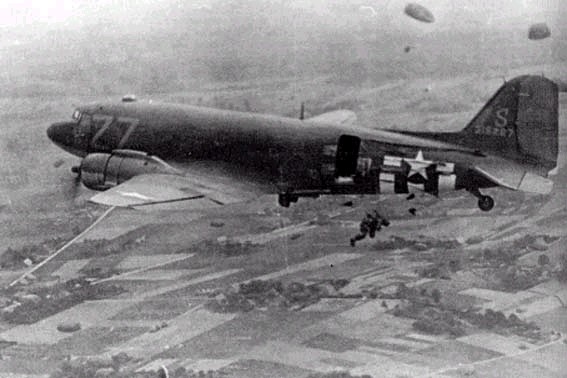
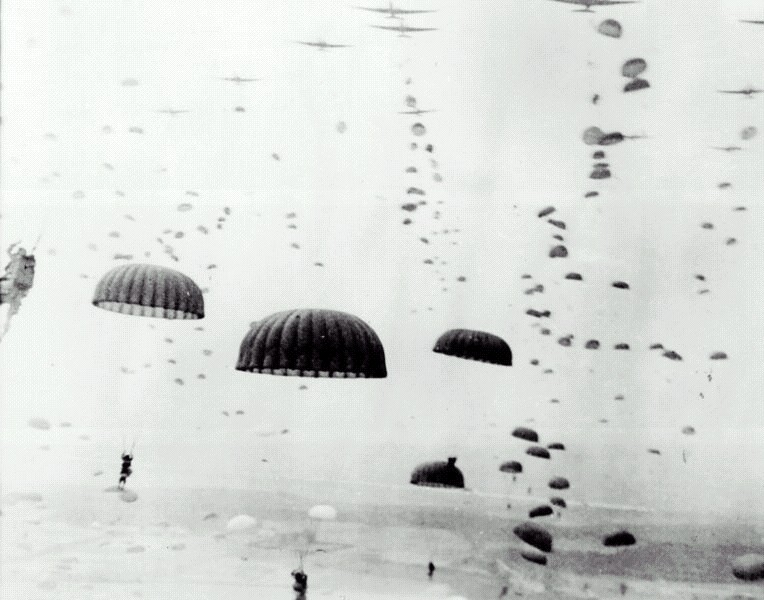
VIDEOS: WW2 C-47 Re-Enactments
Paratrooper's Eye View of C-47 static-line parachute jump
 www.youtube.com/watch?v=3v7e5mKh708
www.youtube.com/watch?v=3v7e5mKh708
Paratroopers Mass Tac from C-47s from the epic movie "A Bridge Too Far"
Part 1
 www.youtube.com/watch?v=SuCdnZVZyE4
www.youtube.com/watch?v=SuCdnZVZyE4
Part 2
 www.youtube.com/watch?v=RTq9QYy81b8
www.youtube.com/watch?v=RTq9QYy81b8
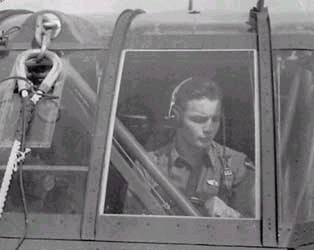

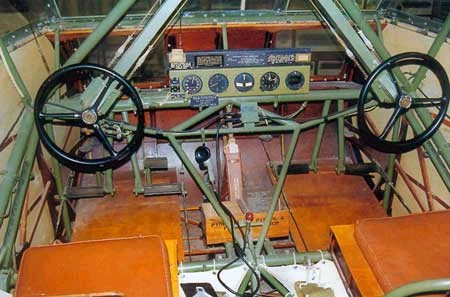
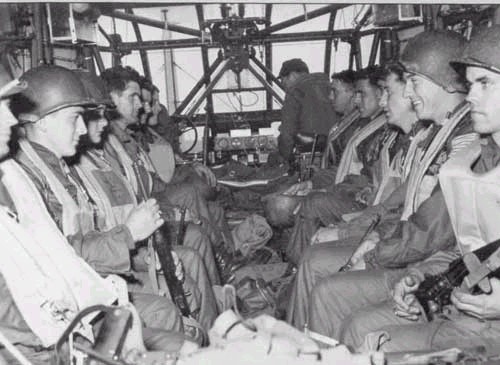
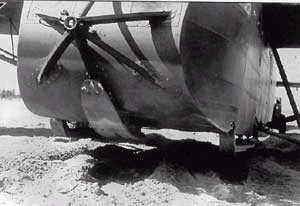
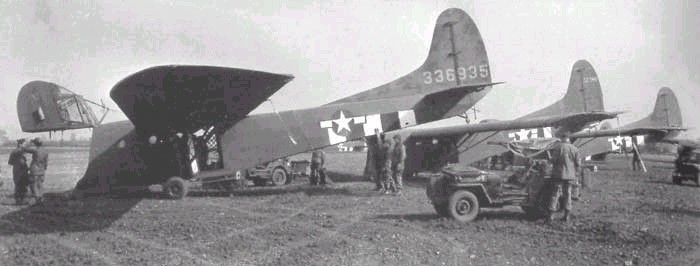
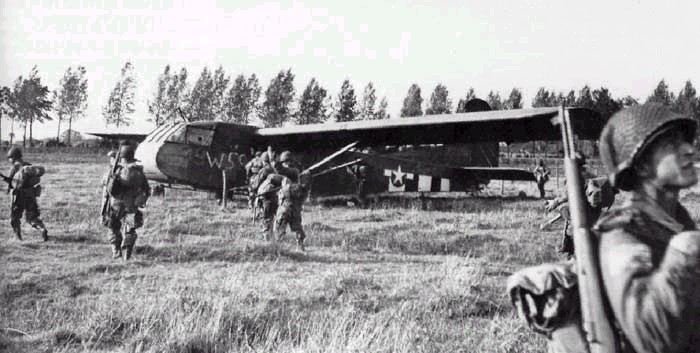
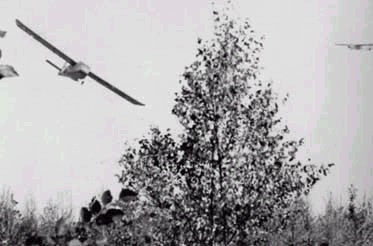
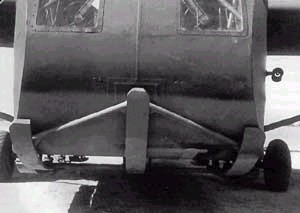
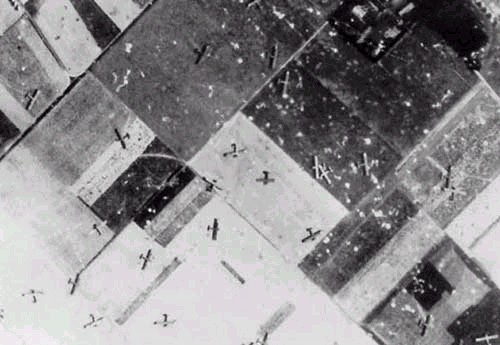
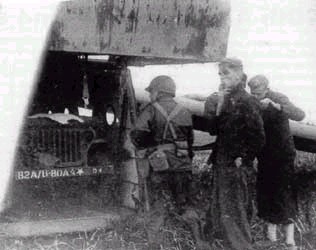
Date: 17 September 1944
Unit: 101st Airborne Division [501, 502, 506]
Operation: Market Garden
Troopers: 6,769
Country: Holland
Drop Zone: Eindhoven
Aircraft: C-47, CG-1 gliders
Type Air delivery: Day Mass low-level tactical personnel static-line jump, wing shackle bundle drops, Gliders
Arnhem: Bridge Too Far or We Didn't Bring Enough?
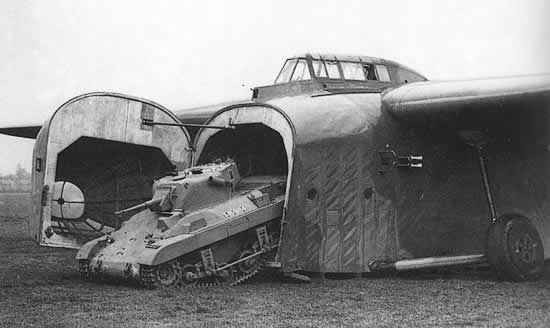
British Tetrarch light tanks
Were glider-airlanded in WWII during the D-Day invasion, where were they at Arhem?
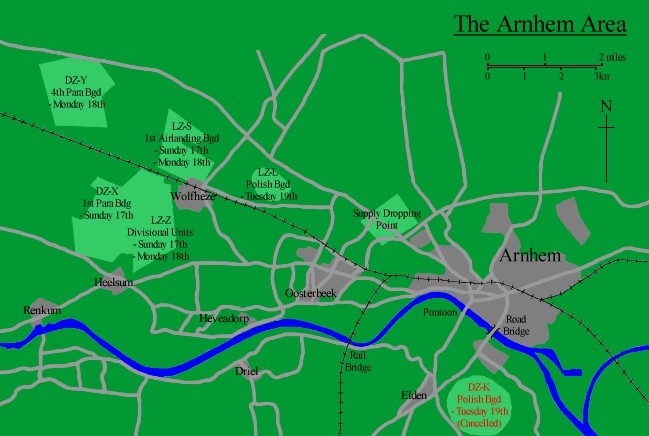
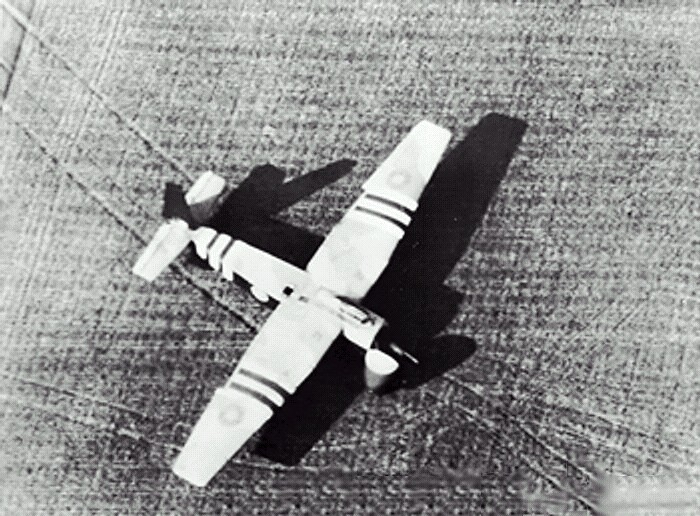
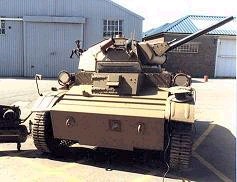
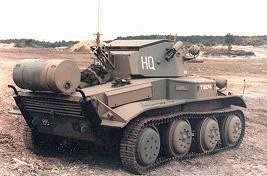
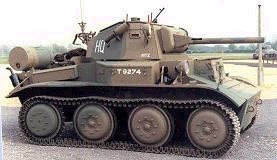
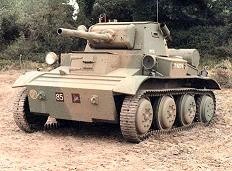
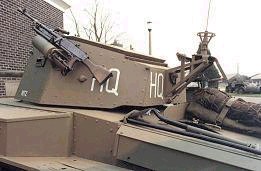
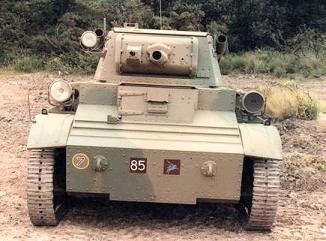
MYSTERY: the British tank museum's Tetrarch light tank has a 3-pounder gun for fire support as shown above. So don't even try to whine about these light tanks being inadequate to kill heavier German tanks, they were needed primarily to BLAST GERMAN INFANTRY OUT OF BUILDINGS, BUNKERS AND DUG-IN POSITIONS. This was known AT THE TIME as proven by the Tetrarch with the 3-pounder gun. Yet we only know the 6th Airborne Division having an Armored Reconnaissance unit with light tanks, not the 1st Brititsh Airborne which landed near Arnhem. The photo above of a Hamilcar at a landing zone west of Arnhem adds to the mystery as SOMETHING has rolled off its front nose ramp. We also know 412 Hamilcar heavy gliders were built so the question arises WHY DIDN'T THE BRITISH GLIDER-LAND A FORCE OF 100-400 LIGHT TANKS AND BREN GUN CARRIERS WEST OR ARNHEM AND PUNCH THEIR WAY THROUGH TO REINFORCE LTC FROST'S MEN?
The puzzling question is where were the light tanks?
www.combatreform.org/airbornetanksnoexcuse.htm
Heavy Lift Gliders + Bren Gun Carriers = Airlanding Troops with Armored Mobility
Heavy Lift Gliders + Bren Gun Carriers + 75mm Pack Howitzers = Airlanding Troops with Armored Mobility + Firepower
Why didn't 57mm and 75mm guns get attached to some Bren gun ultra-light tankettes "mini-STUGs" deployed by gliders to punch through German resistance to reinforce the German paras at Arnhem bridge? Stopping to unlimber a towed 57mm/75mm gun to fire is not the shock action of a STUG.
www2photo.mimerswell.com/tanks/gb/ligh/carr/carr.htm
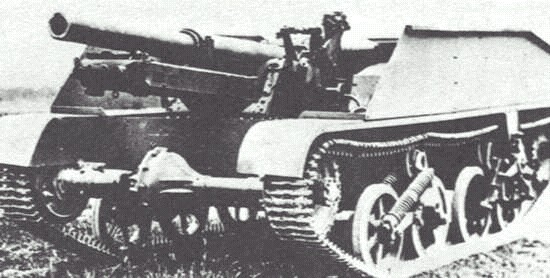
Here a 25-pounder AT gun on a Bren could clearly have blasted through even German medium and heavy tanks blocking the way to Arnhem bridge...
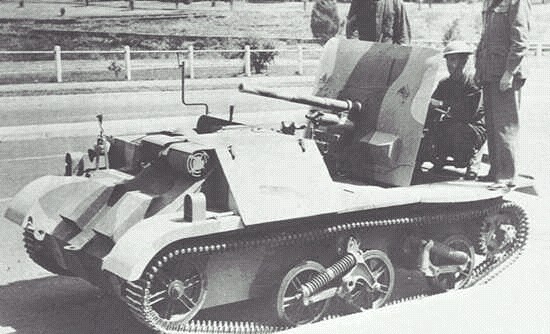
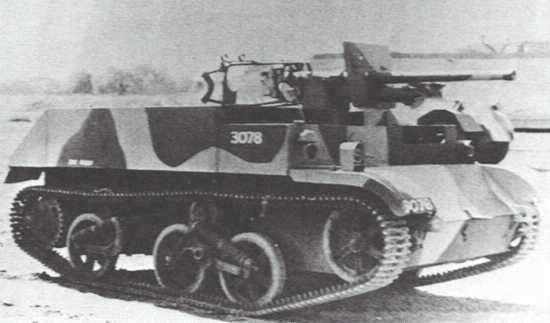
Smaller 2-pounder AT guns on Brens could have blasted the way through lesser vehicles, dug-in and barricaded Germans to Arnhem...
Why didn't the 1st British Airborne glider-deliver these "Mini-STUG" Bren tankettes with AT guns so they could have punched through German opposition to consolidate and hold Arnhem bridge?
It wasn't "a bridge too far" it was a case of the Airborne NOT GOING FAR ENOUGH in its force structure and tactics to have their own mini-STUGs.
The British 6th Airborne Hamilcar glider airlanded Tetrarch light tanks on D-Day....was the 1st Airborne Division ignorant of this practice? What about Bren gun carrier tankettes? In the documentary below they sing the praises of the 75mm pack howitzer...why didn't anyone mount a 75mm pack howitzer on a Bren gun carrier making it a "Pack Howitzer Carrier"? With such mobile firepower, the British Airborne could have punched through to reinforce LTC Frost at the road bridge and hold it long enough for even the slow mechanized XXX Corps to arrive.
Arnhem According to Gavin
1. According to General Gavin in Airborne Warfare (1947) two measley German wheeled armored cars stopped the 3rd and 1st battalions of the 1st British parachute brigade following a railroad track from getting to the Arnhem bridge held by LTC Frost's 2nd Battalion. When a 57mm anti-tank gun being towed by an unarmored wheeled Willys jeep tried to get into firing order, it was blasted by the armored cars.
Canadian, Tim Brown's war game professionalism [http://saskminigamer.blogspot.com/2007/06/tiger-route.html] puts 99.9% of the Army and marine corps types on active duty to shame.
The FACTS are that NO TANKS opposed the 3rd Battalion of the the 1st British Airborne Division they were simply fucked up lacking the minimum of self-propelled, ready-to-fire weaponry on a tracked armored vehicle to overcome just a little German resistance by men with hand weapons. Tim says:
"This was the path to be taken by L.Col Fitch's 3rd Parachute Battalion along the Utrecht-Arnhem highway. The battalion was to sweep into Arnhem from the north and link up with Frost's 2nd Battalion at the bridge. In his way, however was the 16th SS Grenadier Training and Reinforcement Battalion commanded by Major Sepp Krafft (and later elements of the 9th SS panzer Division!)."
In airborne operations you must SEIZE THE DAY! the day you arrive is your opportunity to strike the enemy when he's not ready and take things like Arnhem bridges. If you let yourself get stopped by reaction forces THEN you open yourself to his "panzers" opposing you.
2. The failure of the British Airborne to move the 6-8 miles from their drop zones west of Arnhem to reinforce Frost at the Bridge ruined the entire operation which was to be a bridgehead across the Rhine river.
LESSON #1: Quantity (mass)
Its clear the British fucked up Operation Market-Garden by war weariness and a lack of willingness to suffer casualties in the face of a mere pair of armored cars. The truth is that the Airborne forces did their job to include holding Arnhem bridge for several days and XXX Corps in mechanized armored Bren gun carriers, half-tracks led by Sherman medium tanks took too long to link-up stymied up a narrow single-lane highway. Where was Percy Hobart's 79th Armored Division with the "funnies" tanks to include amphibious LVT-4 Buffalos that could swim across rivers? The relative of an 82nd Airborne Arnhem veteran writes:
"Uncle XXXX said that when they took the northern end of the Nijmegen Bridge, the Brits said something to the effect of, 'Thanks chaps. We'll be across in the morning.' He said that Gavin had to have his MPs hold Julian Cook's regiment at gunpoint to prevent them from comandeering the British tanks and taking them up the road themselves. They were furious. Had they known the Brits would hold in place until morning, they could have paddled across the river at night and taken far fewer casualties. They took 50% casualties taking the bridge. Uncle XXXX died over 40 years ago from wounds suffered in the Battle of the Bulge - quadrapalegic and had kidney failure - but he was adamant that they could have made it up the road to the Brits. He was a very direct guy and not prone to BS'ing."
While the Allied Airborne in general did not fail the mission, it did fail themselves when it could have held on long enough even for XXX Corps to arrive had the 1st British Airborne had its act together better. If you are not willing to lose men and lack the mobility to move several miles quickly because you are foot-slogging, you damn well better jump DIRECTLY onto the bridge and have someone willing to fight hard to do it, namely General Gavin's 82nd Airborne do the job. Gavin would have likely jumped in at NIGHT directly onto the north and south of Arnhem bridge to evade anti-aircraft fires and used aircraft bombing to precede the effort to suppress what couldn't be avoided. Another possibility would have been using gliders at higher altitudes and sneaking in to the bridges Eban Emael and Orne River Bridge-style to get by the AAA guns.
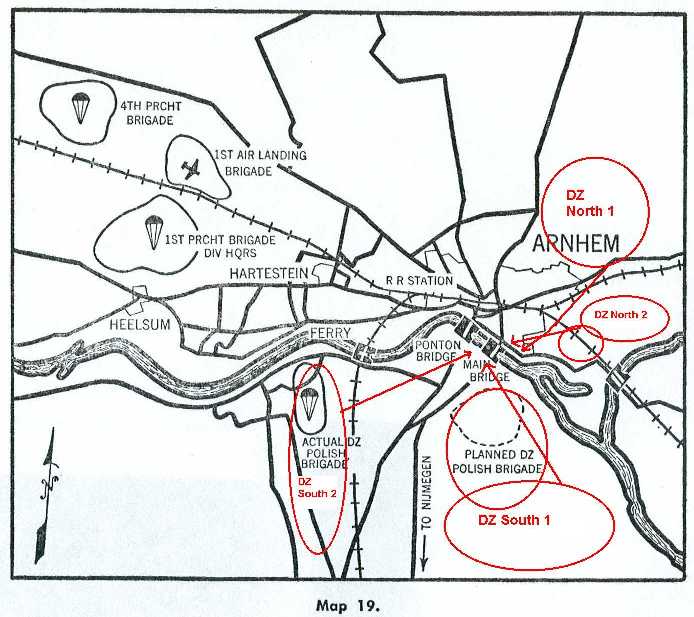
The majority of the 82nd would have then arrived in concentrated form and held the bridge and a nearby resupply drop zone insuring a successful mission. The 101st should have then taken Nijmegan bridge and Groesbeek heights with the 1st British Airborne taking the lower bridges and being relieved first by XXX Corps in motor vehicles. Gavin cites a lack of airlift during Market-Garden to drop all paratroopers and launch all gliders at the same time, therefore having the Arnhem assault echelon jump in at night and a few hours later the other elements during the day would have enabled the planes to return to base and be loaded up for the day time assaults. The 1st Allied Airborne Army being led by the British General Browning who were the weakest practitioners of airborne warfare and not someone from the British 6th Airborne Division who aggressively used gliders to deliver light tanks and stand-off glider surprise attacks or having General Ridgway in command was a fatal mistake.
LESSON #2: Quality (aircraft precision firepower)
Where was the excellent IX Air Force P-47 fighter-bomber close air support (CAS) when the British ran into the German armored cars and panzer tracked tanks leading to Arnhem? It seems that they didn't have the CAS ground forward air controllers (GFACs) that the American forces had and thus should not have been given the toughest assignment of taking Arnhem bridge if they were the weakest force.
LESSON #3: Quality (self-propelled anti-tank vehicles)
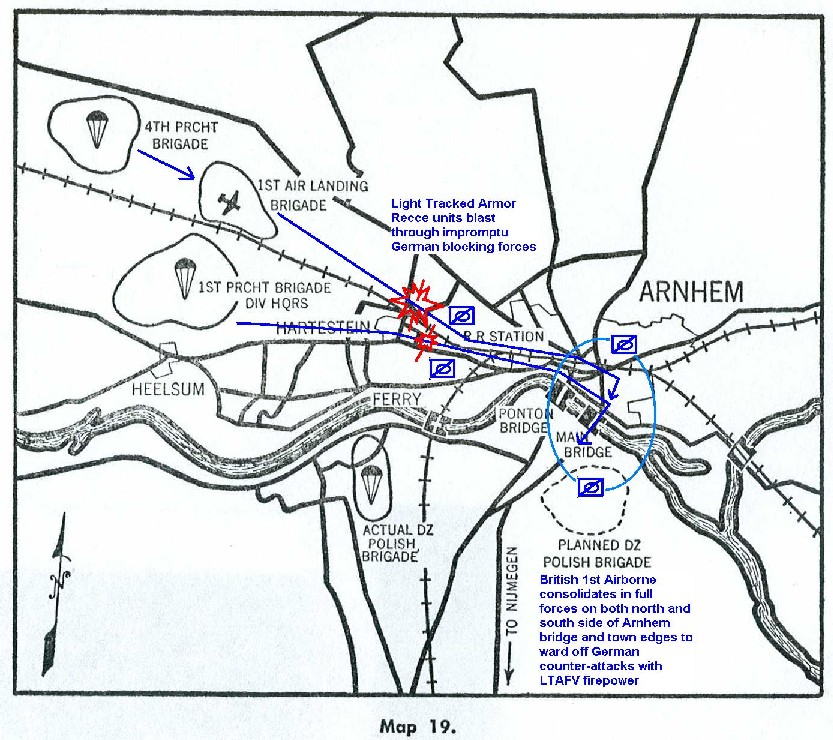
Moreover, the 1st British Airborne division had at least 13 x Hamilar gliders capable of delivering 13 light tanks or 26 Bren gun tankettes. We know for a fact that the 2nd Battalion of the Paras had at least one Bren gun carrier, tracked AFV.
This was the D-Day allocation so more Hamilcars may have been available since 412 total were built during WW2. Proof that the Bitish Airborne had glider-landed 17-pounder, jeep-towed, anti-tank guns and Bren gun carriers:
www.pegasusarchive.org/arnhem/frames.htm
"The men of the Reconnaissance Squadron, together with one of the 2nd Battalion's Bren carriers, were to carry out this task, and Frost told Gough that it would be his chance to win his family's fifth Victoria Cross."
Pegasus Archive founder, Mark Hickman states: "I was under the impression that each para battalion had only the one Bren carrier, though I think the single Hamilcar each battalion had would be capable of carrying another."
www.pegasusarchive.org/arnhem/war_1stBatt.htm
1400 - New positions consolidated in area X rds 726778. By now we were joined by 60 men of the 3 Para Bn under Capt Dorrien Smith, and 1 17 lb gun and 4 6 lb guns of 1 A.L. A/Tk Bty. We also had one carrier. This position was held against increasing opposition from the east and north.
1930 - Withdrawal to area railway bridge 712774. The night was spent in preparing posns with 1st Bn on the right, 11 Bn on left and 3 Bn in centre. During the night there was some enemy shelling and mortaring. Casualties during the day were about 6 killed and 20 wounded. The carrier and the 17 lb A/T gun were knocked out.
Unlike their brother 6th Airborne that landed at Normandy with Tetrarch light tanks, the 1st doesn't seem to have even had a reconnaissance element with light tanks. Jeeps with machine guns don't cut it against armored vehicles. First off, what the hell was the 6th Recce Squadron of the 6th Airborne Division doing in September 1944? Did they have something more pressing than say little ole' WW2? Why wasn't the 6th Recce Squadron which HAD LIGHT TANKS cross-attached to the British 1st Airborne seeing they would need their mobility and firepower to bust through the 6-8 miles to Arnhem if the Germans reacted with impromptu blocking forces? Why weren't Bren gun carriers modified to have 75mm pack howitzers in a ready-to-fire condition and supplied to Freddy Gough's Recce squadron in the 1st British Airborne since they only had vulnerable jeeps? Just a few Brens with 75mm guns could have taken out the two German armored cars and enabled the 3rd and 1st battalions to link up with Frost at Arnhem bridge on the first day, securing the victory and providing enough combat power to stay certainly until the 23rd when XXX Corps finally arrives at Driel, south of the bridge. According to the details below, the 1st Recce had 20mm cannon towed by their jeeps, why couldn't they have been employed against the German armored cars? The excerpt below from their Arnhem war diary indicates the Polsten 20mm guns were used in combat. Its clear that the inability of towed guns to fire instantly when threats are encounted DAMNED THE ENTIRE OPERATION.









www.pegasusarchive.org/arnhem/war_recce.htm
1645 - Polsten sections leave to support A and D Troops who are under strong pressure from the enemy. Section fire on their objective. Lieut Christie killed whilst attempting to save Jeep and Polsten.
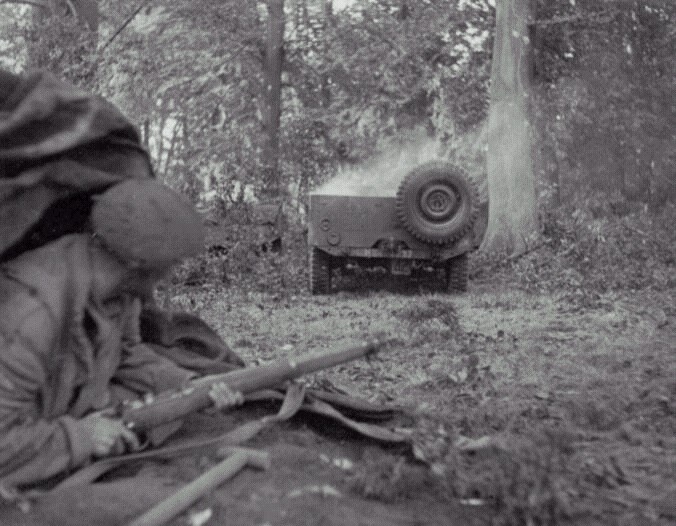
Vulnerable, unarmored jeeps are easy to knock out
Polsten expert, Colin Stevens, where we got the great pics writes:
"Book on Recce Sqn - I used to have it but sold it to a friend. If you see a copy for sale I'd be interested.
Yes they had a single Vickers K (Vickers Gas Operated aka properly known as Vickers G.O.) on each of the Recce Sqn jeeps. Several of the jeeps failed to arrive at Arnhem so they were understrength.
'In addition they had 2 x 20mm Polsten cannons carried behind the jeep. The Polsten cannons were an Anti-Aircraft gun but due to its high firing rate was a very effective ground weapon.'
There were two single towed Polsten 20mm Airborne guns for the entire squadron. I have a rare original manual for this gun, and a rare brief booklet about the AB 20mm at Arnhem. I am away from home but as I recall, the barrel of one gun was bent upon landing and was thus out of action. The other gun remained in action. One of the famous Arnhem wrecked jeep photos shows the jeep that towed this gun. It was in action just North of the Hartenstein Hotel (where AB museum is now) in Oosterbeek. I have some of the 20mm shell casings dug up by a Dutchman from that site.
The AB had 6 Pr and 17 Pr anti-tank guns at Arnhem. I saw and photographed three of the shot-up 17 Pounder guns are at the Airborne Museum on display on the grounds when I was there in May 2005.
My own jeep I believe served with 1st Airborne Division as a replacement vehicle for those lost at Arnhem. I believe they took it to Norway in May 1945 and left it there. The Norwegians used it until 1985! I do not know the British WD number or other British markings unfortunately. The jeep has British modifications including the blackout lights being moved to the fenders (wings) as clearance lights (the Norwegians put them back into the grille) and including the airborne stowage rack mounting holes on the fenders. Presently the jeep is painted for my old regiment (Seaforth Highlanders of Canada) but I plan to put it back to British Airborne markings.
COLIN STEVENS
www.airbornerecce.com/oca/1stars.htm
1st Airborne Reconnaissance SquadronA BRIEF HISTORY
"Leading the way (into Arnhem) would be a motorised reconnaissance squadron of jeeps and motorcycles. General Urquhart was counting on Major 'Freddie' Gough's highly specialised force of some 275 men in four troops - the only unit of its kind in the British Army - to reach the highway bridge and hold it until the main body of the brigade arrived "
Extract from A Bridge Too Far by Cornelius Ryan
The Squadrons' History
By April 1943 the Sqdn had been made up to strength of about 250 men and was stationed at Bulford near Andover when it left for North Africa via Liverpool on the troopship Staffordshire with the rest of the 1st Airborne Division. After a few days acclimatisation inland from Oran in Algeria the unit picked up its vehicles, jeeps and motorcycles. After a few more days the Jeeps and their drivers with Motorcycles and other unit gear in the trailers left on a 1000 mile trip to Msaken near Sousse in Tunisia. The rest of the unit went by train.
Training continued but was switched to loading gliders and towing them about the airfields to place them at the rear of the tug planes ready for the invasion of Sicily in July.
After returning to normal training, in September the Sqdn loaded its jeeps and m/cycles onto the famous light Cruiser USS BOISE because there were no gliders left after the Sicily drop. Also on board were 5 under strength Sqdns of the S A S and 25 men of Popski's Private Army. With the British Cruisers Penelope and Abdiel carrying the rest of the Division they entered Taranto Harbour to offload. Unfortunately the Abdiel hit a mined barge and sank in the harbour losing much of the division's artillery and the Sqdn's 6 pounders. The Sqdn left straight away for its task of exploring the route to the Bari on the East Coast via Massafra and Motola to Gioia del Colle, running into some German opposition and suffering some casualties. After a brief stop the Sqdn moved on towards Bari where it was the first British Unit to enter the town and again after a brief stay moved on where it took the Airfield at Foggia. From then the Sqdn was especially active, being always in the front of the advance.
Amongst the losses were some men from B troop which was never reformed.
In November, the Sqdn moved back to North Africa and left Philippeville in Algeria, some on the (sick) Duchess of Bedfordshire (so called as she had no stabilisers and rolled alarmingly) and others on the Monarch of Bermuda getting back to the UK in time for Christmas. (Actually, the Duchess hit the Monarch in the Med - a Zig Zag went wrong - and the Monarch had to dock in Gibraltar for temporary repairs but still got back to the UK for Christmas)
After a very brief stay at Spalding the Sqdn moved to Ruskington just north of Sleaford in Lincolnshire and stayed there for the next 9 months until the battle of Arnhem in September.
In February 1944 Major Gough told the Sqdn that it had been decided that while its vehicles and drivers would go into their next operation in gliders the bulk of the Sqdn would have to jump and they would have to volunteer to be paratroops. (Most had been posted to the Sqdn as it was a glider unit, one had to volunteer to become a paratrooper). He told the parade that any man who did not wish to volunteer should take a step forward - and no one moved. Training took place at Ringway with jumps into Tatton Park and intensive training continued. The unit was retitled 'Airborne' - not 'Airlanding'.
In accordance with Recce policy the firepower of the jeeps was substantially upgraded. Every jeep had a Vickers "K" .303 caliber machine gun mounted with a round magazine holding 96 rounds. In addition they had 2 x 20mm Polsten cannons carried behind the jeep. The Polsten cannons were an Anti-Aircraft gun but due to its high firing rate was a very effective ground weapon. They also carried standard infantry weapons including two 3" mortars and 2" mortars, a Bren Light machine gun, standard rifles but with sniper sights, a PIAT (ant tank) gun and many and various hand grenades. Most men had a Sten submachine gun and the Radio Operators, a revolver.
There were several false alarms but at the end of August a seaborne party of some 40 men with the Sqdn transport vehicles left for France designed to collect and re-equip the Sqdn during its next battle.

Then on 17th September 1944, 45 men who had previously driven the Sqdns jeeps and motorcycles and heavy weapons and ammunition to Tarrant Rushton in Dorset flew in Gliders to the Dutch Town of Arnhem, where they were joined 30 minutes later by their 160 comrades who had flown from Barkston Heath Airfild, Lincolnshire and landed by parachute. Two of the 22 gliders (out of a total of 358) allocated to the Sqdn did not arrive so they only had 28 instead of 31 jeeps they should have had. Furthermore several of the Gliders on Landing crashed on the soft soil and it proved very difficult to get the vehicles and equipment out which meant that the Sqdn was quite a bit under strength 'HQ, D & C' Troops headed for the Bridge as a coup de main but were held up by "strong" German opposition and suffered several casualties. 'A' Troop had stayed behind as a reserve as planned. Unfortunately radio communications had broken down and when Freddie Gough got a message to say the General wanted to see him he left for Div HQ taking some of H Q Troop and a few from 'D' Troop with him, By the time he found the General the party he had left behind had returned to the D.Z. and when he left Div HQ, after several skirmishes, got to the bridge where the Sqdn was supposed to be and where there were remnants of several units. Our D.R. Chalky White was sent back to Div HQ and was probably the last man to leave the Bridge.
Those at the Bridge held out until Thursday morning 21st September when they had to surrender because they had no ammunition left. The remainder of the Sqdn under Captain Alsop fought on as part of the force at Oosterbeck from which a few of them (perhaps 2,000 of the original 10,000) escaped including about 30 of the Sqdn on Monday 25th September. That night the survivors met up with the Seaborne party and got new clothing and other gear and the next morning were flown back to the UK arriving back in Ruskington on Friday 29th September at about 9pm.
The full story of the battle of Arnhem is well known and the part the Sqdn played is well documented in the book Remember Arnhem: The Story of the 1st Airborne Reconnaissance Squadron at Arnhem by John Fairley. The seaborne party came back a few days later. The villagers were as devastated as the men by the terrible loses sustained. In fact the loses although high were not as bad as at first suspected and many had been wounded and they and the others who did not return, totalling some 140, were taken prisoners of war.
Shortly after their return of the 30 and the seaborne party, following a period of debriefing and two weeks disembarkation leave, the unit was allocated to barracks at Newark, Nottinghamshire, and reluctantly left Ruskington for ever.
During the winter reinforcements made up the strength to 160 and retraining began. On the 10th May 1945, two days after V E day the Squadron flew with its vehicles to Stavanger, Norway, and quickly moved to Oslo to help organise the withdrawal of German troops. Their mobility was needed to escort German units from some of the more rural areas and they also aided the new Norwegian authorities round up some of the Norwegians who had co operated with the Germans. Whilst they were there they took part in a parade with other Airborne Troops and Russians to welcome Crown Prince Olaf back to Norway after his exile. No medal was issued for this operation as the war in Europe had officially ended but Prince Olaf gave the Squadron a Signed Certificate of Thanks for their part in the difficult task they had successfully completed and members of the squadron who were there were issued with a copy.
In September, the Sqdn returned to the United Kingdom to Broham in Wiltshire from where it was disbanded about 4 years after its formation. The men were dispersed to various other units. The men who were wounded and who had been taken prisoner of war in Italy and at Arnhem returned to this country but not to the Sqdn.
www.airbornerecce.com/oca/6thaars.htm
The 6th Airborne Armoured Reconnaissance RGT. R.A.C.A brief history
"The role of the Light Tank Squadron will normally be the capture of an objective, in anticipation of a quick follow up by part of the Airborne Division, followed by patrolling infront of the main position.
It was agreed that the likelihood of heavy opposition would entail the withdrawal of the Squadron"
That was the role laid down in the unit manual but in fact the Unit used its tanks to defend troops against heavy enemy opposition and led the way of all British troops into Germany against the best enemy units.
In 1941 3 Special Service Squadrons of Tanks were formed from various cavalry and tank units but 2 were disbanded in 1942, the third becoming the Airborne Light Tank Sqdn RAC which moved to the 1st Airborne Division on the Salisbury Plain. When the 1st Airborne Div. With the 1st Airborne Recce Sqdn, went to Africa the Airborne Light Tank Sqdn which had used Tetrarch tanks was transferred to the newly formed 6th Airborne Division. The Hamilcar Glider was designed to carry the Tetrarch Tank. Command of the squadron passed to Major (later Lt.Col.) Godfrey Stewart in April 1943, and he commanded the Squadron, and later the Regiment, for the remainder of the war.
Initialy the unit appears to have 3 Squadrons: A (light tank Sqdn) with 5 troops each with 4 Tetrarch tanks, B (Recce) with 4 troops with scout cars and carriers, a blitz (infantry support) troop on motorcycles and 2 troops of 3" mortars. HQ Squadron had 4 more Tetrarchs, REME, MEDICS, Signals, a resupply unit and 2 troops each with 4 Vickers MMGs. Regimental HQ also had 2 Tetrarchs.
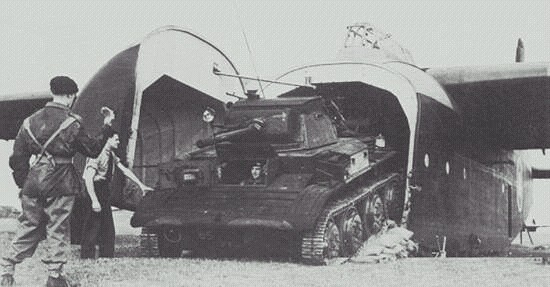
Tetrarch Light Tank being loaded into a Hamilcar Glider
On D Day a small "Harbour Party" of 1 Officer and 15 men flew in with the advance Pathfinder Para Unit to secure the Regimental landing ground. Unfortunately this unit lost its Officer and one stick of men on landing. 20 light tanks and other carriers and vehicles flew in with the second main lift from Tarant Rushton in 30 Hamilcars while others flew in from Brize Norton in Horsas. Some Tanks were lost due to a crash on landing and for a while some tanks were disabled as parachute canopies and rigging getting wrapped round the tracks which had to be burnt off. After 10 days the Unit was withdrawn but the tank units went straight back in their Tetrarchs to support the remaining hard-pressed ground troops. Once again the tank crews were withdrawn but after 10 days retraining went back in with Cromwell tanks and continued supporting the breakout. The Unit was taken out of the line at the end of August and by 6 Sept had regrouped at Larkhil.
There the Unit was enlarged to a Regiment of 4 Sqdns with a compliment of 32 officers and 326 other ranks. The 2 Recce Sqdns each had 4 [M22] Locust tanks when airborne or Cromwells otherwise, and 3 Recce Troops each with 2 carriers and 2 Dingo scout cars. The support Sqdn had 2 MMG troops with 4 Vickers on carriers, a troop with four 4.2" mortars, and a blitz troop on motorcycles.
In December 1944, the Division was sent to France to help with the Battle of the Bulge in the Ardennes and on Monday the 30th December the AARR was involved on the Meuse with the 6th A/B Div with their Cromwells. By 16th Feb the Rgt left for the UK but left a tail, including the Cromwells in Holland. The tail soon found out they were part of the ground force support of the next operation.
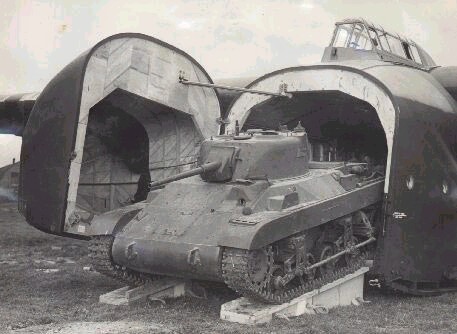
M22 Locust Light Tank
On 24th March, as part of Operation Varsity, 8 x Locust tanks were flown in in Hamilcars along with the troop of 4.2" mortars in Horsas. In fact less flew in "Varsity" than in the D-Day drop. Although the operation was a great success and the battle having been won by nightfall, casualties were very high and of the 8 tanks, only 2 survived fully serviceable. Several tanks and vehicles had been destroyed on landing and casualties were high. The rest of the Regiment had left on 17th March and joined up with the airborne sections on the 26th. The Division continued the advance with the Airborne Armoured Reconnaissance Regiment well to the fore and on several occasions suffered severe casualties, especially at a battle at Minden. On 30th April the Division reached the Elbe and on 3rd May elements of B Squadron met elements of the Russian Stalingrad Armoured Division. 2 days later the war was over and on 16th May the Division was ordered to return home, the Recce Rgt leaving all its Tanks and Carriers in Germany.
Training began for war in South East Asia but as the Japanese surrendered they were reallocated to security duties in Palestine. The Rgt landed in Haifa on 22 Oct 1945 and worked as part of the division facing civil disobedience by both Arabs and Jews and terrorism by Jews.
On 1st Feb the 6th AARR was disbanded and most of the personnel were transferred to the 3rd King's Own Hussars which became a Recce Rgt.
Landing Craft + Trailers + Trucks + Bren Gun Carriers = River Crossings
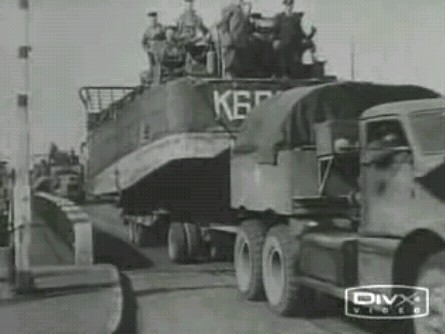
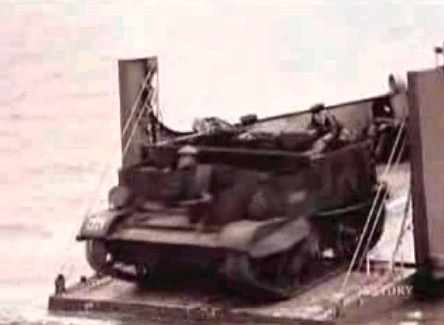
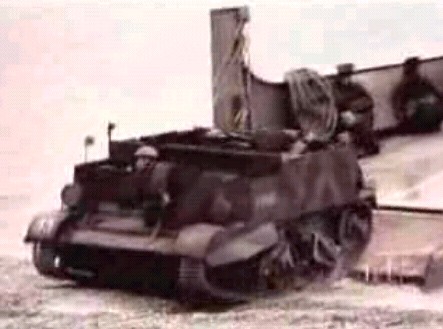
Another weird video fact is you can see Higgins boats---LCVPs on trailers towed by TRUCKS being driven around to cross rivers. Bren gun carriers could be carried and off-loaded by Higgins boats to cross rivers. Why didn't anyone think of this to cross the Rhine and push the Germans off the Arnhem bridge? When XXX Corps finally arrives at Driel, south of the bridge that is now back in German hands, 1st British Airborne on the far bank of the river has to withdraw because wheeled DUKW amphibious trucks can't get supplies to them. Had XXX Corps had TRACKED LVT Buffalo amtracks, they could have resupplied 1st Airborne and kept its river crossing point and built a bridge there to get across. Obviously, if the British Airborne had dropped directly onto the north/south of Arnhem bridge or used light tracked armor to punch through enemy impromptu blocking forces, they would have held both sides of the bridge in divisional strength, so when XXX Corps finally arrived amphibious vehicles wouldn't have been needed---they could drive supplies across the bridge to keep 1st Airborne fighting.
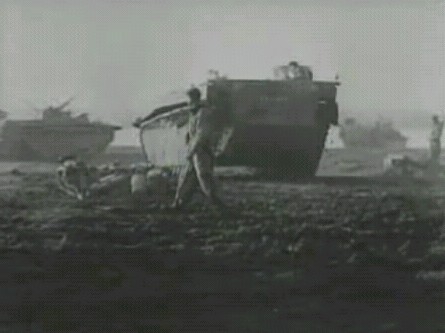
You'll also see LVTs and DUKWs in the video footage...WHERE was Percy Hobart's 79th Division "funnies" which had LVTs when Arnhem was underway to supply amphibious vehicles?
It could also then deliver a LIGHT TANK if it couldn't swim like the M3 Stuart Light tank attached and below on the www:
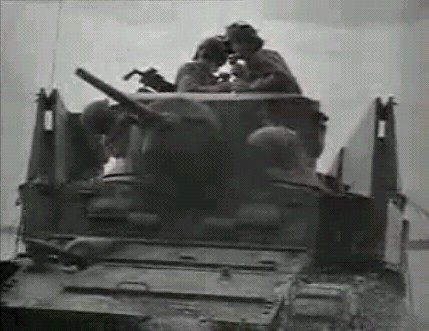
TRACKED AMPHIBIOUS SALVAGE OF OPERATION MARKET-GARDEN, 1944
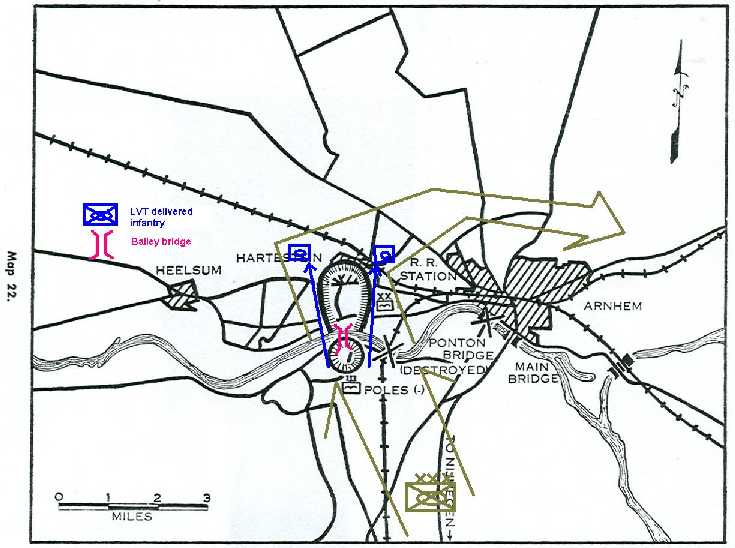
Therefore, had XXX Corps been equipped with enough LVT amphibious tracks organically or by Hobart's 79th Armored Division being attached, when it finally did arrive at Driel on September 23, 1944 instead of withdrawing the 1st British Airborne, it could have pushed across and REINFORCED it. Once the toe-hold was strengthened, a Bailey bridge could have been erected for Sherman medium tanks with 17-pounder guns to cross and ward off the German heavy Tiger tanks and the offensive could have swung around the city of Arnhem and encircled the Germans like the paras were a few days before. Good land armies are able to cross rivers and keep maneuvering.
Of course, its better if your light tanks SWAM themselves across lakes/rivers like the LVTs or today's M113 Gavin and PT76s can...the point here is that if your light tanks don't swim like the M8 Buford/Thunderbolt AGS you are not necessarily "sunk" if you are willing to pay for trucks or better yet XM1108 Gavin tracks towing a flat-bottom Higgins boat on a trailer to wherever the river or lake crossing is required so you can have FAR SHORE COMBAT POWER to hold against enemies with much heavier tanks if your light tank has the firepower to kill them. The combat engineer force reinforced by a CAVALRY in light tanks can seize a bridge from both sides 82nd Airborne @ Nijmegan-style or proceed to build their own bridges for the medium-to-heavy vehicles of a 2D maneuver force to cross.
Operation: Market Garden Overview

VIDEO: BBC BATTLEFIELDS: Arnhem
This is THE BEST documentary on Operation Market-Garden to date. Professor Richard Holmes walks the exact battlefield locations and explains how and why it unfolded showing the STRATEGIC consequences and most importantly does not leave those who failed by incompetence off-the-hook with typical BS hero worship so we might actually LEARN SOMETHING from the tragic events.
Part 1: Holmes: WW2 could have been shortened by at least 6 months had we crossed the Rhine and got to Berlin before the Soviets
 www.youtube.com/watch?v=-UIGaM5iXtc
www.youtube.com/watch?v=-UIGaM5iXtc
Part 2: XXX Corps lacking a light tracked cavalry doesn't clear out enemy anti-tank guns expecting WW1 style rolling artillery barrage to do its work, Germans let 8 medium tanks go by then destroy 9. Why couldn't low ground pressure Bren gun light tracked APCs and infantry have gone ahead of the high ground pressure Sherman medium tank main body going cross-country adjacent to the single highway?
 www.youtube.com/watch?v=O3km0HCZbPw
www.youtube.com/watch?v=O3km0HCZbPw
Part 3: U.S. General Brereton ruled out night drop directly on the bridge resulting in only half 1st Airborne delivered during the day 6-8 miles away to avoid AAA, then 1/2 of them had to hold the landing zones and couldn't move on to the bridge, unarmored wheeled jeeps can't breakthrough ad hoc infantry blocking force to Arnhem bridge, no radio comms to inform battalions stopped to change direction and take LTC Frost's route that was open, Major Hibbert radioed to HQs to take river route but they replied they were tangled up with the Germans---where was the reserve? XXX Corps stopped for the night after only 7 miles beyond start line? Can't fight forward at night? General Urquart trapped in Arnhem can't command his division
 www.youtube.com/watch?v=ABWmB18iIvs
www.youtube.com/watch?v=ABWmB18iIvs
Part 4: Urquart and his men hide in attic for 36 hours!, XXX Corps reaches 82nd Airborne but Frost's perimeter of buildings is being burned down by tanks firing HE to create a hole in the wall, then WP through that, Horrocks decided with Gavin to cross Waal river in boats in daylight to take Nijmegan bridge, Colonel Tucker asks if British tanks will be ready to charge through to Arnhem, and he says yes. 82nd Paras paddle across when they should have had their own amphibious light tracked AFVs to swim across with protection
 www.youtube.com/watch?v=y2O8j3U_iHQ
www.youtube.com/watch?v=y2O8j3U_iHQ
Part 5: 82nd Airborne infantry offer to clear AT guns beyond Nijmegan bridge to get to Arnhem but they wimp out and refuse to move forward at night which would have shielded them, NOTHING STOOD IN THEIR WAY TO ARNHEM!! Frost's 750 men killed/captured even though they held for 3 1/2 days when 3, 000 men were to hold for 2 days....the failure here raises the sociological weakness of those who fight from armored tanks lacking the courage of those without armored cocoons clearly those with the courage to fight without armor like Airborne troops should have their own light tracked amphibious armor to use as needed when ground mobility is required, remaining 3, 500 1st Airborne Division Paras still holds a Osterbeek pocket north of the Rhine river with a ferry boat where a bridge could have been erected to still get across and make the operation successful,
 www.youtube.com/watch?v=LYs0pbtoXJ0
www.youtube.com/watch?v=LYs0pbtoXJ0
Part 6: Poles in rubber boats can't reinforce the 1st Paras so they are evacuated, Professor Holmes concludes had we crossed the Rhine millions of people could have been saved by beating the Soviets to Berlin, Amen
 www.youtube.com/watch?v=4ApkOygrHII
www.youtube.com/watch?v=4ApkOygrHII
Late summer 1944, after the invasion of Normandy by the Allied forces the front lines stalled at along the Meuse river and just beyond Antwerp in Holland. In Holland was the 21st Allied Army Group commanded by Gen. Montgomery. Gen. Bernard Montgomery was a famous general for defeating the German Afrika Korps commanded by Gen. Erwin Rommal in the sands of North Africa. American Gen. George S. Patton commands the armies along the Muese river and demands supplies so he can cross into Germany. In supreme command is General Eisenhower of all allied forces in Europe. Gen. Montgomery called Gen. Eisenhower to his HQ in Belgium to present a plan to out flank the formidable Rhine river and invade the Rhur river valley where all of Germany's industry is to end the war.
The Plan:
The plan calls for the Allied 1st Airborne Army of the British 1st and American 101st and 82nd Arborne divisions to be dropped into Holland to secure strategic bridges. The British 1st Airborne Division known as the "Red Devils" are to land at Arnhem and attempted to secure the massive bridge across the lower Rhine. As a backup they are to capture the railway bridge encase the other bridge cannot be taken. While this is happening, the American 101st Airborne "Screaming Eagles" would drop into the Eindhoven Sector and attempted to capture the bridges for the British XXX Corps that had broke through the front line of defense and was racing towards the bridges that were held by the airborne troops. In the middle, between Arnhem and Eindhoven was the vital bridge at Nijmegen, this was left up to the American 82nd "All Americans" Airborne Division.
September 17, 1944
British Lt. Gen. Brian Horrocks commander of the British XXX Corps gives the go ahead for the armored divisions to smash ahead through the German front lines. The corps goal is to slash 60 miles along a single highway to the airborne troops all in two days. Allied G2 (intelligence) believed that there was around twenty battalions defending the front line with almost no artillery support. Really there was only ten very weak positions and almost no artillery at the front. Just beyond the front line the Germans had put up several brand new 75mm anti-tank guns along the road waiting to ambush the tanks. Further back they placed machine gun nests and panzerfausts. U.S. 8th and 9th Air Force bombers and fighter-bomber hit many targets around the breakthrough point and anti-aircraft positions. All over Britain, over 2,000 C-47 Dakotas begin to take off while bombers tow more than 500 gliders loaded with supplies and paratroops. From the six leading C-47's jump the pathfinders that will mark the land zone for the thousands of troops to come. Unrolling large bright strips of plastic and placing radar beacons the pathfinders marked the entire landing zone. Transports carrying the 101st Airborne meet lots of flak but manage to maintain formation. In Eindhoven alone more than 7,000 "Screaming Eagles" landed safely and began to move towards there objectives. In the Nijmegen sector 4,500 men of the 82nd Airborne land around Groesbeek Heights and move towards the bridge. In Arnhem 5,200 men of the 1st Airborne Division and most of its supplies land safely near the landing zones and Coronal Frost's battalion begins to move towards the huge Arnhem highway bridge. All over Holland German units go on alert and move towards the land areas. These include the 16th SS panzer Grenadier Training Battalion and 9th and 10th SS panzer Divisions along with the garrisons of the towns and at the bridges. The American 82nd Airborne had secured the Grave bridge one of there objectives as soon as they landed and moved on to the rest of the objectives. British XXX Corps is ambushed as it charges into enemy lines losing nine of the lead tanks and slowing the column down so that it was not on it's time table to reach Arnhem on time. The British tanks had to stop along the highway and let the infantry sweep the woods along the road for German troops. By 1330 hours the lead patrols of units of the 1st airborne division reached Arnhem bridges and the outer limits of the city. The defense of Arnhem is provided by the 16th SS panzer Grenadier Training Battalion under the command of SS Maj. Kraft. Overall command of all of the German troops is under Field Marshal Model commander of the German 15th Army. British 1st airborne troops push back Krafts forward line of defense with a hail of mortar and machine gun fire towards the bridges. The 82nd airborne quickly captures its first objective by capturing the main bridge the XXX corps needs to reach the paratroops at Arnhem. Meanwhile, the 101st "Screaming Eagles" landed near the Veghel and are soon in a fire fight with a company of German troops. After fighting all the way to the bridge at Son the Americans where within grenade throwing range of the bridge when the demolition charges set off by the Germans blew apart the bridge. German troops that overrun an landing zone find a briefcase in a crashed WACO glider that has complete planes for operation Market Garden, including the time table, landing zones and objectives. The German forces then decide to defend the bridges because of this. The main elements of the 1st Airborne followed main roads and where attacked by the 16th SS panzer Grenader Training Battalion while Col. Frost's men went down a secondary road and met no resistance. When Col. Frost's men reach the railroad bridge at Oosterbeek that is the secondary objective of the force it is blown sky high by the SS troops defending it. 1st Airborne radios have all failed and do not work so air strikes cannot be called in on the defending German troops. Nearing darkness the 1st Airborne troops reach Arnhem bridge and launched an attack to get to the south side. Royal Engineers with flamethrowers crossed the bridge in the dark by crawling all the way across the 2000 foot span. At the south end there was a German pillbox with a machine gun in it, using the flamethrowers the engineers set off the explosives and ammunitions the Germans had stock piled at the end of the bridge. When all of the explosives went off the 1st airborne came charging across firing. Even though the one pill box was destroyed heavy accurate fire from the south side of the bridge drove the 1st airborne back across the bridge. At Nijmegen the 82nd airborne tried to move through the streets to the bridge but pinned down by German machine gun fire. By the end of the day the 101st and the 82nd had taken there primary objectives while the 1st Airborne only held the north end of the Arnhem bridge. The British XXX corps had covered only half the ground that it was supposed to.
September 18, 1944
German troops arrived at Oosterbeek and attack the British landing zones where there is a stalemate with either side moving very far. At Arnhem the British 1st attempts to rush the other end of the bridge but are driven back. Later the German troops attempted to drive trucks full of troops across the bridge but Bren guns and flamethrowers stop the trucks from reaching the other side of the bridge. German attacks continue throughout the night attempting to push the 2st airborne out of the landing zones. The British defenders hold the landing zones and force the Germans back. At 0930 SS troops attempted to drive the "lightly" armed paratroopers off of the bridge by charging across in halftracks and armored cars. With a working radio the British were able to call air burst shells in from artillery at the drop zones over the bridge destroying the armored cars. What the artillery did not get the automatic weapons and flamethrowers did. As XXX corps attempts to move out towards Eidhoven heavy fog forces them to wait for 2 hours before moving out. Just after starting to move out the lead elements of the Irish Guards runs into four German 8.8 cm Flak guns and several machine guns. The Guards attempt to call in air strikes but the Typhoon fighter-bombers are fogged in at there bases. After four hours of heavy fighting a scout unit finally makes its way behind the German positions and takes out the guns. The corps is 32 miles from Arnhem and the Son bridge is blown in its path to Arnhem. At Nijmegen, the 82nd Airborne has captured bridges at Grave, Honihghutie and Heuman but is still fighting for the Nijmegen bridge. Out numbered five to one the 82nd repulses attack after attack on the landing zones. Massive resupply operations begin and the 101st and 82nd recover most of there supplies while the British 1st airborne is pinned down and can only recover some to the supplies.
September 19, 1944
The Polish 1st brigade is to drop at Driel to help the 1st Airborne but heavy fog covers all of England and the drop is canceled. The XXX Corps finally gets moving fast crossing the Bailey bridge put up by the Royal Engineers at Son and linking up with the 82nd Airborne at Grave, but the bridge at Nijmegen is still in German control. In Arnhem, the Germans send a message to Col. Frost asking him to surrender, Col. Frost refuses. The Germans have now overrun the drop zones and most of the supplies are falling into German hands. The 82nd Airborne with the help of XXX corps tanks maul attacking Germans and force there way forward. To capture the bridge at Nijmegen the 82nd Airborne is to cross the 400 yard wide Waal canal and attack the bridge from both ends this is to happen early the next day. With stiff British resistance the Germans decide to level every British held building in Arnhem, soon German Tigers and other tanks roam the streets blasting buildings.
September 20, 1944
At Son the 109th panzer Brigade makes a last attempted to capture the bridge but are beat back by XXX corps tanks and the 82nd Airborne. At Arnhem Col. Frost's men are down to just 300 defending the bridge while the rest are casualties including Col. Frost when he is hit with shrapnel from a mortar round. The rest of the 1st Airborne has to pull back to let the 1st Polish Brigade get across the river to help them. At Son the bulk of the German 15th Army has arrived and a major assault on the bridge is attempted, but they are beat back by British troops from XXX corps. At Nigmegen, the 82nd attempt to cross the Waal river, after a devastating rocket attack by Typhoons and with artillery support they start across. German machine gun fire sinks many of the boats. But many troops make it across and capture the bridge from both ends. As XXX Corps rolls over the bridge, they are only 11 miles from Arnhem. To get to Arnhem, the troops must travel the elevated highway along what is called the Island an are to soggy off of the road for heavy armored vehicles. Without supplies and almost out of ammunition, Col. Frost's men surrender the bridge while other attempted to sneak through the German lines.
September 21, 1944
XXX Corps is only 5 miles from Arnhem when they are stopped by German anti-tank guns and are forced to wait for the road to be cleared. The 1st Airborne is surrounded and under attack from all sides, but with fire support from XXX corps artillery they are able to hold off the Germans for a while. It is found that the only way back across the river is by the ferry , but the ferry had been set adrift by a shell. At Driel, the 1st Polish airborne finally lands amidst machine gun fire.
September 22, 1944
At Nijmegen, XXX Corps infantry begins to move down the line towards Arnhem but are slowed by heavy German attacks and it takes them the rest of the day to battle to Oosterhout. At Veghal, the Germans make a heavy counter-attack but are forced to retreat by the 101st Airborne.
September 23, 1944
British Troops attempt to ferry supplies across the river to the 1st airborne by amphibious DUKW vehicles but soon all of the wheeled vehicles are bogged down and stuck in the mud on the other side. The 1st Airborne is now surrounded and under major attack from all sides. At Ooserbeek, the German heavy Tiger heavy tanks plow down the streets trying to drive out the paratroopers with little luck. Even though the tanks have little luck the 1st Airborne's perimeter is slowly contracting and ammunition is running low. XXX Corps moves down the corridor along the elevated highway and finally reaches Driel.
September 24, 1944
German forces receive a shipment of 60 x Tiger tanks from the Eastern front this much needed help is to force XXX corps back and stop them. A truce is held and the British wounded are evacuated by German medical units. The British 1st Airborne was under heavy attack and any major attack would cause the entire perimeter to collapse.
September 25, 1944
It is decided to evacuate the entire 1st Airborne across the river to the Polish lines where a few troops have managed to sneak across the river to the paratroops. Maj. Gen. Urquhart commander of the 1st Airborne plans to sneak what is left of the division across the river at night. Some troops will stay with what is left of the machine guns and ammunition to give the appearance that the troops were not moving. These troops would then move out later that night to cross the river.
September 26, 1944
Operation Market Garden is over and of the original 10,000 man force of the 1st Airborne there are only 2,163 men that made it back across the river to Polish lines. Overall the Allies suffer 17,000 casualties and the Germans take between 13,000 to 15,000. Overall the entire campaign was a draw; the Allies suffered a defeat but the Germans lost many units that would have been used elsewhere to lengthen the war.
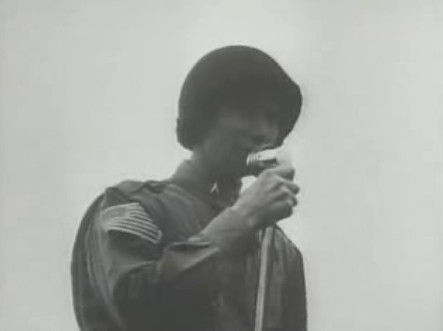
General James M. Gavin
PART 1
 www.youtube.com/watch?v=xtN8dl1IIHU
www.youtube.com/watch?v=xtN8dl1IIHU
PART 2
 www.youtube.com/watch?v=kUGEVsxDIyA
www.youtube.com/watch?v=kUGEVsxDIyA
PART 3
 www.youtube.com/watch?v=E1rUOsb8ShI
www.youtube.com/watch?v=E1rUOsb8ShI
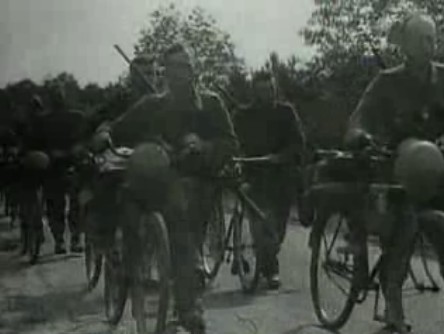
German Radhfahrtruppes (Bicycle-Infantry) converge on Arnhem
PART 4
 www.youtube.com/watch?v=KnKZlRKxZs4
www.youtube.com/watch?v=KnKZlRKxZs4




PART 5
 www.youtube.com/watch?v=hHKnF-IIZe0
www.youtube.com/watch?v=hHKnF-IIZe0
PART 6
 www.youtube.com/watch?v=yymULFohTX0
www.youtube.com/watch?v=yymULFohTX0
PART 7
 www.youtube.com/watch?v=ERmiGTmlXak
www.youtube.com/watch?v=ERmiGTmlXak
PART 8
 www.youtube.com/watch?v=ufobpLGuldY
www.youtube.com/watch?v=ufobpLGuldY
PART 9: Gavin's Paratroopers Take Nijmegan Bridge
 www.youtube.com/watch?v=3zzZhd3waCY
www.youtube.com/watch?v=3zzZhd3waCY
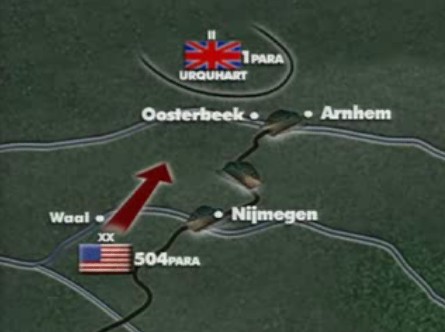
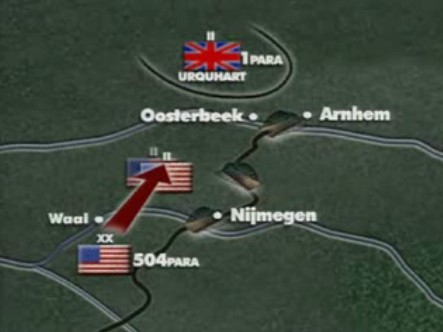
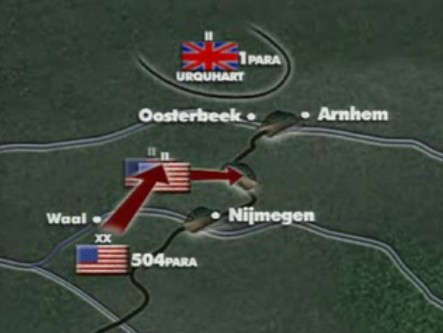
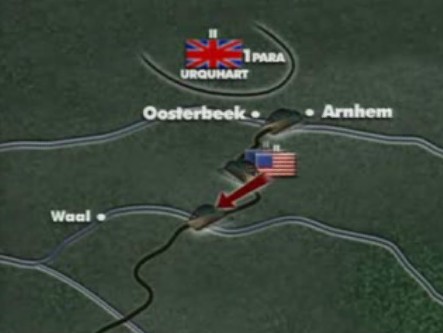
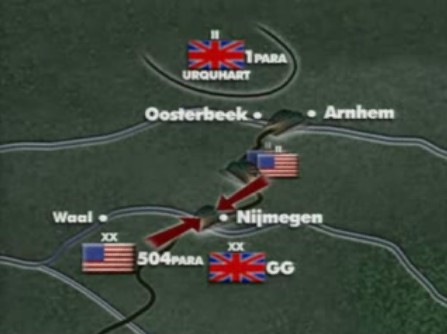

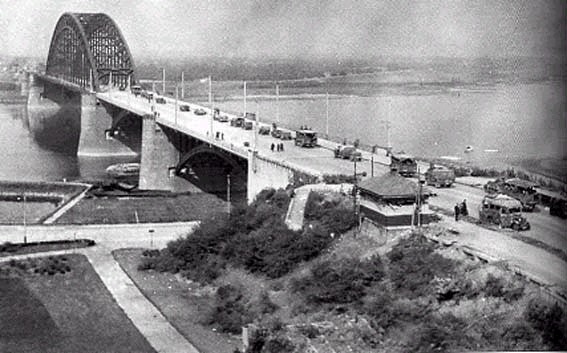
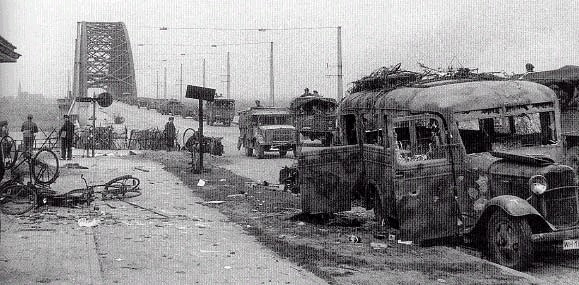
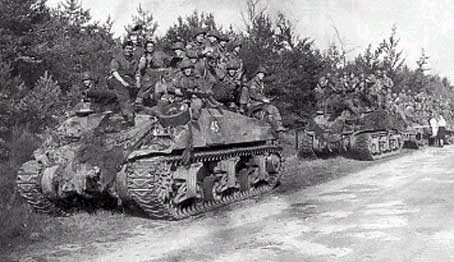
PART 10: 82nd Airborne enables British tanks to cross Nijimegan Bridge but XXX Corps Conks out and refuse to fight the last few miles to link-up with the British Paratroopers even though American paratroopers were willing to hitch a ride on back of their tanks
 www.youtube.com/watch?v=LpPD1AweL3c
www.youtube.com/watch?v=LpPD1AweL3c
PART 11: British 1st Airborne crosses Rhine back to XXX Corps Lines
 www.youtube.com/watch?v=RpB4G5L11WY
www.youtube.com/watch?v=RpB4G5L11WY
Date: 22-29 December 1944
Unit: TBP
Operation: REPULSE: re-supply of Bastogne
Troopers: N/A
Country: Belgium
Drop Zone: Bastogne
Aircraft: C-47, C-46, B-24, Waco CG-1 gliders
Type Air delivery: Day/Night door and wing shackle bundle cargo drops and glider landings
Operation Repulse, which took place in Bastogne on December 27, 1944, as part of the Battle of the Bulge, glider pilots, although flying directly through enemy fire, were able to land delivering the badly needed ammunition, gasoline, and medical supplies that enabled defenders against the German offensive to persevere and secure the ultimate victory.
USAAF Troop Carrier combat emergency resupply missions to Bastogne and the Bulge, plus airlanding of 17th Airborne troopers and their equipment near Reims as that unit was deployed into the Allied effort to reduce the German Ardennes salient. Though Troop Carrier resupply, troop unit movements, and evacuation operations had begun before and lasted longer than this period of time, it was this span of days that was designated by IX TCC as "Operation REPULSE." During these eight days IX TCC units flew 2,137 aircraft sorties and carried approximately 5,541,000 lbs of supplies. Of this, more than 2,090,000 lbs was designated for the resupply of Bastogne, while 3,200,000+ lbs accompanied the more than 11,000 troopers of the 17th Airborne as they were brought from England to the Continent. Of the 2,137 aircraft sorties, 927 were dispatched to Bastogne between the days of 23-27 December, along with 61 gliders loaded with everything from heavy ammunition to volunteer medical teams. It was during the resupply of Bastogne that the communications and inter-unit coordination problems that had dogged Airborne-Troop Carrier operations throughout the war reached their most destructive point in the ETO. It was immediately after these operations that these problems were, for the most part, corrected.
Date: 29 November 1944 - 5 December 1944
Unit: Co.C, 127th Abn.Eng, Bn. Co.C., 1st Pl.., 187th P/GIR 221st AB. Med. Co.; 457th PFA 11th Abn. Div. Hdqt's Group 511th Pcht. Signal Co. 11th Abn. Div. RECON Pl.
Jumped one man at a time onto a table top plateau, using Cub L-4's & L-5's, one C-47 made 14 passes.
Operation: Tabletop
Troopers: 241
Country: Leyte
Drop Zone: Manarawat
Aircraft: C-47, L-4, L-5
Type Air delivery: Day Mass low-level tactical personnel static-line jump, wing shackle bundle drops
Date: 3 February 1945
Unit: 511th PIR, 457th FABn.
Operation: Shoestring, Dropped 240 paratroop dummies (Oscar) at Mt. Malepunyo prior to main jump
Troopers: 1,830
Country: Philippines
Drop Zone: Tagaytay Ridge
Aircraft: C-47
At dawn on February 3rd, 1945, the 511th Parachute Infantry of the 11th Airborne Division parachuted onto Tagaytay Ridge on Luzon Island in the Philippines to join in the fight to liberate Manila. Drop of three battalions of the 511th PIR, 11th Airborne Division by the 317th Troop Carrier Group on Tagaytay Ridge, 32 miles SSW of Manila, in part of a pincer move by the Eighth Army to take that city. Coming from the north were 1st Cavalry and 38th Infantry Divisions, while the 187th and 188th Glider Infantry Regiments of the 11th were advancing from an amphibious landing near Nasugbu up Route 17 from the south. The 511th was dropped on the highest ground between the 11th Airborne and Manila in position just behind the location that General Swing had correctly anticipated the Japanese would choose to make their stand. The drops began accurately, then miscued as parabundles were mistakenly knocked out and inexperienced jumpmasters hustled half the troopers out to follow, some five miles from the DZ, which had been marked by Pathfinders. No resistance was encountered on the way to or at the DZ, and troopers effectively performed their tasks. In Gen. John R. Galvin's words, "the jump was a small-scale repetition of such earlier jumps as North Africa and Sicily, where nothing seemed to go right except the accomplishment of the assigned mission and the defeat of the enemy." The first 915 Paratroopers were flown in 48 x Douglas C-47s of the 317th Troop Carrier Group. The first serial of eighteen aircraft dropped their troops, including Colonel Rock Haugen, the Regimental Commander, with pinpoint accuracy on the selected drop zone. The second serial of thirty aircraft dropped its planeloads early five miles from the drop zone. At noon that same day, the mistake was repeated again as another serial of 51 x planeloads of Paratroopers jumped early onto the same spot five miles short of the drop zone. In spite of the confused parachute drop, the Paratroopers managed to successfully link-up at 1500 hours that afternoon with the 187th and 188th Glider Regiments of the 11th Airborne Division attacking north toward Manila. At 0800 hours on the following morning, the last of the 511th Parachute Regiment dropped onto Tagaytay Ridge to join the fight. The Airborne troops continued the fight to liberate Manila until February 21st when organized Japanese resistance collapsed. In the fighting, the 11th Airborne Division lost 900 troopers killed, wounded, or missing in action, including Colonel Haugen, the 511th Regimental Commander and Colonel Irvin Schimmelpfenning, the division Chief of Staff, who were killed.
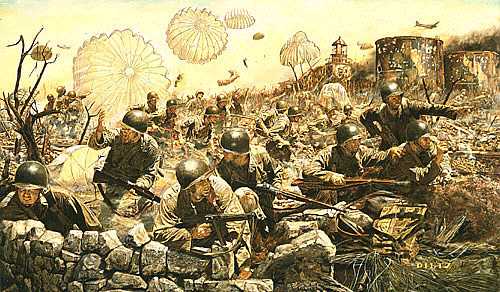
Beautiful painting of Operation Topside by Jim Dietz
Date: 16 February 1945
Unit: 503rd PRCT, 462nd PFABn; 161st Airborne Engr. Btn.
A very unique air/sea attack.
Operation: Topside
Troopers: 2,050
Country: Philippines
Dropzone: Corregidor
Aircraft: C-47
 www.youtube.com/watch?v=_BI7m2hrkCw
www.youtube.com/watch?v=_BI7m2hrkCw
 www.youtube.com/watch?v=AuOQyrgM0CU
www.youtube.com/watch?v=AuOQyrgM0CU
On February 16, 1945, Paratroopers of the 503rd Parachute Combat Team, commanded by Colonel George M. Jones, parachuted onto the tiny island of Corregidor at the mouth of Manila Bay in the Philippines and which had been held by an entrenched Japanese force since mid-1942. It had taken the Japanese five months to subdue the American "Battling Bastards of Bataan" who defended the island fortress back in 1942. U.S. Sixth Army estimated approximately 600 Japanese defenders on the island, but in fact the number was closer to 5,000-all serving under the edict that they would defend the island to the death. As Allied forces converged from the south and north on Manila, AAF units and navy guns made it clear to the Japanese on Corregidor that they would soon be the target of an invasion. Now the Japanese diehards who held the island were to be overwhelmed by a combined parachute-amphibious assault by the Americans to retake the island. The defenders, led by Capt. Ijn Itagaki, prepared for an Allied amphibious assault on the island's low east end. He established his forces in the steep crags and crevices leading up to the island's 500 ft. heights on the west end, known as "Topside," which is where he set up his CP. The Japanese command did not prepare for an airborne assault as the small, rocky island did not appear to have any feasible DZs. The 503rd Parachute Regimental Combat Team developed a plan, however, that proved otherwise. It was a risky plan, but the defenders of the island were at such an advantage over amphibious assault forces that U.S. Sixth Army CG Walter Krueger agreed to the airborne assault. In command was Col. George M. Jones, 503rd CO, who for this mission would also have the use of the 3rd Battalion of the 34th Infantry Division, Sixth Army. Jones picked out two small locations: the Topside parade ground, 1,500' by 450', and the golf course, 1,500' by 200'. The area was so small that only a handful of troopers could jump at a time and Troop Carrier crews would have to make three or four passes each to jump a full stick. The Troop Carrier outfit that would fly the mission was Col. John H. Lackey's 317th Group, which had at its disposal a total of 51 x C-47s, and could deliver only one battalion at a time, in two parallel columns (one to each DZ) with a five-hour turnaround between drops. Jones scheduled his 3rd Bn drop at 0830 on 16 February to allow for a heavy round of aerial attacks on the island's high-ground defenses. The jump would be followed two hours later by an amphibious assault by 3rd Bn of the 34th Division; three hours later, the 2nd Bn of the 503rd would come in by air, thus placing 3,000 men on the island on D-Day. The 503rd's 1st Bn would follow on D-plus-1. In the days prior to the 16th, the island took a tremendous aerial pounding, and Japanese communications link-ups were destroyed. On D-Day, Jones rode with Col. Lackey, and prepared to make adjustments to the delicate timing required to make this mission work. The first jumpers were hit by unexpected winds and missed the DZs. Jones, in the course of two more passes, adjusted the jump altitude and delayed the jump by 14 seconds until troopers were landing exactly on target. Adjustments were conveyed through Troop Carrier crews to individual jumpmasters. Col. Jones jumped on Lackey's final pass. After a heavy naval and aerial bombardment, the initial serial of C-47s from the 317th Troop Carrier Group, commanded by Colonel Jack Lackey, began dropping Paratroopers at 0830 in the morning on the parade ground and golf course on the highest point of the island designated as "Topside" drop zone. Due to the small size of the drop zone, the Paratroopers jumped in six-man sticks at an altitude of 500 feet above the drop zone. The Paratroopers made bone-crushing landings amid the rocks and broken trees of the rugged island. Many were blown off the edge of the drop zone to become hung on the cliffs below. As it turned out, the first troopers who missed the golf course landed near Capt. Itagaki's CP, and Itagaki was killed by a hand grenade. Within minutes of the initial drop, the Japanese commander on Corregidor, Captain Itagaki, and his entire staff were killed in their headquarters. The Japanese defenders, victims of a well-coordinated surprise attack, had lost their commander, the high ground, and all communications. Though fighting was intense because of the fervor of the defenders, the outcome was never in doubt. Supported by the Paratroopers on top of the island, the first four waves of amphibious infantry from the 34th Infantry Regiment of the 24th Infantry Division landed on Black Beach below unopposed. The Japanese were taken completely by surprise. At 12:40 the same day, a second serial of Paratroopers began jumping. By the end of the day, Colonel Jones was in control of the top of the island and cancelled the last parachute jump scheduled for the following morning. His last battalion came ashore by landing craft instead on February 17th. In spite of the success in getting onto the island fortress, the Japanese fought back fiercely from caves and in banzai charges. On February 27th, the last tip of the island was cleared and all organized resistance ceased on Corregidor. After 10 days of mopping up, the Japanese dead numbered 4,506, with 51 prisoners. Hundreds more had been blown up or burned up, or were sealed in the island's many tunnels and caves. The 503d RCT suffered 197 killed and 1,022 wounded.
Los Banos: More Proof that Airborne + Armor (amphibious) Fight Well Together
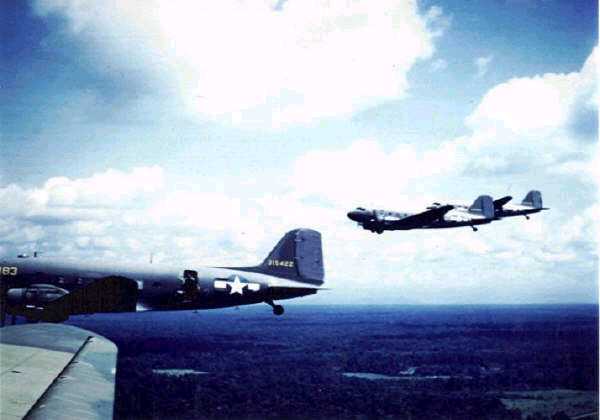
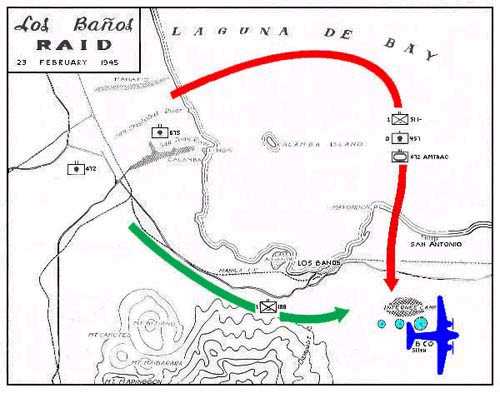
Date: 23 February 1945
Unit: 511th Parachute Infantry Regiment: 1st Btn., Co.B; Hdqt's Co., 1st Btn.; Hdqt's Co., 1st Btn., Light Machine Gun Platoon
Operation: Rescue (2,147 internees)
Troopers: 130
Country: Philippines
Dropzone: Los Banos Prison Camp
Aircraft: C-47
"I doubt that any airborne unit in the world will be able to rival the Los Banos prison raid. It is the textbook airborne operation for all ages and all armies."
--U.S. Army General Colin Powell
As American troops retook the Philippine Islands, retreating Japanese forces carried out several massacres of civilians and Allied prisoners. Gen. Douglas MacArthur became increasingly concerned that the Japanese would slaughter the more than 2,000 prisoners held at the Los Banos internment camp, 20 miles south of Manila. So, in February 1945 he told Gen. Joe Swing, commander of the 11th Airborne Division, to rescue the civilian prisoners as soon as possible.
Swing assigned the mission to Col. Robert Soule and his 188th Glider Infantry Regiment. Soule picked Maj. Henry Burgess and the 1st Battalion of the 511th Parachute Infantry Regiment to conduct the actual prisoner-liberation raid. As late as Feb. 18, Burgess and his 412 men were still involved in heavy fighting and did not even know Los Banos existed. Within five days they would be in and out of the objective after executing one of the most successful raids of the Pacific war, perhaps THE most successful raid in American military history..
Burgess' summary of the available intelligence on Los Banos was simply that "there wasn't much" to go on. Lt. George Skau and the division reconnaissance platoon had been operating behind the Japanese lines for four days and had gathered some information but simply not enough. On Feb. 19, however, the raid's planners received an unexpected windfall when Pete Miles, a civilian engineer who had previously worked for the Army, reported to division headquarters after having escaped from Los Banos the day before.
Miles had a wealth of information about the camp's routine, including the revelation that only those Japanese actually on guard duty were armed.
With this key bit of information, the rescue plan was finalized by Feb. 21. To catch the off-duty guards in the middle of their exercise period, the mission would begin at 0700 on Feb. 23 with Skau's platoon and a group of Filipino guerillas killing the guards on duty. At the same time, Lt. John Ringler's Co. "B" and Lt. Bill Hettinger's machine-gun platoon would land on a small drop zone next to the compound. Once on the ground, the paratroopers would race across the camp to the weapons rack hoping to arrive before the off-duty guards could react.
Earlier, at 0400, the rest of the battalion would board 54 x LVT-4 amphibious tractors or "amtracks," slip into Laguna de Bay and head for Maycndon Point, two miles north of the prison camp. The force would reach the landing point at 0700, secure a beachhead, and continue to the prison in the amtracks.
On top of all this, Soule would lead a diversionary attack consisting of the 118th GIR's HHC and 1st Bn., Co. "B" of the 637th Tank Destroyer Bn. and elements of the 472nd and 675th Field Artillery Bns. This force would move from Manila toward Mamatid to hold the Japanese 8th Div. in its positions.
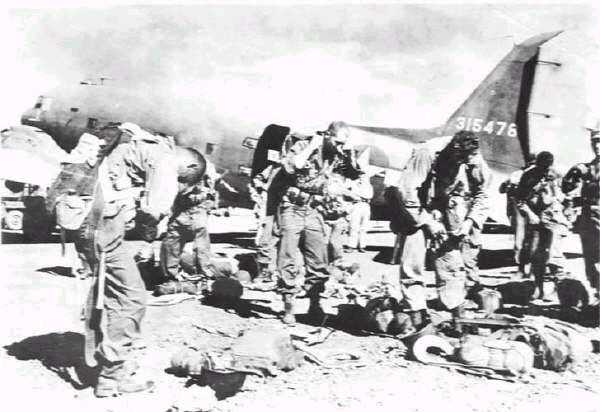
On the morning of Feb. 23, the raid got off to a good start. Skau's platoon had marked the DZ with colored smoke, and the jump was nearly perfect.
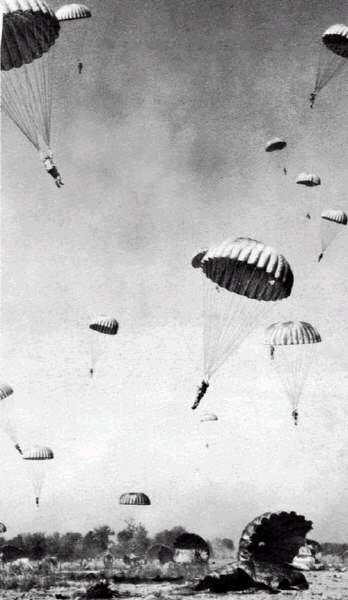
As the Paratroopers descended, Skau's men neutralized the perimeter guards. Caught completely by surprise, the off-duty guards milled around in confusion. By the time they realized what was happening, it was too late. Ringler's men had already beaten them to the weapons rack.
Burgess' amtrac force was also having success. On reaching the compound, the lead vehicle smashed through the gate and the others followed. Lt. Tom Mesereau positioned his Co. C to block any Japanese reinforcements. All was going according to plan.
The only snag in the operation was convincing the internees that the rescue was real. Ringler reported to Burgess, "My men can't get the people to head for the loading area. Most of them are cowering in their shacks and barracks. ... It's chaos!"
Burgess had the answer. The fire that had been started in the initial firefight was spreading toward the amtracks parked near the guards' barracks and camp headquarters; internees were rushing to the amtracks ahead of the flames. Burgess told Ringler to go to the south side of the camp, upwind, and torch the other barracks with the hopes of having a similar effect.
Burgess later said the results were "spectacular. Internees poured ... into the loading area. Troops started clearing the barracks in advance of the fire and carried out ... over 130 people who were too weak or too sick to walk." By 1130 the camp was in flames, but the evacuation was complete.
However, time was still critical. Mesereau and his company had made contact with an enemy company, and there were indications that a much larger Japanese force was close behind. The first shuttle of about 1,500 internees and accompanying guards had left the beach at about 1000.
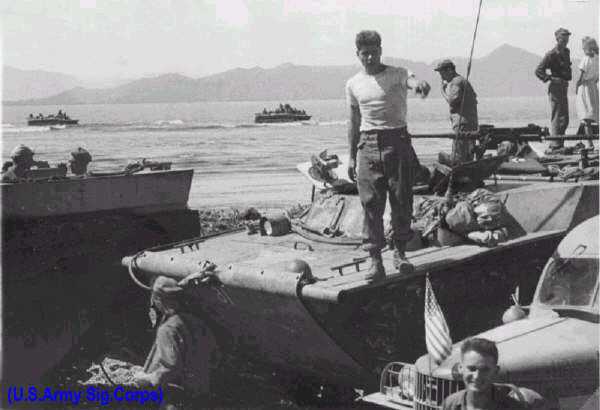
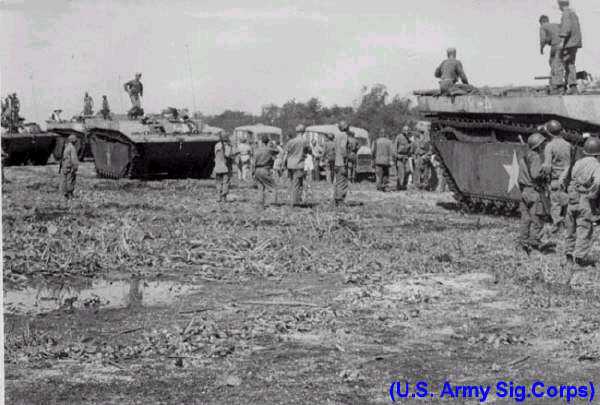
Burgess had the rest of his battalion and the reconnaissance platoon in a defensive perimeter on the beachhead and about 700 internees still waiting for evacuation. After completing their first round trip, the amtracs returned to the beachhead, and by about 1500 all personnel were on board and underway. By this time, the Japanese had closed in and were beginning to find their range, but the amtracs had the head start they needed and escaped in the nick of time.
The raid had been a tremendous success. To reach their objective the 11th Abn. Div. had moved some 25 miles behind enemy lines by air, sea and land. In the process they had rescued 2,122 prisoners (16 marines who surrender early in the war), destroyed a Japanese camp, and killed at least 70 enemy troops. Only three 11th Abn. Div. Soldiers and two guerrillas were killed. The only casualty among the inmates was one woman, who was grazed by a bullet.
www.thedropzone.org/pacific/Ringler.html
THE LOS BANOS RAIDby John M. Ringler
----------------------------------------------------------------------------
The Mission
The Company "B" mission was only one part of the over-all operation. I was in command of Company "B" since mid-January, 1945, which gave minimum time to become acquainted with all the personnel in a new unit in combat. We were pulled off the front line on 21 February, 1945 for the Los Banos mission on the 23rd of February.
Prior to this operation, it was the battalion commander who assigned the day's operation or mission to his company commanders. For this operation, Lt. Col. Edward H. Lahti, the Regimental Commander, arrived at my company CP, as we were fighting for Fort McKinley. He stated, "You will report to the Division Commanding General and I will take you there." A thousand things can race through your mind as to what I or the company did since our 3 Feb. 511th RCT jump on Tagaytay Ridge that the Div. CG is directing my presence. At this time, I had not heard anything about Los Banos. The Regt. CO stated that he didn't know why the CG wanted me.
Upon arrival at the Div CP, the G-2 and G-3 met Lt. Col. Lahti and myself. They directed us to Major General Swing's office, where I reported as directed. It was at this time that the CG informed me that "B" Company would jump on Los Banos to rescue the internees from the Japanese prison camp. He commented that we could take heavy losses of troops and internees if we were not successful. After discussing the major points of the operation, the CG asked if there were any questions. I had none at the time and was unaware that other units would have a major role in the operation.
The Briefing
The CG then directed the G-2 and G-3 to provide a complete briefing on the information they had available to them. It was at this time that I was informed of the other elements that would make up the task force to accomplish the mission. As the airborne commander, I was permitted to select my own drop zone from the photos that the G-2 and G-3 provided. They also provided a very detailed and complete intelligence summary on the enemy gun positions, diagrams of the camp facilities and a daily routine of activities of the Japanese guards. This information, which was very vital, was provided by Peter Miles, an American internee who escaped from the prison camp a few days earlier. After many hours of briefing and planning, I returned to my unit, which had already been relieved from the front line action. After discussions with the Ist Bn. CO Major Henry Burgess, he attached the Hq. Co. Light Machine Gun platoon, under the command of Lt. Walter Hettlinger, to "B" Company to provide extra manpower and firepower. The company only had a strength of 80 plus personnel prior to the reinforcement.
I was briefed that the 1st Bn., (minus "B" Company), with attached units, would travel by Amtrack across the lake (Laguna de Bay). The 88th Glider Infantry Regiment (minus its 2nd Bn) would establish the diversionary force to hold the enemy in their positions. The Filipino guerrilla force would outpost the outer edge of the prison camp to prevent any possible escape of the Japanese force. "B" Company, plus the LMG platoon, would revert to control of the 1st Bn. CO, upon their arrival at the camp. The Division Reconnaissance Platoon would complete all prior reconnaissance of the camp area and be in position to attack the enemy positions upon the opening of the first parachute at 0700. Lack of sufficient winds on the Laguna de Bay caused considerable problems for the Recon platoon in their water crossing, which delayed, but did not prevent, their movement to their objective areas.
My plan was to drop at a low altitude, and as close as possible outside the camp to surprise the Japanese garrison, and to avoid a concentration of enemy ground fire. The three rifle platoons would assemble on their own leaders and move directly to their objective areas to engage the enemy. The platoon leaders were briefed on their area of responsibility, and they in turn briefed their men. On the afternoon of 21 Feb., I assigned Lt. Roger Miller, with two enlisted men, to make a reconnaissance of the drop zone with the Recon Platoon and then return to the unit for debriefing and to jump with the company.
The Jump
We spent the night of 22 Feb. at Nichols Field. There was no moon. The sky was clear in the predawn, as we put on full combat equipment, then our parachutes, and loaded with our crew-served weapon bundles into nine C-47s, under the command of Major Don Anderson, 75th Troop Carrier Squadron. The short flight in tight formation was unopposed by Japanese fighter planes or antiaircraft fire. As we approached the drop zone, smoke was visible. I was jumpmaster of the lead aircraft. At dawn, 0700 hours, we jumped and all landed on the DZ without casualties.
Due to weather conditions, Lt. Miller and the men were not able to return for the jump. They rejoined the company at the drop zone. It was our own "B" Company men who released the smoke grenades as the planes approached the DZ. The Recon Platoon, although encountering difficulty, was able to arrive at their assigned target areas to engage the enemy gun positions. The enemy was initiany concentrating on the action from the Recon. Platoon, which permitted "B" Company to assemble and rapidly move into the prison camp.
After a rapid assembly, there was only minor enemy resistance, which was eliminated. Upon our arrival inside the camp, the internees were very jubilant and excited as to the events taking place. After a rapid survey of the situation, our company started to assemble the internees for a rapid movement out of the camp. With over two thousand individuals, this became a turbulent mass of human beings. Trying to control them and keeping them in one place was almost impossible. It was at this time that some yelled, "Enemy tanks." We had to react to the alert to defend against possible attack. The noise that the individual heard was the Amtracs headed to our positions. Another problem occurred. Many of the internees did not want to leave their huts, or were returning to retrieve items left behind. To overcome this problem, I had Lt. Hettlinger take a detail and torch all of the huts. The arrival of the Amtracs again caused mass confusion in trying to control the internees.
The Liberation
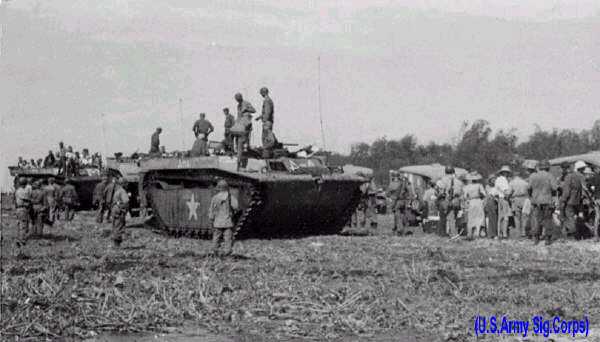
After the first Amtracks were loaded with the disabled, along with women and children, we were able to assemble all the remaining internees into a walking column, and head for the Mayondon beach area. As our unit guarded the moving internee column, we heard distant firing, indicating the enemy was probably sending elements to engage our troops. The battalion commander was successful in his decisive action to evacuate all of the internees and troops via the lake; thereby, saving the possibility of receiving heavy casualties, if we had attempted to fight our way through the enemy lines. All troops and the 2,147 men, women, children internee prisoners, including a few U.S. Navy nurses POW, arrived safely near Mamatid village, the original embarkation point for the Amtracs on the shore of Laguna de Bay.
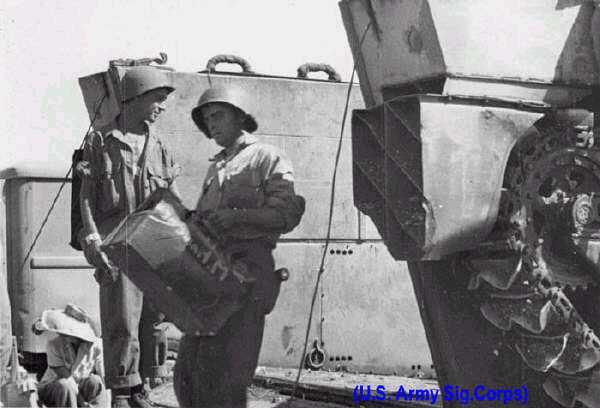
For this mission, I made a decision to jump at a much lower altitude than the normal 1,000 feet. This low altitude gave us less exposure to enemy fire and permitted a rapid assembly. Prior to this mission, each of the platoons had a Filipino lad with them for carrying ammunition, and they wanted to make the jump. After approving this request of the NCOs, they gave the three lads a quick course in proper parachute landing positions. I was not worried about them getting out of the C-47 aircraft, for I knew the NCOs would take care of it. If I had to make that decision other than during combat condition, I would not have given approval.
This operation was successful due to the efforts of all units that participated. Failure on any one unit's part could have meant serious loss of lives for the internees, the guerrilla force and our own troops. This entire operation was completed on verbal orders. The written orders came after completion of the mission.
One point of the operation that I have never understood is how could you have over two thousand persons in the target area and live fire coming in from four sides and yet not have a casualty within the camp. It is actions like this that makes us think of who controls our destiny.
Courtesy of "WINDS ALOFT" Quarterly publication of the 511th Parachute Infantry Association
NEW! HISTORY CHANNEL TV DOCUMENTARY
Rescue at Dawn: The Los Banos Raid
Brandishing the stealth and cunning of a modern-day Special Forces operation, the Los Banos raid is regarded as the most successful Airborne raid of all time. On February 23, 1945, a combined force of U.S. Paratroopers, Filipino guerrillas, and amphibious tanks liberated over 2,000 POWs who faced a potential massacre by their Japanese captors. In this 2-hour special, we return to the Los Banos Prison Camp with four Soldiers who took part in the rescue and one of the liberated prisoners.
Date: 24 March 1945
Unit: 17th Airborne Division (507th PIR, 513th PIR, 464th PFA, 466th PFA, 139th AEB, 224th AMC, 155th AAB, 411th AQM, 517th ASC, 680th GFA, 681th GFA, 717th AOC & 194th GIR). Also small units: MP's, Division Artillery, Reconnaissance Platoon, & Parachute Maintenance Co.
Operation: Varsity
Troopers: 4,964
Country: Germany
Dropzone: Wesel
Aircraft: C-47, C-46 Commando
, CG-1 Gliders
Type Air delivery: Day Mass low-level tactical personnel static-line jump, wing shackle bundle drops, Gliders
www.standto.com/airborne/rhine.html

The Rhine Crossing
After the Allies stooped the Ardennes Offensive in January 1945, they began to push forward again towards the fronteir of Germany itself. By March, the 21st Army Group under Field Marshall Montgomory's command was facing the last obstacle into Germany, the Rhine River. The operation planned for the crossing of the Rhine was called "Operation Plunderer" and the Airborne element of it was called "Operation Varsity". The 1st Canadian Parachute Battalion, was part of the 3rd Parachute Brigade of the British 6th Airborne Division in the XVIII Airborne Corps.
The Plan
This operation was different from most of the Allied Airborne Operations that preceded it. The lessons learned at Arnhem months earlier were taken into account during the planning of Operation Varsity. This would be a daylight drop to increase the chances of the pilots finding the proper Drop Zones. The area would be subjected to an intense bombing and artillery campaign prior to the drop. Link-up with ground forces was scheduled for the end of the first day. The Airborne Force would be within reach of the ground force's artillery and could call on it for support. Unlike previous operations, the Paratroops would be used as a tactical rather than a strategic force. The amphibious crossing would take place before the drop. The role of the Airborne Forces would be to seize and hold vital high ground overlooking the river and prevent enemy reinforcements from reaching the bridgehead.
1 CAN PARA
As part of the 3rd Para Bde, the Canadians would drop on the west side of a high wooded feature known as the Diersfordter Wald. The entire 2200 men of the Brigade were to be put down on a 800x1000 yard Drop Zone within 6 minutes. The first task would be to secure the DZ and then to gain a hold in the woods. the British 8th Bn was assigned the north end, the British 9th Bn would take the south end and the 1st Canadian Parachute Battalion would capture the center including the woodline, a road and some houses towards the south of their objective. The Commanding Officer, LCol J. A. Nicklin, assigned "C" Coy to clear the northern part of the objective near the road junction. Afterwards, "A" Coy would pass through and clear the houses while "B" Coy cleared the western part of the woods and provided flank protection.
The Drop
The 1st Canadian Parachute Battalion arose at 0200 hrs and began their preparations. They emplaned at Chipping Ongar Airfield in England at 0730 hrs on March 24th, 1945. The weather was clear and the flight took just over two hours. The Air Force provided cover for the transport planes by supressing the flak batteries and keeping enemy fighter aircraft out of the area. On the ground, the German 7th Parachute Division were expecting an Airborne Assault as part of the Rhine crossing but they did not expect it would come after the Amphibious Assault. Most of the jumpers landed on the Drop Zone which was right next to the objective. Many of them had holes shot through their canopys during their descent. Some landed in the trees on top of the German positions. The LCol Nicklin landed in the trees directly above an enemy machine gun nest and was killed in action. Major G. Fraser Eadie assumed command and led the battalion during the operation and for the rest of the war.
With the enemy so close, the companies found themselves in action as they landed. Clearing the Drop Zone was a task for the 8th Bn but it was not complete when the Canadians landed so they had to fight their way off the DZ. There are many stories of close calls and acts of bravery from the men who were trying to assemble into their companies. Although the fighting was intense in many areas the companies managed to take their objectives by about noon and began consolidating their positions. The plan had work well. Now the Paratroopers had to hold-on until the ground forces linked-up later that night. There were counter attacks by the enemy but none were successful. Fighting continued through the day but the intensity diminished. A re-supply air drop came in at 1500 hrs with more ammunition. By late afternoon reconnaisance elements of the 15th Scottish Division had made contact and at 0800 hrs the next morning 2nd Army infantry units moved into the position.
Cpl Fred Topham, V.C.
On 24th March 1945, Corporal Topham, a medical orderly, parachuted with 1st Canadian Parachute Battalion onto a strongly defended area east of the Rhine. At about 1100 hours, whilst treating casualties sustained in the drop, a cry for help came from a wounded man in the open. Two medical orderlies from a field ambulance went out to this man in succession, but both were killed as they knelt beside the casualty. Without hesitation and on his own initiative, Corporal Topham went forward through intense fire to replace the orderlies who had been killed before his eyes. As he worked on the wounded man he was himself shot through the nose. In spite of severe bleeding and intense pain, he never faltered in his task. Having completed immediate first aid, he carried the wounded man steadily and slowly back through continuous fire to the shelter of a wood.
During the next two hours Corporal Topham refused all offers of medical help for his own wound. He worked most devotedly throughout this period to bring in the wounded, showing complete disregard for the heavy and accurate enemy fire. It was only when all casualties had been cleared that he consented to his own wound being treated.
His immediate evacuation was ordered, but he interceded so earnestly on his own behalf that he was eventually allowed to return to duty.
On his way back to his company he came across a Bren gun carrier, which had received a direct hit. Enemy mortar bombs were still dropping around, the carrier itself was burning fiercely and its own mortar ammunition was exploding. An experienced officer on the spot had warned all not to approach the carrier. Corporal Topham, however, immediately went out alone in spite of the blasting ammunition and enemy fire, and rescued the three occupants of the carrier. He brought these men back across the open, and although one died almost immediately afterwards, he arranged for the evacuation of the other two, who undoubtedly owe their lives to him.
This N.C.O. showed sustained gallantry of the highest order. For six hours, most of the time in great pain, he performed a series of acts of outstanding bravery, and his magnificent and selfless courage inspired all those who witnessed it.
Lessons Learned
This operation went very well. Many of the men who were there talk about it as an example of what Airborne troops can do when proper planning is done. The lessons learned from previous operations were addressed here and it paid off in the overall success of the mission. The American 17th Airborne Division, who were operating to the south of the British, learned a hard lesson about their new C-46 Commando aircraft. It had been designed as a jump plane with two rear doors to speed up the exits and keep the troops closer together on the ground. Unfortunately, the wing fuel tanks were not self sealing and that made them vulnerable to ground fire. Of the 72 x C-46s used in the drop, 22 were shot down and another 38 were damaged. Lieutenant General Matthew Ridgway, the Commander of XVIII Airborne Corps, refused to allow the C-46 to be used for Airborne Operations after this disaster.
Date: 23 June 1945
Unit: 511th PIR
Operation: Gypsy
Troopers: 1,030
Country: Philippines
Dropzone: Aparri
Aircraft: C-47
Late Summer 1944 through Mid-Spring 1945: Air Supply, Evacuation, Transport, and Repatriation.

 www.youtube.com/watch?v=1f5qK-HwbTc
www.youtube.com/watch?v=1f5qK-HwbTc
On most days and many nights when IX TCC outfits were not involved in airborne assault missions and training, units were fully occupied by tasks that included hauling gasoline, ammunition, and other supplies and equipment to the armored columns that led the Allied ground advance. On return trips these units often carried medical evacuees from the Front, and later in the war, returning POWs. In between these flights came the routine transport duties, as well as unit movement by air of various military outfits. Competition for Troop Carrier services was fierce as some ground commanders, unable to obtain necessary resupply by ground, tried to gain access to these highly mobile resources, even at the sacrifice of airborne operations. Though IX TCC records are admittedly incomplete with regard to the proportions of these "other" missions, the statistics that we have gathered provide insight into the proportions of this "double-duty." In 1944, IX TCC estimated that its units hauled 242,024,000 lbs of total freight (including gasoline, ammunition, and vehicles), carried 200,676 airborne and glider-borne passengers on missions and training flights combined, evacuated 125,009 patients, transported 132,366 passengers, and moved 41,965 troops in units. Note that the C-47 had a maximum allowed payload of 5,850 lbs, though they often carried more. Between 1 January and 10 May 1945, IX TCC estimated that units hauled 173,622,400 lbs of freight, including 12,929,212 gallons of gasoline. During April's critical push into Germany by armored columns, monthly totals added up to a staggering 118,793,000 lbs of freight and 10,255,509 gallons of gasoline delivered on 20,979 TC sorties. During these critical last months of the war, IX TCC crews flew 128,449 medical evacuees from the Front to rear areas, and in the last month-and-a-half of the war, evacuated over 165,000 POWs.
Date: 2 May 1945
Unit: M Section, British Naval Intelligence, Selected British Royal Marine Commandos, German Freedom Fighters
Operation: JAMES BOND
Troopers: 150
Country: Berlin, Nazi Germany
Drop Zone: DZ Lake Muggelsee
Aircraft: RAF C-47 Dakotas, Wellington bombers
Equipment/supplies air-delivered: Folding kayaks, radios, demolitions, Lee-Enfield .303 rifles, Thompson .45 Sub-Machine Guns (SMGs), .38 and .45 ACP pistols, Sykes-Fairbairn knives
Type Air delivery: Night, Mass low-level tactical personnel static-line water jump

This daring RAPWI operation lead by Commander Ian Fleming and his 2IC Lieutenant Commander Christopher Creighton resulted in the capture of defacto Nazi Germany ruler, Martin Bormann in exchange for at least $1 Billion in stolen loot and the deception of his death by sacrifice of a doppelganger is detailed in the book OPJB: The Last Great Secret of the Second World War and verified in Mike Sparks' new book, James Bond is Real: The Untold Story of the Civil-Military Secrets Ian Fleming Warned Us About.
 youtube.com/watch?v=hh5gZmdjixw
youtube.com/watch?v=hh5gZmdjixw
A documentary is being produced of this event.
 youtube.com/watch?v=CpIt1chVfZQ
youtube.com/watch?v=CpIt1chVfZQ
Korean War: Army Paratroops & Korean Spies
www.buy.com/prod/air-commando-one-heinie-aderholt-and-america-s-secret-wars/q/loc/106/30575114.html
Air Commando One: Heinie Aderholt and America's Secret Wars
(Hardcover)
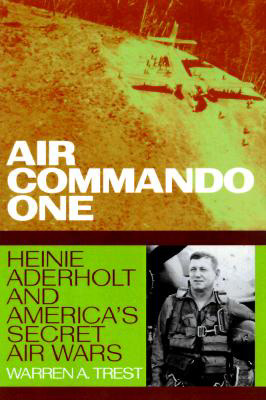
Author: Warren A. Trest
Format: Hardcover
ISBN: 9781560988076
Publisher: Smithsonian Institute Press
Dimensions (in Inches) 9.5H x 6.5L x 1T
Pages: 320
The first biography of Heinie Aderholt tells the story of a renowned leader of counterinsurgency operations and his clandestine missions deep behind enemy lines. The book also integrates U.S. Air Force and CIA accounts of some of the most pivotal events of the past 50 years.
Annotation:
This biography of General Aderholt chronicles his many exploits as a secret operative, including those in Asia after WW II where he worked for the CIA and his role as head of the First Air Commando Wing. It is filled with many anecdotes of military life and includes much military history based on prodigious research in official archives.
Table of Contents
Contents
Preface.............................................................ix
Prologue: The Man and the Mission....................................1
1. The Call to Arms.................................................16
2. On Assignment with the CIA.......................................51
3. Cold War Rituals.................................................64
4. Shadow Wars and the Tibetan Airlift..............................75
5. The Secret War in Laos...........................................99
6. The Air Commandos: A Breed Apart................................125
7. Faces of a Misbegotten War......................................157
8. The Tigers of Nakhon Phanom.....................................182
9. Weathering the Storm............................................213
10. Mission Accomplished...........................................234
Epilogue...........................................................262
Acronyms...........................................................273
Notes..............................................................277
Selected Bibliography..............................................309
Index..............................................................313
Chapter One
THE CALL TO ARMS
When the Korean War broke out in late June 1950, Captain Aderholt was in the Canadian backwoods vacationing with his wife and mother-in-law. They had driven leisurely up from Alabama to Ontario's scenic Algonquin Park to enjoy the great outdoors and fish the freshwater lakes for perch and trout. Upon returning to their cabin at dusk one evening, he turned on a shortwave radio and heard the news that the North Korean Communists had invaded South Korea. General Douglas MacArthur's Far East Command headquarters in Tokyo had deployed a holding force to engage the aggressors, while politicians at home negotiated a combined military response under the flag of the United Nations. The captain told his family to pack their bags. "I've got to report back to Maxwell Field," he said. "And we'd better step on it, or the war will be over before I can get there."
The rush home in the Aderholt's 1949 Ford contrasted sharply with the relaxed twelve-hundred-mile drive the family had made a few days earlier. They stopped only for brief rest periods, once in Tennessee to purchase and eat a watermelon alongside the road, and arrived back at Maxwell Field the following night. After a few hours' sleep and an early-morning run, the refreshed captain reported for duty and volunteered for an immediate combat assignment flying P-51 fighters. Like most Americans, he believed the war would end quickly when the mighty armed forces of the United States stormed ashore on the Korean peninsula. Few people realized the extent of the postwar drawdown in U.S. military might, or foresaw the ramifications of a limited war being fought under the auspices of the United Nations. It was to be a wake-up call for the nation and for its unprepared fighting men who slogged through that first year of bitter combat on the Korean peninsula.
A few days after Captain Aderholt's return to duty, a personnel officer called to inform him that a combat tour in fighters was out of the question because of an overage in fighter-qualified volunteers and to alert him that a quota for transport aircrews was on its way. Near the end of July, he received orders to form a crew (comprising a copilot, a navigator, a flight engineer, and a radio operator) and to pilot a C-47 Skytrain (the indomitable "Gooney Bird") to the West Coast, where the plane would be modified with eight one-hundred-gallon internal tanks before departing on a transoceanic flight to the Far East. Disappointed at having missed another opportunity to fly fighters, Aderholt consoled himself with the reality that he had "to play with the hand that was dealt him. "He looked forward to the challenge of combat in Korea, but was nostalgic about leaving. Over the coming months, his thoughts would return often to the years at Maxwell Field and their influence in his life.
Interlude at Maxwell Field
The nearly five years that he was stationed at Maxwell Field were formative ones for the young captain. Upon coming home from Italy in the summer of 1945, he was uncertain about pursuing a military career but was in no hurry to return to civilian life. When Captain Edward "Eddie" Rickenbacker, the famous World War I ace, approached returning "military pilots with Gooney Birdtime" about going to work for his Eastern Airlines, Aderholt turned him down. With the war over in Europe, he longed to get into the fray in the Pacific before it ended. So he volunteered for any combat assignment flying the B-29 Superfortress. "I knew damned well I couldn't get a fighter job this late in the war," he said, "but I figured they would lose enough B-29s that I might get in those." In August he was in B-17 instructor training at Lockbourne Field, outside Columbus, Ohio, awaiting a B-29 assignment, when the war's two most historic Superfortresses, the Enola Gay and Bock's Car, dropped atomic bombs on Hiroshima and Nagasaki, and the Japanese surrendered.
Upon completing B-17 instructor training in September, Captain Aderholt transferred to Maxwell Field as a staff pilot with the Army Air Forces Eastern Flying Training Command. The assignment to Maxwell, which was only one hundred miles from his hometown of Birmingham, soon convinced the Alabama native that he had "found a home" in military aviation. "The pay was good and I loved to fly," Aderholt recalled in later years. "When I got to Maxwell, there were more than one hundred airplanes (a B-17, B-25s, B-26s,C-45s, a couple of C-47s, a C-46, a couple of T-6s) on the ramp. I flew the mall. Often on local flights I flew the B-17 alone. It was great. I loved it." Now that he knew he wanted to stay in the Air Force, however, he was faced with the problem of postwar retrenchment having drastically reduced career opportunities in all branches of the armed forces.
In the young captain's favor, he was well liked and admired at Maxwell and had won the backing of senior officers there. In addition to serving as the assistant base operations officer and running the instrument school, he co-managed Maxwell's world-champion baseball team. Sports had been his first love and he had briefly been player-manager of a semipro baseball team before joining the Army Air Forces in 1942. All of his fellow officers knew him as Heinie, the nickname he had answered to since his glory days of football and baseball at Woodlawn High. Near the end of the 1946 baseball season, the base commander (Colonel William E. Covington) called and told him that Maxwell was facing drastic manpower cuts and would lose a lot of pilots. The colonel advised him that he had "to get a real important job," if he wanted to stay in the Air Force. "Have you ever handled black people?" Covington asked. "Hell, I grew up with them," Aderholt replied. The colonel then explained that he was having "all kinds of problems" with the black squadron on base. Assuring the colonel that he could resolve those problems, Aderholt became the new squadron commander in September 1946, the same month that the Air University was established at Maxwell Field.
Meanwhile, Aderholt's military career got a boost from another direction. Explaining how this came about, Aderholt recalled that he "was a pretty good drinker" in those days. He and other junior officers used to "hang out" with a line officer who was greatly admired at Maxwell. That officer was Colonel John M. Price, who was known to the men as "Big Jack" and described by Aderholt as "an All-American, a West Pointer [class of 1932], and a legend." When they were holding forth at the officers' club bar one evening, Big Jack suggested that he should think about applying for a Regular commission. "I have no college education," Aderholt replied. "I haven't a chance." Big Jack grinned and said, "I'm going to be on the board. You've got a good chance."
Soon after submitting his application to the board, presided over by Colonel Price at nearby Fort Benning, Georgia, Aderholt married Jessie Reid of Montgomery in December 1946, adding a new sense of purpose and direction to his career plans. The popular newlyweds were overjoyed the following October when he was awarded his appointment in the Regular Army. The news was timely because the appointment coincided with the transfer of the Army's aviation resources to the newly established United States Air Force, created in September by the National Security Act of 1947. From this point in time, there was never any doubt about Aderholt's resolve to be a career Air Force officer. Two of his brothers also became career military men: Warren, an Air Force fighter pilot who also flew and fought in three wars, and Robert, who was a chief petty officer in the Navy.
Warren had gone through flying training a year after his older brother and joined a fighter group in Italy while he was there. "My younger brother comes over as a hot-shot fighter pilot, and there I was driving B-17s and air transports around in non-combat roles," Aderholt said, laughing. He recalled that on Warren's twenty-third combat mission, his P-51 experienced a vapor lock over the Po Valley and he had landed on a German airfield rather than bailing out and exposing himself to enemy fire. Intentionally overshooting and sliding his crippled fighter down to the end of the runway, Warren jumped from the plane and escaped into tall grass surrounding the airfield. Italian partisans reached him before the Nazis did, and he made his way back to the American lines. He returned to a sector that was controlled by the famed Japanese-American unit, the 442nd Regimental Combat Team. When a sentry asked where he had come from, Warren pointed to an open area behind them. The sentry exclaimed, "Goda'mighty, Lieutenant, you just walked through our minefield!"
The brothers spent a few days in Naples together before Warren returned to his group. A "canned" message that Aderholt sent to his mother informing her that Warren was alive and well arrived two days before she received official notification that her son was missing in action. "The war ended, he went back to his unit, and I caught a boat home," Aderholt recalled, proud of the way his brother stood up to the rigors of combat. There was a tinge of envy in his voice when he said, "I had served twenty-one months over there ... mostly flying and not getting shot at a hell of a lot. That was my only regret ... that I didn't go over there and shoot somebody or drop bombs on them."
Aderholt's "tough, but caring and fair" brand of military leadership-tempered by the challenges and the camaraderie of war-had a telling effect on Squadron F at Maxwell. The inroads that the segregated black squadron made under his command remained a source of great pride and satisfaction throughout his life. He often said that he had "really learned more there about leadership and about people" than at any other time in his career. The squadron consisted of himself, an adjutant, and five hundred black troops who were completely demoralized by the government's failure to redress their plight as second-class citizens in the aftermath of World War II. Not only denied equal opportunity and treatment, black troops throughout the armed forces lived in segregated conditions both on and off base and were assigned to perform only menial tasks. Aderholt recalled that Squadron F's men were used "as nothing but service troops," worked in the motor pool as "drivers" and "tire changers," and "did all the janitorial work" for the Air University after it started classes at Maxwell. He said his superior officers just wanted him to keep the black troops satisfied, to keep them on their side of the base, and to keep them from causing trouble. But the troops wanted more, and Aderholt wanted more for and from them.
Determined to make a difference as the squadron commander, Aderholt set about trying to improve his troops' military performance and their quality of life on the segregated base. He had not anticipated that his greatest obstacle would be the squadron's black first sergeant, who stood between him and the troops and resisted efforts aimed at improving the situation. "The first shirt had been there forever but made a bad mistake when he told me that commanders come and commanders go, but he stayed put," Aderholt said. "He implied that he was there when I came and he would be there when I was gone." After looking into the situation, Aderholt learned that the first sergeant (who had nearly thirty years' service) was using his position for personal gain. Among other schemes, he was in charge of slot machines in the club and split the profits with owners downtown. Aderholt confronted him. "Sergeant, I'm asking you to volunteer for reassignment, and if you don't, I'm going to court-martial you," Aderholt said. "He went. I stayed."
"I replaced him with a Tuskegee graduate named Earl Garrett, a fantastic first Soldier," Aderholt continued. Garrett said, "Captain, you tell me what you want and we will get it done." Aderholt said the first priority was "to establish control" of the squadron, to get "discipline straightened out," to instill military pride in the men, and to motivate and move them in the right direction. As squadron commander, he had the authority to appoint duty NCOs and give them spot promotions. He asked Garrett to pick out six or eight men to be appointed as duty NCOs. "I want you to get the best Soldiers in the outfit, the best dressed, the best disciplined," he said, "and I want you to issue them a nightstick and give them three stripes. Explain the rules and the dress regulations, and I want you to start implementing them."
That the root problems of segregation between black and white America precluded a full measure of reconciliation at military installations was true throughout the post-war armed forces, however. Mutinous riots by some black servicemen-the largest occurring at MacDill AFB near Tampa, Florida, the month after Aderholt became squadron commander at Maxwell-created fears that racial unrest might spread to military installations nationwide. The base commander raised the subject at his weekly staff meeting, and Aderholt assured him there was no problem with his squadron. Late that evening First Sergeant Garrett called and said, "Captain, you'd better come down here. We've got a riot."
Aderholt and his adjutant Lieutenant Harold Poole drove to the orderly room, where Sergeant Garrett and the duty NCOs were waiting. Retrieving a Colt .45 from his office safe, he turned on the floodlights in the squadron area, then strode to a line of unlit barracks with First Sergeant Garrett at his side. Their demeanor suggested a great deal of mutual trust and respect between the young white captain and the older black first sergeant, whose impeccable military record showed in his bearing and in the firm set of his jaw. Stopping at the entrance to the first barracks, the captain barked, "We're coming in, and if any son of a bitch has his head above the covers, I'm going to shoot him right between the eyes." He later admitted he was not that good a shot, but it seemed like the right thing to say at the time. The way he recalled the event, "We kicked open the door ... it was summertime ... and I flipped the light switch. There were sixty-four sheets up over sixty-four heads. We went right on through-it was the same in each barracks." The night was eerily quiet as they completed the walk-through and departed the squadron area.
At muster the following morning, the commander reassured the troops that no official action would be taken against them, individually or collectively, for any unruliness the evening before. He promised to deal quickly and severely with any future refractions, however. When he told the men that if any of them wanted out of the service, they should just tell him and he would have them out "in a very short time," Aderholt said there were "no takers." Then vowing to do all within his power to address their grievances, he said, "I want to know what the hell your problems are. You can speak off the record. Nobody is going to do anything against you."
Over the ensuing months the commander worked against the grain to improve the living and working conditions of his troops. He gained the confidence of the base commander and the troops for his efforts, but deep down he knew the real solutions were "above his pay grade." Some of the white officers at Maxwell were supportive of his actions; others were not. He received helpful insights from Colonel Noel Parrish, who had been a wartime commander at Tuskegee and was one of the few senior white officers advocating integration of the armed forces. In a thesis submitted to the Air Command and Staff College in May 1947, Parrish recognized that segregation not only was morally indefensible, but "was the prime cause of low morale among blacks."
Help finally came from above in the spring and summer of 1948. The Air Force was concerned "about the impact of segregation upon its own effectiveness" and announced a decision to integrate during the spring. This was followed in July by President Truman's Executive Order 9981 to foster equal opportunity in the armed services. Well before then Aderholt had begun to instill pride in the squadron by insisting on their inclusion in base activities. "We started molding that place over," he recalled proudly. "We won every damned parade. Every time we had a review, Squadron F won it hands down."
He fought to include black athletes in Maxwell's sports programs while commanding the squadron. When he took charge, the black troops were not allowed to play on white baseball teams, so he organized and managed a team that played against other black teams. He was the only white person at these games. The squadron faced similar discriminatory practices when basketball season came around, but Aderholt overcame opposition from white players to schedule his team against others at Maxwell and nearby Gunter Air Station. Hemet with the base commander and said, "I'm going to have a basketball team, and I want us to play in the league." The other teams threatened to withdraw from league play, but he called their bluff, telling the airmen in charge to schedule the squadron against the best team on base. "We went up there, and we just kicked the living hell out of them," he said. "We never lost a game, and we played all year."
He recalled with a thin smile "the unenviable task of integrating the Maxwell USO Club there in the heart of the Confederacy." The top men in the squadron were singled out and groomed for the task. They were bused to the USO on Saturday evening with orders not "to get drunk," but to be on their best behavior. "When the black airmen went in, all the Montgomery belles went out," Aderholt recalled. They eventually trickled back when the shock wore off and when the squadron continued to send its airmen to the USO weekend after weekend. Pride in this "grassroots" involvement toward racial equality sparkled whenever he discussed the early days of integrating the Air Force. Laughing, he told about using the experience, years later, to punctuate his remarks on the Air Force's rejection of counterinsurgency warfare in Vietnam. "You think it is hard to get the United States Air Force to accept its role in counterinsurgency, low-intensity warfare," he said at an Air University dining-in in the late 1960s. "You ought to try to integrate the blacks into Montgomery society at the USO club on the base here. Hell, it is nothing compared to that."
The distinguished black leader of the Tuskegee Airmen, Colonel Benjamin O. Davis, reported to the Air War College as a student in 1949. The assignment of a black student to the Air War College-unthinkable when the Air University was established at Maxwell three years earlier-was a first step toward breaking down the color barrier to professional military education within the Air Force. Davis had endured exceptional racial prejudice as the U.S. Military Academy's first black graduate of the twentieth century, but rose above bigotry and discriminatory treatment to become the Air Force's first black three-star general. He was proud that the Air Force took the lead in integration in 1948 and reassigned the men formerly "grouped on predominantly white bases in all-black `F squadrons' ... worldwide into white units." He spoke less favorably of the year spent as a War College student at Maxwell, however, observing that the base "was guilty of some of the worst foot-dragging" on integration. The only black officer on Maxwell at the time, Colonel Davis said he and his wife "had no social life of any kind off base, and Montgomery was like a foreign country."
Aderholt remembered Davis being at the Air War College as a colonel and described him as "a real gentleman." He later served under Davis, who assumed command of Thirteenth Air Force in the Philippines while Aderholt led the Air Commando Wing at Nakhon Phanom in 1967. General William W. Momyer, the Saigon-based Seventh Air Force commander whose heavy-handed leadership style made life miserable for Aderholt and the air commandos at Nakhon Phanom, also studied at the Air War College in 1949, staying on as a faculty member after graduation. Ironically, while commanding the 33<sup>rd</sup> Fighter Group in North Africa during World War II, Momyer filed a report rebuking the performance of the group's 99<sup>th</sup> Fighter Squadron-the famed Tuskegee Airmen led by Benjamin Davis. Momyer recommended the squadron's removal from combat. Davis successfully refuted the allegations, and after receiving the new P-51 long-range fighters, the black airmen went onto compile one of the most impressive combat records of the war. No bomber formation escorted by the black pilots ever lost a plane to enemy fighters.
As a company grade officer who was not part of the Air University faculty, Aderholt did not interact socially or professionally with either Colonel Davis or Colonel Momyer while they were at Maxwell. He had no way of knowing the contrasting roles that both men would play in his life nearly two decades later in the Vietnam War. Meanwhile, his forceful and fair-minded leadership while commanding the black squadron at Maxwell caught the attention of his superiors. His efficiency report for the period highlighted his special qualities "as a commander of men," describing him as "a morale builder, firm in his convictions, and respected by officers and men alike."
In his final days at Maxwell, he did a favor for a senior officer who would become an important influence on his career. Aderholt and the newly formed crew were getting ready to leave for California when Colonel Cecil H. Childre, a chief instructor at Air Command and Staff College, came to them and said he was told they were on their way to Korea and had a layover in San Bernardino. "Captain, I'd like for you to take my dog to San Bernardino," the colonel said, explaining that he would be following them to Korea in a few weeks and that his wife was staying in California while he was gone. Aderholt described Childre as "one helluva good guy," whom he had known slightly at the officers' club and elsewhere on base. He did not think twice about taking the family's pet dog to San Bernardino, an act that unwittingly stood him in good stead with the man who would be his new boss in Korea.
To Korea with the Kyushu Gypsies
The runway was steaming when Captain Aderholt and his crew lifted off from Maxwell Field in late July. Their flight suits were drenched but would dry as they climbed to cruising altitude and leveled off. Jessie and the other wives were at the flight line to bid them Godspeed. Viewed from the cockpit and the windows of the C-47, the waving arms of the well-wishers faded rapidly into the vaporous landscape below. A popular country-and-western tune-"I'm Moving On," by Canadian recording star Hank Snow, destined to be a Korean War classic-crackled through the static on the plane's radio. Aderholt smiled. They were on their way.
The ground patterns below were as familiar as his reflection in the windshield. He had flown religiously while at Maxwell. After completing his tour as Squadron F commander in August 1948, he had gone on temporary duty to Tyndall AFB, Florida, as a student at the Air Tactical School-the only formal classes of his career other than pilot training. Returning to Maxwell in December, he was assigned to base operations managing a variety of activities, including flying training, the instrument training school, the checkout program, and flying safety. He was current in at least six airplanes at Maxwell and often flew alone. He said that flying the large multi-engine planes with no one else onboard "got lonesome," but he loved it. "I was having a helluva good time," he recalled.
Making two refueling stops in Texas (Fort Worth and El Paso), the C-47 touched down at San Bernardino late the same day. Colonel Childre's wife met them at base operations to take the canine passenger off their hands. Captain Aderholt and the crew "twiddled their thumbs" for nearly a week at San Bernardino, waiting for their plane to undergo engine maintenance and have eight one-hundred-gallon fuel tanks installed in the fuselage. Then on a balmy southern California morning, the captain and his crew departed for Hawaii, the first and longest leg on their flight across the Pacific. They were carrying sixteen hundred gallons of fuel, enough to last them twenty-three or twenty-four hours in the air, more than sufficient for the Hawaii leg, which took about nineteen to twenty hours. It was a long, wearing journey, wrapped in a Plexiglas cocoon of flight instruments, sky, and ocean.
Just past midnight, a light appearing in the darkness ahead broke the monotony. Only Aderholt was awake, flying the plane on automatic pilot. Seeing the light grow larger, he rubbed his eyes and nudged the sleeping copilot. "Is that light another plane, or what?" he asked. "Jesus Christ, I think that's an airplane, " the half-awake copilot responded. They were surprised to be overtaking another plane, since the Gooney Bird was on cruise control with a zerowind factor and was "going along at about 110 or 115 miles per hour." They crept up on the other craft, flying at the same altitude, and slowly flew past what they recognized as a Martin PB2M Mars, a mammoth four-engine seaplane the Navy had acquired for transporting cargo in World War II. Cruising at about 105 miles per hour, the lumbering behemoth was on a milk run between Alameda and Honolulu.
Arriving at daybreak, Aderholt and his crew stayed at Hickam AFB overnight and departed for Johnson Island the following morning. From Johnston they flew to Kwajalein, to Guam, and on to Tachikawa Air Base, on the outskirts of Tokyo. "Everywhere we went we spent the night," Aderholt said. "It didn't seem like anybody was in a big hurry." The aura of Mount Fuji-a great oriental shrine breaking through the clouds-rose to greet them as they turned for the descent into Tachikawa. Reporting to the 374th Troop Carrier Wing, they were put on crew rest awaiting further orders. Nearly a week had gone by since they left California, and they "sat and waited" another week at Tachikawa.
Just after the Korean War erupted, Far East Air Forces (FEAF) beefed up the 374th Wing's two squadrons of C-54 transports at Tachikawa by stationing a squadron equipped with C-47s at Ashiya Air Base in southern Japan. The rugged Gooney Bird was ideal for airlift operations supporting the hard-pressed U.S. and South Korean defenders because the small, unimproved airstrips on the war-torn peninsula would not accommodate heavier planes. The squadron initially flew some C-46s into Korea but discontinued using them because the runways could not support their landing weight. The initial buildup of C-47s at Ashiya was accomplished with planes borrowed from other FEAF bases-a temporary measure until additional C-47s arrived from the United States. The planes were assigned to the 21<sup>st</sup>st Troop Carrier Squadron, better known as the Kyushu Gypsies, a former C-54 unit that had moved sans aircraft from the Philippines to Ashiya in early July.
Because Kyushu was the southernmost of the main islands, Ashiya and its neighboring installation, Itazuki, were two of the more strategically situated bases available to FEAF at this desperate stage of the ground war. When the North Korean onslaught drove defending forces back to the southern tip of the war-ravaged peninsula in July, General MacArthur ordered Eighth Army Commanding General Walton H. Walker to hold the Pusan perimeter at all costs. MacArthur did not want another Dunkirk on his hands, and preserving a foothold on the peninsula was vital to his plans for an amphibious assault on South Korea's waistline at Inchon. His daring maneuver to cut off the enemy's main line of advance and drive the aggressors back across the thirty-eighth parallel was contingent upon the arrival of essential reinforcements by September. Meanwhile, the C-47s flying out of Ashiya, sitting across the narrow strait from the Pusan perimeter, were a primary source of resupply and emergency evacuation for General Walker's besieged Eighth Army. Similarly, the 8th Fighter-Bomber Group and other fighter units at nearby Itazuke assured Eighth Army of readily available tactical air support.
Impatient to end the delay and join the airlift action into Korea, Captain Aderholt exploded in frustration when finally told why they were being held over at Tachikawa. The 374th Wing would not let him fly the C-47 to Ashiya because local procedures prohibited pilots from operating in Japanese airspace unless they were flight-checked and qualified by Fifth Air Force. "Boy, was I pissed," Aderholt said. "Here we were ready to go to war, and they made us sit on our hands at Tachikawa." There was no one else available to fly the C-47.The group had only C-54 pilots assigned at Tachikawa, so Aderholt and his crew had to wait for a "qualified" pilot to arrive. "It was Catch-22," he recalled. "They sent us a second lieutenant who had a total of about seven hundred hours in the air. He got us to Ashiya all right, but then taxied my perfectly good airplane that I'd nursed across the Pacific into a damned utility pole and tore the right wingtip off. That was my introduction to Far East Air Forces."
The squadron singled out Aderholt to be operations officer, but he begged off with the explanation that he had come there "to fly." So he started "flying the line" into Korea, night and day. The airlift of cargo into Korea was a continuous operation. Base operations scheduled the flights. "The planes were all lined up in a single row," he explained. "They were ready to go, and you just took the first aircraft in line and flew to Korea. When you got to Korea and somebody wanted you to do something, they sent you around. When you decided you'd had enough, you came home. You put your airplane at the end of the line, and they checked it. It was pretty well organized." The aircrews, consisting of a co-pilot, flight engineer, and radio operator, were never the same people. "Since we had pretty good non-directional beacons, we didn't really need a navigator," Aderholt noted. He recalled that he spent most of his time in Korea. "They always kept one or two planes in Korea," he said, "and we often stayed two or three days before returning to Ashiya. When we couldn't find a bunk, we slept in the planes."
The squadron's name, the Kyushu Gypsies, was an appropriate one. "We were gypsies," he recalled. "It wasn't like being in a squadron. We never saw anybody. We just flew. We did a hell of a lot of flying. The guys who wanted to fly got to fly, and those who didn't push didn't have to do too much." The squadron airlifted thousands of tons of urgently needed arms, ammunition, rations, and supplies from Ashiya to Eighth Army units through early September, while transporting endless manifests of passengers, including the evacuation of wounded troops to hospitals in Japan. Aderholt started flying with the squadron in early August, and by the end of the month he had chalked up seventy-two sorties and nearly two hundred flying hours-a feat that put him in the top 10 percent of the 130 pilots assigned to the squadron at that time.
Recounting these early missions, he said there was "such a confused front when we had the Pusan perimeter" that pilots never had a clear picture of the ground battle. When Army troops were being resupplied, they normally laid out panels and the pilots dropped on those panels. Many times the pilots had to land on airfields that were under attack, and these missions "could get hairy." Flying emergency resupplies into Pohang (K-3) when the field was under siege was one such mission. "We were flying ammunition in, and the artillery was all around the perimeter," Aderholt said. "I just taxied around and off-loaded it where the artillerymen were firing." They were "shooting it up" as fast as the pilots could bring it in. "We spent two days doing nothing but hauling ammo from Taegu (K-2) to Pohang," he said. He also recalled that the enemy was on "the hill above Taegu (K-2) and stayed there" until the North Korean forces withdrew from the Pusan perimeter. "We didn't know whether the field would still be ours when we came in some nights," he said, adding, "Some people don't know how close we came to getting our ass kicked off that peninsula."
While Aderholt was away in early September, his squadron moved from Ashiya to nearby Brady Field. The mission did not change, but the squadron came under operational control of the newly formed FEAF Combat Cargo Command after relocating to Brady. The move was part of a larger realignment to centralize all theater air transport under Major General William H. Tunner (architect of "Over the Hump" airlift in World War II and the Berlin Airlift) initially as commander of FEAF Combat Cargo Command, later of the 315th Air Division. Colonel Cecil Childre arrived in the theater about the same time and became deputy commander of the 21st Squadron's parent unit, the 374th Wing at Tachikawa. In October, Childre moved to FEAF's forward headquarters in Seoul and established the air terminal units of the Combat Cargo Command. On the first of the month, Aderholt activated a special air missions detachment in Korea, operating briefly out of Taegu (K-2) and then from Kimpo (K-14) on the outskirts of Seoul. Upon relocating to Kimpo, the detachment worked for and got its instructions from Colonel Childre, a rugged, soft-spoken Texan who rose to three-star rank after the war and took a personal interest in Aderholt's career.
The shake-up in combat airlift coincided with MacArthur's amphibious assault at Inchon in mid September where marine landing forces "backed by devastating naval and air bombardment ... readily defeated the weak, stunned North Korean defenders." The enemy's main invasion force had advanced south of the thirty-seventh parallel, well below Seoul, where it stalled because of Eighth Army's stubborn defense of the Pusan perimeter. The North Koreans '"long, exposed lines of communications" were overextended and under constant attack by air and naval fire. Their "logistical problems worsened daily. " On the heels of the marine landing, the Army's 7th Division came ashore and struck south toward Suwon, helping to facilitate Eighth Army's breakout at Pusan. By the twentieth, the marines had taken Kimpo airfield and "were pounding at the gates of Seoul." Nine days later Seoul had been recaptured and the North Korean Army's withdrawal "had turned into a rout."
During preparations for the Inchon landings, pilots from the 21st Squadron were brought to Tokyo for training in airborne operations. MacArthur's headquarters planned to drop the 187th Airborne Regimental Combat Team into Korea at the time of the Inchon landings. The 21st was designated as one of the squadrons to support the airborne assault. Having flown paratroopers in training at Fort Benning and in Sicily, Aderholt was one of the few pilots in the squadron who had airborne experience. All of the pilots needed to hone their skills in formation flying. After completing the training, they were told that the airborne assault had been put off because the 187th RCT would not arrive in Japan in time for the Inchon landings. Aderholt learned that he was going to establish the special missions detachment working for Colonel Childre in Korea when he returned to the squadron with the other pilots.
"Our mission was a little bit of everything ... strictly combat support and combat operations," he said, "and we supported nearly everybody ... Fifth Air Force, Far East Command, Army G2, and anybody else that needed us." When the detachment moved from Taegu to Kimpo, Aderholt asked Colonel Childre what he wanted him to do. The colonel's matter-of-fact response: "Your job is to keep everybody in Korea off my back." The detachment never had more than a dozen pilots available to fly five or six planes, and they flew night and day. "We flew all kinds of missions, even taking the frag order around at night," Aderholt said. "It was terrible for the pilots. We just flew the pilots into the ground." When not flying, they lived in conditions that were "about as primitive as they could get." "We had about sixteen to eighteen officers crammed into a quonset hut," he said. "No toilet facilities. No bath facilities." Then he paused for a moment and reflected, "But we had it better than those poor bastards slugging it out on the ground."
Participating in the long-delayed airdrop of the 187th RCT, which had shipped to Korea and was in GHQ Reserve around Kimpo, afforded a break in the routine. In October, after President Truman and the UN Security Council assented, General Walker's reinforced Eighth Army and other UNC forces launched an all-out drive across the thirty-eighth parallel (including an amphibious assault at Wonsan) to punish the retreating aggressors and to take North Korea. When Eighth Army troops captured Pyongyang on the nineteenth, MacArthur ordered the airdrop of the 187th; the next day near the towns of Sukchon and Sunchon to entrap the North Koreans and keep them from fleeing across the Yalu River to Manchuria. Approximately fifty C-47s from the 21st Troop Carrier Squadron, and an equal number of C-119s of the 314th Troop Carrier Group, carried out the airdrop. Aderholt flew deputy lead to the 21st Squadron commander, Lieutenant Colonel Phil Cage. "It was just another day at the office," he said. "We had total air superiority and got no flak from the North Koreans."
All hell was about to break loose "in the Land of the Morning Calm," but nobody believed it. General MacArthur reported that the airborne landing of the 187th; had been a complete surprise and spelled the end for the North Koreans. From Tokyo he confidently predicted the war would be "coming to an end shortly." "The troops thought they'd be home for Christmas," Aderholt recalled. This optimism faded quickly, however, when U.S. and ROK forces clashed with Chinese troops below the Yalu River at the Changjin Reservoir and at Onjong in late October and early November. While UNC forces were engaged in defeating the North Korean Army, intelligence reports estimated that as many as 180,000 Chinese troops had crossed the border undetected. The Chinese abruptly broke off the encounter on 6 November, allowing UNC forces to fall back and regroup. Although the enemy's intentions were unclear at this point, it would soon be evident that the fog of war settling back over the ravaged land was the harbinger of a harsh and savage winter.
Flying the Dark of the Moon
The threat of Chinese intervention changed the outlook of the war, imposing urgent new mission requirements on Aderholt's detachment. Around the time U.S. and Chinese forces first clashed near the end of October, Colonel Childre called to tell Aderholt he was sending an Army captain out to see him. "Whatever this guy wants, give it to him," Childre said. The Army captain was Bob Brewer, a case officer assigned to special intelligence within Far East Command's forward headquarters. He was responsible for collecting "essential elements of information" about opposing military forces, a highly classified project involving clandestine operations deep inside North Korea. Brewer was one of three case officers charged with collecting and analyzing this information, known in the trade as human intelligence (HUMINT). He had gone to Colonel Childre seeking Fifth Air Force's help airdropping agents over the north.
Constraints imposed by MacArthur's headquarters prior to the Inchon landing had limited Brewer's project to using boats for inserting agents behind the lines-an option that he found "unsatisfactory." Meanwhile, he prepared for the eventuality of parachuting agents into the north, by carefully choosing seven (three women and four men) of his "best Korean spies," training them "in a safe house how to jump out of an airplane," and keeping them in good physical condition. After successfully parachuting these operatives into North Korea at the time of the Inchon landing, Brewer developed a continuing program of insertions by air and gained approval to implement it. When he ran into problems finding regular, qualified air support for the project, he turned to Colonel Childre. "You go out to Kimpo and talk to Captain Aderholt," Childresaid. "He is the man you are looking for."
Despite Childre's assurances, Brewer's disappointing experience with earlier air support had him primed "to expect a little trouble convincing my Air Force counterparts to fly the kind of mission that would get the job done." For such clandestine missions to be successful, the agents had to be dropped with pinpoint accuracy without being detected by the enemy. This meant that the supporting aircraft had to penetrate at low altitude and at night, "flying by the dark of the moon and below the rim of the mountains wherever possible," to avoid detection and to navigate with precision to the objective. If radar tracked the plane's penetration, the enemy could plot the probable drop zone and zero in on the agent. Likewise, an agent who landed outside the zone had to move through unfamiliar territory to the objective and was susceptible to capture. It was a mission demanding "the utmost in skill and guts" by all concerned.
Brewer was pleasantly surprised when he got to Kimpo and found that "Aderholt and some of his assistants were all ready for me." Aderholt looked back on the meeting as the start of "a lifetime friendship with Bob Brewer." Here called Brewer explaining his mission and complaining that he "had all these agents to drop and the Air Force hadn't given him any qualified flying crews." "Well, you just tell us what you want us to do, and we'll take care of that, "Aderholt told him. Brewer agreed that they "immediately hit it off" and became the best of friends. He noted that Aderholt's strong points-"the ability to innovate and to communicate"-were ideally suited for the heat of combat and the exceptional risks of clandestine operations. "He communicated with everybody and everybody knew exactly where he stood," Brewer said.
Aderholt's terse account of the detachment's first flight supporting Brewer's operation could not mask his thrill in the mission:
He had about eighteen or twenty Korean agents all parachuted up and a big map on the wall, and he pointed out where we were going. I looked where he was pointing, and we were going up on the Yalu River. I remember thinking, What in the hell are we going up there for? We got on the airplane, and he became the damned navigator. He took my ass all the way on the deck up to the Yalu River and down the Yalu River, and we were dropping these poor sons of bitches out. My navigator was this second lieutenant, just commissioned, and he kept saying, You are going to let this Army captain get us killed. When we got back, that was the last time we ever saw the navigator. He went back to the squadron in Japan and he never returned.
The operatives they dropped that night were part of a growing pool of trained Korean spies known as "Rabbits" in the intelligence community. "These guys looked tough, and they were tough," Aderholt said. Some were North Korean refugees "who had a score to settle with the Communists." They parachuted into the heart of enemy territory, carried out the assigned mission, and made their way back to prearranged rendezvous points inside friendly lines. Often allowing themselves to be captured and interned by friendly forces, agents then used prearranged signals to gain release from prisoner of war (POW) cages. Intelligence officers immediately debriefed them and reported the information obtained from their mission.
Taken on as a recurring mission, the detachment's support for Brewer's operation grew in importance. Entailing more than just airdropping the agents, the mission included monitoring signals by some agents and resupplying them when required. The Office of Strategic Services (OSS) had developed radios and other equipment for clandestine work during World War II, but these items were not available in Korea. Some agents carried heavy SCR-300 backpack infantry radios and relayed information to a detachment aircraft orbiting overhead. Aderholt's radio operator, Staff Sergeant Robert Gross, rigged "a long coaxial reception antenna trailing behind the aircraft," where he could communicate with agents on the ground ten miles away. As operations progressed, they developed other innovative means of communicating with the agents. Brewer emphasized how important communications were to the success of a mission. "When you told agents you would be back the next night at a certain hour and they could hear that plane wandering around the sky, they would break their backs for you," he said, "but you could kiss the mission good-bye if you failed to keep your word or they thought you didn't care."
According to Brewer, during the ten months or so that he and Aderholt's detachment worked together, they averaged about twenty missions a month for Far East Command-all at night and many of them flown "in the dark of the moon." They airdropped approximately one thousand agents in all, with over seven hundred of them either returning on time or coming up over the radio on time. Brewer interpreted a delay of more than two days to mean an agent had been compromised. He claimed their success rate of above 70 percent far exceeded that of other wars. "It was because we were accurate," he said. "We put people in exactly where we said they were going to go, and once they were on the ground, they knew where to go and carry out their mission."
Meanwhile, the detachment continued to carry out its regular air transport tasks, providing routine and emergency airlift, flying the ambassador and other VIPs around, and making the frag run each night to a growing family of Allied bases. Another part of its regular mission was psychological warfare, which included aerial broadcasting of loudspeaker messages and "wide-ranging leaflet drops urging Chinese and North Korean soldiers to surrender or face inevitable death." Always innovative and willing to try new ideas, Aderholt decided that because they were flying over enemy-held terrain anyway and nearly always spotted tempting targets, they might as well make the most of the opportunity. In the saga of what has been described as the first and last C-47 "Bomber," the detachment rigged some of its planes to hold "two seventy-five-gallon napalm bombs under the transport's belly." The C-47 had paracontainer racks underneath that were used to drop bundles. Aderholt's crews screwed aerodelivery shackles into the racks and hung napalm canisters the same way it was done on fighters. When the last agent had parachuted from the plane, Aderholt and his crews flew "armed reconnaissance," dropping the napalm canisters on trucks and other lucrative targets on their way home.
Aderholt and Captain Lou Droste made the first C-47 napalm drop against a target that Fifth Air Force intelligence had identified as an enemy headquarters. On Christmas Eve they made a reconnaissance run over the target, observing a large barn-like structure sitting in the open with tracks leading through the snow into the building. "At dawn the following morning, flying at minimum altitude, fifty feet off the ground, we delivered a Christmas present-two napalm canisters crashing through the front door at the same time," Aderholt recalled. "The building erupted in flames. Nobody got out." That was the first time the 21st Troop Carrier Squadron's planes had dropped napalm and was believed to have been the first napalm dropped in combat from a transport aircraft.
The detachment believed higher headquarters was unaware of its midnight bombing runs until Colonel Childre called and said, "I know you have been dropping napalm." Hesitantly, Aderholt answered, "Yes." "Well, officially I've got to tell you not to do it," Childre said, "but I know you are going to do it anyway." Months later, as Aderholt was nearing the end of his tour in Korea, Childre called and asked him to come to Tokyo. The colonel had left Korea in February 1951 to become deputy commander of the 315th Air Division at Tachikawa. He explained that the division was planning a napalm saturation mission using C-119s and could benefit from the detachment's experience. Aderholt flew to Tachikawa and briefed Childre and his staff. The division subsequently massed a large formation of C-119s loaded with fifty-five-gallon drums of napalm. Their target was a hill where heavily fortified enemy troops persisted in beating back attacks from exposed UNC positions below. After the C-119s saturated the hill with napalm, fighters roared in and ignited the fire. Aderholt learned later that they burned off the hill, but enemy troops were well-dug in, and most survived the firestorm.
As the detachment's reputation in flying special missions grew, more agencies asked for support. Already lean in resources, the unit got a few more men and planes for the increased workload, but mostly "sucked it up" with what was already available. "Aircraft were hard to come by, and my outfit had so few people," Aderholt said. "Nobody wanted to fly with us when they could live in Tokyo." Bringing to mind the lieutenant who never returned, he said the detachment's C-47s rarely had navigators. "Navigators were hard to come by, and none of them wanted to fly with us," he said. Pilots like Droste, Jack Nabors, and John McDonald (captains at the time) who flew the hard missions and were always there when you needed them "had balls of steel" and were crucial to detachment operations.
Among the detachment's new missions were more daring penetrations deep into North Korea in support of Fifth Air Force intelligence and the Central Intelligence Agency, the latter having far-reaching implications for Aderholt's career. These missions did not begin until January 1951, however, amid perhaps the harshest winter endured by American fighting men since Valley Forge and the "Winter of Despair" nearly two centuries earlier. The convulsion of the bitter Korean winter of 1950-51 into a hellish struggle for survival might have been averted had General MacArthur and his staff heeded intelligence gleaned from prisoner interrogations and partisans dropped into North Korea by Aderholt's detachment.

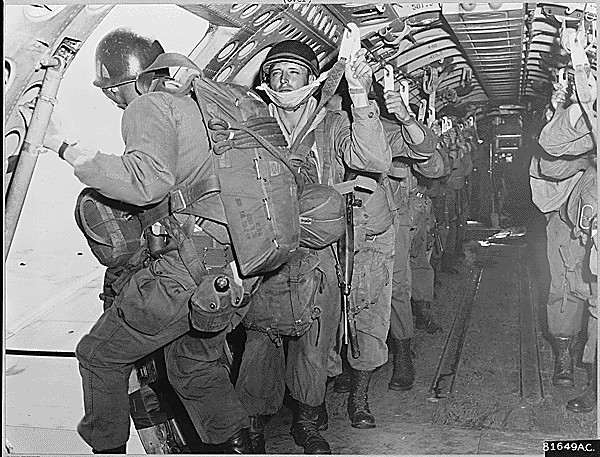
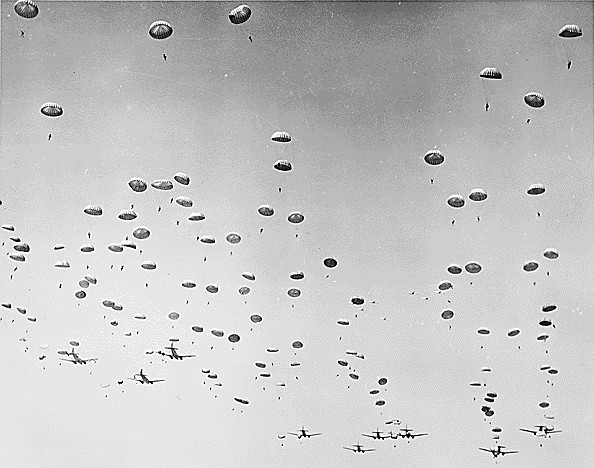
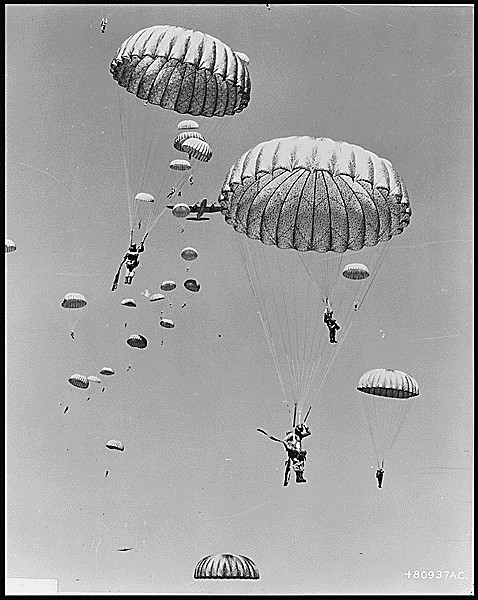
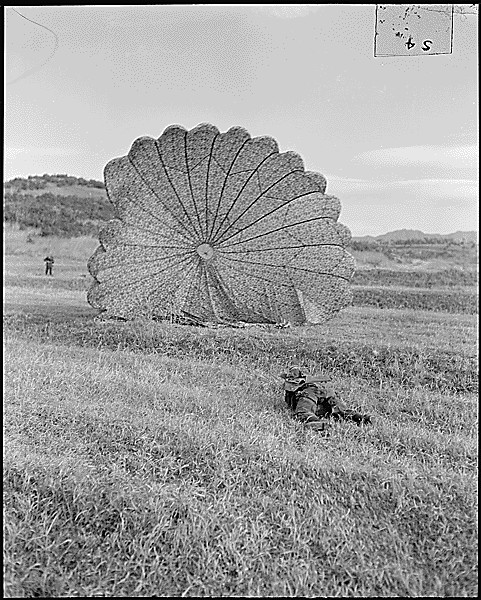
OVER ENEMY TERRITORY IN KOREA -- One of the nine missions assigned to the 315th Air Division (Combat Cargo) is the dropping of Paratroopers in airborne assaults. Far East Air Forces Combat Cargo has participated in two such combat assaults: at Sukchon-Sunchon, Korea, in October 1950 and at Munsan-ni in March 1951. Chutes billow out as troopers of the U.S. Army 187th Regimental Combat Team jump from a formation of U.S. Air Force C-46 "Commandos." While airborne assaults took place, other Combat Cargo planes continued the other missions assigned to the 315th Air Division. Besides airborne operations, FEAF Combat Cargo planes have airlifted more than 1,100,000 passengers and 400,000 tons of cargo on the Korean airlift. (circa March 1952)
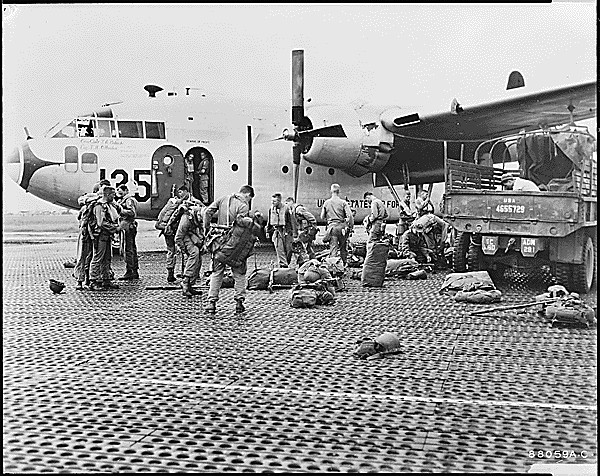
Paratroopers of the 187th Regimental Combat Team put on parachutes and "Mae West" life preservers before boarding a 483rd Troop Carrier Wing U.S. Air Force C-119 "Flying Boxcar," en route to Korea from southern Japan. (Circa July 2, 1953)
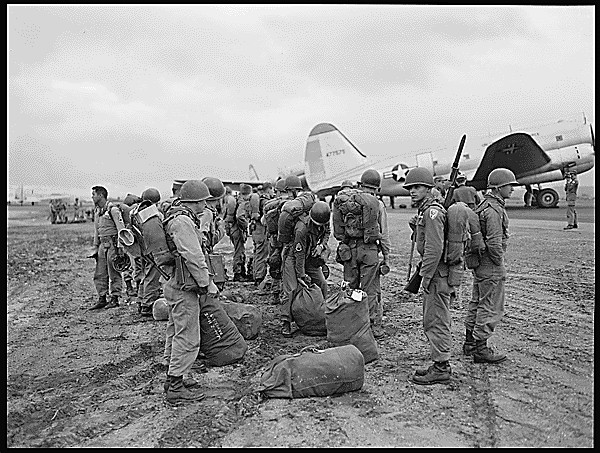
Battle-equipped Paratroopers of the 187th Regimental Combat Team wait to board C-46s of the 315th Combat Cargo Group prior to take-off on an airborne assault mission somewhere in Korea. (circa June 20, 1953)
Date: 20 October 1950
Unit: 187th ARCT, 2nd Battalion
Operation: DZ Easy
Troopers: 1,203
Country: Korea
Dropzone:
Sukchon
Aircraft: C-119 Flying Boxcar
Equipment/supplies air-delivered: Gun jeeps, 105mm artillery pieces
Type Air delivery: Day Mass low-level tactical personnel static-line jump, platform Heavy drop

Unit: 187th ARCT of the 11th Airborne Division, 1st, 3rd. Bn's.
Operation: DZ William
Troopers: 1,470
Country: Korea
Dropzone: Sukchon
Aircraft: C-119 Flying Boxcar
Equipment/supplies air-delivered: Gun jeeps, 105mm artillery pieces
Type Air delivery: Day Mass low-level tactical personnel static-line jump, platform Heavy drop
Date: 21 October 1950
Unit: 187th Airborne Regimental Combat Team (ARCT) of the 11th Airborne Division.
Operation: DZ William
Troopers: 671
Country: Korea
Dropzone: Sukchon
Aircraft: 113 x C-46s and C-119 Flying Boxcars
Equipment/supplies air-delivered: Gun jeeps, 90mm, 105mm artillery pieces
Type Air delivery: Day Mass low-level tactical personnel static-line jump, platform Heavy drop




The C-119's first combat mission included a cooperative airdrop with C-46s on 20 October 1950, when 2,860 Army paratroops and 300 tons of supplies were dropped at Sukchon during the drive to Pyongyang in North Korea. General MacArthur planned to employ the airborne troops of the 187th Airborne Regiment in a drop north of P'yongyang in an attempt to cut off North Korean officials and enemy troops, and to rescue American prisoners of war who it was assumed would be evacuated northward when the fall of the North Korean capital seemed imminent. MacArthur set the airdrop for the morning of 20 October 1950. The regiment loaded into 113 planes, C-119's and C-46's of the 314th and 21st Troop Carrier Squadrons based in Japan. This flight carried about 2,800 men. The planes were crowded-a typical C-119 carried 46 men in 2 sticks of 23 men each, 15 monorail bundles, and 4 door bundles. Each man had a main parachute, a .45 caliber pistol, and a carbine or M1 Garands 7.62mm x 82mm rifle. After the troop drop came that of the heavy equipment-equipment organic to an airborne infantry regiment, including jeeps, 90mm towed antitank guns, 105mm howitzers, and a mobile radio transmission set equivalent in weight to a 2 1/2-ton truck. Seven 105mm howitzers of the 674th Field Artillery Battalion and 1,125 rounds of ammunition were in the drop. Six of the howitzers were recovered in usable condition. This was the first time heavy equipment had been dropped in combat, and it was the first time C-119'S had been used in a combat parachute operation.
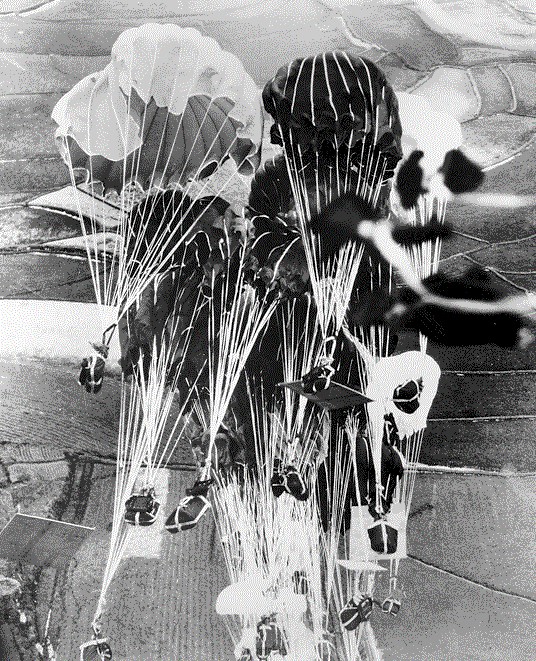
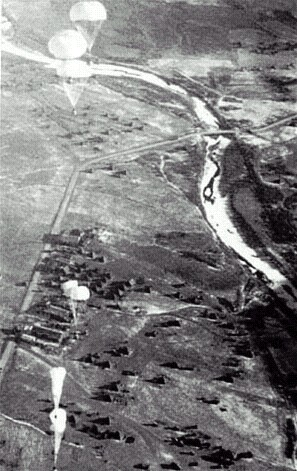
Date: December 1950
Unit: USAF MATS 314th Troop Carrier Squadron
Operation: Save the Asses of the Ungrateful, incompetent marine egomaniacs
Troopers: N/A
Country: Korea
Dropzone: Koto-Ri
Aircraft: C-119 Flying Boxcar
Type Air delivery: Platform Heavy drop Equipment/supplies air-delivered: Bailey Bridge sections to construct complete bridge across mountain gorge to rescue trapped marines
The C-119's greatest feat during the Korean War, however, was a mission to aid the retreat of U.S. marine corps from Chosin in December 1950. During this unprecedented mission, the 314th successfully dropped eight 2,500-pound bridge sections, each measuring 16 x 5 feet. The assembled bridge allowed the troops to span a deep gorge that was blocking their only escape route. In December 1950 two Chinese People's Liberation Army (PLA) divisions, numbering over 300,000 men, entered Korea practically undetected and began closing the jaws of a giant trap. Air Force C-119 "Flying Boxcars" dropped supplies to the marines, but on 7 and 8 December the Chinese closed the sack by blowing the bridge across an otherwise impassible 1,500-foot-wide gorge south of Koto-ri. Without help, the marines would be forced to leave behind their heavy equipment and make it out on foot, a trek many of the wounded and frostbitten would not survive. [What? real marines don't need vehicles, these are pussies thus saith usmc narcissism] Air Force C-119s again answered the call and dropped eight two-ton spans of a treadway bridge for marine engineers, who kept the column moving by bridging the gap.
www.qmfound.com/riggers.htm
Chosion Reservoir Bridge Drop
Perhaps the most famous drop was the first ever airdrop of an M-2 treadway bridge, at Koto-Ri on 7 December 1950. Communist forces had surrounded parts of the 7th Infantry Division and the 1st marine division near the Chosion Reservoir. The Chinese had demolished part of a mountain road over an impassable ravine to their rear, blocking withdrawal by vehicle. The 8081st dropped 1,571 tons of supplies to sustain these 20,000 men from 29 November to 9 December 1950. In an effort to provide an escape route the 8081st constructed platforms for and rigged eight sections of an M-2 bridge that was at Yon-Po airstrip. The next day eight C-119s lifted off, each carrying a 4,500 lbs section of the bridge. In the air the Quartermaster Dropmasters extended the bridge sections 8 feet out of the rear of the aircraft to cut down the ejection time and increase drop accuracy. Dropping into an area only a few hundred feet long, the bridge sections arrived intact, testimony to the skill of the riggers of the 8081st. The marines assembled the bridge which undoubtedly saved lives. This drop showed the high degree of improvisation, speed and ingenuity of the company. One Soldier interpreted the marines' opinion after the drop: "When it comes to handing out plaudits to the Army the marines generally change the conversation to the Halls of Montezuma or talk about the weather. But if the talk gets around to the day the Army's Paratrooper Quartermasters airmailed them a bridge, the song is a lot sweeter."
"The airdrops were a godsend."
- Marine Sgt. Lee Bergee, a survivor of the Chosin Retreat
Notice the marine asshole didn't thank the USAF for dropping the bridge or the us Army for rigging the sections so they could be parachute dropped, without just one of these elements and the marine egomaniac would be TALKING TO God instead of abusing his name to avoid having to give credit to the Air Force/Army who saved his ass.
Date: 23 March 1951
Unit: 187th ARCT 2nd of the 11th Airborne Division & 4th, Airborne Ranger Co's.
Operation: Courageous & Tomahawk
Troopers: 3,486
Country: Korea
Dropzone: Munsan-Ni
Aircraft: C-119 Flying Boxcar
Equipment/supplies air-delivered: Gun jeeps, 105mm howitzers
Type Air delivery: Day Mass low-level tactical personnel static-line jump, platform Heavy drop
Synopsis:
Following the recapture of Seoul, Communist forces retreated northward. Operation COURAGEOUS was designed to trap large Chinese and North Korean forces in the area between the Han and Imjin Rivers north of Seoul, opposite I Corps. The operation featured a parachute drop by the 187th Airborne RCT onto the south bank of the Imjin River near Munsan-ni, twenty miles north of the current front line, and a rapid advance by an armored task force. Both the airborne drop, which used over a hundred C-119 Flying Boxcar transport aircraft, and the armored movement were successfully executed. The drop took place on 22 March 1951, and Task Force Growdon (made up of armored elements from the U.S. 24th Infantry Division's 6th Medium Tank Battalion, borrowed from IX Corps, and infantry elements from the U.S. 3rd Infantry Division) linked up with the Paratroopers on the twenty-third. The 187th faced only weak resistance, and the armored task force faced primarily minefields rather than active defenses. However, once again Communist forces withdrew more rapidly than the UN forces could advance to trap them.
Korean War Air-Mech-Strike: Combat Jump at Munsan-Ni
3D Maneuver by Paratroopers at Munsan-Ni Followed by 2D Maneuver by Tanks: the U.S. Army Can-Do This
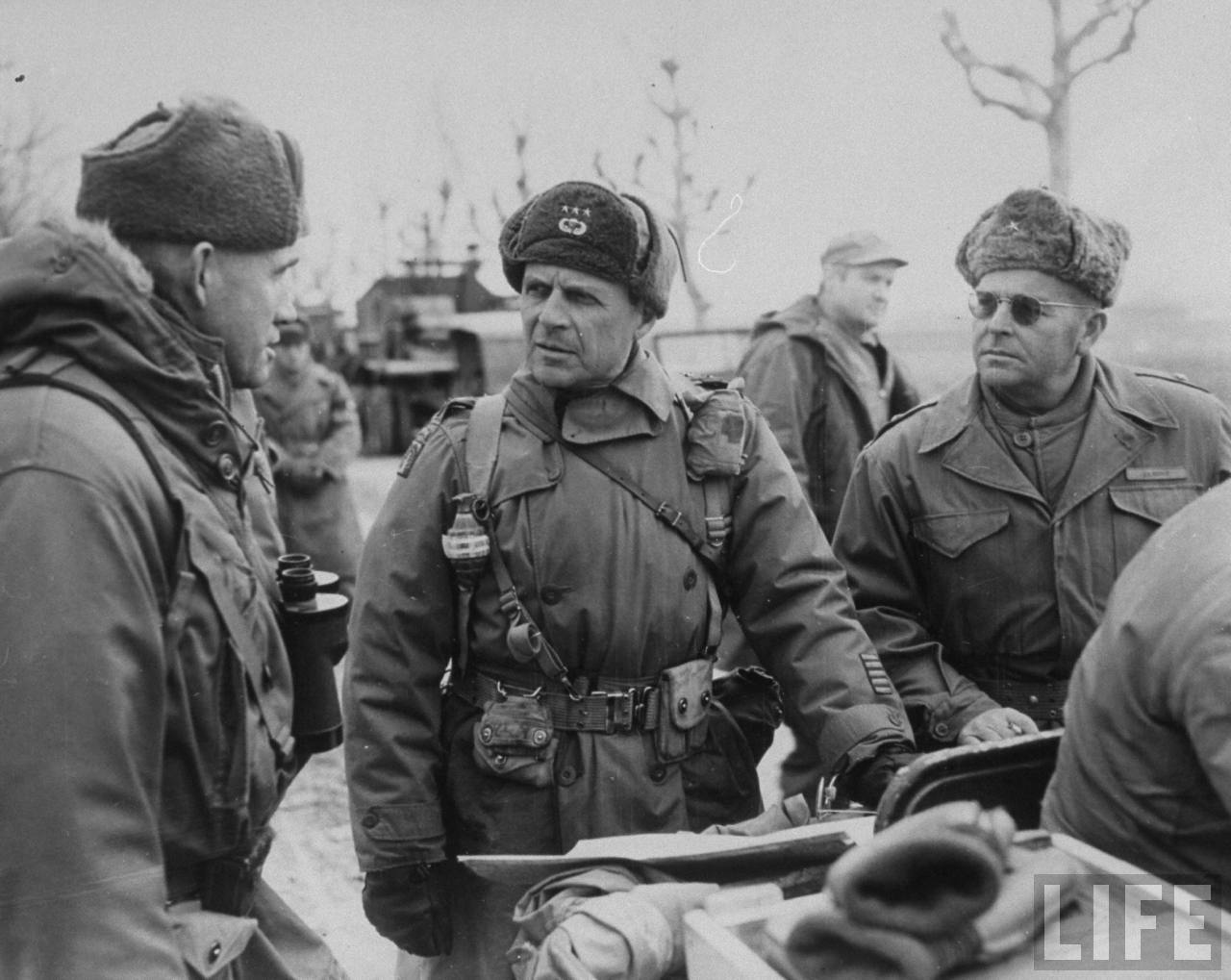
LTG Matthew Ridgway, U.S. Army
www.time.com/time/magazine/article/0,9171,814500,00.html?promoid=googlep
Again at the Parallel
Monday, Apr. 02, 1951
The Eighth Army pushed slowly and methodically along the roads and over the ridge tops on the way back to the 38th parallel. Lieut. General Matthew Ridgway's men prudently refrained from pursuing the enemy pell-mell, painstakingly mopped up his rearguard elements.
The fight for "Tombstone Hill," rising 1,200 feet from a valley on the central front, was typical. A North Korean rearguard clung to its one-man pillboxes studding Tombstone's flank. The fortifications were foxholes, each roofed over by a three-foot layer of logs, stones and earth. Each man inside had plenty of ammo and a two days' bag of rice. U.S. marine Corsairs blasted Tombstone with rockets, seared it with napalm. Shell bursts enveloped it. G.I.s crawled up, peppering the enemy's pillboxes with small-arms fire. Those who survived held off the U.N. attack for two days, then slipped away under cover of night.
The U.N. offensive [Operation Courageous http://en.wikipedia.org/wiki/Operation_Courageous.] took abandoned Chunchon, last important crossroads town on the central front below the 38th parallel. Next day, on the front above Seoul, Uijongbu fell, also without a fight. The enemy seemed to have only one considerable force left in South Korea-perhaps 60,000 strong-guarding the two highways on the west side of the peninsula leading to Pyongyang.
Methodical ground advance would probably not catch this 60,000. On Friday, General Ridgway staged Operation Tomahawk [http://en.wikipedia.org/wiki/Operation_Tomahawk] to do the job.










A fleet of Flying Boxcars and C-46s dropped some 3,300 Paratroopers of the 187th Regimental Combat Team (11th Airborne Division), plus attached Rangers, on the flatlands around Munsan, 22 miles northwest of Seoul and twelve miles below the 38th parallel.




Under Brigadier General Frank S. Bowen Jr., it was the second and biggest paradrop of the Korean war; the first took place last October north of Pyongyang (TIME, Oct. 30).


The 187th quickly seized its objective: a clump of hills dominating what was thought to be the escape route for the retreating Reds.



"The purpose of this operation is to kill the enemy," reiterated General Ridgway, who followed the Paratroopers in a light plane. But Bowen's men found their quarry had slipped out of the trap. Instead of 60,000 Communists, they found less than 20,000.
Paratroopers capture Well-Camouflaged, North Korean Rear Guards







A few hours after the drop, U.N. tank-led task columns from Uijongbu linked up with the chutists.
www.combatreform.org/FM_17_10_Armored_Force_Field_Manual_Tactics_and_Tech1942.pdf
FM 17-18 ARMORED FORCE FIELD MANUAL
17. AVIATION.-a. The role of aviation attached to or operating in support of armored force units, its characteristics, and tactical and technical employment are given in FM 1-5, 1-20, and 100-5.
b. Corps headquarters contain an aviation section that acts in an advisory and technical capacity for the corps commander and coordinates operations of attached or supporting observation and combat aviation.
c. (1) An observation squadron is attached to the armored division. It is equipped both with airplanes of high speed and sufficient range to reconnoiter the area essential to armored operations and with airplanes capable of operation from advanced landing fields.
(2) Observation aviation performs distant and battle reconnaissance (including artillery adjustment), liaison, command, and photographic missions.
Page 11
d. Combat aviation is made available by GHQ. It is employed against targets which cannot be engaged effectively by available ground weapons within the time required and supplements or extends the range of available artillery. Its chief missions in support of large armored force units are:
(1) Neutralization of hostile aviation.
(2) Neutralization of enemy artillery.
(3) Neutralization of hostile defensive installations, including antitank.
(4) Direct support of the attack.
(5) Neutralization of counterattacks, especially of armored units.
(6) Destruction, harassing, or delaying of hostile concentrations, reinforcing, pursuing, or retreating forces, and rear installations and centers of communication.
e. Transport aviation will be furnished by GHQ for the supply of elements of armored units when operating beyond the sources of normal supply or when no land communications are available.
1. Either parachute troops or air-borne troops may be employed in conjunction with the operations of armored units to secure terrain objectives on the routes of march or to seize vital points in rear of the hostile front. They may establish support groups and supply bases for a break-through.






The enemy was still withdrawing; north of the 38th parallel he was either digging in for a stand or marshaling fresh forces for another attack.
Enlisted Soldier's account of Munsan-Ni Combat Jump

New LIFE magazine pictures by John Dominis from GOOGLE image search of found many pics of the Korean war combat jump revealing important details like that the paras used M6 Cole carts to move their heavy 4.2" (107mm) mortars:
http://images.google.com/hosted/life/l?q=parachute+source:life&imgurl=500d2b797f804837
THE PALLADIUM TIMES
Oswego, New York, Friday, March 23, 1951
PARATROOPERS BATTLE REDS
3,300 Chutists Outnumbered by 20,000 of Enemy
Jumpers Bolstered By Tough Rangers Land Behind Communist Lines North Of Seoul; Chinese And North Koreans Try To Wipe Out Allies, Aided By Armored Column And Infantrymen
Tokyo (AP)
American Paratroopers bolstered by tough Rangers jumped today behind Communist lines north of Seoul and shocked some 20,000 Red troops into hasty flight. The Paratroopers filled the sky with their brightly-hued parachutes like a massive Easter bouquet. But the Communists rallied later and were fighting desperately to surround and wipe out the 3,300 outnumbered American jumpers. An armored column spearheading a fresh allied drive by three divisions north of Seoul linked up with the Paratroops near the drop area south of Munsan. Lines of infantrymen trudged up the road for miles behind, moving to the aid of the hardfighting chutists.





--General Matthew Ridgway
A second column rolled through the road center of Uijongbu and fanned out to the east, north and west. But the Reds west of Uijongbu, late Friday, were pouring heavy artillery and mortar fire into the allied positions. Munsan is 21 miles northwest of Seoul and only nine miles south of Red Korea. Uijongbu is 11 miles north of Seoul. 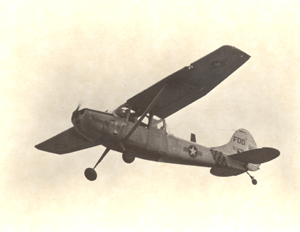 Lt. Gen. Matthew B. Ridgway landed in a light plane only 29 minutes after the first Paratrooper jumped. A field dispatch said he was in the thick of one firefight. In Central Korea, an American armored patrol pushed within two and one-quarter miles of Parallel 38 north of Chunchon without opposition. The air assault was made behind 15,000 to 20,000 Communist troops, possibly the rear guard of a 60,000 man force reported earlier in the area.
Lt. Gen. Matthew B. Ridgway landed in a light plane only 29 minutes after the first Paratrooper jumped. A field dispatch said he was in the thick of one firefight. In Central Korea, an American armored patrol pushed within two and one-quarter miles of Parallel 38 north of Chunchon without opposition. The air assault was made behind 15,000 to 20,000 Communist troops, possibly the rear guard of a 60,000 man force reported earlier in the area.
145 Cargo Planes

Allied armor speeding north from Seoul in a new three-division offensive linked up with the chutists a few hours after the mass jump from 145 combat cargo planes. The airborne assault was completed in one hour. AP correspondent John Randolph, who watched the landing from an accompanying plane, said the vari-hued chutes wafted down "swinging in the air like giant floating flowers of many colors." Ammunition cases, jeeps and artillery swing like pendulums as they chuted down.
Ammunition Bundles Precede Paratroopers from C-119 Forward Fuselage Floor Trap Door and Rear Side Doors






Note the All-Terrain Carts used to transport the Paras' 4.2" (107mm) Heavy Mortars!
Heavy Drop Loads from C-119 Rear Clamshells Removed: 105mm towed Howitzers, Ammo and 4x4 Jeep Trucks



Displaced by War, South Korean Civilians Try to Confiscate Cargo Chutes but are Driven Away


Helicopters fly out wounded Soldiers; pack-mules help distribute supplies...


S-51 "Pin-Wheel" helicopter with casualty pod

"It would be beautiful-really beautiful-if it weren't so terrible," said Lt. Col. T.A. Edward of Tulsa, Okla., a U.S. Eighth Army intelligence officer. The Paratroopers met no opposition in the first minutes after landing. They slipped out of their chutes and ran into skirmish order standing up - something men never do when bullets are flying. But as they pushed out from the tight drop area, they ran into opposition from small, scattered groups of Reds. Some of the Reds put up a stiff fight. The airborne infantrymen knocked these out with their artillery and some fighter plane support. Communist troops apparently were all around the Paratroopers. An Eighth Army staff officer in the parachute force said there was continuous fire on the boundary of the drop area. Ridgway said the operation was aimed "to kill the enemy."

Brig. Gen. Frank S. Bowen, Jr. told his Paratroopers: "I wish you all a happy landing. I'll see you on the ground." He cautioned officers: "Make the men dig in...get buttoned up in those goose eggs (the drop zone)."


The 187th Airborne Regimental Combat Team-bolstered by tough, wiry Rangers specially trained for behind-the-lines fighting - hit the Korean dirt near Munsan, nine miles south of Parallel 38 and 21 miles northwest of Seoul. A field dispatch said the operation "looked like sweet peas suddenly blooming in the spring. Parachutes blossomed into red, blue, yellow and gray flowers that drifted down to the fields and rice paddies." Ridgway, a Paratrooper himself, landed among the troops in a [L-19/O-1 Bird Dog] light observation plane 29 minutes after the first chutist "hit the silk." The Paratroopers quickly cut the Red supply road running south from Kaesong, two miles south of the border.
No Appreciable Losses
Ridgway said the air troopers "landed with no appreciable losses, and are now proceeding to secure their objectives." The only mishap was the explosion of a C-119 Flying Boxcar cargo plane in the air after it delivered its Paratroopers. AP correspondents Tom Stone and John Randolph, who witnessed the airdrop from accompanying planes, said there was no apparent contact with enemy ground troops by the Paratroopers at the initial landing. A major said: "Seems to me theres no sweat. It looks like a good show." The flying boxcars met no anti-aircraft fire. No enemy planes rose to try to break up the surprise allied move. United Nations warplanes blistered Red-held hills just ahead of the Paratroopers. The drop began at 9 a.m. and was completed in an hour. The Paratroopers landed in an area less than a mile long. They were within Red positions described by intelligence as 15 miles deep. It was the second airborne landing of the war. The first, on a smaller scale, was in North Korea, northwest of the Red capital of Pyongyang, last Oct. 20 and 21. AP correspondent Jim Becker reported after a flight over the new battleground that Red foxholes and entrenchments were empty. "They sure were not yesterday" his pilot told him. "I can't understand it."
Once the 2D Maneuver Force linked up with the Paras, Self-Propelled Howitzers Silenced Enemy Guns



LIFE magazine photos by John Dominis
Date: 12 February 1962
Unit: FTT-1 White Star SF Team
Operation: Nam Beng Valley Campaign vs. Pathet Lao
Troopers: 12
Country: Laos
Dropzone: Nam Tha airstrip
Type Air delivery: Day Mass low-level tactical personnel static-line jump

President Kennedy with SF Paratroopers at Fort Bragg, NC
Date: 2 January 1963
Unit: Joint General Staff reserve ARVN Paratroopers with U.S. MACV "Red Hat" Advisors from Saigon
Operation: Ap Bac
Troopers: 300 South Vietnamese, 2 Americans
Country: South Vietnam
Dropzone: Ap Tan Thoi
Aircraft: 7 x USAF C-123 Providers
Type Air delivery: Day, Mass low-level tactical personnel static-line jump
Details: www.combatreform.org/johnpaulvann.htm
Heart of Darkness: the Tragedy of the Congo, 1960-67
Date: 24 November 1964; 0600 hours ZULU time
Units: USAF C-130E squadron, Belgian Paratrooper Regiment
Operation: Dragon Rouge
Troopers: 338 Belgians, 2 Americans
Country: Belgian Congo
Dropzone: Stanleyville Airport (7,086 feet long, MOG: 3 x C-130s)
Aircraft: USAF C-130E Hercules, 2 x CIA Cuban-exile piloted B-26 Invaders
Equipment/supplies air-delivered: Armored gun jeeps, jeeps, AS-24 tricycle ATVs, crew-served machine guns
Type Air delivery: Take-off from Kamina airport; "Close Look" doctrine: approach Stanleyville DZ under 500 feet, pop-up to 700 foot jump altitude line astern formation at 20 second intervals; day mass low-level tactical personnel static-line jump on signal from navigator's computed air release point (CARP).
DETAILED HISTORY:
Dragon Operations: Hostage Rescues in the Congo, 1964 - 1965, Major Thomas P. Odom.
www-cgsc.army.mil/carl/resources/csi/odom/odom.asp
Operation DRAGON ROUGE, "RED DRAGON" in English, was one of the most dramatic military missions undertaken during the Cold War. It involved a flight of more than 4,000 miles by USAF C-130Es carrying Paratroopers of the crack Belgian ParaCommando Regiment to rescue hostages who had been held for more than three months in the Congolese city of Stanleyville.
Africa was an unstable place in the 1960s, even more so than it is today. The former Belgian Colony of Congo, now known as Zaire, was granted independence in 1960, and almost immediately became the site of chaos. When the crisis ended in early 1964, a new one broke out as Congolese rebels calling themselves "Simba" rebelled against the government. The Congolese government turned to the United States for help. In response, the U.S. Strike Command sent JTF LEO, a task force made up of a detachment of C-130Es, communications personnel and an 82nd Airborne security team, to Leopoldville.
By early August, 1964 the Congolese, with the help of the LEO force and a group of white mercenaries led by Colonel BEM Frederick Vandewalle, Belgian Army and Major Mike Hoare, were making headway against the Simbas. In retaliation, the Simbas began taking hostages of the whites in areas under their control. They took them to Stanleyville and placed them under guard in the Victoria Hotel.
While the world watched anxiously, in Washington and Brussels the United States and Belgium were hard at work trying to come up with a rescue plan. Several ideas were considered and discarded, while attempts at negotiating with the Simbas failed - no one reliable could be found to negotiate with!
In mid-November the C-130Es and crews of the Tactical Air Command rotational squadron from Pope AFB, NC were called back to their temporary duty base at Evreux-Fauville AB, France from missions throughout Europe. The crews were told simply to go to their barracks and get some rest, because something big was brewing. On Tuesday evening, November 17, the crews were told to report to the operations room on the Margarite where the airplanes were deployed. The crews were told to rig seats and take-off. Just before take-off, each navigator was given a Manila envelope and instructed not to open it until their airplane had reached 2,000 feet and there were no mechanical problems to make them turn back. When the crews opened the envelopes, they learned they were going to Klinebrogel, a Belgian military airfield outside Brussels. When they got to Klinebrogel, each airplane loaded with Paratroopers wearing red berets, then took off again after being handed another envelope. This time it told them to head south for Moron AB, on the Spanish Mediterranean. At Moron the navigators went into Base Operations where they were given maps and instructions for the next leg of their flight, to Ascension Island in the South Atlantic, where they arrived 18 hours after leaving France.
By this time everyone knew they were on their way to Africa, but first there was a time of "hurry up and wait" on secluded Ascension, where the rescue force was out of sight of the prying eyes of the world. While they waited, the American airmen and Belgian paras got to know each other, and began working out procedures to drop the Belgians.
On Sunday before Thanksgiving the force left Ascension and flew across the Atlantic and much of Africa to Kamina, an airfield in the southern Congo. There the crews and Paratroopers waited again. By this time all hopes of negotiation had vanished, and that evening the American and Belgian commanders were told to launch Operation DRAGON ROUGE.
In the early hours of November 23, 1964, 5 x C-130Es took off from Kamina, each with a minimum of 64 Belgian Red Berets in full combat gear seated on the red nylon troop seats in its cargo compartment. Behind the assault force came seven more Herks, with Chalk 12 configured as a hospital ship. The C-130Es flew north at high altitude, then dropped down to treetop altitudes to follow the Congo River as they neared the city of Stanleyville.
As the sun was breaking over the horizon out of the African Veldt, two CIA B-26 Invaders flown by Cuban mercenary pilots made a multiple .50 caliber heavy machine gun strafing pass over the Stanleyville Sabena airport. Right behind the A-26s, the first C-130E roared low over the runway. As the airplane came over the field, Paratroopers led by Colonel Charles Laurent spilled from the doors on either side of the airplane. Within seconds, 310 Paratroopers were in the air, then landing on the strip of grass alongside the runway. The five jump planes came around for a second pass to drop the jumpmasters and bundles of equipment. As the airplanes came off the drop zone, they began taking fire from a .50-caliber Heavy Machine Gun which was later silenced by NCO initiative on the ground. After dropping the troops, Chalks Two through Five left the area for Leopoldville, where they were to refuel and stand-by. Chalk One, carrying the C-130E mission commander, Colonel Burgess Gradwell, and flown by Captain Huey Long of the 777th TCS, orbited over the airfield until they were hit by several heavy shells that knocked out hydraulics. Long pointed the battle-damaged airplane toward Leopoldville.
Forty-five minutes after he jumped, Col. Laurent reported that the airfield was secure. Five other C-130Es roared in for assault landings from their orbit point near Stanleyville. Each airplane discharged troops and vehicles to join the Paratroopers on the ground, then took off again and headed to Stanleyville. Meanwhile, Chalk Six, flown by Captain Mack Secord's crew, approached Stanleyville. They had lost a life raft after takeoff from Kamina and had to return for the spare airplane. Secord was told to land, and wait with Chalk Twelve, the hospital plane, until the Belgians returned to the airport with the hostages.
After leaving the airport, the Belgian rescue team made haste to reach the Victoria Hotel before the Simbas carried out their threats to kill the hostages if a rescue was attempted. Several blocks from the hotel a Paratrooper rounded a corner just in time to prevent the Simbas from firing a second volley of shots into the assembled hostages, who had evidently been walking toward the airport. Some of the hostages later said they thought the Simba officers intended to turn them over to the Belgians unharmed, but some of the Simbas, who had been drinking and smoking hemp all night the night before, decided to take matters in their own hands. They shot their own officers, then turned their guns on the hostages. They had fired one volley, picking women and children as their targets, and were preparing to fire another when the Red Berets showed up on the scene. At the sight of the Belgians, the Simbas lost their courage and ran! The Belgian Paratroopers had stormed the city and freed the hostages. Casualties included 3 Soldiers dead and 7 wounded, as well as 27 dead among the hostages, but 2000 hostages were saved
After more than an hour on the ground at Stanleyville, Mack Secord's crew finally saw the first hostages coming toward them. As they were the most badly injured, they had been driven to the airport. Seeing the engines running and thinking the C-130E was about to take-off, the frightened whites rushed aboard the airplane through the open rear ramp. Secord's loadmasters, there were two aboard, tried to get them over to the other airplane where a doctor waited to tend their wounds. After finally getting the most seriously injured people to leave, Secord's crew closed up their airplane and began taxing for the runway. As they passed a clump of elephant grass, a pair of Simbas ran out. One ran alongside the airplane trying to get inside the door while the other sprayed the underside of the wing with a submachinegun. No one inside the airplane knew what had happened; the whole thing was witnessed by the crew of Chalk 12. Secord took off and headed for Leopoldville. When he got there, he had to be bodily lifted from the airplane and taken to the hospital where he was treated for a brain concussion he had received the night before when he bumped his head getting into the airplane.
For the rest of the day, C-130Es and other transports shuttled between Stanleyville and Leopoldville. More than 2,000 people were airlifted out of the city. That night a Belgian mechanic working on a DC-4 was killed by sniper fire. Several times during the day the field was mortared, and every airplane was hit by ground fire during their landings and takeoffs. One was hit in a wing fuel tank. The airplane crew chief whittled a plug from a broom handle and wrapped it with a rag and used it to plug the leak.
The airlift continued the next day. Late in the day the Belgians were pulled out of the city and flown to Leopoldville. Early the next morning a smaller scale mission designated as DRAGON NOIR/BLACK DRAGON, freed hostages held at Paulis, a town 225 miles northwest of Stanleyville. The hostages at Paulis had also been harmed by the Simbas. An American missionary had been beaten to death during torture.
Date: 26 November 1964; 0602 hours ZULU time
Unit: USAF C-130E squadron, Belgian Paratrooper Regiment
Operation: Dragon Noir
Troopers: 246 Belgians
Country: Belgian Congo
Drop zone: Paulis Airport
Aircraft: 4 x C-130E Hercules turboprop aircraft, 2 x B-26 Invader aircraft
Equipment/supplies air-delivered: Armored gun jeeps, AS-24 tricycle ATVs, crew-served machine guns
Type Air delivery: Day Mass low-level tactical personnel static-line jump
After DRAGON NOIR, the rescue force retired to Kamina to await further orders. While they were waiting, an African thunderstorm prompted one C-130E crewmember, none of whom had had a bath in days, to grab soap and go out into the rain for an impromptu shower. The rest of the force followed his lead as the airmen and Paratroopers ran around naked in the rain! A few days later, in response to political pressure from the Third World, President Lyndon Johnson ordered the force out of Africa.
For their role in DRAGON ROUGE, the C-130E crewmembers received the 1964 MacKay Trophy for the most meritorious flight of the year by USAF aircraft. All of the crewmembers were decorated with the Air Medal, while Captain Mack Secord received the Distinguished Flying Cross.
Further reading: Dragon Operations: Hostage Rescues in the Congo, 1964-1965 by Major Thomas P. Odom, U.S. Army
Date: 27 April 1965
Unit: 2 x Brigade Combat Teams (BCTs) and "A" Troop of the 17th Cavalry of the 82nd Airborne Division
Operation: Power Pack
Troopers: 2, 112+
Country: Dominican Republic
Dropzone: San Isidro airfield
Aircraft: 144 x C-130 Hercules
Equipment/supplies air-delivered: machine gun and 106mm Recoilless Rifle jeeps, 3.5" bazookas
Type Air delivery: airland, drop cancelled
Power Pack: U.S. Intervention in the Dominican Republic, 1965 - 1966, Dr. Lawrence A. Yates
www-cgsc.army.mil/carl/resources/csi/yates/yates.asp
EXCERPT:
Once the ambassador, the junta, and the U.S. commanders reached a consensus, the military operations commenced. At San Isidro, the 3rd Brigade of the 82nd began to move at daybreak (see map 5). [16] While the 1st Battalion, 505th Infantry, secured the airfield, the 1st Battalion, 508th Infantry, together with the cavalry troop and engineer attachments, moved in two columns toward the Duarte bridge. Intelligence provided no accurate estimate of rebel strength, although word circulated that the Constitutionalists were operating in groups of fifteen to twenty men with little central control and were incapable of offering resistance other than small-arms sniper fire. Because those Constitutionalists who had defected from the military ware uniforms identical to those of the Loyalists, a U.S. officer suggested that junta forces in the area wear their caps backwards to avoid accidentally coming under U.S. fire.
Within fifteen minutes, the lead elements of the 508th had made contact with junta forces on the eastern side of the bridge. An hour later, U.S. troops had secured the position. A patrol then crossed the bridge to contact Loyalists on the west side and to determine their positions. A larger U.S. force would follow but not until the east bank of the Ozama, especially the Villa Duarte area to the south from which increasing sniper fire was being received, had been cleared of rebel pockets. One company and a reconnaissance platoon cleared the area north of the eastern bridgehead, while another company and the cavalry troop moved against Villa Duarte. These were time-consuming operations, requiring house-to-house searches, but by midafternoon, the east bank was secure. Operating in accordance with an order to fire only when fired on, Company "C" of the 508th-flanked by the battalion's Company "B" and the 505th Battalion's Company "C"-crossed the bridge in force. Sniper fire and the remains of burned-out vehicles slowed their advance. Once on the west bank, they fanned out to secure the bridgehead, particularly the vital power plant to the south, which Company "C" of the 1st Battalion, 505th Infantry, seized under "withering fire." By late afternoon, U.S. forces had relieved all but a small number of Loyalists on the west bank. Besides the power plant, American troops controlled a semicircle with a six-block radius. On the east bank, units had moved all the way south into San Souci and had established positions atop an eight-story silo overlooking the rebel stronghold downtown. The entire operation had cost the Paratroopers five casualties, none of them serious.
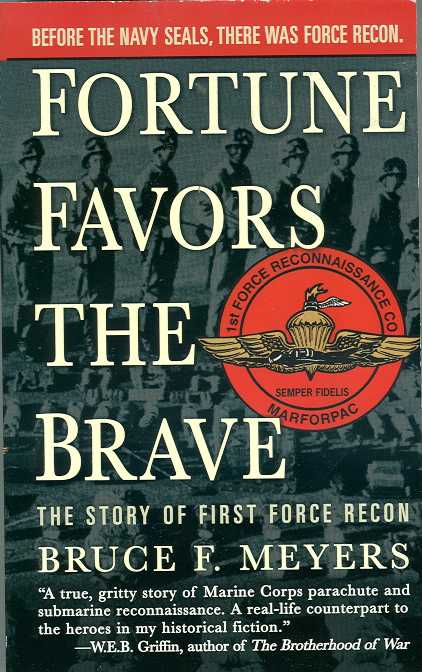
Force Recon pioneer Bruce Meyers revealsin his book, (3) USMC Force Recon parachute jumps were made in combat in Vietnam, not just the infamous failed "Doc" LaPorte jump. Two were successful.
Date: 14 June 1966
Unit: 4th Platoon, 1st Force Recon
Operation: ?
Troopers: 13
Country: South Vietnam
Dropzone: 35 miles NW of Chu Lai
Aircraft: 1 x U.S. Army piloted CV-2 Caribou piston-engined STOL aircraft
Equipment/supplies air-delivered: personal weapons, rucksacks, radios, food, water
Type Air delivery: Night low-level tactical personnel static-line jump
Bruce Meyers reports the recon team was lead by Captain Jerome T. Paull with the team exiting at 0205 hours. They landed tightly together (less than 150 meters apart) in a small, 500-meter grassy hillside. They buried their T-10 main and T-7 reserve parachutes and set-up and observation post reporting enemy troop movements. On the second day, a dog following two Vietnamese wood cutters discovered and dug up the parachutes. Shortly thereafter, they observed a Viet Cong unit alerted by the wood cutters searching the area. "Compromised" the marines requested and got an emergency extraction by UH-34 SeaHorse helicopters back to Chu Lai.
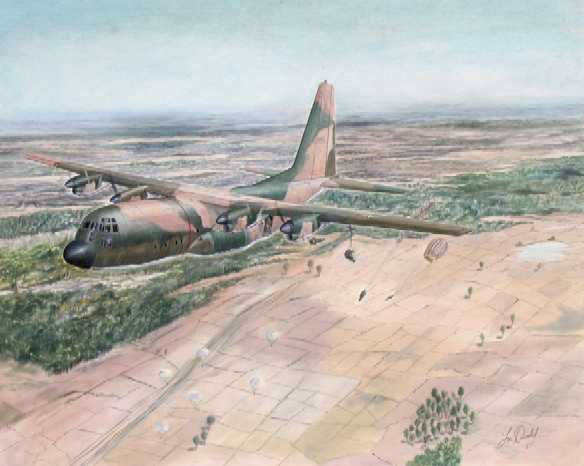

Awesome painting by legendary Paratrooper, artist and aviator Lou Drendel of the 1967 173rd Airborne Brigade jump into Vietnam called "OPERATION Junction City"
Date: 22 February 1967
Unit: 173rd Airborne Brigade
Operation: Junction City
Troopers: 845
Country: Vietnam
Dropzone: Katum
Aircraft: 21 x C-130E Hercules turboprop aircraft
Equipment/supplies air-delivered: Gun MULE ATVs (M274s), 105mm artillery pieces, 81mm, 4.2 inch mortars, 1/4 ton jeeps, 3/4 ton trucks
Type Air delivery: Day Mass low-level tactical personnel static-line jump
LTG John Tolson writes: http://www.army.mil/cmh-pg/books/Vietnam/Airmobility/airmobility-ch07.html
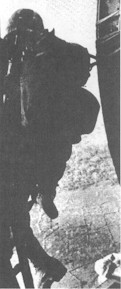
"At 0900 hours on 22 February 1967, Brigadier General John R. Deane, Jr., stood in the door of a C-130E aircraft. When the green light flashed, General Deane jumped, leading the first U. S. parachute assault in the Republic of Vietnam, and the first such assault since the Korean conflict fifteen years earlier. This parachute jump of the 2nd Battalion, 503rd Infantry, signalled the beginning of Operation JUNCTION CITY ALTERNATE. The original plan, as conceived in November 1966, called for the 1st Brigade of the 101st Airborne Division to make the parachute assault; but, much to their chagrin, they were engaged in other operations and the honor was to go to the 173rd.
Operation JUNCTION CITY employed the 1st and 25th Infantry Divisions, the 11th Armored Cavalry Regiment, the 196th Light Infantry Brigade, elements of the 4th and 9th Infantry Divisions, and South Vietnamese units, as well as the 173rd Airborne Brigade. Their target was enemy bases north of Tay Ninh City, in the area the French had named "War Zone C." The decision to make a Paratroop assault was based on the urgency to place a large force on the ground as quickly as possible and still have enough helicopter assets to make a sizeable heliborne assault as an immediate follow-up.
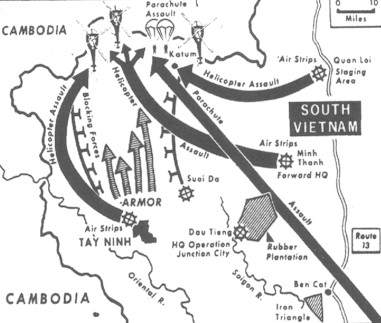
The requirement for helicopter lift on D-day was substantial. The 1st Infantry Division had five infantry battalions to put in by air assault and the 173rd had three infantry battalions. In addition to the requirement for the Huey slicks, there was a tremendous requirement for CH-47 lift for positioning artillery and resupply of ammunition. The 173rd had computed that they would free 60 Hueys and six Chinooks for support of other forces by using the parachute assault technique. The Paratroopers were assigned landing zones farthest to the north-areas that would have cost many extra minutes of flying time for lift helicopters.
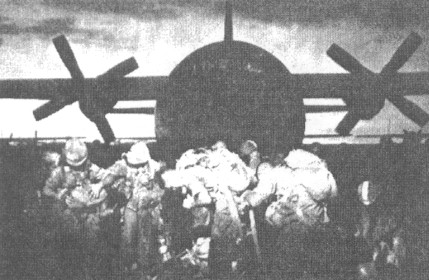
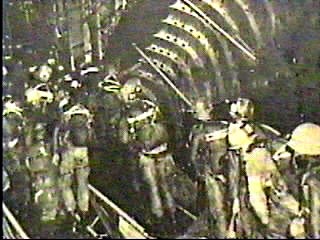
The 173rd was placed under the operational control of the 1st Infantry Division for this operation and developed an elaborate deception plan to avoid possible compromise of the drop zone. In the planning phase only the commanding general, his deputy, and two key staff officers were aware of the actual drop zone. The cover plan designated a larger alternate drop zone outside the planned area of operation. This permitted all the necessary staging preparations which must precede an airdrop and all necessary coordination with the Air Force. The actual drop plan for the airborne assault phase of the operation was not distributed to the units until 1900 hours on 21 February, the evening before D-day. After Lieutenant Colonel Robert H. Sigholtz, the Airborne Task Force Commander, briefed his troops on the operation, he sealed off his battalion area as a security measure. Thirteen C-130E's were used for the personnel drop and eight C-130E's for heavy drop of equipment. Jump altitude was 1,000 feet.
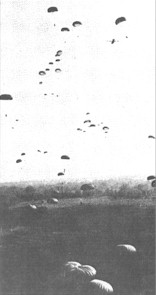
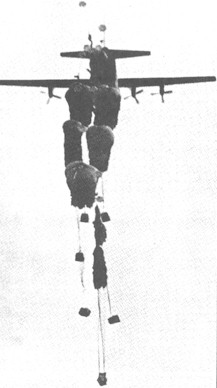
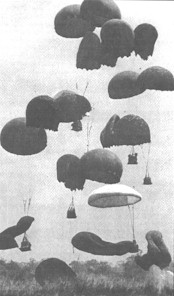
The battalion dropped on schedule and by 0920 hours on D-day all companies were in their locations around the drop zone. Out of the 780 combat troops who made the assault, only eleven sustained minor injuries. The heavy equipment drop commenced at 0925 hours and continued throughout the day. The 1st Battalion, 503rd Infantry began landing by helicopter assault at 1035 hours and the entire battalion was in place shortly thereafter. No direct contact with an enemy force occurred during these early hours of D-day. Another infantry battalion, the 4th Battalion, 503rd Infantry, conducted a heliborne assault into two other close landing zones at 1420 hours and phase one Of JUNCTION CITY ALTERNATE was essentially complete.
During this operation, the 173rd Brigade was supported by the 11th, the 145th, and the 1st Aviation Battalions. Over 9,700 sorties were flown in support of the operation and Army aviation lifted 9,518 troops and a daily average of fifty tons of cargo. While the initial parachute assault phase received most of the publicity, the subsequent tactical moves were made by helicopter and the momentum of the operation depended on this support.
As might be expected, some operational problems resulted from this first mix of parachute and heliborne operations. One accident and several near accidents were experienced as a result of helicopters trying to land in an area littered with parachutes. There just wasn't time to adequately police the drop zone. Also there were some problems on Tactical Air coordination. Long delays were imposed prior to a tactical air strike by the communications and coordination required between the large number of units involved. While safety was of prime consideration, there were periods of time when no ordnance was being delivered against the enemy. In addition, General Deane had noticed that air strikes were being called in when troops were unable to break contact, forcing the jets to break away without having an alternate target. However, the control and coordination procedures began to smooth out after the first few hours of confusion.
This combined operation, which the 173rd Brigade had begun so dramatically, continued until mid-May. The enemy lost over 2,700 dead along with vast amounts of ammunition, medical supplies, and more than 800 tons of rice. War Zone "C", which had been an exclusive Viet Cong stronghold for many years, was now vulnerable to the allied forces at any time of their choosing. In retrospect, there is no question that the parachute assault which began JUNCTION CITY ALTERNATE was effective. The troopers had been well trained and knew what to expect but, as General Deane stated, "More importantly, they did what was expected of them."
The employment of the airborne parachute force is historically visualized as a theater-controlled operation aimed at achieving strategic surprise...the very existence of this capability complicates the enemy's planning and offers the friendly commander one more option of surprise. In this instance, which involved multiple units in a major operation, there was a greater demand for helicopter lift than there were helicopter assets. As a result, the 173rd pushed strongly for a parachute assault".
On February 22nd, 1967, Paratroopers of the 2nd Battalion, 503rd Infantry, 173rd Airborne Brigade, parachuted into a wide clearing in the jungle of War Zone "C" as part of Operation Junction City.
Photos:

Their mission was to form a blocking force near the crossroads hamlet of Katum, South Vietnam, to support a large-scale cordon and search by U.S. forces. The 780-man Airborne task force was delivered in two sorties of aircraft from Bien Hoa Airbase. The personnel drop of 13 x C-130E Hercules aircraft arrived over Drop Zone Charlie at 9:00 a.m. General Jack Deane, Commander of the 173rd Airborne Brigade, Lieutenant Colonel Robert Sigholtz, Commander of the 2-503rd Task Force, and Sergeant Major Harold Proffitt led the jump from the first aircraft. A total of 778 troopers hit the silk in two passes over the small drop zone, settled to the earth, and began assembling without any enemy opposition. Thirty minutes later, 10 heavy drop C-130Es arrived and dropped 6 x M101 105mm howitzers, 4 x 4.2 inch mortars, 6 x 81mm mortars, 4 x 3/4-ton trucks, 5 x jeeps, 6 x M274 "Mule" vehicles, one trailer, and 3900 rounds of artillery and mortar ammunition. By 10:00 a.m., all 845 men and equipment were deployed into blocking positions and the command post and artillery firebase were established. As units from the U.S. 1st and 25th Infantry Divisions, the 11th Armored Cavalry Regiment, and the 173rd Airborne Brigade began closing the horseshoe around suspected Vietcong (VC) and North Vietnamese Army (NVA) positions, Operation Junction City became a series of small unit firefights for the Paratroopers. On February 28th, the "Sky Soldiers" of the 173rd overran the Viet Cong Central Information Office, a key enemy propaganda facility. As the multi-divisional attack continued through mid-May, major battles raged around the horseshoe with three Vietcong regiments and one regiment of NVA regulars. Operation Junction City succeeded in driving major enemy forces from War Zone "C" across the border into sanctuaries in Cambodia. The operation was terminated on May 14, 1967.

Date: 2 April 1967
Unit: 5th Special Force Group (ABN), 1st Special Forces: CIDG Detachments, A-503 Mike Force & A-344, Operation Harvest Moon (Includes Montagnards)
Operation: Harvest Moon
Troopers: 300
Country: Vietnam
Drop zone: Bunard, Phouc Long "Happy Dragon" Province
Aircraft: C-123 Providers
Type Air delivery: Day Mass low-level tactical personnel static-line jump
PHOTOS: www.hialoha.com/Vvet/early.html
The middle picture was taken over DZ Bunard, 65 miles N.E. of Saigon, setting up area control to establish a new SF camp. The photo with the planes was taken at the Nha Trang airfield as the CIDG and SF troops were loading for the jump. The photo on the right is the interior of the 1st aircraft just prior to the jump. SSG Whitting (18D SF Medic) was the 5th man in the 1st stick to exit.
These pictures courtesy of SSG Scott Whitting
Date: 13 May 1967
Unit: Mobile Strike Force (Mike Force), 5th Special Forces Group (Airborne): Detachment A-503, Co's. 3, 4 & 5; 4.2 inch Heavy Mortar platoon & Hdqts. group. Water jump (0600 hrs.) at 700 ft.
Operation: Blackjack
Troopers: 486
Country: Vietnam (SW corner)
Drop zone: Seven Mountains ( Near Chi Lang, 1km S of Nuai Yai)
Aircraft: C-123 Providers
Type Air delivery: Day Mass low-level tactical personnel static-line jump
Date: 5 September 1967
Unit: USMC, 1st Force Recon
Operation: Oregon
Troopers: 10
Country: South Vietnam
Drop zone: SW of Da Nang
Aircraft: USAF C-7 Caribou
Type Air delivery: Night personnel, static-line jump tail gate jump
Mission was to verify if 30mm Russian rockets were present capable of nuclear strikes. USAF pilot failed to drop team at 800 feet and jumpers were 1, 500 to 2, 000 feet and drifted away from the drop zone into triple canopy trees smashed by previous B-52 heavy bomber strikes. Patrol Leader Gunnery Sergeant Webb was injured in the groin and stuck up in a tree. By dawn he had gotten down, found Sgt. James H. Hager but were spotted by a 3-man VC patrol. Unable to walk, Webb became separated and used his RT-10A survival radio to get an extraction by USAF HH-3 Jolly Green Giant helicopter at 1830 hours.
SGT M.D. McNemar joined with CPL "Pappy" Garcia and found two more team mates, CPL John W. Slowick and SSG Thomas Valario, the assistant patrol leader. They went into "E & E" mode abandoning their mission. With plenty of water in area, they drank their two canteen's worth while looking for the others. Garcia and McNemar were hoisted out by jungle penetrator from a HH-3 helicopter. Corporal Woo had a sprained ankle and couldn't walk. He was MEDEVACED by HH-3 at 1830. The last four survivors were recovered by UH-34 the next day. The team's USN Corpsman "Doc" LaPorte was never found and is still considered MIA to this day. He had a Vietnamese wife and child in Saigon and some speculate he went to be with them and is alive today.
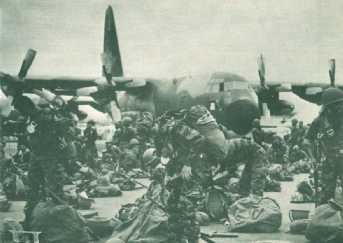
Date: 5 October 1967
Unit: 5th Special Force Group (ABN), 1st Special Forces: Pathfinder Detachment (12 SF, 37 ARVN Pathfinders), Co's 24 & 25, Detachment B-20, "B" Co II CTZ (Pleiku) Mike Force (50 SF) & 275 LLDB (Includes Montagnards)
Operation: Blue Max
Troopers: 374 with ARVN and Aussie Paras
Country: Vietnam
Drop zone: Bu Prang CIDG fighting camp, Quang Duc "Great Virtue" Province
Aircraft: C-130 Hercules
Type Air delivery: Day Mass low-level tactical personnel static-line jump
Date: 1968-73?
Unit: Military Assistance Command Vietnam, Studies and Observations Group (MACV-SOG)Airborne Studies Group (SOG 36)
Operation: Eldest Son, Italian Green, Pole Bean
Troopers: ? to sabotage enemy ammunition supply
Country: North Vietnam, Laos, Cambodia
Drop zone: ?
Aircraft: C-130 Hercules or MC-130 Combat Talon
Type Air delivery: Night, High-Altitude, Low-Opening (HALO) jump
Date: 17 November 1969
Unit: USMC Force Recon Team 51
Operation: ?
Troopers: 6
Country: South Vietnam
Drop zone: 200 meters inland from beach on South China sea near village of Nui Tran
Aircraft: CH-46 SeaKnight helicopter
Type Air delivery: Night low-level tactical personnel static-line jump
1LT Wayne Rollings lead SSG Chamberlain, SGT Moorman, CPL Smith, LCPL Lyons, and HC Smith at 1, 000 feet and 100 mph from the CH-46 rear ramp. Standard marine infantry couldn't capture VC supplies due to the open ground giving the enemy ample time to hide. After 4 days of foot patrolling, no VC supplies were found. 3 empty caves were found. Extraction was made at the nearby beach.
Date: 1968-73?
Unit: Military Assistance Command Vietnam, Studies and Observations Group (MACV-SOG)Airborne Studies Group (SOG 36)
Operation: Eldest Son, Italian Green, Pole Bean
Troopers: ? to sabotage enemy ammunition supply
Country: North Vietnam, Laos, Cambodia
Drop zone: ?
Aircraft: C-130 Hercules or MC-130 Combat Talon
Type Air delivery: Night, High-Altitude, Low-Opening (HALO) jump
Date: Three in 1970-71
Unit: Op 35, Command & Control North (CCN), Studies & Observation Group (SOG), High Altitude Low Opening team (HALO).
Formerly classified.
Troopers:
Country: North Vietnam
Drop Zones: Ho Chi Minh Trail
Aircraft: C-130 Hercules "Blackbird"
Type Air delivery: Night High Altitude Low-Opening (HALO)jump
Jumped at 21,000 feet with oxygen, between 0001-0300 hours.
Objective to close the Ho Chi Minh trail to NVA by calling in air strikes. Individually extracted by "V" rings on STABO harnesses worn by team members by helicopter lowering ropes/bridles using the STABO (Stabilized Tactical Airborne Operation) system.
Operation: Team Florida. 9 troopers. 28 November 1970
Mission: Interdiction of Ho Chi Minh Supply trail in Laos.
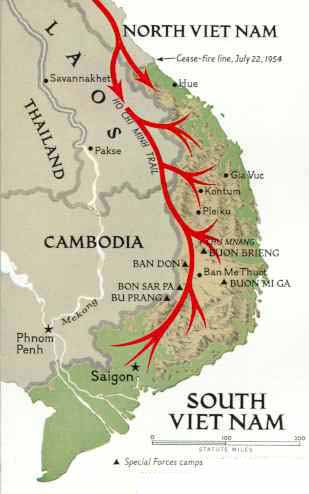
SSG Cliff Newman, SSG Sammy Hernandez and SGT Melvin Hill, one ARVN officer, two Montagnards.
Each team member carried an Eagle Arms CAR-15 5.56mm carbine, team had several sawed-off M79 40mm grenade launchers, a shortened 12 gauge shotgun, a Colt Cobra airweight snub-nosed revolver, .22 caliber suppressed Hi-Standard pistols and grenades. Rucksacks were under their chest mounted reserve parachutes. Main chutes had luminescent paint to help team steer to land close together at night.
They exited the C-130 at 0200 hours without oxygen bail-out bottles and descended by freefall for 71 seconds. Assembling on the ground, they split up into 3 teams. After 5 days in the Laotion jungle, they were extracted by HH-3 helicopter to Thailand.
The following teams went into areas where heavy enemy aniti-aircraft fire made it impossible for low altitude parachute recon team insertions.
Operation: Team Alaska. 9 troopers. February 1971
Operation: Team One Zero. 4 troopers. 15 April 1971
Also 13 separate static-line jumps.
Date: 1980
Unit: Army SFOD-Delta, Ranger security detachment, USAF Special Tactics squadron, CCT, marine helicopter aircrews
Operation: Eagle Claw
Troopers: 100
Country: Iran
Assault zone: Dash te Kavir desert
Aircraft: MC-130 Combat Talons, EC-130 Hercules, RH-53D Sea Stallions
Type Air delivery: Night low-level tactical NOE flight
On 24 April 1980, a force was launched to save American hostages being held in the U.S. embassy in Tehran, Iran. The first part of the mission was a flight of converted EC-130 tankers from a site, in Egypt, to a rendezvous point with 8 x Navy RH-53s piloted by non-special operations qualified marine aircrews to a site designated "Desert One" in Iran. The C-130s were to refuel the helicopters on the ground for the continuation of the mission. Because of bad weather, Mcpilot errors and technical problems, 5 helicopters were left at Desert One, and the mission was aborted. During the evacuation, there was a collision with a marine piloted-RH-53 flying into an USAF EC-130 on the ground. In the ensuing fire, 8 crewmembers lost their lives. It was decided to leave the helicopters and evacuate the rest of the force in the remaining 4 x C-130s.
Date: 23 October 1983
Unit: SEAL Team, 1 USAF CCT member
Operation: Urgent Fury
Troopers: 12
Country: Grenada
Dropzone: Coastline near Point Salines
Aircraft: C-130 Hercules
Type Air delivery: Night static-line parachute jump into the water
Although the invasion officially started on Oct 25th, D-Day, the first troops to enter on Grenada's territory were the Navy SEa Air Land teams or (Seals). On Oct 23rd, Navy Seal Team 6 launched a mission to reconnoiter the Point Salines airport. They were tasked to gather intelligence on the condition of the runway for an Airborne assault by U.S. Army Rangers. They were also to place signal beacons on the ground to guide the Rangers to the correct target landing zone (LZ). The Seals static-line parachuted from the tailgate of a C-130 Hercules cargo plane. The 11 Seals, 1 USAF Combat Controller and three Zodiac F470 rubber boats exited the aircraft, over open ocean, from an altitude of 500 ft. Four of the Seals, overburdened with excessive equipment and tangled in their parachutes, drowned upon landing in the water. After a brief search for the missing Seals, the remaining Seal boat teams resumed their mission. Before they could reach the beach, they were forced to evade an enemy patrol boat. During the evasion, the Zodiac's gasoline-powered outboard motor was swamped and refused to start. The Seals were forced to abort the mission and paddle to a pickup point by a Navy destroyer.
Date: 25 October 1983
Unit: 75th Ranger Regiment LRS Detachment
Operation: Urgent Fury
Troopers: 16(?)
Country: Grenada
Drop zone: Point Salines airport
Aircraft: MC-130 Combat Talons or C-130 Hercules
Type Air delivery: Night High Altitude Low-Opening (HALO) jump
This little known part of the Ranger Airborne operation, provided them vital information on the obstructions on the runway, resulting in the decision to jump in rather than airland.
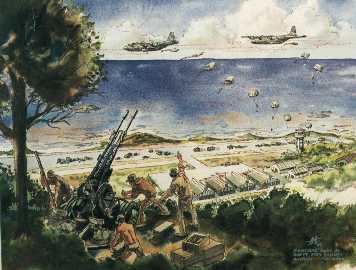

Date: 25 October 1983
Unit: 75th Ranger Regiment 1st, 2nd BN & Two 82nd Airborne Division Paratroopers: Sgt. Spain and SPC Richardson, 618th Engineer Co., 307th Engineer Btn., USAF Combat Controllers (CCT), Air Force Special Operations Command (AFSOC), 12 troopers (Set up radios to guide aircraft)
Operation: Urgent Fury
Troopers: 500
Country: Grenada
Drop/Assault zone: Point Salines airfield
Aircraft: MC-130 Combat Talons, C-130 Hercules
Type Air delivery: Day Mass low-level tactical personnel static-line jump
U.S. Army Rangers were the key to the overall success of the Grenada invasion. U.S. Army Rangers (NOT Mcforce recon) were tasked with securing the Point Salines Airport and the True Blue Campus of the Grand Anse Medical School, rescuing the American citizens there. The Rangers initial plan was to airland three MC-130E Combat Talons aircraft directly on the runway, disembark, and commence direct action contact with opposition forces to secure the airfield. Upon securing the airstrip, the 82nd Airborne Infantry would airland and relieve them, moving out to control the southern part of the island. The Rangers would then send a company to the True Blue Campus to secure the safety of the American students housed there.
The Rangers had little time to prepare for their role in Urgent Fury, the invasion of Grenada. Within hours of receiving orders to move, Ranger units were marshaling at Hunter Army Airfield, Georgia, prepared to board C-130Es and MC-130Es for the ride to Grenada. Their first objective was Point Salines airfield, located on the island's most southwestern point. While securing the airfield, Rangers were to secure the True Blue Campus at Salines, where American medical students were in residence. As quickly as possible, Ranger units were then to take the Army camp at Calivigny.
Since the Navy SEAL team was unable to get ashore; they were to have provided intelligence on the airfield at Salines. H-hour, originally scheduled during darkness, was moved several times until morning twilight. In the lead MC-130Es there were problems with the inertial navigation equipment. Since there were no hatch mount antennas on the cargo doors of the aircraft, communications to Ranger units were delayed while passing through Air Force communications.
While in the air, the Rangers were notified of photographic intelligence and HUMINT reports from Ranger LRSD indicating obstructions were on the field. Instead of landing, the transports would have to drop all the Rangers at Salines so the runway could be cleared. Due to the Seals not placing the beacons or getting any intelligence on the runway condition, and MC-130E Combat Talon sensors indicating the runway was blocked, the Rangers decided to parachute directly onto the airstrip. The Rangers performed a tricky in-flight parachute rigging in preparation of the jump. The Rangers would be jumping without reserve parachutes from an altitude of below 500 ft. A mix-up occurred in the air when the lead plane's navigation instruments failed. The aircraft slowed it's approach allowing the other aircraft to pass it by. At dawn, the first Rangers jumped in a mass tactical formation and landed on the runway. Unfortunately, the first group of jumpers on the drop zone (DZ) was the command and staff elements. The assault force was a half hour late arriving at the DZ. The staff element came under immediate fire from a small force of Cuban engineering reservists.
In some aircraft the men were told to remove their harness, rucksack, and main and reserve parachutes. These items were placed in kit bags and moved forward to facilitate off-loading troops and cargo. But before long, the USAF Loadmasters were yelling, "Only thirty minutes fuel left. Rangers are fighting. Jump in twenty minutes."
These Rangers now had to re-rig for the drop, unpacking nonessential equipment and pulling on parachutes. Rucksacks had to be hooked under the reserve pack and weapons strapped to the left side. Under these conditions it was not possible for the jumpmaster to check each man, so buddy rigging was employed.
Aboard the lead MC-130E, navigation equipment failed and the pilot reported he could not guarantee finding the landing zone. Rain squalls made it impossible to employ a lead change, so both lead aircraft pulled away to the south. As the Rangers approached the target, the aircraft were out of assigned order and the planned order of arrival was no longer possible. This meant that the attached 82nd Airborne Division Combat Engineer runway clearing team would not be the first on the field. The Rangers then requested a mass parachute assault, a contingency previously planned, so that only the order of exit from the aircraft would be affected, but the Air Force would not conduct a mass drop.
Despite all these difficulties, the rangers drove on and at 0534 the first Rangers began dropping at Salines: a platoon of "B" 1/75 and the Battalion Tactical Operations Center (TOC), followed almost 25 minutes later by part of "A" 1/75. Over a half hour later the rest of "A" 1/75, minus seven men were over Salines. It was now 0634, but the remaining men of 1/75 would not be on the ground until 07:05.
Men of 1/75 assembled on the east end of the runway. They were short "C" 1/75, which had been sent with sixty Special Operations Detachment Delta (Delta Force) troops to take the Richmond Hill prison. The Ranger battalions were already operating below strength. One reason for this seems to have been the fact that a limited number of aircraft and aircrews were trained for night operations.
Over one and a half hours elapsed from the first drop of 1/75 until the last unit was on the ground shortly after seven in the morning. These men jumped from 500 feet so they would be in the air between 12 and 15 seconds and under the line of sight of Cuban anti-aircraft guns. Their drop zone was very narrow because there was water on the north and south sides only a few meters from the runway.
At 07:07 the 2nd Battalion began to drop. For several hours their aircraft had orbited, waiting to unload and refuel. They dropped in a much shorter period, and all but one man was safely on the ground. One Ranger broke his leg, and one Ranger's static line became tangled as he exited the aircraft, dragging him against the tail of the plane before he was hauled back aboard. 2/75 assembled on the western end of the runway.
Once on the ground, 1/75 was not under effective fire, and thus could begin to clear the runway of blocking trucks and bulldozers. Some of the vehicles had keys in them; others were hot-wired and removed. A Cuban bulldozer was used to flatten the stakes that had been driven into the ground with wires between them, and to push aside the drums placed on the runway. For fifteen minutes there was no enemy fire, and the Rangers worked without interruption.
By 10:00, 1/75 had its second platoon at the True Blue Campus and its first and third platoons had moved north of the runway. In the center, "B" 1/75, had moved north and was holding the high ground not far from the Cuban headquarters. Units of 2/75 had cleared the area west of the airfield as well as the area north of their drop zone to Canoe Bay. The airfield was secure, and the C/MC-130Es, which had gone to Barbados to refuel, returned to unload equipment not dropped - which included M151 gun jeeps, motorcycles, and Hughes A/MH-6 "Little Birds" otherwise known as MD500 Defender helicopters.
Date: 17 March 1988
Unit: XVIII Airborne Corps, 82nd Airborne Division, 1st & 2nd Battalions, 504th Parachute Infantry Regiment
Operation: Golden Pheasant (Show of force causing Nicaraguan Sandistas to withdraw from border areas)
Troopers: 1,300
Country: Honduras
Drop Zone: Border
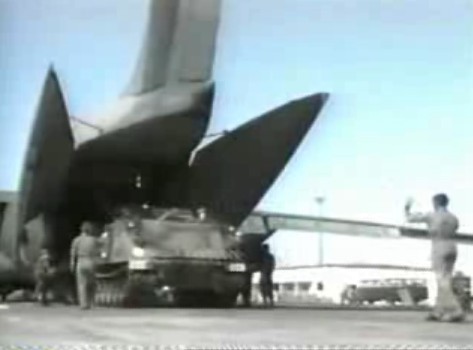
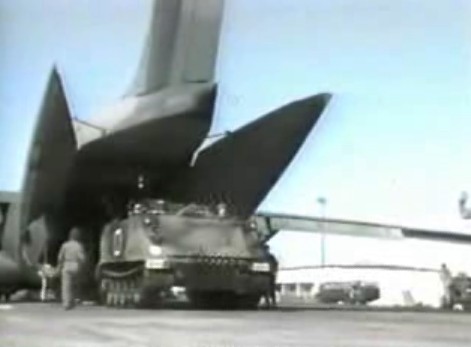
Date: January-December 1989
Unit: 4th Battalion, 6thRegiment, 5th Infantry Division joined to form: Task Wildcat of TF Bayonet
Operation: Nimrod Dancer
Troopers: 1,000
Country: Panama
Drop/Assault zone: Multiple Panamanian Airports
Aircraft: C-130H Hercules turboprop, C-141B Starlifter turbojet, C-5B Galaxy turbofan aircraft
Equipment/supplies air-delivered: M113 Gavins, M1064 4.2" heavy mortar Gavins, trailers
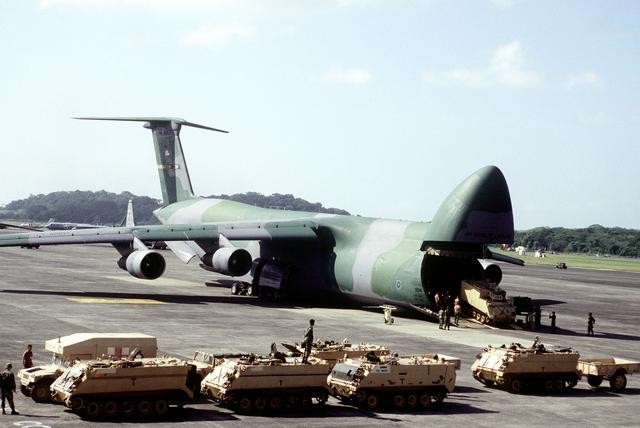
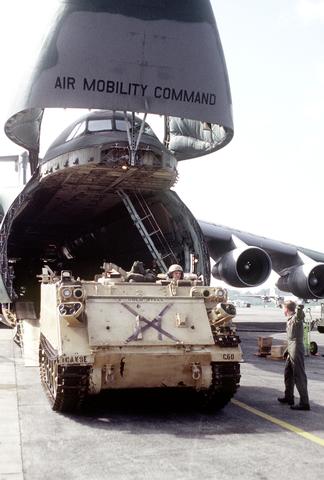
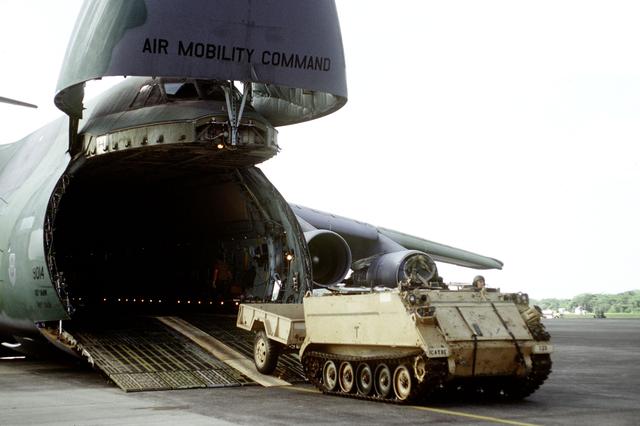
The airlanded build-up of light mechanized forces prior to Operation Just Cause made possible by the M113's lightness in weight which is what LTG Gavin intended for it as the Airborne, Armored Multi-Purpose Vehicle Family (AAM-PVF) to be able to do to execute AIRBORNE WARFARE.
Operation Just Cause: Airborne 3D Maneuver Masterpiece
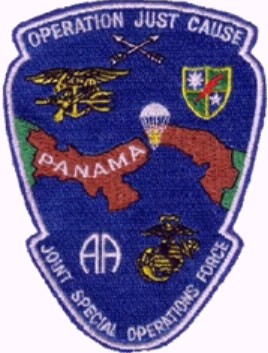
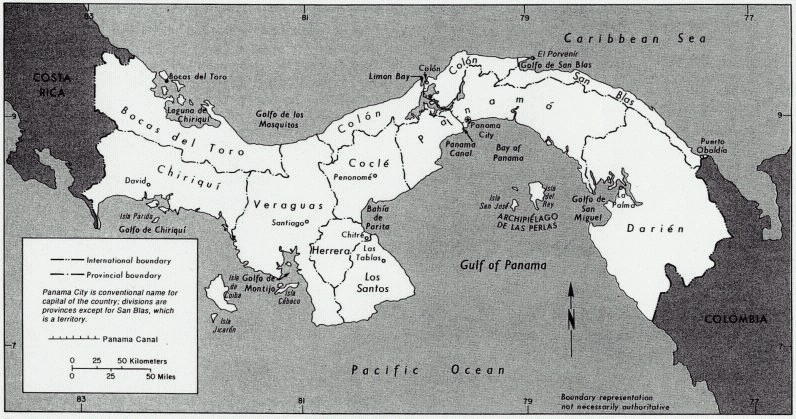
www.globalsecurity.org/military/library/report/2002/MOUTYates.htm
Operation JUST CAUSE in Panama City, December 1989
Lawrence A. Yates
Along with the harbor and airports, Downing's JSOTF had another mission in Panama City, a highly sensitive one.
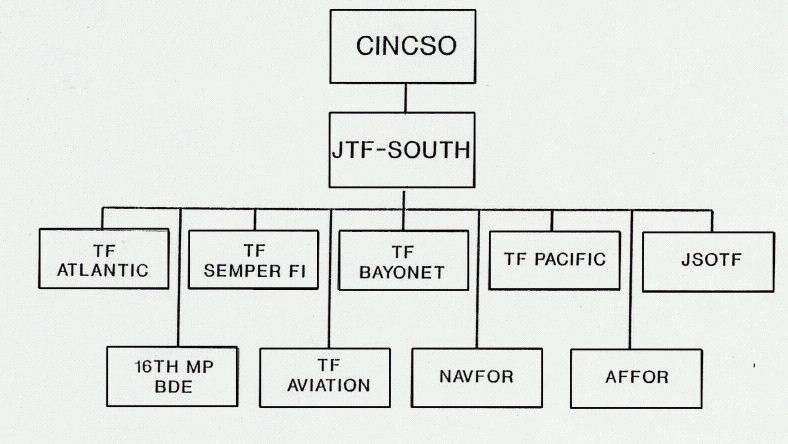
Timed to coincide with the attack on the comandancia, the operation involved elite assault forces freeing an American citizen incarcerated in the carcel modelo, a prison compound across the street from the PDF headquarters.
 http://video.google.com/videoplay?docid=-424561071787364580
http://video.google.com/videoplay?docid=-424561071787364580
 http://video.google.com/videoplay?docid=5468200215546336893&q=&hl=en
http://video.google.com/videoplay?docid=5468200215546336893&q=&hl=en
As executed, most of the rescue mission went according to plan: the assault force "neutralized" the PDF guards and, after extracting the American from his cell, placed him aboard an AH-6 helicopter on the roof of the jail. But as the chopper lifted off, it was hit by PDF fire and crashed into the street below, resulting in injuries to all aboard save the civilian. Quickly, three M113 [Gavin] armored personnel carriers (APCs) arrived on the scene to scoop up the men and rush them to safety.25
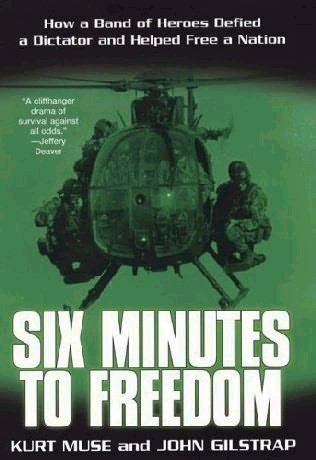
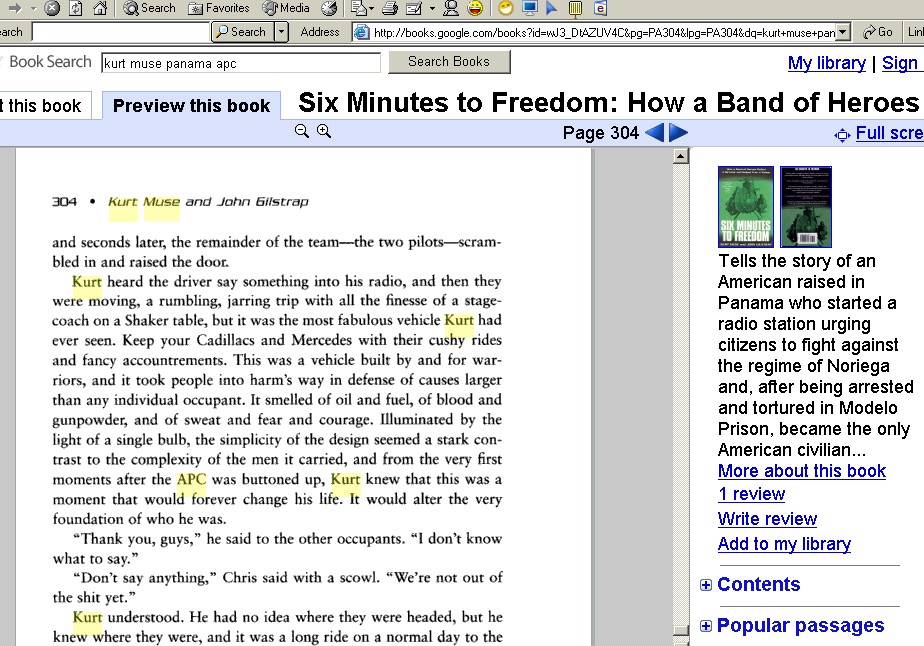
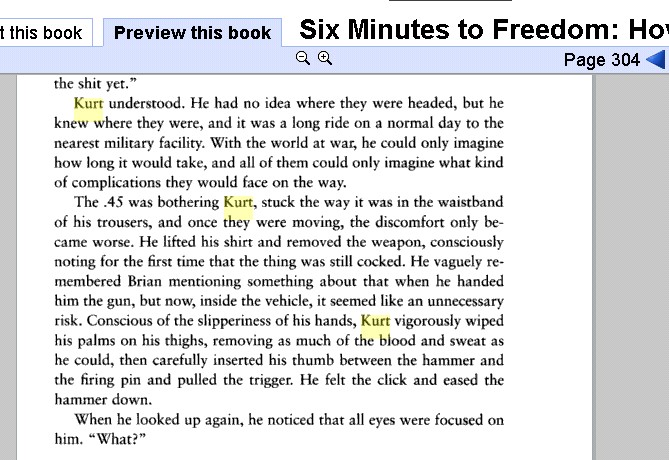
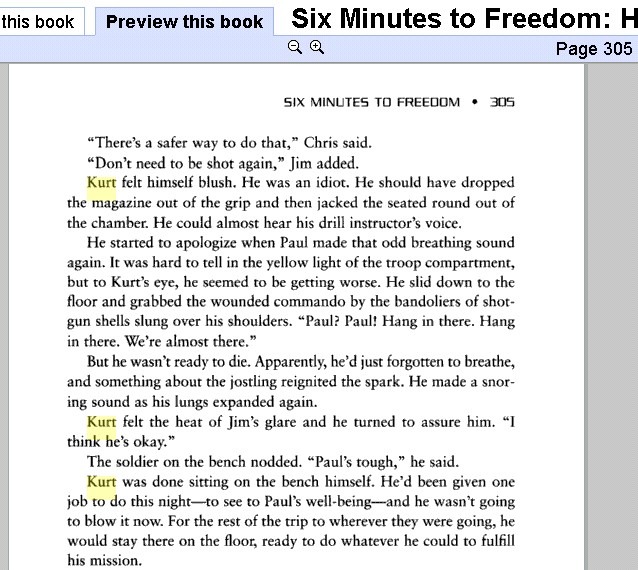
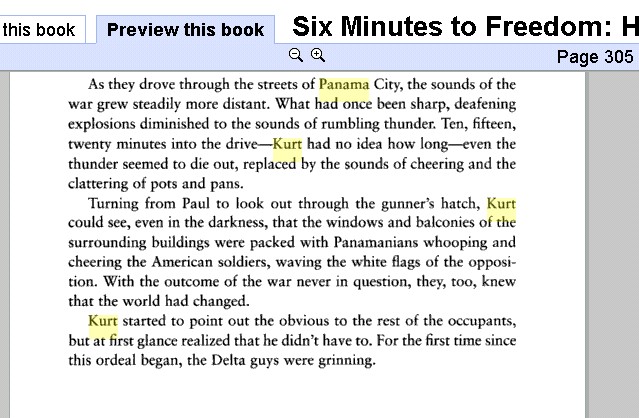
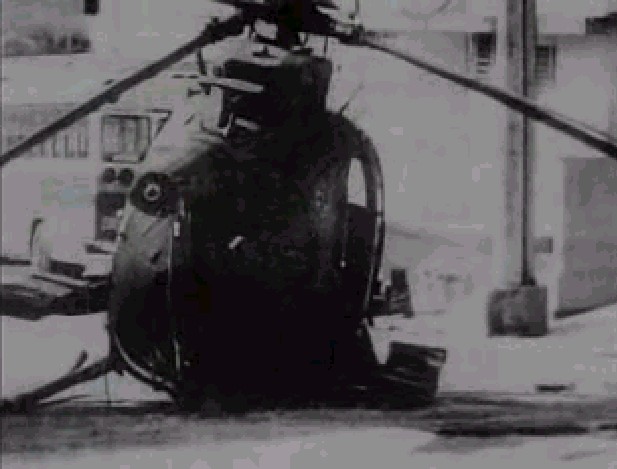
The M113s had been waiting nearby in case they were needed. They belonged to TF Gator, the conventional force charged with conducting the main H-Hour assault on the comandancia. The PDF headquarters, three stories high and made of concrete and reinforced steel, was the largest of ten buildings within a walled compound and had always been viewed by BLUE SPOON planners as the most critical of the organization's command, control, and communications nodes. One problem in mounting an attack on the compound was that it was located near the downtown area in el chorrillo, a poor and crowded barrio with narrow and erratic streets, buildings of various sorts and sizes (including a sixteen-story high-rise right behind the comandancia), and significant vehicular traffic, even late at night.
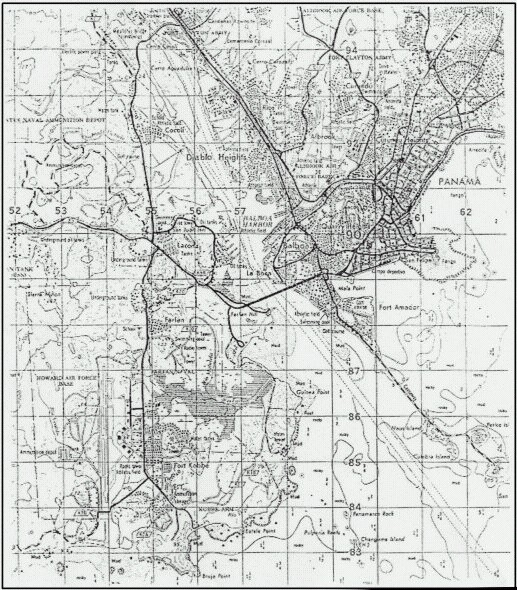
A subordinate element of Task Force Bayonet, TF Gator was led by Lieutenant Colonel James Reed, the commander of the 4th Battalion, 6th Infantry Regiment (Mechanized).[26] It was no accident that the battalion, which had rotated into Panama as part of the ongoing show of force President Bush had initiated earlier in the year, belonged to the 5th Infantry Division (Mechanized), a unit still equipped with the M113 APC. In the narrow streets and constricted terrain of downtown Panama City, U.S. planners believed, the M113's size held an advantage over that of its replacement in the Army's inventory, the larger Bradley Fighting Vehicle.
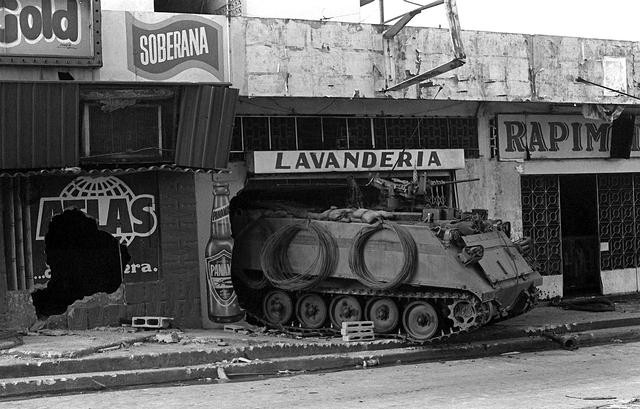
Two of Reed's companies, B and D, formed the core of TF Gator. The plan called for them to set up a series of squad- and platoon-size blocking positions around the carcel modelo and comandancia compounds, designated A and B, respectively (see Map 4).
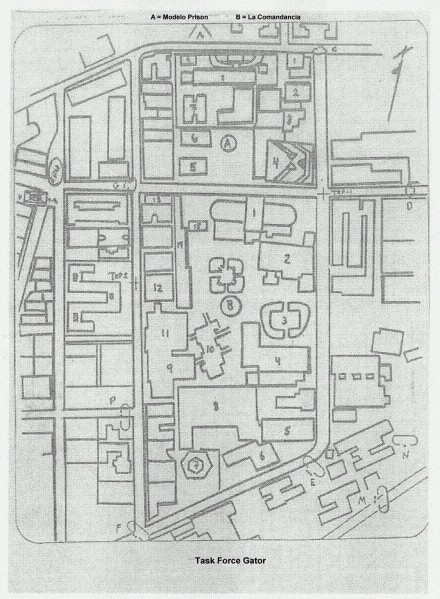

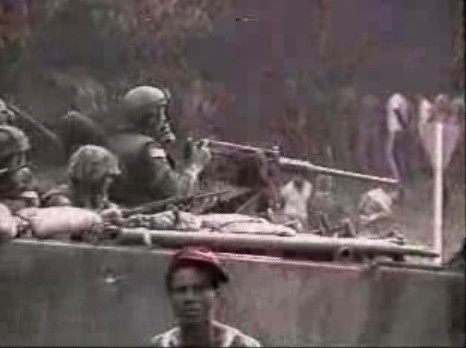
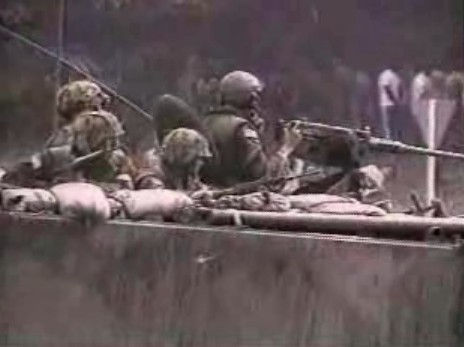
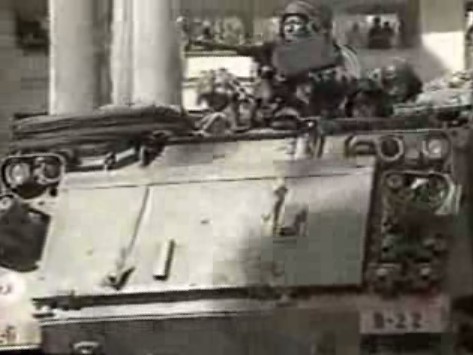
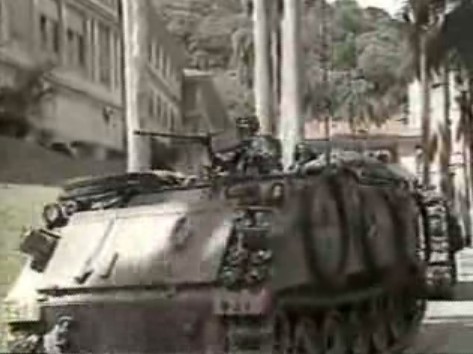
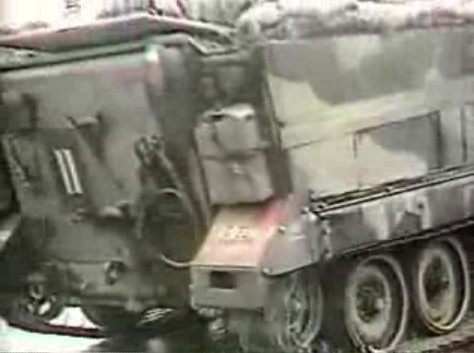
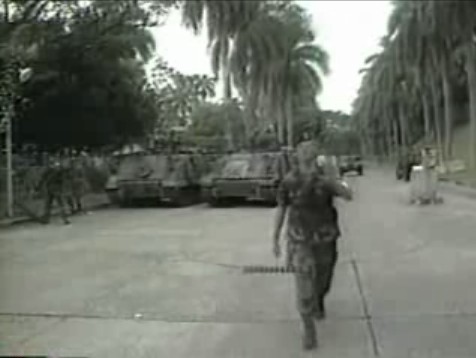
Meanwhile, Company C, 1st Battalion, 508th Regiment (Airborne), a unit attached to TF Gator from USARSO's 193rd Brigade, was to secure and clear the buildings behind the PDF headquarters in the vicinity of the high-rise. From intelligence reports, Reed knew that the ratio of American troops PDF at the comandancia would be at best 1:1 (350 U.S. to 390 PDF). Conventional wisdom, however, holds that to guarantee a successful assault, the attacker to defender ratio should be at least 3:1 and preferably higher, 4:1 or 5:1, in UO. To compensate for the manpower shortfall, Reed, as noted, had operational control of four LAVs [25mm small autocannon on turrets] and four Sheridans [152mm large main guns on turrets] for fire support. He could also count on two AC-130s [105mm, 40mm cannon] overhead, as well as AH-6 [2.75" rockets] attack helicopters. Rounding out the task force were two MP platoons (for placing roadblocks around the combat zone), an engineer platoon broken down into 2-3 man demolition teams, and a PSYOPs team. With this force, Reed planned to isolate and pound the PDF headquarters, after which U.S. troops could enter the compound to clear the buildings. Because of the SOF-led rescue mission at the carcel modelo across from the comandancia, TF Gator would begin its attack under Downing's operational control. (The transfer of control from TF Bayonet to the JSOTF took place on Monday, well in advance of the operation.)27
As a result of a repositioning of units on the Saturday night Lt. Paz was killed, Reed had both of his mechanized companies on the east bank of the Canal, the same side as the comandancia. D was at Fort Clayton, B a few miles to the south at Corozal. Shortly before the attack, he brought the LAVs and Sheridans-labeled Team Armor-over to the east bank as well. Last-minute preparations included hydrating the troops for combat in a tropical clime, getting intelligence updates (which indicated the PDF knew the attack was coming), and applying glint tape to uniforms and equipment and disseminating passwords. Both of these latter measures were designed to reduce the risk of friendly fire, an overriding concern U.S. commanders shared throughout the theater of operations, but especially in the congested area of the comandancia.
The decision to move H-Hour ahead by fifteen minutes caused some adjustment but little disruption to TF Gator's schedule as it set out toward the target. When Team Armor reached Ancon Hill, it moved out of formation and took up firing positions on the hillside overlooking the compound. Company B settled in briefly near to Quarry Heights and waited for Company D to move into position around Balboa Avenue. Once that was done, both companies advanced in M113s toward their blocking positions. Meanwhile, Company C, 1/508, moved dismounted into the built-up area adjacent to the compound. The entire task force was now committed to the attack, a fact that caused Reed some concern. TF Gator had no combat reserve. If additional forces were needed, they would have to come from the reserve controlled by Colonel Mike Snell at brigade level, that is, at TF Bayonet.
As B and D companies set out, they immediately saw that the PDF had put its advance knowledge of the invasion to good use. Well before the two units reached their positions, they encountered roadblocks covered by intense small-arms and RPG fire, especially from the built-up area and high-rise apartment building. Reconnaissance by U.S. Special Forces had discovered a couple of the roadblocks, but a third had gone undetected. The worst was one that stacked heavy dump trucks two deep. In trying to negotiate the obstacles, both columns stalled, with Company B suffering one fatality, a corporal who was killed while providing suppressive fire against the PDF. Innocent bystanders also paid a price, as M113s, in going over vehicles in their way, could not always distinguish between empty cars and those with civilians inside.
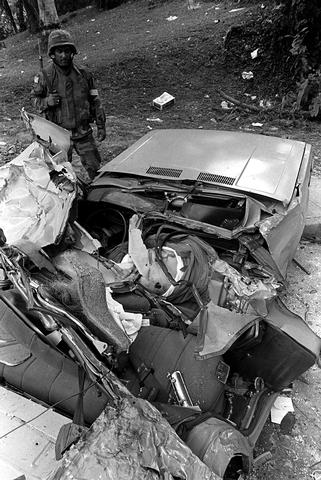
As the columns approached the comandancia, the battle became more heated. The AC-130s and AH-6s pounded the compound, and to those watching, the 105mm howitzers of the Spectre gunships seemed to be pulverizing the main headquarters building. In reality, the damage inflicted, while extensive, was restricted largely to the top floor, the howitzer rounds failing to penetrate to the second and first floors before detonating.28 From Ancon Hill, Team Armor also opened fire, although some of the vehicles found their line of sight to the comandancia obscured either by trees on the hill or by the smoke, fire, and debris that soon engulfed the target. Consequently, the teams impact on the early part of the battle was marginal. Once Reed realized this, he moved some of the M551s off Ancon Hill, giving one to each of the two companies assaulting the PDF complex.29 From their new positions, the Sheridans were much more effective against the compound's walls and defences.
All of the U.S. assault force initially encountered heavy firing from the compound and the built-up area around it, especially from the 16-story high-rise apartment building. Restricted somewhat by ROE designed to limit civilian casualties, the Americans generally showed remarkable discipline in returning fire, although on occasion, they could not refrain from unleashing indiscriminate suppressive fires on the assumption that, after a certain point, no uninvolved civilian would be so foolish as to stand on a balcony and risk certain injury in order to observe a war.
It took an hour for Company B in the north to secure its positions, and an hour or so longer for Company D in the south. At one point in the fighting, an AH-6 was shot down, landing inside the comandancia compound. The pilot and copilot managed to get out of the craft, hide out, then make their way to a segment of the wall, climb over, and scurry to the American lines, shouting something en route that sounded more like profanity than the password. They both made it to safety, narrowly escaping a tailor-made opportunity to become friendly fire victims. One mechanized platoon, however, was not so fortunate. As it approached the compound, one of the AC-130s tracking PDF V-300s changed the target acquisition system on the gunship in order to obtain a better image. When the gunner reacquired the target, it was the wrong one, not the V-300s, but U.S. M113s. The AC-130 hit all three of the platoon's APCs and wounded 21 of 26 of their occupants. Miraculously, no one was killed, but the unit had been put out of action. Reed had a fire support officer located with the JSOTF, and when it became apparent what was happening, communication with the AC-130 ended the firing before further damage could be inflicted. But the fears of a major friendly fire incident in a congested urban area had been realized.30
While this was going on, Company C, 1/508, was waiting for word to enter and clear the comandancia compound. But Reed never issued the order. In the meantime, heavy sniper fire and grenades rained down on the company, resulting in the death of three Soldiers. After that, the unit pulled back to a safer area.
Shortly before dawn, the shooting had been reduced to sporadic sniper fire. At 0430, TF Bayonet resumed operational control of TF Gator from the JSOTF. Remaining was the task of clearing the buildings. Reed had not issued the order to Company C, 1/508, to start the procedure because, after talking to Col. Snell, the TF Bayonet commander, he had decided to await the arrival of a Ranger company from the Torrijos-Tocumen operation to lead the effort. Reed felt that the Rangers had more expertise and experience in clearing rooms than did his mechanized troops, despite their pre-JUST CAUSE UO training. The company arrived around noon on the 20th. With the support of Apache helicopters requested by Reed and a platoon of TF Gator troops covering them from the roof of a nearby gymnasium, the Rangers began clearing the prison and other facilities in compound A and then moved on to buildings in compound B, which included the comandancia itself. Company C, 1/508, joined in. By late afternoon on the 20th, the area was secure. TF Gator had lost four Soldiers killed in action (KIA) and had had several more wounded. PDF casualties were unknown, but assumed to be substantial. Hindering an accurate account was the fact that few of the PDF fighting at the comandancia wore uniforms.
Leaving a platoon to secure the PDF headquarters and its contents, TF Gator engaged in several follow-on operations. These included helping Navy SEALS clear Flamenco Island, securing a Panamanian television station near the Ancon DENI, and, potentially most challenging, securing the San Filipe DENI station without harming one of its occupants, a PDF colonel who was also a U.S. intelligence "asset." Reed wondered how he would extract the colonel if a firefight erupted while the officer was still inside the DENI. His speculation ended, however, when U.S. units arrived at the DENI to find that the PDF, with the exception of the colonel, had fled.
Looking back on the battle at the comandancia, Reed reached several conclusions. One concerned the proven value of the M113 APC in UO. Planners had wanted the M113 because of its size and, in case civilians needed to be evacuated from certain areas, its interior capacity. To these attributes, Reed added the vehicle's freewheeling .50-caliber machine gun that could be trained on the upper stories of high-rise buildings and used much more readily for suppressive fire than the Bradley's more precise 25mm cannon. He also noted that infantry in the M113 could stand and fire from the troop compartment without obstruction (in contrast with the Bradley, where they could only do so only with the turret on top pointed to the front).
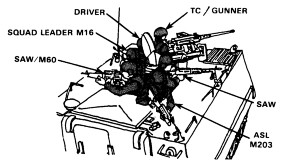
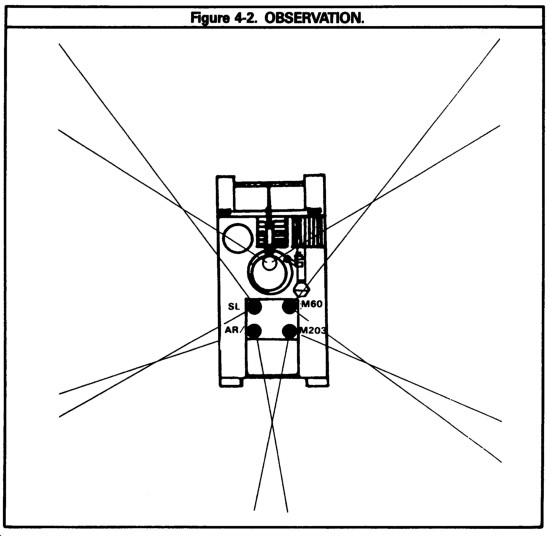
While Reed praised the M113, he was lukewarm regarding the performance of Team Armor's Sheridans and LAVs from their positions on Ancon Hill. The noise and debris created by the Sheridans did have a psychological value at the outset of the fighting, he argued, and once the clearing operations got underway that afternoon, both the Sheridans and LAVs helped to suppress sniper fire. But neither of the vehicles had created much physical damage from Ancon Hill during the nighttime assault, although the Sheridans Reed pulled out of position to assign to companies B and D proved very effective against the compound walls. As for the AC-130s, he conceded that they were highly accurate and could bring devastating supporting fires to bear, a tremendous asset if they hit the right target. That they did so most of the time at the comandancia was offset by the one serious incident of friendly fire.
Other key observations offered by TF Gator dealt with a variety of issues. U.S. snipers, Reed believed, had been too constrained by the ROE, thus limiting their effectiveness against the PDF snipers who bedeviled the task force. The fact that few PDF fought in uniform also created a dilemma for U.S. troops under strict orders to avoid civilian casualties. What was a legitimate target and when to shoot at it was not always clear, although no friendly KIAs could be attributed to any indecision by the troops as to when to use deadly force. During the battle, Reed also realized that his medical station was too far away from the fighting, so he approved setting up an intermediate one closer to the battle. Finally, as will be seen, TF Gator was not prepared to cope either with the large number of refugees that appeared at dawn on 20 December or with the widespread looting in Panama City that followed within days.

The battle for the comandancia saw some of the fiercest fighting to occur during Operation JUST CAUSE. With a force-to-force ratio of 1:1 at best, TF Gator could not afford to find itself outflanked by PDF reinforcements. As Reed put it, "I had no ability within my own resources to fight the deep battle . . . ." That being the case, the Rangers, the 82nd Airborne brigade, marines, and Special Forces were to block any enemy forces coming in from distant locations. That left PDF personnel in the immediate vicinity of Ancon Hill to worry about. To make sure that none of these forces interfered in the battle downtown was largely the responsibility of Task Force Wildcat, another task-organized unit within Task Force Bayonet. [31]
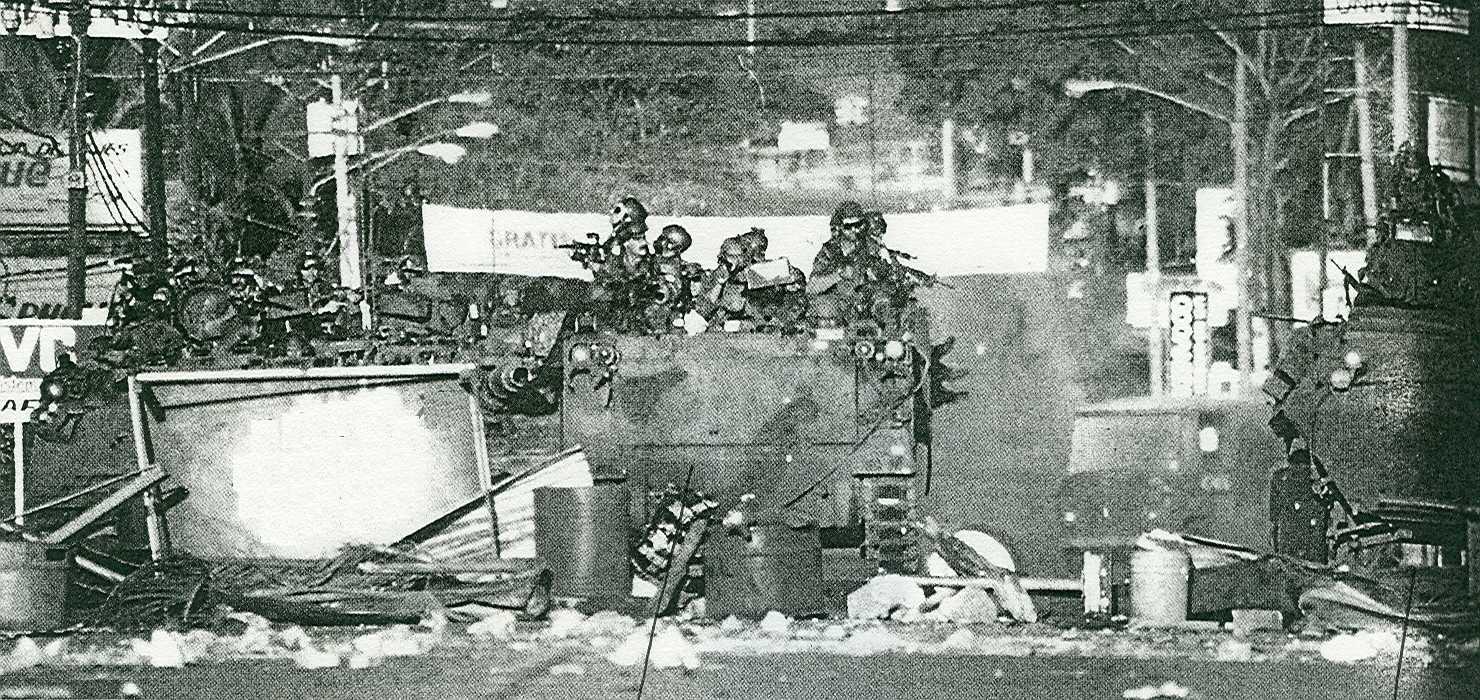
[29] Reed also provided two LAVs, one Sheridan, and six M113s to the JSOTF so that SOF elements would have a small task force to assist in the extrication of American personnel from the U.S. embassy. The problem for Reed, however, was that once relinquished he did not see the vehicles again for several days.
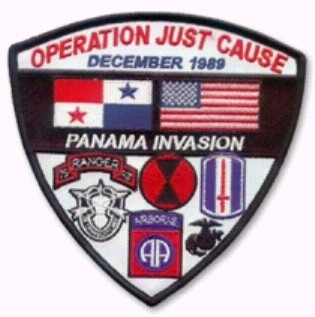
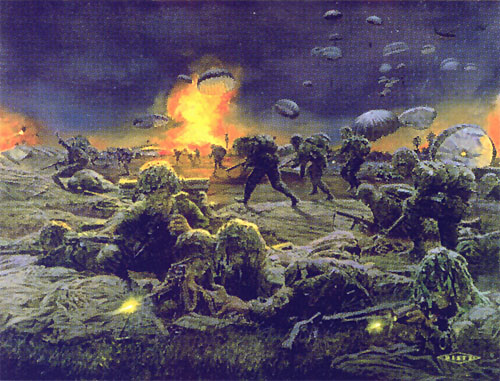
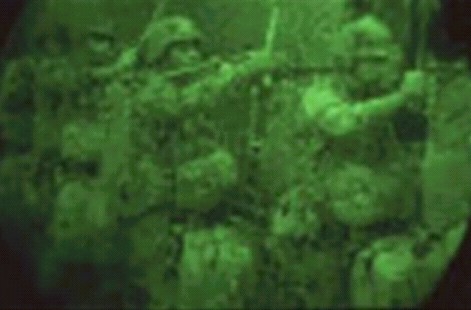
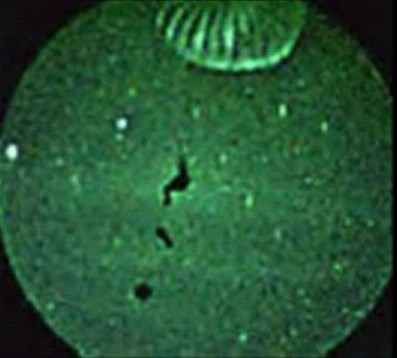
Actual Video clip of U.S. Army Paratroopers exiting a C-141B Starlifter
Date: 20 December 1989
Unit: (0124) Rangers; (0145) 82nd Airborne Division, 1st Brigade Task Force: 1/504th PIR, 1/505th PIR; 2nd Bn., 504th PIR; 4th Bn., 325th Abn. Inf. Reg., Co. C; A Co., 3/505 PIR; 3rd Bn., 73rd Abn. Armor Reg.; 82nd Abn. MP Co., 3 platoons (0411). All joined to form: Task Force Pacific.
Operation: Just Cause
Troopers: 2,176
Country: Panama
Drop/Assault zone: Torrijos-Tocumen Airport
Aircraft: MC-130E Combat Talons, C-130H Hercules turbofan, C-141B Starlifter turbojet, C-5B Galaxy turbofan aircraft
Equipment/supplies air-delivered: 12 x M551 Sheridan light tanks, Ranger M151 Gun jeeps, 78 x HMMWVs, 4 x M102 105mm towed howitzers, ammo, food (MREs), water (CDS)
Type Air delivery: Night Mass low-level tactical personnel static-line jump, platform Heavy drop LVAD, CDS LVAD
75TH RANGER REGIMENT (TASK FORCE RED)from the 75th Ranger Regiment, was given two H-Hour missions. The first was to secure Tocumen PDF Airport/Torrijos International Airport neutralizing the PDF's 2nd Infantry Co prior to the 82nd Airborne Division's Airborne assault 45 minutes later. The second mission was to neutralize the PDF's 6th and 7th Infantry Companies at Rio Hato west of Panama City.
1st Battalion (-) 75th Ranger Regiment (TASK FORCE RED TANGO) 1-75th and C/3-75th Ranger Regiment became TF Red Tango. At 19 1800 Dec, TF Red Tango departed Hunter Army Airfield, outside of Savannah, GA. Its mission was to seize Torrijos International Airport and neutralize the PDF's 2nd Infantry Co on Tocumen PDF Airport.
At 0100 an USAF AC-130 opened fire on the compound of the 2nd Infantry Co as Army AH-64A "Apache" gunships fired on additional targets. Three minutes later, four Ranger companies parachuted from under 500 feet onto the tarmac of the airfield. The Rangers quickly eliminated PDF resistance and secured their assault objectives. "C" Co/3-75th Ranger Regiment was to clear and seize the main air terminal. The second and third floors were cleared, but the first floor was isolated after it was discovered that the PDF took a number of hostages. After two and one-half hours of negotiations, the hostages were set free. By 0630 the airfield was secured, and a Forward Aerial Resupply Point (FARP) was established to receive incoming aircraft.
On 28 Dec, the battalion began reconnaissance-in-force operations in the vicinity of Cerro Azul to pursue remnants of the PDF and DIGBAT forces, seize reported weapons caches, and neutralize potential rally points and exfiltration routes to the Panamanian interior. The battalion redeployed on 3 Jan.
82ND AIRBORNE DIVISION (TASK FORCE ATLANTIC)was the Division Ready Brigade (DRB) that deployed by air, consisting of 1st Bde (-) with the 4-325th AIR replacing 3-504th PIR. 1st Bde's mission was to conduct a parachute assault on Torrijos airport, isolate and neutralize PDF forces at Panama Viejo, Tinajitas and Ft. Cimmarron and deny PDF reinforcement of Panama City from within AO. Upon completion of combat operations, the BDE conducted stability operations until redeployment from 10-12 Jan.
1st Battalion, 504th Parachute Infantry Regiment (PIR) parachuted onto Torrijos Airport several hours after H-Hour. At 0830, the battalion air assaulted into Tinajitas, the location of the PDF's 1st Infantry Company. The battalion received heavy ground fire from San Miguelito en route. On final approach to the landing zone (LZ), the helicopters received constant fire from the objective. The troopers received both direct and indirect fire as they maneuvered up the hill to the objective. The battalion had a long hard fight in taking Tinajitas due to the steep terrain and PDF defense. The objective was secure by 1430 but the unit continued to receive sporadic sniper fire from surrounding buildings. The battalion then conducted security sweeps on 21 Dec. On 22 Dec the battalion began stability operations. These continued until 10 Jan when the battalion was relieved by elements of the 7th Inf Div (L) and redeployed from 10-12 Jan.
2nd Battalion, 504th Parachute Infantry Regiment (PIR) at 0200 20 Dec, parachuted onto Torrijos Airport which was being secured by the 1-75th Ranger Regiment. After assembly, 2-504th PIR air assaulted into Panama Viejo four hours later. Their mission was to secure the PDF military complex at Panama Viejo, home of the 1st Cavalry Squadron and the Panamanian Military Counter-Terrorist Unit (UESAT). The PDF units had been alerted and resisted, but the battalion secured its objectives by 1200.
While D-Day operations were still ongoing, the 82nd Abn Div was ordered to secure the Marriott Hotel and rescue civilians trapped there. "B" Co/2-504th PIR fought its way from Panama Viejo, and secured the hotel. The next morning 29 American civilians were evacuated by armed convoy to Panama Viejo and then flown to safety. Stability operations in or near Panama City continued until 10 Jan when the battalion was relieved by elements of the 7th Inf Div (L) and redeployed from 10-12 Jan.
4th Battalion, 325th Airborne Infantry Regiment(ABN)parachuted onto Torrijos Airport early on 20 Dec. "A" Co then led the battalion's combat operations by air assaulting into Ft. Cimmarron, location of the PDF's Battalion 2000. After directing fire from an AC-130 against its objective, the company hit its LZ at 1000 hrs. They met limited resistance and found 13 killed in action, 10 destroyed vehicles, and three 120mm mortars. The company consolidated and awaited linkup with the remainder of the battalion on 21 Dec.
On 22 Dec the battalion was given responsibility for the security of the district containing the Papal Nunciatura. Stability operations continued until 10 Jan when the battalion was relieved by elements of the 7th Inf Div (L) and redeployed from 10-12 Jan.
Date: 20 December 1989
UNIT: (0100) Rangers, 75th Inf. Reg.,
Task Force Red, 1,300 troops; 82nd Abn. Div. Ready Brigade (DRB), 2,700 troops.
Operation: Just Cause
Troopers: 4,000
Country: Panama
Drop zone/Assault zone: Rio Hato east to Fort Cimarron
Aircraft: MC-130E Combat Talons, C-130E Hercules turboprop, C-141B Starlifter turbojet, C-5B Galaxy turbofan aircraft
Equipment/supplies air-delivered: Ranger M151 Gun jeeps, HMMWVs, Ammo, Food (MREs), water (CDS)
Type Air delivery: Night Mass low-level tactical personnel static-line jump, platform Heavy drop LVAD, CDS LVAD
2nd Battalion (-) and 3rd Battalion, 75th Ranger Regiment (TF RED ROMEO) departed Lawson Army Air Field, Fort Benning, GA at 19 1800 Dec. Its mission was to seize Rio Hato and neutralize the 6th and 7th PDF Infantry Cos.
At 0100 Dec 20, the battalion jumped from C-130Hs onto the airfield at Rio Hato. Both PDF companies had been alerted and fired on the C-130Hs with small arms. Despite PDF resistance, the battalion assembled, attacked the barracks and established an airhead. By morning, the Rangers accomplished all missions, captured 250 prisoners and cleared the airfield for future operations.
The battalions conducted security operations until they redeployed on 9 and 10 Jan.
www.airpower.maxwell.af.mil/airchronicles/cc/torrisi.html
EXCERPT:
"Operation Just Cause which required an airlift package of 51 C-141 aircraft to drop 2,288 paratroopers, 78 M-998 HMMWVs, 12 M-551 Sheridan light tanks, and four M-102 105mm howitzers."
OUR ANALYSIS:
The Airborne has too many hypocritical liars. They airdrop by parachute 78 x HMMWV 3-ton, 185 inch long, 85 inch wide trucks that can transport (can't swim or go-cross country anywhere with confidence) without ANY armor protection 320 Paratroops into COMBAT in Panama.
For that same airlift: its the floor space--not weight that's driving the issue--they could have dropped 78 x M113A3 Gavin, 10.5 ton, 207 inch long, 98 inch wide ARMORED tracks to move (x-country anywhere, amphibious) with FULL armor protection 858 Paratroops to accompany the 12 x M551 Sheridan, 17-ton light tanks, creating a BATTALION ARMORED TASK FORCE. That would still leave 1,430 Paratroops--2 Battalion's worth to do the follow-on Air Assaults that took place.
So what's the matter with the U.S. Army Airborne?
Why, the Airborne is what's wrong with the Airborne.
The Airborne is populated by too many adolescent, narcissistic egomaniacs who think war is a fashion show for their egos and they don't need armor protection or tracked mobility because we have created a BS and dangerous culture within the U.S. Army that looks down upon "mech" Soldiers because they ride into battle and generally don't parachute jump. Here is a REVELATION. There is nothing stopping us from parachuting light tracks with the Airborne (sociological ego objection #1 overcome) and then using them to get to the objective safely and intact without enemy RPGs, small arms fire and roadside bombs decimating our troopers and then DISMOUNTING from them to fight on foot if the situation calls for it---holes blown in buildings by the M8 Buford AGS light tank's 105-120mm main guns, the M113A4 Gavin MTVL's 20-40mm autocannons now they must be cleared of enemies---(bye, bye, ego objection #2).

Date: 8 August 1990
Unit: 2nd Brigade, 82nd Airborne Division (DRB)
Operation: Desert SHIELD
Troopers: 5, 000
Country: Saudi Arabia
Drop/Landing zone: Daharan International Airport, Saudi Arabia
Aircraft: C-5B Galaxy turbofan aircraft, CRAF airliners
Equipment airlanded: 29 x M551 Sheridan light tanks, 3 x M270 MLRS tracked rocket launchers, battalion of 105mm light howitzer artillery, 5 quart water bladders in addition to regular TA-50, desert BDUs
Where the Iraqi Army was in Kuwait

How the Iraqis could have invaded Saudi Arabia

Note: the other two brigades of the 82nd Airborne deployed by air/sea totalling 15, 000 Paratroopers constituting the "Line-in-the-Sand"---the DESERT SHIELD---that stopped Saddam from venturing south into Saudi Arabia; so follow-on-forces could build up and go on offense to expel the Iraqi Army from Kuwait
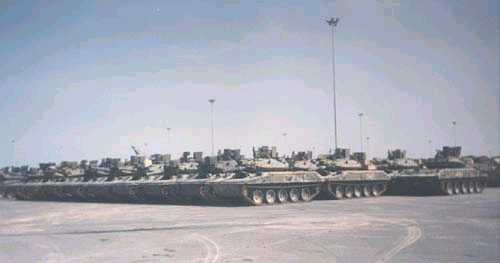
The rest of the 3/73rd Armor BN's M551 Sheridans at the Port of Damman in Saudi Arabia
82nd Airborne secured the airfield and the sea port for the USMC to safely arrive a week later by MPS ships.
Operation DESERT STORM: the "Official" Version of Events
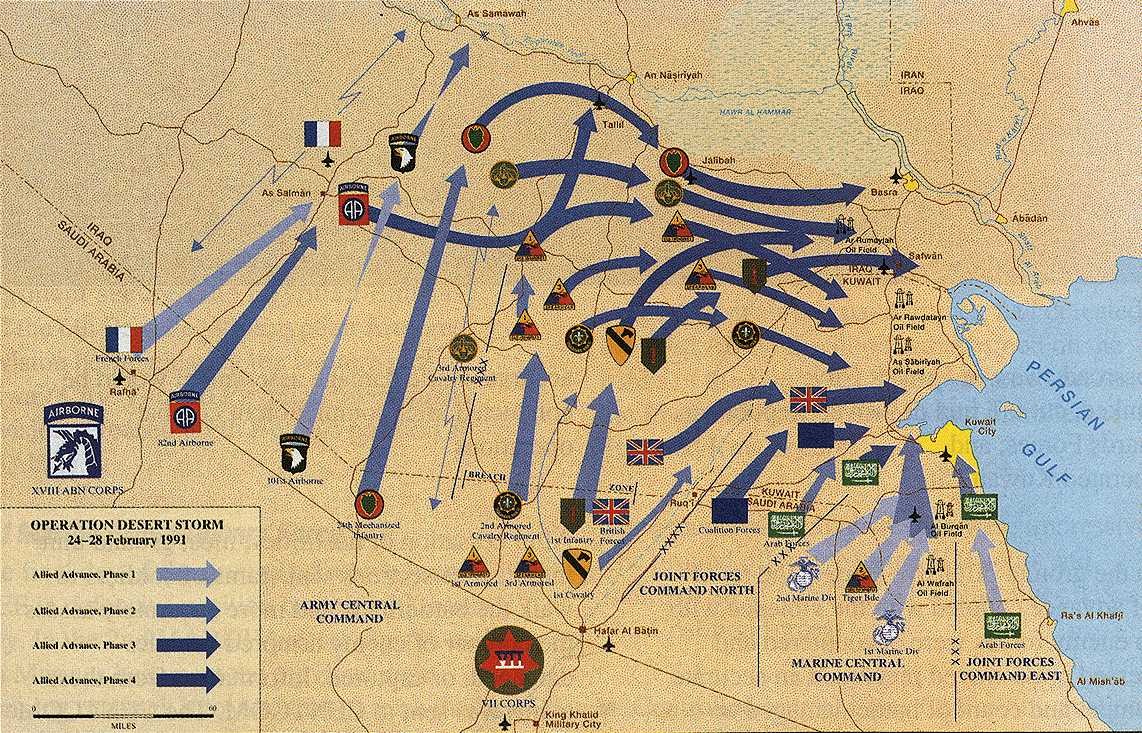
GOOD PURSUIT: Russians would have dropped VDV Airborne AHEAD of Iraqi Retreat to Block their Escape
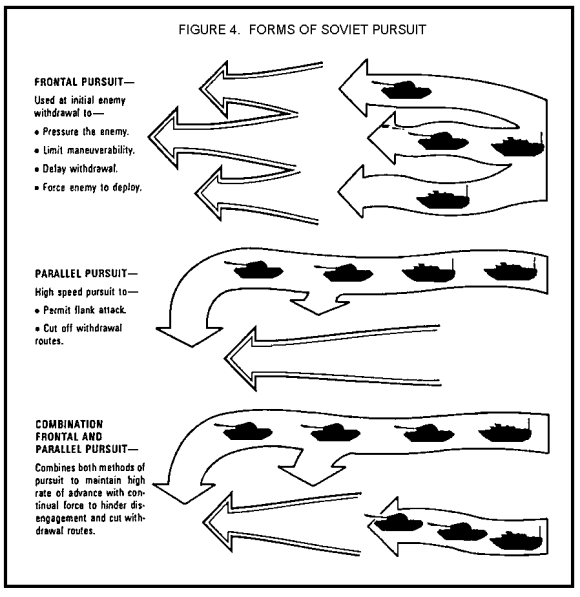
American Generals traumatized by Vietnam foot-slogging heavy casualties (see movie "Platoon") moved too timidly not realizing they were in TRACKED ARMOR that could wade into the enemy and give aggressive pursuit. Result is the current Iraq fiasco.
Fascinating display at the U.S. Army Transportation Museum @ Fort Eustis, Virginia
Date: January 1991
Unit: 3rd Battalion, 73rd Armor, 82nd Airborne Division
Operation: Desert STORM
Troopers: 900
Country: Saudi Arabia/Iraq
Drop/Landing zone: Log Base C
Aircraft: C-130E/H Hercules turboprop aircraft (1, 000 sorties)
Equipment airlanded: 45 x M551 Sheridan light tanks, Humvee trucks, 250,000 gallons of fuel, 9,000 tons of supplies
Type Air delivery: STOL airland
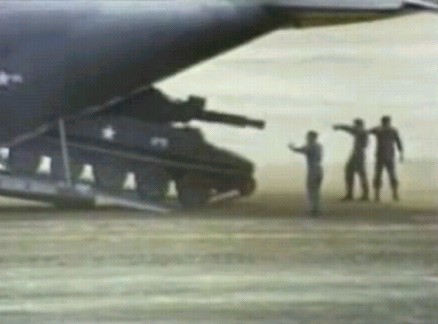
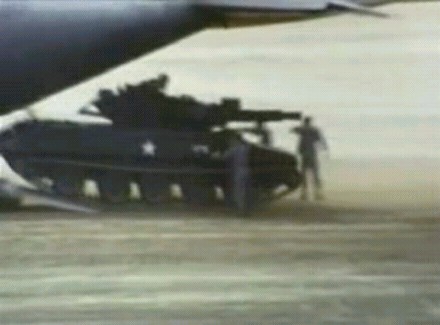
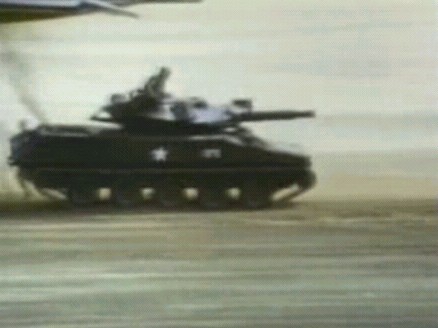
USAF moved 80% of 3/73rd Armor Bn (M551 Sheridans) by C-130E/H 700 miles west from the King Faud International Airport to a small landing strip outside of Rafha SA near the SA Iraq border. They moved all of the tracked vehicles in the Bn - the C2 M577 (flatbedded) to that location. Some wheeled stock moved by air but the majority moved over the road to get into assault position for the "Hail Mary" left hook into Iraq. This included their scout platoon who was test evaluating LAV-25s (LAV-1s) because the LAV-25 did not fit into the C-130 and could not fly. This was meant to be a somewhat stealth operation.
XVIII Airborne Corps had the guts or the feeling it "was worthy" to use air resupply so it had expertise and contacts within the USAF to seize a section of paved highway and get them to airland supplies and troops. USAF CCT traffic controllers would be necessary to guide in landings, mark the runway etc. since Army Pathfinders are not "worthy" and trained to do this job.
Notice a specialized Army unit was there to fiddle around with fragile 463L pallets as C-130s spent 12 minutes on the ground; me thinks SeaBox's ECDS pallets with forklift slots would have been faster by dropping them off then taxiing to take-off position. However let me guess. Due to "cutbacks" Army no longer has units to transfer cargo from aircraft yadda yadda yadda fuking BS. All the more reason to go with ECDS pallets and AIP pallets that anyone with a forklift can pick up and move--even a bulldozer with Butch Walker's "Bucket Lift" attachment or his Amaze-N-Tow forklift trailer.
Notice the bypass around the commandeered road-turned-into-airfield so ground vehicles could get back onto the road; wheeled vehicles can't just go anywhere in the desert lest they get stuck. General Gavin would be pleased since he wrote about such bypasses in his book, "Airborne Warfare" in 1947. Again, more reason to go with an all-tracked Army.
4. In 1, 000 flights, 9, 000 tons of supplies, 250, 000 gallons of fuel and 900 Soldiers were delivered. Let's break this down:
A C-130 can carry 40, 000 lbs or 20 tons of supplies. 450 flights moved the 9, 000 tons of supplies.
A C-130 can carry 6 x 500 gallon bladders of fuel so 3, 000 gallons per sortie means 100 flights
A C-130 can airland 92 troops so that's just 10 flights
This all comes to less than 500 flights, so what was carried in on the other 500 flights?
Probably lots of BS Humvee trucks; possibly 1, 000 Humvee trucks...
If we had tow kits they could even TOW the fuel bladders with them acting as their own wheels...if towed by wheeled trucks they might get stuck....but if they were towed by TRACKED XM1108 Gavins its not likely...
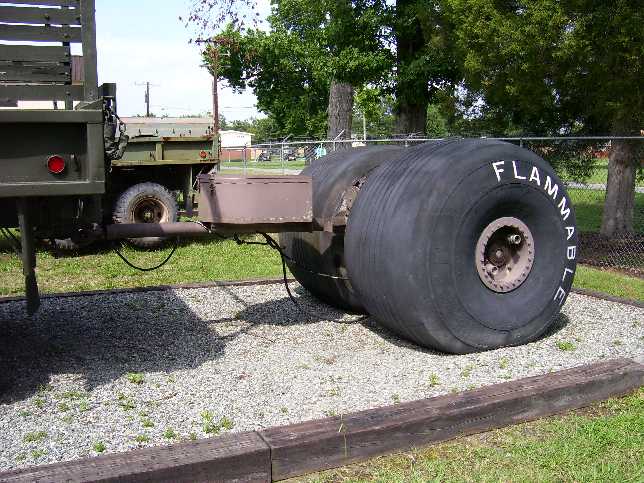
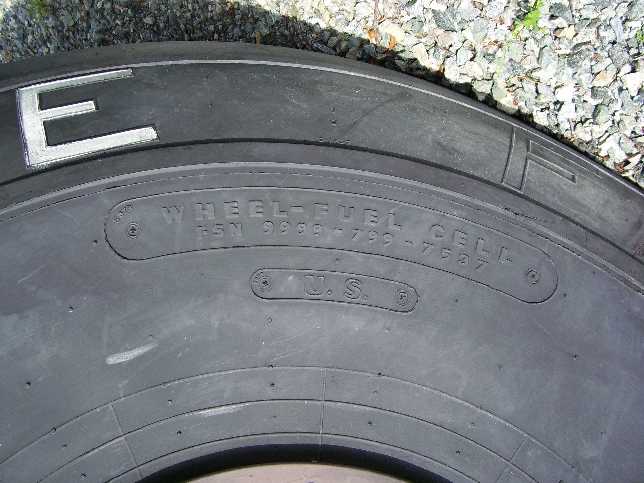
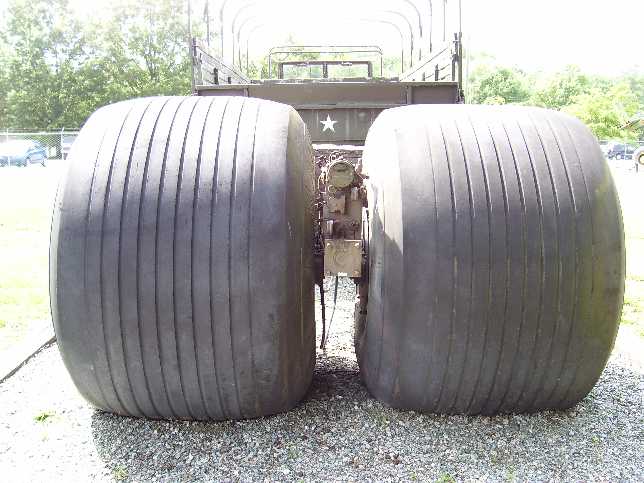
Yes, some of the 3/73rd Armor's M551 Sheridan light tanks flown in by C-130. We know 3/73rd Armor was there as part of the armored stampede into Iraq for Desert Storm...
THE BIG QUESTION: WHY DID THE IRAQI REPUBLICAN GUARD ESCAPE?
Operation DESERT STORM: What REALLY happened
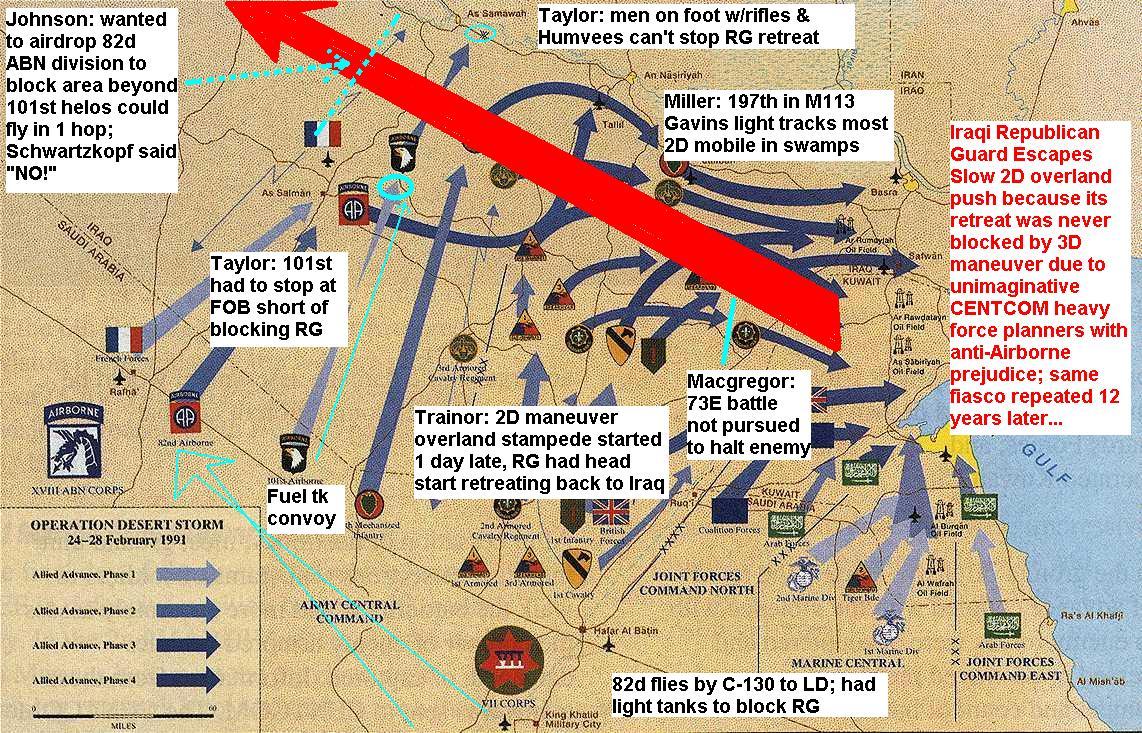
So why didn't we parachute in an 82nd Airborne BLOCKING FORCE which had 56 x M551 Sheridan light tanks and a M577 Gavin C2 APC and could have had a M113 Gavin supplied to each infantry rifle squad and have it seize a stretch of paved road for airland resupply to more aggressively stop the Iraqi Republican Guard (RG) from escaping? The 82nd could have even jumped into FOB Cobra to secure it for the 101st's helicopters to airland--or vice-a-versa. The 101st could also have helped the 82nd get to the ground by airlanding with C-130 fixed-wing aircraft with their more powerful light tracked AFV force by securing a stretch of road. Clearly, this kind of Airborne/Air Assault teamwork was absent.
I asked 82nd Airborne Division Commander General Johnson about this at an "All American Week" in 1992 or '93 (which had a WW1 82nd DIVISION vet lead a parade!) and he said General Schwartzkopf WOULDN'T LET THEM JUMP. Too risk averse or as I surmise CENTCOM populated by heavy tanker "mech pussies" (there is some validity to this insult) who were ANTI-AIRBORNE in their mentality of doing just 2D overland stampedes that folks easily escape from...sort of like what Saddam & Company did 12 years later...I also think a lot of people are envious of the Airborne jumping because it is fuking cool to jump out of airplane and all the ego trappings of getting a jump star on your jump wings etc. I also think the Airborne going around calling people "legs" is disgusting and makes people hate us when we need their co-operation in combined 2D/3D maneuver warfighting...
Snobs could state to the non-Airborne folks:
"Then go to jump school and get with the program!"
Not so easy. The Army doesn't let anyone go to jump school lest everyone have esperit de corps. We can't have that and still have a zero-sum game "pyramid of ego".
Again, Gavin---like our greatest Army leaders like Chamberlain, Ridgway and Sherman was not a snob---he wanted the ENTIRE U.S. ARMY ABLE TO BE AIRBORNE AND FIGHT AFTER AIR DELIVERY; an ATTAINABLE goal.
I think we should get on with it; make every Soldier a tiger and stop this lack of exploiting 3D maneuver we need to win 21st century wars out of petty bureaucratic command post mission/task back-stabbing fueled by ego envies/rivalries.
The fact remains you cannot catch enemies with obvious 2D overland vehicle stampede "pushes" since they have a "head start". You need to BLOCK THEM WITH A CAVALRY; that force should be the Army Airborne with LIGHT TANKS using fixed-wing aircraft for the distances/times needed. The 101st in conventional helicopters had to hop twice into FOBs and then wait for fuel trucks to arrive. When they finally got there, they didn't have the ability to block the Republican Guards from escaping with just men with hand weapons and BS Humvee trucks. Another solution would be to air-mechanize the 101st with Mini-Gavins and make their helos fly faster and farther with Piasecki VTDP/wings. All covered in our AMS book. Another thing we need to do is conserve fuel and TOW helicopters on the ground if we don't need them to fly.
And what were the consequenses of letting the RG escape due to U.S. military incompetence and narcissism that kept dictator Saddam Hussein in power for 13 more years?
* At least 200, 000 Iraqis dying
* U.S. having to re-invade...again...without an effective 3D maneuver block
* Unlike Noriega in Panama, when we fanned out in light tracked tanks to block him, we had a slow 2D push with imbecilic USMC in 75% wheeled trucks that was 6 days AWOL reaching Baghdad while the aggressive "thunder run" of the U.S. Army's 3rd Infantry Division toppled the nation-state capital city.
* The timid 3D airdrop/airlanding by the 173rd Airborne Brigade and the 1st Infantry Division into Northern Iraq did not fan out to prevent Saddam and subordinates escaping to Tikrit to start a guerrilla war against us
* So far the Iraq war & occupation has cost us over 2, 500 dead and 20, 000 wounded American service men/women;numbers of human tragedies rising each day due to a mis-led COIN campaign
NOT BEING EXCELLENT IN THE ART OF WAR---WHICH MEANS BOLD 3D AIR-GROUND MANEUVER AND NOT JUST 2D STAMPEDES---HAS FATAL CONSEQUENSES!
Too bad General Schwartzkopf was not as good at the operational art as he claimed to be.
There are two HUGE ideas never spoken about that describe what happens in U.S. DoD and military.
The first one is why is everything NEW and so COSTLY and what we already have is NEVER fully upgraded and maximized so WE HAVE MORE.
IDEA #1: "We're holding-out-for-our-cash-cow"
According to Dr. Dixon western militaries are full of people who deep down really don't want to fight and want built-in excuses like NOT HAVING ENOUGH. This is why we replace originally 2, 000 x F-15s (now we're down to just 224) with just 184 x F-22s. We throw away all our M60 medium tanks and replace with lesser amount of M1 heavy tanks. FCS is a classic holding-out-for-a-cash-cow move. IF the Army gets Congress to buy into the false idea that THEY ARE THE EXPERTS and that civilians exist solely to supply THEM what they want and that FCS IS THE BEST AND ONLY WAY TO WARFIGHT; they will have won even if we can only afford handfuls. The Army will hold out for more FCSs as the light mafia gets what it wants which is the heavy force in tracks to die by platform neglect and their "modularity" reorganization "helps".
IDEA #2: "Move aside, I'm hogging the action"
When the lightfighters planned Grenada in 1983 and Panama in 1989, THEY KEPT HEAVY FORCES COMPLETELY OUT OF THE ACTION other than 5/6 Mech Infantry in M113 Gavin light tracks (this was considered "heavy force" because they lack penises and need the armor and tracks). The lightfighters had their own M551/M113 Gavin light tracked tanks to keep the the heavy "mech pussies" out; no combat action = no promotions for them.
Along comes Desert Shield/Storm run by CENTCOM and the heavy tankers, so who do they shut out? They wanted to send the 82nd Airborne home because it lacked mobility in the open desert (so they say) but General Johnson insisted they get to do the "death-from-a-truck" stampede out to the far west of the "Hail Mary"; obviously he was not able to get the All Americans to drop into blocking positions as should have happened because this would mean the glory going AGAIN (Grenada, Panama etc.) to the fuking arrogant call-everyone-a-leg Airborne types. The 82nd Airborne supplied with M113 Gavin tracks en masse could have paradropped or airlanded into or close to and then went overland to block the Republican Guard's escape, but Schwartzkopf said "NO!" due to PETTY BS ATTITUDES of whose going to get the action/career help NOT DUE TO SOUND MILITARY LOGIC.
So with the heavy tankers in charge, when the M551 Sheridans needed replacing, the M8 Buford AGS light tank suddenly was less important than other funding priorities like a $100M paper study of a tank to replace the M1 heavy tank. So the Airborne now can't shut out the Heavy force mafia from the "action" in the next war, but the egomaniacs don't realize this means we have to WAIT FOR THEM TO BE SLOWLY AIRLANDED; scroll down to see how this enabled Saddam & subordinates to escape during OIF in 2003.
Today, the worst kind of extreme lightfighter egotists are in charge, the Schoomaker mafia and they are the ones opposing the Airborne getting light tanks because it makes their penis shrivel.
So instead of doing WHAT'S BEST FOR AMERICA, WHAT'S BEST FOR EXCELLENT U.S. ARMY WARFIGHTING, whoever is in charge of HQDA does what they think's best for THEIR PRIVATE EGO CLUB FACTION they came from or crackpot "vision of warfare" they embrace to make a name for themself as Army Chief of Staff.
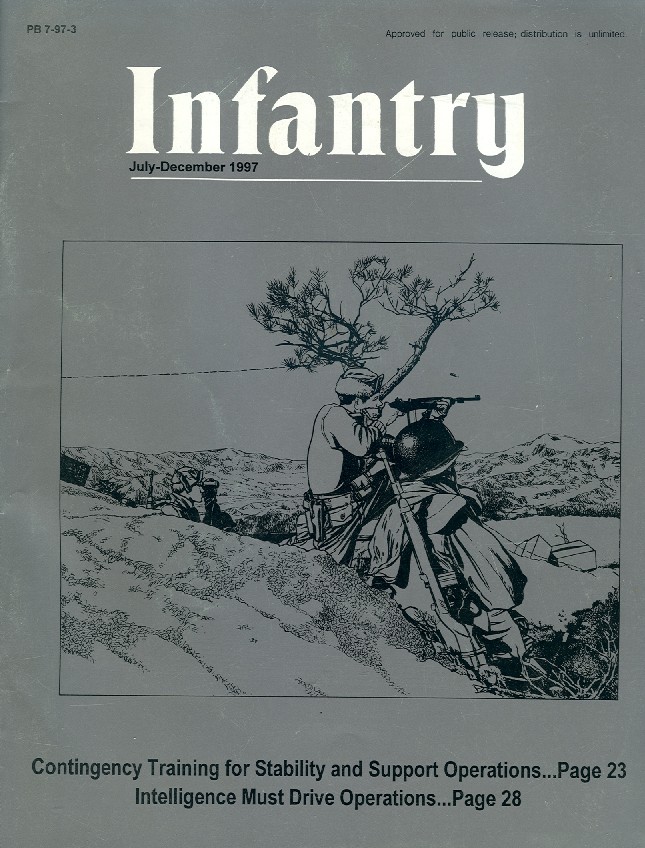
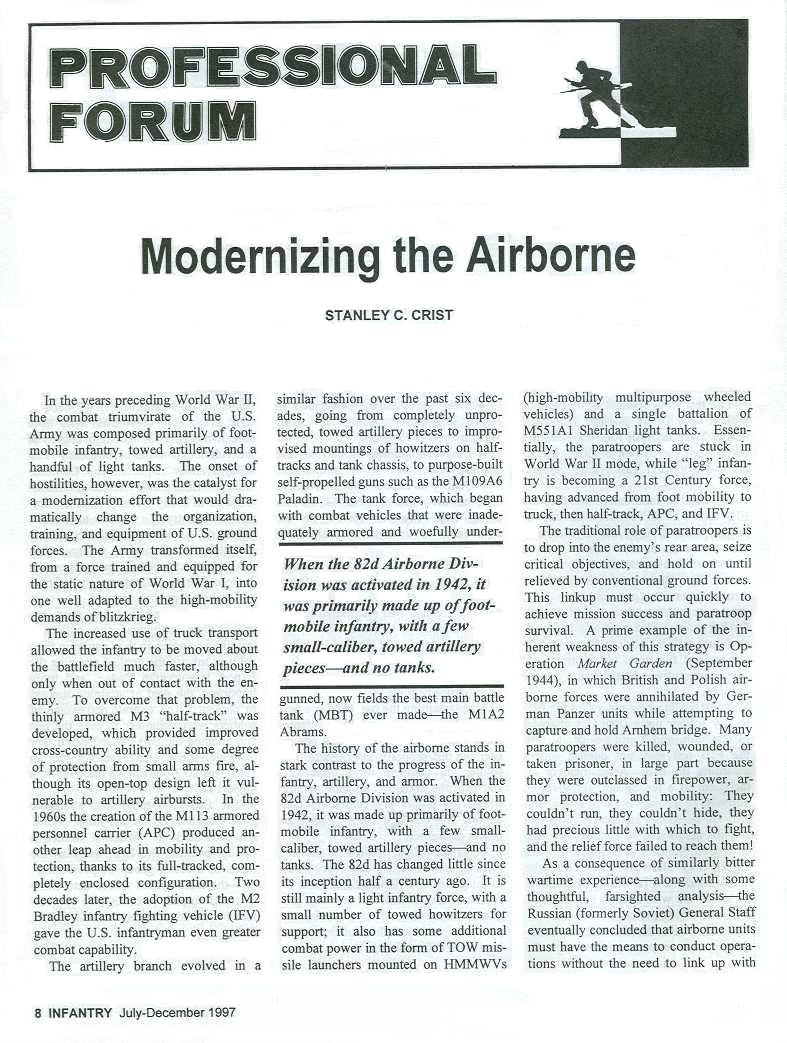
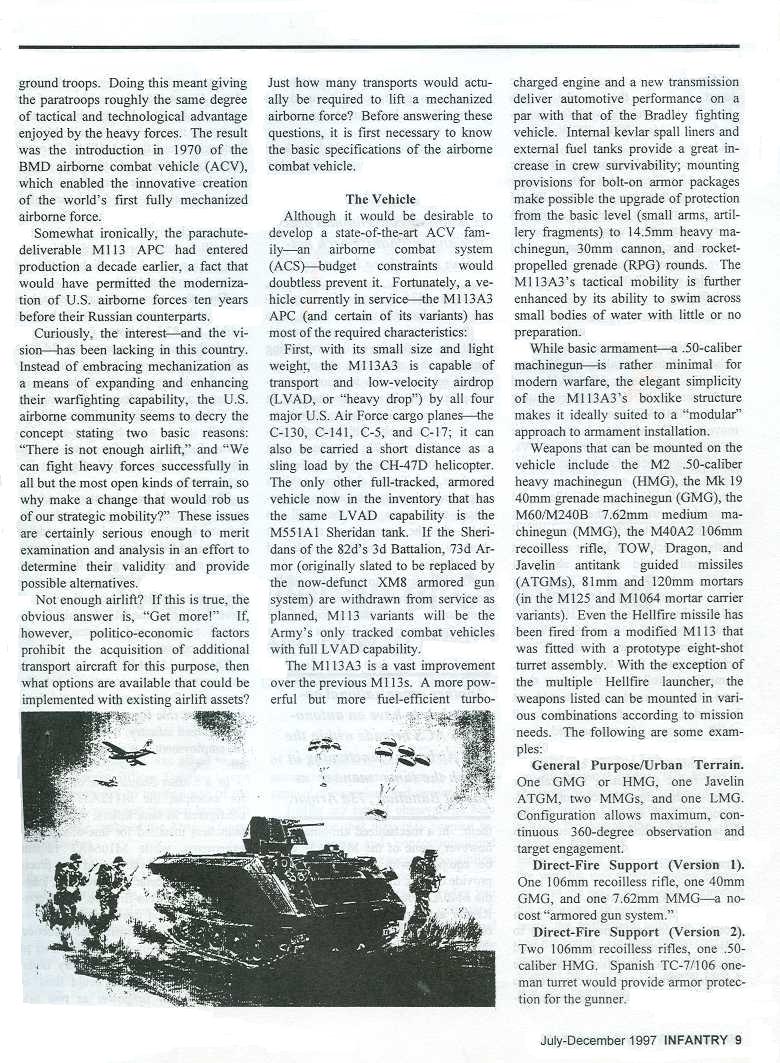
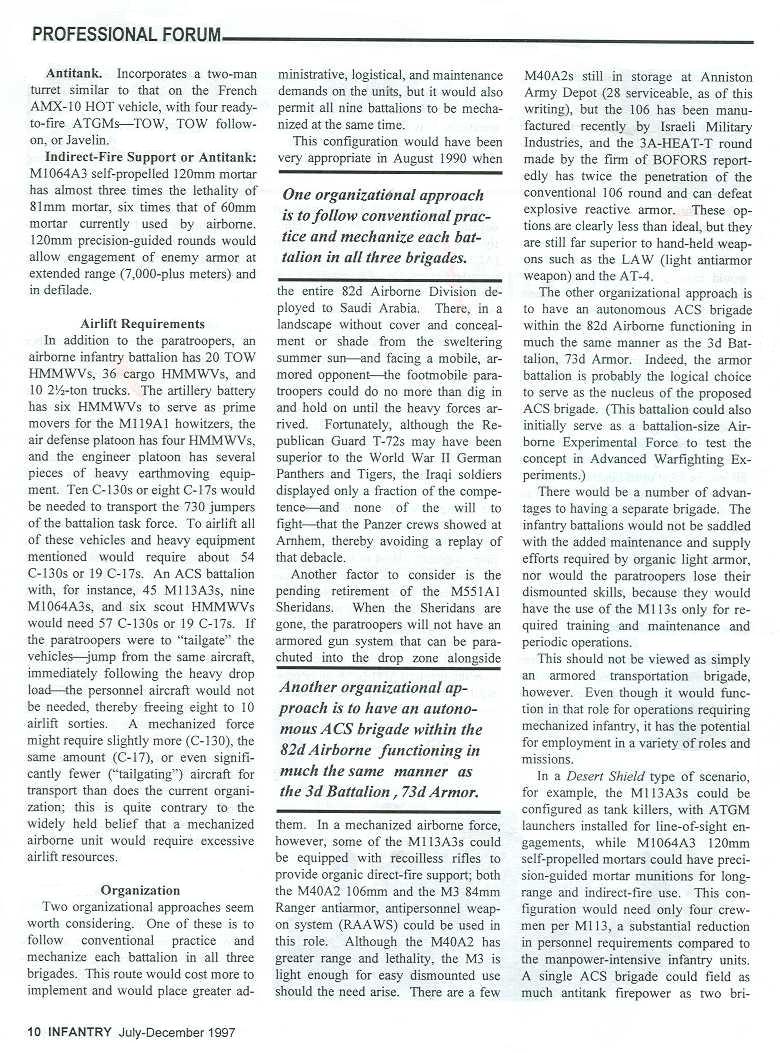
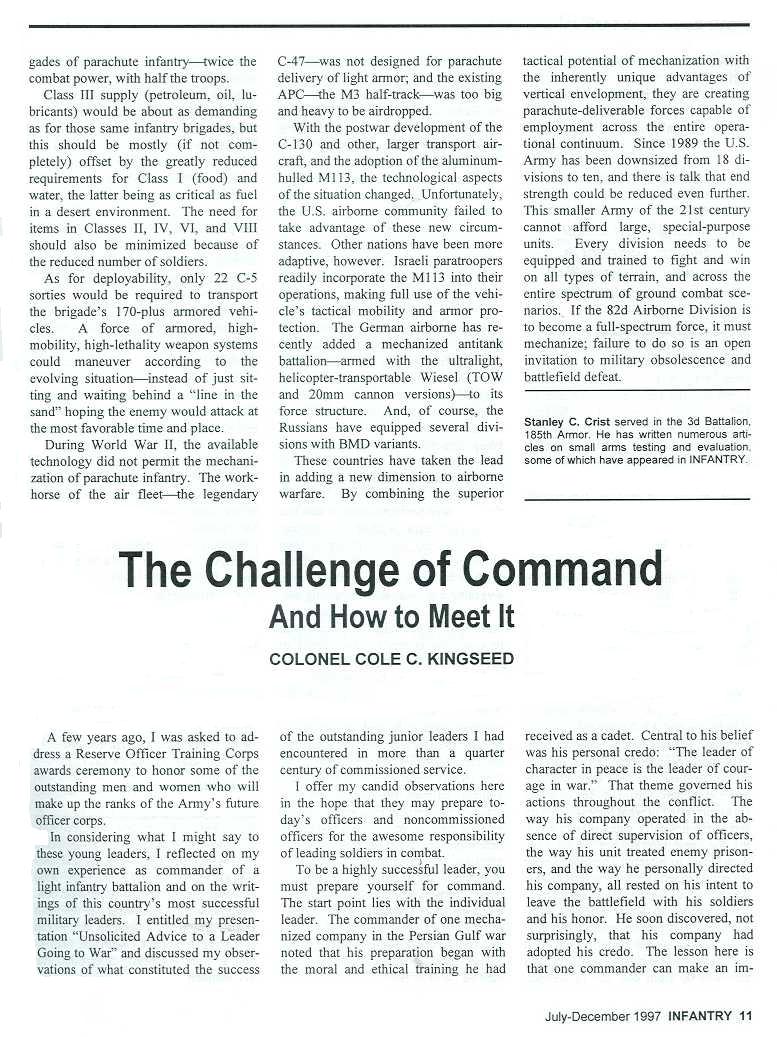
Modernizing the Airborne
PROFESSIONAL NOTES
By Stan Crist
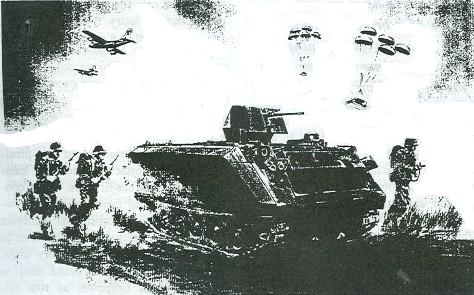
In the years preceding, World War II, the combat triumvirate of the U.S. Army was composed primarily of foot-mobile infantry, towed artillery, and a handful of light tanks. The onset of hostilities, however, was the catalyst for a modernization effort that would dramatically change the organization, training, and equipment of U.S. ground forces. The Army transformed itself, from a force trained and equipped for the static nature of World War I, into one well adapted to the high-mobility demands of blitzkrieg.
The increased use of truck transport allowed the infantry to be moved about the battlefield much faster, although only when out of contact with the enemy. To overcome that problem, the thinly armored M3 "half-track" was developed, which provided improved cross-country ability and some degree of protection from small arms fire, although its open-top design left it vulnerable to artillery airbursts. In the 1960s the creation of the M113 [Gavin] armored personnel carrier (APC) produced another leap ahead in mobility and protection, thanks to its full-tracked, completely enclosed configuration. Two decades later, the adoption of the M2 Bradley infantry fighting vehicle (IFV) gave the U.S. infantryman even greater combat capability.
The artillery branch evolved in a
Page 8 INFANTRY July-December 1997
STANLEY C. CRIST
similar fashion over the past six decades, going from completely unprotected, towed artillery pieces to improvised mountings of howitzers on half-tracks and tank chassis, to purpose-built self-propelled guns such as the MI09A6 Paladin. The tank force, which began with combat vehicles that were inadequately armored and woefully under-
When the 82nd Airborne Division was activated in 1942, it was primarily made up of foot-mobile infantry, with a few small-caliber, towed artillery pieces--and no tanks.
gunned, now fields the best main battle [heavy] tank (MBT) ever made-the M1A2 Abrams. The history of the airborne stands in stark contrast to the progress of the infantry, artillery, and armor. When the 82nd Airborne Division was activated in 1942, it was made up primarily of foot-mobile infantry, with a few small caliber, towed artillery pieces-and no tanks. The 82nd has changed little since its inception half a century ago. It is still mainly a light infantry force, with a small number of towed howitzers for support; it also has some additional combat power in the form of TOW missile launchers mounted on HMMWVs (high-mobility multipurpose wheeled vehicles) and a single battalion of M551A1 Sheridan light tanks. Essentially, the paratroopers are stuck in World War II mode, while "leg" infantry is becoming a 21st Century force, having advanced from foot mobility to truck, then half-track, APC, and IFV. The traditional role of paratroopers is to drop into the enemy's rear area, seize critical objectives, and hold on until relieved by conventional ground forces.
This linkup must occur quickly to achieve mission success and paratroop survival. A prime example of the inherent weakness of this strategy is Operation Market Garden (September 1944), in which British and Polish airborne forces were annihilated by German Panzer units while attempting to capture and hold Arnhem bridge. Many paratroopers were killed, wounded, or taken prisoner, in large part because they were outclassed in firepower, armor protection, and mobility: They couldn't run, they couldn't hide, they had precious little with which to fight, and the relief force failed to reach them!
 www.youtube.com/watch?v=VSm5nBZ4X0A
www.youtube.com/watch?v=VSm5nBZ4X0A
As a consequence of similarly bitter wartime experience---along with some thoughtful, farsighted analysis-the Russian (formerly Soviet) General Staff eventually concluded that airborne units must have the means to conduct operations without the need to link up with ground troops. Doing this meant giving the paratroops roughly the same degree of tactical and technological advantage enjoyed by the heavy forces. The result was the introduction in 1970 of the BMD airborne combat vehicle (ACV), which enabled the innovative creation of the world's first fully mechanized airborne force.
 www.youtube.com/watch?v=_hrvgYEI90c
www.youtube.com/watch?v=_hrvgYEI90c
Somewhat ironically, the parachute deliverable M113 APC had entered production a decade earlier, a fact that would have permitted the modernization of U.S. airborne forces ten years before their Russian counterparts.
 www.youtube.com/watch?v=zD4RWmotso0
www.youtube.com/watch?v=zD4RWmotso0
Curiously, the interest--and the vision-has been lacking in this country. Instead of embracing mechanization as a means of expanding and enhancing their warfighting capability, the U.S. airborne community seems to decry the concept stating two basic reasons: "There is not enough airlift," and "We can fight heavy forces, successfully in all but the most open kinds of terrain, so why make a change that would rob us of our strategic mobility?" These issues are certainly serious enough to merit examination and analysis in an effort to determine their validity and provide possible alternatives.
Not enough airlift? If this is true, the obvious answer is, "Get more!" If, however, politico-economic factors prohibit the acquisition of additional transport aircraft for this purpose, then what options are available that could be implemented with existing airlift assets?
Just how many transports would actually be required to lift a mechanized airborne force? Before answering these questions, it is first necessary to know the basic specifications of the airborne combat vehicle.
The Vehicle
Although it would be desirable to develop a state-of-the-art ACV family-an airborne combat system (ACS}---budget constraints would doubtless prevent it. Fortunately, a vehicle currently in service--the M113A3 APC (and certain of its variants) has most of the required characteristics: First, with its small size and light weight, the M113A3 is capable of transport and low-velocity airdrop (LVAD, or "heavy drop") by all four major U.S. Air Force cargo planes-the C-130, C-141, C-5, and C-17; it can also be carried a short distance as a sling load by the CH-47D helicopter. The only other full-tracked, armored vehicle now in the inventory that has the same LVAD capability is the M551A1 Sheridan tank. If the Sheridans of the 82nd's 3rd Battalion, 73rd Armor (originally slated to be replaced by the now-defunct XM8 [Buford] armored gun system) are withdrawn from service as planned, M113 variants will be the Army's only tracked combat vehicles with full LVAD capability.
 www.youtube.com/watch?v=htdQVbmvLgQ
www.youtube.com/watch?v=htdQVbmvLgQ
The M113A3 is a vast improvement over the previous M113s. A more powerful but more fuel-efficient turbocharged engine and a new transmission deliver automotive performance on a par with that of the Bradley fighting vehicle. Internal kevlar spall liners and external fuel tanks provide a great increase in crew survivability; mounting provisions for bolt-on armor packages make possible the upgrade of protection trom the basic level (small arms, artillery fragments) to 14.5mm heavy machinegun, 30mm cannon, and rocket-propelled grenade (RPG) rounds. The MI13A3's tactical mobility is further enhanced by its ability to swim across small bodies of water with little or no preparation.
 www.youtube.com/watch?v=9VMgdFUd1JU
www.youtube.com/watch?v=9VMgdFUd1JU
While basic armament-a .50-caliber [heavy] machinegun-is rather minimal for modem warfare, the elegant simplicity of the M113A3's box-like structure makes it ideally suited to a "modular" approach to armament installation.
 www.youtube.com/watch?v=9SPHgpLWPws
www.youtube.com/watch?v=9SPHgpLWPws
Weapons that can be mounted on the vehicle include the M2 .50-caliber heavy machinegun (HMG), the Mk 19 40mm grenade machinegun (GMG), the M60/M240B 7.62mm medium machinegun (MMG), the M40A2 106mm recoilless rifle, TOW, Dragon, and Javelin antitank guided missiles (ATGMs), 81mm and 120mm mortars (in the M125 and M1064 mortar carrier variants). Even the Hellfire missile has been fired from a modified M113 that was fitted with a prototype eight-shot turret assembly. With the exception of the multiple Hellfire launcher, the weapons listed can be mounted in various combinations according to mission needs. The following are some examples:
General Purpose, Urban Terrain.
One GMG or HMG, one Javelin ATGM, two MMGs, and one LMG.
Configuration allows maximum, continuous 360-degree observation and target engagement.
Direct-Fire Support (Version 1).
One 106mm recoilless rifle, one 40mm GMG, and one 7.62mm MMG-a no cost "armored gun system." Direct-Fire Support (Version 2).
Two 106mm recoilless rifles, one .50 caliber HMG. Spanish TC-7/l06 one-man turret would provide armor protection for the gunner.
Page 9 July-December 1997 INFANTRY
Antitank.
Incorporates a two-man turret similar to that on the French AMX-1O HOT vehicle, with four ready-to-fire ATGMs-TOW, TOW follow-on, or Javelin.
Indirect-Fire Support or Antitank.
M1064A3 self-propelled 120mm mortar has almost three times the lethality of 81mm mortar, six times that of 60mm mortar currently used by airborne. 120mm precision-guided rounds would allow engagement of enemy armor at extended range (7,000-plus meters) and in defilade.
 www.youtube.com/watch?v=-Y-j4KCNqKM
www.youtube.com/watch?v=-Y-j4KCNqKM
Airlift Requirements
In addition to the paratroopers, an airborne infantry battalion has 20 x TOW HMMWVs, 36 x cargo HMMWVs, and 10 x 2.5-ton trucks [ED: these weigh 10.5 tons--exactly the same as M113s]. The artillery battery has six HMMWVs to serve as prime movers for the M1l9A1 [105mm] howitzers, the air defense platoon has four HMMWVs, and the engineer platoon has several pieces of heavy earthmoving equipment. Ten C-130s or eight C-17s would be needed to transport the 730 jumpers of the battalion task force. To airlift all of these vehicles and heavy equipment mentioned would require about 54 x C-130s or 19 x C-17s. An ACS battalion with, for instance, 45 x M1l3A3s, nine x M1064A3s, and six scout HMMWVs would need 57 x C-130s or 19 x C-17s. If the paratroopers were to "tailgate" the vehicles-jump from the same aircraft, immediately following the heavy drop load--the personnel aircraft would not be needed, thereby freeing eight to 10 airlift sorties. A mechanized force might require slightly more (C-130), the same amount (C-17), or even significantly fewer ("tailgating") aircraft for transport than does the current organization; this is quite contrary to the widely held belief that a mechanized airborne unit would require excessive airlift resources.
 www.youtube.com/watch?v=50cpPAVoxJQ
www.youtube.com/watch?v=50cpPAVoxJQ
Organization
Two organizational approaches seem worth considering. One of these is to follow conventional practice and mechanize each battalion in all three brigades. This route would cost more to implement and would place greater administrative, logistical, and maintenance demands on the units, but it would also permit all nine battalions to be mechanized at the same time.
This configuration would have been very appropriate in August 1990 when
One organizational approach is to follow conventional practice and mechanize each battalion in all three brigades.
the entire 82nd Airborne Division deployed to Saudi Arabia. There in a landscape without cover and concealment or shade from the sweltering summer sun-and facing a mobile, armored opponent-the foot-mobile paratroopers could do no more than dig in and hold on until the heavy forces arrived. Fortunately, although the Republican Guard T-72s may have been superior to the World War II German Panthers and Tigers, the Iraqi soldiers displayed only a fraction of the competence--and none of the will to fight-that the Panzer crews showed at Arnhem, thereby avoiding a replay of that debacle.
Another factor to consider is the pending retirement of the M551A1 Sheridans. When the Sheridans are gone, the paratroopers will not have an armored gun system that can be parachuted into the drop zone alongside them. In a mechanized airborne force, however, some of the M113A3s could be equipped with recoilless rifles to provide organic direct-fire support; both the M40A2 106mm and the M3 84mm Ranger antiarmor, antipersonnel weapon system (RAAWS) could be used in this role. Although the M40A2 has greater range and lethality, the M3 is light enough for easy dismounted use should the need arise. There are a few M40A2s still in storage at Anniston Army Depot (28 serviceable, as of this writing), but the 106 has been manufactured recently by Israeli Military Industries, and the 3A-HEAT-T round made by the firm of BOFORS reportedly has twice the penetration of the conventional 106 round and can defeat explosive reactive armor. These options are clearly less than ideal, but they are still far superior to hand-held weapons such as the LAW (light anti-armor weapon) and the AT-4.
The other organizational approach is to have an autonomous ACS brigade within the 82nd Airborne functioning in much the same manner as the 3rd Battalion, 73rd Armor. Indeed, the armor battalion is probably the logical choice to serve as the nucleus of the proposed ACS brigade. (This battalion could also initially serve as a battalion-size Airborne Experimental Force to test the concept in Advanced Warfighting Experiments.)
There would be a number of advantages to having a separate brigade. The infantry battalions would not be saddled with the added maintenance and supply efforts required by organic light armor, nor would the paratroopers lose their dismounted skills, because they would have the use of the M113s only for required training and maintenance and periodic operations.
This should not be viewed as simply an armored transportation brigade, however. Even though it would function in that role for operations requiring mechanized infantry, it has the potential for employment in a variety of roles and missions.
In a Desert Shield type of scenario, for example, the M113A3s could be configured as tank killers, with ATGM launchers installed for line-of-sight engagements, while M1064A3 120mm self-propelled mortars could have precision-guided mortar munitions for long-range and indirect-fire use. This configuration would need only four crewmen per M113; a substantial reduction in personnel requirements compared to the manpower-intensive infantry units.
A single ACS brigade could field as much antitank firepower as two bri-
Page 10 INFANTRY July-December 1997
gades of parachute infantry--twice the combat power, with half the troops. Class III supply (petroleum, oil, lubricants) would be about as demanding as for those same infantry brigades, but this should be mostly (if not completely) offset by the greatly reduced requirements for Class I (food) and water, the latter being as critical as fuel in a desert environment. The need for items in Classes II, IV, VI, and VIII should also be minimized because of the reduced number of Soldiers.
As for deployability, only 22 C-5 sorties would be required to transport the brigade's 170-plus armored vehicles. A force of armored, high mobility, high-lethality weapon systems could maneuver according to the evolving situation-instead of just sitting and waiting behind a "line in the sand" hoping the enemy would attack at the most favorable time and place.
During World War II, the available technology did not permit the mechanization of parachute infantry. The workhorse of the air fleet--the legendary C-47-was not designed for parachute delivery of light armor; and the existing APC-the M3 half-track-was too big and heavy to be airdropped.
With the post-war development of the C-130 and other, larger transport aircraft, and the adoption of the aluminum-hulled M113, the technological aspects of the situation changed. Unfortunately, the U.S. airborne community failed to take advantage of these new circumstances. Other nations have been more adaptive, however. Israeli paratroopers readily incorporate the M113 into their operations, making full use of the vehicle's tactical mobility and armor protection. The German airborne has recently added a mechanized antitank battalion-armed with the ultralight, helicopter-transportable Wiesel (TOW and 20mm cannon versions}-to its force structure. And, of course, the Russians have equipped several divisions with BMD variants.
These countries have taken the lead in adding a new dimension to airborne warfare. By combining the superior tactical potential of mechanization with the inherently unique advantages of vertical envelopment, they are creating parachute-deliverable forces capable of employment across the entire operational continuum. Since 1989 the U.S. Army has been downsized from 18 divisions to ten, and there is talk that end strength could be reduced even further. This smaller Army of the 21st century cannot afford large, special-purpose units. Every division needs to be equipped and trained to fight and win on all types of terrain, and across the entire spectrum of ground combat scenarios. If the 82nd Airborne Division is to become a full-spectrum force, it must mechanize; failure to do so is an open invitation to military obsolescence and battlefield defeat.
Stanley C. Crist served in the 3rd Battalion, 185th Armor. He has written numerous articles on small arms testing and evaluation, some of which have appeared in INFANTRY.
Date: 15 January 1991
Unit: Special Forces, HALO Team
Operation: Desert Storm
Troopers: 12
Country: Iraq
Dropzone: Northwest desert
Aircraft: MC-130E Combat Talons turboprop or C-141B Starlifter turbojet aircraft
Date: 1991
Unit: 4th Psychological Operations Group (Airborne)
Operation: ?
Troopers: 300+ parachute dummies
Country: Kuwait
Dropzone: North of Kuwaiti International airport
Aircraft: MC-130Es Combat Talons turboprop aircraft
Equipment air-dropped: Folding parachute dummies to replicate a U.S. Army 82nd Airborne Paratroop landing in the rear of Iraqi positions to assist Arab coalition/marine forces moving north to liberate Kuwait
Type Air delivery: LVAD
NOTE: Numerous leaflet drops were made though not specifically detailed here, resulting in mass surrenders of Iraqi forces and saving hundreds of American lives
Date: 1991-2
Unit: USAF airlift squadrons/Army Riggers
Operation: Provide Comfort
Troopers: ?
Country: Iraq
Dropzone: Northwest desert
Aircraft: MC-130E Combat Talons, C-130H Hercules turboprop aircraft
Equipment/supplies air-delivered: Food (MREs), water, medical supplies (CDS)
Type Air delivery: LVAD, Free drop
Date: 1993-5
Unit: USAF airlift squadrons/Army Riggers
Operation: Provide Promise
Troopers: ?
Country: Bosnia
Dropzone: Mountains of Bosnia
Aircraft: MC-130E Combat Talons, C-130H Hercules turboprop aircraft
Equipment/supplies air-delivered: Food (MREs), water, medical supplies (CDS)
Type Air delivery: HVAD, delayed-timer LVAD, free drop MREs Free drop (TRIADS system)
Date: 11-20 November 1996
Unit: USAF C-5C airlift squadron/U.S. Army "B" Co 3/160th SOAR (Airborne)"Night Stalkers", 3/325th PIR Paratroopers
Operation: Assured Response
Troopers: 200
Country: Liberia
Assault zones: Freetown airport, Sierra Leone, Monrovia, Liberia
Aircraft: C-5C Galaxies turbofan, MH-47E SpOPs Chinooks, C-130H Hercules turboprop aircraft
Equipment/supplies air-delivered: Ammunition, food (MREs), water, medical supplies 463L palletized
Type Air delivery: STOL airland
Airborne flies into Sierra Leone by USAF C-5Cs and rescues Americans from Liberia using MH-47 helicopters 9 DAYS before marines can get there by slow moving ship. 3/160th SOAR(A) (-) deploys four MH-47Ds to Freetown, Sierra Leon, Africa to support COMJTF (Operation ASSURED RESPONSE) in the Noncombatant Evacuation (NEO) of personnel from Monrovia, Liberia, from 10-20 APR 96. The commander of B 3/160th SOAR, Major James Viola, U.S. Army writes:
"The Personnel Assets:
HHC: 4 Officer, 1 WO, 9 Enlisted, 0 Civilian.
A/3-160:
0 Officer, 0 WO, 0 Enlisted, 0 Civilian.
B/3-160:
2 Officer, 8 WO, 17 Enlisted, 0 Civilian.
C/3-160:
1 Officer, 0 WO, 39 Enlisted, 1 Civilian.
Total:
7 Officer, 9 WO, 65 Enlisted, 1 Civilian
(82 personnel)
The Helicopter Assets:
4 MH-47Ds
The staff updates were still a bit sketchy, particularly in the area of what logistics would be available at the deployment end. The train was moving so fast that we would not have time to get an
Advance Party (ADVON) in before the main body arrived. I focused mainly on mission requirements and deploying the right people, equipment, and bullets to be able to perform all of my METL for 14-21 days. It was on the logistic side that I was taking risk and selling the BN CDR on my assumptions. My general assumption was that everything we needed beyond executing the mission would be there for us to fall in on - a big assumption that we were not able to confirm prior to departure. I was glad we were able to include tents and cots to our load as we waited on the air flow for departure.
Then the big question was asked: What was the no nonsense time we could be ready? MAJ Bobeck had stopped all scheduled maintenance and had every mechanic working on the MH-47Ds identified for deployment. He said, "Twenty-four hours, Sir." LTC Forrester said nice try but can you do it in 12 hours. Mike confirmed with me that my CEs would join the fight once my deployment equipment was ready, and he could put his DynCorp team on one MH-47D. This would enable us to have four MH-47Ds ready to load at 0001, in 12 hours. The BN CDR was much happier with that figure. As we left the meeting, everyone in the room was focused on deployment.
LTC Forrester was going to deploy with Team Viola because of the uncertainty of support at the far end and the rapidity of the deployment. This would become his second ongoing Real World mission in Operations Other Than War, as he already had three MH-60Ls in Brindisi, Italy in support of SOCIFOR, BG Michael Canavan. It was comforting to find out that we also would work for BG Michael Canavan, the JTF Commander.
The teardown of four aircraft and the first C-5 load-out went great. It was accomplished through the super work and dedication of the contract personnel from DynCorp, teamed with two teardown crews from C/3/160. Two aircraft were prepared for deployment on a C-5A. The third and fourth aircraft were configured for transport on a C-5C, one of two the Air Force owns. The C-5C is a modified C-5 which requires less breakdown of the MH-47D. At 092345 Apr 96, the fourth Chinook was ready to load. With the air flow scheduled to start at 100015 Apr, there was only time for a short break.
The Assistant S3, CPT Richard Carroll, showed up in the hangar. "Hey, Sir, there's been a change in the air flow." Those words started the tumble. Problem #1, the air flow began to tumble one to two hours at a time. The first C-5 finally landed and was ready to load at 100900 Apr 96. Because the teardown crew worked until midnight in preparation for a 100015 APR 96 loadout, and now the actual load time was 100900 APR 96, this extended the teardown crew's already long duty day. Some personnel were up almost 24 hours. Not a problem yet, it will be an eleven hour flight, plenty of time for some rest.
Once the loading started, the adrenaline began to flow again. It went quick and safely. Chalk 1 was ready to go in about two hours. As Chalk 1 departed Hunter Army Airfield, Chalk 2 started to load up. Problem #2 was about to rear its ugly head. Chalk 1 diverted to Dover, Delaware for 16 hours with maintenance problems and Chalk 2 remained at HAAF with some equipment problems. Chalk 2 ended up taking off first and arrived at Freetown, Sierra Leone at 112100 Apr. Chalk 1 arrived at 120030 Apr. After some delays in downloading, build-up operations were begun at 120400 Apr.
As my pilots came off the C-5, I gave them the priority of work. Set up a planning area in the JSOACC, get accountability of the planning stations, three crews would go into crew rest, and one crew would put together maps and get all the grid coordinates into the planning computer for all key locations.
Initially I ran into some small logistical problems, but I unleashed my ace in the hole, the BN CDR. The horsepower play worked; my assumptions for support were becoming facts with the help of LTC Forrester.
The Acting JTF Commander on scene (Freetown) was the USEUCOM Deputy COMSOC, COL Race. BG Canavan was forward deployed at the U.S. Embassy, Monrovia.
Our command relations with the JTF, was as a member of the Joint Special Operations Aviation Component Command. The other members of the JSOACC were elements of the 352nd and the 21st. The JSOAC Commander was initially COL Connelly, Commander, 352nd. COL Connelly was followed by his deputy, COL Curtis, on 16 Apr 96. LTC Forrester was the senior Army element in the JSOACC, and the senior Army commander within the JTF headquartered at Freetown.
Build-up was slow and deliberate. The rate of build-up and maintenance test flights continued at a steady and safe pace. The urgency I placed on pushing the build-up crews to finish all four aircraft, was dictated by the missions for which we were tasked and safety considerations of the long duty days thus far. Although the projected timelines, both teardown and build-up crews to finish all four aircraft, was dictated by the missions for which we were tasked and safety considerations of the long duty days this far. Although the projected timelines for both teardown and build-ups were met, the continued/sustained deployment sequence (air flow slips) degraded my ability to push the build-up teams too hard.
The timelines for build-up:
• Second C-5 arrives Freetown, Sierra Leone (Africa), 112100 APR 96
• First C-5 Arrives Freetown, Sierra Leone (Africa), 120030 APR 96
• Build-up begins (three aircraft), 120400 APR 96
• Build-up complete/FMC (A/C #367), 121230 APR 96
• A/C #367 executes 1st mission, 121730 APR 96
• Build-up complete/FMC (A/C #160), 131230 APR 96
• Build-up complete/FMC (A/C #360), 131430 APR 96/NMCS (transmission pump)
• Build-up complete/FMC (A/C #146), 141300 APR 96
Mission support began within 17 hours of our arrival at Freetown, Sierra Leone, with my first FMC MH-47D, #367.
A typical mission departed Freetown, flew southeast along the west coast of Africa, and landed at the ECOMOG compound or the U.S. Embassy in Liberia.
The majority of our missions from 11-15 Apr 96 were executed using Night Vision Goggles (NVGs). Mission requirements shifted to require two day sorties and six night sorties. Aerial refuel was used enroute from tanker aircraft provided by both 352nd SOG and 21st SOS.
B/3/160 SOAR (A) MH-47D aircraft were used to transport American Citizens (AMCITS) and foreign nationals from Monrovia to Freetown Airport. The evacuees were then cross-loaded on a C-130 and flown further north to Dakar, Ghana.
The Follow-On:
Team Viola continued operations and assisted the transition of the JTF mission to the U.S. Navy/marines. A MARG steamed South to reach the coast of Liberia on 20 Apr 96. A smooth transition through a local area/AO brief to the marine pilots was given and a successful handover of the SOC mission to the marines occurred on 20 APR. After the marine forces were in place at the Embassy and a successful handover of the Embassy was made from 3-325 IN to marines, I was charged with exfil of all the Army personnel. I used three MH-47Ds to extract the company plus with six sorties. Our first TOT was 201230 APR 96 and we were PZ clean at approximately 202015 APR 96. The last lift out of the Embassy included BG Canavan, the JTF Commander.
Our arrival back into Sierra Leone signified mission complete for Team Viola, as well as the JTF mission. It was now time for Phase four, the MH-47 breakdown and redeployment sequence.
Operational Highlights:
• 100% mission execution
• 2,100 personnel, including 436 AMCITS evacuated (not including 3-325 Paratroopers)
• Aerial Refueling available for all missions
• C-17 MH-47D load validated at HAAF for possible redeployment (C-5s were used)
• 24.5 hours flown on 20 Apr 96 (approx. 8 hrs per crew, last mission)
• ZERO accidents/incidents
• MH-47D total hours - 85.1
• 71 different Nations evacuated"
Date: 1999
Unit: USAF airlift squadrons/Army 1/505th PIR, 3ID (Mechanized)XVIII Airborne Corps
Operation: TF Hawk
Troopers: 1,500
Country: Albania
Assault zone: Tirana airport
Aircraft: C-17 Globemaster III turbofan, C-130H Hercules turboprop aircraft
Equipment/supplies air-delivered: M2 Bradley Fighting Vehicles, M270 MLRS rocket launchers, HMMWVs, 2.5/5 ton trucks, ammunition, food (MREs), water, medical supplies 463L palletized
Type Air delivery: STOL airland
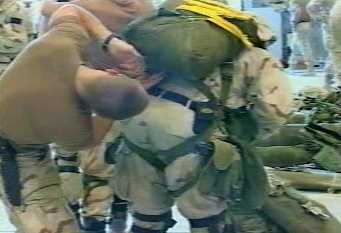
Rangers rig for night combat jump with T-10C main and reserve parachutes
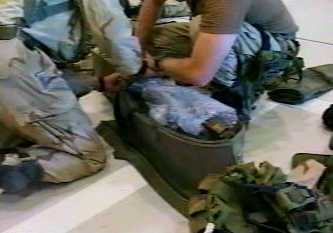
A Weapons case is loaded with a machine gun
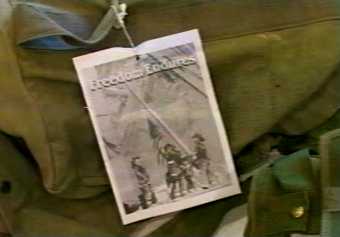
Unfriendly reminder: Rangers left leaflets reminding terrorists they will pay with their lives for September 11th attacks on America

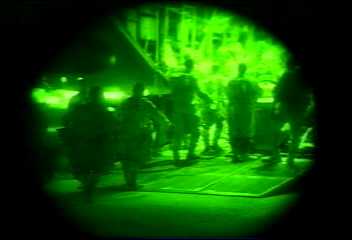
Paratroopers load up the rear ramp of their MC-130E for the flight to Afghanistan
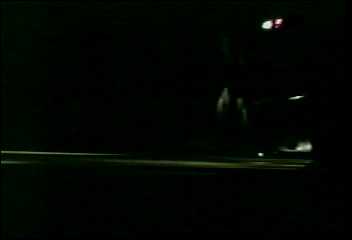
Mighty MC-130E Combat Talon engines roar to prepare for take-off
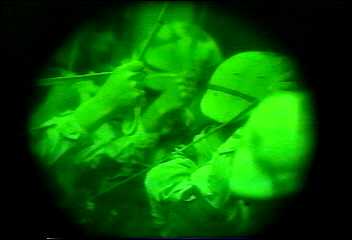
"Hook up!" the cry that begins the battle drill to victory, said many times in America's history by her Paratroopers before meeting America's enemies as our first-to-fight
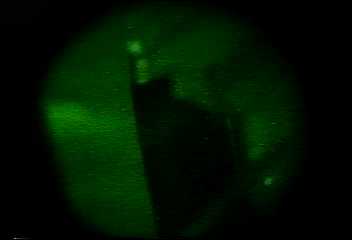
"GO!" a Ranger steps out into the night sky
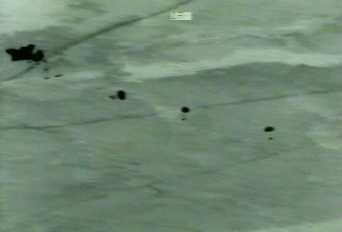
Infared thermal camera of Rangers exiting their MC-130E and chutes opening
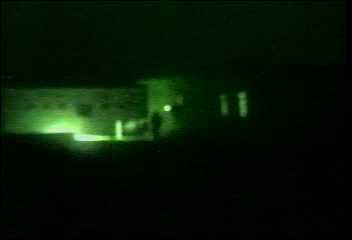
Target buildings!
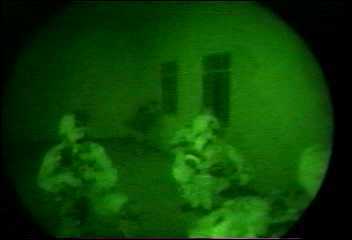
Leaders recon as rooms are cleared; notice night vision devices in use on helmets
Unit: SFOD-Delta, 75th Ranger Regiment
Operation: "Rhino" as leading element of Enduring Freedom
Troopers: 200
Country: Southern Afghanistan
Dropzone: Khandahar
Aircraft: 4 x MC-130E Combat Talon Is
Equipment supplies: M3 84mm Carl Gustav recoilless rifles, M4 5.56mm carbines, some with M203 40mm grenade launchers, M249 Light 5.56mm and M240B Medium Machine Guns 7.62mm, all with night vision devices
Type Air delivery: night, combat mass-tactical Airborne Assault with static-line parachutes
Ranger raid force parachute-dropped in at night to capture/destroy enemy Taliban RPGs, automatic weapons caches at an airfield. Al Queda terrorist second-in-command Muhommad Omar's home raided and destroyed for intelligence collection.
Actual video footage: Army Rangers parachute raid Afghanistan terrorists airfield and base areas
Article with raid description: General Meyers, CJCS press conference
 www.youtube.com/watch?v=K-BUkMF6bpE
www.youtube.com/watch?v=K-BUkMF6bpE
THE JUMP
 www.youtube.com/watch?v=fcF2ctMdMsE
www.youtube.com/watch?v=fcF2ctMdMsE
THE ASSAULT
 www.youtube.com/watch?v=qxTaeHJaA-4
www.youtube.com/watch?v=qxTaeHJaA-4
By Sgt. 1st Class Kathleen T. Rhem, USA
American Forces Press Service
WASHINGTON, Oct. 20, 2001 Ground forces, including Army Rangers, operating under U.S. Central Command struck two terrorist sites inside Afghanistan Oct. 19, the chairman of the Joint Chiefs of Staff confirmed.
DoD officials said two Soldiers were killed in a Blackhawk helicopter accident in Pakistan. Their names have not been released.
Air Force Gen. Richard Myers said during a Pentagon briefing that the troops struck and destroyed an airfield in southern Afghanistan and a Taliban command and control center near Kandahar.
"U.S. forces were able to deploy, maneuver and operate inside Afghanistan without significant interference from Taliban forces," Myers said, adding that the troops did encounter "light resistance."
Myers showed video clips of special forces troops to Pentagon reporters. The video clips showed servicemen packing individual bags, loading onto transport aircraft and later jumping out of those aircraft for an airborne assault inside Afghanistan.
The video was taken at night with night-vision equipment, Myers explained. He noted that the service members found and destroyed a small weapons cache at the airfield.
Myers refused to disclose how many troops were involved or any more details of how they got into or out of Afghanistan, saying only that "they accomplished their objective." Part of the forces' mission was to collect intelligence, he said.
"One of the things I simply can't do is talk about any of the tactics, techniques and procedures that we used beyond what you've seen on that tape," Myers said in response to reporters pressing for more details. "If I were to divulge that, then the next time we conduct an operation somewhere in this world people would have an understanding of how we operate."
Myers dismissed outright Taliban claims that they shot down the helicopter in which two Soldiers died. "I think it's pretty well established the Taliban lie," he said. "Any claims they shot this helicopter down are absolutely false."
He said the crash is classified as an "aircraft mishap" and is currently being investigated. He speculated the crash may have resulted from reduced visibility from landing in large amounts of flying dust at night. But, "it's going to be up to the mishap investigation board to tell us finally," he said.
The chairman expressed his sympathy for the families of the two Soldiers killed. "They, and all who are participating in Operation Enduring Freedom, are heroes," Myers said. "They put their lives on the line on behalf of freedom and on behalf of America. And they do it each and every day."
President Bush, speaking in China where he is attending the Asia-Pacific Economic Cooperation Forum, said, "I want to assure the loved ones that the Soldiers died in a cause that is just and right, and that we will prevail.
"These Soldiers will not have died in vain," he said.
Myers also said five others were injured in the night's missions three on the helicopter that crashed in Pakistan, and two others during the airborne landing. He said none of the service members had life-threatening injuries. Defense officials didn't give any other details about the condition or the identities of those injured.
Meanwhile, air operations continued as well. Roughly 100 strike aircraft hit 15 planned targets, including anti- aircraft artillery sites, ammunition and vehicle storage depots and military training facilities. Four C-17 flights dropped 68,000 humanitarian ration packs as well.
Myers had words of high praise for all the troops involved in these operations. "The credibility of any of the senior leadership in the services rests really with the professionalism and the way our young forces members conduct themselves day in and day out," he said. "They have never let us down."
EXCERPT:
www.enr.construction.com/features/technologyeconst/archives/020225c.asp
MILITARY CONSTRUCTION
High-Tech Tools and Hard, Hard Work At FOB Rhino 2/25/2002
By Tom Sawyer
Long before the first U.S. Soldiers hit the ground in Afghanistan, military construction specialists began studying, analyzing, calculating and planning for the support the troops would need. Military engineers are using the information technology tools of the 21st Century-geospatial data mining, digital collaboration, remote sensing and imaging and satellite communications-together with intelligence in the classic traditions of the cold war to take on an enemy whose tactics range from driving bomb-laden camels toward their foes to crashing hijacked airliners into the towers of lower Manhattan.
It is a story that may never be fully told, but from a series of interviews with military and construction officials, it is possible to sketch how the work is being done. A good starting point is the night of Oct. 19, 2001, 39 days after Sept. 11, as the first assaults by U.S. ground troops in Afghanistan started to unfold.
PIC
MOON DUST Huge planes trashed Rhino's dirt strip nightly. Seabees kept it open. (Photo courtesy of U.S. Navy/Master Chief Photographer's Mate Terry Cosgrove)
A MYSTERIOUS OBJECTIVE. On one stage helicopters swooped out of the moonless night to raid a Taliban headquarters in Kandahar, their troops snatching documents, data and prisoners and whisking them away. At another stage, 200 U.S. Army Paratroopers, most from the 3rd Ranger Battalion of the 75th Ranger Regiment of Ft. Benning, Ga., along with a few "specialists" from the Army and Air Force, raided a strange fortified compound on a dry lakebed about 80 miles to the southwest.
Preceded by fire from supporting aircraft, the Rangers jumped from four C-130 transports, parachuted down and burst into the walled compound's buildings. About 30 defenders fleeing from outlying buildings or rushing toward the compound were killed. The Rangers spent a few hours on the ground and then flew out in the same four transports that dropped them. Somehow, the pilots of those 155,000-lb aircraft knew by then that the outpost's 6,840-ft-long dirt runway was not only safe to land on, but that it also had room for them to turn and taxi and get away again.
Planning for Operation Rhino, as the raid was named, included numerous engineering issues, not the least of which was evaluating the unexplored airstrip. It was not only the return route for the raiders, it was also to serve as a staging point in case the simultaneous raid going on farther north ran into trouble and needed support.
Although it wasn't specified in the mission plan, that same brief visit also helped set the stage for the next act at Rhino on Nov. 25, when elements of the 15th marine expeditionary unit, based at Camp Pendleton, Calif., began swarming in with more than 1,000 troops and an endless chain of aircraft to set up a forward operations base. Engineering support came from a detail of about two dozen Seabees from the Naval Mobile Construction Batallion-133, based in Gulfport, Miss., whose primary task was to improve and maintain the crucial runway.
Such commitments require good site condition information. But the brief night raid of Oct. 19, which began to wrap up when troops signaled the transport planes that the field was safe for landing, was the only "boots on-the-ground" time planners had. The rest of the analysis was made by studying satellite imagery, research and old-fashioned intelligence gathering.
One of the raid planners and participants, Maj. Robert Whalen, regimental intelligence officer with the 75th, describes the target as a "frontier outpost," surrounded by an 8-ft wall with 30-ft-high towers on each corner. And it was new construction.
"It was a self-contained compound attached to a 6,000-ft runway right in the middle of Afghanistan; an oasis of civilization in the middle of nowhere," he says. "Once we received a tip about it we got new satellite pictures and saw construction tents outside in September and October, and then they disappeared."
Whalen says raid planners-as do the rest of the military-rely on satellite imagery and other remote sensing data collected by the National Imaging and Mapping Agency, a secure federal clearinghouse for strategic satellite imagery and geospatial data under the Dept. of Defense and the Central Intelligence Agency. The raid planners used NIMA images to document the layout, calculate the wall height and estimate the number of people using the compound by looking for the latrines. Then they obtained "hand-held" photographs of the unfinished buildings that allowed the regimental engineer and master breecher to study the construction and estimate the sizes of charges that would be needed to blow openings into the walls.
But when the Soldiers jumped from their planes on Oct. 19 there was still much they did not know.
"We had to make all sorts of guesses about what was at Rhino," Whalen says. "After we were there we knew the ground was very difficult to dig down any distance at all. It seemed very hard-packed to us. Rangers hurt themselves, two with broken legs and ankles." The high altitude of the compound, at 3,285 ft, also meant the Soldiers, weighing 250 to 300 lb with their gear, came down fast. "To us it seemed very, very hard, but I bet to the C-130 pilots it probably seemed alarmingly porous," Whalen says. One thing the Rangers did not bring with them was their own engineers. "We wanted as many shooters as possible," Whalen says.
While the Rangers secured the perimeter and searched the compound's buildings, specialists from the Air Force, reportedly from the 23rd Special Tactics Squadron of the Special Operations Command based at Hurlburt Field, near Ft. Walton Beach, Fla., walked the runway in the dark. Alert for mines, they tested the runway with a soil penetrometer, a long rod with a cone-shaped end and a sliding weight. It registers soil resistance when the weight is dropped, allowing bearing characteristics to be evaluated.
The 23rd's members are trained in unconventional infiltration tactics, including scuba and free-fall parachuting. The unit includes a specialty group called combat controllers whose capabilities include surveying and assessing assault zones, and establishing and controlling landing and drop zones "in the most austere and inhospitable regions of the world," according to the unit's mission statement. In addition to inspecting and evaluating runways, the special tactics teams bring in kits that include battery-powered runway lights to guide in pilots.
A public affairs spokesman for the Air Force Special Operations Command declined to discuss Operation Rhino, in part because combat controllers were still in the field. "Combat Control has very few people but they have been working with all those units," he says. The C-130 aircraft used in the raid "can just about land anywhere," he added. "It's unbelievable."
"The most important intelligence we brought back was really the condition of that runway," says Whalen. "That was something we could not tell until we were actually on the ground and sampled it. We brought along specialists who walked up and down the runway to take readings and measurements.
"By the time we left we were absolutely certain it would support C-130s and cautiously optimistic that it would support C-17s. It was more time-consuming to figure out whether it could support a bigger aircraft like a C-17, and this was a raid. Our goal was to destroy the Taliban presence, destroy weapons, gather intelligence and get out. And do it within one cycle of darkness."
In the weeks following the raid intelligence officers monitored the site closely, looking for evidence of fresh mine laying activity "particularly on the runways, in case the Americans came back," Whalen says. On Nov. 25 they did.
2002 Ranger Association Banquet Remarks
The following message from Bill Schwartz '59 is reposted with his permission.
George Lawton
Normally the guest speaker at a Ranger Association Banquet is a senior active duty or retired special operations type, like GEN Wayne Downing or the 75th Ranger Regiment commander. In this case, it was SSG Granger, 3d BN, 75th Ranger Regt who last October made the initial jump into Afghanistan. Granger's squad normally is mounted on motorcycles and perform recon functions. The motorcycles didn't accompany them on the jump.
Ranger veterans from WWII, Korea, Vietnam, Grenada, Panama and Somalia attended the Banquet along with wives and significant others. Ranger Granger had great difficulty describing some of the events without using the F word as adjective and adverb, though I must say he did use it very appropriately, as in ...and when we pulled off the objective, we left 43 dead F rag heads on the objective. Needless to say all in attendance rose to their feet to applaud and the wives allowed as how theyd heard their husbands use the word from time to time and not to worry.
SSG Granger said that as his aircraft approached the DZ, about four minutes out, the aircraft commander stood them all up and had them recite the Ranger Creed. Granger said that the troops were crying as they shouted it out, he himself was tearing up and had shivers running up and down his spine. To say they were pumped is putting it mildly.
I must say that those of us listening to his description of this part of the jump also had shivers running up and down our spine.
SSG Granger was asked how his squad dealt with an ambush since both hands are on the handlebars and this you can't fire. Granger said that the drill calls for getting off the bike, rolling behind it to use it as cover and returning fire. One of the retired Rangers in attendance jokingly asked why the drill wasn't to attack directly into the ambush. Ranger Granger replied, well Sir, what I'd really do is drop it two gears and get the F out of there.
One other note. It was the 3d BN 75th that secured marine corps Base Rhino before the jar heads landed though you'd never know it from reading the newspapers."
On Close Air Support issues, Bill Schwartz, after listening to comments and discussions from various 10th Mountain Division officers who fought in Afghanistan and participated in the Senior Leaders Panel, came to the following conclusions:
"CAS in Afghanistan was abysmal until the arrival of the A-10s, months into the operations. As I listened to the informal tales told by 10th Mountain Division people about the lack of support, my stomach turned. This was not the Air Force that supported us in Vietnam. Air Force shooters would not fly below 10,000 feet in daylight per Air Force dictates, not for political reasons. Hence no strafing runs. No AC-130 support was permitted by the Air Force during daylight hours. For example, when the Rangers were going back into Roberts Ridge to find the SEAL who was killed and support the operators in the area, AC-130 support was withdrawn by the AF Cmd Center in Saudi Arabia five minutes before Chinook touchdown at the LZ because it was daylight. The result as we know contributed to dead and wounded Rangers.
CAS as we knew it was only provided by Navy and marine aircraft when they were in the AO. Only they would come in low for strafing and bombing runs. Unless a unit had an ETAC or FAC they weren't permitted to call in AF close air support. Small units lacked this support. Precision munitions often weren't and could require hours to get on target. At one point it took five hours to bring in close air support for 10th Mountain troops that were in a tough fight. After the Rangers were evacuated from Roberts Ridge, the Air Force pounded the hell out of it for hours with precision munitions prior to a reinsertion by the 1-87 Inf. When the 1-87 hit the LZ the same Al Queda who fought the Rangers were still on the ground. None had been killed. It took troops on the ground to kill the 12 Al Queda that continued to fight from their fortified positions.
One of the reasons for poor CAS was that the Air Tasking Order was laid out 72 hours in advance, and the Air Force staffers were so bureaucratic that they wouldnt adjust weapons loads or missions. By the time the 10th left, they were able to reduce this to 18 hours. This approach to air support means that hitting fleeting or moving targets is very unlikely.
The ASOC in Afghanistan was often overruled by Blue Suit staffers at the Command Center in Saudi Arabia who didnt have a clue as to the real situation on the ground.
For a long period the Air Force would not allow heavy lifters to land in Afghanistan in daylight. Because of poor weather conditions at night this stifled resupply operations. God forbid a round should hit a resupply bird. I contrast this with Vietnam when C-123s and C-130s landed under fire in daylight to support troops on the ground.
In effect there is a significant cultural difference between the views of the Army and the Air Force when it comes down to close air support. These problems must be ironed out before any further operations, such as in Iraq, are undertaken.


From what we've learned:
Date: February, 2003 (no exact date nailed down)
Unit: "B" Company, 3/504 Parachute Infantry Regiment, 82nd Airborne Division
Troopers: 70
Dropzone: Remote section of Western Afghanistan
Aircraft: A single C-130H Hercules
Equipment Supplies: Standard Issue (No specialty items were mentioned) M16A2's, M203 Mounted Grenade Launchers, M249 LMG "SAWs", NVGs for all the men
Type of Delivery: Combat Mass-Tac, T-10D Static Lines, Dusk (not night, you can clearly see in the photo)
An Army insider reports: "Now, I'm proud to be able to suggest an addition. Another U.S. Combat Jump!!!! Yesterday, the Army acknowledged that approximately 70 men of "B" Company, 3/504 Parachute Infantry Regiment made a combat jump in Afghanistan to secure the perimeter for a Ranger Force attacking a classifield objective (the jump took place in February '03 but was declassifield recently.) These men were awarded their Combat Parachutist Badge's yesterday and have stepped into the anals of a proud Airborne History. Here are links to the news story (including a fantastic photo of 10 of the Jumpers descending through the twilight sky an American Flag in the foreground.)
http://www.fayettevillenc.com/story.php?Template=military&Story=6369597
Please recognize these HOOAH Paratroopers and their tremendous contribution to the War on Terror! These men said the hardest part was keeping their mouths shut one of the LT's said that at Advanced Airborne School an Instructor was telling about how he'd heard a rumor of a jump in A-Stan but was sure it was a lie (And he couldnt say "BS! I WAS THERE!) Let's give them the recognition they DEFINITELY deserve".
www.fayettevillenc.com/story.php?Template=military&Story=6369597
Medals go to 70 who made history
By Kevin Maurer
Staff writer
First Lt. Henry Moltz was about to make his first combat jump when he realized that the static line of his parachute was out of place.
Contributed photo
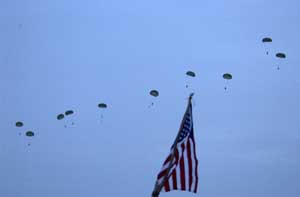
82nd Airborne Division Paratroopers sail toward the ground during a combat jump last year in Afghanistan.
The line was hanging around his knees, instead of hanging properly over his shoulder, as he approached the door of the C-130. Fellow Paratroopers were yelling at him to fix it, but there was nothing he could do at that point. He was the first jumper and was seconds away from going out the door.
"I turned in the door and acted like nothing was wrong," said Moltz, a 24-year-old Texan. "I knew that no matter what happened, I was leaving if I had to use my reserve or not." His main chute opened fine and he landed safely.
Moltz was one of about 70 Paratroopers from "B" Company, 3rd Battalion, 504th Parachute Infantry Regiment, who jumped in Afghanistan in February 2003. It was the first combat jump by the 82nd Airborne Division since Panama in 1989. In a ceremony today, the paratroopers will be awarded a Combat Parachutist Badge with one bronze star to indicate a combat jump. The star is centered on the shroud lines below the canopy.
The Paratroopers had been in Afghanistan for about a month and had been running missions in the eastern part of the country when they were ordered to pack up their gear and move to Bagram air base. The mission was kept so secret that the Soldiers didn't know what they were doing until almost a week after they arrived at the base. "Rumors were flying around. I wasn't sure we would jump until the parachutes arrived," said SPC. Raymond Mullenix, a 21-year-old Florida native.
Even getting the parachutes was a furtive operation.
The Paratroopers covered the parachutes with their ponchos as they carried them into the building where they were training.
"We had guards around the buildings," said Spc. Eddie Camacho, a 22-year-old team leader from New York City.
Secrecy remains
Parts of the operation are still classified. The Paratroopers' mission was to establish an outer security perimeter around the drop zone to protect Soldiers from the 75th Ranger Regiment as they carried out a different mission. They expected to meet some resistance from al-Qaida and Taliban fighters.
The drop zone was in a remote part of western Afghanistan. The Paratroopers said it was flat and sandy, but surrounded by mountains. "It looked like a white piece of paper with mountains around it," said Sgt. 1st Class John Setzer of Binghamton, N.Y. Setzer is 31. He was one of the jumpmasters and was a platoon sergeant in the company.
The Paratroopers jumped at dusk. "We could see forever in every direction for miles," said Staff Sgt. Nathan Buchko, a 24-year-old forward observer in the 319th Airborne Field Artillery. He was attached to the company.
Most of the Paratroopers said they had little time to look around before they landed. Master Sgt. Brian Severino, "B" Company's first sergeant, said he felt like he was in the air forever. All of the Paratroopers said it was a hard landing.
Once on the ground, the Paratroopers assembled in less than 20 minutes, faster than they ever had at Fort Bragg. "It was flawless," Moltz said. They met no enemy resistance and completed their mission. They were picked up the next day by helicopter and returned to Bagram.
'Quiet professionals'
While the Paratroopers were still in Afghanistan, news of the 173rd Airborne Brigade's jump into northern Iraq was reported. Setzer said no news reporters were with the 82nd when his group jumped. He said it was a matter of pride that they received little press attention. "We were definitely the quiet professionals," Setzer said.
After the jump, the hardest part for the Paratroopers was keeping their mouths shut. The jump was not declassified for almost a year. When Setzer and Severino returned to Fort Bragg, people were talking about rumors of a jump. Some of the instructors at the Advanced Airborne School said they had heard about it, but that it was probably a lie, Setzer said.
"A lot of people were jealous," Severino said. "It was very difficult not to rub it in people's faces. One company out of nine got picked to do the mission."
Camacho put it this way: "We were told by our battalion commander that 70 of us are going down in history for a combat jump and that right there is the greatest honor a Soldier in the 82nd Airborne could ever have."
Staff writer Kevin Maurer can be reached at maurerk@fayettevillenc.com or 486-3587.
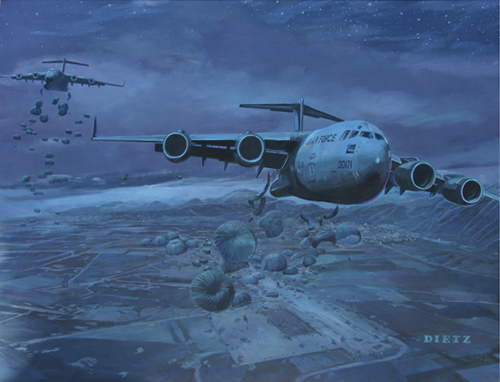
"Moving the Herd" by James Dietz
The 173rd Brigade parachutes into Northern Iraq on 26 March 2003. Image Size: 17.25" x 25"; Overall Size: 24.25" x 31"
1000 Military Edition (Limited Edition, Signed and Numbered)
250 Publisher Proof Edition (Limited Edition, Signed and Numbered)
100 Artist Proof Edition (Limited Edition, Signed and Numbered)
In March of 2003, the Turkish government refused to allow American ground forces, which were positioned at their ports, to move through Turkey in order to establish a northern front in support of Operation Iraqi Freedom. America needed another option and the Sky Soldiers of the 173rd Airborne Brigade provided that option. On the 26th of March at 2000 hours, fifteen C-17 aircraft delivered 20 heavy platforms and 959 paratroopers of the 173rd Airborne Brigade onto Bashur Drop Zone vicinity Bashur, Iraq. This combat parachute assault was the initiation of Operation Northern Delay and established the Coalition's northern front.
The parachute assault force consisted of HHC, 173rd Airborne Brigade, 1st-508th Infantry (Airborne), 2nd-503rd Infantry (Airborne), 74th Long Range Surveillance Detachment, D Battery 319th Airborne Field Artillery Regiment, 173rd Combat Support Company, 501st Forward Support Company, 250th Forward Surgical Team, ODA (-), 2nd Battalion 10th SFG, 4th ASOS (USAF), and the 86th Expeditionary Contingency Response Group (-) (USAF). The Paratroopers were under the command of Colonel William C. Mayville Jr., commander of the 173rd Airborne Brigade. The chariots from which the Sky Soldiers were delivered into battle were the C-17s of the 62nd and 446th Airlift Wings from McChord AFB, Washington and the 437th Airlift Wing and 315th Reserve Airlift Wing from Charleston AFB, South Carolina. The C-17s were under the command of Colonel Robert "Dice" R. Allardice, commander of the 62nd Airlift Wing. This airborne operation was not only the largest since the 1990 invasion of Panama, but was the first airborne personnel insertion ever conducted with the C-17. The professionalism and courage of both the Paratroopers and the aircrews were beyond reproach.
The successful establishment of a northern front was essential to the coalition battle plan. Without a northern front six Iraqi divisions arrayed in northern Iraq remained free to move south to reinforce Baghdad. Fast moving coalition forces were closing on Baghdad with the expectation of having to capture the Iraqi capitol from three defensively arrayed divisions. Six additional Iraqi divisions streaming from the north could dramatically affect the balance of power around Baghdad.
Another critical factor was the oil-rich area of Kirkuk. The oil wealth of the Kirkuk area would be crucial to rebuilding Iraq but the Iraqi army had shown a willingness to destroy their countries own future simply to spite the Coalition. Securing the oil fields and airbases of Kirkuk was assigned to the 173rd Airborne Brigade.
The success of the 173rd Airborne Brigade in its securing of Bashur and Kirkuk and its subsequent control and rebuilding of Kirkuk Province and later the As Sulaymaniyah Province was unmatched in theater. The Sky Soldiers integrated forces from fifteen other units, to include five Army divisions, to accomplish every mission. The Sky Soldiers added to the reputation of the Herd, so hard won in Vietnam.
This print is dedicated to the team members who served with and supported the Herd, past and present. The sacrifices they've made and the blood they've shed in the service of their country demonstrate the true cost of freedom. The print's name is derived from the last words spoken by Colonel Mayville prior to loading the aircraft - "Commanders, it's time to move the Herd."
Date: 27 March 2003
Unit: 173rd Airborne Brigade
Operation: Iraqi Freedom
Troopers: 1,100 Jumpers. 9 Paras from the 250th Forward Surgical Team (FST), idea they had is right: fix Soldiers immediately and have vehicles to carry medical supplies. However, wheeled Humvees are road-bound, not cross-country mobile and extremely vulnerable, offering no protection
as it takes too long to get ready a DRASH, which itself is vulnerable and static. M113 Gavins rigged to be armored, mobile operating rooms are what FSTs need.

www.lesalesusa.com/militaryphotos.htm
Caption reads:
Paratroopers armed with machine guns, mortars and grenades were not the only U.S. Army Soldiers who parachuted onto Bashur Airfield in Northern Iraq with the 173rd Airborne Brigade on the evening of March 26, 2003. Nine paratrooper-surgeons and medics from the 250th Forward Surgical Team (FST), based in Fort Lewis, Washington, also jumped with the 173rd's assault troops to perform life-saving trauma surgical procedures on any paratroopers who sustained combat injuries. Two Humvee cargo trucks loaded with an operating table, an O.R. tent, a generator, and enough supplies to perform 10 resuscitative procedures were pushed out of aircraft and parachuted to the drop zone ahead of the jumpers. This was critical in order for the surgical team to unload and set up to perform forward resuscitative surgery.
The following USAF TACPs (Ground Forward Air Controllers or "GFACs") also jumped in to Iraq with the U.S. Army's 173rd Airborne:
Blaine Anderson
Conan Higgins
Matthew Foote
Ryan Knight
Juan Valentin
Alejandro Castillo
Faustino Martinez
Mitchell Yang
Leo Ortiz
Country: Northern Iraq
Drop Zone: Harir Basher airfield, 45 miles northeast of Irbil in Kurdish-controlled northern Iraq
Aircraft: C-17 Globemaster IIIs
Equipment supplies: 10 x unarmored Humvee trucks, M4 5.56mm carbines, some with M203 40mm grenade launchers, M249 Light 5.56mm and M240B Medium Machine Guns 7.62mm, all with night vision devices
Type Air delivery: night, combat mass-tactical Airborne Assault with T-10D static-line personnel and cargo parachutes and platforms
Force landed between 2 kilometers short of, and 3.5 kilometers long of the Drop zone. With the mud and the muck, it took over 12 hours to assemble the foot mobile unit.
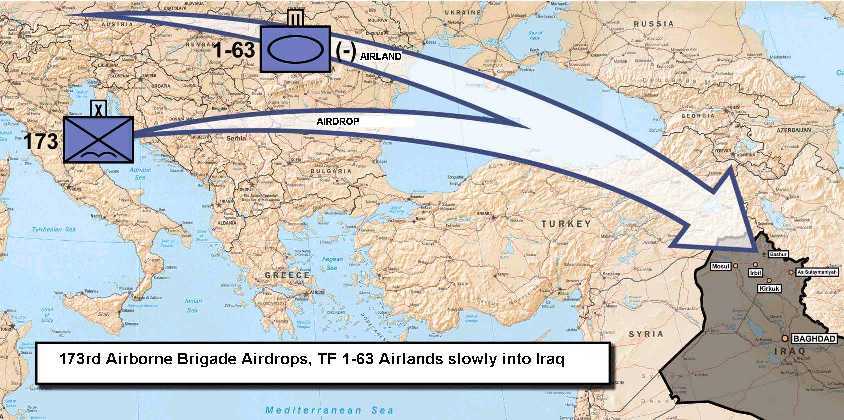
Date: 7 April 2003
Unit: IRTF 1-63 Armor
Operation: Airborne Dragon
Troopers: 1,000
Country: Northern Iraq
Dropzone: Harir Basher airfield, 45 miles northeast of Irbil in Kurdish-controlled northern Iraq
Aircraft: C-17 Globemaster IIIs
Equipment supplies: M113A3 Gavin light, M2 Bradley medium and M1 Abrams heavy tracked Armored Fighting Vehicles, M16 5.56mm assault rifles, M4 5.56mm carbines, some with M203 40mm grenade launchers, M249 Light 5.56mm and M240B Medium Machine Guns 7.62mm, .50 caliber and 40mm heavy machine guns all with night vision devices
Type Air delivery: day/night, airland
www-cgsc.army.mil/milrev/download/english/NovDec03/barclay.pdf
IRTF 1-63rd Armor, 3rd BDE, 1st Infantry Division attached to 173rd Airborne Brigade
Medium Ready Company
1st Platoon Bravo Company 2/2 IN M113A3 Gavin light AFVs
3rd Platoon Bravo Company 2/2 IN M113A3 Gavin light AFVs
Heavy Ready Company
2d Platoon Bravo Company 2/2 IN M2A2 Bradley Medium AFVs
3rd Platoon Charlie Company 1/63rd Armor Battalion M1A2 Abrams Heavy tanks
+ FSB and C4I elements
On 07 April 2003 the IRTF flew from Ramstein AFB, Germany to Bashur Airfield in Northern Iraq by 30 x C-17 Globemaster III sorties as the follow-on echelon to the 173rd Airborne Brigade which had jumped in earlier. Fanning out, the Sky Soldiers and IRTF Soldiers collapsed Iraqi resistance in the north by April 10th.
ANOTHER REPORT:
http://216.239.37.104/search?q=cache:1gdO_ut209kJ:www.afa.org/magazine/July200 3/0703mobility.html+m113+c-130+saudi+arabia&hl=en&ie=UTF-8
This is G o o g l e's cache of
www.afa.org/magazine/July2003/0703mobility.html
AIR FORCE MAGAZINE
July 2003 Vol. 86, No. 7
----------------------------------------------------------------------
Demand for airlift far exceeds supply, and senior USAF officers say it is time to expand the fleet.
The Squeeze on Air Mobility
By John A. Tirpak, Executive Editor
EXCERPT:
The Northern Front
When Turkey decided that U.S. forces could not transit its territory to invade Iraq from the north, it seemed at first that there would be no northern front to the war. A flight of 15 C-17s, however, was able to bring in 954 troops of the Army's 173rd Airborne Brigade, which parachuted into the war zone on the night of March 26. They landed and regrouped in the vicinity of Iraq's Bashur airfield, which then was taken and used as an American supply hub.
The C-17s staged out of Aviano AB, Italy, not far from Vicenza, where the Paratroopers were stationed. Flying direct from Aviano, the first five aircraft dropped equipment while the other 10 dropped Paratroopers. Flying in darkness, the C-17 pilots used night vision goggles and made use of special field lighting set up by U.S. Special Operations Forces.
The C-17s deployed another 1,200 troops to Bashur over the next few nights. On April 8, C-17s began the delivery of five U.S. Army M1A1 tanks, five Bradley fighting vehicles, 15 M113 Gavin armored personnel carriers, and 41 Humvees, along with other equipment from the 63rd Armored Regiment in Germany. The job required 27 round-trips between Ramstein AB, Germany, and Bashur. Paratroopers of the 173rd Airborne Brigade get "racked and stacked" aboard C-17s at Aviano AB, Italy, in preparation for the flight to Iraq. Nearly 1,000 of the troops went in by night, in the largest combat drop since World War II. [EDITOR: not true, since Panama in 1989].
U.S. ARMY AIRBORNE CURSED BY OWN LIGHT-ITIS HUBRIS?
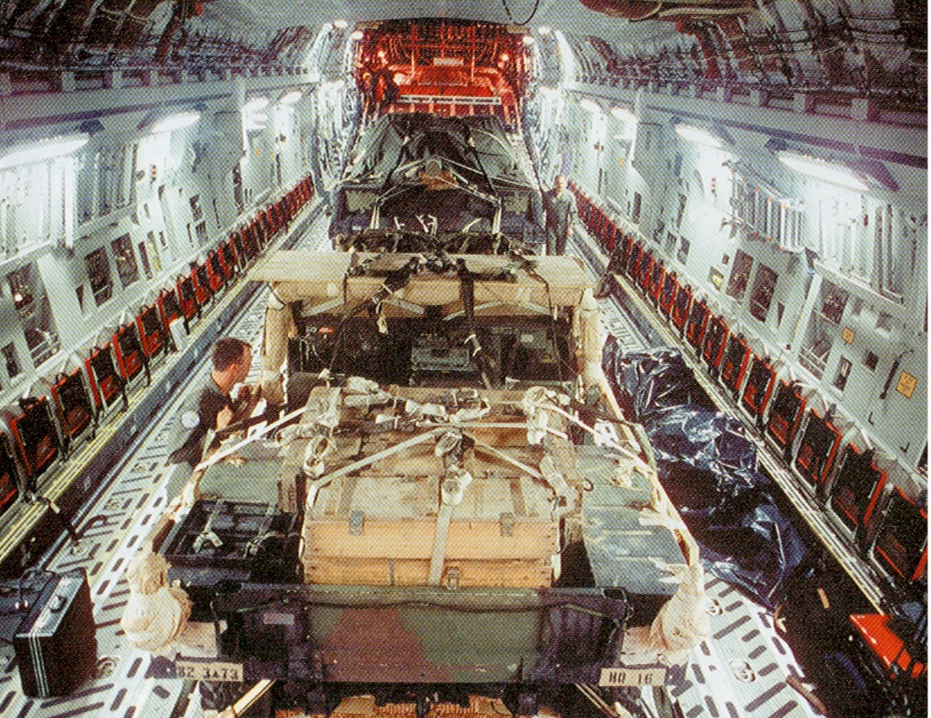
Picture above of C-17 with a M551 Sheridan light tank and HMMWV truck rigged for airdrop shows 54 sidewall seats and walkways to the side jump doors are still available, yet Airborne still inefficiently loads C-17s with either all people or all equipment, then offers the excuse that they do not have the airlift to bring tracked armored vehicles to the fight below.
Consider:
"The parachute assault force consisted of HHC, 173rd Airborne Brigade, 1st-508th Infantry (Airborne), 2nd-503rd Infantry (Airborne), 74th Long Range Surveillance Detachment, D Battery 319th Airborne Field Artillery Regiment, 173rd Combat Support Company, 501st Forward Support Company, 250th Forward Surgical Team, ODA (-), 2nd Battalion 10th SFG, 4th ASOS (USAF), and the 86th Expeditionary Contingency Response Group (-) (USAF). The Paratroopers were under the command of Colonel William C. Mayville Jr., commander of the 173rd Airborne Brigade. The chariots from which the Sky Soldiers were delivered into battle were the C-17s of the 62nd and 446th Airlift Wings from McChord AFB, Washington and the 437th Airlift Wing and 315th Reserve Airlift Wing from Charleston AFB, South Carolina. The C-17s were under the command of Colonel Robert "Dice" R. Allardice, commander of the 62rd Airlift Wing."
"A flight of of 15 C-17s, however, was able to bring in 954 troops the Army's 173rd Airborne Brigade, which parachuted into the war zone on the night of March 26."
"The C-17s staged out of Aviano AB, Italy, not far from Vicenza, where the Paratroopers were stationed. Flying direct from Aviano, the first five aircraft dropped equipment while the other 10 dropped Paratroopers."
173rd No Armor? No Excuse
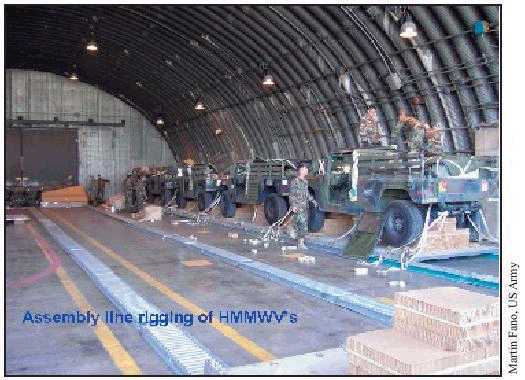
U.S. Army photo of the 173rd's BS Humvee trucks being rigged for the Northern Iraq jump
The American Airborne makes BS excuses that "it doesn't have enough airlift" to airdrop light tracked AFVs. The picture above and following details illustrates this narcissistic hypocrisy. The 173rd Airborne BDE airdropped 10 x bullshit Humvee trucks that can't move against enemy fire or fight, why not 10 x M113 Gavin light tracked AFVs that can? A C-17 can airdrop 3 Gavins; each only requires a slightly longer 20 foot Type V airdrop platform than the 16 foot one the BS Humvee truck requires.
Hypocrisy #1: Airborne doesn't exploit wide body capability of C-17s to carry light tracked AFVs along center of the floor and STILL HAVE 54 seats. Instead, they had seats for just 48 Paratroopers in the center.
They used 10 x C-17s to drop just 954 Paratroopers when the capability was there to drop 1,020 Paratroopers. Preceding them were 5 x C-17s just loaded with EQUIPMENT (BS wheeled trucks, towed artillery and supplies).
After the 15 x C-17s flew away what remained on the ground was a BS foot-immobile force with some short-range tube artillery that could not move and was only able to dig in and hope for reinforcements. It was in no position to fan out and stop Saddam or anybody from escaping the 2D maneuver push coming from the south. For all their macho crap talk, the light infantry hunkered down and cowered when it was required of them to maneuver.
Hypocrisy #2: After the C-17s dropped, they spent the next few days airlanding one-plane-at-a-time 15 x M113A3 Gavin light, 5 x M2 Bradley medium and 5 x M1 Abrams heavy tracked AFVs. The hypocrisy here is that the M113A3 Gavins can be parachute airdropped SIMULTANEOUS WITH THE EQUIPMENT THAT WAS DROPPED AND GIVEN THE 173rd PARATROOPERS ARMORED PROTECTION AND MOBILITY TO FAN OUT AND ACHIEVE OPERATIONAL OBJECTIVES NOT JUST HUNKER DOWN. We might have even gotten Saddam and many of his key subordinates BEFORE they escaped to start the bloody guerrilla war which has killed 2,600 of our men and maimed another 4,000 and wounded another 22, 000 of our people.
The best way to reveal the weakness of the current U.S. Army Airborne force structure and mentality that is prejudiced against light tracked armor is to take their worse-case 15 x C-17s available and show what could be done if light tracked AFVs were integrated.
Scenario 1: Max-out the 15 x C-17s with ground combat capability
First off, those 15 x C-17 sorties could airdrop 45 x MTVL stretched hull or regular length M113A4 Gavin light tracks on the center floor, 3 per C-17. Being stretched hull, each MTVL could transport 15 Paratroopers on the ground for a total of 675 men under full armor protection and mobility. The 45 MTVLs would be operated by the two Delta weapons Companies in the 173rd's two infantry battalions that now operate 70 vulnerable, unarmored HMMWV wheeled trucks.
Next, each of these 15 x C-17s could also air deliver 820 Paratroopers since after the MTVL light tracks leave the floor centers, the rear ramps are closed up and the left and right jump doors can open for the 54 Paratroopers sitting on the fuselage seats to jump.
It would be far better to have a force of 820 men with 675 of them armored Paratroopers with weeks worth of supplies in a mobile form that can go 1-60 mph than 954 men stuck in a wide open, exposed area with supplies stranded that cannot move faster than a 1 mph foot slog and if it starts to receive enemy small arms, mortars, artillery fire has to go-to-ground and burrow to survive.
Scenario 2: we have to take all our infantry in the first drop, maximum combat capability working around this
Let's say the 954 men the Herd dropped were the absolute, scrapping the barrel bottom of every able-bodied man in the unit and the attached specialists.
Even living within the 15 sorties as the absolute most aircraft available in one lift, if three C-17s were designated as overflow of personnel and had the 48 center seats plus the extra 6 seat section that Boeing says is possible but the complacent Airborne hasn't exploited, instead of 3 x MTVLs rigged for airdrop we would have a total of 36 x MTVLs delivered in the other C-17s which each also have 54 Paratroopers that can jump.
The 954 could easily jump (actually 972 men possible) and 36 MTVL light tracked AFVs would be heavy dropped. Once on the ground, 540 Paratroopers would then be armored and mobile with the remaining 414 (potentially 432) free to dig-in and defend the airhead WWII-style. Half the force would be free to fan out and do other missions or at the very least be a mobile reserve to extend the airhead recon & security zone beyond enemy mortar and light artillery fire ranges.
Scenario 3:
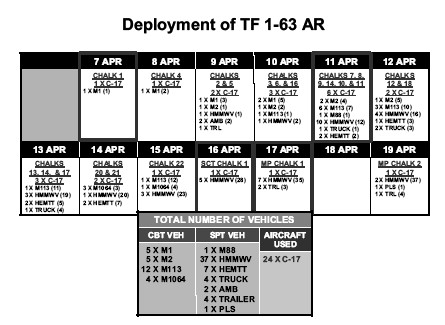
If we had a 173rd Airborne Brigade with its own M113 Gavins and M8 Buford/Thunderbolts they could have parachute dropped ON DAY ONE with 24 x C-17s:
72 Gavins or 48 Bufords or combinations.
Airlanding:
120 Gavins or 96 Buford/Thunderbolts.
I'll also work a better force package using the trickle of C-17s shown in the graphic above.
And even better---the light TAFVs would have been able to rapidly move south where the medium 33 ton M2 Bradleys and 70 ton M1 Abrams could not.
Quote:
"The route south from Taqtaq was not suitable for armored vehicle traffic, unfortunately. Several of the bridges along the route were incapable of supporting Abrams tanks. Additionally, road conditions deteriorated significantly south of Taqtaq. Unimproved mountain roads and narrow village streets greatly restricted armored vehicle mobility. This route was, however, suitable for lighter vehicles and was used by the 2rd Battalion, 503rd Infantry (2-503rd) during their attack on Kirkuk."
Source U.S. Army ARMOR magazine article:
www.knox.army.mil/center/ocoa/ArmorMag/so03/5maddox03c.pdf Scenario 4: Better 155mm towed artillery possible with light tracked AFV vehicles
Another fact lost in this Airborne-we-don't-have-the-airlift-because-we-do-not-load-our-planes-efficiently-in-order-to-provide-the-excuse-we-need-so-we-can-fight-on-foot-because-it-gratifies-our-ego hypocriticisy shuffle, is that by re-equipping our Airborne with M113 Gavin or MTVL tracks with greater 400-500 hp engines in the same volume we use to airdrop impotent 105mm towed howitzers, we can deliver full-power and 30 km+ range XM777 155mm howitzers and have the means to tow them on the ground. The Airborne Red Legs also get armor protection and cross-country mobility in a vehicle that can FIGHT BACK not just burn up as a victim HMMWV truck.
We don't know for sure yet WHAT the 5 x C-17s dropped as far as "equipment" into Northern Iraq. Knowing the defeatist hunker down mentality of the Airborne and light infantry it would not surprise us that all 8 x 105mm howitzers and 8 HMMWVs to tow them of D/319th Field Artillery gobbled up 4 C-17 sorties. This leaves one C-17 to airdrop just BS vulnerable HMMWV wheeled trucks as status symbols for the over 40 year old senior staffs to employ RHIP and not have to walk. How many HMMWVs per C-17? No more than 4 coming out of the center airdrop rails. That gives a HMMWV truck for the Brigade Commander, two for the Infantry Battalion Commanders and maybe one for the chaplain to drive around and read the last rites to our heroic Paratroopers as they die due to our own force structure stupidity.
The May 1989 Infantry Reference Data Book which spells out EXACTLY what infantry units have. I do not think the numbers have changed at all or that much.
We are not proposing ADDING light tracks to the Airborne, we are RE-EQUIPPING THEM from trucks to tracks. There is a HUGE difference between the Lightfighters CHOOSING to not deploy with their trucks and assuming they don't have any. If they deployed with ALL of their trucks they would need beaucoup amount of C-17 sorties.
For example.
My book says:
Airborne Infantry Battalion
HHC
4 x HMMWV ambulances
11 x 2.5 ton cargo capacity trucks
24 x HMMWV cargo trucks
15 x motorcycles
Delta Weapons Company
32 x HMMWV trucks (20 TOW carriers)
__________________________________
60 x HMMWV trucks
11 2.5 ton trucks
15 x motorcycles
We know motorcycles are no longer used.
Multiply this by two for the 2 infantry BNs the 173rd has.
120 x HMMWV trucks
22 x 2.5 ton cargo trucks
______________________
Then add the Airborne BDE's HHC:
19 x HMMWV trucks
3 x 2.5 ton cargo trucks
SUB-TOTAL
_________________________________
139 x HMMWV trucks
25 x 2.5 ton cargo capacity FMTV trucks
Note: this doesn't include the vehicles the Engineers, the Field Artillery, LRS and Support units in the 173rd have!
If the Airborne were honest, just to transport their BS truck force structure we know exists within the infantry BNs and BDE Headquarters in separate airplanes from the ones they are flying in, it would take 36 x C-17 sorties just to airdrop their HMMWVs, and another 11 x C-17 sorties to airdrop their 2.5 ton cargo trucks, this ON TOP OF the C-17 sorties to airdrop their roughly 1,000 people.
Non-Linear Battlefields Require FULL armor protection: tracks are 28% more capable of armor protection--and can go cross-country to avoid ambushes in the first place!
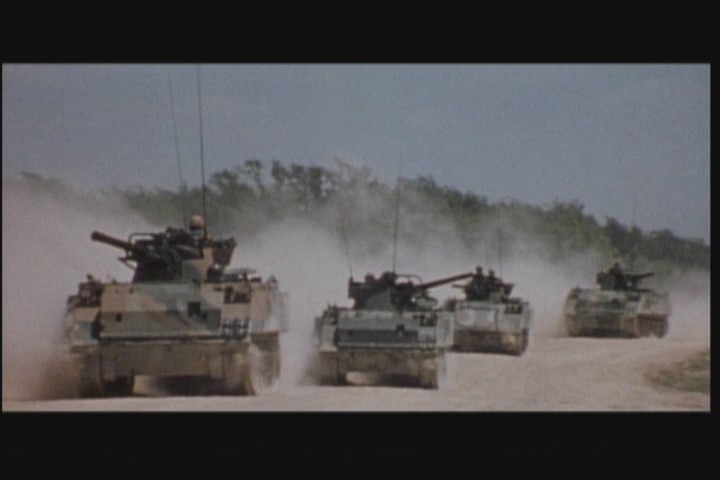
General James M. Gavin as Army Chief of Research & Development created the Airborne Armored Multi-Purpose Vehicle Family (AAM-PVF), the amazing M113 in the 1950s for maximum mobility over nuclear devastated, non-linear battlefields.
The official history of the U.S. Army for that time period says the following:
www.army.mil/cmh-pg/books/amh/AMH-26.htm
The seven divisions stationed in the United States constituted the strategic reserve. Four of these-two airborne and two infantry-were designated in 1957 the Strategic Army Corps (STRAC) and were maintained in a high state of readiness for quick deployment in event of an emergency. The other three were earmarked as STRAC reinforcements and as a training base for expansion of Army forces should the crisis become prolonged or develop into a full-scale war.With the emphasis on mobility, even the larger and heavier weapons and equipment were designed to be air-transportable.
A program to produce ground and air vehicles with the necessary battlefield mobility led to the development of armored personnel carriers, such as the M113 with aluminum armor, that could move troops rapidly to the scene of operations while providing greater protection for the individual Soldier. Since
585
highways and bridges might be damaged or destroyed, dual-capability amphibious vehicles that could travel on rough terrain and swim across rivers and swamps freed the fighting units from total dependence upon roads.
What today's planners don't realize is that what was required for a nuclear battlefield is required today with PGMs in a Surveillance Strike System (SSC) that can be as equally devastating but in a more localized way: units ON TRACKS not wheels. We need GREATER PHYSICAL mobility, firepower, protection and livability features not less regardless if tied in to a "Mother May, I?" computer network to alleviate the anxieties of senior officials.
Thus, the M113's purpose was armored, amphibious cross country mobility for LIGHT, AIRBORNE units. In 1960, America's Airborne should have been the first ones to have "air-mech" capabilities organic but the ill-conceived ROAD reorganization plan reverted back to the paratroopers foot slogging and their armored tracks went to heavy units instead. Mass-produced and inexpensive, there was and still is enough M113s to supply BOTH light and heavy units. The old saying if you don't get it right, you spend the rest of your time trying to get it right comes to mind.
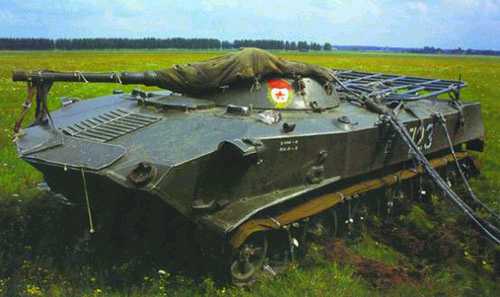
BMD-1 after parachute airdrop; note kneeling landing gear
Compare the U.S. Army to the Russian Army of today...8 years after we revolutionized ground maneuver tactics with the M113 but sat on its potential, they created their own BMD and fielded one to every paratroop squad. They are already on their 4th Generation BMD and we are still trying to get "GEN I" M113 Gavins IN light units. What a disgrace to the memory of our great Airborne leaders, Gavin, Lee, Ridgway, Yarborough, Hackworth, Moore that we are not having American Light and especially Airborne forces---live up to their full potential.
U.S. Army TALKING about Light Units with M113 Gavin tracked armor (still after almost 5 decades of using them on & off)
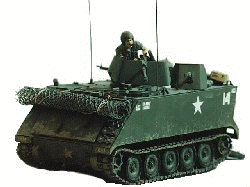
U.S. Airborne/Light units would be lucky just to have M113 Gavins with machine guns, much less autocannon...this wasn't always the case...the 82nd Airborne actually had M551 Sheridans and M113 Gavin light tanks in the 3rd Battalion, 73rd Armor until 1997.
VIDEO: How the U.S. Army Airborne should Power Project by Parachute Airdrop
www.combatreform.org/USARMYAIRBORNEpowerprojection.wmv
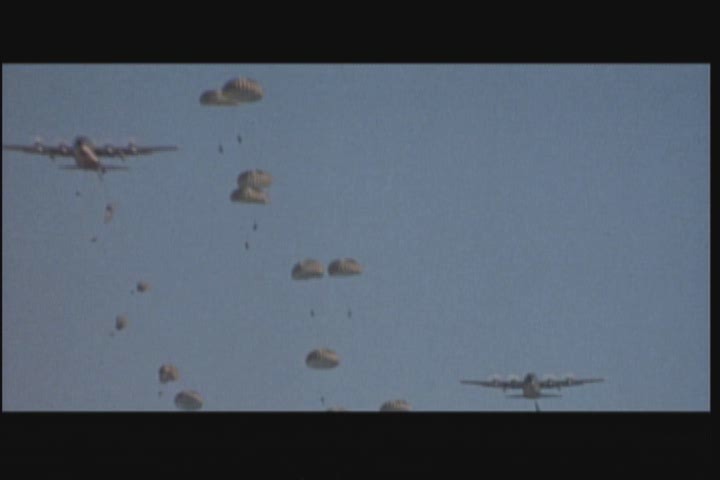
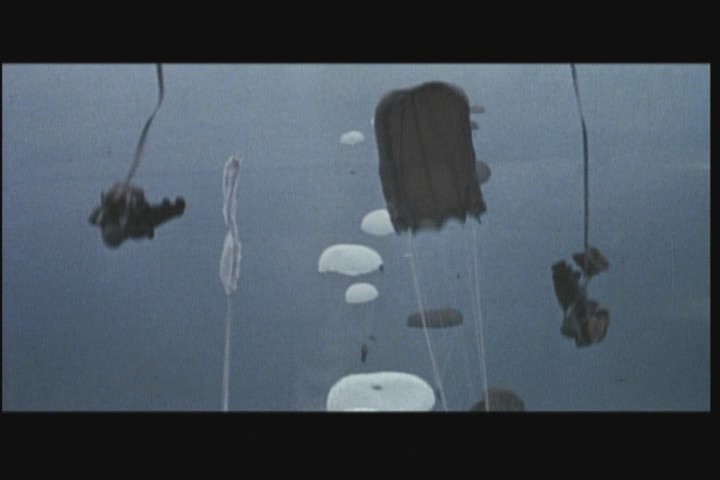
LAPES = Low Altitude Parachute Extraction from 5-10 feet
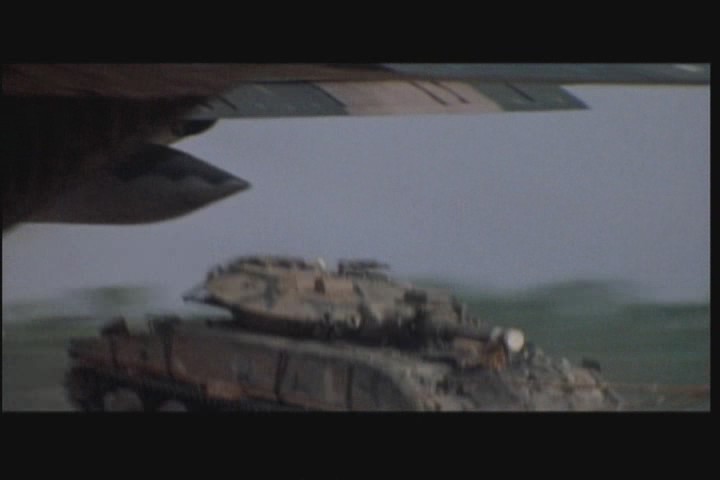
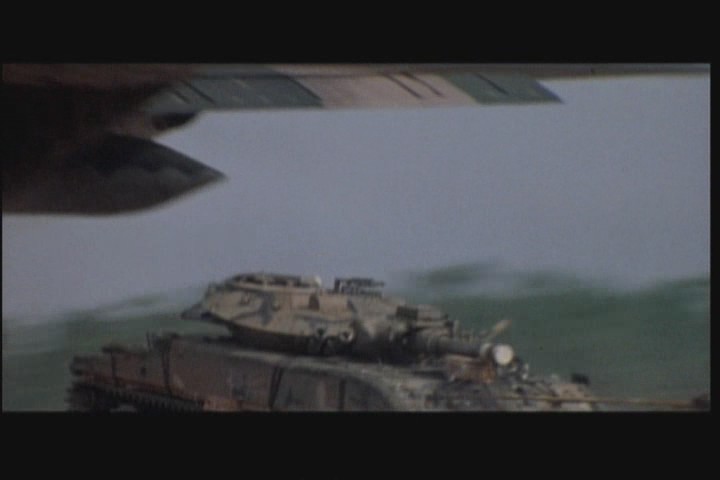
LVAD = Low Velocity Air Drop from 600-1200 feet
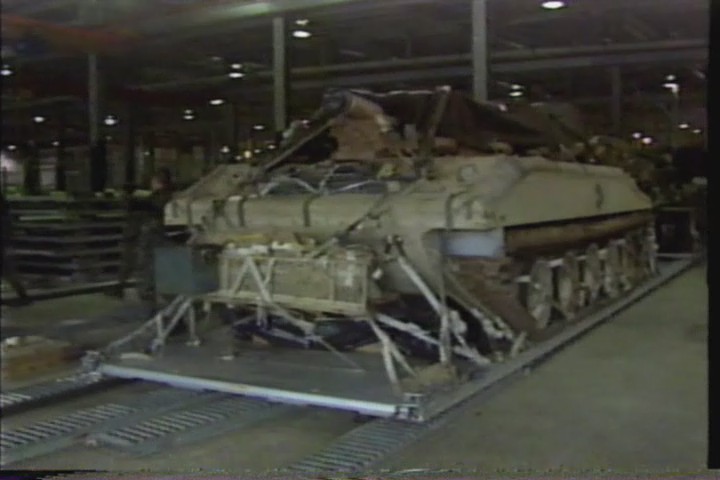

Picture above of C-17 interior with a M551 Sheridan light tank and HMMWV truck rigged for low velocity airdrop shows 54 sidewall seats and walkways to the side jump doors are still available; yet Airborne still inefficiently loads C-17s with either all people or all equipment, then offers the lame excuse that "they do not have the airlift" to bring tracked armored vehicles to the fight below. How convenient. Current "can't-do" U.S. Airborne is a disgrace to the CAN-DO spirit of all the Paratroopers who have gone before us and created the American Airborne in the first place.
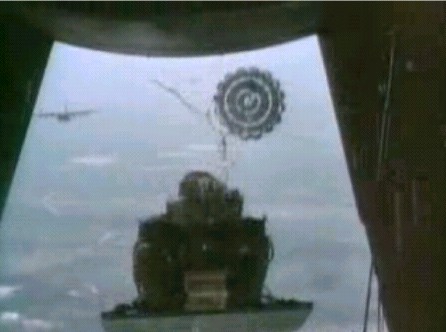
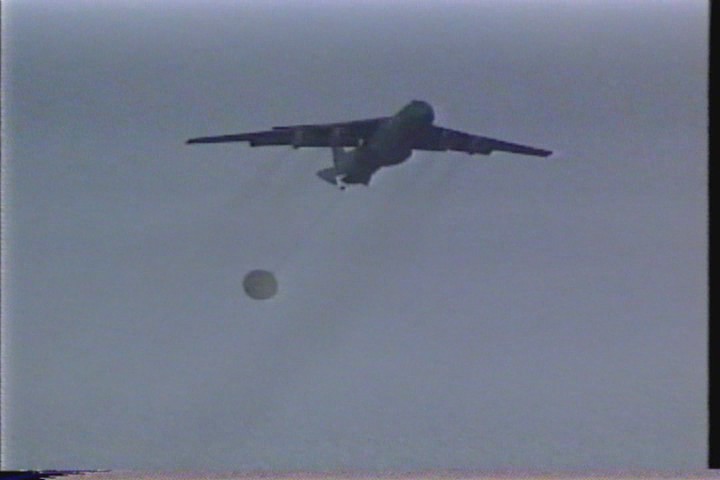
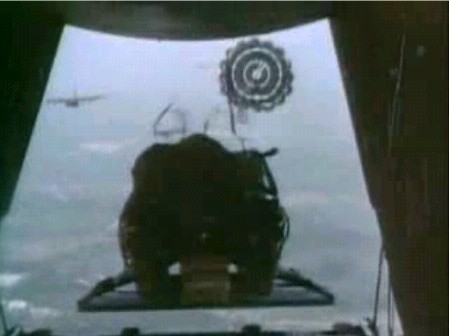
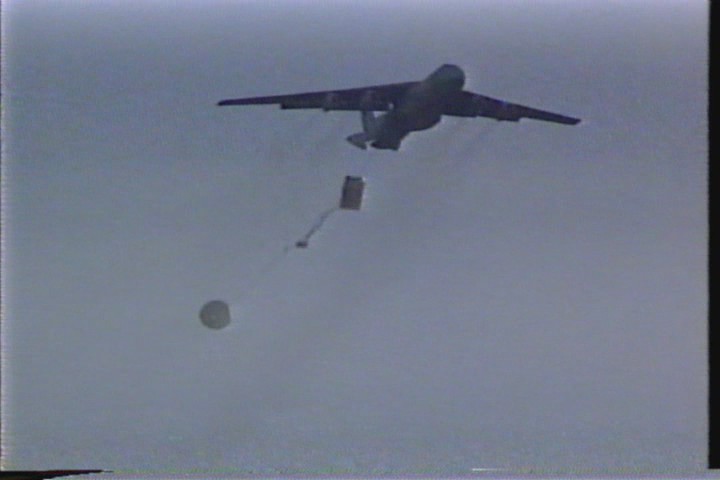
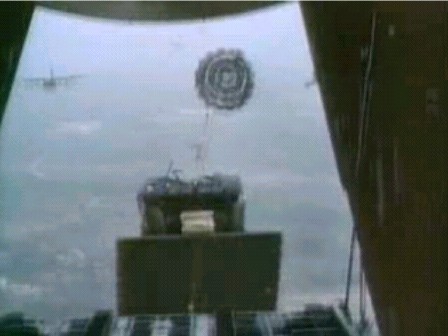
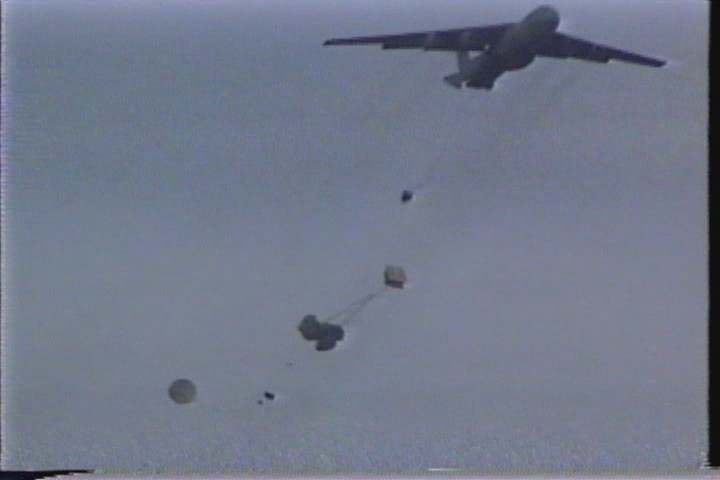
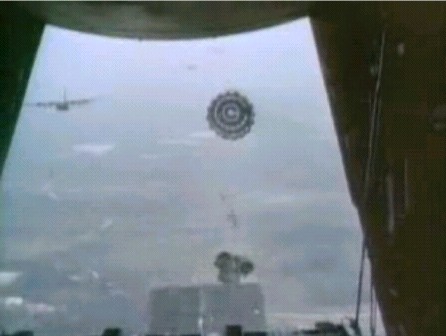
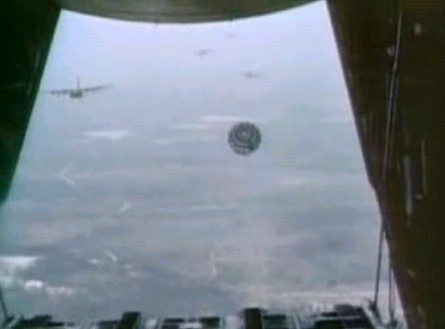
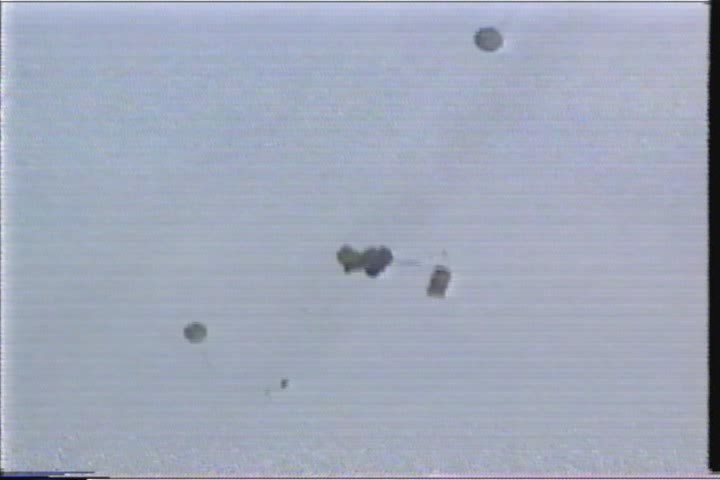
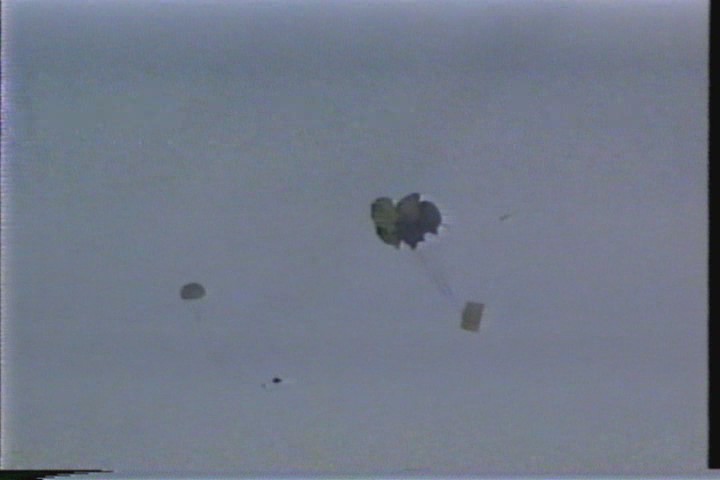
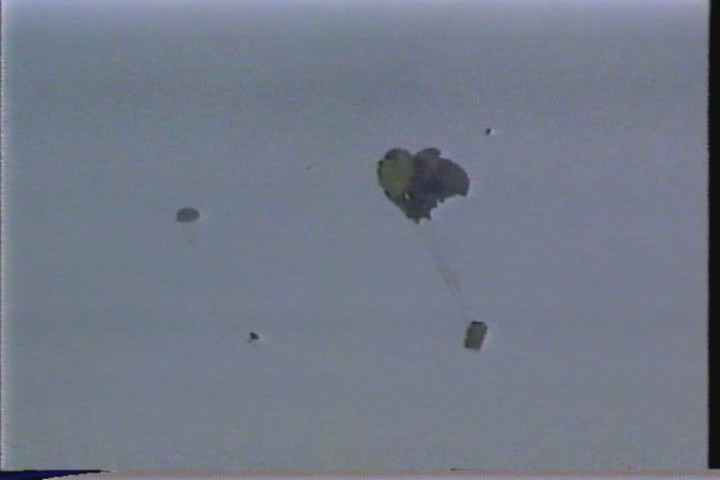
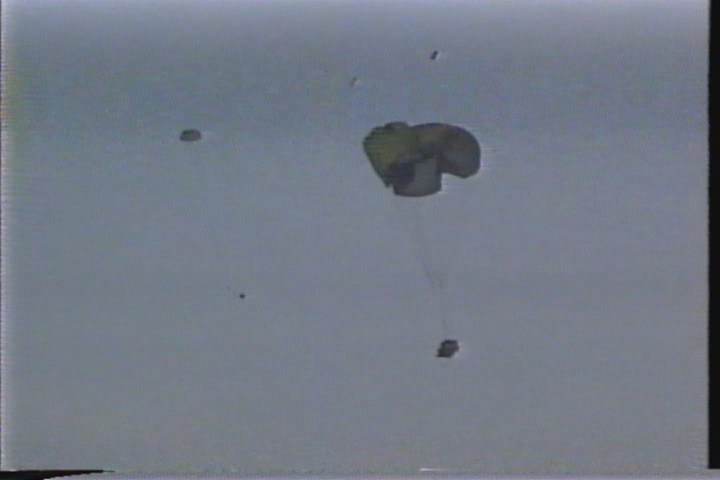
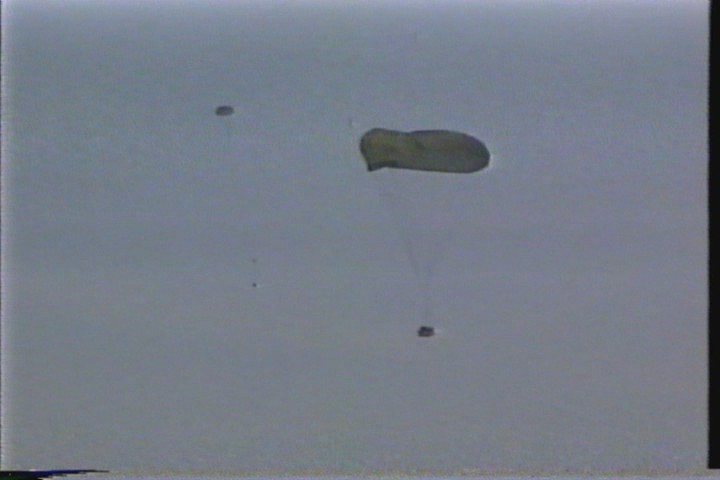
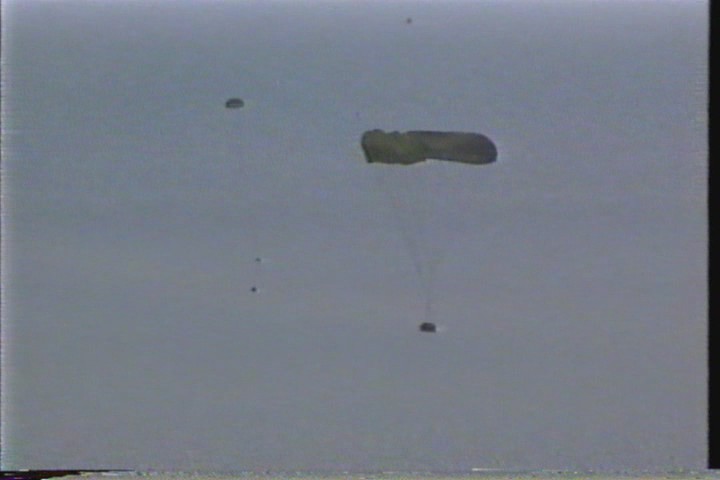
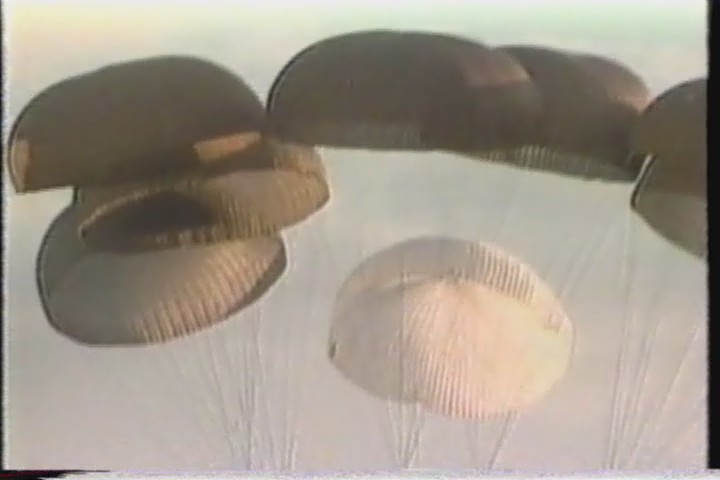
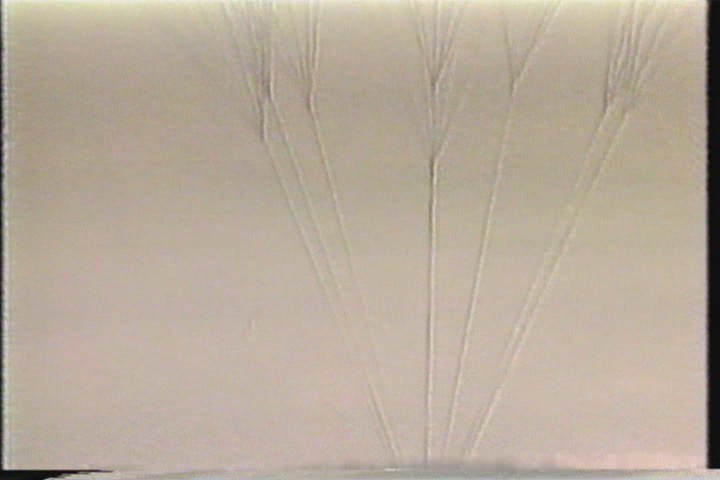
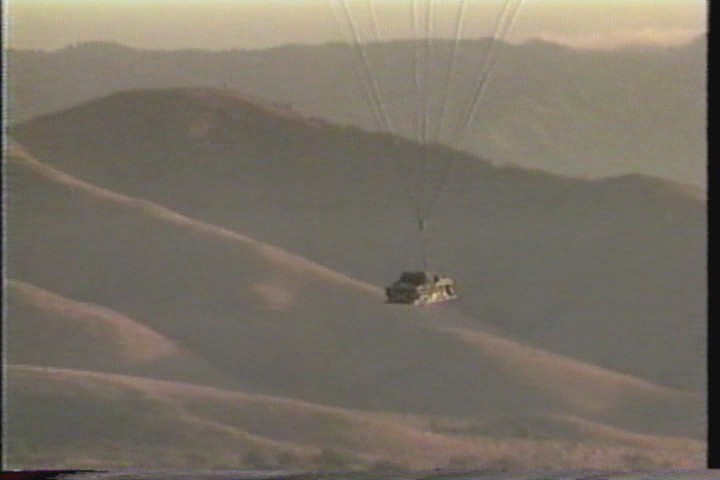
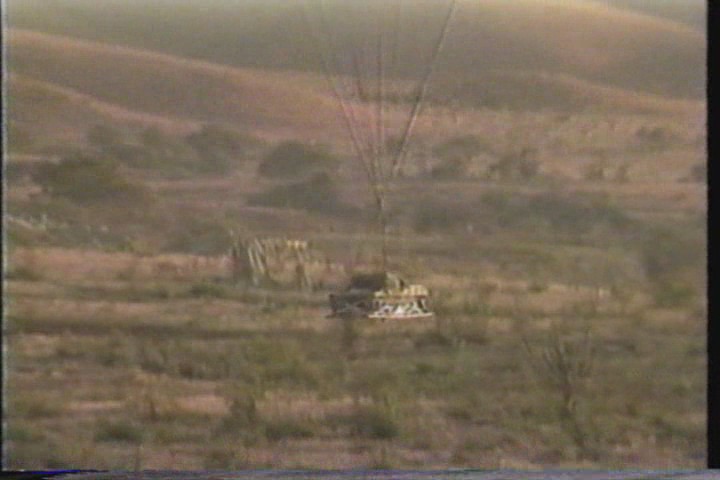
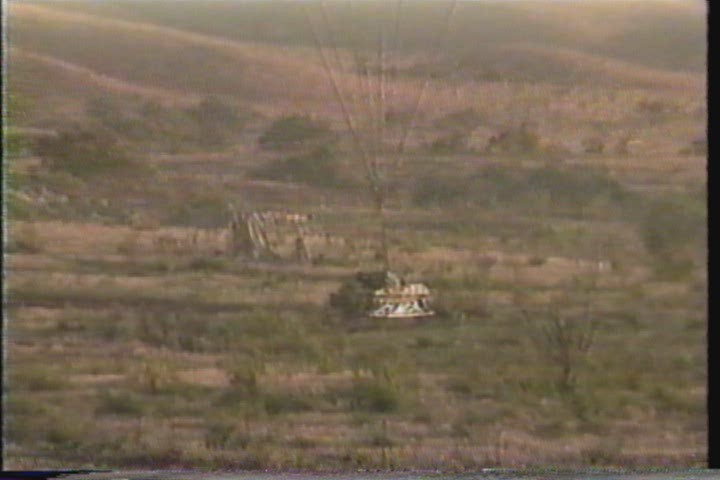
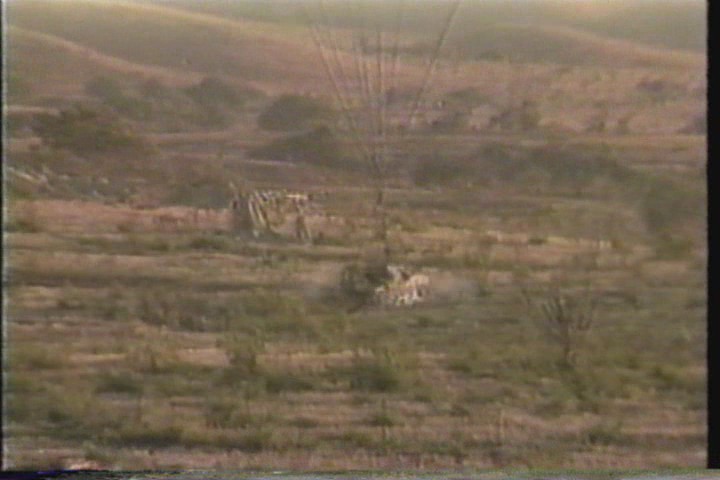
 www.youtube.com/watch?v=BcSwXW49J_I
www.youtube.com/watch?v=BcSwXW49J_I
Here's the 82nd Airborne's post OIF AAR (from the CALL Website):
MANEUVER
--------------------------------------------------------------------------
LESSON LEARNED 1: Lack of lethality/firepower by Airborne Infantry in Urban Terrain.
DISCUSSION: Recent combat operations in As Samawah and Ad Diwaniyah during Operation IRAQI FREEDOM highlighted the need for increased lethality and firepower in the current airborne infantry brigade structure, while operating in urban terrain. The DA decision to eliminate the divisional armor battalion, in favor of employing the Immediate Ready Company concept (IRC) [EDITOR: which can only AIRLAND after an airfield is seized and cannot parachute drop with the 82nd Airborne Paratroops], while waiting for the Army to identify and field an air-deliverable armored gun system (AGS) left the airborne brigade woefully in need of increased lethality and firepower. Frequently during these recent operations, airborne forces would move in advance of heavy forces (TF 1-41 IN) to isolate an objective area while the heavy force postured for action at the decisive point in the fight. Heavy forces delivered the firepower that rapidly and decisively terminated the conflict. An airborne infantry brigade, with an organic AGS capability would enable it to quickly and decisively defeat an enemy in an urban environment without having to depend on heavy force augmentation. [EDITOR: if the closed terrain cannot facilitate medium to heavy tanks, these forces are off doing something else, they can't get there at all in a timely manner etc.]
RECOMMENDATION: Modify the Airborne Division MTOE to include a battalion of air deliverable armored gun systems (AGS). The armored gun system must meet the requirements of being air transportable by C130 and air droppable by G-11 cargo parachute, must be capable of providing accurate and lethal fires, and must be survivable in an urban environment against small arms and RPG type weapons.
LESSON LEARNED 2: Inadequate Mobility of Airborne Infantry.
DISCUSSION: Recent light/heavy operations in Central Iraq during Operation IRAQI FREEDOM highlighted the lack of mobility of the airborne infantry brigade operating in unrestricted desert terrain. Frequently, airborne forces would LD well in advance of the heavy forces to isolate an objective area while the heavy force postured for action at the decisive point in the fight. The heavy forces provided the firepower to terminate the conflict rapidly and decisively, but it would constantly outpace the airborne infantry forces forward in subsequent tactical sets.
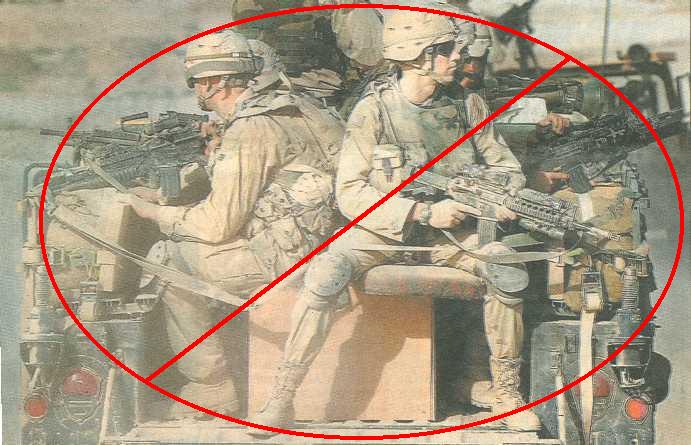
 www.youtube.com/watch?v=DMp7iEtc_i0
www.youtube.com/watch?v=DMp7iEtc_i0
To maintain tactical pace with the heavy forces, both organic and task organized truck assets had to be reallocated from the FSB and DIV MSB, as well as, inorganic truck assets from 1st COSCOM and PREPO stocks to support mobility requirements for the current and future fight. The reallocation of organic transportation assets also complicated logistical resupply and forward positioning of BDE and higher command posts. [EDITOR: wheeled trucks cannot go forward in combat in the face of enemy fire]
The addition of four mounted platforms per platoon would greatly enhance the airborne infantry platoon's mobility. Four per rifle squad and one per weapons squad (two of which are outfitted for PL and PSG C2 nodes) with .50 caliber machine guns and/or MK-19s would substantially enhance the rifle platoon's mobility and firepower, and allow it to be much more effective while operating independently or in conjunction with heavy forces. These platforms would deploy as part of the Charlie Echelon and employed after seizure of an airfield and establishment of a lodgment. [EDITOR: violently disagree; "C" echelon is too late. Time for American Airborne to start maneuvering immediately after landing on the drop zone] Additionally, these mobile platforms would greatly relieve the strain on precious logistical assets required to move and sustain airborne infantry units.
RECOMMENDATION: Modify the MTOE of the airborne infantry platoons to equip them with organic assets (four each 2 w/ .50 caliber MGs and 2 w/ MK-19s) that provide mobility, firepower, and ability to conduct non-standard CASEVAC.
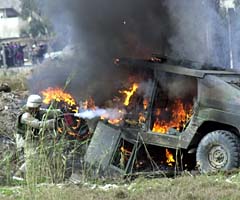
[EDITOR: M113 Gavins should be the mounted platforms since they are tracked and armored to keep the paratroops alive while moving forward with the M8 AGSes. Paratroops in wheeled Humvee trucks are just going to go up in flames and die from nearly any enemy fire as daily tragedies in Iraq prove. M113 Gavins should be in the "Delta" weapons company and be used as needed to give A, B, C mobility as needed. However, providing A, B, C M113 Gavins can also work, too but we better not hear of any whining from them that they have to spend half a day each week in the motor pool and its going to somehow make their penises shrivel up]
www.stormingmedia.us/46/4652/A465262.html
Light Infantry, Augmentation, and the M113A3 Armored Personnel Carrier: A Step in the Direction of Versatility
Authors: William K. Sutey; ARMY COMMAND AND GENERAL STAFF COLL FORT LEAVENWORTH KS SCHOOL OF ADVANCED MILITARY STUDIES
Abstract: This paper examines a proposal to create M113 Armored Personnel Carrier support units (vehicles, drivers, and service support) to provide protected tactical mobility augmentation for light infantry forces. Light infantry divisions are a crucial component of the Army's force structure to meet potential challenges across the spectrum of conflict. They lack, however, the tactical mobility assets to be of any utility beyond the lowest intensity conflicts in the most restrictive terrain. This limitation constrains the Army's versatility as a whole. This monograph first considers tactical mobility as an element of combat power, establishes an analytical framework for the analysis of the infantry mobility systems, and considers the heavily armed and mobile nature of potential world threats. Next, the light infantry concept is explored focusing on the intended purposes for which light infantry divisions were formed and an evaluation of their actual tactical mobility capabilities. Following this examination of today's light infantry, this paper looks at the Pentomic Era in the late 1950's in which M59 armored personnel carrier companies were consolidated at division level and sent vehicles as attachments to augment the tactical mobility of infantry units. Finally, this monograph conceptually outlines a proposal to use M113 APC's to augment deployed light forces and evaluates how this might enhance their utility. Although there are philosophical objections to, and practical problems with, augmenting light infantry with armored personnel carriers, this paper concludes that today's demands for maximizing the versatility of all forces merits reexamination of such a concept.
BREAKING NEWS!
Plain old "Gavin" M113 is ranked #1 by Top 10 IFV show
 http://uk.youtube.com/watch?v=CdOO1fCAOBE
http://uk.youtube.com/watch?v=CdOO1fCAOBE
Russian Airborne FIELDING BMD-4 tracked armor with 100mm guns
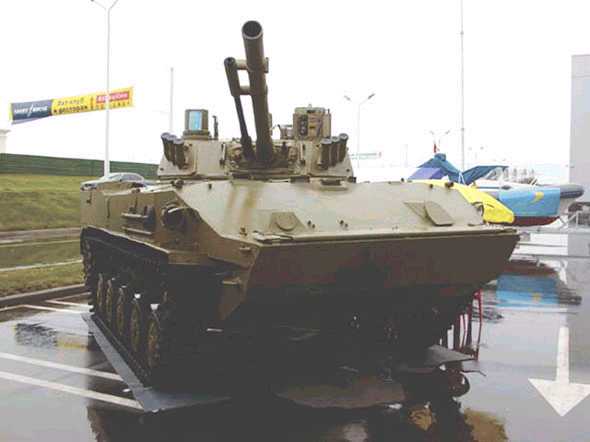
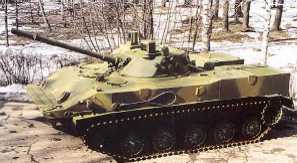
BMD-4 uses an improved versionm of the powerful 100mm main gun, 30mm autocannon, 7.62mm medium machine gun turret first fielded with the BMD-3M shown above
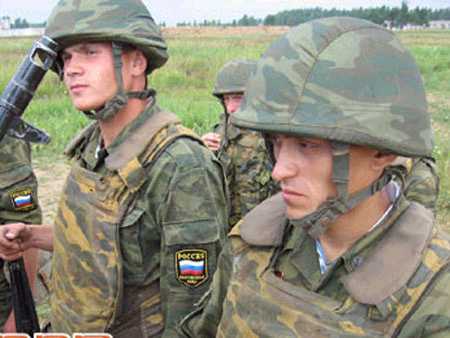
The Russian Paratroop crew of the BMD-4 ride INSIDE it during airdrop to save time de-rigging and getting it in action on the ground. Dismount paratroop infantry squad jumps out in FRONT of the IL-76 jet's engines SIMULTANEOUSLY with their mother BMD-4 exiting the rear ramp in order to land closer together. Their D-8 parachutes deploy only a stabilizer chute upon aircraft exit in order to jump in front of jet engine; U.S. old-fashioned static line and deployment bags leave a tangled mess streaming outside the plane as paratroopers exit.
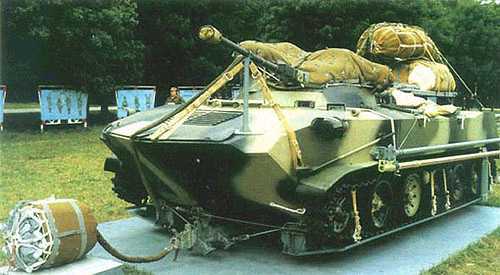
Note the minimalist approach to getting the BMD-4 to slide out the floor of cargo planes; runners under the tracks conserves weight and payload of the plane compared to the U.S. Type V aircrop platforms that each take up about 2, 000 pounds of payload and are a pain to recover on the drop zone for re-use.
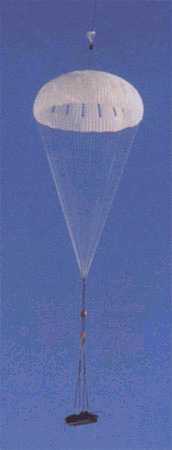
The BMD-4 under canopy
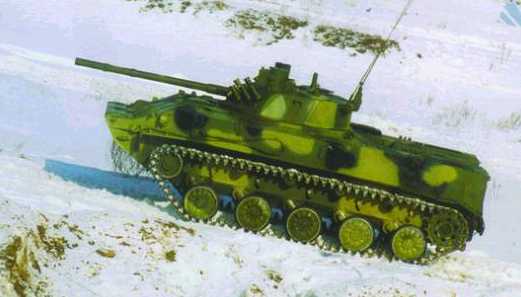
The BMD-4 has low ground pressure cross-country mobility like the M113 Gavin first pioneered
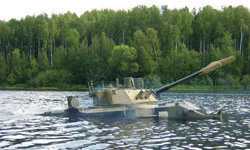
The BMD-4 has waterjets to swim in the ocean like the M113 "Amphigavin" with the ARIS GATOR kit
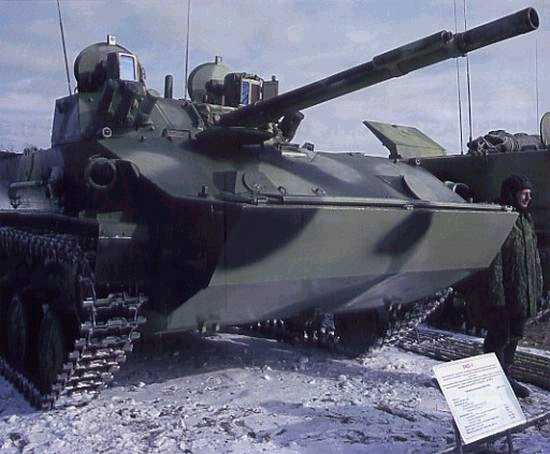
The BMD-4 has stabilized optics and gun mounts to shoot-on-the-move; a capability our M113 Gavins could have if they were OWNED BY LIGHT/AIRBORNE/AIR ASSAULT UNITS and improved on by ownership; ad hoc temporary load of M113s to units will not result in their full potential being achieved...and could result in the enemy killing a lot of Americans in battle because we chose to be inferior.
http://en.rian.ru/russia/20060616/49637256.html
New combat vehicles on way to Russian airborne units
19:24 | 16/ 06/ 2006
MOSCOW, June 16 (RIA Novosti) - Russia's Airborne Forces will receive the first batch of a new armored airborne combat vehicle on June 21, an army spokesman said Friday.
The BMD-4 airborne combat vehicle is amphibious, light and well armed. Like its predecessor, BMD-3, it has a hull made of special alloys and a turret, but features many modifications. In addition, it is equipped with a 100-mm gun.
"The start of deliveries of the BMD-4 marks a new era in the development of the Airborne Forces and will significantly raise the combat strength of Russia's most mobile units," Alexander Cherednik said.
The vehicle will be shown off during an exercise on June 26 that senior officers are expected to attend.
Legendary Tanker Ralph Zumbro asks the question:
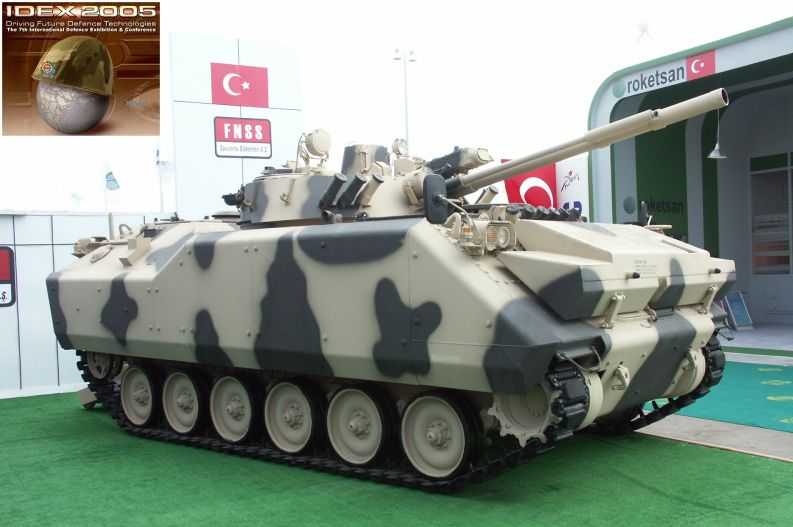
Nurol of Turkey has a M113-based AIFV with a BMD-3 type turret
"Gents;
That turret sounds like a development of the BMP-3 turret which at lease one ex Russian/Soviet country has adapted to the M-113. Maybe we ought to just BUY them and adapt them to our vehicle????"
Ralph
SO WHY ARE WE TRAVELING IN VULNERABLE TRUCKS DOWN ROADS INTO PREDICTABLE AMBUSHES?
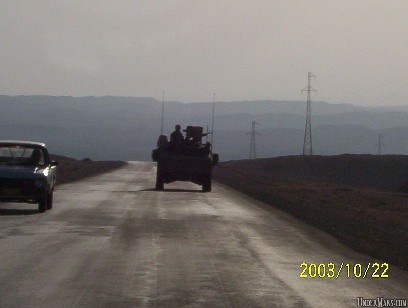
The Army wheeled narcissist lie exposed: Video Proof that steel tracks can go 60+ mph on paved roads
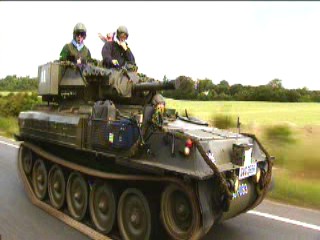
This should end the "Stryker and Humvee 60 mph on roads" non-sense forever. Take the governors off our tracks and they can go as fast as you want them. There is NO reason to have or use rubber-tired trucks on the non-linear battlefields of today...they need to go the way of the horse cavalry.
Edited Clip
www.combatreform.org/steeltrackscango60mphonpavedroads.wmv
Full Clip with an excellent short History of Tanks
www.pioneertv.com/video/tanks900.wmv
Recent Productions
http://72.14.207.104/search?q=cache:FFlc_wMMrHAJ:www.pioneertv.com/recent.asp+tycoon+toys+national+geographic&hl=en&ie=UTF-8
Tycoon Toys
(2 x 60' for National Geographic Channel/Freemantle International Distribution) are what the super-rich choose to spend their hard-won zillions on. We meet the few individuals who have a particular penchant for owning, driving and firing huge pieces of ex-military hardware, from field guns to tanks to fighter jets. Tycoon Toys goes on a journey to watch them at play. 2004 - Distributed by: Freemantle International Distribution
3D maneuver requires light tracked AFVs
By the time 1st Infantry Division "Big Red One" Soldiers in M1 Abrams heavy, M2 Bradley and M113 Gavin light tanks slowly airlanded by C-17 into Northern Iraq, Saddam and cohorts were already in hiding in Tikrit. USMC foot-infantry egomaniacs doing feel-good methodical battle but clobbered by mere rear guards while dismounting from vulnerable trucks were 6 days late reaching Baghdad and also contributed to the mission failure. While pompously boasting they believe in "Maneuver Warfare" the USMC shows no understanding of the operational art to rapidly seize nation-state centers of gravity (grab the capital city) to collapse an opponent (3rd Generation Warfare) which would require them to fix their force structure and stop packing our amphibious ships with hundreds of wheeled trucks when they can and should be filled with light tracked tanks. Had the U.S. Army 173rd Airborne Brigade been properly equipped with their own M113 Gavin and M8 Buford/Thunderbolt light tanks they could have parachute dropped their entire force and within hours fanned out into blocking positions to deny Saddam's Ba'athist Regime cohorts to escape to start a rebellion later. Instead the egomaniac Army Airborne did the "seize & hold" BS WW2 re-enactment it likes to do and "held the airfield" so "follow-on forces" could airland. Airborne WARFARE is not airfield (logistics base) seizure and sitting on your ass and digging in WW2-style. Even in WW2, the Airborne was made to MANEUVER after parachute insertion. To do this well, they need their own light tanks and not sit and wait for someone else to do their job for them as the enemy escapes. After the war, General James M. Gavin as Army R & D Chief realized this and created the Airborne Armored Multi-Purpose Vehicle Family which became the M113, named years later in his honor. Light tanks can do things that medium and heavy tanks cannot do over and above the obvious air-insertion capability: they have the absolute best cross-country mobility we have to go through closed terrains to include swimming across shores, lakes and rivers. A professional LIGHT infantry should want the LIGHT tracked tanks it needs to do its job well and stay off the roads/trails as it preaches but does not practice when it rides around in wheeled trucks so they can say they do not look like the "death-before-dismount, mech pussies" in tracks. Because the light infantry rightfully detest the heavy Soldier's laziness and reluctance to dismount when necessary, they wrongly dismiss in their minds the desirability of using LIGHT tracks to do their missions dramatically better just because they might LOOK LIKE the Soldiers they look down on.
500 deaths and 10,000 wounded men later we finally got Saddam--not the way you want to wage 4th Generation War (4GW) on today's non-linear battlefield (NLB). If we want to get fleeing bad guys we need effective 3D maneuver that gets there quick by parachute and helicopters. M8 Buford AGS light tanks should have dropped in with infantry in M113A3 Gavins and fanned out within minutes to block Saddam's escape routes instead of the slow airland build-up that took place. Why didn't the 173rd Airborne Brigade have its own M113 Gavin light tanks to airdrop instead of the slow airlanding operation?
To its everlasting credit, the U.S. Army XVIII Airborne Corps is beginning to realize this and take action to regain what was lost when their M551 Sheridan light tanks were wrongly taken away when the "Heavy Mafia" was running the Army.
Inside The Army
March 15, 2004
Pg. 1
Army To Transfer Four Armored Gun Systems To 82nd Airborne DivisionRETHINKING AIRBORNE AND AMPHIBIOUS OPERATIONS FOR THE 21st CENTURY: Could we even do D-Day today?The Army last week approved the transfer of four M8 Armored Gun Systems from contractor storage facilities to the 82nd Airborne Division at Ft. Bragg, NC, sources say, marking the first time the vehicles will be used by the service since the program was terminated in 1996.
Proposed in the 1980s as a lightweight combat vehicle that could fit aboard a C-130, the AGS was canceled as the Army struggled to pay for "other priorities". Contractor United Defense LP, which fought the cancellation decision, has five M8 AGS vehicles in stock -- four in York, PA, and one in San Jose, CA.
The 18th Airborne Corps at Ft. Bragg recently passed along an "operational needs statement" to Army Forces Command that spells out the division's need for a rapidly deployable vehicle with firepower that could be dropped from an aircraft (Inside the Army, Feb. 16, p1). The Army's operations and plans office, or "G-3," has been reviewing the requirement with Training and Doctrine Command.
TRADOC completed its analysis on Feb. 19, and the G-3 approved the needs statement on March 8, authorizing transfer of the existing vehicles to the 82nd Airborne Division, sources say. By press time (March 11), the Army had not released a copy of the approval documents.
According to one source, officials made it clear in the documents that the transfer in "no way should be construed as support for an AGS program." Instead, it is an attempt to meet the immediate requirement with an interim solution and allow the division to begin developing and refining tactics, techniques and procedures.
The unit expects to receive the vehicles by the end of March, the source said.
Rep. Robin Hayes (R-NC), a member of the House Armed Services Committee whose district includes Ft. Bragg, said he is pleased with the decision, but does not want the transfer to be misconstrued as a move to revive the terminated program.
"To be clear, I am not endorsing one system over another," Hayes told ITA in a March 12 statement. "I simply believe that, if these existing AGS are combat-worthy, then they should be fully utilized while we await the future technologies that are already in production."
"My priority on this matter is simple -- what can we do to help our Soldiers in the field the fastest?" he added. "If our Soldiers can utilize these existing systems, then I want these systems in Baghdad rather than in a manufacturing facility in Pennsylvania."
Hayes asked the Army last December to provide him information on the matter, including how much the transfer would cost and whether spare parts are available to maintain the gun systems. Last week, a spokesman for Hayes said the congressman was told government and contractor costs are estimated at approximately $1 million for one year of support for AGS.
The funding, however, is not as much of a concern to the Army as the availability of parts for a system that was terminated eight years ago. Sources say UDLP can sustain the systems for a limited amount of time, but many of its components are now obsolete or unavailable. Supporting the system beyond one year poses high risk, sources said.
Herb Muktarian, a spokesman for UDLP's ground systems division in York, said the systems are ready-to-go.
"We have not received any official requests from the Army regarding AGS, but the four AGS vehicles stored in York remain in excellent condition and we're ready to provide support if asked to do so," Muktarian said.
Maj. Rich Patterson, a spokesman for the 18th Airborne Corps, said officials at Ft. Bragg have been notified and are assembling the necessary manning documents, additional equipment and training plans, "with the intent to integrate the AGS into division operations as soon as possible."
The vehicles will go to the 1st Battalion of the division's 17th Cavalry Squadron, Patterson said. AGS will provide its assault teams "mobility, firepower and shock effects" within the "drop zone," he added.
"It gives us a capability we could deploy if we need it," Patterson said.
AGS features a 105mm cannon, an ammunition autoloader and options for armor protection.
The division's requirement for an air-droppable platform has existed at least since the 1990s, when the division disbanded one of its battalions -- the 3rd Battalion of the 73rd Armored Regiment, which was equipped with an aging armored reconnaissance vehicle called the Sheridan. At the time, service officials thought other capabilities would become available to the Paratroopers once the M551 Sheridan was retired.
When the division deactivated the armored battalion in 1997, however, then-Army Chief of Staff Gen. Dennis Reimer [EDITOR: under pressure from the "Heavy Mafia"] had already terminated AGS, which had been regarded as the Sheridan's replacement. Eliminating AGS freed more than $1 billion over the service's outyear funding plan -- money that was badly needed for "other" cash-strapped programs, officials said at the time.
Two years after the program was canceled, service officials said they continued to review options for all light forces that wanted more firepower. Vehicles reviewed included AGS, the marine corps' Light Armored Vehicle, the Pandur lightweight vehicles used by the Kuwait National Guard and a variant of the M113 Gavin armored personnel carrier (ITA, Oct. 4, 1999, p1; Sept. 27, 1999, p1).
That effort, however, went nowhere, and the 82nd Airborne Division resubmitted its request for such a vehicle, eventually attracting Hayes' attention.
"Let's find out as soon as possible if AGS can serve effectively as a short-term solution for an immediate operational need," Hayes told ITA last week.
-- Anne Plummer
Landing 125,000 troops into Normandy on D-Day, June 6, 1944 was a STRATEGIC OPERATIONAL MANEUVER that brought an end to the nation-state regime of Adolph Hitler in WWII. As we celebrate the men who changed the world on the event's 60th anniversary, we need to ask ourselves if we are equal today to the same task?
25,000 Paratrooopers/glidermen were delivered by 3D maneuver using 2,000 C-47 twin-engined transports each able to carry 20 men or tow 1 glider @ 200 mph. Today, the U.S. military has but 500 C-130 aircraft that can carry roughly 60 men @ 300 mph. If we scraped up every single C-130 in the U.S. military, we might be able to duplicate what the "Greatest Generation" did on D-Day--if we had enough Paratroopers--which we do not. In WWII, we had 5 DIVISIONS of Paratroopers/glidermen (100,000 men), today we have less than 5 BRIGADES or under 10,000 actual "trigger-puller" airborne infantrymen.
Following the Paratroopers on D-Day, were roughly 100,000 men in water landing craft to effect 2D maneuver. If we pooled together ALL of the water landing craft in the Army and Navy we could only deliver 1 division's worth of marines or Army troops ashore, or 10,000 men.
The sad truth is that we couldn't right now do "D-Day" because we have a peacetime garrison military that is not at war. If we put the same amount of effort into building the 10,000 twin-engined C-47s that were built into 4-engined C-130s, assuming a 2-for-1 difficulty exchange, we'd have 5,000 x C-130s. But we do not. We have only 500, C-130s and most of them were built over 20 years ago during the height of the Cold War production duels with the Soviets. America has not been at war over the last 20 years and mass-producing any war weapons, and has atrophied into a state of unreadiness where we can't do a D-Day.
Some may say, "we will never need to do a D-Day again".
Rethink this again.
American needed "D-Day" on 9/12 2001 when Paratroopers should have dropped en masse along the Afghanistan-Pakistan border to prevent terrorist leader Osama Bin Laden from escaping.
It didn't happen.
America needed "D-Day"---regardless of whether it was right to invade Iraq or not---right after "Shock and Awe" airstrikes failed to get ANY Iraqi leaders, thousands of Paratroopers should have descended upon Saddam and his minion's escape routes into Northern Iraq to prevent the bloody guerrilla war which so far has killed over 800 Americans and grievously wounded another 4,000.
It didn't happen.
We did drop the one gallant Airborne Brigade we had from nearby Italy and then slowly flew in tracked armored fighting vehicles (TAFVs) by landing aircraft one-at-a-time, and Saddam and his loyalists were able to escape to start the insurgency. Without actual, PHYSICAL overwhelming ground maneuver forces no amount of mentally directed firepower will suffice to kill/capture cunning enemies hiding in a still very large planet earth.
The earth is still a very large place and to control it requires large amount of military force: STRATEGIC OPERATIONAL MANEUVER--like on D-Day---and what we lack today to win the war against sub-national terrorists hiding from our sensors and aircraft bombing amongst difficult terrains and civilian populations.
Some apologists will state that our C-130s are so much qualitatively better than the C-47s that our lack of force size is somehow offset. While flying only 100 mph faster and indeed with GPS able to drop its Paratroopers exactly where they need to be, the C-130 is only able to deliver 3 times the troops at 100 times the cost such that we only have 1/100th the amount of airlift (ability to move forces in three dimensions) that we once had in WWII! The one huge advantage today's C-130s have over C-47s; a high-t-tail and rear ramp to airdrop light tanks/armored personnel carriers has NOT been fully exploited to date.
What's Needed to do D-Day Today
In today's media world, surprise is fleeting--if we want to get Bin Ladens before they can escape we must be able to do D-Days at a drop-of-the-hat. Since we do not have the size like we once had in WWII, we truly have to be at least 10 times better than the enemies we are fighting. We do not want to fight the enemy "even" our men with M16 rifles in their hands riding around in infamous vulnerable HMMWV trucks versus theirs with AK47s, RPGs in their hands and roadside bombs ready to explode at a touch of a cell phone button. The American or enemy Soldier can both carry 50 pounds of food, ammo, water on their bodies and move at best 5 mph. We need to do 10 times better than this on D-Day. Instead of dropping 60 Paratroopers fighting the enemy "even" we need to drop 20 from every C-130 (like we did from C-47s in WWII), but only after a M113 Gavin light tracked armored fighting vehicle (TAFV) goes out by cargo parachutes first. 10 of the Paratroops would stay to secure the drop zone, the other 10 would mount up into the Gavin and head out to do tactical and operational maneuvers. The 10.5 ton M113 Gavin carries 5000+ pounds of weaponry, ammunition and food, travels at 50 mph and swims across lakes, rivers and if fitted with waterjets even oceans so we out-maneuver, out-shoot and out-last any enemies we encounter. Instead of cramming our Paratroopers full of grenades, bullets, explosives, rope, medical supplies which increases their chance of jump landing injuries put this in their light Gavin track. The Army has thousands of Gavins sitting unused in storage to re-equip every "Delta" Weapons company in the Army Airborne which now drive around in vulnerable HMMWV trucks. The Delta Company's Gavins with space in their backs can give A, B and C companies a ride under armored protection as needed. The American Army Airborne could land within minutes anywhere in the world and instead of sitting there for days, fan out in its Gavin TAFVs and cut-off all of the enemy's escape routes. The Russian Airborne has done such Operational Maneuver Groups (OMGs) for years using their 8-ton BMD family of tracked armored fighting vehicles. They took Prague and Afghanistan, remember? The American Airborne air-delivered light TAFVs into Panama, and we actually got nation-state dictator Manuel Noriega shortly thereafter. True, but forgotten by our Army.


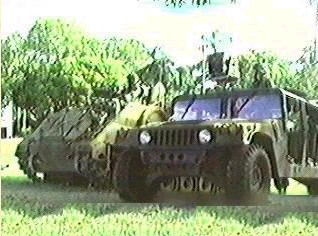

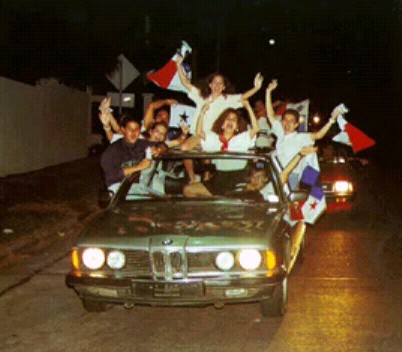
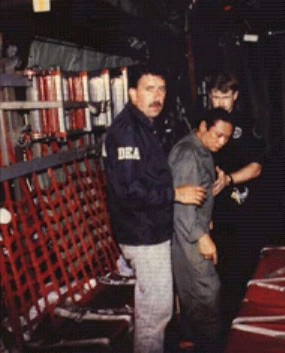
All of our 500 x C-130s could be stretched to carry up to 92 Paratroopers, fitted with in-flight refuelling plumbing and "J" model propfans for 400 mph speeds and global ranges.
Instead of cramming marines in handfuls of surface amphibious ships at $1 billion each for 6 months at a time which can be easily sunk by precision guided weapons in one strike, we should build a 4-engined version of the Russian A-40 jet seaplane that can speed them from the United States at 500 mph and land them in the water where they drive out from nose-open ramps using M113 Gavins fitted with waterjets to be OMGs from the sea. The Russian Naval Infantry use the same BMD amphibious-airdroppable TAFVs as their Airborne units use to get maximum Air/Sea, 2D/3D force synergism. Again, we have thousands of M113 Gavins in storage, mass-produced during a time when we were in a Cold War threatening to go hot that can be inexpensively upgraded into "AmphiGavins" to enable Navy/marine strategic operational maneuvers.
America needs to be able to do D-Days, but Generals/Admirals must be fired first
The dirty secret of winning WWII is that for us to get to the point of being able to do D-Day, President Roosevelt had General Marshall fire hundreds of Generals and Colonels who were standing in the way. The same thing is needed today with Generals and Admirals insisting that $BILLIONS be spent on mechanically unreliable V-22 half-airplane/half-helicopters to fly off the decks (at best 300 mph) of obsolete mentality amphibious ships to try to preserve the decaying status quo, when even if they worked at $80 million each can only deliver 20 marines and no TAFVs--and cannot land in the water. For this same price we could get two 4-engined "A-80" jet seaplane transports delivering 40 marines inside 4 M113 Amphigavins arriving at 500 mph to anywhere in the world, onto either sea or land. Other Army Generals are insisting that Congress supply them $3 BILLION a year for 10 years to develop a 20-25 ton "Future Combat System" that in 2012 will be just as 5-10 tons overweight to fly in a C-130 as their 19-21 ton Stryker "interim" wheeled truck is today. The 300 Stryker trucks crammed full of electronics gear and skimping on physical armor protection rolling on air-filled rubber tires that burn are so fragile that even though they are kept in the quietest spot in Northernmost Iraq now require $111 million in repairs. The Army Generals have a solution for the FCS being too heavy to fly in a C-130: Congress should give them more $BILLIONS to develop a huge heavy lift helicopter that also doesn't exist. Nevermind, that their "icing" of computers can be put into existing Gavins now to get the "network-centric" warfare capabilities the Generals say are sooooo vitally needed. They say without a multi-billion dollar FCS/heavy lift helicopter "cake" there can be no "icing". Without both of them there can be no "D-Days" (effective strategic, operational maneuvers). Clearly, to do D-Day today, we need a major "house-cleaning" of out-of-touch, can't-do Generals and Admirals who want to fund their fantasy projects and not what the troops and America needs today to win.
We Told You So: Why Are Medium Bradleys and Heavyweight Abrams Tanks Sitting in Motor Pools in the USA while American Light Infantry is Getting Creamed in Wheeled Trucks and On Foot in Afghanistan when LIGHT M113 Gavins are Available?
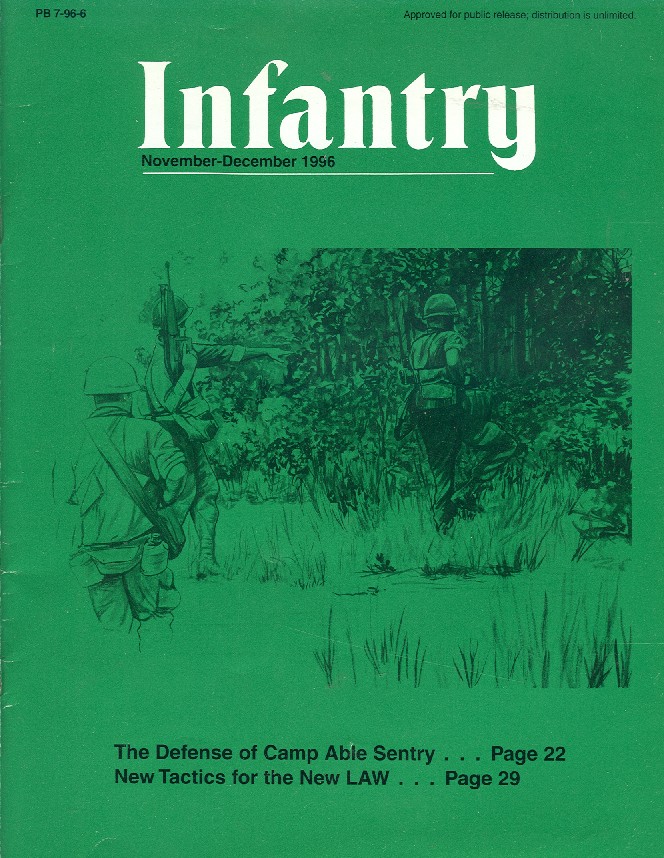
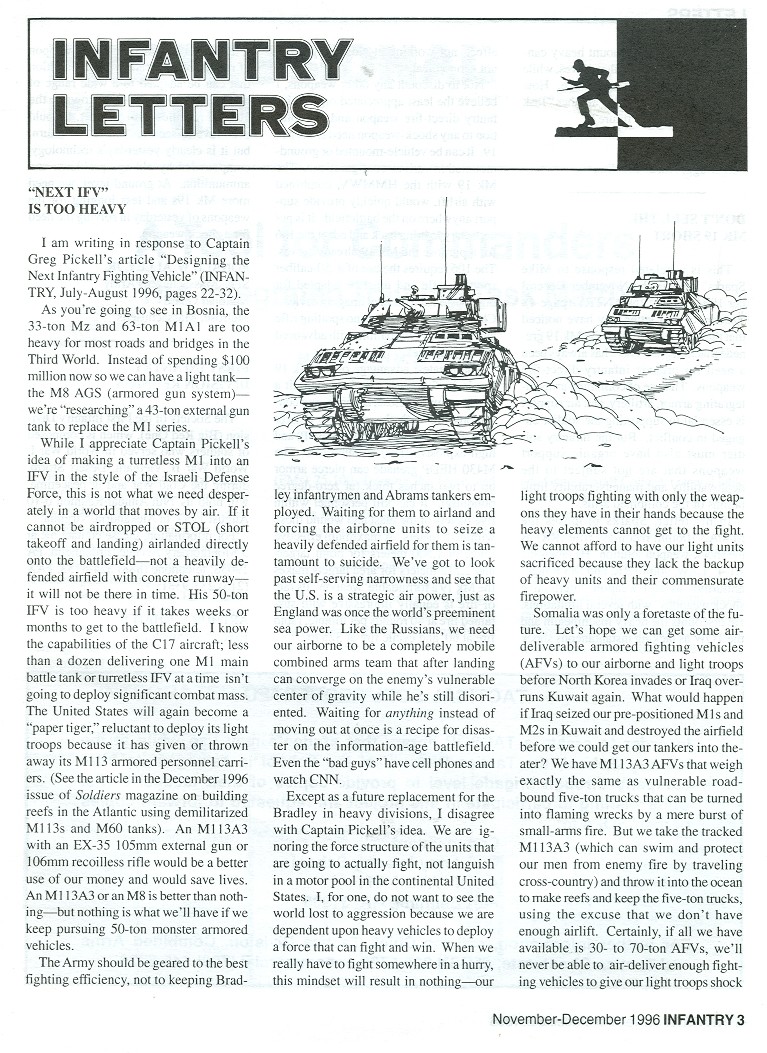
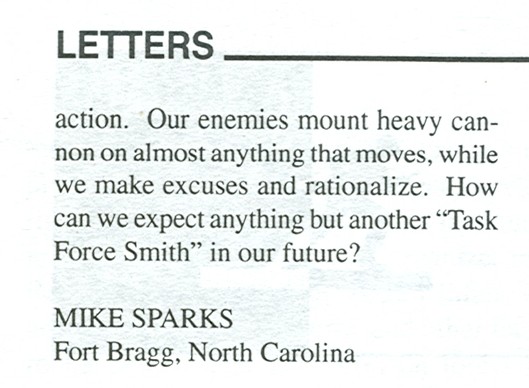
INFANTRY LETTERS
"NEXT IFV" IS TOO HEAVY
I am writing in response to Captain Greg Pickell's article "Designing the Next Infantry Fighting Vehicle" (INFANTRY, July-August 1996, pages 22-32).
As you're going to see in Bosnia, the 33-ton M2 and 63-ton M1A1 are too heavy for most roads and bridges in the Third World. Instead of spending $100 million now so we can have a light tank the M8 AGS (armored gun system) we're "researching" a 43-ton external gun tank to replace the M1 series.
While I appreciate Captain Pickell's idea of making a turretless M1 into an IFV in the style of the Israeli Defense Force, this is not what we need desperately in a world that moves by air. If it cannot be airdropped or STOL (short takeoff and landing) airlanded directly onto the battlefield-not a heavily defended airfield with concrete runway it will not be there in time. His 50-ton IFV is too heavy if it takes weeks or months to get to the battlefield. I know the capabilities of the C-17 aircraft; less than a dozen delivering one M1 main battle tank or turretless IFV at-a-time isn't going to deploy significant combat mass.
The United States will again become a "paper tiger," reluctant to deploy its light troops because it has given or thrown away its M113 armored personnel carriers. (See the article in the December 1996 issue of Soldiers magazine on building reefs in the Atlantic using demilitarized M113s and M60 tanks). An M113A3 with an EX-35 105mm external gun or 106mm recoilless rifle would be a better use of our money and would save lives.
An M113A3 or an M8 is better than nothing-but nothing is what we'll have if we keep pursuing 50-ton monster armored vehicles. The Army should be geared to the best fighting efficiency, not to keeping Bradley infantrymen and Abrams tankers employed. Waiting for them to airland and forcing the airborne units to seize a heavily defended airfield for them is tantamount to suicide. We've got to look past self-serving narrowness and see that the U.S. is a strategic air power, just as England was once the world's preeminent sea power. Like the Russians, we need our airborne to be a completely mobile combined arms team that after landing can converge on the enemy's vulnerable center of gravity while he's still disoriented. Waiting for anything instead of moving out at once is a recipe for disaster on the information-age battlefield. Even the "bad guys" have cell phones and watch CNN.
Except as a future replacement for the Bradley in heavy divisions, I disagree with Captain Pickell's idea. We are ignoring the force structure of the units that are going to actually fight, not languish in a motor pool in the continental United States. I, for one, do not want to see the world lost to aggression because we are dependent upon heavy vehicles to deploy a force that can fight and win. When we really have to fight somewhere in a hurry, this mindset will result in nothing-our light troops fighting with only the weapons they have in their hands because the heavy elements cannot get to the fight. We cannot afford to have our light units sacrificed because they lack the backup of heavy units and their commensurate firepower.
Somalia was only a foretaste of the future. Let's hope we can get some air-deliverable armored fighting vehicles (AFVs) to our airborne and light troops before North Korea invades or Iraq overruns Kuwait again. What would happen if Iraq seized our pre-positioned M1s and M2s in Kuwait and destroyed the airfield before we could get our tankers into theater? We have M113A3 AFVs that weigh exactly the same as vulnerable road bound five-ton trucks that can be turned into flaming wrecks by a mere burst of small-arms fire. But we take the tracked M113A3 (which can swim and protect our men from enemy fire by traveling cross-country) and throw it into the ocean to make reefs and keep the five-ton trucks, using the excuse that "we don't have enough airlift". Certainly, if all we have available is 30 to 70-ton AFVs, we'll never be able to air-deliver enough fighting vehicles to give our light troops shock
November-December 1996 INFANTRY 3
action. Our enemies mount heavy cannon on almost anything that moves, while we make excuses and rationalize. How can we expect anything but another "Task Force Smith" in our future?
MIKE SPARKS
Fort Bragg, North Carolina
November-December 1996 INFANTRY 4
Editor: "Air-Mech-Strike: Asymmetric Maneuver Warfare for the 21st Century"
www.geocities.com/air_mech_strike/amsbook.htm
P.S. CAVEAT: please do not quibble; I know a C-130 routinely paradrops 62 Paratroopers (2 non-jumping safeties to pull in static lines) and can be crammed with 80 in war time. I also know that we have 100+ C-17 4-jet transports that can drop 102-108 Paratroopers--the latter if the AF adds the last possible 6-seat section. However, this would complicate the WWII-to-today's D-Day comparison with at best 10,000 more troops delivered; a moot point. The point is we are physically less capable today than we were in WWII. Think long and hard about this.
Date: March 27, 2003
Unit: "A" Company, 3rd Battalion, 75th Rangers, Combat Engineers
Operation: ?
Troopers: 306
Country: Western Iraq
Drop zone: H-1 airfield
Aircraft: 3 x USAF C-17s
Type Air delivery: Night personnel, static-line jump
After the airfield was secured, "B" arrived by airland to infiltrate into Iraq to disrupt enemy activity at key locations using vulnerable wheeled Humvee trucks called "ground mobility vehicles" to make them sound sexy and not what they are. "B" company later went to Objective Lynx, the Hadithah Dam to prevent it from being exploded.
Date: Before April 1, 2003
Unit: USAF 820th Security Forces Group
Operation: Iraqi Freedom
Troopers: ?
Country: Iraq
Drop zones: Tallil Air Base, objective "Rams"
Aircraft: HC-130 Hercules
Equipment/supplies air-delivered: ?
Type Air delivery: Daylight Static-line parachute mass tactical jump

www.defenselink.mil/daimages/photos/may2003/index/ii050403a.jpg
READY TO JUMP - Members from the 820th Security Forces Group wait to leave an HC-130 for a static line jump over Tallil Air Base, Iraq May 1 during Operation Iraqi Freedom. U.S. Air Force photo by Staff Sgt. Shane A. Cuomo.
Date: April 1-4, 2003
Unit: "C" Company, 1-41st Armor
Operation: Iraqi Freedom
Troopers: Armor Company (-) 1 platoon
Country: Western Iraq
Drop zones: H-1 Air Base
Aircraft: C-17 Globemaster IIIs
Equipment/supplies air-delivered: 4x M113 Gavins, 10 x M1 Abrams heavy tanks, 2 trucks, 2 HEMMT fueler trucks, 1 Humvee truck
Type Air delivery: Tactical airlanding
From Trainor/Gordon's book: Cobra II, pages 330-334, 442-448
OBSERVATIONS
Special Operations Force Detachment-Delta "Delta Force" ad hoc had 4 x M113 Gavin light tracked AFVs, 10 x M1 Abrams, 3 trucks, 3 x HEMMTT fuelers and a Humvee from "C" Company 1-41 Armor BN flown from Tallil airfield in southern Iraq to then airland into the airfield at H-1 in western Iraq after a company of Rangers parachute jumped in to secure the airfield. Commanded by Captain Shane Celeen, this task force was called "Team Tank" and drove south to Tikrit along Highway 1, despite having inadequate fuel due to USAF insistance their tanks not be filled due to in flight atmospheric pressure and no resupply after the fuel trucks went dry.
On April 11th, 2 days after Saddam had left Baghdad, TF Tank and Delta were nearing Tikrit when their commander orders them to "thunder run" into Tirkit. The Delta commander refuses. Delta raids Bayji a town north of Tikrit, and capture Saddam's bodyguards, the IqAF Chief of Staff and several inner circle mermbers, BUT NO SADDAM. They spent much of their time looking for non-existant WMD and missing Navy pilot Scott Speicher from the last Gulf War. On April 13th, marine brigadier John Kelly's ad hoc clusterfuck in LAV trucks arrive in Tikrit and don't find "shit" as the Fedeyeen rear guards melted back into the populace. He has his men take their helmets and flak jackets off and start mingling with the Iraqis as if the war was over when Saddam and subordinates were still very much on the loose to start a guerrilla war against us.
1. CENTCOM DID NOT have Saddam's capture assigned as a task to SOF or any other units---it appears. What were they thinking?
2. The slow build up of tracked armor by airland by "mech pussies" who in snobby Army culture are not allowed to parachute in, insured Saddam & company would escape after they left Baghdad on the 9th after the AWOL USMC finally showed up 6 days after the 3rd ID took Baghdad International Airport on April 3rd.
3. The 7 gallon-per-mile M1 Abrams heavy tank fuel hog was the wrong tank to air deploy (only one per C-17) cannot rapidly fan out and cannot be parachute dropped. Airborne/Special Operations Forces need a LIGHT TANK, either the M8 Buford AGS or a M113 Gavin with a cannon that CAN be parachute dropped and operated by jump-qualified Soldiers to immediately use them to fan out and BLOCK enemy forces and fleeing leaders.
4. If the "special" feces Soldiers are too good to do thunder runs, then its time we get the so-called "mech pussies" jumping out of airplanes and using light tanks to do the job and tactics they refuse to do so we could root out a Saddam hiding in a hometown like Tikrit early on in an operation when a 2D overland pushed flushes him out from his nation-state capital.
5. A dedicated Air-Mech unit with light tracks would realize in training to use Flex-Cells or other means to insure they have full fuel and range to get the job done working with/around the USAF.
MISCELLANEOUS
USAF PJs jumping in Afghanistan
www.nationaldefensemagazine.org/issues/2006/may/CombatRescue.htm
EXCERPT:
Equipment is evolving as well as doctrine. One important item is the Sov-3 parachute, which allows landings at altitudes above 8,000 feet, where normal parachutes would have difficulty with the thin air. They have already been used twice in missions in Afghanistan, according to Shepard. Communications gear is also being revamped to allow para-jumpers to carry fewer radios.
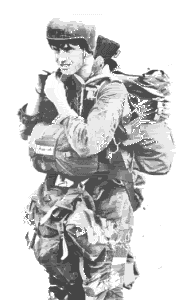
Rhodesian Fire force Paratrooper: World Champion with most combat jumps: 1962-1980
 www.youtube.com/watch?v=oRd_vgjGIWE
www.youtube.com/watch?v=oRd_vgjGIWE
Who has the world's most combat jumps?
U.S. Army Airborne?
Nope.
Brits?
Nope.
Russians?
Nope.
Germans?
Sorry, germanophiles, not even close.
French? good guess; they have the 2nd most combat jumps.
Want to know who has the most combat jumps so far in world history?
The Rhodesians.
The Rhodesians created an ingenious "Fire Force" system during their sub-national conflict (SNC) against communist rebels and outside mercenaries. The Rhodesian FIRE FORCES have done more combat jumps than anybody else at the small-unit, tactical level of war; sometimes they would jump 3 TIMES IN A DAY! Professor J.R.T. Wood's excellent report on the Rhodesian Fire Forces (RFFs):
The RFFs would have small "Killer Bees": Alouette III scout helicopters forward deployed with fuel caches and fixed-wing Cessna Model 337 Lynxes (USAF: O-2 Skymasters) scour the countryside for the enemy with Selous scouts on the ground hunting the "terrs" with tracker skills, and when they found the enemy, the Quick Reaction Force (QRF) Paratroopers would jump in by C-47 Dakotas, surround and finish off the terrorists with the help of CAS Hunter, Canberra fighter-bomber or SF-260 light attack aircraft strikes. Professor Wood elaborates:
"By 1977 ALL regular infantry were trained paratroops and would in turn be deployed by either helicopter or parachute"
This puts our cocky light infantry to shame: the 101st Air Assault, 10th Mountain and 25th Tropic Lightnings are not jump-qualified though they need to be ASAP--so they can be deployed without need of airlanding runways for Army C-27Js, USAF C-130s, C-17s.
Don't even bring up the simpleton USMC who has a Congressional order to parachute jump that they have ignored since 1947 because they instead want clusterfucks of blind obedience, lemmings to order around; not self-reliant, THINKING Paratroopers or egalitarian, Carlson's Raiders; marines are snob-incompetents unsuited for fluid, rapidly-changing, non-linear Airborne warfare situations.
For Sub-National Conflicts (SNCs) we need Airborne Quick Reaction Forces (QRFs) like the Rhodesian Fire Forces but enhanced with High-Tech M113 Gavin light tanks for places like Afghanistan--backed by border security sensor fences.

RRF tactics are EXACTLY what we should be doing in Iraq/Afghanistan--but for all our more-Airborne-than-thou-art, chest-beating crap, the fact is Americans are LAZY and don't want to do the extra work to earn SURPRISE on the enemy by 3D maneuver vertical airdrop landings from out-of-earshot fixed-wing aircraft; we want to ride in comfy wheeled trucks along roads sallying forth from comfortable FOBs kicking up dust visible for miles or ride on our asses in noisy helicopters and then foot-slog with 100 pounds of "lightweight" equipment and then wonder why the rebels are long gone and not around to gunplay? A smart SNC air-mech force would use the Rhodesian Fire Force system and airdrop M113 Gavin light tracked AFVs to cross-country transport Paras and recover parachutes and air items for re-use at the end of the QRF mission.
Want to know more about 3D Airborne Maneuver Warfare?
Our book, "Air-Mech-Strike: Asymmetric Maneuver Warfare for the 21st Century" is ONLINE for FREE skyjacked by Google!

Special thanks to Msasa Enterprises for compiling this rare footage!
First, a reality check. If you only scrolled down through the American Airborne operations, shame on you; you are part of the "problem". If you are here, we congratulate you. Now for the truth. The Rhodesian FIRE FORCES has done more combat jumps than anybody else. Sometimes they would jump 3 TIMES IN A DAY. There were so many RRF jumps we don't even have a list of them all to post here. Next in line is the French Airborne with over 100 combat jumps. The RRFs have so many combat jumps between them we are so far unable to list/gain specific info on them all. Next the Russian Airborne is the most advanced in the world because its fully mechanized with the BMD family of light AFVs. The U.S. Airborne doesn't even have light tanks any more. The Russian Airborne can do Operational Maneuver from the Air, the American Airborne is fixated on seize/hold and "airfield seizure" from its WWII baby-steps. Shame on us all. The point is the American Airborne has NOT "arrived" and is in no position to call anyone a "leg" while others with a fraction of our resources have done MORE and led the way in Airborne warfare developments. The Russians can jump HIGHER and at FASTER speeds than the American Airborne can.
 www.youtube.com/watch?v=_hrvgYEI90c
www.youtube.com/watch?v=_hrvgYEI90c
The British Airborne can jump LOWER
 www.youtube.com/watch?v=Of4E-2fSeWs
www.youtube.com/watch?v=Of4E-2fSeWs
 www.youtube.com/watch?v=yAjNop4uyao
www.youtube.com/watch?v=yAjNop4uyao
and the Russians airdrop BMD-4 light tank/APCs with them while Israelis, Australians and German Airborne take along M113 Gavin and Wiesel light tracked armored fighting vehicles.
 www.youtube.com/watch?v=IUF4GVszsCQ
www.youtube.com/watch?v=IUF4GVszsCQ
 www.youtube.com/watch?v=HCB6QirkX5E
www.youtube.com/watch?v=HCB6QirkX5E
The point is the American Airborne is NOT "all that it can be" and needs to be.
Fix U.S. Army/UK Airborne Warfare
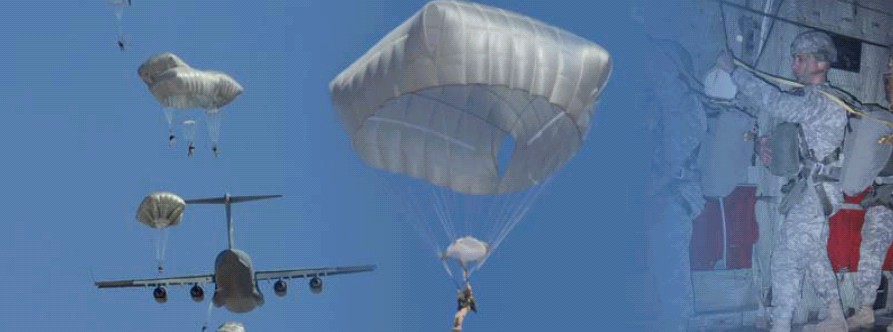
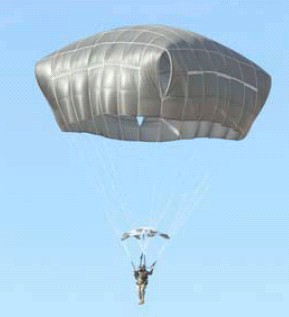
Aside from the new T-11 ATPS parachute that hopefully is bought in sky-gray camouflage, the American Airborne hasn't done much of anything to advance the state of 3D maneuver warfare.
 www.youtube.com/view_play_list?p=8FC4156AED940B4A
www.youtube.com/view_play_list?p=8FC4156AED940B4A
We realize that its not all the Airborne's fault, HQDA cancelled the M8 Buford AGS for example. But the idea that everything has already been accomplished, that the great pioneering work has been already been done by the greats from the past; Lee, Gavin, Miley, Ridgway is bogus. That's the rated-G word for it. Where was the American Airborne when the M113 APC was fielded? Has any Airborne commander put his "bars" (Not where you sing "Blood on the Risers" but your career) on the line and requested these vehicles? Why wasn't the M113 used to create 82nd Airborne DivisionAIRBORNEmechanized warfare capabilities as its original purpose as an AIRBORNE, armored multi-purpose vehicle family intended??
 www.youtube.com/watch?v=zD4RWmotso0
www.youtube.com/watch?v=zD4RWmotso0
If we are going to make any headway in AIRBORNE WARFARE capabilities in the U.S. we must accept the truth and GET BUSY fighting the battles and doing the pioneering work--which means RISKS to name, reputation, career, life and limb---Sadly the people that should be reading this probably didn't scroll down past the American jumps.
WWI
The first use of Paratroops goes back to WWI when Italian officers landed behind Austrian lines for reconnaisance.
Date: 1918
Unit: Italian Paratroops
Operation: ?
Troopers: ?
Country: Austria
Drop zones: ?
Aircraft: ?
Equipment/supplies air-delivered: ?
Type Air delivery: Daylight Static-line parachute mass tactical jump?
Between the wars

The Russian Airborne
Date: 1929
Unit: ?
Operation: ?
Troopers: 15
Country: Soviet Union (Russia)
Drop zones: Garm, Tadzhikistan
Aircraft: TB-3 bombers?
Equipment/supplies air-delivered:?
Type Air Delivery: Guestimate rip-cord activated parachutes after sliding down wing of TB-3 bomber
The first actual use in combat of Soviet paratroopers. The Red Army landed a force of fifteen men to relieve the besieged Tadzhik town of Garm, which was surrounded by a band of Basmachi guerrillas.
Date: November 1939
Unit: ?
Operation: ?
Troopers: ?
Country: Soviet Union (Russia)
Drop zones: Petsamo, Finland
Aircraft: TB-3 bombers?
Equipment/supplies air-delivered:?
Type Air Delivery: Guestimate rip-cord activated parachutes after sliding down wing of TB-3 bomber
The first actual use in combat of massed Paratroopers anywhere in the world. Myth that Germans were first is a lie.
The Dangerous Lie of Russian Airborne Inactivity and Uselessness in WW2

One of the cardinal myths of WW2 along with the U.S. Navy winning the war in the Pacific at Midway, that marines needing to die in droves to reach Iwo Jima and that the Japanese were even a threat when Germany--who actually had the atomic bomb---was the real mortal threat to the free world---is the lie that the Russians created parachute and glider delivered "Airborne" 3D maneuver forces before WW2, used them a couple times unsuccessfully against the Germans, then simply threw their ego-filled Paratroopers into the ranks of the enemy along with all the other "leg" Soldiers in a 2D stampede until overwhelming the Wermacht by numbers and reaching Berlin. Thus, all being "Airborne" is good for is to be a self-delusional aggressive Soldier---which is the conclusions of the Germans who LOST WW2, not the Russians who WON it.
These are all lies because the Russians not only had the largest Airborne force in the world, so far, ever--200, 0000 Paratroopers---they jumped more men and more times in WW2 successfully than anyone else did or has done ever since.
Proof: retired U.S. Army LTC David Glantz's The Soviet Airborne Experience
On U.S. Army Fort Leavenworth Web Site
www-cgsc.army.mil/carl/download/csipubs/glantz.pdf
1st Tactical Studies Group (Airborne) Web Site www.combatreform.org/russianairbornehistoryto1984.pdf
So why would alleged "historians" and the typical American serviceman lie about the Russian Airborne?
Win without Sacrifice
American military personnel for the most part are paid draftee-style volunteer victim idiots who are not even amateurs---let alone professionals who look at war objectively and study it. Most Americans in uniforms are egomaniacs or money-hungry types who never crack a book let alone delve into the complexities of modern warfare. Those who project a fake veneer of military knowledge buy wholesale into lies and cliches' that feed their Ameri-centric ego. At least half of the American ground military hates the Airborne (Cavalry) because they know deep down inside, it takes far more courage to risk one's self to fly to get into situational advantage than to creep up to the enemy entombed in a heavy, thickly armored vehicle (like the Greek phalanx) while pouring firepower that hopefully will leave only ashes of the enemy by the time the 2D clusterfuck reaches its destination. Our American "yankee ingenuity" version of the Greek Citizen-Soldier traces back to the Union Army that for the most part was not great but clearly massive backed by industry that overwhelmed the agrarian South. The sad truth that the earth can easily absorb incredible amounts of high explosives and the enemy will not be necessarily incinerated on the other end troubles the weak ego, labor-saving American who doesn't want to work or fight to be militarily excellent because he thinks his corporations have won the war for him by mass-produced firepower. People that jump out of airplanes bothers the ego and outlook of the typical "mech pussy". However, they are not without provocation.
Win by Suicide
The other half of the Army is composed of intolerable light infantry narcissists (like Achilles) who are so in love with themselves that they are willing to take personal risks to self-validate when fighting the enemy like parachute jumping that they make the true professional (Odysseus) want to throw up. These America-worshipping fools will jump and die but will not do a damn thing about improving their combat power and force structure with light tanks for example that clearly could be easily delivered to them lest they look like the "mech pussies". American infantry's refusal to mechanize which General Marshall would clearly have not tolerated---has persisted for years since WW1 and runs straight through the southern U.S. through Fort Benning, Georgia and is a perpetuation of the narcissism of the Confederate south that lost the modern civil war because war for self-validation is utter bullshit. The light infantry narcissists hate the Russian Airborne and lie about it because it fits into their lies that they were and still are the world's leaders in Airborne operations when its clearly not true and they are sitting on their asses reliving WW2 seize & hold despite the creator of the American Airborne, General Gavin repeatedly warning and explaining to them to air-mechanize into a "Sky Cavalry".
So we can see the myth of Russian Airborne inactivity fits into the cultural brain-washing of the American serviceman, but this lie has a father: Adolph Hitler.
The Russian Airborne WW2 inactivity and uselessness myth perpetuated by both anti- and pro-Airborne Americans alike was actually born by the evil, sinister and at times criminally incompetent dictator of Nazi Germany, Adolph Hitler after his own Airborne suffered heavy casualties taking the island of Crete in 1941 because unknowingly to him, the Allies had broken the German communications code and were waiting for the fallschirmjaegers and glider riders! Many so-called "historians" jump on the Hitler anti-Airborne cliche' iconoclast band wagon because they themselves are losers not doing squat in person about military excellence and it makes them feel good when they can bash men who are more dedicated and back up their talk with actions than themselves. The idea that Airborne forces if dropped ahead of the main body as a cavalry will get slaughtered and are only good to lead the main body as fatalistic Achilles shock troops as it instead slams into the enemy is THE fatal error that defeated Nazi Germany in WW2. Flat, rolling grassy plain Russia is THE BEST terrain on earth to conduct Airborne operations, even better than the desert. You can jump and glider crash-land just about ANYWHERE in Russia. The vast, open terrain of Russia is so huge one needs the motorized transport of both planes and tanks to cross it or else if you WALK YOU WILL TAKE TOO LONG TO REACH MOSCOW AND THE NOTORIOUS WINTER WILL GET YOU. Americans in the know talk about the "strategic moat" effect the two oceans have provided over the years to protect us, Russia has a "strategic planetary continental surface" that protects them. Russia is too far to walk to, yet at the very moment Hitler needed his Airborne forces to jump ahead and stop the Russians from retreating and reorganizing themselves (think Odysseus and the Trojan Horse), he didn't have it for the most favorable terrain on earth for it as his blitzkrieg (-) conked out just at the outskirts of Moscow.
And he just didn't run out of gas, either.
At the very moment when he was able to pounce on Moscow, the Russians dropped every paratrooper they could right into the Germans to stop them, working from the inside-out. And as typical American self-centered egomaniacs who think the world revolves around us, we simply do not get it. Americans have NEVER fought ALL of the German Army either in WW1 or WW2, only fractions after a late entry--we have NEVER fought 200 divisions or put it this way, 2 MILLION MEN at the same time. Americans have no idea whatsoever at the scale and horror of the Germany versus Russian Eastern Front in WW2. They have no concept whatsoever that a HUGE BATTLE could easily consume entire units. To the impatient and ignorant American, from the point of view of those units who were annihilated they were "failures". Americans want to win wars AND survive them, and this is simply not possible when you are fighting MILLIONS of enemies. Americans want their small-unit actions to win WARS and if its AN ENTIRE WORLD at war, its ignorant and unrealistic to even hope that every combat action is going to have a decisive pay-back in the enemy turning tail and running or calling it quits. When its TOTAL WAR---when ANNIHILATION/ATTRITION of entire societies is the goal as Hitler strayed when he didn't reach the enemy's center of gravity---Moscow to collapse the Russian nation-state's government which was ripe for collapse---you may have to drop entire divisions of brigades into the enemy's midst to slow them down---and these men will be lost like "a drop in a bucket".
The facts are, and they are known to the Russians---and its not BS propaganda on their part--is that their Airborne forces saved them in WW2 and this is why they continue to develop 3D maneuver forces to the present day because THEY KNOW SOMETHING WE DO NOT AND THEY ARE BETTER AT IT THAN WE ARE. If that is unacceptable to the American military egomaniac, its too fucking bad, because its true. The Russians know that in human land war, 3D maneuver is necessary to get into the inside of the enemy--like a Trojan Horse---to collapse him and not just to slam into his hard, outer crust where he is expecting you. Liddell-Hart explains it as the "indirect approach" in Strategy, Sun Tzu details that such an "extraordinary" force compliments the "ordinary" forces on the outside once the gates are opened.
Here is an example of the typical BS Russian Airborne-bashing history:
Airborne and Airmobile Forces, Russian (Peter Antill)
Early History
The VDV See Action
Post-War Developments
Sightseeing in Prague and Kabul
Going Solo
The War in Afghanistan
Into the 1990's
Bibliography
Early History
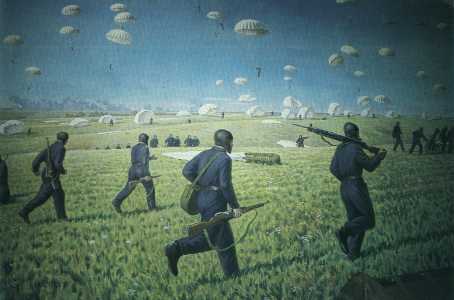
Painting of the Kiev Airborne Maneuvers
The Soviets can rightly be viewed as the pioneers of the airborne force, when in the late 1920's and early 1930's, trials were conducted that led to the first paratroop landing unit (PDO : parashyutnodesantniyotryad) in the Leningrad Military District in 1931.
Russians actually streamlined external load (SEL) carry armored cars and light tanks under TB-series bombers to include AIRDROP WITHOUT PARACHUTES! The works of Grohovskiy with TB-1, TB-2 and TB-3 bombers.
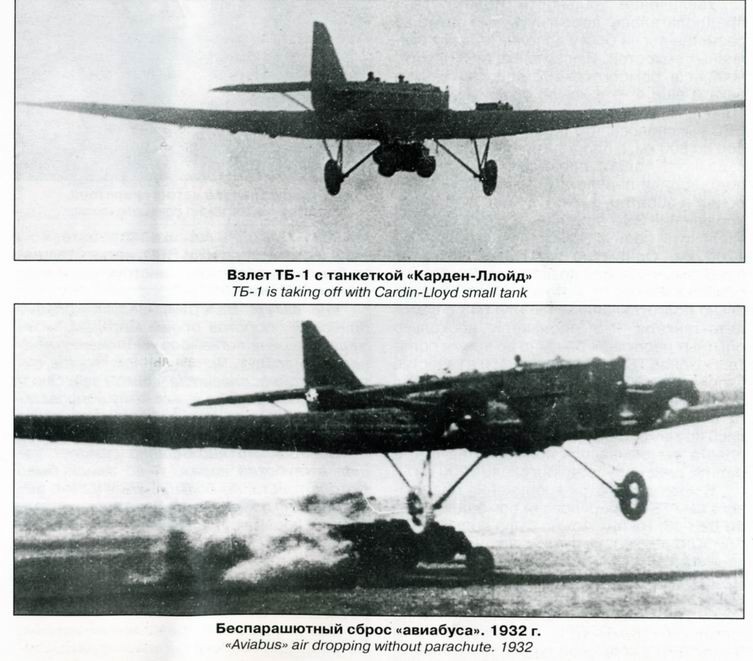
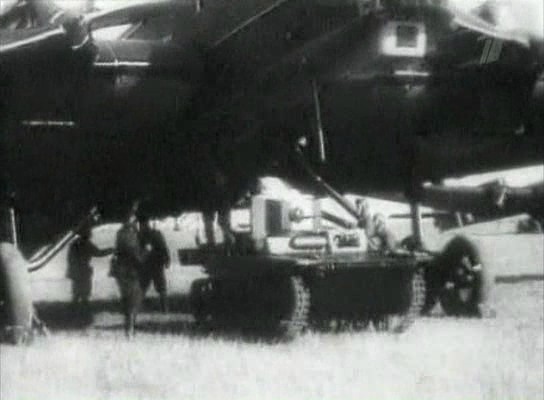
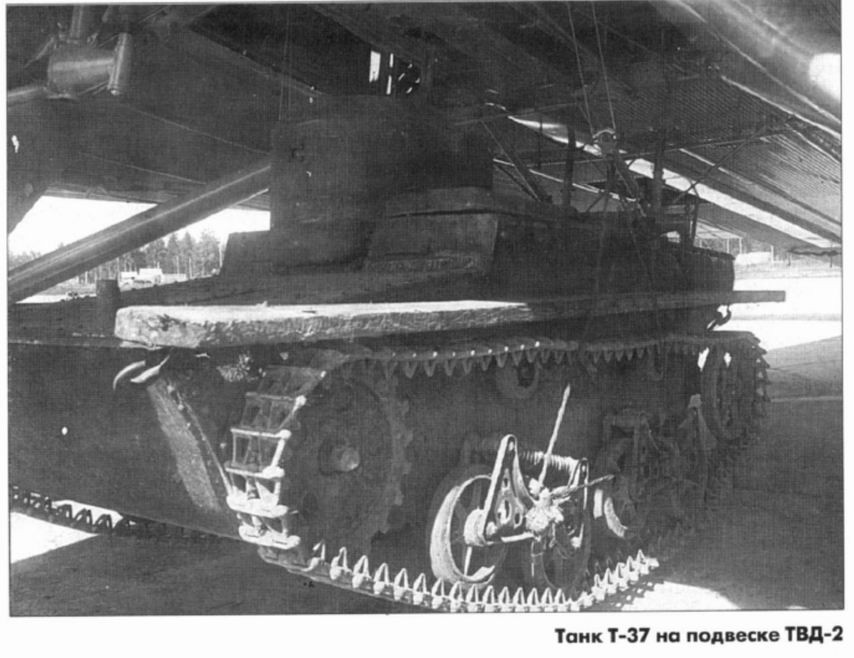
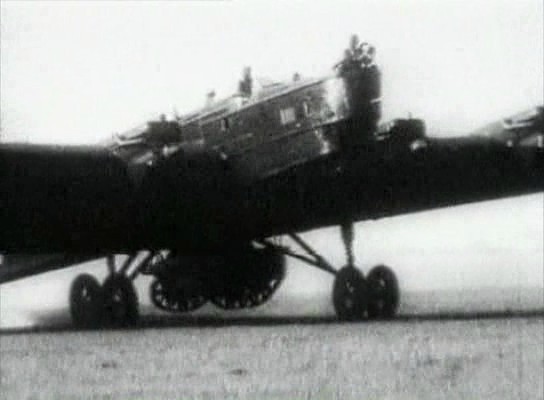
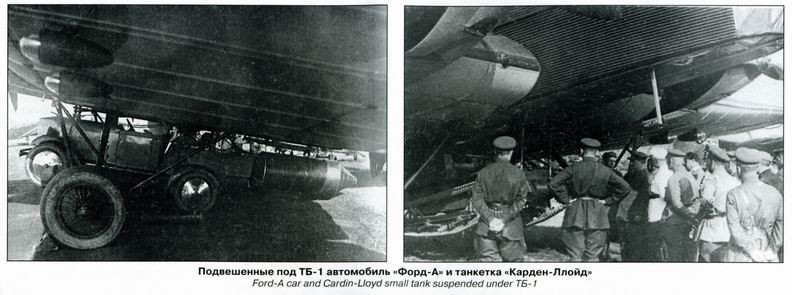
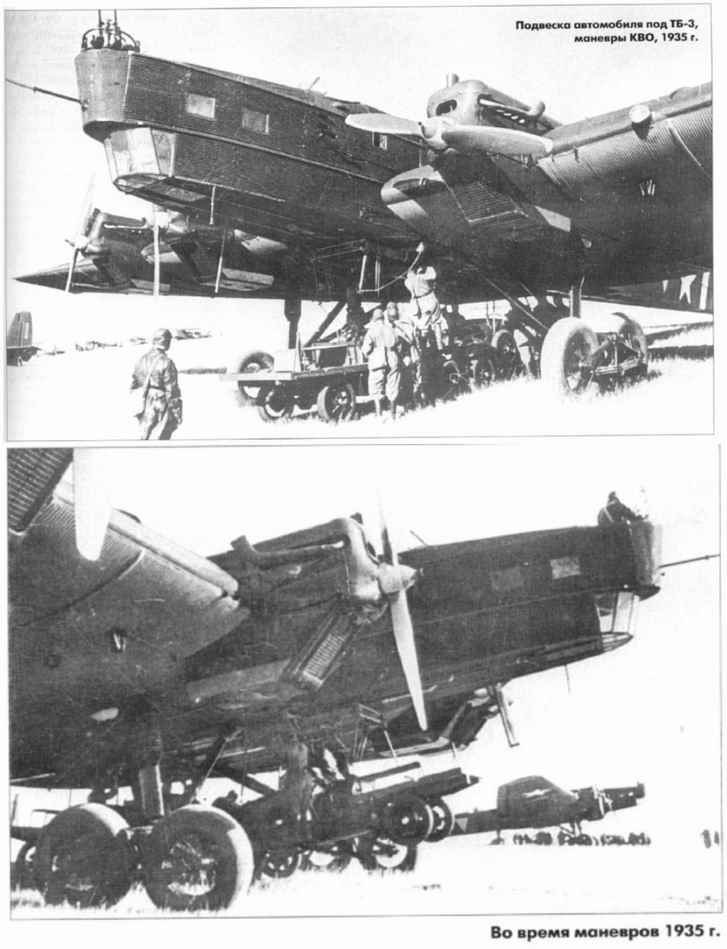

Russian Antonov KT-40 fixed wings to tow a T60 Light tank as a glider
However, the first actual use in combat of Soviet paratroopers had come in 1929 when the Red Army landed a force of fifteen men to relieve the besieged Tadzhik town of Garm, which was surrounded by a band of Basmachi guerrillas. The first major trial was conducted on 2nd August 1930 near Voronezh in the Moscow Military District. Experimentation went hand-in-hand with doctrinal research. Some of the leading names in this area were M. N. Tukhachevsky (commander of the Leningrad Military District), A. N. Lapchinsky (chief of staff of the Red Army's air force) and N. P. Ivanov. While aircraft had landed individuals in the enemy rear during the First World War, the developments in passenger aircraft now meant, it was theorised that it could be possible to put a substantial force down in the rear of the enemy and disrupt his operations.


TB-3 bombers load and drop Russian VDV Paratroopers
The first major test came in the Byelorussian Military District in 1934, and world-wide attention was given to their development when in 1935, foreign military observers were invited to the military exercises in the Ukrainian Military District, where 2,500 Paratroopers were dropped near Kiev. This helped stimulate the development of airborne forces in both Europe and the USA.
The VDV See Action

Despite being part of the Air Force, the 212th Airborne Brigade was deployed to the Far East and saw action in the Battle of Khalkin Gol against the Japanese Army in July and August 1939, while the 201st, 204th and 214th Airborne Brigades took part in the invasion of Poland during September 1939. The first full-scale combat jump in history occurred in November 1939 near Petsamo, Finland during the Russo-Finnish War and were again in action during the occupation of Rumanian Bessarabia. The reasonable success and good combat record, along with the success of the German Airborne forces in Western Europe meant that the five airborne brigades based in European Russia were earmarked to be expanded to corps status, while the sixth remained in the Far East. When war broke out in June 1941, the technical assets of the VDV (Vozdushno-Desantnaya Voyska - Air Assault Force) were totally inadequate to start with, and what they had was devastated by the air attacks early on in the campaign. This shortage of air assets meant that the VDV spent most of the war fighting as elite infantry. A number of operations were conducted during the winter of 1942/1943 with the 201st Airborne Brigade dropping near Medzyn on the 2/3 January and again near Vyazma on the 18th January, with the 204th Airborne Brigade near Rzhev on the 14-22 February. An ambitious plan was formulated to drop the entire 4th Airborne Corps near Vyazma behind German lines at the beginning of February, but with the lack of air transport assets meant that the 22 x TB-3s and 40 x PS-84s [EDITOR: Russian copies of the DC-3/C-47] would have to fly two or three sorties a night for a week. The Corps started dropping on the 27th January and about a quarter of them were dropped into terrible weather conditions and the operation foundered. Another operation later in the month against Yukhnov also failed. These heroic but ineffective operations led the Soviet High Command to convert the Corps to Guards Rifle Divisions and they fought with distinction in the northern Caucasus and Stalingrad. Eventually however, the Air Force managed to have them reformed as Guards Airborne Divisions and a large scale operation was planned in September 1943 to drop and air-land 10,000 troops from the 1st, 3rd and 5th Airborne Brigades and establish a bridgehead over the Dniepr River. The operation, however was a costly failure. "By a cruel irony, the only successful airborne operation by Soviet forces in the Second World War were small-scale drops by special Naval Infantry paratroopers in the Crimea, and operations by improvised Army units during the campaign against the Japanese in Manchuria in 1945." [note 1]
1940, 29-30 June: In the second large-scale combat use of Soviet airborne forces in an air assault, two airborne brigades parachuted from TB-3 bombers into Rumanian Bessarabia and captured the cities of Bolgrad, Kagul, and Izmail.
1941, July-October: Soviet parachute raids on a small-scale near Kiev, in the area near the Black Sea, and on the northwestern edge of the Caucasus.
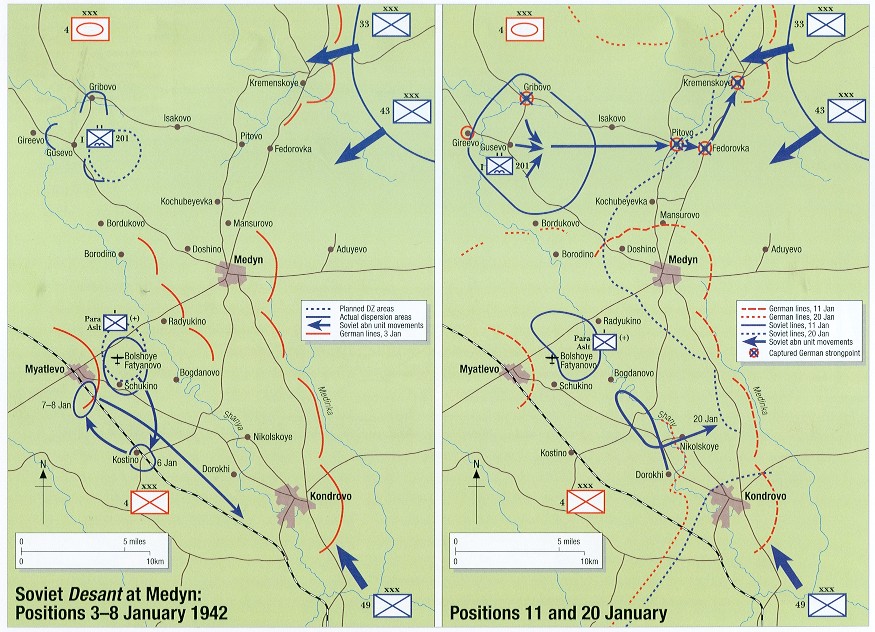
1942, 3 January-6 March: Airborne troops of the Soviet IV Airborne Corps, totaling approximately 14,000 men, were dropped or airlanded into the rear area of the German forces attacking Moscow in the vicinity of Vyaz'ma, 130 SW of Moscow. The operations included six major drops that were often spread out over several days due mainly to shortages in troop carrier aircraft (including PS-84s, TB-3s, and probably even some Soviet-built C-47s). Initial objectives generally required troopers to secure-and in one instance, establish-an airfield for airlanding additional forces. The troopers of IV Airborne Corps were to link up with attacking Soviet ground forces and, along with partisans in the vicinity, cut German supply lines and strike a counterblow; in the drop of 6 March, parachutists jumped even farther west and directly attacked the supply base at Elnya. The overall effort suffered from poor coordination between units, bad weather, shortages, ineffective resupply, pilots who were poorly trained in night navigation and formation flying, and scattered drops; however, the effort threw off the German timetable in Hitler's quest for Moscow. Troopers were isolated and eventually defeated in a battle during which some units fought in the line for four months, making this the longest-running airborne operation in history. Approximately 4,000 men survived.
1943, 24-25 September: Last Soviet operational-level airborne assault of the war. After the successful strategic defensive operation at Kursk in July 1943, the Soviet military quickly launched two counterattacks on German forces, which began a retreat westward toward the Dnepr River. In an effort to expedite Soviet crossings and develop bridgeheads, approximately 10,000 paratroops were to be brought in from the 1st, 3d, and 5th Guards Airborne Brigades (many troopers of which were veterans of the assault missions near Vyaz'ma in early 1942). Aircraft used included 50 x PS-84s and 150 IL-4s (B-25s supplied by the U.S.), plus a handful of gliders and nearly three dozen sailplane-type gliders. Parachutists were to drop at night in the area near the pocket on the west side of the bend in the Dnepr River just below Pereyaslav, where partisans had maintained strongpoints. Jumpers, who included a number of nurses trained as parachutists, were delayed a day because of weather. Units encountered problems with aircraft unsuited for parachute delivery and in preparations and aircraft fueling. Finally, rather than attempting to form up, aircraft simply departed as they were ready, shuttling in troopers in widely dispersed columns. The 5th Brigade dropped in easy range of the German 19th panzer Division that was moving east on the road through Dudari toward the river to provide assistance to German forces trapped there. Most parachutists were slaughtered in the air or as they reached the ground. Similar losses for related reasons occurred with 3d Brigade. The 1st Brigade landed in better position and went into action with infantry units, as planned. However, during October and November the forces in this area at the bend of the Dnepr River were driven out or eliminated. Ironically, the Germans poured in so many reserves to this contested area south of Pereyaslav that Soviet forces probably crossed the Dnepr more readily at points north and south than they would have otherwise. Losses were so heavy and results so meager, however, that the Soviet military confined its elite airborne units to infantry fighting for the balance of the war. Most of the difficulties in this operation arose from a combination of factors including expediency in planning, poor coordination, the use of transport aircrews rather than troop carrier aircrews, no joint training between airborne and air crews, ineffective intelligence, and improper equipment.
Post-War Developments
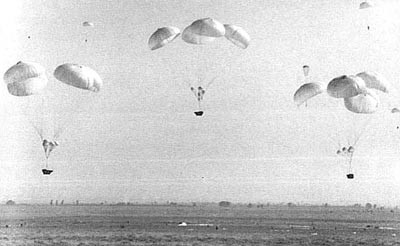
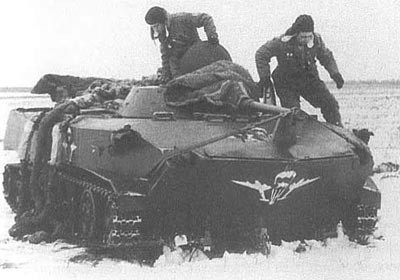
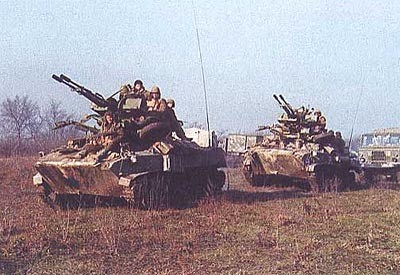
Sightseeing in Prague and Kabul
The invasion of Czechoslovakia was designated Operation Danube. The Soviet Army formed a Strategic Direction composed of three Fronts (Central, Carpathian and Southern) and the VDV mobilised two of its divisions, of which the 103rd Guards Desant Division was to deliver the coup de main against Prague, with elements of the Polish 6th Airborne Division designated to take the airfield at Pardubice. On the evening of the 20th August 1968, an unscheduled Aeroflotte An-24 aircraft made an unscheduled landing at Ruzyme Airport at around 2030 hrs, and was soon followed by an aircraft from Lvov in the Ukraine at about midnight, which unloaded a number of Soviet 'civilians' who talked with Czech officials and then departed. As the troops of the three Fronts crossed the Czech border, the 'civilians' took up positions around the airport. At around 0200 hrs, two An-12 aircraft, escorted by MiG-21 fighters, landed at the airport, and two companies of desantniki (about 180 men) were disgorged and took over from the "civilians". After the airfield was secured, the command An-24, which had been the first aircraft to arrive, ordered the rest of the 103rd Guards Desant Division to start landing. This contained a number of ASU-85s and armoured personnel carriers, and a special assault group was to take the presidential palace, with the rest of the division seizing key points around the city. Not long after, the lead elements of the Central Front, the 6th Guards and 35th Motor Rifle Divisions entered Prague. For the invasion of Afghanistan, a larger VDV force was allocated than for Czechoslovakia, presumably because of the greater expectation of resistance. The VDV were to again provide the coup de main against Kabul, and were to eliminate the Afghan President, Hafizullah Amin, and replace him with a puppet regime under Babrak Karmal. One regiment was to be used from the 103rd and 104th Guards Desant Divisions, as well as the entire 105th Guards Desant Division in the operation. In early December 1979, the Soviets transferred the regiments from the 103rd and 104th into the country to assist in controlling Bagram airport just outside Kabul. Meanwhile, Soviet advisors all over the country began attempts to paralyse the armed forces. On the 24th December, the VDV forces at Bagram seized control of the airfield and the main elements of the 105th Guards began to arrive from their base in the neighbouring Turkestan Military District. The main Soviet forces began crossing the border on the 25th December, and the VDV assembled the main battle group to assault the presidential palace. After a brief but intense battle, the Soviets took the palace, and then spread out to take key locations around Kabul, and other population centres, such as Kandahar. Later in 1980, the airborne forces were reorganised, with the 105th Guards being disbanded, apart from the 345th Guards Airborne Regiment which became an independant air assault regiment, and both it and the 103rd Guards Desant Division were stationed at Bagram during the Afghan conflict.
Going Solo
It was its reorganisation as a semi-autonomous branch of the Soviet Armed Forces that marked a major shift in the VDV's nature. During the 1960's the Soviet Army had embarked on a shift in doctrine and tactics that emphasised the ability to fight on a nuclear battlefield (particularly in a European conflict). The VDV realised that they could be very useful in a theatre devastated by nuclear weapons but the troops could not survive in contaminated areas unprotected. So the VDV decided to follow the same route as the Ground Forces and develop a smaller lighter version of the BMP, which appeared in 1970 as the BMD (Boyevaya Maschina Desantnaya - Airborne Combat Vehicle). This marked the move from the light infantry role, to a mechanised air assault force, as the BMD equipped one, and eventually all three regiments (making around 320 BMDs) in a division. The BMD is a smaller version of the BMP, sharing the same turret and engine, but having a new hull and suspension design. The internal configuration is different and is more cramped. There are stations for three crewmembers (driver, gunner and commander) and for three passengers. The BMD-1 shares the same 73mm low pressure gun with the BMP-1 and has a revolving magazine of forty rounds, with an AT-3 "Sagger" missile launcher on top of the main gun. The engine and transmission are housed at the rear, and the suspension can be lowered and locked down for air transportation. Fuel is carried by a tank in the right rear corner of the vehicle and was supplemented on later models by two small external tanks. It is fully NBC protected, and has armour sufficient to withstand small arms and artillery shrapnel. However, "its light weight and small size have resulted in some performance and handling constraints. The armament system shares the same shortcomings as that on the BMP: the Malyutka (the Russian name for the AT-3 "Sagger") missile is difficult to aim due to its primitive guidance system, especially from a moving armoured vehicle; the main 73mm gun is short ranged; and its finned projectile is vulnerable to cross-winds to a greater extent than more conventional ammunition." [note 3] There were also problems with the poorly supported fuel tank, fragile transmission and poor ventilation when the crew fires the main gun. Many of these problems have been addressed to a greater or lesser extent in the BMD-1 M1973 model or the heavily redesigned BMD-2 which featured new grill vents, an internal redesign, new roadwheels, a 30mm automatic cannon in place of the 73mm gun, and an AT-4 'Spigot' or AT-5 'Spandrel' launcher in place of the AT-3 'Sagger', and first appeared in 1980. While it was initially unclear whether the BMD-2 had the complete turret of the BMP-2, it was later discovered that the turret was a new more compact design housing just the gunner (on the left), day / night sight, anti-aircraft sight, the 30mm 2A42 stabilised cannon and co-axial 7.62mm PKT machine gun. In 1990, a new airborne assault vehicle entered service, with the first production units going to the airborne forces, with delivery to the naval infantry to follow. The BMD-3 has a new chassis design and is fitted with the complete turret of the BMP-2. The vehicle is reported to have much better amphibious capability (hence the acquisition by the Naval Infantry), a more spacious interior, better firepower and improved command and control (due to the two man turret). The BMD-3 can be dropped complete with its crew of seven and the IL-76 can carry three such vehicles. An AG-17 grenade launcher is mounted on the front left of the vehicle and a 5.45mm RPKS machine gun on the right bow. The engine is a 2V-06 water-cooled diesel developing 450 bhp, giving a high power-to-weight ratio of 34 hp / tonne. The transmission is hydromechanical and features five forward and five reverse gears with a hydraulic steering unit. The vehicle has five rubber tyred road wheels, a large drive sprocket at the rear, an idler at the front and four return rollers.
The War in Afghanistan

Mi-8 drops off Russian VDV Paratroopers in Afghanistan
The Soviets have had an interest in helicopters since their early development in the 1940s and 1950s. The crash development of the Mi-4 "Hound", Yak-24 and Mi-6 "Hook" showed that they had begun to appreciate the value of vertoletnyi desant (helicopter landing). The development of the Mi-8 "Hip" finally provided sufficient tactical flexibility for the formation of airmobile forces. Three regiments of infantry were designated as airmobile brigades, but without organic helicopter assets they were little more than dedicated versions of the motor rifle units being cross-trained in helicopter insertion. One of the clearest lessons of the Sino-Soviet clashes of 1969, was the need for closer integration between mobile units and helicopters to respond to changing situations. As a result, in the late 1970s the Soviets began to form Front-level DShBs (Desantoshturmovaya Brigada or assault landing brigade, originally called Brigady Osobennogo Naznachenia or Special Designation Brigades) and the equivalent battalions at Army level. These units trained much more closely with the Air Force regiments concerned, and as with the VDV, had their pick of recruits. The DShB were to have absolute priority on helicopter assets in combat, and the fact that these units were brigades is in itself indicative of their status, as the brigade was not a standard formation in the Soviet Armed Forces. "The war in Afghanistan provided the DShB with a range of challenges which bred .new tactics, new equipment and a new respect for the flexibility and tempo of helo-mobile operations." [note 4] The war itself was categorised by a sharp divide in the roles of the majority of Soviet troops, who were used primarily for garrison, convoy and perimeter duties, and the elite units that were used in an aggressive counter-insurgency role. These consisted mainly of the Spetznatz, VDV, reconnaissance troops, security troops (such as the MVD and KGB) and the DShB. While one brigade was supposedly deployed to Afghanistan in 1980, based at Shir Khan, the estimates for the whole war ranged from one to ten brigades at any one time, due to the regular rotation of personnel through the theatre and the use of Soviet forces from inside the USSR itself. Most likely, there was a single reinforced DShB with several battalion sized elements to it. In many cases it is difficult to isolate the use of the DShB from that of the VDV, security or motor rifle troops used in heliborne operations. All conducted convoy security, rapid response and vertical assault missions. Convoy protection was very important to the Soviet effort in Afghanistan. The airmobile troops would scout the route the convoy was taking out, and then identify possible ambush locations, and then land small detachments that could take control of any commanding heights prior to the convoy passing. Once it had passed, they would be lifted off, and carried to the next point in a leapfrogging manner. In this regard they worked closely with the reconnaissance troops and combat protection units (Boevoe Okhranenie Podrazdelinia) guarding the convoy. One of the most effective uses of airmobile forces was in the rapid response role, whereby platoons or companies were kept on a round-the-clock alert footing, and used to repel attacks on vital installations, or act on tip-offs from scouts or government agents regarding supply caravans. Air assault forces were also of value in the more conventional Soviet operations, the blikirovka (blockade) used to surround and destroy identified rebel groups, and the procheska (comb) used to root out suspected rebel concentrations.
Into the 1990's

Not long after the war in Afghanistan came to an end, the Cold War ended as well, and the break up of the Soviet Union and Warsaw Pact seriously disrupted the Soviet military, which did not bode well for the creation of the Armed Forces of the Russian Federation. Morale, discipline and funding have all been serious problems, which were highlighted during the rather less than well-executed war in Chechnya. The VDV supplied a number of ad hoc regiments to the fight, and although even they were not once what they were under the Soviet Union, they outshone the rest of the forces assembled in the Caucasus. The VDV have to some extent been shielded from the problems of the Russian Army as a whole , as they still have priority with regard to funds and personnel selection. However, it has been difficult to maintain the number of personnel required in keeping five divisions and eight brigades up to strength. This was shown in that after the dissolution of the Warsaw Pact and Soviet Union, the new economic and strategic realities facing the Russian Federation forced a rethink of the force structure, particularly in view of the economy's inability to support large groups of mechanised forces throughout the Federation. It was therefore decided to create a highly mobile, well-trained and equipped fire brigade type of force, especially in view of the local wars predicted by the new doctrine. The new Mobile Forces were planned to be complete by the end of 1995 and be split into two elements: the Immediate Reaction Forces and the Rapid Deployment Forces. The year 1996 saw two reorganisations of the VDV, which gained a lot of media coverage due to the political implications. The first was the transfer of four of the air assault brigades to the control of the commander of the Military District they were in. In addition, two airborne divisions that were deployed in border districts were to become operationally subordinate to those districts while remaining part of the VDV for administration and training. There was much heated discussion over this, and while General Grachev was accused of destroying the VDV, the General Staff defended the decision in that it would strengthen the VDV and prepare them for the missions they would face in the 1990's, given the Chechen experience. The VDV needed heavier equipments, and re-eqipping the whole force was just not possible. The reassignment of the air assault brigades was seen as a correction of an earlier mistake, which meant that control of army aviation and the air assault force, would now take place in the same headquarters. This in many ways made sense given the move towards decentralised power, and so territorial commands can now have their own small scale rapid deployment forces. It may also provide a leavening to the otherwise shakey local forces. The second reorganisation was the reduction in establishment of the VDV from 60,000 to 48,500 (down to 3 divisions and two brigades) recognising the unpalatable fact of undermanning, and rumours have continued to persist that the VDV might even loose its status as a separate branch of service and merge with the Ground Forces. ". . . . Russia will not have an effective . . . . desant force until the country's internal problems have been solved and the armed forces have undertaken a real reform. When that happens, Russia has the helicopter designers and tactical theorists to make a major contribution to this branch of the military art once again." [note 5]
Bibliography
Blount, Kerry A, "Mobile Forces for Russia's Future", FSRC Analytical Note, 6th January 1993.
Galeotti, Mark "DShB - Assault Landing Brigades from Afghanistan to 'Defensive Defence'", Jane's Soviet Intelligence Review, September 1990, pp. 386 - 391.
Galeotti, Mark "Russia's Airborne Forces: Coming Down to Earth", Jane's Intelligence Review, April 1996, p. 147.
Glantz, David M "A History of Soviet Airborne Forces", Frank Cass & Co Ltd, 1994, 0-7146-4120-0.
Hall, Robert "Russia's Mobile Forces - Rationale and Structure", Janes Intelligence Review, April 1993, pp. 154 - 155.
Holcombm, James F and Turbiville, Graham H, "Soviet Desant Forces", International Defence Review, 9 / 1988, pp. 1077 - 1082 and 10 / 1988, pp. 1259 - 1264.
Orr, Michael "The Russian Heliborne Desant Force in Theory and Practice", CSRC (RMA, Sandhurst), Research Paper A99, December 1996.
Schofield, Carey, "Inside the Soviet Army", Headline Publishing, 1991, 0-7472-0418-7.
Tsouras, Peter G, Changing Orders: The Evolution of the World's Armies, 1945 to the Present", Arms and Armour Press, 1994, 1-85409-018-6.
Zaloga, Steven J and Loop, James, "Soviet Bloc Elite Forces", Osprey Publishing, 1985, Elite Series No.5, 0-85045-631-2.
1. Steven J Zalooga and James Loop, "Soviet Bloc Elite Forces", 1986, Osprey, page 6
2. James F Holcomb and Graham H Turbiville, "Soviet Desant Forces", p1079
3. James F Holcomb and Graham H Turbiville, "Soviet Desant Forces", p10
4. Mark Galeotti, "DShB - Assault Landing Brigades from Afghanistan to 'Defensive Defence'", p387
5. Michael Orr, The Russian Heliborne Desant Force in Theory and Practice, p. 21.
The German Airborne
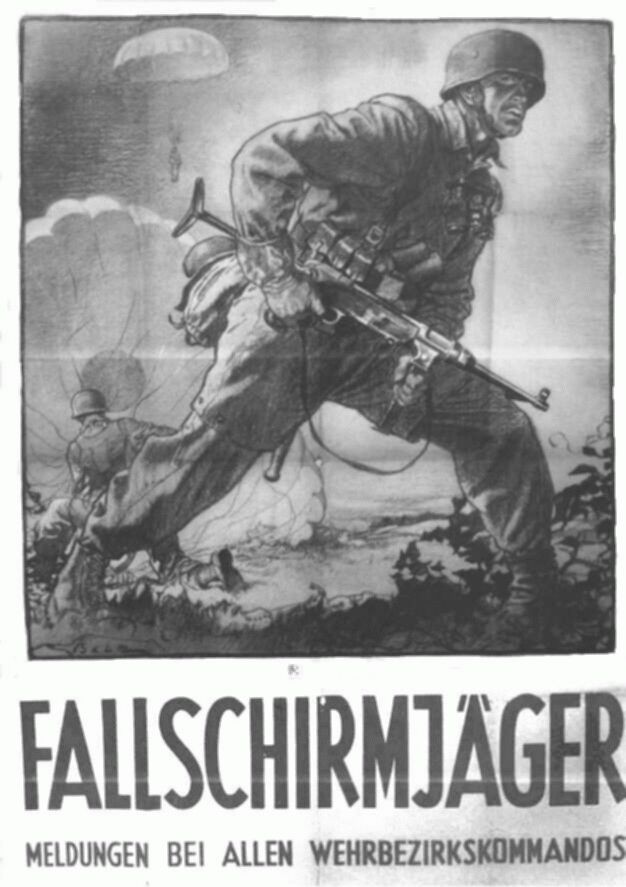
German paras late war history
Note: small Liaison planes towing assault gliders for Mussolini rescue
 www.youtube.com/watch?v=TEme8MUmOTM
www.youtube.com/watch?v=TEme8MUmOTM
 www.youtube.com/watch?v=q4IWbRS6mLI
www.youtube.com/watch?v=q4IWbRS6mLI
NOTE: their dependance upon separately located containers for their heavier hand weapons
The history of the German Airborne troops began on the 29th of July in 1936. On this day the Surpreme Command of the Luftwaffe ordered the deployment of the "Fliegertruppe F" and by this brought into being a totally new military unit.
At the same time, the Airborne School of the Wehrmacht at Stendal was set up, where on the 11th of May 1936 the first parachute jump in the German military history was carried out from the wing of a Klemm 25.
The first Paratroopers were trained in a course which took place from August to September of the same year; the successful Soldiers were awarded the "Fallschirmabzeichen of the Luftwaffe".
Beginning in 1937, the Wehrmacht intensified its training of Paratroopers and with the "parachute-infantry-company" deployed a second Paratrooper unit, which contrary to the Luftwaffe's "Fliegertruppe F" was an Army unit.
While this new unit was stationed and trained at Stendal like the "Fliegertruppe F", its military tasks were different: the second one was trained for the destruction of targets in the enemy's hinterland, the "parachute-infantry-company" should be enabled to cooperate with other infantry units in tactical operations.
After the construction of German Airborne troops had been carried on in 1938, both existing units were united under the command of the Luftwaffe in 1938.
When WWII started, the Wehrmacht had 3,200 Paratroopers available, in 1943 it were 35,000 and at the end of the war, after some "Luftwaffe infantry divisions" had been integrated, 100,000 of which 15,000 were trained in jumping.
During WWII, the Wehrmacht brought its Paratroopers into action in 17 Airborne operations.
Date: 1938
Unit: 1st Paratroop Battalion of the 7th Flieger Division, German Fallschirmtruppen
Operation: Bruntal
Troopers: 1,200
Country: Czechloslavakia
Drop zones: Kosetice, Hill 674 vicinity Milotice, east of Bruntal
Aircraft: JU-52s, Iron Annies
Equipment/supplies air-delivered: weapons, ammunition, food, water, medical supplies (wing bundles)
Type Air delivery: Daylight Static-line parachute mass tactical jump, LVAD
1940, 9 April: The first German opposed combat airborne assaults of the war. A regiment of German paratroops from General Kurt Student's 7th Parachute Division, with air support, staged coordinated surprise assaults on airfields in key locations in Norway, and to a lesser extent, Denmark, followed by massive airlanding of troops and supplies and subsequent small-scale airborne operations. For these operations the Luftwaffe used the JU-52, the primary German troop carrier aircraft of WWII converted from a civilian airliner. This airplane had a length of 62 ft. and a wingspan of almost 96 ft. Its weight empty ranged between models from 12,610 lbs to 14,330 lbs; maximum loaded weight varied from 23,148 lbs to 24,250 lbs. It could generally carry into combat 18 equipped airlanded troopers or a maximum load of 4,409 lbs. The JU-52 was a tri-motor aircraft (one engine in the nose and two on the wings), with a corrugated metal skin. It's engines were 9-cylinder BMW radials that generated between 725-850 hp depending on models. (The C-47's P&W Twin Wasps, by comparison, were 1,200 hp 14-cylinder radials). The JU-52 had a top speed of only 168 mph at sea level, and a standard range of 684 miles. It had no self-sealing tanks or armor plating, though it regularly carried an assortment of machine guns that were manually aimed, and sometimes had a cockpit roof cupola or a dorsal turret equipped with a 20mm machine gun.

Art by Peter Dennis
At the outset of World War II, Belgium's Fort Eben Emael was thought to be virtually impregnable. But at dawn on May 10th, 1940, it fell in just half an hour to a force of only 71 Nazi warriors.
The excellent video documentary written by military expert Simon Dunstan below reveals how German strategic planners took advantage of Eben Emael's one weakness--the roof. Incredibly, gliders landed on top of the fort, delivering a strike force of Paratroopers in a one-way mission of incredible daring and skill. Once in the fortress, the elite forces surgically attacked the gun emplacements and neutralized an obstacle that might have significantly changed the course of the war.
Highlighted by first person accounts and detailed reenactments filmed in Eben Emael itself, this is the stirring tale of one of history's greatest raids.
 www.youtube.com/watch?v=BPg0azS32TU
www.youtube.com/watch?v=BPg0azS32TU
PART 2: General Student ascertains 12 gliders could land on top of the fort, Monroe effect shaped-charges could explode gun emplacements, raid force selected and begins training
 www.youtube.com/watch?v=ep83dBymdAQ
www.youtube.com/watch?v=ep83dBymdAQ
PART 3: Assault groups not only to take-out the fort but to seize the canal bridges, Stuka close air support on-call within 15 minutes, Belgians had warning attack was coming but wasted time trying to clear-out two wooden barracks, were not ready to fire warning shots to alert others around them, 4 machine guns on top put into action but two guns jam, can't identify friend or foe, the gliders land, German paras begin taking out gun positions with hollow charges and grenades through the openings they create
 www.youtube.com/watch?v=DFsbuAFpOV0
www.youtube.com/watch?v=DFsbuAFpOV0
PART 4: the remaining gun positions had defective ammo elevators and no cannister ammunition to fire at the Germans on foot, one of the machine gun emplacements was unmanned with its men pitching in to clear the wooden admin buildings and the other undermanned with no ammunition taken out of boxes to shoot back and were easily taken out by flamethrowers and shaped charges, at the bridges one was blown but the rest taken and 40 minutes later parachute troops landed to reinforce them. Only 1 gun emplacement worked and it did destroy 1 Meuse river bridge and forced the Germans to build pontoon bridges delaying their invasion by 24 hours
 www.youtube.com/watch?v=-arKcJTj1u4
www.youtube.com/watch?v=-arKcJTj1u4
PART 5: Germans move down into the fort to avoid fires from the nearby Liege forts and blow up the inner barrier doors, smash the ammunition supply elevators, Belgians surrender and Germans pour through and capture their country
 www.youtube.com/watch?v=GJ4dzDj3_Ls
www.youtube.com/watch?v=GJ4dzDj3_Ls
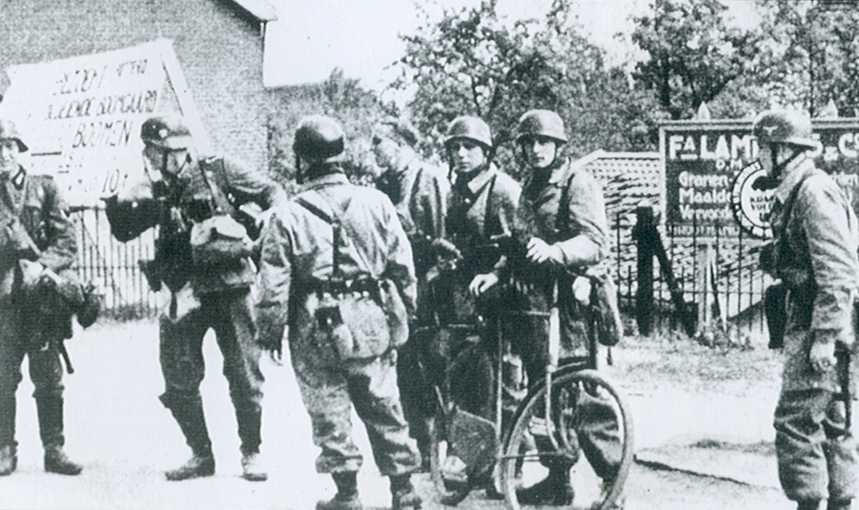
1940, 10 May: Part of a reinforced company of Student's forces staged the first glider assault of the war against the massive Belgian fortress, Eben Emael, 20 airline miles north of Ličge on the west side of the Albert Canal. Included in the attack were also three key bridges over the same canal. JU-52s and Stuka dive bombers were used to tow approximately 50 gliders into the area for the highly-successful assault. The attack was staged at night on a small landing zone, with no advance artillery or aerial bombardment. (The glider used was the standard Luftwaffe combat glider of WW II, the DFS-230, which had been perfected in the days before the war as the Germans trained many Luftwaffe pilots under the auspices of a civilian sport glider program. The DFS-230 was a high-wing, fabric-covered craft constructed of tubular steel. Like the CG-4A, the German glider was equipped with spoilers, and made considerable use of stressed plywood in the wing construction. Unlike the CG-4A, the Luftwaffe glider had a machine gun mounted on top of the fuselage, immediately behind the pilot. The DFS-230 seated nine Soldiers who sat single-file behind the pilot and could carry a maximum load of 2,800 lbs. It had a length of 371/2 ft. and wingspan of 72 ft.)
The same day that the glider raid on Eben Emael took place, the Luftwaffe used approximately 500 x JU-52s to deliver five parachute regiments plus one airlanded infantry division. Objectives included key airfields in Holland and nearby bridges over the Maas, Waal, and Lower Rhine rivers in advance of invading German forces.
1941, 26 April: 1,500 German parachutists and gliderborne troops, transported by approximately 50 x JU-52s and 12 gliders, temporarily seized the bridge over the Corinth Canal in Greece, a bottleneck in both the British escape route and the German advance. However, the bridge was soon destroyed, evidently by Australian or British Soldiers who had prepared it for demolition.
Crete: World's First Air-Mech-Strike Operation: Airborne Victory, Amphibious Defeat

1941, 20 May: German airborne assault, divisional in size, of the island of Crete, using both parachute and glider delivery. Air operations included ten Luftwaffe groups of JU-52s, plus hundreds of support aircraft. The plan was similar to that used in Norway and Holland: capture three key airfields on the island, then land ground troops by air and/or sea to consolidate positions. German multiple "ink blot" DZ dispersal of their paratroops overcomes Allied awareness of the exact drop zones via the ULTRA secret.
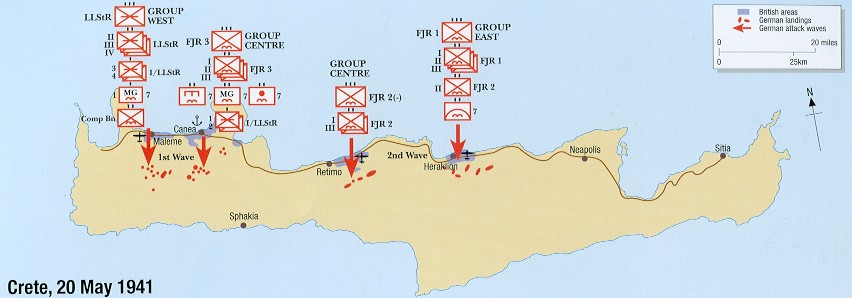
Suffering heavy losses due to the Allies knowing in advance where his men were landing, General Student gambles everything on Maleme airfield and JU-52s airlanding mountain troops turns the tide and the allies are pushed off the island.
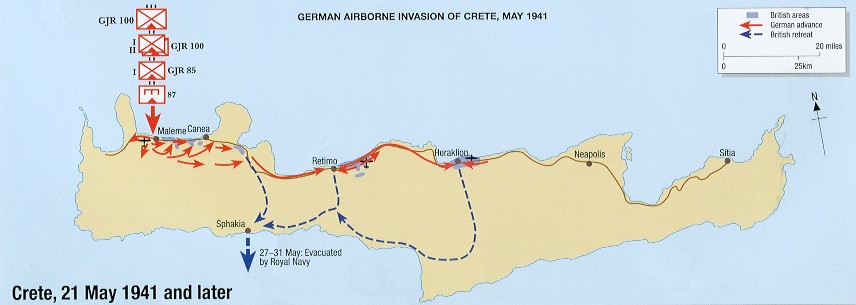
The result was a Cadmean victory for the Germans who captured Crete at the cost of 5,140 casualties (almost 4,000 of them killed), 170 of the Luftwaffe's 600 x JU-52s destroyed.
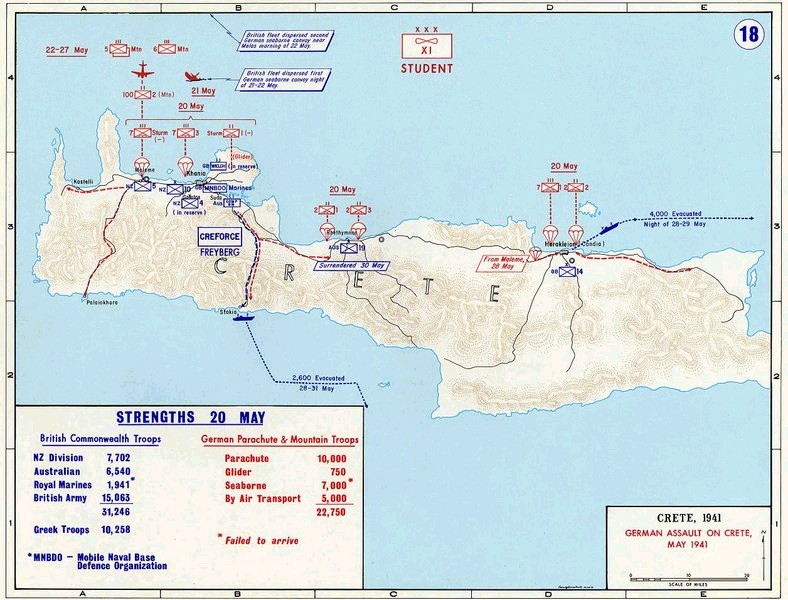
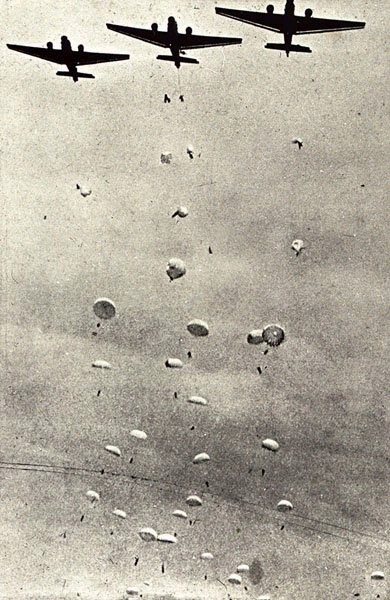
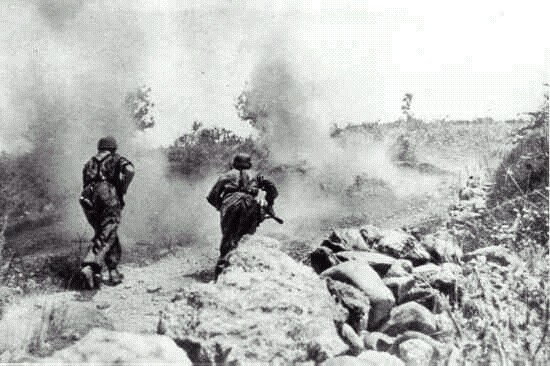
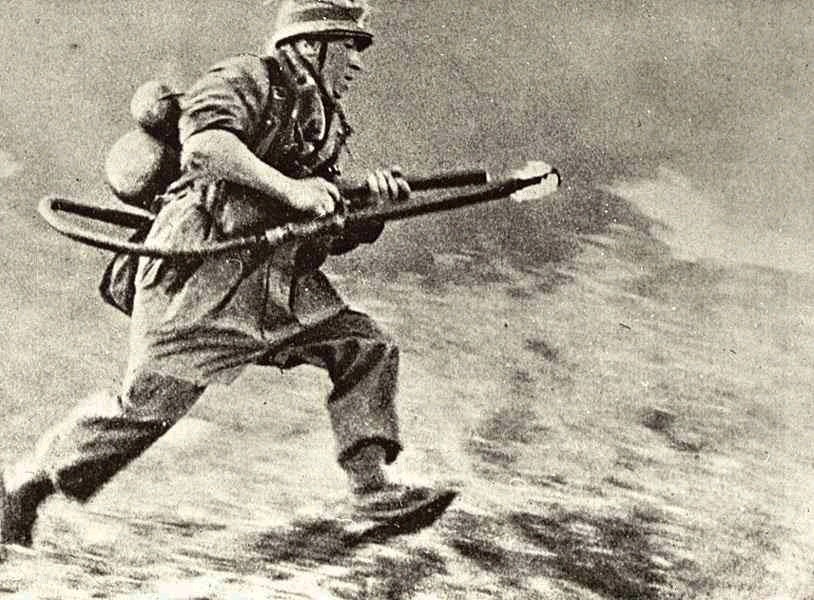
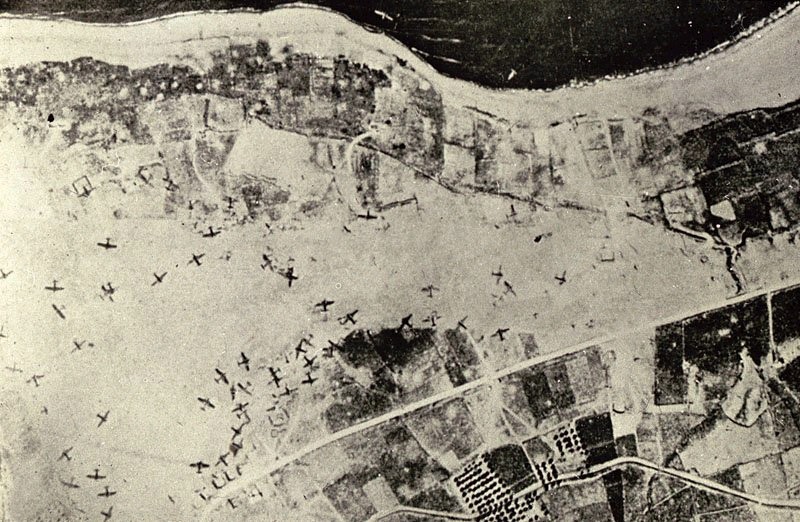
MYSTERY: we know with some certainty that the Kettenkrad motorcycle half-tracks were AIRLANDED by JU-52s at great risk onto Maleme airfield which was littered with destroyed aircraft. What we do not know is whether the LG40 75mm and LG42 105mm recoilless rifles were AIRDROPPED as 3 separate bundle loads from under the JU-52s and hand-towed into action initially or whether they airlanded with the motorcycle half-tracks.
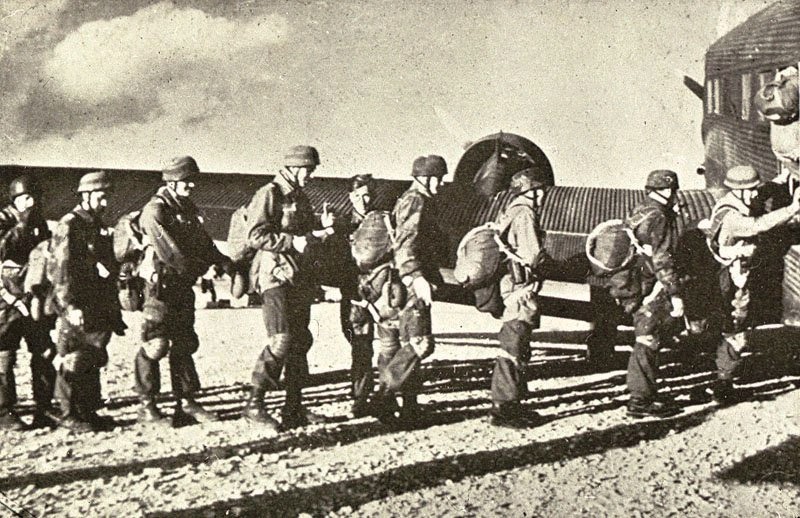
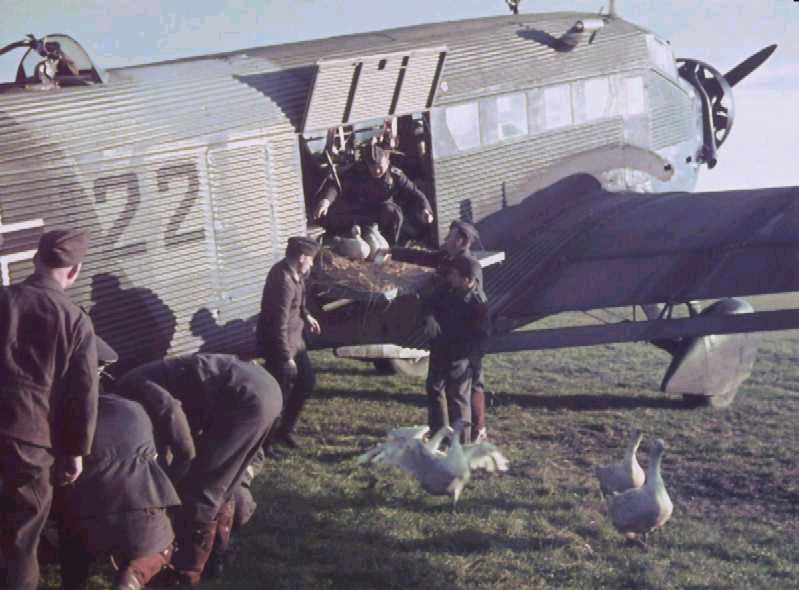
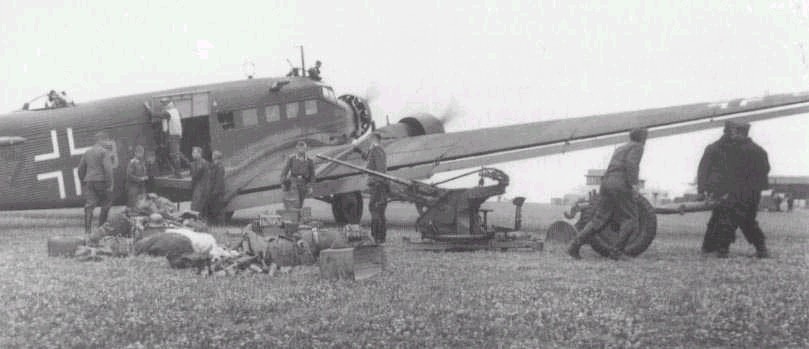
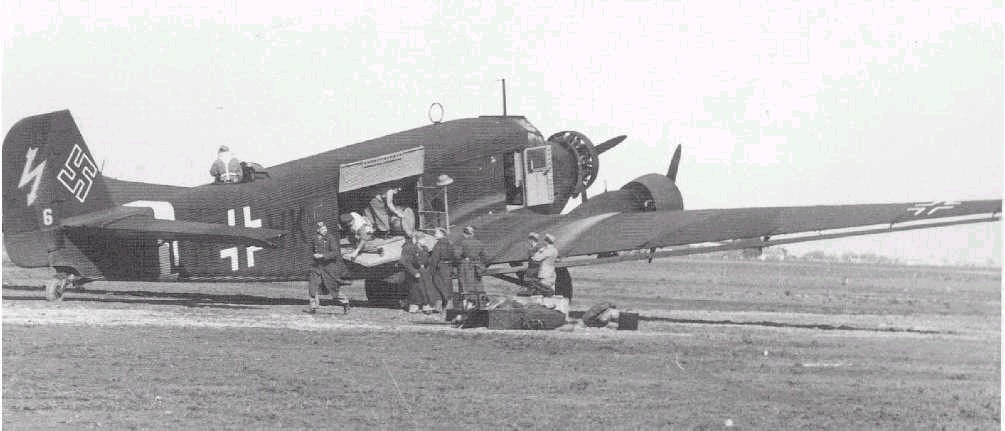
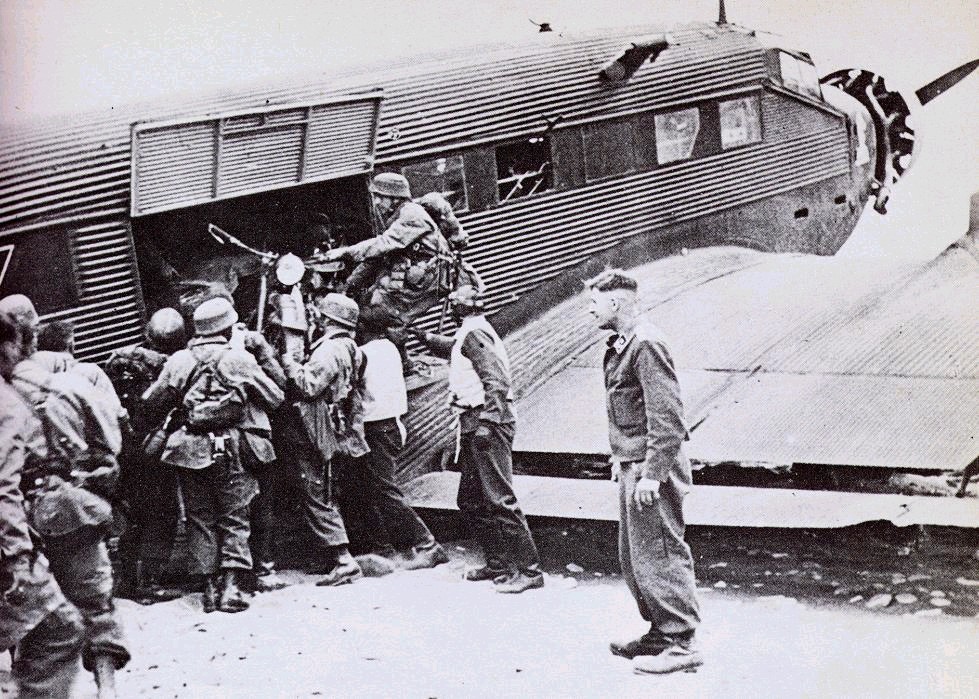
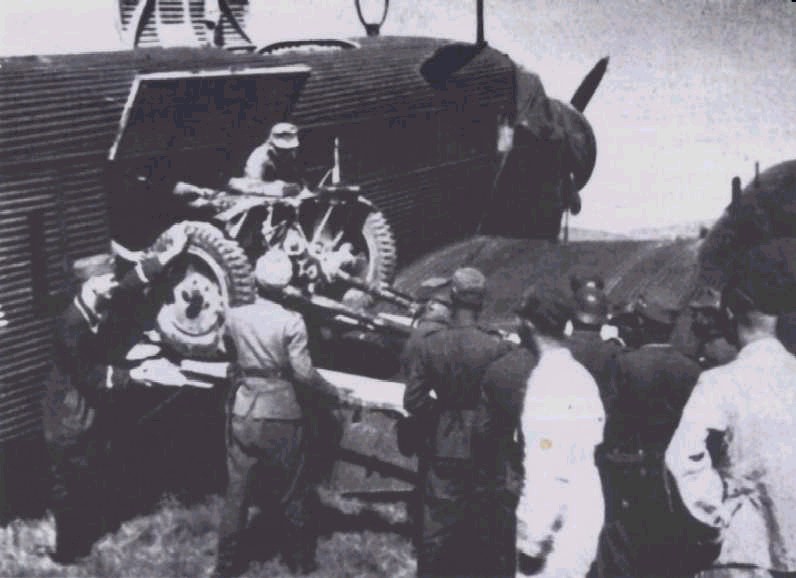
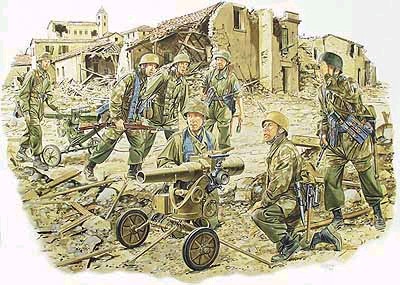
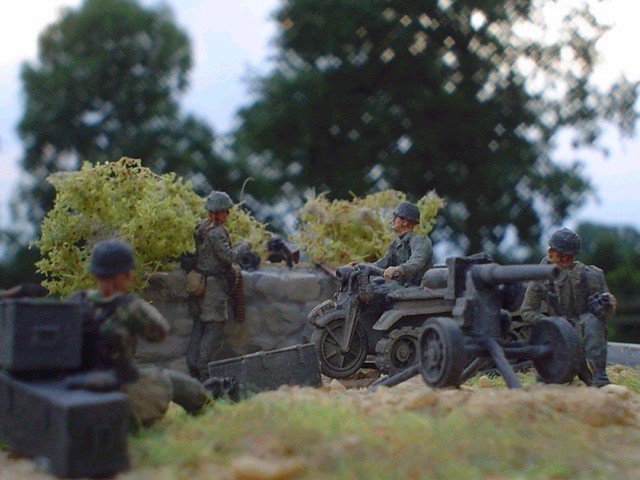
LG40 75mm RR in ACTION on Crete!
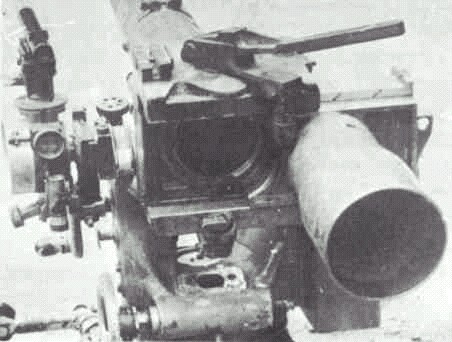
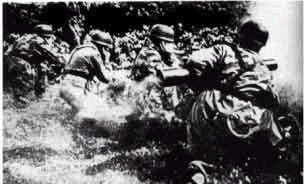
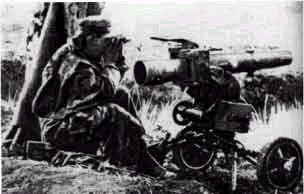
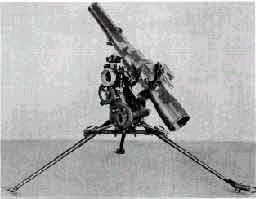
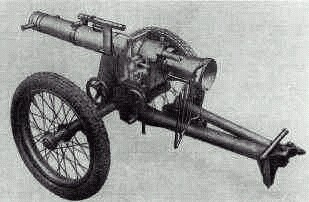
LG42 105mm RR in ACTION on Crete!
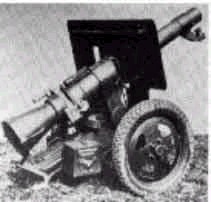

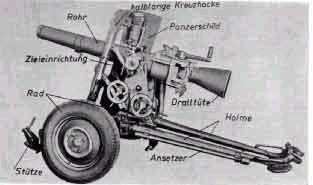
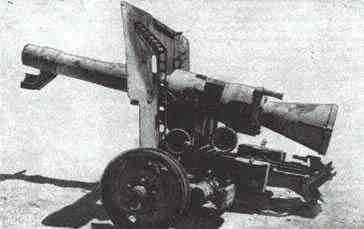
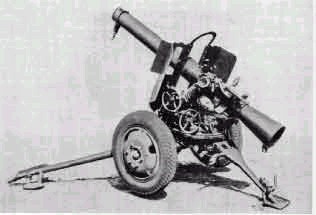
The Germans were deploying a new weapon on Crete: the LG40 Panzerabwehrwerfer 7.5, a 75mm recoilless rifle. At 320 pounds, it weighed only a tenth as much as a standard German 75mm field gun, yet had two-thirds of its range. The new gun could fling a 13-pound shell over three miles. Adding to the airborne units' firepower was the fact that one-quarter of the German paratroopers jumped with an MP40 submachine gun, often carried in addition to a powerful bolt-action Mauser K98k rifle. Moreover, almost every German squad was equipped with an MG34 light machine gun.
The Germans used color-coded parachutes to distinguish the canisters carrying rifles, ammunition, crew-served weapons and other supplies. Heavy equipment like the LG40 was dropped with a special triple-parachute harness designed to bear the extra weight.
The troopers also carried special strips of cloth which could be unfurled in pre-arranged patterns to signal low-flying fighters to coordinate air support and supply drops.
75mm LG 40
This is a light recoilless weapon designed for use with airborne forces. This weapon was in service in time for the airborne invasion of Crete where it proved to be successful. It is air dropped in two loads each contained in a wicker container. This weapon was also adopted for use with other light troops such as mountain infantry as its airborne origin made it satisfactory as a pack weapon. Like all recoilless weapons the LG40 has a substantial back blast creating a hazardous cone behind the weapon. The carriage is not designed for high towing speeds and no gun shield is provided.
|
Crew: 3 |
Ammunition: 7.5cm LG40 |
ROF: SS |
Introduced: 1940 |
|
Weapon Wt: 146 kg |
Ammunition Wt: 16.4 kg |
Reload: 2 |
Gun Shield: No |
|
Round |
DF Range |
IFR |
Armor Penetration |
|
AP |
215 |
N/A |
50mm (2 inches) |
|
HEAT |
160 |
8.9km |
? |
|
HE |
160 |
8.9km |
? |
105mm LG 42
The 10.5cm LG42 is very similar to the 7.5cm LG40 with the exception of the size of the weapon. It was also used during the invasion of Crete and proved its usefulness. The LG42 was also used by other light troops such as mountain infantry as it made a good pack weapon. The weapon and carriage are designed for rapid dismantling and assembly. The carriage is not designed for high speed travel but a small gunshield is provided for crew protection.
|
Crew: 4 |
Ammunition: 10.5cm LG40 |
ROF: SS |
Introduced: 1940 |
|
Weapon Wt: 389 kg |
Ammunition Wt: 35 kg |
Reload: 2 |
Gun Shield: Yes |
|
Round |
DF Range |
IFR |
Armor Penetration |
|
HEAT |
160 |
8.6km |
? |
|
HE |
160 |
8.6km |
? |
By the 24 May, the Germans were now being reinforced on a huge scale and had been resupplied to the point where they could begin to adopt conventional tactics supported by tactical air power and their own artillery. To the Allies' surprise, the Germans had brought artillery onto the island. This was unheard of in 1941, artillery being thought of as too cumbersome and heavy for airborne operations. The Germans had managed it by deploying one of the first recoilless guns seen in Europe. The recoilless gun had been invented by an American naval officer, Commander Davis during the First World War, and was very basic. Davis reasoned that if two guns were placed back to back and fired simultaneously, the recoil from both would cancel each other out. He made a gun with a single central chamber and two barrels facing in opposite directions. One barrel carried an explosive projectile, the other an equivalent weight of grease and lead shot. When the central cartridge was exploded the two projectiles were sent down their barrels at identical speeds making the entire mechanism free from recoil. The explosive shell went to its target while the wad of grease and shot disintegrated in the air. The Davis gun was purchased by the British and experiments undertaken to see if it could be used as an anti-submarine weapon but the war ended before the trials were completed. The German Rheinmetall company continued to experiment with the idea and eventually reduced it to a much simpler form. Reasoning that recoil could still be counterbalanced if the ejected 'countershot' was smaller but faster they found that the shell could be counterbalanced by a stream of gas moving at very high speed through a nozzle in the gun breech. The LG40 was of 75mm caliber, weighed 320lbs and fired a 13lbs high explosive shell to a range of 6.8km. The conventional 75mm gun of the German Army weighed 2,470lbs and fired the same shell to a range of 9.4km. Thus the recoilless rifle allowed virtually the same firepower as a conventional artillery piece with two-thirds the range but one eighth the weight.
The LG 40 was built in four parts, each capable of parachute decent without the need for special packing; the ordnance split into barrel and breech assembly, while a simple top carriage and a wheeled tripod assembly formed the rest of the equipment.
Although Rheinmetal were responsible for the basic research, both they and Krupp were given development contracts and both produced prototypes. The Krupp model used a simple side-swinging breech mechanism and was mounted on two motorcycle wheels, while the Rheinmetall type used a horizontal sliding breechblock and two small aircraft-type wheels.
The latter was the one accepted for service. Extensive use was made of light alloy in the mounting to save weight; and, to prevent the back blast from ricocheting on to the detachment, the elevation and traverse gears were interconnected so that the normal 360 degrees traverse was restricted to 30 degrees each way as soon as the elevation reached 20 degrees.
The firing mechanism was placed in a streamlined housing in the center of the jet venturi, so that a normal type primer in the center of the plastic case base could be used.
The danger area at the rear of the gun extended to 100 m (109 yds) for practice firing ot 50 m (55 yds) for combat firing; this, however, referred only to the actual jet blast, and stones and debris were disturbed some considerable distance beyond this. Firing instructions also emphasized the danger to the detachment members' ears from the blast, and recommended them to plug their ears tightly with clay or mud before firing. A total of 450 of these guns were made, 170 by Rheinmetall-Borsig at Dusseldorf.
Data
Caliber: 75 mm (2.95 in).
Length of gun: 750 mm (29.53 in).
Length of bore: 458 mm (18.03 in).
Rifling: 28 grooves, uniform right-hand twist, 1/52.
Breech mechanism: horizontal sliding block, percussion fired.
Traverse: 360 degrees below 20 degrees elevation, 60 degrees above 20 degrees elevation.
Elevation: -15 degrees to + 42 degrees.
Weight in action: 145 kg (320 lb).
Performance:
Firing standard high explosive shell weighing 5.83 kg (12.86 lb).
Full charge: velocity 350 m/ps (1,148 ft/ps), maximum range 6,800 m (7,434 yds).
Ammunition:
Separate-loading, cased charge.
Projectiles:
7.5 cm Gr 34 A1: fuzed K1 AZ 23, weight 5.75 kg (12.68 lb).
This was an high explosive shell, filled with a 90/10 mixture of TNT and aluminium powder.
7.5 cm Gr 38 H1/B: fuzed AZ 38, weight 4.40 kg (9.70 lb).
This is a hollow charge anti-tank shell.
These were the shells fired by the 7.5 cm Geb G.36.
7.5 cm Pzgr. rot: fuzed Bd Z f 7.5 cm Pzgr, weight 6.08 kg (14.99 lb).
This was an armor piercing high explosive shell of conventional pattern.
This was the shell fired by the 7.5 cm F K 16 nA.
Propelling charge
The charge consisted of a silk-cloth bag containing 1.21 kg (2.68 lb) of Digl Str P with a gunpowder igniter stitched to the bottom; this was carried in a cartridge case with an 85 mm (3.35 in) aperture in the base that was closed by a plastic disc. A percussion primer C/43 was screwed into the centre. The case-mouth was closed by a cardboard cup.
The design of the 75mm light gun relates to the recoilless rifles, in the breech of its stem is a nozzle for the release of solid-reactant gases outside, i.e., to the side, opposite to the direction of the motion of projectile. In this case the dynamic balancing occurs - stem with the shot remains fixed, thanks to which it is possible to forego the bulky and heavy antigravity devices. The development of recoilless rifles began in Germany in the middle thirties. They were necessary in order to ensure artillery for the Fallschirmjagers, they were called "light weapons" due to secrecy. One such weapon is the 75mm light gun, which was being used in the parachute divisions of the Wehrmacht against infantry targets and weapon emplacements. the first succesful use of the weapon was in the combat during the large-scale airborne operation on the seizure of Crete island in the spring of 1941.
The guns consists of following major portions: stem with the lock and the nozzle, upper machine tool with lift and swivel gears of guidance, lower machine tool with the tripod and tread with the cushioning of the sight mechanisms. The gun barrel consists of pipe- monoblock and breech, connected to the pipe with the aid of the sukharnogo lock. The lock is horizontal, wedge, which is opened/disclosed to the right. In the wedge of lock are openings for the release of the solid-reactant gases resultant with the shot back; the nozzle is fixed on the wedge. The upper machine tool poured from the light alloy revolves on the pintle of lower machine tool. Sectorial type lift and swivel gears are assembled on the upper machine tool. Lower machine tool consists of base, three feet and tread. Feet are hinged connected with the base of lower machine tool. In the firing position they are fixed with the aid of the stops. Rear feet are connected together upon transfer to the march position, and the nose wheel strut rises and is attached to the clip of stem. The tread consists of the tubular axle, in which is assembled torsion cushioning, and two disk wheels with the continuous rubber tires. The weight of gun in the firing position is 145 kg. For the landing by parachute method and for transportation on the drag harrows under the winter conditions the gun is divided into two parts (stem and gun carriage). The light weight of system gives a good maneuverability on the field of battle. The gun can conduct fire at the elevation from - 15° to 42° with the sector of horizontal field of fire 60°, and at the elevation from - 15° to 20° - with the sector of horizontal field of fire 360°. In this case is ensured the maximum range of shooting 8 100 meter. Ammunition to the 75mm gun consists of special fixed rounds with the HE fragmentation, cumulative and armor-piercing shells. Case used in these cartridges has a bottom of plastic with the nest for primer cup. The bottom of the case flies out when firing and thus it makes it possible for the part of solid-reactant gases to leave back through the nozzle. The HE fragmentation projectile with a weight of 5,7 kg has the initial velocity of 376 m/s, shooting is conducted on the distance of 8 100 m. The shaped-charge shell with a weight of 4,6 kg has an initial velocity of 364 m/s and a firing distance 6 800 m. It is capable to penetrate armor with a thickness of 50 mm. As all recoilless rifles the 75mm gun possesses such deficiencies as the disclosing action of the solid-reactant gases, which emerge from the nozzle, the presence from behind of the nozzle is hazardous zone as deep as 50m, and also the outgoing of the nozzle gases produces a strong sound, which can damage the eardrums.
The caliber of 75 mm
Initial velocity of projectile: 376 m/s (HE fragmentation) 364 (cumulative)
The greatest angle of elevation: 42 degrees angle of depression -15 angle of the horizontal
Field of fire: 60 degrees
The weight when emplaced: 145 kg
Rate of fire: 8 shots/min
Maximum range of shooting: 6 800 - 8 100 m
Armor-piercing ability with shaped-charge shells: 50mm

The Germans didn't have a means to carry their weapons and equipment attached to the individual paratrooper, here a German para actually has held an ammunition can in his hands from exiting the aircraft until a few seconds before landing he release it! The converted civilian airliner, the JU-52 could only 13 paratroops or 18 airlanded troops.
www.feldgrau.com/articles.php?ID=18
14 Containers for German Airborne Platoon
Because of the rather athletic forward landing roll necessitated by their parachute harness, the German paratrooper could carry little more than a pistol and some grenades on his person. Therefore, many weapons containers, called Waffenhalter, had to be carried and dropped. A single 40-man plus platoon of Fallschirmjaeger needed no less than fourteen containers just for weapons and a basic ammunition supply. The containers were carried either under the Wings or in a bomb-bay. Each container could hold over 200 pounds of equipment and the maximum loaded weight was 260 pounds. It was five long and about 16 inches square. The container had a crash pad at one end and the parachute was connected at the other end. Some containers were equipped with a pair of small wheels and a tow bar that could be clipped onto the container after the drop. This allowed the container to be towed from the drop zone. The number one priority of the troops upon landing was to find their containers. colored bands or other markings were used to aid retrieval by the correct units and to indicate which items the container carried.


The German paras did do one thing right--they airlanded LG40 75mm recoilless rifles from the right cargo door of their JU-52s which were decisive in blasting the allies off the island.
North African & Russian Air-Mech and Resupply Airborne Operations
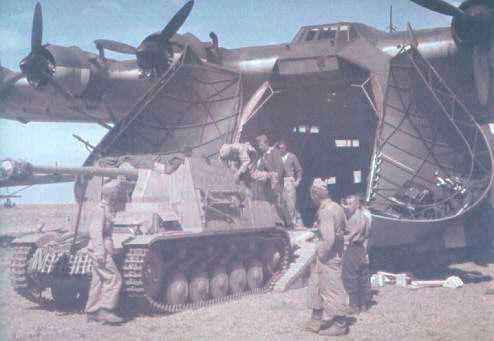
The British took 3 years to design and field their Hamilcar heavy gliders to fly in Tetrarch/Locust light tanks and Bren gun armored personnel carriers, the Germans designed and fielded Me-321 glider squadrons in under a year! In less than another year, they had a 6-engined powered version, the Me-323 in service. Keith Flint writes in Airborne Armour on pages 206-207, about how the Germans used their Me-323s in 1942 to do the world's first air-mech operation with tracked armored tanks:
They were not cleared for flight on instruments, and so could not be flown at night to avoid enemy interference.
Operations the Mediterranean began in November 1942 with the Gigants formed into Kampfgeschwader (z.b.V.) 323, with three groups of 6 aircraft plus a headquarters with three aircraft. The main task was flights from Italy to Tunis and Bizerta carrying supplies for the Afrika Korps. The Gigants usually flew in mixed streams with large numbers of Ju-52, three-engined transports, along with a large fighter escort. The missions continued through to April 1943, but losses to fighters en-route, and on the ground in Tunisia, eventually led to the withdrawal of the aircraft. The last straw was on the 22nd of April, when 14 out of formation of 16 Me-323s were shot down by RAF fighters, with another destroyed in a strafing attack on the airfield at Tunis. During December 1942, some Gigants had been moved to Russia to take part in re-supply missions to Stalingrad. Operations in Russia, after withdrawal of the aircraft from the Mediterranean, continued until at least May 1944, with main bases in Warsaw, Kecskemet (Hungary) and Focsani (Rumania).
The aircraft were assigned to Transport-geschwader 5 (Transport-wing 5), which consisted of two Gruppe, although according to William Green "the Messerschmitt transport was never available in really substantial numbers".[11] Production of the aircraft ceased in April 1944, and following continuous losses on the eastern front TG5 was disbanded in August 1944.
The Me-323 was used primarily as a normal transport aircraft, carrying supplies, men and fuel and evacuating casualties. There is evidence, however, that armoured vehicles were transported on at least one occasion in the Mediterranean. In Frank Vann's biography of Willy Messerschmitt he quotes the following letter to Messerschmitt regarding operations in November 1942:
The first Me-323 flew with an assault gun and the necessary ammunition to Bizerta immediately after our landing in Tunis. It unloaded there without any trouble and returned to its home base without any damage. It was this assault gun that we have to thank for being able to break through the ring of American tanks drawn up in a circle of 12 kilometres diameter around Bizerta. On the very first day 8 tanks were destroyed by it and on the next day that total went up to 28. More assault guns were flown over with the Me-323 and these opened up for the troops the possibility of driving the Anglo-Americans even further back.
...The transport of the assault guns was necessary because the Straits of Otranto had been completely mined by the enemy. This had the result that one of our transport ships loaded with tanks was blown up.
This information might be thought to dent the unique reputation of 6th AARR as the only unit to fly tanks into action in World War Two, but it must be pointed out that the German armoured vehicles were flying as part of a transport mission .rather than an assault landing. The type of assault gun is not mentioned, but they cannot have been the Wehrmacht's standard assault gun, the Sturmgeschutz III, as these vehicles would be too heavy for the Me-323. They would appear to have been one of the versions of the Marder self-propelled gun.
Recapture of the Dodecanese islands -Cos & Leros
1943, 9 September-15 November: Battalion-size German airborne assaults on three locations ranging from Italian Supreme HQ northeast of Rome (9 September), to attacks coordinated with amphibious assault forces on the Greek island of Leros (12 November) and the Italian island of Elba (15 November). All were successful. The German airborne assault during this time frame that captured the most attention, however, was the small but daring raid to rescue recently-deposed Italian dictator Benito Mussolini, then under guard by the Pietro Badoglio regime, which had moved Mussolini to a remote retreat in the Gran Sasso d'Italia mountains. Hitler picked Otto Skorzeny to lead the raid, which was to be carried out by a force of fewer than 50 troopers who would be landed on a small, rocky slope in six gliders. Five more gliders and their troops landed below and captured the hand-pulled cable car station. The mission successfully surprised the small force of guards at the resort and Mussolini was flown out after a hair-raising take-off down the slope by a small Storch observation aircraft.
1944, 17 December: The last German airborne assault of the war, and the only German night parachute mission. Troopers were to drop near Baraque Michel approximately seven miles south of Eupen and seize the intersection of three key roads for use by lead units of 6th Panzer Army in the German Ardennes offensive. For the drop, 90 x JU-52s were dispatched, most flown by inexperienced troop carrier crews. German troop carrier had been so depleted by operations on the Eastern Front that only about half of those available had any combat experience-none were trained in instrument flying, and none had ever flown a night drop. Ten aircraft were shot down by Allied gunners, and most of the rest got lost.
Hungarian Paratroops
http://belgiumcongo3.bizland.com/wwiaustrohungariancollectorsbooksandmore/id11.html
The Death Heads, Hungarys Airborne Forces 1938-1945
By Michael M. van Lauesen
Parachute Forces
In 1938, the Hungarian Ministry of Defense decided to create an airborne infantry force the, "Ejtoernyos" (paratroopers). A parachute test center was established on Szent Endre, an island in the Danube river near the capital city of Budapest. Even though parachuting was in it's infancy in 1938, many enthusiastic Hungarian army infantry NCOs and officers volunteered to join this new unit. Parachutes and other airborne equipment were purchased from all over Europe and from the USA. The Italian Salvadore parachute, the German Schrodor parachute, and the U.S. Irving parachute were all utilized by the Hungarians. This elite, special unit made many parachute drops with the newly acquired equipment from WW1-era Italian Caproni 101 aircraft.
Later, in 1939, the Hungarian army developed its own locally-manufactured airborne equipment, knee and elbow pads and a jump smock, as well as the H-39M parachute. The Hungarians also updated their aircraft inventory with the Savoia-Marchetti SM-75, purchased from Italy, and other modern aircraft.
Hungarian Paratrooper training at Papa airfield 1940
Hungarian para's load their gear, Veszprém Air Field, 1941
The Hungarian Army Chief of Staff was impressed by the first training exercises of the paratroopers and recognized many practical applications for the new force within the regular army. The Hungarian army command expanded the paratrooper training program in 1940 and moved its location to the Papa Airport, where it established a standardized paratrooper school. The Hungarian paratroopers comprised one battalion of three companies with a total nominal strength of 410: 30 officers, 120 NCOs, and 250 enlisted men. The first operational battalion was soon ready in 1941.
In April 1941 the German army wanted to use Hungary as a jumping off point for their invasion of Yugoslavia. Permission was granted by the Hungarian authorities for the Germans to pass through Hungarian territory to launch their attack. The Hungarian army was indecisive in regarding their role. The Hungarian army leadership waited until Croatia, now an autonomous region of Yugoslavia, declared its independence on 10 April 1941. Their was much protest in the Hungarian military establishment against attacking the new Croatian state, a country that had not acted against Hungary.
Hungarian Paratroopers linking up with the Mobile Corp, April 1941
When the Hungarian troops started to invade Croatia on 11 April 1941, they attacked the Batchka region. The Hungarian parachute battalion was placed on alert for possible deployment and kept in reserve by the Hungarian 3rd Army (commanded by Colonel-General Novák). When the Hungarians attacked from the north, the Yugoslav troops retreated from their first defensive line along the border with Hungary, behind the Franz Josef Canal. The Canal divides the Batchka area and the two canal bridges at Szenttamas and Verbasz had to be taken before the Hungarian Mobile Corps (Commanded by Major-General Béla Miklós) could occupy the rest of the region. The Hungarian Parachute Battalion was to be dropped behind this line, approach the bridges from the rear, and seize them. The Hungarian airborne forces made their first operational combat jump over the northern Yugoslavian district of Delidek on April 12, 1941. After the drop, the Hungarian paratroopers marched over 30 kms to their objectives at night, then took the bridges after brief fighting with Yugoslav forces.
Following the invasion of northern Yugoslavia, in June 1941, the Hungarian paratrooper battalion was named in honor of Major Árpád Bertalan, a pioneer of Hungarian parachuting. Major Bertalan, a winner of the Order of Maria Theresa in W.W.I. (Honvéd -IR.4, awarded ten years after the action on 25 October, 1927), Austria's highest award for valor, and the Parachute Battalion's first commander, died tragically in a plane crash on April 12, 1941 the circumstances of which remain somewhat controversial. The plane crash that claimed Major Bertalan's life occurred at Veszprém Air Field, to which operations had been shifted because rain had left the runway at Papa Airport, composed of compressed dirt and gravel, too muddy for use. The airfield at Veszprém was the only military air base with a cement runway, so it was used by the paratroopers that day for the airborne assault on Yugoslavia. The plane carrying Bertalan was over loaded with equipment and crashed as it was trying to take off: Bertalan returned to the crash site and tried to retrieve equipment and ammunition from the wreckage. Bertalan, the pilot, and 22 paratroopers died as the plane caught fire and exploded. The other three planes involved in the operation, dropped the remaining paratroopers: 3 officers and 57 men, at Ujverbász that same day.
Starting in late 1941 a new commander was nominated for the elite Hungarian paratrooper battalion, Colonel Zoltan Szügyi. Szügyi had a very distinguished record from the First World War and held many important infantry commands before being appointed as the new officer in charge of the Hungarian paratrooper force. Szügyi was a decorated solider in the First World War in the Austro-Hungarian Army, he started his military career as a private and then earned rapid promotion to Sergeant and then finally in 1918 to Lieutenant. General Szügyi decorations included the following Austro-Hungarian awards, the Order of the Iron Crown with war decoration and swords, The Military Merit Cross, 3rd Class with war decoration and swords, the Golden Bravery Medal (this was the highest award for valor an enlisted man could receive, date of award: May 15, 1915). The Silver Bravery Medal, First Class and the Silver Bravery Medal, Second Class, the Silver Military Merit Medal with swords, the Bronze Military Merit Medal with swords and the W.W.I German Iron Cross, Second Class. In the Second World War Szügyi was to further receive the German Iron Cross, First Class and the German Knights Cross (January 6, 1945).
Hugarian paratroopers training jump, Papa Airport, 1942
In 1942 and 1943, Colonel Szügyi and a small cadre of officers and NCOs of the airborne force were moved to the Russian front in an advisory role, for special operations of Hungarian infantry against the Russian army. In 1943 Szügyi help conduct and advise equipment, arms and medical supply drop operations in the Ukraine to relieve elements of the Hungarian Second Army that had retreated from the Don River front following the Axis disaster at Stalingrad. The Hungarian air lift brought relief to many trapped Hungarian military units, allowing the units to retreat and escape from the Red Army.
In August 1944, Romania, Germany's ally but Hungary's opponent in many past conflicts, defected from the Axis powers and joined forces with the Russian Red Army, thus endangering the southern flank of the Axis forces in the Balkans. With the German occupation of Hungary starting in March 1944, many German and Hungarian units rushed to shore up the southeastern flank of the collapsing Axis eastern front. The Hungarian paratrooper battalion was rushed to meet the threat to Hungary's southeast border posed by their new opponents, the Romanians.
Colonel Szügyi, set up a strong defensive perimeter in the Carpathian mountains, the last natural defensive position to the east, along with many German units of the Wehrmacht. Out numbered 10-to-1, Szügyi's paratroopers put up a valiant struggle before being overwhelmed by the combined forces of the Red and Romanian armies.
Many survivors of the First Hungarian Paratrooper battalion, along with personnel from other units, including the Regents Body Guard and college students of the Levente Youth, were formed into the St. Lászlo Division (named for the victorious medieval king, Saint Ladislas I) on 20 October 1944. The Szent Lászlo Division was put under the command of now General Zoltan Szügyi (Szügyi having been promoted to Major General in October 1944 to lead this new, elite division). While the St. Lászlo division comprised three light infantry battalions, its strength fell far short of that of a regular division. In November 1944, the St. Lászlo Division was moved to the lake Balaton area, trying to stem the Russian south-west advance, after ten days of brutal combat the St. Lászlo was pulled back to defend Budapest, the battle for the Hungarian capital city was soon to follow.
On December 31, 1944, Budapest was surrounded by the Red Army, the city surrendered officially to the Russians on February 12, 1945. The Red Army and their allies then began their steam roller offensive west, pushing the remaining Hungarian forces and their German allies back into Austria. On 10 May 1945, General Szügyi and the remaining paratroopers of the St. Lászlo Division surrendered to the British army. According to General Bor (Lieutenant-Field Marshal Jenö nemes halmaji Bor),* there were many Hungarians who wished to return to their homeland, in 1945. Although the Russians had overrun Hungary, there was not yet a Communist regime in place, and there may have been hopes that Hungary's independence would be preserved once the war was over and the Allies withdrew from their respective zones of occupation.
In hindsight, of course, this was unrealistic when considering the Russians, but Hungary didnt have the "benefit" of experiencing a prior Russian occupation. Russia continued as the de facto governing authority over the central European countries it had liberated from the Germans by installing Communist regimes in each that, effectively, sympathetic to the government of the Soviet Union and Russian Communism and were controlled by Moscow.
Ultimately many high ranking Hungarian military officers in the west were turned over to the Red Army or arrested by either the Soviet authorities and transferred to the Hungarian Communist authorities. Many Hungarian officers were put on show trials, deported to Siberia or executed, by the new Hungarian or other Communist regimes in Central Europe, (Lt. General Szombathelyi, C n C of the Hungarian Army in 1941, was turned over to the Yugoslavian authorities in 1945, put on a show trial in Belgrade and executed by impalement in 1946).
General Szügyi was no exception. Delivered to the Red Army by British military authorities in May 1945, General Szügyi was tried by the new governing body of Hungarian Communists who found him guilty of treason and with collaborating with the Hungary's Fascist government (The Arrow Cross). He was sentenced to life in prison. Szügyi signed several false confessions, so it is reasonable to believe he was subjected to torture by his captors.
Detail photo of the 2nd type basic Hungarian para wings in gilt and chromed finish
Sources:
Anyakönzvi Lap (Army Daily Register), Szügzi Zoltan, 1941-1945.
Hadtörténelmi Levéltár (Hungarian Army Archives) Fourteen pages of documents from the 1 rst. Parartrooper Batl., to include 4 pages of awards issued to the unit in 1944, 3 pages of after action reports from 1941. Also 8 pages from the Magyar Honvéd Miniszter Katona Politikai Ostzalz (Elhártó Alosztálz), from 1947.
The Hungarian Paratroopers 1938-1945. Huszár János. Privately published, Budapest 1999.
A magyar katonai felso vezetes 1938-1945
The Royal Hungarian Army Gazette. 1940-Order a 1042/ein 2/r 1940 sz. körrendelethez.
Photos:
B&W photos courtesy of the Hadtörténeti Múzeum, Budapest.
Color detail photo of basic Hungarian Paratrooper badge: Private collection.
Date: April 12, 1941
Unit: Hungarian Bertalan Paratroop Battalion
Operation: ?
Troopers: 700
Country: Yugoslavia
Drop zones: Northern Yugoslavian district of Delidek
Aircraft: Savoia-Marchetti SM-75
Equipment/supplies air-delivered: weapons, ammunition, food, water, medical supplies (wing bundles)
Type Air delivery: Daylight Static-line parachute mass tactical jump, LVAD
When the Hungarian troops started to invade Croatia on 11 April 1941, they attacked the Batchka region. The Hungarian parachute battalion was placed on alert for possible deployment and kept in reserve by the Hungarian 3rd Army (commanded by Colonel-General Novák). When the Hungarians attacked from the north, the Yugoslav troops retreated from their first defensive line along the border with Hungary, behind the Franz Josef Canal. The Canal divides the Batchka area and the two canal bridges at Szenttamas and Verbasz had to be taken before the Hungarian Mobile Corps (Commanded by Major-General Béla Miklós) could occupy the rest of the region. The Hungarian Parachute Battalion was to be dropped behind this line, approach the bridges from the rear, and seize them. The Hungarian Airborne forces made their first operational combat jump over the northern Yugoslavian district of Delidek on April 12, 1941. After the drop, the Hungarian Paratroopers marched over 30 kms to their objectives at night, then took the bridges after brief fighting with Yugoslav forces.
Following the invasion of northern Yugoslavia, in June 1941, the Hungarian Paratrooper Battalion was named in honor of Major Árpád Bertalan, a pioneer of Hungarian parachuting. Major Bertalan, a winner of the Order of Maria Theresa in W.W.I. (Honvéd -IR.4, awarded ten years after the action on 25 October, 1927), Austria's highest award for valor, and the Parachute Battalion's first commander, died tragically in a plane crash on April 12, 1941 the circumstances of which remain somewhat controversial. The plane crash that claimed Major Bertalan's life occurred at Veszprém Air Field, to which operations had been shifted because rain had left the runway at Papa Airport, composed of compressed dirt and gravel, too muddy for use. The airfield at Veszprém was the only military air base with a cement runway, so it was used by the Paratroopers that day for the airborne assault on Yugoslavia. The plane carrying Bertalan was overloaded with equipment and crashed as it was trying to take off: Bertalan returned to the crash site and tried to retrieve equipment and ammunition from the wreckage. Bertalan, the pilot, and 22 Paratroopers died as the plane caught fire and exploded. The other three planes involved in the operation, dropped the remaining Paratroopers: 3 officers and 57 men, at Ujverbász that same day.
Japanese Army/Naval Airborne Force actions:
1. Menado, Celebes Island, 11 January 1942
When the Japanese declared war on the Dutch government in exile, they launched their first Airborne assault against the airfield at Menado, Netherlands East Indies, 11 January 1942, using their airborne elements in a slightly different way to the European's army concept. The offensive thrust into the vast island studded South West Pacific needed airfields for the limited-ranged land-based warplanes. One of the main objectives was to secure the airfield quickly using airborne combat forces, and then to support the amphibious invasion. Starting from 11 January-23 February, a reinforced battalion, the Yokosuka Special Naval Landing Force, seized an airfield from Dutch forces near Manado in the Celebes on 11 January as an amphibious force landed nearby. Troop carrier aircraft used were the Mitsubishi Ki-57, an airplane that resembled the DC-3, though smaller, and a few of the similarly-sized Kawasaki Ki-56s (Japanese-built Lockheed Lodestars). The field was used by Japanese aircraft to extend the range of protection provided to their navy as the Emperor's forces pushed through Indonesia.
At Menado, the amphibious assault was conducted first and supplemented by the Airborne drop as a way of introducing superior numbers to the battle area, particularly the enemies rear, and to take the objective. The drop was conducted by the 1st Special Landing Unit, also known as 1st Yokosuka SNLF, consisting of two companies commanded by IJN Commander Toyoaki Horiuchi. The first wave was air-lifted from Davao in the Phillipines by 28 transport planes of the 1001st Daitai, air carrier battalion, operating G3M aircraft. The Japanese parachutists jumped from a low altitude south of the city, at about 0900 hrs, against the Langoan airfield. This aerial assault caught the 1500 Dutch defenders, and their military high command, on the Minahassa peninsula completely by surprise. As what thinnly dispersed Dutch colonial defence forces were available were engaged against the sea-borne invasion since dawn four hours previously. When the 324 Japanese parachutist descended they were fired upon by KNIL troops defending the outer airfield perimeter. One Japanese aircraft was reported lost including the cargo of Yokosuka marines. The weakly armed colonial KNIL defenders were quickly overrun, isolated and eliminated by the extra automatic firepower the Japanese parachutists were able to jump with, and collect in dropped canisters found. The Japanese parachuted formation repulsed several piecemeal Dutch counterattacks, losing some 130 Paratroopers dead and wounded. The airfield was secured by 1030 hrs, then the Japanese overall combined commander immediately began to land fighter-aircraft and use the captured airfield to support the land operations of the sea-borne invasion. The next day, 12 January, a second wave of parachutists consisting of 185 men of the First Yokosuka air transported by 18 x G3M air transport equivelants were dropped in, onto the same drop zone reinforcing the already occupied Langoan airfield. The Dutch defenders and command control had been shaken by the early amphibious invasion was kept off balance by the shock of the paradrop. Once off-balance in a planned defensive the Dutch were more easily defeated breaking their will for organised resistance. The combination of the seaborne assault and the airborne attack speeded the unpredictability of the decisive indirect approach dislocating the opponents dispositions and frame of mind. The depleted 1st Yokosuka suffered up to 70% casualties from all causes eliminating the parachute infantry marine unit as an effective offensive force.
2. Palembang, Sumatra Island, 14 February 1942
The combined operational success on the Celebes Island peninsula led to the brigade-size Army Airborne force being dropped on Sumatra island, over Palembang. On 14 February, after establishing air superiority, Japan's 1st Parachute Brigade staged two drops on Palembang, Sumatra: one at the airfield and another at the oil refinery. Though the airfield was taken quickly, fierce fighting continued near the refinery for over a day until Japanese airborne forces again prevailed. On 22 February about half of the Yokosuka Force was used to capture the Dutch-held airport at Penfoei, about 20 miles east of Kupang on the island of Timor. The following day the balance of this reinforced battalion jumped into the same location, subsequently moved toward Kupang and captured many Dutch and Australian prisoners. In all three instances a smaller force of airborne troopers surprised and defeated a much larger force of defenders-a hallmark of successful airborne operations. The Japanese military, however, did not realize the potential of airborne warfare until it was too late in the war for the required training and buildup to occur.
This task was assigned to the Japanese Army 1st Parachute Force, and in particular the Parachute Raiding Regiment, a four company formation of 425 Soldiers, under the command of Colonel Sei-ichi Kume. The Palembang operation consisted of the 2nd Paratroop Regiment, other sources call it the 2nd Raiding Regiment, either way, this was the second outfit ready for the parachute operations. The 1st Raiding Regiment remained at Haikow Field on Hainan Island. The first wave consisted of about 270 paratroopers under command of Major Niihara, originating from the captured airfield at Kahang in occupied Malaya, dropped above Palembang, and P1 the airfield, an hour and a half after dawn on 14 February 1942. Airlifted in 34 x Ki-57's from the 1st, 2nd and 3rd Chutai's, under the overall air command of Major H. Shinbara, plus seven more Ki-56 carrying supplies to be dropped. This Airborne force was protected by elements of the heavy bomber 98th Sentai, with escorts from the 59th and 64th Sentai's. British Hurricane fighter aircraft were unable to intercept the aerial armada, due to the lack of range for communications, as the RAF were escorting the bombers on a raid against the Japanese seaborne invasion fleet. Japanese air transport losses were slight and the descended parachutists upon landing attempted to rush the objective but were repulsed. The Japanese Army stormtroopers then set up a roadblock with overturned vehicles to stop mobile enemy reinforcements and infiltrated towards the aerodrome defenders, close infantry combat became the order of action. Another paradrop landing took place at Pladjoe, two hours later, 60 men in 12 x Ki-57 from the Malayan occupied Kluang airfield, were dropped at 0930hrs from 600feet on a line several miles west of P1 near the refineries, under the command of Lt. Hirose Nobutaka. These stormtroopers were detailed to secure the oil refiner ies, had come down in a swamp and were hard pressed to achieve their objective on the first day. Another small jump by 30 men from six Ki-56 under Colonel Sei-ichi Kume commander of the Parachute Brigade, landing southwest of P1 airfield.
Japanese casualties were heavy, upward to 80% of those dropped. They did succeed in capturing Pladjoe, but were hard pressed to control and secure the other objectives. The next day, 15 February, around noon midday, the last jump of 94 Japanese Army parachutists over P1. This small parachute unit was under the command of Lt. Ryo Morisawa and flown in nineteen air transports. The allied losses sustained in the close infantry fighting, and rumours of further paradrops by enemy stormtroopers, coupled with general disorganization opposing the enemy airborne assault led to an allied general withdraw. When the last echelon of Japanese Paratroopers descended, reinforcing the remnants of those on the ground, the allied rearguard defenders were finally driven off. That afternoon the reinforced IJ Army airborne unit marched into Palembang town, as the scratch amphibious relieve force, elements of the 229th Regiment, 38th Division, moving up the Musi river, using the water course for a highway, linked with the forward p aratroopers. Again the main objective was the airfield, as well as the secondary and diversionary objective, the much precious oil refineries at Sungeigelong and Uyodiraff near Palembang. Only this time the Airborne mission began two days prior to the amphibious phase of the operation, that was delayed by an abortive allied fleet action, threatening the seaborne invasion transports. Which were also attacked mercilessly by the allied airforces in Buntok Strait. The Japanese paid a heavy price in troop laiden landing barges for not locating the airfield P2. Yet military surprise multiplied the outnumbered Japanese Paratroopers to neutralize the airfield P1 and disrupt demolition of the refineries. Although battle damaged and still isolated fighting going on, their objectives had been reached by nightfall. The combat depleted Army Paratroopers held for longer than the required 24 hours and returned to their base after two weeks of operations.
3. Dutch West Timor Island, 20 February 1942
In another airborne-launched Special Naval Landing Force operation, the 3rd Yokosuka, airdropped over Dutch West Timor repeating earlier Japanese offensive successes, although it was a high price to pay in specially trained infantry parachutists. The 3rd Yokosuka SNLF (Lieutenant Commander Koichi Fukumi), numbering about 630 troops, trained especially as air-lifted infantry to support amphibious invasions, were planned to be dropped over Usua and to cooperate with the ground attack on the airfields by the Japanese Army formation. Early in the morning of the 20 February the first wave of Japanese Paratroopers, about half of the battalion, some 308 men were air-lifted by the 1001st in 25 x G3M from Kendari airfield. The remainder of the Yokosuka Paratroopers were held in reserve, to be deployed as required. By 0800hrs the Flores Sea and Lesser Sunda islands disappeared behind the horizen, the Japanese Airborne marines checked and re-checked their parachutists gear as the delivery aircraft arrived over Dutch West Timor and "these thumping big planes circled around the crossroads at Usapa Beser and Penfui" to get their bearings. The first contingent of the 3rd Yokosuka were dropped near Usua, and quickly overwhelmed the rear service troops defending supplies and stores at selected dump sites. Reports had been received by various communications that hundreds of Japanese Paratroopers were landing approximately five miles north-east of Babua. Astride the only road into the centre of the island cutting the Australian and allies ground forces from the main ammunition dumps, medical facility, main supply storage, and most important the withdraw route into the islands interior away from large enemy force advancing towards Koepang. The amphibious landings were at three points over a six mile spread near the Paha river mouth on the south coast, and supported by light tanks, had drawn the Australian mobile reserve away from the vicinity of the paradrop zone.
An eyewitness to the Japanese jump was at a point on the Tjamplong road where he could look down on the wide flat valley below that led to Koepang and the airfield at Penfoi. He saw several flights of low flying twin-engined aircraft heading along the valley towards the airfield, noticeable were the quietness of the enemy aircraft motors. Almost immediately the warplanes disgorged hundreds of parachutists, a great cloud of white with a spreckle of different coloured parachutes that identified the rank of the stormtrooper, or the package of supplies the chute supported. Such an awe-inspiring sight the eyewitness, an RAAF pilot who escaped from Timor rescued by an U.S. submarine, could only utter a quick prayer "God help Australia!" Japanese parachutists were shot as they hung from their multitude of coloured chutes while descending to earth in the gentle breeze. An advance party of Paratroopers entered Babua at 1050hrs and met stiff resistance from two understrength ad hoc platoons of Australian Soldiers armed with only rifles, pistols and Australian issued bayonets, even more lightly armed than the Japanese. After suffering severe casualties the Australians were forced out of the village early in the afternoon. Here two Australian sappers from the pioneers platoon, 2/11 Field Company, manning a light machine gun prevented the paratroopers from crossing the main road at Babau. This resolute delaying action for nearly three hours prevented the further rapid penetration by the Japanese down the narrow road to Koepang and the airfield while the mobile reserve was brought back to this rearward frontline. The Australian mobile reserve, "D" Company, after much delay elsewhere, finaly attacked Babua at 1630 hrs from the west. The paratroopers held until an Australian platoon forced its way through the maize fields into the eastern side of the village, then the main attack went in, the two Australian platoons were able to advance the frontline to the centre of the village market under support from large caliber mortars and heavy machine-gun fire.
A considerable number of paratroopers were killed in this action, Japanese point 38 pistols were recovered and many enemy automatic weapons were prized as trophies. The Australians found the enemy "all dressed in green uniforms," armed with .258 carbines (6.5mm), numerous .258 light machine-guns, and what looked like 2-inch mortars (50mm), which were oversized grenade launchers. The Australians also were surprised at the tall stature of the Japanese parachutist marine, by no means of the dimuniative height most thought all Sons of Nippon to be, and on how heavily-armed and well-equipped these dead Soldiers were. Yet enemy automatic machine-gun fire from concealed positions outside the village made the objective untenable and as twilight gave way to the darkness of the night the Japanese Paratroopers were seen to be infiltrating into the village. Japanese voices could be heard all round, a bugle was blown to rally or direct the paratroopers and the Australians wisely withdrew to Ubelo for a more defensive postu re. The next day Japanese commanders had decided to land their extra paratroopers when they realised the Australian column was escaping eastward on the main road into the interior of Timor. This second drop consisting of 185 men in 18 x G3M came in low north of Babau moving south, the delivery aircraft spitting out Paratroopers like green peas from a pod, with some coloured chutes intermingled with the clouds of white ones. Japanese control of the air enabled them to deliver another wave of parachutists, virtualy over the same drop-zone area as the previous day.
The Japanese Paratroopers took advantage of the night cover to move a number of snipers into forward harrassing positions. The next morning the withdrawn Australian infantry company began an ordered attack again at 0530hrs. This infantry counter-attack was halted for sometime, until the lone green clad paratrooper in a maize field on the side of the road was eliminated. One dead Japanese 3rd Yokosuka marine had ridden up to his position on a pushbike and had two little flags to signal communications to his unit. Two other Japanese Paratrooper marines who were unable to be seen, as they lay in a dip firing machine gun and a little mortar, were eventually blown out by Australian large calibre mortar fire. As the forward push by the Australians was in progress an reinforcement company made a quick move around the left flank, again ejecting the enemy from the maize fields and entered Babua clearing the village of organized enemy groups. In one building, it seemed to be the enemy HQ, as a high ranking paratrooper and ten other Japanese stormtroopers were killed. The decimated airborne troops stayed close to the allied forces retreating column, at one time harassing an anti-aircraft gun that moved too far from the van-guard until driven off by a platoon of Australian infantrymen. The British bofors unit had shot down fourteen enemy aircraft and scored several successes on twin engined bombers during the two days of anti-airborne operations, "also brought down a flying boat carrying paratroopers" as mentioned in the diary of British officer Lieutenant C.W. Scott. The delivery aircraft on this occassion could have been an IJN transport H8K2-L Seikuu flying-boat, codename Emily.
The Yokosuka SNLF had also been reinforced by an infantry company, and a mountain gun, from the 228th Regiment, that joined the marine parachutists defence in delaying the Australian columns withdraw. Here the Japanese plan of conquest for Dutch West Timor changed, the support attack on the airfield was sheathed and a blocking battle occurred to stop the escape of enemy soldiers. The Australian 2/40 Battalion group on the road to retreat, began to advance in battle against the paratroopers and was temporarily stopped by the Japanese navy & army contingent that had dug in on the high ground straddling the road at Usua on the bridge across the Amaabi river, covered by machine guns, mortars and a mountain gun on the ridge. The attacking Australian Company, having been involved in two days of combat, moved forward up the high ground to almost the top when all hell broke loose. Many Australians were pinned by automatic machine-gun fire, the attack had failed. A larger and heavier armed battlgroup was required than infantrymen of the depleted D Company. The Japanese put down flanking fire to prevent Australian efforts to organise a three company assault and seemed to be everywhere in small groups. Some wayward Japanese paratroopers had even been seen crossing the road by drivers of convoy vehicles moving along from Babau. The Australians by late afternoon had gathered their strength and launched a heavy mortar bombardment that blasted the summit and the reverse slope of the ridge for fifteen minutes, obscuring the objective in dust and smoke. The stalled Australian advance was launched again. Under heavy fire Australian sappers cleared the roadblock, B Company covered A and C Company frontal attacks, and Vickers machine guns mounted on Bren carriers joined in. From then on the Australian casualty count started to mount under heavy enemy small-arms fire and grenade bursts as they scaled the heights of Usua ridge. When the Australians reached the summit of the ridge the Japanese were still entrenched, and badly shaken, the Aussies with fixed bayonets charged overrunning the first trench line and an action of fire and movement ensued. The Japanese roadblock had been dislodged and the remnants dispersed, organised resistence had been broken by taking the enemies main defensive position. It took all told an hour from the bombardment till the convoy trucks began to pass over the bridge. Only isolated pockets of marine paratroopers remained to fend for themselves until the enemy trapped soon capitulated.
There were no abundant numbers of troop carriers available to the Australians, nor enough motor vehicle transport overall. The Dutch defending the western approaches to Koepang were otherwise engaged. As the Japanese commander's plan was to defeat and break the static position defenders, as they had overcome other allied defensive arrangements on Indonesian archipelago islands elsewhere since December 1941. Then to gain a naval base and secure the supply line by sea and air. Also there was no mobility to mass heavy allied forces against the lighly armed parachutists, woeful communications and the single narrow road restricted a rapid response, nor did the Australians have any air assests available. The next day it was likely to the Australian commander Lieutenant-Colonel Leggatt that paratroopers would block the allied column along the escape route, and apparently, with a captured Japanese map at hand, that the base at Champalong, with which there has been no communications, was assumed in enemy hands. Also amphibious landed strong enemy elements were at Koepang and advancing swiftly, supported by air attacks operating from the captured airfield, towards the sound of battle behind the Australian led allied column. The victory at Usua ridge came too late in the day for the Australian commander to exploit and all this added to exhausted thoughts of capitulation. The Japanese officials stated to the captured Australian commander that there were only seventy-eight survivors of the parachute dropped 3rd Yokosuka, most of the 550 dead paratroopers were counted as apparantly killed by mortar explosions. And the Japanese Army detached infantry company, which had speedily moved overland from the south coast to join them, had perished during the hard fought action against the enemy at Usua ridge. The show of aggressive military strength, planning and preparedness clearly demonstrated Imperial Japan's superior capacity to wage an offensive war. The principal of surprise was exploited to the utmost augmented by rapid and v igorous movement preventing the enemy from recovering and the chance to react on terms more favourable. Overall Japanese Army and Imperial Navy special airborne forces accomplished deeds of duty in their capacity as shock parachute troops in the offensive thrust into the South East Asian islands of the South West Pacific.
1944, 6 December: The last Japanese airborne assault mission of the war arose out of the Japanese High Command's decision to vigorously contest Leyte in an attempt to prevent the USAAF from establishing major bases on the island. The subsequent Japanese buildup on Leyte was countered in part by placement of Gen. Joseph M. Swing's 11th Airborne Division into the central mountains with the objective of pushing west to the coast. From one of several makeshift airfields around Burauen, Swing staged a creative resupply, transport, and evacuation operation for his troopers, using 11 available L-4 Piper Cubs, which had to fly many trips per day to keep up with divisional needs. In an attempt to strike at the division and the developing airfields, the Japanese assembled 350 highly-trained men of their Task Force Katori Shimpei, who were to drop on five different airfields in the Burauen area, then link up with two infantry divisions that had been reduced to battalion size or less by previous battles. Notice of a one-day delay was not received by one of these divisions, so a portion of the ground attack preceded the airborne assault by one day. This attack against the airfield at Buri caught some AAF service group personnel and a portion of a Troop Carrier squadron by surprise. A battalion of the 11th Airborne repelled the attack, however, but by evening 40 x Mitsubishi Ki-57s began disgorging their troopers over the airfield. Four were shot down or crashed, but the others made their passes, then headed back to Japanese airfields to shuttle more parachutists in as Japanese troop transports were now in short supply in this region. Confusion reigned at the airfields through the night of 6 December, but American personnel from the miscellaneous units organized and held on. Swing, whose HQ was at Burauen, assembled all the troopers he could find nearby, including a nearby artillery battalion, and led an attack that reopened one of the airfields, then held his position until reinforcements arrived on 8 December. The Americans began rooting out the Japanese paratroopers and infantrymen, and by 11 December Japanese forces in the area had been eliminated. This Japanese operation, had it been adequately equipped with airplanes, and had it possessed gliders, might have been much more effective.
British Paras: the Saga of the Red Berets

 www.youtube.com/watch?v=eMpuasQvBYg
www.youtube.com/watch?v=eMpuasQvBYg
History of the British Paras and Commandos (Over-View)
Part 1
Right after Dunkirk, Churchill calls for 5, 000 volunteers to raid the coast, called "Commandos" after the mobile Boers who in South Africa stymied the Brits, 10 commandos or regiments of 500 men, no royal marines allowed to join since they had to help man guns on RN ships, Admiral Keys hero of WW1 Zebrugge block ship raid in WW1 put in charge, Churchill knew talent and placed such men (like himself) in power, special ferries delivered shallow-draft landing craft, 2nd Commando trained to be paratroopers using Whitley bombers, renamed 11th SAS, everyone self-reliant, initiative-taking, knew how to use enemy weapons, Norwegian fish oil raids bagged hundreds of Germans, captured an Enigma machine cipher wheel and one commando telegraphed Hitler asking him where his Soldiers were? Dumbass Hitler then placed 250, 000 troops in Norway for rest of the war!
 www.youtube.com/watch?v=xvY4n-PNcxM
www.youtube.com/watch?v=xvY4n-PNcxM
Part 2
LayForce wiped out covering British withdrawal from Crete taken by German Paras, Keys resigns in protest over Army interference, Mountbatten a competent destroyer captain, takes over, Vaagso raids, Mad Jack plays bagpipes, use of smokescreen munitions from RAF bombers to mask landings, Commandos take back Norwegian volunteers to join their force! 16th SAS becomes Parachute Regiment, raids Bruneval radar station, USS Campbeltown converted to look like a German destroyer packed full of explosives to ram dry docks
 www.youtube.com/watch?v=Hro6FnJjM8U
www.youtube.com/watch?v=Hro6FnJjM8U
Part 3
Montgomery's demo team destroy pump house but cannot get back to motor launches to exfiltrate back to England, captured the Campbeltown skipper is lectured by German interogator about how foolish to ram the docks with a flimsy ship when BANG!!!!! it blew up killing over 300 Germans who were souvenir hunting! Disastrous Dieppe raid, Commandos under Peter Young and Lord Lovat take out shore batteries to protect the ships
 www.youtube.com/watch?v=_aDk9YMNue4
www.youtube.com/watch?v=_aDk9YMNue4
Part 4
Leader of bayonet assault wins the VC, American Rangers' first action of WW2, Laycock takes over from Mountbatten who went to southeast asia to replace incompetent Auchinleck, Commandos spearhead role for conventional forces in North Africa, Italy, Major Howard asked his glider pilot to slide through the wire which it did and his men overcame the defenders quickly, interesting men linking arms and raising legs on bench seats before crash landing--smart technque to avoid men flying loosely, Lord Lovat's commandos race 10 miles on foot and bikes to reinforce Howard's men, Operation Market-Garden fiasco begins
 www.youtube.com/watch?v=r0MC-SiQcuA
www.youtube.com/watch?v=r0MC-SiQcuA
Part 5
Jeeps in gliders don't make it, Frost takes Bridge but only has a battalion, Frost is shown after the war describing battle at the bridge to current Paras, couldn't get his exposed foot sloggers across to seize south end of it, a mere armored car's machine gun fire thwarted them, Walcheren island raided to clear Germans so ships could reach port of Antwerp, Rhine river crossings, Red berets of the Paras and Green berets of the RM commandos kick ass today, as seen in the Flalklands war
 www.youtube.com/watch?v=mzaGWjRH6L8&feature=related
www.youtube.com/watch?v=mzaGWjRH6L8&feature=related
North Africa
In the first U.S. Airborne operation of the war, the 60th Troop Carrier Group of the 51st Wing flew 39 x C-47s non-stop in a night flight from England to points near Oran, carrying the 2nd Battalion of the 503rd Parachute Infantry (soon redesignated the 509th Parachute Infantry Battalion), whose task it was to capture key airfields in advance of the amphibious Allied invasion force. Confusion regarding the intentions of the French forces in the region quickly compounded problems associated with poor planning, failed communications, excessive distances, and inadequate training. Soon, however, a number of small, improvised airborne operations were developed for key points, mostly airfields, across Algeria and eastward in the race for Tunis. These operations were conducted by the 60th, 62rd, and 64th Groups of the 51st Wing, commanded by then-Col. Paul L. Williams. Airborne troopers for these operations included the 509th and the British 1st Parachute Brigade "Red Devils" (comprising a total of three battalions), which began arriving in Algeria on 11 November, transported by the 62nd and 64th Groups.
Sicily
1943, 9-14 July: The invasion of Sicily. First large-scale Allied airborne assault of the war, flown by groups of the 51st Troop Carrier Wing, the newly-arrived 52d Troop Carrier Wing, and approximately three dozen pilots of the RAF 38 Wing (later 38 Group). The first airborne units to be delivered-505th PIR and one battalion of the 504th PIR in the American sector, and the British 1st Airlanding Brigade in the British sector-served as the spearhead of the Allied invasion force. In later missions the balance of the 504th PIR was brought in along with the 376th Parachute Artillery Bn and other units comprising over 40 percent of the 82nd Airborne Division in its first combat of the war. Also delivered in the latter time frame were troopers of the British 1st Parachute Brigade and attached units. All British units were part of the British 1st Airborne Division. Though Sicily was viewed officially as "a qualified success," the problems that arose focused attention on critical deficiencies in the Airborne-Troop Carrier program. Poor coordination of unit headquarters, imprudent planning, especially on the glider tow to the British sector on D-Day, inexperienced air crews without proper training in night navigation and formation flying, and trigger-happy Allied naval and army gunners who shot down more than two dozen American Troop Carrier aircraft on these missions (23 on HUSKY II, and 2 on FUSTIAN) combined to place the entire Airborne-Troop Carrier program in jeopardy of being cut back or even cancelled. However, the proponents of the program prevailed (see Nadzab in U.S. jumps). From the Sicilian operations and from the Airborne-Troop Carrier emergency reinforcement drops on the beaches of Salerno, Italy on 13 September came the commitment to more thorough training in the current Stateside Troop Carrier buildup, and the creation of the Pathfinder School in the ETO.
Italy
1941, 10 February: In the first British Airborne action of the war, 38 commandos parachuted from Whitley bombers to locations high on Monte Volturno in an effort to disrupt the supply of water through the Tragino aqueduct to several Italian towns, including Taranto and Foggia. The result was temporary damage to the aqueduct and eventual capture of all commandos.
France

Art by Peter Dennis
1942, 27-28 February: A company of 119 paratroops of the British 1st Airborne Division dropped from Whitley bombers in a commando-style raid on the German radar station at Bruneval, France (near Le Havre). Led by then-Major John D. Frost, the paratroopers successfully used folding bicycles to converge from the drop zone onto the radar station where they captured, disassembled, and transported the radar set down 300-ft. cliffs to the beach-under fire-and signaled waiting naval vessels to come in and make the pick up. The radar set was taken to England and studied by technicians.
1944, 6-7 June: Allied airborne operations in Normandy, France. On 6 June, parachute assault missions followed by glider assault missions provided the spearhead for the Allied invasion of northwest Europe, the largest such invasion in history. During these two days, some 27,000 troopers and their equipment and supplies were brought in behind enemy lines to open the passageways inland from the landing beaches on the Cotentin peninsula, and prevent German counterattacks that could stymie the amphibious landings and jeopardize the establishment of a beachhead.
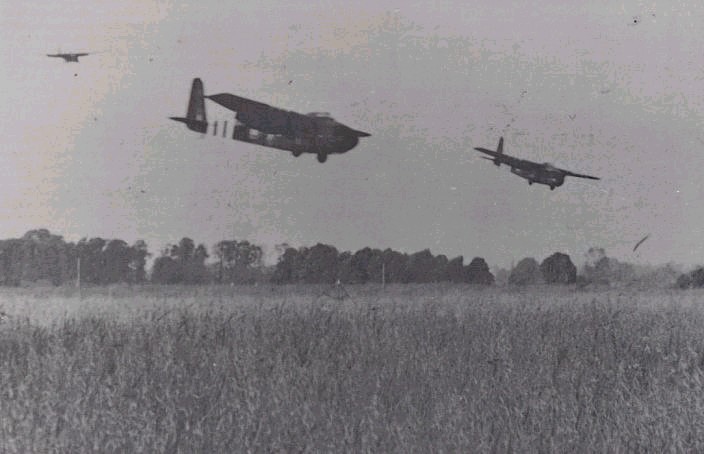
British Hamilcar heavy gliders landing Tetrarch light tanks into Landing Zone "N": the world's first combat air-mech assault
General Gavin writes about British Airborne operations in Airborne Warfare pages 62-63, particularly about the taking of "Pegasus Bridge":
Farther east, the British 6th Division, commanded by Major General Gale, carried out its operations much more in accordance with plan (see Map 10). Following in the wake of its pathfinders, which touched down between 0010 and 0020 of D-Day, a force of six platoons of infantry, reinforced by engineers, landed by glider and captured the bridges over the Caen Canal and the River Orne.
Map 10.
The approach technique of this flight was unusual. Right after taking off they started to climb so that when they reached the coast of France they were between five and six thousand feet. The gliders were released the moment they crossed the coast and then started in a glide for their objectives. This was done, so the official after-action report states, "so that they would arrive at the bridges alone and unheralded, like thieves in the night." This technique was preeminently successful and both bridges were captured intact.
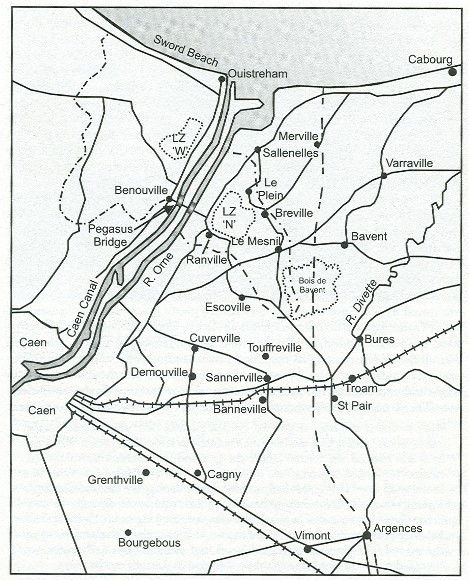
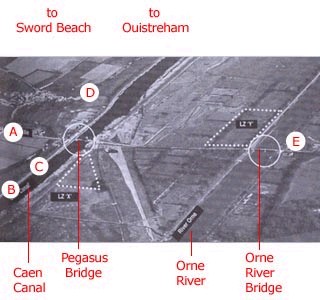
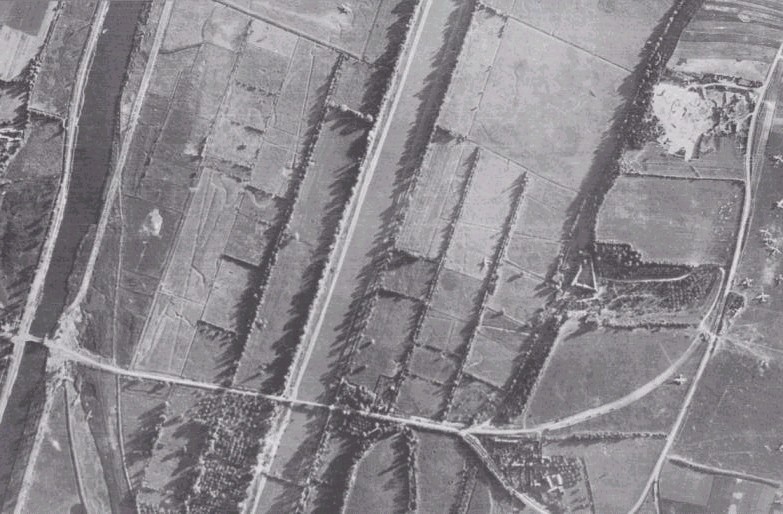
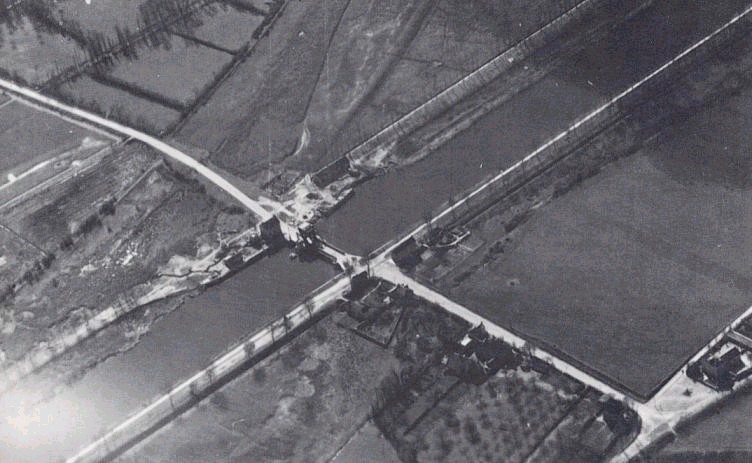
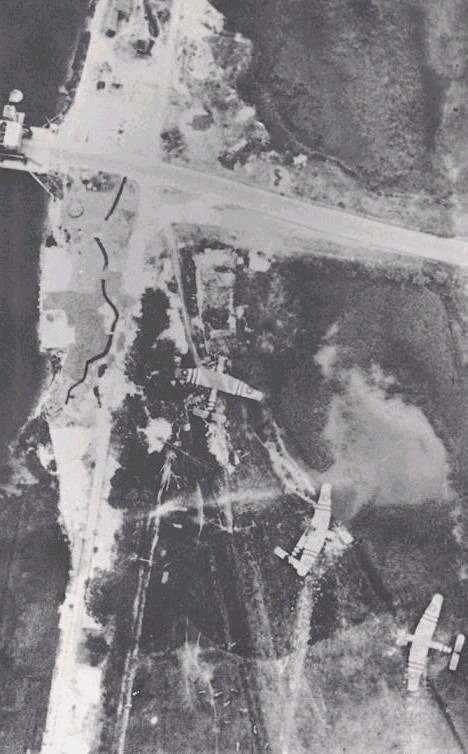
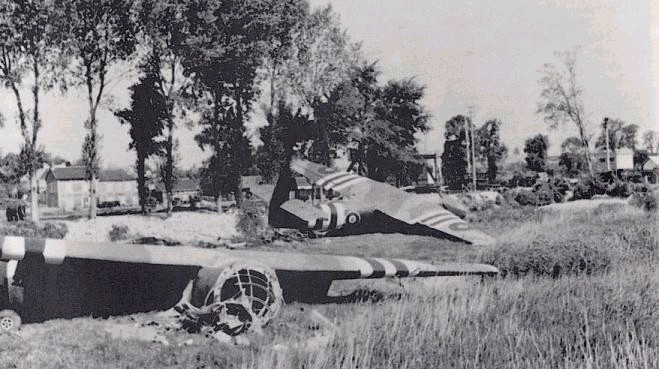
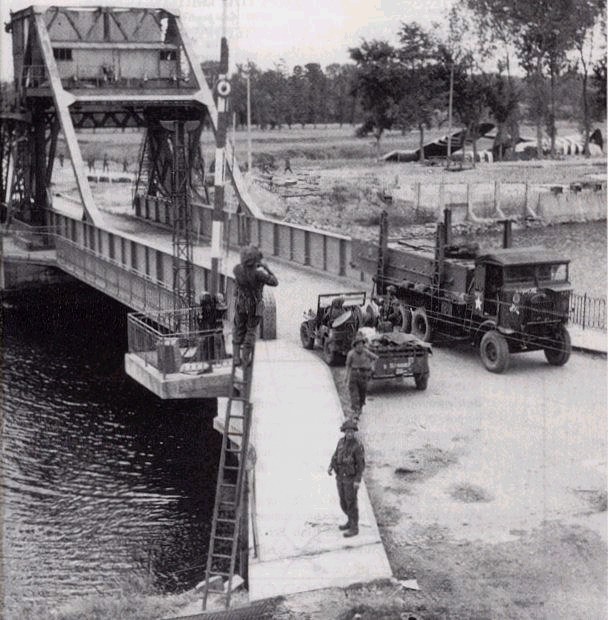
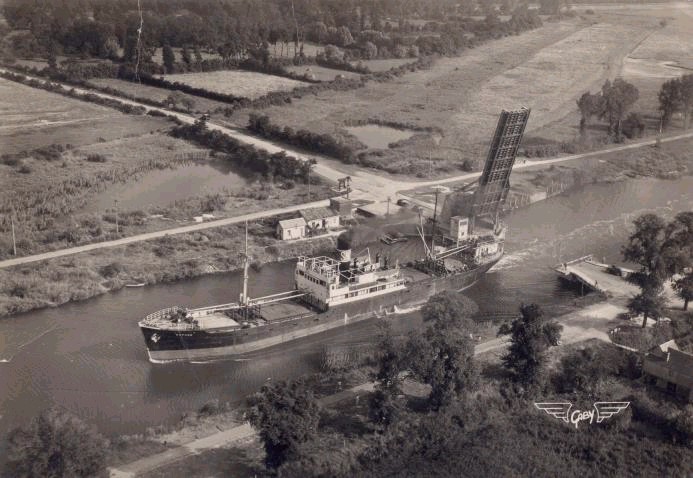
For delivery, more than 1,700 Troop Carrier sorties were flown on D-Day alone (by American and British Troop Carrier outfits), delivering 17,000-plus paratroopers that day; by the end of D-Day, American and British glider serials had also delivered more than 600 American and British gliders containing more 7,000-plus troopers, more than a hundred artillery guns, several hundred vehicles, and over a thousand tons of supplies. It was in Normandy that the Airborne-Troop Carrier concept truly "came of age."
Date: 10 June 1944
Unit: Nos. 298 and 644 Transport Squadrons
Operation: Neptune
Troopers: ?
Country: France
Dropzone: Normandy
Aircraft: specially-modified Halifax heavy bombers
Type Air delivery: Day low-level tactical personnel, containers and jeeps with 6-pounder (57mm) anti-tank guns by static-line, from Halifax bomb bays and troop exit holes in fuselage
Author/researcher Keith Flint in Airborne Armour on page 131 says 6 x jeeps and 6-pounder anti-tank guns were dropped into the 6th Airborne's area by PARACHUTE--the first time we know of that combat vehicles were parachuted into action.
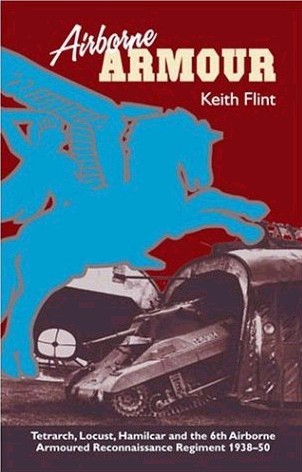
www.worldwartwobooks.com/product/54/airborne-armour---british-airborne-armour
Email: sales@worldwartwobooks.com Telephone: +44 (0) 1970 623 778
Airborne Armour: Tetrarch, Locust, Hamilcar and the 6th Airborne Armoured Reconnaissance Regiment 1938-50
Despite all the works on airborne forces published since 1945, the full story of Britain's airborne armour has remained untold. This book is intended to correct that omission. The story has two main strands - the project to fly tanks onto the battlefield to support airborne forces, and the history of the unit that operated those tanks and supported 6th Airborne Division in the ground role - the 6th Airborne Armoured Reconnaissance Regiment.
The book is the result of considerable original research and contact with surviving members of 6th AARR. It contains the full development background of airborne tanks, the British Tetrarch and American Locust, and also that of the Hamilcar glider. It examines rival or complimentary projects, in particular the German Me 321 Gigant glider, and analyses the extent to which the British airborne armour project was a success.
The history of 6th AARR is traced back to the little known Special Service Squadrons of the RAC which were pioneers of armoured amphibious assault, and who saw action in the invasion of Madagascar in 1942. One of these squadrons became the Airborne Light Tank Squadron, which grew into the Airborne Armoured Reconnaissance Regiment in time for D-Day. This unit flew 20 x Tetrarch tanks into battle on the evening of D-Day in the first ever assault landing of tanks from the air, and did the same 10 months later when 8 x Locust tanks were landed as part of the massive Rhine crossing operation.
6th AARR also had a proud history in ground combat in Normandy, the Ardennes, and Germany, often forming the spearhead for the advance of 6th Airborne Division. The unit has a fair claim to be the 'forgotten regiment' of British airborne forces, a fate that this book aims to put right.
- Fills a significant gap in the history of Britain's airborne forces, and on a broader scale, the history of airborne operations and armoured fighting vehicles
- Original research reveals considerable new information, including eyewitness reports from former members of the unit
- Behind the scenes analysis is combined with a narrative of combat operations, including plenty of detail about the unit's actions in Normandy, the Ardennes and Germany
- The text is accompanied by a number of previously unseen photos
Author: Flint, Keith Hbk 230mm x 145mm 224 pages 35 b/w photos & ills, 7 maps
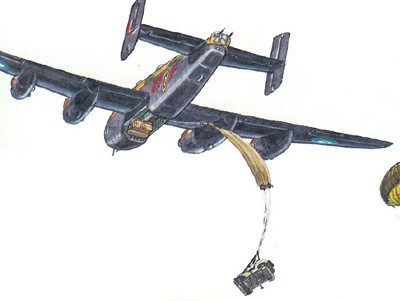
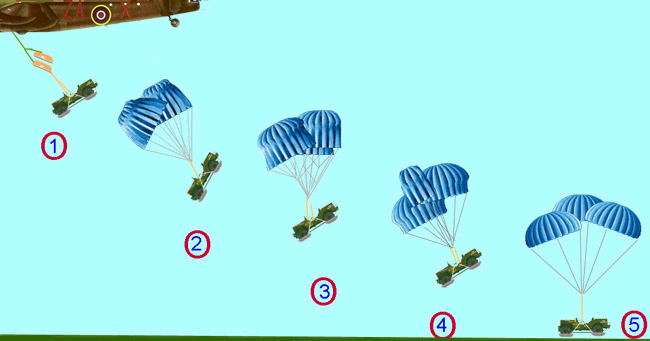
Research reveals that while the Russians were the first to air-motorize armored cars and air-mech tanks in war games by both airdrop and airland, the Germans deserve credit for the first airlanded air-motorized, air-mechanized combat operations on Crete in 1941 and North Africa in 1942. We do not buy into this notion that a military maneuver has to be in the face of enemy fire to be important, but to make the distinction for others who need the self-validation of combat, we'll refer to airland/airdrop operations into contested territory as "assault" operations. The British deserve the credit for the world's first combat air-mech assault delivering 20 Tetrarch light tanks and 9 Bren gun carriers by Hamilcar heavy glider into Landing Zone "N" on D-Day, June 6, 1944.
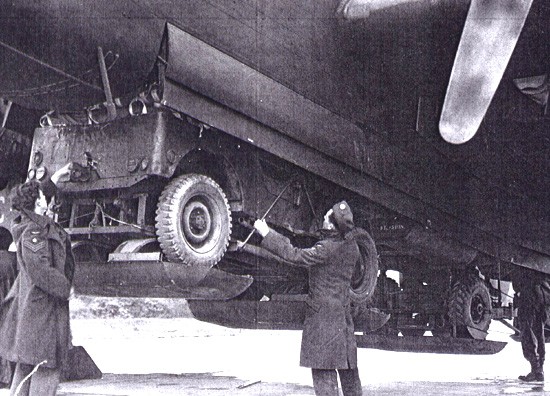
Jeep with 57mm anti-tank gun rigged to airdrop

Moreover, Keith Flint reveals in his book, Airborne Armour on page 131, that on June 10th, 1944 "the Halifax squadrons involved successfully dropping six 6-pounder anti-tank guns and their towing jeeps by parachute into the airborne bridgehead" making the British the first to parachute drop wheeled combat vehicles in an air-motorized assault. What is significant about parachute vertical airdrop landing (VADL) is that if you can pay for it up front by complicated special preparations, no one has to land a fixed-wing aircraft to the ground, but simply get close or fly over the spot desired. The parachute decelerated load like the Paratrooper human "crash-lands" more or less vertically, requiring less space than sliding to a stop as in a glider. The rigging of items to do VADL is a complicated art form requiring dedicated Rigger professionals. If the parachute air items are not recovered, its very expensive for continual operations but the cash-strapped French could do multiple airborne assaults in the first Indo-China war so there's no excuse why we can't be less lazy than the current craving for a smooth runway to airland pampered USAF t-tail transport planes. What we need to do is to use sturdier TRACKED ARMORED M113 Gavins that can be VADL delivered with minimal amount of air items instead of fragile wheeled trucks like the jeep which as you will see below needs a lot of TLC to survive parachute delivery.
Other Airdropped gun-jeep Special Forces operations:
Operation Dingson - 160 men and 4 jeeps of 4 French Parachute Battalion (4 SAS) parachuted into Vannes area of Brittany to organize local resistance, establish a local base of operations, and harass enemy forces in the area. (July - October 1944)
Operation Franklin - 186 men from 4 French Parachute Battalion (4 SAS) deploy in 31 jeeps to support U.S. VIII Corps during the German Ardennes Offensive. (Belgian Ardennes, December 1944 - January 1945)
Operation Hardy - 55 men from 2 SAS (with 12 jeeps) parachuted into eastern France to establish a base on the Plateau de Langres, northwest of Dijon and carry out intelligence and harassment operations. (July - September 1944)
Operation Kipling - 107 men and 46 jeeps from "C" Squadron 1 SAS parachuted into the area west of Auxerre, central France, and tasked with aiding the Allied airborne landings due to take place in the Orleans Gap. (August - Sept. 1944)
Operation Lost - Seven men from 4 French Parachute Battalion (4 SAS) parachuted into Brittany, France to meet up with parts of 4 SAS and conduct large scale operations against the enemy in the area. (June - July 1944)
Spenser - 317 men of 4 French Parachute Battalion (4 SAS) mounted on 54 jeeps, infiltrated enemy lines and conducted operations designed to effect major casualties to the retreating German Army. (August - Sept. 1944)
Operation Wallace - 60 men from 2 SAS in 23 jeeps (divided into three groups) landed at Rennes, tasked with strengthening SAS bases in the area, later attacked the German HQ in Chatillon. (1944)
Greece
Date: 12 October, 1944
Unit: 4th, 5th & 6th Battalions of the Parachute Regiment who made up the 2nd Independent Parachute Brigade
Operation:
Troopers: 5, 000
Country: Greece
Drop zones: Megara
Aircraft: U.S. supplied and operated C-47 Dakota transports and CG-4 Waco gliders
The 4th Battalion of the British 2 Independent Parachute Brigade was dropped on the airfield at Mégara by crews of the 60th and 62nd Troop Carrier Groups of the 51st Wing. This was the same airfield from which Student's forces had taken off on the German invasion of Crete. By now, however, the Germans had withdrawn from nearby Athens, and British troopers were brought in to help stabilize the situation in that city, where various factions and ideologies fought for power. The mission was flown in high winds, and many of the troopers who jumped became casualties as the wind dragged their chutes across the rocky ground and into the water. Nevertheless, the field was secured and soon members of the British 1st Independent Glider Pilot Squadron brought in vehicles and supplies in a number of used CG-4As that were towed by pilots of the 60th and 62nd Groups. During and after these operations, these two Troop Carrier groups, veterans of the Allied invasions of North Africa and Sicily, were based at the airfield at Pomigliano, Italy, and at Malignano Airfield in Italy, respectively.
 www.youtube.com/watch?v=m-W5NsvmGkE
www.youtube.com/watch?v=m-W5NsvmGkE
Arnhem
See also the American Airborne's account above for more details
1944, 17-30 September: Largest airborne assault in history: the spearhead of a coordinated air and ground assault in the Allied airborne invasion of German-occupied Holland. Three simultaneous operations were mounted-completely in daylight-against locations near Eindhoven, Nijmegen, and Arnhem in an effort to lay a 60-mile carpet of airborne units from approximately 7 miles north of Eindhoven northward to Arnhem. Use of multiple lanes by different serials was implemented effectively to compress deliveries. Two routes were specified, southern and northern, and both were used to good advantage. On 17 September, Eindhoven lay approximately 15 miles behind enemy lines, Nijmegen was over 65 airline miles behind enemy lines, and Arnhem was 85 miles behind the lines. The American sectors were centered around Eindhoven (101st), Nijmegen (82nd); Arnhem was in the British sector (1st Airborne). Troop carrier operations in Holland extended from 17-30 September 44, during which IX TCC flew 3,743 effective aircraft sorties, flew in 1,618 gliders, and delivered 30,385 troopers, 158 pieces of artillery, 710 jeeps, 465 trailers, and carried 2,856 tons of cargo to all three sectors combined. The RAF 38 and 46 Groups flew 1,191 effective aircraft sorties, and dropped more than 1,400 tons of cargo, delivered 621 gliders, 4,401 troopers, 1,026 vehicles, and 105 artillery pieces.
M3 105mm Towed Howitzer Unique to the U.S. Airborne
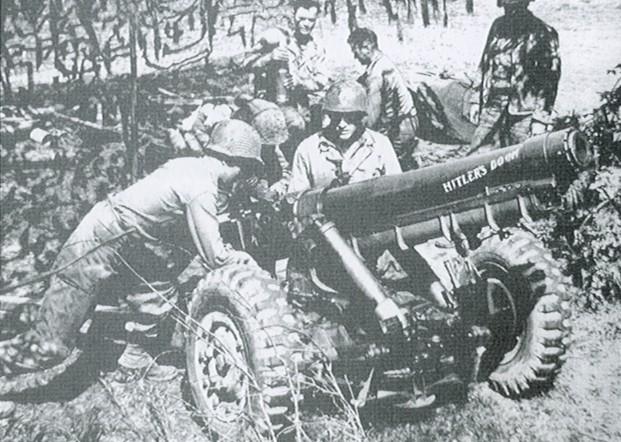
The two American sectors were successfully taken, though not on schedule. The invasion, which depended on the rapid movement of British army units up a narrow corridor from south of Eindhoven to Arnhem, became over-extended by a combination of unrealistic plans, weather, communications failures and other factors.
Analysis: The British 1st Airborne Division had not been used for the D-Day landings, WHY WERE THEY NOT FULLY READY FOR ARNHEM?
http://en.wikipedia.org/wiki/Operation_Market_Garden
Wiki has an excellent web page on the Arnhem fiasco. Let's look at some main points.
EXCERPTS:
Montgomery, Browning and Horrocks: the Real Culprits for the Arnhem Failure
Its clear that had competent American Generals Ridgway or British General Gale been placed in charge of First Allied Airborne Army, they would have executed successfully Montgomery's plan despite its flaws.
Wiki reports:
Gavin, commanding the U.S. 82nd Airborne Division, was skeptical of the plan. In his diary he wrote, "It looks very rough. If I get through this one I will be very lucky." He was also highly critical of Browning, writing that he "...unquestionably lacks the standing, influence and judgment that comes from a proper troop experience... his staff was superficial... Why the British units fumble along... becomes more and more apparent. Their tops lack the know-how, never do they get down into the dirt and learn the hard way."
From Max Hastings (2005 reprint). Armageddon: The Battle for Germany 1944-45. New York: Vintage Books. ISBN 0-375-71422-7. Page 36
Market Garden was a very high-risk plan that required a willingness to take risks at the tactical, small-unit level. Unfortunately, the detailed planning and leadership required at that level was not always present. The 1st Airborne Division, the least experienced working as a whole division, was given the most difficult, distant objective. XXX Corps was also criticized for its inability to keep to the operation's timetable. Its lead unit, the Guards Armoured Division, was led by a commander (Allan Adair) whom Montgomery had sought to remove prior to D-Day. This action was blocked due to Adair's popularity.
Montgomery Knew Holland was Wet Area but did not Employ Hobart's Amphibious Tanks/APCs (LVT Amtracks)
Wiki reports:
The terrain was also ill-suited for the mission of XXX Corps. Little contingency had been made in the event of blown bridges along the route.Montgomery initially suggested Operation Comet, a limited airborne coup de main to seize the bridge in Arnhem on September 7, but weather postponements and a fluid enemy situation made it evident that Arnhem was too distant a target for an unsupported airborne attack. Comet was replaced by a more ambitious plan that bypassed the Siegfried Line, crossed the Rhine with large-scale forces, and trapped the German 15th Army between Arnhem and the shores of the IJsselmeer. This would also isolate the V-2 launch sites that were bombarding London and Antwerp. However, the plan aimed the British Second Army northwards through terrain with numerous water obstacles; this moved them away from the U.S. First Army.
 www.youtube.com/watch?v=VSm5nBZ4X0A
www.youtube.com/watch?v=VSm5nBZ4X0A
Incompetent British Airborne Commanders Chose Distant Drop Zones for Coup de Mains by Foot-Sloggers
Wiki reports:
The inexperienced airborne commanders deferred to their concerns and agreed to a site selected by the RAF that was some 9 miles (15 km) from the bridge.It is therefore surprising in retrospect that the plans placed so little emphasis on capturing the important bridges immediately with forces dropped directly on them. In the case of Veghel and Grave, where this was done, the bridges were captured with only a few shots being fired.
Despite the heroism, bad choices were made throughout, and opportunities were ignored. The commander of the Glider Pilot Regiment had asked for a small force with gliders to land on the southern side of the bridge at Arnhem to quickly capture it, but he was denied. This was surprising in light of the fact that in Normandy, the British 6th Airborne Division had used such coup-de-main tactics successfully to take smaller bridges. In Britain, the commander of the British 52nd (Lowland) Infantry Division, whose troops were slated to fly into a captured airfield, pleaded with his superiors to allow a brigade to fly in with gliders to assist Gen. Robert Elliot Urquhart's trapped forces; this was also denied...
However, there was another airfield near Grave, and if the 52nd Lowland had been landed there, they might have freed up British units supporting the 82nd Airborne, and might have allowed them to reach Arnhem sooner.
"He who has not fought the Germans does not know war"
--British Military Saying
If you'fd like to what-if the distant drop zones re-think of the battle, there's a video strategy game for your PC, "Airborne Assault: Highway to the Reich" available.
Dave @ Panther games writes:
HTTR does allow for many a-historical options, including closer drop zones, different arrival times and priority of deployments, plus an option to conduct double lifts on Day 1, so may of the what-ifs can be gamed out. It also has a range of what-if options for the 82nd and 101st Abn operations to the south of Arnhem and for the drive by 30th Corps to relieve them.
Dave O'Connor
www.panthergames.com
www.panthergames.com/Games/Titles/AAHTTR.html

RATING: Violence
GENRE: Strategy
RELEASE DATE: December 2003
PUBLISHER: Matrix Games
DEVELOPER: Panther Games
PRODUCT CODE : MGX1025
UPC: 6-99030-11167-3
A Bridge Too Far
September 1944, General Montgomery mounts the most daring Allied offensive of WW2. The plan is ambitious. Drop thirty thousand airborne troops deep behind enemy lines, seize the vital bridges across the Rhine, secure the highway to the Reich, advance the Allied armies into the German heartland and end the war by Christmas. Take command and with the aid of the world's most advanced wargame engine fight the battle and change history.
Strategy Informer Rated 8.8 of 10: "In summary, Airborne Assault: Highway to the Reich is an excellent wargame for the true enthusiast. [...] In my opinion this game is as close as anyone who wasn't there in Monty's HQ in '44 will ever get to Market Garden, and as a "game" rides the line between entertainment and historical re-enactment with style and grace."
GameSpot Rated 8.1 of 10: "It's hard to convey just how cool this system is, because not only does it eliminate the massive amount of micromanagement inherent in most wargames, but it does so in a way that makes it feel like you're really commanding forces in the field. [...]Highway to the Reich is a rich, rewarding game and a great example of how the designers are using the PC to push wargaming into new and exciting directions. The elegant gameplay system makes it one of the most accessible operational-level wargames we've ever played, and it's worth your time if you're a veteran wargame fan or if you've been thinking about jumping into wargaming. "
The Airborne Assault game engine revolutionizes wargaming. Its pausable, continuous time game play, the most advanced artificial intelligence of any wargame, powerful and intuitive user interface and unique command system provide the most realistic and enjoyable simulation of operational warfare.
Command like a real General, under real time pressures to achieve real objectives on a real map all within the fog of war. Issue orders to your powerful AI controlled subordinates or take total control of every unit. Fight the worlds most advanced AI opponent or match wits against your friends online or over a LAN.
Lead Parachute Regiments in daring assaults to seize vital bridges, send mighty Armored Divisions into the attack and wield entire Infantry Corps in a race against time. Reshape history in one of the many historical battles covering all major actions of the Market Garden operation or salvage victory from disaster in one of the hypothetical "what-if" encounters.
Create your own maps with our Map Maker utility. You can modify an existing scenario or design your own battle using the Scenario Maker utility.
KEY FEATURES:
Stunning graphics, including new customizable map textures
Battles covering all of Operation Market Garden including Nijmegen, Eindhoven and Neerpelt
Detail Order of Battle covering all forces that participated down to the company level
Enhanced user interface, including in-game briefings, intel filter, sound control and auto-save
Advanced AI.
Game Data
Complexity: Medium
Field of Play: Operational
Historical Period: WW2
Theatre: Western Front
Unit Scale: Regiments units
Game Play: pausable continuous time
Players: 2
AI: Either sides
TCP/IP: yes
Requirements
Windows 98 / ME / 2000 / XP
DirectX 8
Pentium II 500 Mhz CPU
64MB RAM ( 128 recommended )
Direct X compatible Soundcard
2MB Video Graphics Card 16 BIT Color
8x CD-ROM
400MB free Hard Disc space
CAS not pre-arranged to help British Paras breakthrough Germans to Arnhem bridge to strengthen Frost's Men
Where were the British Lysander STOL observation/attack/liaison planes to act as radio relays or failing that drop and pick-up paper messages?
Wiki reports:
Communications planning was poor, and the 1st Airborne Division would be out of touch with most other headquarters for most of the battle. No arrangements were made for close air support.Some loss of communication between the bridge and the drop zones was expected because 8 miles (13 km) separated them, and the main radio used throughout the Division was the Type 22 set with a 5 mile (8 km) radius. However, the British radios did not function at any range; some had difficulty receiving signals from just a few hundred yards and others received nothing at all. Several theories have been advanced to explain the near-total failure of the 1st Airborne Division's communications net. Modern tests using 22 sets have suggested that large deposits of iron in the soil could have been to blame.[14] It is also possible that repeated operational stand-bys and cancellations (over a dozen drops were planned and then cancelled in the weeks prior to the operation) had led to sloppy battery charging procedures and lax supervision of this task.
Folding Bikes Available to Speed Infantry to Arnhem bridge but Not Used
 www.youtube.com/watch?v=o44BvtQxOV4
www.youtube.com/watch?v=o44BvtQxOV4
Wiki reports:
Two of the three battalions of the 1st Parachute Brigade found themselves slowed down by small German units of a training battalion which had quickly established a thin blocking line covering the obvious routes to Arnhem. Lieutenant Colonel John Frost's 2nd Battalion was advancing far south of this position and so found their route largely undefended. They arrived at the bridge in the evening and set up defensive positions at the north end. Of the other battalions, the 3rd had only covered half the distance to the bridge when they came to a halt for the night, the rear of their column being under attack and needing time to catch up. The 1st Battalion was similarly fragmented, yet they pushed on around the flank of the German line throughout the night, but frequent skirmishes resulted in their making little more progress. Two attempts to take the bridge span including the south end were unsuccessful.
The video above is Part 3 of a New Thought-Provoking Series on the Battle for Arnhem in 1944 asks the question, WHERE WERE THE FOLDING BIKES? when the British Army needed them to reinforce LTC John Frost's 2nd Battalion of the 1st British Airborne Division holding the north end of Arnhem bridge over the Rhine river? Details of this research can be found on the constantly updated web pages below:
www.combatreform.org/atb.htm
www.geocities.com/militaryvehicles2
Airborne forces are essentially CAVALRY as explained by LTG James M. Gavin in his influential 1954 Harper's magazine article; "Cavalry and I Don't Mean Horses":
www.combatreform.org/cavalryandidontmeanhorses.htm"
Early Airborne forces once they left their aircraft going 100-300 mph lost the MOBILITY DIFFERENTIAL of Cavalry and became walking 1-4 mph infantry--a condition folding bikes for 10-25 mph speeds can solve. The time of the greatest opportunity to surprise the enemy and an Airborne force's greatest vulnerability is right after the drop--had the British who used folding bikes en masse on D-Day used them in quantity on the flat terrain west of Arnhem they could have swarmed upon Arnhem bridge before Germans on foot could have gotten into blocking positions or switched to Frost's open route if opposed. Mobility and time is of the essence in a coup de main.
British General Montgomery tried to cross several major rivers by 3D Airborne maneuver coup de mains, yet on the most vital bridge over the Rhine no such direct action was taken to ostensibly avoid anti-aircraft flak. If you are going to do an INDIRECT VERTICAL ASSAULT you must close the distance quickly with GROUND MOBILITY.
The British are great deep thinkers about war and their innovations like the tracked tank, the landing craft for amphibious warfare, light tanks in gliders are just a few of their thinking ahead and doing TANGIBLE THINGS to get ahead. What they lacked in WW2 was the flexibility to take what they had and improvise on the spot ruthlessly for decisive effects, no doubt very war-weary. Since the British were tired and the 1st Airborne not very competent, its clear now they should have "stacked the deck" in their favor with lots of folding bikes to speed to Arnhem bridge ASAP hopefully without a fight--to conserve their fighting ranks. Simple bike transportation doesn't cost a fortune nor demand all the maintenance that "mechanization" with powered tanks invokes cold sweats in the mind of the light infantry narcissist. So why wouldn't a light infantryman want to travel at 10-25 mph instead of 1 or at best 4 mph on foot? The British at times asked this question in WW2 and used bikes, at others they didn't and disasters followed. It has something to do with the flexibility of mind--those that can decentralize and delegate control to trusted subordinates can use mobile, dispersed bike troops like Yamashita did to take Malaya/Singapore; if one's mind is weak and inflexible, a slower walking pace is chosen and the alleged safety of caution turns into bloody head-long charges into enemy strength. The bike is a tool for maneuver warfare of a Cavalry force. One of the sad truths of war is that even the pressures of survival in combat and as a nation-state are NOT A GUARANTEE that what's best is going to over-ride prejudice and malpractice of racketeers. The British people had to demand Winston Churchill be their leader and it was he who brought back Hobart to active-duty to save the day on D-Day. With the Germans on the run after the Normandy break-out, the British generals thought they could "pull a fast one" and not even have fast-moving detachments of bicycle troops to reinforce an Airborne unit if stranded on the far side of one of the rivers. German Paratroop General Kurt Student knew right away to attack landing paratroops and had his men converge by bicycles and STUG turretless assault guns on Arnhem--and we all know how that action resulted.
Just a few hundred bikes at Arnhem's drop and landing zones would have have ended WW2 sooner by 6-8 months with us reaching Berlin before the Soviets--and would have saved MILLIONS of lives and prevented there being a "Berlin Wall" and "Iron Curtain".
TechnoTactical Errors in our force structure and equipment can have STRATEGIC CONSEQUENCES. Let's hope we can realize this before its too late and its more than a bridge at stake.
Hobart's CDL Tanks Not Used: Night Fighting, Anyone?
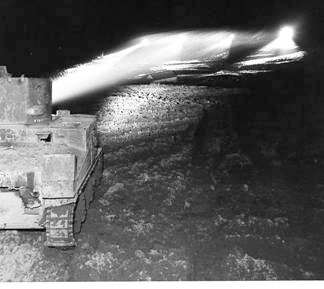
General Hobart trained his armored divisions, the 7th, 11th and 79th to fight at night. Apparently the rest of the British armored units "didn't get the memo". What of the 79th CDL beam light Grant medium tanks? What were they doing? Playing checkers? Why didn't Montgomery put them to work to keep the XX Corps advance going during the night?
Wiki reports:
The common doctrine for armour at that time was to halt at night, and although some night attacks had been made with armour by 21st Army Group in Normandy during Operation Totalise, no attempt was made here.Despite the capture of Nijmegen bridge and the clearing of the town on the previous evening, the Guards Armoured Division did not begin their advance until some eighteen hours later, at noon. Lieutenant General Brian Horrocks claimed he needed this delay to sort out the confusion among his troops that had resulted from the battle in Nijmegen. This was a controversial decision that has been examined often in the years since.
Wiki reports that LTG Gavin saw that the overall commander for Market-Garden was inept.
Gavin's diary comment was: "Had Ridgway been in command at that moment, we would have been ordered up that road in spite of all our difficulties, to save the men at Arnhem." The historian Max Hastings wrote "It reflected poorly on the British Army...".The actions of XXX Corps have also been questioned. Their advance was characterized by what was widely perceived, at the time, as a lack of drive. For example, XXX Corps did not jump off until midafternoon of the first day and were delayed by pockets of German resistance and the need for engineers to replace the bridge destroyed at Son. They arrived at Nijmegen on September 19 when the plan called for them to be in Arnhem by that afternoon. Their major unexpected delay arose from the need to support the 82nd's assaults on Nijmegen and its bridges. After the river had been crossed, the Guards waited 18 hours to resume their advance; in the words of Colonel Reuben Tucker (commander of the 504th) the Guards "...stopped for tea". While not literally true, Tucker's statement summed up the view some U.S. troops had of the XXX Corps units. Ridgway added that he was "much dissatisfied with the apathy and lack of aggressiveness of the British forces".
Foot Slogger Airborne Forces Subject to Defeat by Artillery Indirect Fire: Need to be in Light Armored Tracks
Wiki reports:
Day 6: Friday, 22 September ("Black Friday")Arnhem
The Germans, wary after unsuccessful and costly attacks the previous day, shelled and mortared the airborne positions heavily in lieu of additional direct assaults. By the end of the battle some 110 artillery pieces had been brought into place around Oosterbeek as the Germans shifted to the tactics that had worked so well at the Arnhem bridge. Direct attacks were limited in nature, conducted against specific positions and even individual houses. Numerous well-sited British anti-tank guns also caused German reluctance to attack directly. The survivors of the 1st Airborne were outnumbered 4 to 1.
Flimsy Assault Boats Cannot Cross Forces over the Rhine to Reinforce 1st Airborne at Osterbeek: Need Armored LVT Amtracks
Wiki reports:
Day 8: Sunday, 24 September...an attempt was made on Sunday night to reinforce the 1st Airborne Division with the 4th Battalion the Dorsetshire Regiment. Two companies were put across the river, however the location of the crossing point was ill-advised and the Dorsets landed amongst prepared German positions. Fragmented by their landing and immediately pinned down, of the 315 men who crossed, only 75 reached Oosterbeek, the remainder were taken prisoner. As a result of this failure, the decision was made to withdraw the 1st Airborne Division.
A Bridge Too Many? Or The Wrong Bridge?
Wiki also reports that the Arnhem road bridge was not even needed that taking the closer ferry crossing was more prudent and that XXX Corps could have taken an undefended bridge and hit the Germans in the rear by non-linear armored maneuver--suggested by Horrocks of all people! Had Patton been in Horrock's position he would have crossed the bridge, won the battle and apologized afterwards.
Arnhem bridge was not the only available Rhine crossing. In fact, had the Market Garden planners realized that a ferry was available at Driel, Frost's paratroops might well have secured that instead of the Arnhem bridge, making a profound difference in the campaign because at a shorter distance away from their western drop and landing zones--the whole of the 1st Brigade could have concentrated to hold the Osterbeek heights instead of just one battalion farther away at the road bridge. In this case, Arnhem was "one bridge too many".The commander of XXX Corps advocated another course of action. About 16 miles (25 km) to the west was another bridge similar to Arnhem, at Rhenen, which he predicted would be undefended because of all the efforts being directed on Oosterbeek. This was in fact the case, but the corps was never authorised to take the bridge; if they had, it is almost certain they would have crossed unopposed into the rear of the German lines. By this time, it appears that Montgomery was more concerned with the ongoing German assaults on Market Garden's lengthy 'tail'.
Rhine River Crossing
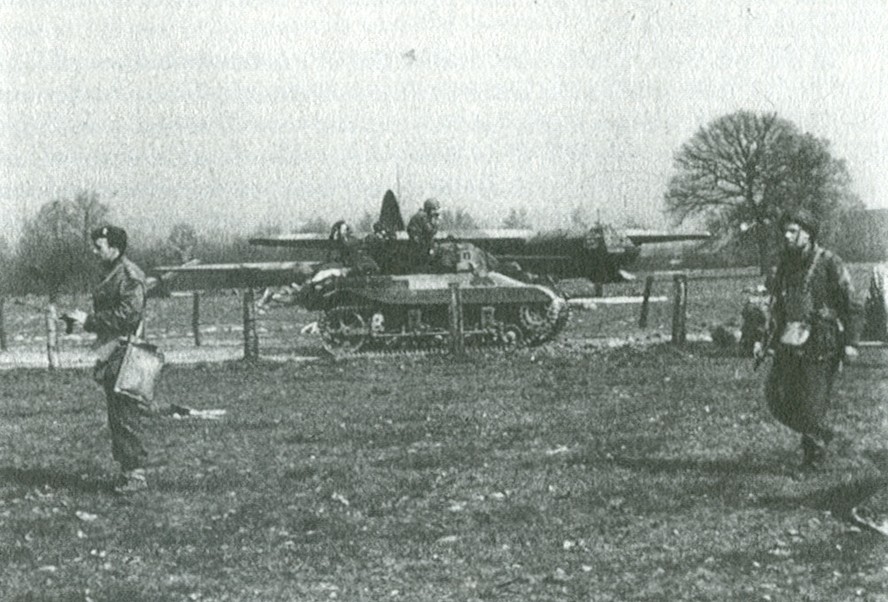
American-made M22 Locust light tank in combat with the British 6th Recce Squadron during operations across the Rhine, the world's second airborne tank deployment directly into combat
1945, 24 March: Allied crossing of the Rhine River just north of Wesel, Germany, and the largest one-day airborne assault in history. The entire operation took place in daylight, though in visibility hampered by smoke. Allied planners drew conservative operational parameters, mindful of the problems encountered in Holland. All missions were compressed into one day to eliminate weather delays of later missions; airborne objectives included the vertical flanking of the Germans' east bank defenses and the capture of several key bridges that were located no farther than approximately six miles into enemy territory; Troop Carrier aircraft were scheduled to arrive six hours after ground forces had begun to cross the river. The entire invasion involved more than one million men, and was second in size only to the Normandy invasion. Troop carrier aircraft and gliders carried two airborne divisions, the 17th Airborne and the British 6th Airborne. The formation, in multiple lanes similar to the MARKET assault, was even more concentrated and massive. It flew flew three lanes abreast, 11/2-miles apart, with a fourth lane above. The lanes contained various types of serials, including American, British, parachute and glider. The TC assault formation, which also included 240 x B-24s bringing resupply fifteen minutes behind the multiple-lane formation, comprised 1,836 power aircraft and 1,348 gliders and took 3 hours and 12 minutes to pass a given point. Of the power aircraft, 1,156 were American. Of the gliders, 908 of those dispatched were from IX TCC units, and 592 of these were on double-tow-a first for European combat operations, and by far the largest use of combat double-tows in history. In slightly over three hours, more than 17,000 troopers and 7,000,000 lbs of equipment and supplies, including more than 130 artillery weapons and 1,200 vehicles, had been dropped or landed within an area less than 25 miles square. The paradrops and airlandings were very accurate. Extensive arrangements had been made to facilitate communications and cooperation between units, and Combat Control Teams were flown in by glider to coordinate ground-to-air communications if later resupply missions had been required. (For more on this operation, see Col. Charles H. Young's Into The Valley, Chapter 14.
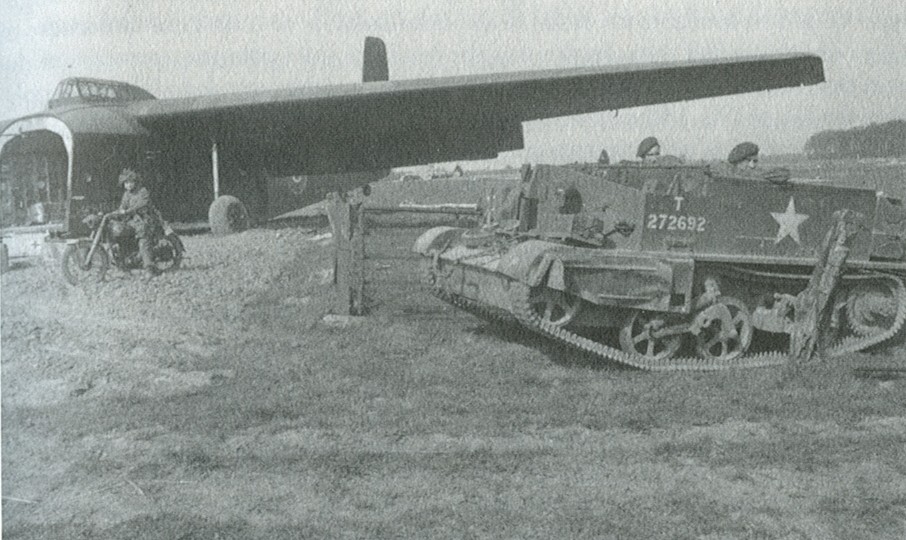
Author Keith Flint in Airborne Armour, page 153 reports that the British glider-landed an entire company, the 716 Light Composite Compsany, RASC in 12 x Hamilcars with 12 Bren gun armored personnel carriers and trailers whose sole purpose was to use their tracked mobility and armored protection to redistribute supplies from other gliders and recover parachute resupply drop bundles--a good idea we need to emulate today with M113 Gavins
WWII French & Dutch Airborne small unit actions (yes!)
Operation Abel - 82 Soldiers of 3 French Parachute Battalion (3 SAS) conduct blocking actions and hit-and-run raids in conjunction with Maquis units during the battle for the vital Belfort Gap. (Eastern France, 27 Aug to 22 Sept 1944)
Operation Barker - 27 men from 3 French Parachute Battalion (3 SAS) jumped into the Saone-et-Loire area, tasked with the disruption of enemy movements and to support the local Maquis. (France, Aug - Sept 1944)
Operation Benson - Six members of Belgian Independent Parachute Company (5 SAS) jumped into northeastern France to collect intelligence concerning German troop strength and movements. (France, 28 Aug - 01 Sept. 1944)
Operation Bergbang - 41 members of Belgian SAS dropped into the Liege-Aachen-Maastricht region to aid the local resistance and sever German communications east of the Meuse River. (02-12 Sept. 1944)
Operation Brutus - 19 members of the Belgium Independent Parachute Company (5 SAS) dropped east of the Meuse River to contact the Belgian Secret Army and another party of 5 SAS. (02 Sept. 1944)
Operation Caliban - 26 members of Belgian Independent Parachute Company (5 SAS) dropped into Bourg Leopold to sever German communications east of the Meuse River. (northeast Belgium, 06-11 September 1944)
Operation Chaucer - 22 members of Belgian Independent Parachute Company (5 SAS) jumped into Le Mans, France to conduct harassment operations against retreating German forces. (July-August 1944)
Operation Cold Comfort - 13 members of 3 Squadron, 2 SAS dropped north of Verona and tasked with the destruction of the railway line leading to Brenner Pass. (northern Italy, 17 Feb. 1945)
Operation Derry - 89 men of 3 French Parachute Battalion (3 SAS) parachuted into Finisterre, Brittany and tasked with harrassment operations against German forces and the protection of viaducts at Morlaix and Plougastel. (France, August 1944)
Operation Dickens - 65 men from 3 French Parachute Battalion (3 SAS) parachuted into the Nantes/Saumur area of western France and tasked with gathering intelligence, organizing resistance, and general harrassment of German forces. (July - October 1944)
Operation Dunhill - Five teams from 2 SAS parachuted into eastern Brittany to gather intelligence on enemy troop movements in the area. (northwest France, 3-4 August 1944)
Operation Fabian - Six month mission by five men from the Belgian Independent Parachute Company (5 SAS) deployed near Arnhem, Holland to collect intelligence and determine the locations of V-2 rocket launch sites. (Sept 1944 - March 1945)
Operation Gaff - Seven members of 2 SAS parachuted into Ramouillet, France to kill or capture German Field Marshall Erwin Rommel at his headquarters at La Roche Guyon on the Siene. (25 July 1944)
Operation Gain - D Squadron, 1 SAS parachuted into southwest France to meet up with the Maquis and conduct operations to disrupt enemy communications. (1944)
Operation Galia - 34 men from 3 Squadron, 2 SAS parachuted into northern Italy to meet up with local resistance fighters, gather intelligence, and conduct operations against the enemy. (December 1944 - February 1945)
Operation Houndsworth - A Squadron, 1 SAS parachutes into eastern France to establish a base for support of the Normandy D-Day landings. (June 1944)
Operation Jockworth - 57 men of 3 French Parachute Battalion (3 SAS) parachuted into southeast France with orders to disrupt enemy movement and organize local resistance forces. (August - September 1944)
Operation Keystone - Jeep-mounted squadron from 2 SAS tasked with interrupting enemy movements south of Ijsselmeer, Holland. (April 1943)
Operation Loyton - 91 men from 2 SAS and a Phantom team parachuted into eastern France to conduct intelligence gathering operations, attack enemy operations, and cooperate with local Maquis resistance fighters. (August - October 1945) Note: Phantom was the name given to F Squadron, GHQ Liason Regiment which was attached as a signal section to the SAS Brigade during WW2.
Operation Magistral - Soviet airborne forces' operation to open the road from Khost to their Kunduz base camp. (Afghanistan, 1987).
Operation Marshall - 32 men of 3 French Parachute Battalion (3 SAS) parachuted into the Correza area of France with orders to interfere with enemy troop movements and better organize local resistance operations. (August 1944)
Operation Moses - 47 men of 3 French Parachute Battalion (3 SAS) tasked with disrupting enemy communications near Poitiers in southwestern France. (August - October 1944)
Operation Newton - 57 men of 3 French Parachute Battalion (3 SAS) tasked with reinforcing existing SAS bases and conducting limited operations against the enemy. (August - Sept. 1944)
Operation Noah - 41 men from the Belgian Independent Parachute Company (5 SAS) parachuted into the French Ardennes to gather intel on the enemy presence in the area. (August - Sept. 1944)
Operation Pistol - 51 men of 2 SAS dropped into Alsace/Lorraine region of France and tasked with cutting enemy road and rail communications betweem the Rhine River and the Moselle River. (September-October 1944)
Operation Portia - Seven men from Belgian Independent Parachute Company (5 SAS) parachuted into the area around Drente to gather intelligence on enemy troop movements and determine the feasibility of the establishment of a covert SAS base. (September 1944 - March 1945)
Operation Samson - 24 men from 3 French Parachute Battalion (3 SAS) parachuted into the area west of Limoges, southern France to disrupt enemy road traffic and bolster local resistance forces.
Operation Samwest - 116 men of 4 French Parachute Battalion dropped into northern Brittany to establish a base near St. Brieuc and conduct operations to prevent the movement of German forces from western Brittany to Normandy following D-Day. (June 1944)
Operation Shakespeare - Small detachment of the Belgian Independent Parachute Company dropped west of Paris and tasked with harrassing the retreating German forces. (July - August 1944)
Operation Snelgrove - 28 men of 3 French Parachute Battalion (3 SAS), parachuted into southern France with orders to disrupt enemy troop movements an support local Maquis resistance fighters. (August 1944)
Operation Speedwell - Two seven-man teams from 2 SAS dropped into the Spezia/Genoa area to conduct long term behind the lines sabotage and other operations. (Sept. 1943 - April 1944)
Operation Titanic - Seven men from 1 SAS jumped along with dummy parachutists into an area near Normandy, with the intent being to deceive the Germans into believing a major airborne landing was taking place. (6 June 1944)
Operation Trueform - 102 personnel from 1 and 2 SAS and the Belgian Independent Parachute Company jumped onto 12 separate landing zones northwest of Paris with orders to inflict maximum damage to the retreating German forces. (August 1944)
Operation Wolsey - A five man joint SAS/Phantom team parachuted into northeast France and assigned to gather intelligence on enemy positions and movements. Note: Phantom was the name given to "F" Squadron, GHQ Liason Regiment which was attached as a signal section to the SAS Brigade during WW2. (1944)
Thanks to Dutch Paratrooper expert, Bastiaan Paul Suverkropp, we now know more about the intrepid history of the Japanese Paratroops (see above), a newly discovered French jump and the Belgian Airborne!
Date: April 8, 1945
Unit: 3rd and 4th SAS (French) Battalions
Operation: Amherst
Troopers: 684
Country: Netherlands
Drop zones: Groningen and Drenthe provinces
Aircraft: Short Stirling bombers
Equipment: gun-jeeps
Operation Amherst started at the early morning of April 8th and lasted until April 13th 1945. Two French Special Air Service regiments in fifty parties (a total of 684 men and 219 containers with supplies) landed by parachute in the North of The Netherlands between Ommen and Assen. They were supported by the Belgium 5th Special Air Service regiment (a total of 284 men and 35 Special Air Service jeeps), two Canadian divisions and the 1st Polish Armoured Division. Their main goal was to support the Canadian advance in the Netherlands and to prevent two German Divisions from making a concentrated attack or an escape to Germany. By April 13th 1945 The French had occupied the area and made contact with their support units. During the operation they prevented the German demolition of the airfield near Steenwijk and captured 18 bridges in the Canadians' vanguard. With this they had broken the last resistance in the area and closed one of the last escape routes to Germany. The Free French forces took 33 casualties.
The Dutch used Paratroopers in their fight to try and restore Dutch sovereignity over Indonesia. Basically, The military operations were successfull but the Dutch forces then were confronted with an unpleasant guerilla war (many competing factions from communists to radical muslims) and worldwide condemnation of their actions. When the U.S. threatened to stop Marshall Aid to the Netherlands, the Netherlands decided to grant Independance to Indonesia.

Date: March 8, 1945
Unit: "M" Section, Operation James Bond Vanguard (JBV), German Freedom Fighters (GFF), Royal Marine Commandos/Special Boat Service (SBS)
Operations: James Bond & Winnie-the-Pooh
Troopers: 50
Country: Great Britain
Drop zones: Lake Muggelsee near Berlin, Germany
Aircraft: 2 Wellington bombers
Equipment: .38 revolvers, waterproof jackets, 2x type 36 grenades, German & Russian uniforms over thin
British uniforms, 20 folding Kayaks
After parachuting in, JBV set-up hiding positions and began clearing a water escape route for kayaks to rescue Nazi party leader Martin Bormann to safety behind American/British lines before the Russians over-ran Berlin. Sadly, leader Hannah Fierstein drowned during the jump when her parachute release jammed.
Afterwards, another 100 men were sent to reinforce JBV becoming "JB7" the advance party. Included were sea mine disposal experts from the HMS Vernon.
Date: April 22, 1945
Unit: "M" Section, Operation James Bond Command Group (JBC)
Operations: James Bond & Winnie-the-Pooh
Troopers: 28
Country: Great Britain
Drop zones: Lake Muggelsee near Berlin, Germany
Aircraft: Wellington bomber
Equipment: .38 revolvers, waterproof jackets, 2x type 36 grenades, German & Russian uniforms over thin
British uniforms
Operation James Bond (OPJB) was an Recovery of Allied Prisoner of War & Internees (RAPWI) to snatch Nazi Party leader Martin Bormann from crumbling Berlin before the Russians arrived in exchange for Swiss Bank accounts. Lead by Commander Ian Fleming and Lieutenant Commander John Ainsworth-Davis (Christopher Creighton), the OPJB Command Group linked up with the advance party (JB7) after a water parachute jump into Lake Muggelsee near Berlin. After recovery, Fleming, Creighton, U.S. Navy Lieutenant Barbara Brabenov and the rest of the rendezvous party went by kayak into Berlin and wisked Bormann to safety down the river to American/British lines. However, before departing down river, Fleming was ordered away to conduct a new RAPWI, Operation Winnie-the-Pooh, by motor boat back to Lake Muggelsee where a British Lysander STOL plane landed and waited under camouflage cover. A JU-52 floatplane came later which Fleming and Caroline Saunders met, to get Swiss bank account information in exchange for flying "Mr. and Mrs. Rabbitt" to Spain. Adolph Hitler and new wife Eva Braun lived in secret exile in Montserratt monastery for the next 5 years.
Date: December 19, 1948
Unit: Dutch Paragevechtsgroep (Para Combat Group)
Operation: part of Operation Product
Troopers: 320
Country: Indonesia
Dropzone: Maguwo airport, near Yogyakarta, Java
Aircraft: C-47s
Type Air delivery: Daylight Static-line parachute mass tactical jump
This was a surprise attack on the capital of the rebel governement. After the target was softened by strafing with P-51 Mustang and P-40 Kittyhawk fighters, the para's landed and quickly secured the airport, so C-47 with reinforcements could airland. The paras and follow-up troops quickly moved to Yogyakarta, where they captured most of the rebel governement. Rebel resistance was light but many rebel troops escaped. Dutch casualties were very low.
Date: December 29, 1948
Unit: Dutch Paragevechtsgroep (Para Combat Group)
Operation: part of Operation Product
Troopers: about 300?
Country: Indonesia
Dropzone: Djambi oil fields, Sumatra
Aircraft: C-47s
Type Air delivery: Daylight Static-line parachute mass tactical jump
This operation intended to capture the oilfields before the rebels could destroy them. The operation was succesfull.
Date: Januari 5, 1949
Unit: Dutch Paragevechtsgroep (Para Combat Group)
Operation: part of Operation Product
Troopers: about 300?
Country: Indonesia
Dropzone: Rengat and Ajer Molek oil fields, Sumatra
Aircraft: C-47s
Type Air delivery: Daylight Static-line parachute mass tactical jump
Another operation intended to capture the oilfields before the rebels could destroy them. The operation was succesfull.
Date: March 10, 1949
Unit: Dutch Paragevechtsgroep (Para Combat Group)
Operation: part of Operation Product
Troopers: ?
Country: Indonesia
Dropzone: Gading, Southeast of Yogyakarta, Java
Aircraft: C-47s
Type Air delivery: Daylight Static-line parachute mass tactical jump
Date: November 9, 1952
Unit: French 10th Airborne Division Paratroopers
Operation: Lorraine
Troopers: 1,200
Country: Northern Vietnam
Dropzone: Phu Doan
Aircraft: C-47s, Dakotas
Equipment/supplies air-delivered: ammunition, food, water, medical supplies (wing bundles), Jeeps (underwing shackles)
Type Air delivery: LVAD
Date: 1953-54
Unit: French 10th Airborne Division, Foreign Legion Paratroopers
Operation: ?
Troopers: 12,000
Country: Northern Vietnam
Dropzone: Dien Bien Phu
Aircraft: Noratlas, C-47s, C-119s Box Cars
Equipment/supplies air-delivered: ammunition, food, water, medical supplies (wing bundles), Jeeps (underwing shackles)
Type Air delivery: LVAD
The Dien Bien Phu Battle




 www.youtube.com/watch?v=th7tImvzutc
www.youtube.com/watch?v=th7tImvzutc
The 2nd REP French Foreign Legion Paratroopers Today & Flashback to Dien Bien Phu
 www.youtube.com/watch?v=8YSsetJU-tU&feature=related
www.youtube.com/watch?v=8YSsetJU-tU&feature=related

Date: 29 October, 1956
Unit: 1st BN/202d Israeli Paratroop Brigade
Operation: Kadesh
Troopers: 395
Country: Egypt-held Sinai peninsula
Dropzone: Parker memorial east of Mitla pass
Aircraft: 16 x C-47 Dakotas
Equipment/supplies air-delivered: ammunition, food, water, medical supplies (door bundles)
Type Air delivery: Dusk static-line mass parachute jump, LVAD of fuel/supplies later after rest of 202d Parachute Battalion linked up in half-tracks and AMX-13 light tanks moving overland
Date: November, 1956
Unit: 1st BN/202d Israeli Paratroop Brigade
Operation: ?
Troopers: 395
Country: Egypt-held Sinai peninsula
Dropzone: At-Tur
Aircraft: 16 x C-47 Dakotas and 3 x Noratlas
Equipment/supplies air-delivered: ammunition, food, water, medical supplies (door bundles)
Type Air delivery: Day static-line mass parachute jump
The IDF's Sinai Campaign finished with the Paratroops jumping into At-Tur, on the south-eastern shore of the Gulf of Suez. The rest of the 202d Parachute Brigade proceeded by land to conquer Ras Sudar and link up with their comrades at At-Tur. They then moved southeastward to Sharm-el-Sheik at the southern tip of the Sinai Peninsula - which they conquered in a classic pincers move in coordination with the 9th Infantry Brigade which had been moving southwestward.
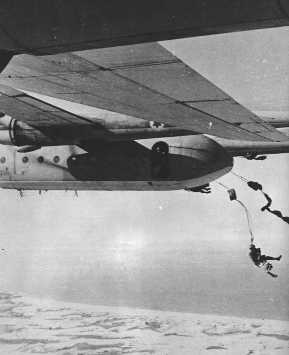
Noratlas jump with IDF Paratroopers
www.geocities.com/CapeCanaveral/Hangar/2848/noratlas.htm
Nord 2501 Noratlas
 www.youtube.com/watch?v=4f5pA3p2bww
www.youtube.com/watch?v=4f5pA3p2bww
The Nord Noratlas was designed for the French Air Force as a replacement for the Douglas C-47 and Junkers Ju-52 which suffered from an aft sloping floor, restricting side loading doors and a limited payload. The prototype Nord 2500 first took to the air on September 10th 1949, but changes made to the original design resulted in the improved Nord 2501 whose first flight took place on November 28th 1950. Officially named Noratlas in January 1953, the first examples were delivered to the Armיe de l'Air on June 12th. The type's distinctive characteristics were its twin booms supporting the tail unit, allowing for for a long uninterrupted hold terminating in rear clamshell doors. A total of 425 Noratlases were built, some remaining in civilian service well into the 1990s.
When France agreed to sell 12 Dassault Ouragans to Israel in 1955, it also insisted that Israel purchase 3 Nord Noratlases. The IAF did not want the Noratlas, a new aircraft that would require changes to its training and maintenance arrays. France, however, was the only country willing to sell jet fighters to Israel and the IAF grudgingly agreed to buy the new transport as well. This was the uninspired beginning of the type's long career with the IAF, during which it played an important part in Israel's various conflicts. Dan Tolkovsky, IAF Chief-of-Staff during the signing of the initial Noratlas deal, would later comment that this imposed sale turned out to be quite a blessing.
Two pilots and three mechanics from the 103rd "Elephants" transport squadron flew to France in September 1955 to study the new aircraft. On November 1st the first Israeli Noratlas landed at Tel-Nof AFB, flown by its Israeli crew, while the remaining two Noratlases were delivered during January 1956, this time by French crews. Commonly known as the Nord, the type was operated by the 103rd squadron alongside the IAF's C-47s. The Nord provided the IAF with new capabilites which it soon put to good use. During April 1956 the Nords participated in the delievery of the IAF's Dassault Mystere IVAs, escorting the fighters on their way to Israel. More Mysteres were delievered during August, and once again they were escorted by Nords all the way from France to Israel. As tensions were increasing in the Middle East following the Egyptian nationalization of the Suez Canal in July 1956, A Nord especially fitted with additional fuel tanks carried the Israeli delegation sent to France to lay the foundation of Franco-Israeli military cooperation.
The IAF's three Nords saw extensive use during operation "Kadesh", Israel's part in the Suez Campaign launched on October 29th 1956. During the early hours of October 30th the three Nords begun dropping supplies to the Paratroops at the Mitla Pass, a strategic point the troops had jumped into only a few hours before. More such supply flights were flown on subsequent days while one Nord even landed at a makeshift airstrip to evacuate casualties. More flights were flown in support of the Israeli effort in the southern Sinai, flights that also envolved inserting forces behind enemy lines. In all, the three Nords flew 51 sorties between October 30th and November 5th, by which the fighting had stopped. Nord Noratlases were also extensively used by the French during the Suez Campaign, transporting men and supplies to Israel, dropping supplies to Israeli troops on the ground as well as during the French airborne assault on Port Said.
By the outbreak of the Six Days War in June 1967 the IAF had 23 Noratlases in its inventory, 16 of which were former West German examples. In the days leading up to the eruption of the war the Nords were employed on maritime patrol missions, a role they continued to play once fighting broke out on June 5th. As Israeli forces advanced through the Sinai, Nords were also active in their support, dropping supplies and ammunition as well as evacuating the wounded. On June 7th Nords were about to drop dozens of Israeli Paratroops over Sharm-A-Sheik, an important stronghold at the southern tip of the Sinai, but instead disembarked them on the ground when it was discovered that the point had been abandoned. A single Nord was destroyed on June 5th in a Royal Jordanian Air Force strike against the IAF base at Sirkin. Sirkin was not actually an active air base at the time, but several Nords had been dispersed there to evade just such an attack! The Jordanians had apparently used out of date intelligence, from the time Sirkin was a flying base, home to the IAF flight school.
Noratlas dropping supplies during the Six Days War
The eruption of the War of Attrition following the Six Days War provided even more opportunities for the IAF's Noratlas fleet to prove its mettle. Throught the late 1960s, as the war raged on around the Suez Canal, the aircraft were employed delievering troops, supplies and ammunition to the front, evacuating wouded Israeli Soldiers on their return flights. In two most unusual missions the Nords became the first and only transport aircraft since the War of Independance to fly a bombing mission. In 1948 Israel had no other aircraft available for such a mission, but in 1969 8 Nords went on bombing missions deep into the heart of Egypt. The plans for these attacks were drawn up in the beginning of the 1969, their targets two bridges over the Nile river. The IAF selected the Nord for these missions for its large fuel and cargo loads, as well as to demonstrate the IAF's capacity to strike at Egypt in the most innovative ways. On April 29th 4 Nords, two for each bridge, took off on operation "Batzoret" (drought) with rudimentry navigation maps and a bomb developed especially for the mission. While one pair managed to damage their intended target, the other pair missed their target and dropped their load on another bridge. The relative success of the operation inspired another such attack, operation "Tarnegol 169" (rooster 169). This time however, the Nords were to overfly their targets before their bombing runs, and this almost brought the mission to a disasterous end. On October 26th 4 Nords once again took off on the seven hour flights into the heart of Egypt and back. While the first mission was a complete surprise, this time the Nords encountered a complete blackout over the Nile. When the aircraft reached their targets and attempted to carry out their overflights they were immediately fired upon by anti aircraft fire. Under heavy fire, some of the Nords completed their missions, dropping their bombloads on the bridges they were sent to destroy. One Nord however was heavily damaged and one of its engines destroyed while its companion's fuel tanks were ruptured. The pair, limping back to Israel, barely managed to land at an IAF base in the Sinai, one flying on one engine and the other on its last drops of fuel.
When the Yom Kippur War broke out on October 6th 1973 the Nords once again went into action, providing much needed support for Israeli troops on the various fronts. Their most important mission at the beginning of the war was ferrying much needed troops to the Egyptian front, while the rest of the war saw continues supply and evacuation flights. After 23 years in years service, the Nord was retired in 1978, replaced by the Lockheed C-130 Hercules. A number of Noratlases were sold to the Greek Air Force. Two Nords can be found at the IAF Museum at Hatzerim.
Specification: Nord 2501 Noratlas
Type: medium range tactical transport.
Powerplant: 2 x radial piston SNECMA-Bristol Hercules 758s.
Performance: max speed - 440km/h, service ceiling - 7,100m, range - 2,500km.
Weights: empty - 13,300kg, max takeoff - 22,000kg.
Dimensions: span - 32.50m, length - 21.95m, height - 6.0m.
Armament: none.
Date: 1956
Unit: 2nd Regiment, French Colonial Parachute Division
Operation: Musketeer
Troopers: 500
Country: Egypt
Drop zones: East side of Suez Canal, South of Port Said near Raswa bridge and South Port Fouad
Aircraft: Nord Nordatlas N2501s, Beverly
Equipment/supplies air-delivered: Ammunition, Food, water, medical supplies (wing bundles), Jeeps (underwing shackles)
Type Air delivery: Low-level mass tactical jump, LVAD
Jumping at 400 feet, the Indo-China and Algeria battle-hardened French Paratroops were on the ground in under 4 minutes. The Raswa bridge was seized despite Egyptian opposition in under 1 hour. French patrols were soon in control of the roads 6 miles south of the objective.
EXCLUSIVE! video clips of the British and French jumps into Suez! www.combatreform.org/legionetrangeresuez1956.wmv

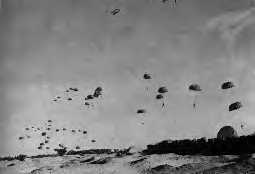
 www.youtube.com/watch?v=h0X1qIECZcU
www.youtube.com/watch?v=h0X1qIECZcU
EXCLUSIVE! The Parachute Regiment's Stirring History Video with 1956 Suez jump footage:
www.combatreform.org/britishparahistory.wmv
 www.youtube.com/watch?v=eMpuasQvBYg
www.youtube.com/watch?v=eMpuasQvBYg
Date: 1956
Unit: 3rd Battalion, The Parachute Regiment, British Paratroopers
Operation: Musketeer
Troopers: 600
Country: Egypt
Dropzone: Gamil airfield, west side of Suez Canal
Aircraft: Valettas, Hastings, Vikings piston-engined aircraft
Equipment/supplies air-delivered: ammunition, food, water, medical supplies (wing bundles), Jeeps (underwing shackles)
Type Air delivery: LVAD
www.standto.com/airborne/suez.html
THE SUEZ CRISIS
OPERATION MUSKETEER
5 November 1956
The Suez Canal
The Suez Canal was built in the 1860's by French engineers of La Universelle du Canal Maritime de Suez (Universal Company of the Maritime Suez Canal). It is a 101 mile canal connecting the Red Sea to the Mediterranean across the Egyptian desert. The northern end of the canal is at Port Said that is named for Sa`id Pasha the Viceroy of Egypt who gave permission for the canal to be built. Ownership of the canal was to be held by the French/Egyptian company for 100 years and then pass to the Egyptian government. In 1875 the British government purchased Egypt's shares in the company and in 1936 they signed an agreement that gave Britain the right to maintain defense forces in the Suez Canal Zone. A new agreement, signed in 1954, called for the removal of British troops by June of 1956. On 26 July, 1956, President Nasser ordered Egyptian forces to seize the canal after the British and the Americans withdrew their offer to finance the construction of the Aswan High Dam.
Israel Captures the Sinai
Britain and France wouldn't stand for Egypt's control of the canal, so they conspired with Israel to create an excuse for military intervention. The Israeli 202 Parachute Brigade jumped onto the Mitla Pass just east of the canal on 29 October, 1956. By doing so, they cut the Egyptian line of communication with the Sinai Peninsula allowing the Israelis to capture it. The operation was very bold in its planning and execution. They wanted complete surprise, so they didn't even do a reconnaissance of the Drop Zone (DZ). At 17:30 hrs the Israeli planes, after keeping low to avoid radar, climbed to a jump height of 700 feet. With only 395 men, the 202 were dropped three miles from their planned DZ. Within two hours they held the pass and after four hours their re-supply started to arrive. The Egyptians struck back, the 202 Parachute Brigade suffered heavy losses but held until morning when Israeli fighter jets could provide air cover.
Britain and France Issue an Ultimatum
The response from Britain and France was to call for a halt to all military operations in the Suez Canal Zone. The ultimatum called for Israel and Egypt to keep their troops ten miles back from the canal and on opposite sides. Israel agreed immediately because their forces still hadn't reached the canal. Egypt didn't even acknowledge the ultimatum because it represented a loss of territory and they probably knew what the British and French had in mind. At the UN, the a resolution calling for a withdrawal by Israel was vetoed by Britain and France (this was the first time they ever used their veto). The U.S. sponsored a resolution calling for a cease-fire that passed by a 64-5 vote. Egypt accepted it but, under pressure from Britain and France, Israel refused. The hostilities that had just about ceased on their own flared up again.
The Invasion of Port Said
By 30 October, the 3rd Battalion, of the Parachute Regiment, in Cyprus, was starting to prepare for an "airborne exercise." On 3 November they got their orders for Operation Musketeer, an invasion of Port Said set for 6 November. The jump was moved forward by 24 hours leaving the naval support, sailing from Malta, out of range for the first day of the invasion. The aircraft used were Valettas carrying twenty jumpers and Hastings carrying thirty. At 0300 hrs they boarded the planes for the jump that was to take place just after dawn. Many men slept on the planes. On 5 November, 1956, 3 Para jumped from six hundred feet onto the El Gamil Airfield. P-Hr (parachute hour) was 0515. The winds were almost zero. Their Intelligence told them they would be outnumbered five to one. The Egyptians had an armoured division in the desert to the south of the town and a battalion group surrounding the airfield. The orders called for "A" Coy to capture the control tower buildings and then secure a bridge at the west end of the field. Before take-off aerial photos showed the bridge had already been destroyed. "B" Coy was to capture the buildings at the east end of the airfield. Many members of "B" Coy landed right on the Egyptian position and were engaged in immediate hand-to-hand combat. "B" Coy lost five to ten percent of their men within seconds. The British method of packing their weapons in Sims containers caused great difficulty for those who found themselves under fire even before they landed. The north and south side of the airfield were bounded by water "C" Coy was to act as a reserve force and assist in capturing the buildings. The Paras captured the airfield in about forty five minutes and had it ready to use by noon. Unfortunately, the runways were too short for the British transport planes so all their reinforcements and supplies had to be parachuted in.
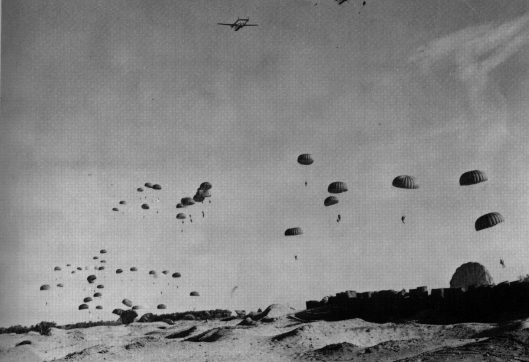
To the south, the French were jumping onto a narrow strip of sand beside the canal at Port Fuad. The 2 Regiment Parachutiste Coloniale and part of 11 Demi-Brigade Parachutiste de Choc flew in at 400 feet and dropped onto a DZ that was only 500 yards long and 200 yards wide. They immediately came under mortar and machine gun fire. From his flying command post, their commander saw the paratroopers were in trouble so he called in air strikes against the Egyptian positions. With the air support, Les Paras overcame the opposition and moved north to the bridges across the Junction Canal that controlled access to Port Said from the south. One of the two bridges was already destroyed and the other was under fire from tanks on the golf course to the north. French Paratroops have always been known for their daring. Under cover of the air attack, they raced forward and captured the objective. This assured the break-out from Port Said once the amphibious landing took place the next day.
Lessons Learned
This operation served as a rude awakening for the British Paratroopers. They had not done an operational jump since the Rhine Crossing in 1945. Most of the equipment they used was unchanged from the second World War. They even had to raid a museum to get a "dropping beam" to attach a load to the fuselage of one of their aircraft. This was the first time the British dropped the 106mm (a recoilless anti-tank rifle) and a special metal cylinder had to be made. It held two guns and used corrugated cardboard to cushion them.
Good Airborne Stories That Might Even Be True
President Nasser of Egypt had just bought some arms from Czechoslovakia so when the British Paras got on the ground they started to find lots of Soviet kit. Many Paras traded in their issued Sten Guns for AK-47s because the Stens that had served so well in WW II kept jamming in the sandy conditions.
This was the first time the British ever dropped the 106mm Recoilless Rifle. The 106mm was an anti-tank gun built by the Americans. It fired a 105mm round (the name 106 was so the ammunition wouldn't be confused with Artillery rounds) and had a .50 cal spotting rifle mounted on top. The two rifles were zeroed together so their rounds had the same trajectory. The weapon would be aimed at the target, a .50 cal spotting round would be fired and if it hit the main gun would fire. This gave it a very high accuracy rating. During the fighting, a group of Paras captured an Egyptian SU-100 (a Soviet self propelled anti-tank gun) and were driving it back to British lines when it was seen by members of the anti-tank platoon. They fired one spotting round that missed. The second one hit and they were a split second from destroying it when someone recognized the driver and called cease-fire.
Years after the battle, Paras on the anti-tank course were told this story. An Egyptian SU-100 was approaching a 106. The gunner fired his spotting round and hit it. The Egyptians recognized that a spotting round had just hit them and immediately jumped out and took cover. Nothing happened. The Egyptians assumed they had made a mistake so they climbed back into their vehicle. The British gunner, who was still dead on target, fired his main gun destroying the vehicle and its crew. The moral is - a spotting round is a spotting round, don't get back into the vehicle.
On several occasions the Paras found piles of boots on the Egyptian positions. Apparently the Egyptians found it was easier to run on the sand in bare feet than in boots.
Date: 1961
Unit: Indonesian Paratroopers
Operation: Musketeer
Troopers: ?
Country: Indonesia
Dropzone: Irain Jaya
Aircraft: C-47, C-130, AN-12
Equipment/supplies air-delivered: ammunition, food, water, medical supplies
Type Air delivery: LVAD
Indonesian Airborne also used paratroopers during the fighting in 1961 with the Dutch in Irain Jaya. They dropped in para-commandos from C-130s, An-12s and C-47s to raid Dutch targets. Many of these raids failed but in the end America and Russia forced the Dutch to turn over the Island. They used the RPKAD (now called KOPASSUS) and the Air Force commandos the PGT (now called PASKHAS). Also in the late 1950s the RPKAD was used to take rebel airfields held by an American backed movement the PERMESTA. The RPKAD did several combat jumps from C-47s to take airfields and block the retreat. This was the operation which eventually lead to the shoot down of Alan Pope a CIA B-26 pilot by an AURI (air force) F-51D and his capture. The American government more or less paid a ransom for his release. Airborne forces have been used also in Irian Jaya to fight the OPM.
Date: April 17, 1961
Unit: Free Cuban Paratroopers of Brigade 2506
Operation: Zapata
Troopers: 177
Country: Cuba
Drop zone: Road junction in San Blas near northern tip of the Bay of Pigs; Playa Larga and east of the bay at the village of Jocumma
Aircraft: 6 x C-46 Commandos piston-engined aircraft
Equipment/supplies air-delivered: Crew-served machine guns
Type Air delivery: Day Mass low-level tactical personnel static-line jump in support of NIGHT amphibious landing by blocking roads leading to invasion beaches to enemy forces
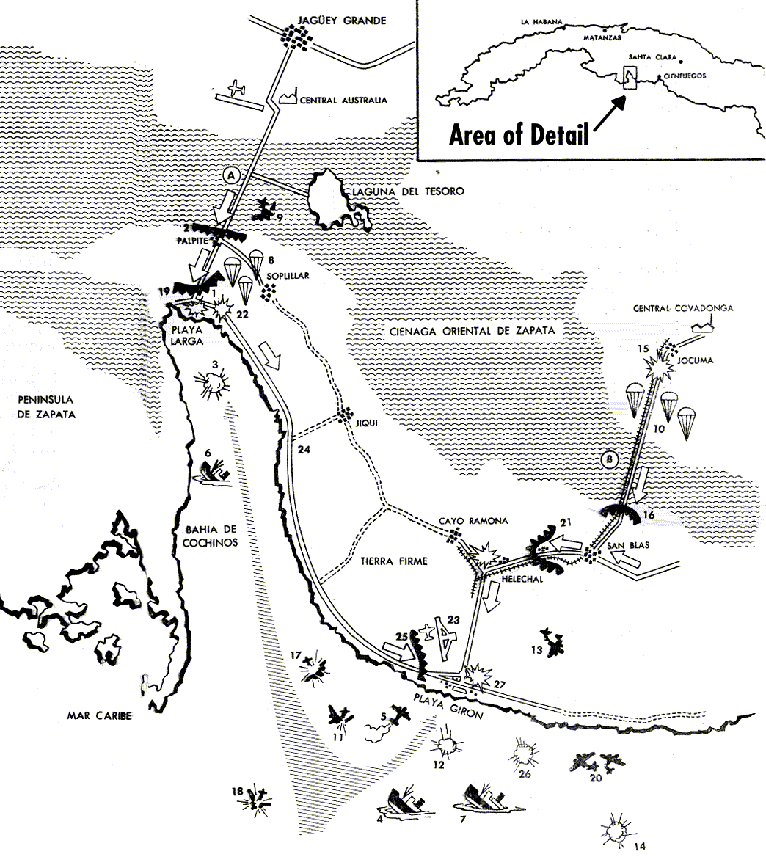
Map of Bay of Pigs Invasion showing 2 drop zones; source: ww.parascope.com/articles/1296/invasmap.gif
The leadership on the beach was competent enough for the job at hand. The Cubans themselves were good. The tactical leadership back in Nicaragua both for the invasion and for the small air strikes was adequate. The substratum of U.S. military personnel attached to the CIA to bring some order out of the training program was competent, especially the U.S. marine corps colonel who worked so hard and effectively to see that the little band of Cubans had some idea of what to do when they hit the poorly chosen marshy beaches, a NIGHT AMPHIBIOUS OPERATION which had never been done before. The U.S. Air Force officers attached to the CIA who pulled together the small hard-hitting air force of World War II B-26s and C-46s were skilled and combat qualified. But above them leadership was practically non-existent.
No proper official would have approved of the Bay of Pigs operation unless there was a guarantee that Cuban communist dictator Fidel Castro would not have been able to give it any effective air opposition. The few close-in, hard-core officers who knew the real plan would never have given any support to the plan if they did not have assurances that Allen Dulles would be able to guarantee that Castro's few combat-ready aircraft would have been bombed out of existence before the men hit the beach. This was the fundament upon which the operation was established; it was its failure that sealed its doom.
Before the first Cuban exiles' B-26 attacks on Castro's aircraft, U-2 pictures detailed exactly where Fidel's planes were and how many there were. The first wave of B-26s hit those planes and destroyed them, with the exception of the three T-33 jet trainers, two B-26s, and a few old British Sea Furies. In modern air-weapons-system technology the T-33 is a very low-order combat aircraft, and actually it has very little combat capability. However, it is a big jump better than the B-26 bomber in air-to-air combat. Therefore, until these three T-33s had been located and destroyed, there was to be no invasion. The B-26s and the Sea Furies could be handled and ignored. Castro's B-26s were not nearly as effective as the newly modified ones of the Cuban exiles.
It had just happened that the three T-33 jets had been flown to a small airfield outside of the Havana area for the weekend. The chance removal of these planes saved them from the first attack.
The Bay of Pigs instructions called for additional air strikes to get all of Castro's planes if this was not accomplished by the first strikes. This prerequisite was simple and necessary. Damage assessment photos not only showed that the T-33s had escaped, but they showed where they were, lined up on an airfield near Santiago. With this knowledge, a flight of B-26s at Puerto Cabezas in Nicaragua was loaded with bombs and fueled for the long flight to the target. These were excellent B-26s, which had been modified by the CIA to have a cluster of eight 50-caliber machine guns firing from the nose. This gun-pack is most lethal and unsurpassed for the type of operation contemplated. The guns could have made mincemeat of Castro's T-33s on the ground. In the air, the T-33s would have chopped them up. Thus the plan was for these planes to leave Puerto Cabezas at an early hour to assure undetected arrival at the target at sunrise and to permit them to sweep in over the airfield with the sun low and at their backs to give them as much groundfire protection as they could get.
As late as one thirty that morning the CIA agent who was in charge of these planes in Nicaragua had not received the expected message from Washington that would authorize their take-off. Later, acting on his own initiative and to keep the excited and ready-to-go Cubans quiet, he permitted them to start their engines on condition that they wait for his signal for take-off. Meanwhile in Washington, heated arguments had arisen over the air strikes. There was so much opposition to the second strike that those who sought the authority to release these planes were unable to gain approval.
On the one hand, General Cabell, the Deputy Director of Central Intelligence, and Richard Bissell, the Deputy Director of Plans, and the man who was responsible for the entire operation, were second-level officials. They were unable to release the planes on their own authority, and they were opposed by others, some of whom were of Cabinet level. It became a question of who would awaken President Kennedy at his Glen Ora retreat in Virginia in an attempt to get his approval. Neither Cabell nor Bissell had the authority to do that, and Allen Dulles was not in Washington. At this crucial time when his agency was faced with its most momentous crisis, a crisis of leadership, Dulles had left Washington to go to Puerto Rico to address the convention of the Young Presidents Organization. He was the man who could have given permission for the planes to go, or who could have gone to the President himself for that authority. On that fateful night the CIA was leaderless. The opposition stood its ground, and the air strike was not ordered to attack the jets at Santiago. This was the key to the failure of the whole operation.
Those three jets destroyed no less than ten B-26s, along with some ground equipment, and sank the vital supply ship "Houston" offshore. The Cuban air force made quick work of the supply ships, sinking the command vessel the Marsopa and the supply ship the Houston, blasting them to pieces with five-inch rockets. In the end the 5th battalion was lost, which was on the Houston, as well as the supplies for the landing teams and eight other smaller vessels. With some of the invading forces' ships destroyed, and no command and control ship, the logistics of the operation soon broke down as the other supply ships were kept at bay by Castro's air force. As with many failed military adventures, one of the problems with this one was with supplying the troops.
In the air, the Communist Cubans won superiority over the invading force. Fast moving T-33s (500 mph), although unimpressive by today's standards, made short work of the slow moving B-26s (250 mph) of the invading force. On Tuesday, two were shot out of the sky and by Wednesday the invaders had lost 10 of their 12 aircraft. With air power firmly in control of Castro's forces, the end was near for the invading army.
Over the 72 hours the invading force of about 1500 men were pounded by the Cubans. Casto fired 122mm. Howitzers, 20mm. anti-aircraft cannon, and tank fire at them. By Wednesday the invaders were pushed back to their landing zone at Playa Girón. Surrounded by Castro's forces some began to surrender while others fled into the hills. In total 114 men were killed in the slaughter while thirty-six died as prisoners in Cuban cells. Others were to live out twenty years or more in those cells as men plotting to topple the government of Castro.
 Amphibious failure, advised by marines
Amphibious failure, advised by marines
Perhaps if one CIA agent had taken a short bicycle ride, the whole invasion would have been a success. The Cuban pilots in those B-26s on the ground at Puerto Cabezas, Nicaragua with their engines running, were on the point of mutiny. They were going to go without word from Washington, except for one thing. The agent who had the sole authority there to release them had told them that Washington was making a last-minute check of the target photographs and that they had better wait until he got the word. They half believed him. Later, his own faith in the system wavered badly, and he knew that as the moments ticked away the last chance the B-26s would have to get to the target airfield before sunrise would be gone. After that, Castro s jets could be expected to be gone.
Nearby, the agent had a bicycle that he used for his trips back and forth to the operations shack where the circuit to Washington was. During those last few moments he looked at that bicycle, certain that if he just got on it and rode away toward the shack the Cubans would go without waiting for his signal. The temptation was great. He had worked with some of those Cubans for two years; he knew how badly they wanted the operation to succeed. But his own discipline was stronger, and he did not take that ride. Finally, it was too late. The crews shut down the engines and got out of the planes.
Far across the Caribbean the small invasion fleet approached the shore secure in the belief that Castro's planes had been destroyed. They hit the beach shortly after sunrise, and it wasn't long before they came under heavy air attack. They knew then that their time was limited. To add to this tragedy, the same B- 26s that were to have wiped out the jets were ordered over the beach to give the invasion troops some firepower against ground opposition. The B-26s were shot down by those jets which only a few hours earlier they could have destroyed. And in sunny Puerto Rico the DCI entered a convention hall to give a speech to a group of young businessmen. This was the kind of elite group he liked. He was at his best among them, and he enlisted their support on behalf of the Agency, which was "saving the world from communism." Many of those same men have since traveled throughout the world on matters concerning business, wearing around their necks the mark of the Agency -- the shoulder strap of a new camera. These same men eagerly went from country to country as special agents for the CIA. But when the chips were down and those brave Cubans had been landed on the beach by the CIA, Allen Dulles was not there. He was perhaps the one man in Washington, had he been there, who could have sent those bombers out that morning for the purpose of destroying Castro's jets.
Date: 1962-1980
Unit: Rhodesian Fire Force Paratroopers
Operation: ?
Troopers: Varied, numerous operations
Country: Rhodesia
Dropzone: Many
Aircraft: C-47 ParaDak piston-engined aircraft, Alouette III turbine-powered helicopters, troop carrying "G" cars and gunships "K" cars with 20mm cannon or 7.62mm or .303 cal MMGs
Equipment/supplies air-delivered: Crew-served machine guns
Type Air delivery: Day Mass low-level tactical personnel static-line jump in order to encircle/destroy/cut off ZANLA Communist guerrillas/terrorists.
Very innovative use of fixed-wing and rotary-wing aircraft to deliver and extract decisive ground forces. Details:
excellent military reading!
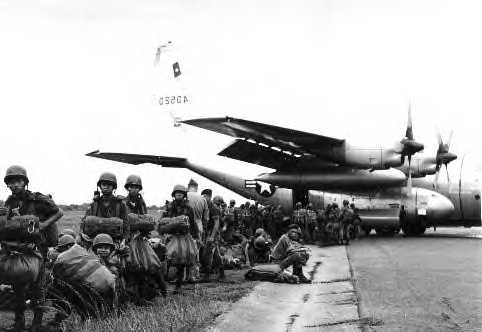
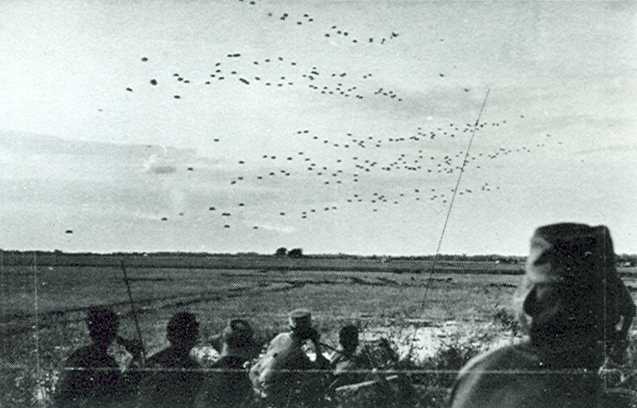
Date: 1963
Unit: ARmy of south VietNam (ARVN) Paratrooper Bn
Operation: ?
Troopers: 300 ARVN + 2 U.S. "Red Hat" Advisors
Country: South Vietnam
Dropzone: Ap Tan Thoi
Aircraft: 7 x USAF C-123s Provider piston-engined aircraft
Equipment/supplies air-delivered: Crew-served machine guns
Type Air delivery: Day Mass low-level tactical personnel static-line jump in order to cut off withdrawing Viet Cong forces.
U.S. Army MACV advisor LTC John Paul Vann attempts to cut-off withdrawing VC forces from Ap Bac village with an ARVN parachute assault to their rear line of retreat. The VC had earlier ambushed ARVN Air and mechanized forces that had tried to seize a radio ransmitter in Ap Tan Thoi village. However, the ARVN Commander was afraid to trap the VC and have to fight, so he conveniently dropped the ARVN Paratroopers in a place where the VC would still be able to escape.
Heart of Darkness: the Tragedy of the Congo, 1960-67
Date: 1964
Unit: USAF C-130E squadron, Belgian ParaCommando Regiment
Operation: Dragon Rouge
Troopers: 338 Belgians, 2 Americans
Country: Belgian Congo
Drop zone: Stanleyville Airport
Aircraft: C-130E Hercules turboprop aircraft, 2 x CIA Cuban-exile piloted B-26 Invaders
Equipment/supplies air-delivered: Armored gun jeeps, jeeps, AS-24 tricycle ATVs, crew-served machine guns
Type Air delivery: Day Mass low-level tactical personnel static-line jump
See other details in American Airborne section.
DETAILED HISTORY:
Dragon Operations: Hostage Rescues in the Congo, 1964 - 1965, Major Thomas P. Odom.
www-cgsc.army.mil/carl/resources/csi/odom/odom.asp
Date: 26 November 1964, 0602 Zulu hours
Unit: USAF C-130E squadron, Belgian Paratrooper Regiment
Operation: Dragon Noir
Troopers: 246 Belgian Paras
Country: Belgian Congo
Drop zone: Paulis Airport
Aircraft: 4 x C-130Es Hercules turboprop aircraft, 2 x CIA Cuban-exile piloted B-26 Invaders
Equipment/supplies air-delivered: Armored Gun jeeps, jeeps, AS-24 tricycle ATVs, crew-served machine guns
Type Air delivery: 3 passes; Day Mass low-level tactical personnel static-line jump from 600 feet
The 11th ParaCommando company jumped into the center and western portion of Paulis airport. Moves into Paulis from southeast and establishes a roadblock northwest of the city. 13th company jumped into the center and east of the runway and clears it for the airlanded jeeps and ATVs. By 0805, the Paracommandos had rescued and evacuated over 200 people.
Further reading: Dragon Operations: Hostage Rescues in the Congo, 1964-1965 by Major Thomas P. Odom, U.S. Army
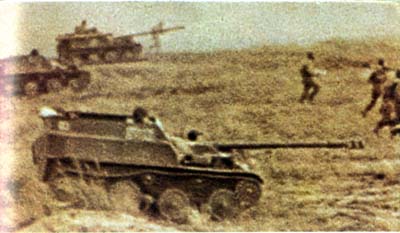
EXCLUSIVE VIDEO! Click here to see Russian Paratroopers Jump followed by ASU-57 Assault Guns!
Date: 1968
Unit: Russian Paratroopers
Operation: ?
Troopers: 12,000
Country: Czechloslavakia
Assault zone: Prague Airport
Aircraft: AN-12 Cub turboprop aircraft
Equipment/supplies air-delivered: ASU-57 Assault gun armored vehicles, Gun jeeps, Crew-served machine guns
Type Air delivery: Day low-level tactical airland operation
Date: 1971
Unit: Indian Army Paratroopers
Operation: ?
Troopers: 1200
Country: East Pakistan
Drop zone: Tangail
Aircraft: AN-12 Cub turboprop aircraft
Equipment/supplies air-delivered: Gun jeeps, Crew-served machine guns
Type Air delivery: Day low-level tactical mass parachute assault
The 1971 Indo/Pakistani War began with Pakistan persecuting millions of people in the nation formerly called "East Pakistan". These people fled the intolerance of the Muslims into India. India waited for the UN to do something and after weeks of inaction decided to plan on invading East Pakistan so the six million refuges could return. After Pakistan attacked, they had the "green light" but little time to act before the Super-powers would intervene and stop the fighting. Both sides knew as in all modern wars, that time is their main enemy. The Pakistanis airlifted 2 Infantry Divisions to East Pakistan. They tried to catch the IAF on the ground like the Israelis had hit the Arabs in 1967, but the IAF aircraft were in dispersed, hardenened shelters. The Air War pitted a handful of IAF pilots in Folland Gnats and MIG-21s with guns versus PAF F-86 Sabres and F-104 Starfighters with both guns and Sidewinder AAMs. The results were legendary.
What is exceptional is the way India skillfully fought the war with brillant operational maneuver, while the East Pakistani's dug in expecting a head-on attack. The Indian commanders realized that their enemy would try to use the extremely wide rivers there as a natural defense, fleeing to the high ground in between. The Indian invasion along multiple accesses deceived the Pakistani's into thinking they were coming head-on when actually they went behind, bypassing the fortified towns and villages and took the key terrain the Pakistani's were counting on to hold out for a UN brokered deadlock: Dhaka.
To do this, the Indians used PT-76 amphibious light tanks and bridging gear from the Russians to cross the wide rivers and bypass the defended towns, winning by maneuver warfare. As the Pakistanis realized their error, an Airborne operation by IAF transport aircraft dropped a Battalion of Paratroopers at Tangail to prevent retreating Pakistani Soldiers from entering Dhaka where they could have re-organised for a last stand. The sea avenue of retreat was cut-off by the Indian Navy with missile patrol boat attacks and a conventional deck aircraft carrier.
The result was victory, with the fall of East Pakistan and the creation of the independant nation of Bangladesh.
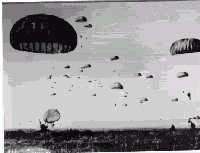
Date: June 20, 1974
Unit: Turkish Para Commando Brigades
Operation: ?
Troopers: 10,000
Country: Cyprus
Assault zone: Nicosia
Aircraft: ?
Equipment/supplies air-delivered: ?
Type Air delivery: Mass tactical parachute (daylight)
Paratroopers were dropped a few miles north of Nicosia between Gönyeli and Hamitköy as part of the over-all invasion to seize the northern 37% of the island, secure the safety of people of Turkish descent and set up "Attila line" seperating Greece and turkish controlled parts of the island.
Date: December 7, 1975
Unit: Indonesian Paratroopers
Operation: Komodo
Troopers: 641
Country: Dilli, East Timor
Assault zone: Dilli Airport
Aircraft: 9 x C-130B Hercules 31st Squadron
Equipment/supplies air-delivered: troops with rifles, machine guns, grenades
Army Special Force 1st Group led by Lieutenant Colonel (Inf.) Soegito and 501st Airborne Infantry Battalion under the command of Lieutenant Colonel (Inf.) Matrodji.
Date: December 8, 1975
Unit: Indonesian Paratroopers
Operation: Komodo
Troopers: 400
Country: Dilli, East Timor
Drop Zone: Komoro
Aircraft: 5 x C-130B Hercules 31st Squadron
Equipment/supplies air-delivered: troops with rifles, machine guns, grenades
The second sortie, from Penfui Airport, Kupang, was 502nd Battalion under Major (Inf.) Warsito will follow, the target was Komoro. Especially for the Red Beret (Army Special Force), this operation was preceded by Denpur-1 (Combat Detachment), also called Nanggala-5, under the command of Major (Inf.) Atang Sutisna.
www.angkasa-online.com/09/05/english/english1.htm
Sky Assault on Dili
For only seven hours, on Sunday December 7, 1975, through the biggest Airborne operation in ABRI's history, the city of Dili, East Timor, was taken over. 1st Group Kopassandha (Army Special Forces) and 18th Brigade/Kostrad (Army Strategic Reserve Command) Airborne, mostly from 502 Battalion/Raiders, East Java, parachuted from nine Air Force C-130B Hercules
At about 05.00 WITA, BTP-5 (Battalion Landing Team)/marine Infantry, tip toed at Alor Village's beach. With the support of gun fire from Indonesian Navy warship, BTP-5 headed the big plan of taking over the city of Dili, December 7, 1975. The operation was the continuation of "Operation Komodo" by Bakin at the beginning of 1975, to anticipate more political problems in Timor Loro Sae (East Land of the Rising Sun). This prolonged political euphoria forces Indonesia to step up the operation into a limited Sandhi Yudha operation (combat intelligence) with the code name "Operasi Flamboyan (Operation Poinciana). This operation led by Colonel Dading Kalbuadi, with the Army Special Forces as 1st Group operation's core strike force that have placed 2nd Combat Detachment at the border since October 1975, will later change into "Operation Seroja" (Operation Lotus). Dili's take over, preceded by this amphibious operation, was decided by Minister of Defense/Commander in Chief of the Armed Forces General Maraden Panggabean, December 4 in Kupang. The operation itself was executed through considerations and field analysis after observing Fretilin troop's movement. Indonesia's firmness was also based on the Timor Portugal people's wish to integrate with Indonesia. The attitude represented by four parties; Apodeti (Associacao Popular Democratica de Timor), UDT (Uniao Democratica de Timorense), KOTA (Klibur Oan Timor Aswin), and Trabalista, known as the Balibo Declaration, November 30, 1975. This attitude also competes against the one-sided declaration of East Timor Democratic Republic by Fretilin (Fronte Revolucionaria de Timor Leste Indepedente), two days before. Before the struggle of Dili, Fretilin has been involved in a shoot out with ABRI troops in the struggle of Batugede Fort (October 7). Another reason, the rise of border violations interspersed with cattle thefts by Fretilin in Belu Regency, East Nusa Tenggara. The rising violations since June 1975 were frequently caught red handed by ABRI, which caused shootouts. Casualties started to fall. Since October 1, Operation Lotus Joint Task Command (Kogasgab) has detected two Portuguese Navy frigate warships off Timor. Unfortunately, the morning of December 7, the two ships started to approach Dili's offshore. "They have anchored nearer to Atauro Island, because that was where the escapee Portuguese government from Timor was situated," said Hendro Subroto. It might be a coincidence, at the straits separating Atauro island and Alor island, three Hercules in arrow formation one formation with there planes would make abeam maneuvers (the plane's position is 90 degrees towards a checkpoint at the left or right side of the plane).
At the end of December 6 1975, at Iswahyudi Air Force Base, Madiun, East Java, unusually, hundreds of heavily armed troops milled about. Some wore American made T-10 parachutes, while others holds Soviet made AK-47 assault rifles. At the apron, nine 31st Squadron heavy transport C-130B Hercules, were ready to take-off. Several aircrews took the opportunity to take final check up before airborne. The nine planes arrived at Iswahyudi Air Force Base that afternoon. Lieutenant Colonel Pilot Suakadirul said, he got the order to depart for Iswahyudi Air Force Base on Friday, December 5, from Colonel Pilot Susetyo, Operation Lotus Air Unit Commander. The order: after Friday prayer, all members of the 31st Squadron should be combat ready. None was allowed to go home. "I didn't know the direction of the order at that time. But I can guess by looking at the development of the situation," remembers Air Vice Marshal (Ret) Suakadirul. In the classified order, 31th Squadron Commander was asked to get 12 planes ready to airlift battalion of Paratroopers. "So I have to get 12 crew sets ready. Pilots, co-pilots, navigators, flight engineers, radio telegraphists, loadmasters and his assistants. That's about 120 people," he said. Incidentally two of his planes were in service, so only ten planes can be readied. For the pilots, Suakadirul purporsely stationed two senior pilots Lieutnant Colonel Pilot Siboen and Colonel Pilot Suhardjo. "As role models." So, the next day, nine C-130s left from Halim Perdanakusuma to Iswahyudi. Three of them transported the Army Special Forces. That afternoon, in Madiun, Suakadirul received explanation that there will be airborne operation in Dili, and his fleet will transport one parachute battalion. "One plane carried 100 people," explained Hendro, the journalist who covered the incident. On the same day in Timor, 403rd Battalion/Kostrad Raiders arrived offshore Tailaco with the Landing Ship Tank (LST) KRI Teluk Bone. In the afternoon, followed by BTP-5/1st Marine Brigade Infantry entered the LST for the preparations of the amphibious landing in Dili at 05.00 the next day. December 6, at 23.50, flight leader Lieutnant Colonel Pilot Suakadirul, started the operation by flying T-1308 Hercules. In succession, in the dark of night, eight planes left Iswahyudi Air Force Base runway. The planes moved towards Ponorogo and Denpasar, nine planes started the arrow formation with the plane's jet exhaust and take-off light as guide. The nature of the operation was a surprise attack. The nine Hercules formations were code named Rajawali (Condor) Flight. To maintain secrecy, radio silence was adopted during the flight. Communication between pilots was done through Morse code. The planes kept gaining altitude until they reached 22,000 feet with the speed of 280 knots. Above Denpasar, the flight leader sent a morse code to Ngurah Rai Airport's air traffic control(ATC) informing that Rajawali abeam Denpasar. Through Denpasar, Suakadirul contacted Penfui Airport, Kupang, to inform Rajawali flight's position at several checkpoints to Operation Lotus Command Headquarters on KRI Ratulangi submarine's tender ship. The slowest T-1308 was chosen as flight leader so that the other planes as wingmen can easily adjust their flight formation. Acting as wingmen were Lieutenant Colonel Pilot Sudji Harsono (left) and Colonel Pilot Suhardjo (right). Lieutenant Colonel Pilot Siboen (leader) flew the second arrow formation, two miles behind were Lieutenant Colonel Pilot O H Wello (left) and Lieutenant Colonel Pilot Sukandar (right). The third arrow was led by Lieutenant Colonel Pilot Masulili consisted of Major Pilot Achlid Muchlas/Major Pilot Sudiyarso (left) and Major Pilot Murdowo (right). Suakadirul illustrates; it was very quiet on the planes. Their breaths got heavier, understandably, this was the first airborne operation in Dili and the biggest for Hercules in ABRI's history. Waiting was obviously boring. Especially when the target was a war zone. The flight to Dili was estimated to take 4 hours and 50 minutes. Each plane carried 42,000 pound of JP-4 fuel, enough for 10 hours and 30 minutes flight. The broad outline, the airdrop operation to take over Dili from Fretilin's hand was done in three sorties.
The first sortie, with Dili as the target, consisted of Army Special Force 1st Group led by Lieutenant Colonel (Inf.) Soegito and 501st Airborne Infantry Battalion under the command of Lieutenant Colonel (Inf.) Matrodji. The second sortie, from Penfui Airport, Kupang, was 502nd Battalion under Major (Inf.) Warsito will follow, the target was Komoro. Especially for the Red Beret (Army Special Force), this operation was preceded by Denpur-1 (Combat Detachment), also called Nanggala-5, under the command of Major (Inf.) Atang Sutisna. The third sortie was also airlifted from Kupang. Lieutenant Colonel Soegito divided Nangggala-5 into three teams. Teams A led by Major Atang Sutisna, in charge of taking the governor's office. Team B led by First Lieutenant Atang Sanjaya, in charges of taking over Dili Harbour. While Team C led by First Lieutenant Luhut Panjaitan, in charge of taking Dili's airport. All three teams were spread in four front Hercules, with the consideration that if one got problems or hit by enemy fire, the team can depend on the other planes. That means, the operation must continue. The troops of the second and third sorties that will be flown from Kupang were from Jakarta and East Java. Because of TNI AU's limited ability in air transportation support, troops transportation to Kupang used Garuda Indonesian Airway's planes. Garuda bridged troop transportation from Halim Perdanakusuma and Iswahyudi using 17 Fokker F-28 and four Fokker F-27 Friendship. Garuda's managing director, Wiweko Supono, directly supervised this bridging operation. To maintain the element of surprise, obviously the operation was not only based on the knowledge of the droping zone. Airstrike also played their part. Irian Jaya's take over achieved air superiority, because it was supported by fighter planes. Bombers and transport planes must get also close air support. On the other hand, for Dili, air fire support (AFS) was a problem. This was caused by the grounding of all P-51 Mustang of 3rd Squadron/Tactical Fighter after a series of accidents, killing, among other, Major Pilot Sriyono. While advanced training aircrafts T-33 T-Bird and ex-Australian F-86 Sabre, were not yet armed. Of the seven B-26 Invader bomber of 2nd Squadron/Tactical Bomber, only two were serviceable. There were only two pilots still qualified to fly these WW II veterans. They were Lieutenant Colonel Pilot Danendra (Penfui Air force Base Commander) and Major Pilot Soemarsono, called to duty from Pelita Air Service. During the Vietnam War the United States realized the importance of AFS. Not surprisingly, later, General John P. McConnel proposed the modification of C-47 into a gunship. The Dakota was later popularly known as the Gooney Bird. It was also now called AC-47 it used to be FC-47. Twenty aircrafts equipped with three 7.62 mm machine guns at the sides, were used by USAF during the Vietnam war aside from AC-130 Spectre Gunship. Inspired by the popular gunship, two C-47 Dakotas of 2nd Squadron/TNI AU's Light Transport, were transformed into AC-47 gunship. Mechanics and technicians of 10th Aircraft Maintenance Depot, Bandung, installed three 0.50-mm caliber machine guns to each planes. Firing test were done along Timor Portugal border in September 1975. Two B-26s and two AC-47s were completed, ready to provide AFS for the airborne operation on the December 7.
Go! The planes keep moving in silence. Occasionally, the sound of Morse code breaks the silence. On the east of Flores, Rajawali Flight slowly descends to 5.000 feet while arranging the dropping formation. Directly above Alor Island at 7.000 feet, the red light by the door started to flash and the bells rang three times to signal the troops to get ready. Ten minutes left for jumping time nearing green light. Kopassandha and 18th Brigade/Kostrad Airborne soldiers attached their hooks at the end of the straps on the metal cable through the cabin. Quickly, backpack, weapons, and individual equipment' were straighened up. There was almost no noise. Everyone kept silent with his or her own duties. Abeam Atauro, the planes reached 5,000 feet. Because the radar was tuned to the weather, Suakadirul was shocked to see two Portuguese frigates Joao Roby and Alfonso de Alburquerque anchored offshore Atauro. "There was no information on the two ships equipped with radar and sonar anchored at Atauro," protested Suakadirul. Strange. Even though KRI Ratulangi has passed Joao Roby at Timor territorial waters, October 23. What was more surprising, the existence of the ship, which has 3 100-mm guns, has already been known since October 1. "That's what I didn't understand," answer Suakadirul. The doors at both sides of the planes started to open. The speed was reduced to 110 knots. "I said we were at 5,000 feet. The yellow light was on, then depressurized," said Suakadirul. The time left to the dropping zone was four minutes. Slowly, the horizontal distance between planes was shortened to about 300 feet (about 100 meters). So was the vertical distance between planes, only a 50 feet distance. "I was at an altitude of 900 feet," said Suakadirul. So if you calculate to the last plane, the altitude reached 1,250 feet. Approaching Dili's shore, with reference to Tanjung Fatukama, Rajawali flight turned to the right headed towards the center of Dili. To be able to fly the planes at 110 knots, according to Suakadirul, the flaps were lowered about 50 percent. For Suakadirul, Dili was nothing new. On 1970, this Chekoslovakian graduate frequently traveled Zamrud's Dakota with Denpasar, Rembiga, Sumbawa, Kupang, and Dili as his route for RON (remain overnight). Meanwhile the navigator said, "two minutes ahead." Nine planes appeared from behind the hills without B-26 and AC-47 escorts. The bell rang for about five seconds after the Hercules T-1308 flew across the West Side of a fishermen's village. Suakadirul's watch showed the time as 05.45, at the exact time the yellow light turned to green. "My throat suddenly went dry," he said. Only seconds to 05.45, the jumping master shouted, "Ready?" Followed by the order, "Stand by the door!" Several seconds later, the jumping master shouted louder. "Go!" Taking 260 degrees direction or almost west of the line paralleled to Dr. Antonio de Carvalho Street in the middle of Dili, the first troop jumped from the Hercules T-1308. Later hundreds, from Kopassandha and Kostrad, jumped from every plane. On the fourth count, T-10 parachutes with their olive green color mushroomed over Dili. Because Fretilin's triangle communication between Dili-Atauro-Portueguese frigates was very good, the firts sortie's jump has lost the element of surprise. The troops were fired upon sporadically from the ground. Fretilin's tracers were like lightning bugs in the dark of night. The paratroopers, still floating in the air, return fire. So, that day there was a fierce battle between airborne troops with the Fretilin. Several months earlier according to Hendro, 15,000 small arms left by Portugal were distributed by Fretilin to arm the people. In fact Fretilin was ready as soon as the lights was turned off at 03.00 at the exact time the marines started its amphibious operation supported by TNI AL's gun fire. The Plessey radar of the two frigate ships was also obviously used to warn the Fretilin. You can imagine the life or death struggle of the airborne troops. Not all arrived safely. Some landed at the roof of houses, stuck on a tree or fences. Those that landed in the open became easy targets. With no time to get ready, they have already engaged in battle with ex Brown Beret Tropaz, Portuguese soldiers. There was absolutely no time to consolidate. The appointed three teams, tried very hard to spread out and started the liberation operation of the governor's office, harbor, and airport. Gun fire was heard everywhere. Even though they have known of the arrival of Indonesian troops, Fretilin's army were scattered. If they want to wait, Indonesia could gain advantage -with careful planning because Fretilin never predicted Indonesia will strike from the air. They thought the strike would be from the border. Because at the time of the jump the planes were fired at, plus the added obstacle of a 1,500 feet hill at the end of Dili's runway, Rajawali flight must turn to the right towards the beach to fly back to Kupang. And because DZ was pretty short and the jump interval too long actually it took only one minute 79 out of 720 Soldiers got cancelled, including Team C leader First Lieutenant Luhut Panjaitan. Fires from below not only hit the troops, but also the four Hercules. In fact, a bullet that went through the plane's body hit and killed T-1312's loadmaster flown by Lieutenant Colonel Wello, Warrant Officer Wardjijo. Suakadirul's plane was no exception. Bullets damaged the navigation compass and auxiliary hydraulic pump. Bullets also went through the cockpit's glass of Suakadirul's left side. A cup of coffee that he put, was thrown to the front of the cockpit and wet his forehead. The crew thought he was shot. Especially when they saw a thick liquid running down his forehead. "Turns out it was just coffee." The other two Hercules flown by Lieutenant Colonel Pilot Sudji Harsono and Colonel Pilot Sukandar were also shot.
The nine planes plus the 79 troops continued the 48 minutes flight to Kupang. From Kupang, after checking the aircrafts condition, the second sorties was continued using five Hercules. Komoro was determined as DZ. Because four planes were not fit to fly, half of 502nd Batallion's strength was not transported. At 07.45, the second sortie jumped safely at Komoro because Fretilin was hit back to the hills south of Dili. Suakadirul changed his plane to T-1305. Wrong shot Second sortie scrambled out of the plane. Unknown who gave the order, when still floating in the air, more than 400 Green Berets showered then with bullets and grenades. Like the first sortie, shoot-out broke out. It continued without either party realizing they were on the same side. The marines that have beat back Fretilins along the coastline, were firing at Kostrad troops. Luckily the marines quickly initiated to stop the shorting waving "Red and White". Even more lucky no casualities was reported. Suakadirul found out about the miss understanding a while later. On their arrival at Penfui, Rajawali flight readied the third sortie of the remaining Kostrad Paratroops jumpers to be dropped at the outskirts west of Dili. Afraid of repeating second sortie's tragic mistake, Operation Lotus Headquarters Command decided to cancel the third sortie. After struggling from 06.00 till noon, Dili was eventually liberated. Fretilin retreated to the hills south of Dili. Its leader escaped to Aileu. Lobato and Ramos Horta took off to Australia. Only the former Tropaz has the guts to stay. In the afternoon, December 7, the Indonesian government issued a statement that on that day, at 12.30, Dili has been liberated by Apodeti, UDT, KOTA, and Trabalista helped by Indonesian volunteers. The next day casualities were counted. 35 Green Berets, mostly from 502nd Batallion/Raiders, including two majors and two captains were killed. From the Red Berets, sixteen were shot and killed. Three more drowned at sea. Three that was thought to be missing were found several months later. Team B leader, First Lieutenant Atang Sanjaya, got hit by his AK-47 ammunition's fragments that exploded after being hit by enemy fire. Unfortunately his superior, Major Atang Sutisna, got shot and died. "Hit by a sniper", explained Hendro. At Fretilin's side, there were more casualties. Hendro Subroto recorded in his article in Airforces magazine, 122 died and 365 apprehended. The operation continued. Three days later, it was Baucau's turn to be liberated.(Beny Adrian/Mouna)
UNDERESTIMATE
We were underestimating the Fretilin, that made us think it was unnecessary for Rajawali flight to be escorted," said Hendro Subroto. According to Hendro, Fretilin had MG-34 7.92 mm Spandau light machine gun. Not to mention the existence of the two Portuguese frigates. "Intelligence should have gotten the information. How could Mr. Suakadirul flew to Atauro, not knowing there were frigates down there," criticized Hendro. Hendro also pointed out friendly fire between the marines and Kostrad as a sign of lack of coordination. Hendro also guessed, maybe the Indonesian military believed that what happened at Padang and Pekanbaru will be repeated. At that time, when the troops were parachuted, PRRI rebels run helter-skelter. "They thought Fretilin will also run. The fact was they started firing," complained Hendro. When the Dutch massacred Maguwo on December 1948, they first dropped lots of dolls to determine AURI's air defense force position. Then their P-51 Mustang and P-40 Kittyhawk strafed Maguwo before Paratroops were dropped. Actually these two operations could be be made as references.
IDF Paratroops
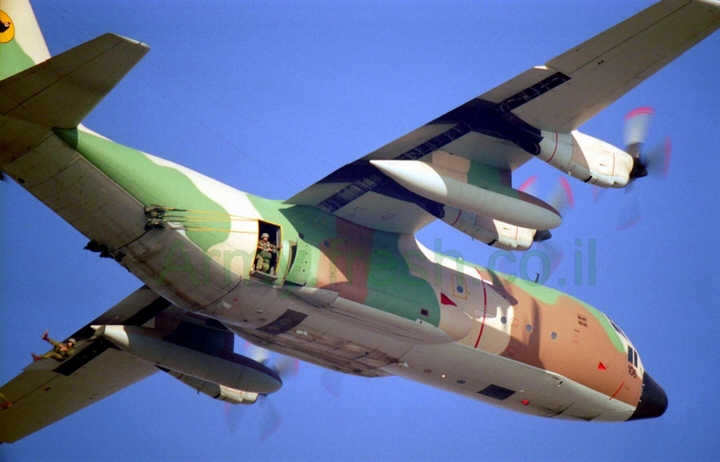
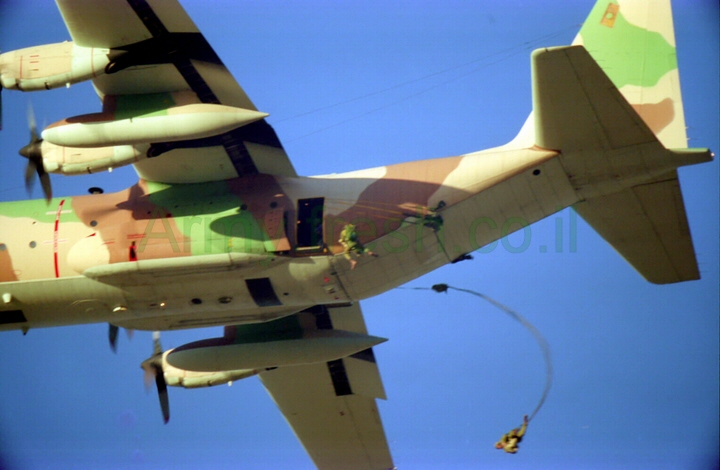
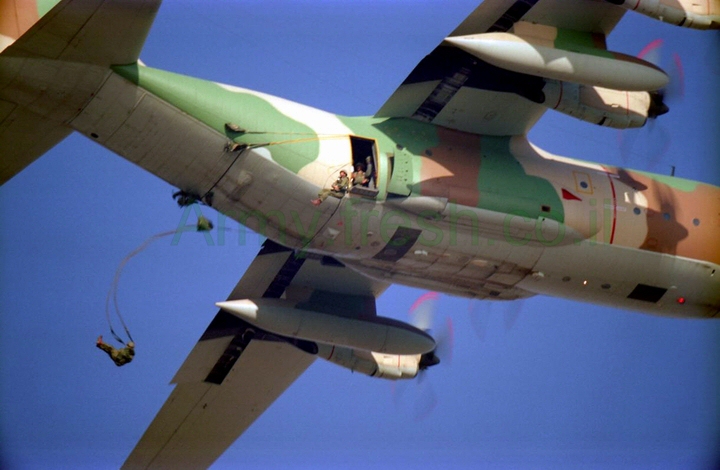
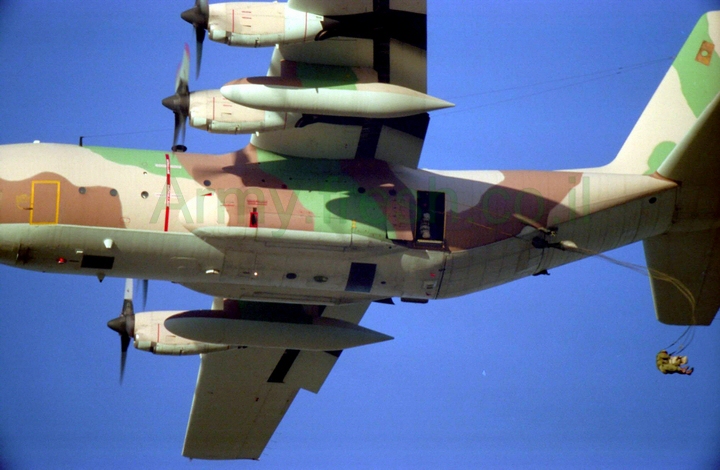
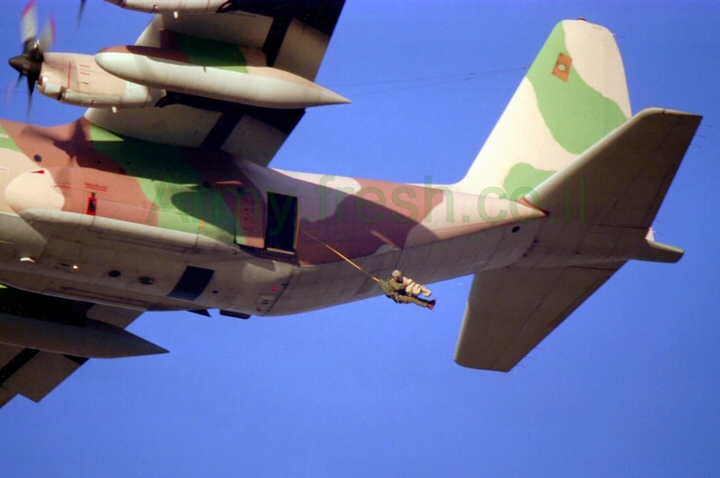
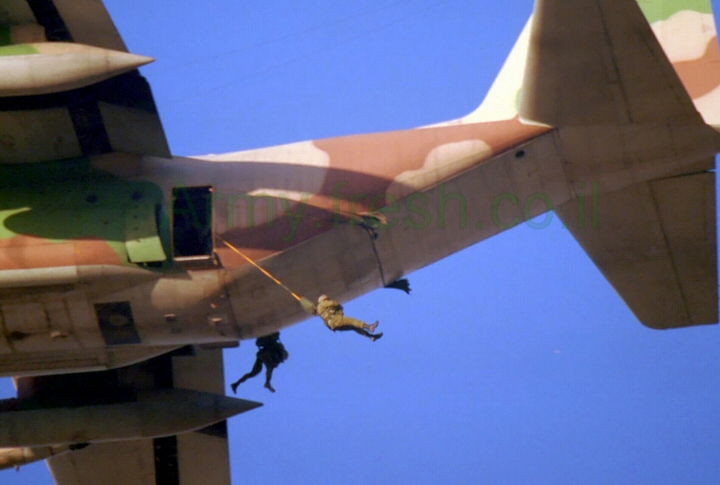
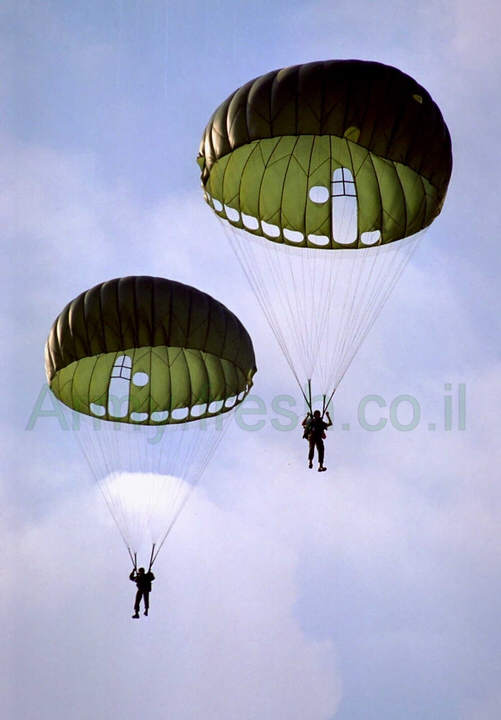
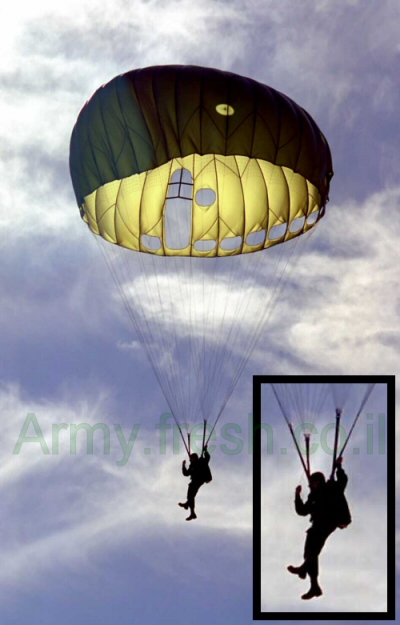
Date: July 3, 1976
Unit: Israeli Paratroopers, Golani infantry troops
Operation: Thunderball renamed "Jonathan"
Troopers: 100
Country: Uganda, Africa
Assault zone: Entebbe Airport
Aircraft: 4 x C-130 Hercules
Equipment/supplies air-delivered: Mercedes limousine, 4 x M113A1 Gavin APCs, BTR 152 armored car, 106mm RR M151 gun jeep, Mercedes limousine and 2 LandRovers, Ammunition, Food, water, medical supplies
Type Air delivery: NOE, STOL airland
During the Entebbe raid on 3 July 1976, five Israeli C-130s flew to Entebbe, Uganda to rescue 105 hostages seized from an Air France Airbus jet airliner and still held by Palestinian terrorists in the Old Terminal of the airport. One C-130 landed in complete darkness without runway lights, then taxied close to the terminal building, with Paratroopers pouring out behind a limousine designed to look like Ugandan President Idi Amin's entourage. After a few minutes the hostages were freed and the terrorists dead. The other three C-130s landed after a few minutes to secure the area and support the evacuation by destroying Ugandan MIG fighters on the ground and blocking any possible counter-attacks. The flight to Entebbe was nonstop from Israel, and on the return flight, there was a landing in Nairobi, Kenya. Casualties included 3 dead civilians and 5 wounded, 1 dead officer, and 4 wounded Soldiers.
http://www.thehistorynet.com/MilitaryHistory/articles/06962_text.htm
"With the old terminal secure, Yoni moved back outside and headed toward an approaching Hippo to supervise the loading of the newly freed hostages. As Yoni emerged from the shadow of the building, a Ugandan sniper, perched on the nearby control tower, fired and mortally wounded the young commando leader.
Yoni's deputy arrived at his side a few seconds later and directed an Israeli armored personnel carrier (APC) to eliminate the sniper in the control tower. The APC crew immediately fired captured Soviet-made rockets at the tower, and the top of the building disappeared in a blinding explosion.
The hostages were rushed aboard the lead aircraft as another team of commandos hurried to the other side of the field in an APC. With silent efficiency, they methodically blew up a line of 11 parked Ugandan MiG fighters.
www.blarg.net/~whitet/entebbe.htm
At approximately 1230 on Sunday, June 27, 1976, Air France flight number AF 139 was hijacked by four terrorists. The plane, of which nearly one-third of the passengers were Jewish, was flown to Benghazi. After a six and a half hour delay, the plane took off again and began flying east. It changed course and began flying south east; by 0300 the next morning it had arrived at Entebbe, Uganda.
Upon arrival, the four terrorists (two of which were members of the German Baader-Meinhof Gang) were joined by three others, bringing the total up to seven. The passengers were kept on the aircraft until 1200, at which point they were transported to the airfield's old terminal building. Then President of Uganda, Idi Amin, visited the hostages in the terminal and told them he was working to achieve their release, and that Ugandan soldiers would remain at the terminal to ensure their safety. The next day at 1530, the leader of the terrorists, a Palestine named the Peruvian released the specific demands the group of terrorists were seeking. 53 terrorists: thirteen held in prisons in France, W. Germany, Kenya, and Switzerland and 40 in Israeli prisons were to be released. If they were not, hostages would be executed starting at 1400 July 1.
The Unit
Sayeret Matkal was placed on alert shortly after the Israeli government learned about the hijacking. Members of the Unit assembled at Lod Airport In Israel (The origin of flight 139), but were stood down temporarily when the aircraft landed in Benghazi. Separately from Sayeret Mat'Kal, Lt. Col. Joshua Shani of the Israeli Air Force's only C-130 squadron began conducting basic flight planning for his aircraft to fly to and back from Uganda.
When the Peruvian announced the terms for release and impending execution if they were not met, Israel's Prime Minister, Yitzhak Rabin, convened a group of cabinet ministers; one of them was IDF Chief of Staff Motta Gur. There were serious complications in using military forces (Uganda was 2,200 miles away, the flight was from a French Company, and only 1/3 of the passengers were Jewish, and not all of these were from Israel) but the military began reviewing options.
Throughout Wednesday, June 30, intelligence information began to filter in. Idi Amin was not seeking the release of the hostages and was actually collaborating with the PFLP. This made an early plan requiring marine commandos to rescue the hostages and then surrender to Ugandan soldiers undesirable. Motta Gur reported that the IDF had no viable plan to rescue the hostages.
On Thursday, July 1, Rabin's government agreed to release their prisoners. Earlier that day, the PFLP terrorists had released 100 passengers, leaving only the Jewish population of the aircraft and the flight crew. Upon receiving word that Israel had agreed to the exchange, the terrorist moved the day of execution back, to Sunday July 4. Intelligence agents were told by the released passengers that the Ugandan soldiers were fully cooperating with the terrorists, and that the Jewish passengers were segregated from the rest. The real purpose of the hijacking was beginning to be made clear. Once again, the military was asked for options.
Jonathan Netanyahu, commander of Sayeret Mat'kal, was briefed on the roles and missions of the units in the plan that was then under development. It called for three ground elements, The Unit, members of the Elite Golani Infantry, and Paratroopers. Netanyahu and others argued for a smaller, more flexible force. Brigadier General Dan Shomron, who would ultimately command the raid, decided to go with Netanyahu's recommendation.
By Friday, July 2, a basic plan of attack had been created. Even though the military had not yet been given the mission to rescue the hostages, members of the Unit began to run through the mission. A pole and burlap mock-up of the terminal had been constructed at their base and members of the unit practiced entering and clearing it. Members of Mat'kal now new exactly how many terrorists there were and what they were armed with; a pregnant hostage who had been released had been debriefed and had given Israeli intelligence the information. 8mm film footage taken by a sergeant major formerly stationed in Entebbe was shown to familiarize the commandos with the airport.
Drivers from the Unit met with crews from the Israeli Air Force to practice off-loading all of the vehicles that were to be brought along for the mission. As further intelligence and information came in, the plan was further refined and improved. Members of The Unit continued to practice all throughout Friday as the Israeli government pondered what to do. Friday evening, a full dress rehearsal was performed for IDF Chief of Staff Motta Gur. After witnessing a successful "operation", Motta Gur told the senior officers in the unit he would recommend to the Prime Minister that the mission be approved. The Commandos, their practice session complete, attempted to rest for the mission the next day.
The Mission
The members of Sayeret Mat'Kal participating in the assault met at Lod Airport at 1130 on Saturday, July 3, six days after the terrorists had hijacked the aircraft and passengers. A final briefing was conducted and last minute details between the C-130 crews and commandos were addressed. At 1320 the aircraft took off (Heading in different directions to fool potential spies) and headed south at low levels to avoid radar detection by Russian ships and Egyptian Radar. The aircraft made a brief stop at Sharm-a-Sheikh to top off their fuel tanks and feed the troops before the four aircraft formation headed south on their 7.5 hour flight to Entebbe.
By 2230 the aircraft had reached Lake Victoria, just a short distance from Entebbe by air. The last three C-130s broke formation and circled as the lead aircraft made its approach. At 2300 on July 23 (Israeli time) the lead aircraft touched down. The commandos on board immediately sprang into action. Aircrew quickly undid the tie-downs and prepared to lower the ramp as the commandos started their vehicles. As the aircraft slowed, ten members from the elite Golani Infantry jumped out and set up landing beacons for the remaining aircraft. As the aircraft turned onto the taxiway leading to the old terminal, the rear cargo ramp was lowered and a black Mercedes and two land rovers drove out. Ugandan flags flew from the Mercedes and all 35 commandos were dressed in Ugandan uniforms.
The three vehicle convoy proceeded towards the old terminal with their lights on at a steady 40 Mph (64 KPH). The vehicles drove towards the terminal for a full minute before being challenged by two Ugandan sentries. Lieutenant Colonel Netanyahu slowed the vehicles as if to stop and, when the sentries were within range, ordered his men to fire. Israeli commandos opened fire with silenced Berettas, killing one sentry and missing another; who who stumbled backwards and opened fire. Realizing that the element of surprise might be lost, Netanyahu immediately ordered the drivers to head for the old terminal at full speed. As they approached, several soldiers and a terrorist could be seen milling about outside in confusion.
The vehicles quickly parked by the control tower adjacent to the old terminal and the commandos jumped out and began their attack. The lone terrorist seen outside ran inside yelling, "The Ugandans have gone nuts--they're shooting at us!" The Israelis had truly achieved the element of surprise.
During the initial phase of the assault, the second in command froze and refused to move forward. Netanyahu ran past him and resumed the assault. A Ugandan guard jumped up from behind some wooden crates and began to fire but was cut down. Another fired fr om within the terminal, spraying glass and bullets about. He too, is killed by Mat'Kal commandos now entering the building. The Commandos began to clear the building. Some members were darting about independently while others were clumping together, but the basic plan was being followed. Somewhere in this initial assault phase, Johnathan Netanyahu is shot and mortally wounded.
Within THREE minutes of landing, four of the seven terrorists had been killed. The troopers continued to clear the building. By this time, events have been happening so quickly that some of the Mat'kal Soldiers are disoriented. Some men are out of position or in the wrong hallways. A little girl suddenly jumped up in on of the rooms they were clearing. The commandos were able t o recognize in time that she was not a terrorist and hold their fire, but two other passengers who also stood up were not so lucky.
The team assigned to assault the VIP lounge in the terminal found the outside door locked. One of them threw a grenade at the door; it bounced of and exploded, wounded one member slightly. They went inside the terminal and entered from an open door there. Inside were two men. As the members of the Unit entered, the two men stood up and began moving towards the commandos, hands raised. Unsure as to the two men's intentions, the commandos withheld their fire until one noticed a grenade belt around the waist of one of the men. Their commands to halt unheeded, they opened fire and killed the two men. As they did, one of the terrorist dropped a grenade he had been hiding in his hand.
All the terrorists were now dead. Only the Ugandan soldiers stood in the way of a safe escape. Several soldiers were holed up in the tower next to the old terminal and were firing at the Mat'kal soldiers remaining in the landrovers. The mortally wounded Netanyahu was evacuated to a C-130 at this time. The second C-130 landed six minutes after the first and two armored personnel carriers offloaded and headed to the secured terminal. When they arrived they took it under fire and temporarily silenced it.
Two more APCs arrived on the third C-130 and joined the first two. One split off and destroyed eight MiGs stationed at the base. Members of Sayeret Golani arrived and set up a defensive perimeter. Within Fifteen minutes of the first C-130 landing, the hostages had been freed and the area secured.
Mat'kal commandos began evacuating the rescued civilians to a waiting C-130. They were hampered by passengers returning to the terminal to try and find lost property and darkness. Several of the passengers were also in shock or hysterical. Getting an accurate headcount was difficult in the darkened aircraft. At 2352, less than an hour after the first Hercules landed, the C-130 with 106 rescued hostages took off and flew into the night.
With the hostages safe, the rest of the force began to withdraw to their aircraft. Their movements were covered by smoke and timed explosives devices. The last C-130 left Entebbe at 2429, 99 minutes after the first one had landed. The cost, one commando killed (Netanyahu) and one hostage dead (she had been moved to a local hospital after a choking incident and was not present during the rescue. She was subsequently executed in retribution for the raid). The rescue at Entebbe is a classic example of a successful special operations. The Israelis used surprise and superior training to overcome their enemies and gain their objectives with a minimum loss of life. It was a logistically difficult mission. Thirty-five commandos in two Landrovers and a Mercedes with four APCs for firepower had to be transported over 2,200 miles and back again with over 100 hostages. The building the hostages were kept in was guarded by seven terrorists and an unknown number of Ugandan soldiers and was reported to be wired with explosives.
Originally, the Israeli military wanted to use a large force and secure the entire airfield. Netanyahu argued for, and got, a smaller force that would take only the terminal. Speed and surprise would be their main advantages. Using information about the old terminal, a mock-up was built allowing the commandos to practice beforehand, allowing them some familiarity with the terminal.
The Israeli assault of Entebbe achieved it's goals with stunning success. Any study of successful counter-terror operations would be remiss in not including this operation.
www.idf.il/english/history/entebbe7.stm
The assault on Old Terminal was completed within three minutes after the lead plane landed. Now in rapid succession, its three companions came into touch down at Entebbe. By 23:08 hours, all of Thunderball Force was on the ground. The runway lights shut down as the third plane came in to land, but it didn't matter, but it didn't matter - the beacons did the job well enough. With clockwork precision, armored personnel carriers roared off the ramp of the second transport to take up position to the front and rear of Old Terminal, while infantrymen from the first and third plane ran to secure all access to roads to the airport and to take over New Terminal and the control tower; the tower was vital for safe evacuation of the hostages and their rescuers. In a brief clash at the New Terminal, Sergeant Hershko Surin, who was due for demobilization from the army in twelve hours time fell wounded. The fourth plane taxied to a holding position near Old Terminal, ready to take on hostages. All the engines were left running. A team of Air Force technicians were already hard at work offloading heavy fuel pumps - hastily acquired by an inspired quartermaster one day earlier - and setting up to transfer Idi Amin's precious aviation fluid into the thirsty tanks of the lead transport - a process that would take well over an hour.
Date: 16 May 1978; 0630 hours ZULU time
Unit: Forces Arme'ees Zairois (Zaire) FAZ 2nd Company (-) of the 311th Airborne Battalion Paratroopers
Operation: ?
Troopers: 60 paras
Country: Zaire, Africa
Drop zone: New Town, Kolwezi east Drop Zone "B"
Aircraft: 1 x C-130E Hercules
Equipment/supplies air-delivered: Ammunition, food, water, medical supplies
Type Air delivery: Daylight, mass tactical airdrop
Jumped to save a FAZ headquarters surrounded by Cuban-communist backed FNLC rebels.
Date: 16 May 1978; 0900 hours ZULU time
Unit: Forces Arme'ees Zairois (Zaire) FAZ 2nd Company (-) of the 311th Airborne Battalion Paratroopers
Operation: ?
Troopers: 60 paras
Country: Zaire, Africa
Drop zone: New Town, Kolwezi east Drop Zone "B"
Aircraft: 1 x C-130E Hercules
Equipment/supplies air-delivered: Ammunition, food, water, medical supplies
Type Air delivery: Daylight, mass tactical airdrop
Survivors linked up with rest of 311th Airborne Battalion holding the airport 5 kilometers south of the city (May 17-18).
Date: 19 May 1978; 1540 hours ZULU time
Unit: French 1st, 2nd, 3rd and Headquarters companies of the 2nd REP Foreign Legion Paratroopers
Operation: Leopard
Troopers: 405 paras
Country: Zaire, Africa
Drop zone: North Kolwezi grassy flying strip, Drop Zone "A"
Aircraft: 1 x C-160 Transaal, 4 x C-130E Hercules
Equipment/supplies air-delivered: Ammunition, food, water, medical supplies (door bundles)
Type Air delivery: Daylight, mass tactical airdrop
Commanded by Lieutenant Colonel Phillipe Erulin, seized control of Kolwezi city rapidly to save hostages from being executed; with mission to locate and destroy FNLC rebels threatening civilians and Zaire government; on first day, rescued 35 hostages, killed 100 FNLC rebels, destroyed 2 captured AML armored cars, captured over several enemy weapons and important documents revealing enemy intentions
Date: 20 May 1978; 0600 hours ZULU time
Unit: 4th company, recon section of French 2nd REP Foreign Legion Paratroopers
Operation: Leopard
Troopers: 200 paras
Country: Zaire, Africa
Drop zone: Grassy area east of Kolwezi town, Drop Zone "B", recon section on Drop Zone "A"
Aircraft: 1 x C-160 Transaal, 4 x C-130E Hercules
Equipment/supplies air-delivered: Ammunition, food, water, medical supplies (door bundles)
Type Air delivery: Daylight, mass tactical airdrop
The 2nd REP conducted combat operations to find and kill FNLC rebels for the next 6 days; capturing 163, killing 252 at a cost of 5 dead and 25 wounded men.
EXCLUSIVE! video clip of the French Kolwezi Airborne operation!www.combatreform.org/legionetrangerekolwezi1978.wmv
Date: 20 May 1978; 0628 hours ZULU time
Unit: 1st and 3rd Battalions of the Belgian ParaCommando Regiment Paratroopers
Operation: Red Bean
Troopers: 1,180 paras
Country: Zaire, Africa
Drop zone: Kolwezi airport; "Drop Zone "C" south of Kolwezi town
Aircraft: 8 x C-130E Hercules of the 15th Air Wing of the Belgian Air Force; USAF C-141As flying in fuel
Equipment/supplies air-delivered: 10 x armored jeeps, 18 radio jeeps, 26 x AS-24 tricycle ATVs, 1 Alouette light observation helicopter, ammunition, food, water, medical supplies (mobile surgical hospital)
Type Air delivery: Tactical airland in 3 waves
With the French Paras in Kolwezi town and the FAZ Airborne holding Kolwezi airport, Belgian ParaCommando Regiment Commander Henri J.G. "Rik" Depoorter decides to airland his men onto the airstrip to conduct his evacuation operation. After the 3rd wave airlanded vehicles, his men were air-motorized mobile. When a rescued civilian asked if the evacuation was mandatory, a Belgian ParaCommando replied; "Of course not. But we won't be coming back next week, either!". The civilian boarded the C-130. 2,300 expatriate civilians were rescued.
Further reading:
Shaba II: The French and Belgian Intervention in Zaire in 1978, LTC Thomas P. Odom, U.S. Army
Better C-130 Hercules seating needed!
Date: 1979
Unit: Russian Paratroopers VDV, Spetsnaz commandos
Operation: ?
Troopers: 6,000
Country: Afghanistan
Assault zone: Kabul Airport
Aircraft: Il-76 Candid, AN-12 Cub
Equipment/supplies air-delivered: BMD-1 Armored Fighting Vehicles
Type Air delivery: Day low-level tactical airland operation
Date: July 6, 1981
Unit: Sayeret Shaldag (Unit 5101)
Operation: Opera
Troopers: 6-12
Country: Israel
Assault zone: Northern Iraq
Aircraft: C-130 Hercules
Equipment/supplies air-delivered: Laser designation equipment, M16 CAR-15s often with M203 grenade launchers, Light Machine Guns, 9mm handguns, Mauser 86SR Sniper Weapon System.
Type Air delivery: Night low-level tactical airldrop operation
Take-off Location: Palmachim Air Force Base (AFB). Primary Mission: ground-based laser designation for air-to-ground attacks. Secondary Mission: an Engagement unit in Counter Terror and hostage rescue team scenarios. Training: navigation, open field combat, communications, parachuting, CT. Note: in some inner Israeli Defense Force (IDF) Special Forces (SF) circles Sayeret Shaldag is also known as the Special Air Ground Designating Team ("T'zevet Simun Karka Avir - TSKA" in Hebrew).
Operation Opera - Shaldag most famous operation is its assistance in the bombing of the Iraqi nuclear reactor known as "Osirak" (Israeli code name - "Tamouse") in the July 6 1981. before the attack took place, Shaldag team performed an airborne insertion to Iraq and waited for eight IAF F-16's to arrive. when they did the team designated the reactor with their laser designators. the laser guided bombs released from the F-16's hit the reactor dead on the spot, the reactor was ruined and the Iraqi nuclear program was set years back. After the bombing, the team used a high speed Bell 212 helicopter to leave the area. with the help of six F-15's, protecting the Bell 212 and the F-16's, a Boeing 707 air refuel tank and the Iraqi fear of radiation the team was home free.
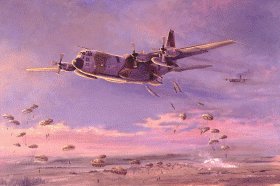
Date: April 15-17?, 1982
Unit: British Special Boat Squadron
Operation: ?
Troopers: 12
Country: Great Britain
Assault zone: Falklands Islands
Aircraft: C-130 Hercules
Equipment/supplies air-delivered: 12-man SBS unit
Type Air delivery: Day low-level tactical WATER airdrop operation
SBS commandos jumped into the water wearing SCUBA gear, masks and fins, then swam down to the submarine HMS Onyx, and "locked in". Afterwards, the sub took them to South Georgia island for reconnaissance and/or raid missions. Consider watching the Richard Harris movie, "Juggernaut" to see a British C-130 waterjump.
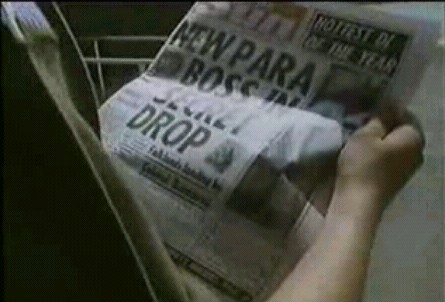
Date: May 1982
Unit: 2d Paratroop Battalion, British Army
Operation: ?
Troopers: 1
Country: Great Britain
Assault zone: Falklands Islands
Aircraft: C-130 Hercules
Equipment/supplies air-delivered: fleet supplies and VIP, LTC David Chaundler
Type Air delivery: Day low-level tactical WATER airdrop operation
Following the heroic death of LTC H. Jones leading the charge by personal example at Goose Green, LTC David Chaundler was flown out to replace him, from the United Kingdom, flying out to Ascension Island on a VC10 jet and then by C-130 Hercules to the Falklands. After the Hercules had dropped its supplies to the fleet, Chaundler parachuted into the sea, from where he was plucked by a helicopter and flown back to one of the ships where he was given a chance to dry off before being flown to HMS Hermes for a brief talk with Admiral Woodward. After talking with Woodward, LTC Chaundler proceeded to Major General Jeremy Moores headquarters where he was brought up to date on the course of the war and then joined 2 Para, four days after the battle of Goose Green, and proceeded to lead them for the rest of the Falklands war.
EPISODE 5, PART 1: PLF training done on mats indoors
 www.youtube.com/watch?v=9cekFAimyXM
www.youtube.com/watch?v=9cekFAimyXM
EPISODE 5, PART 2: unique hydraulic jump landing simulator
 www.youtube.com/watch?v=BSPF7J1Q-BA
www.youtube.com/watch?v=BSPF7J1Q-BA
EPISODE 5, PART 3: Balloon Jump, First Herk JUmp
 www.youtube.com/watch?v=1-jeRAwW34Y
www.youtube.com/watch?v=1-jeRAwW34Y
EPISODE 5, PART 4: Combat Equipment jumps
 www.youtube.com/watch?v=p22RJWq4fG8
www.youtube.com/watch?v=p22RJWq4fG8
EPISODE 6, PART 1: Carl Gustav 84mm recoilless rifle and quick-reaction FN FAL rifle shooting
 www.youtube.com/watch?v=UmyTLBN2PnQ
www.youtube.com/watch?v=UmyTLBN2PnQ
EPISODE 6, PART 2: EXCELLENT life-fire movement and micro-terrain cover selection training emphasizing THINKING, superb digging in of defensive positions carefully rolling back the grass for camouflage
 www.youtube.com/watch?v=qiaurDW_4xs
www.youtube.com/watch?v=qiaurDW_4xs
EPISODE 6, PART 3: image intensifier critique of fighting positions at night, FIBUA training, Falklands war ends before training platoon sent into action
 www.youtube.com/watch?v=ONuEp3UEwac
www.youtube.com/watch?v=ONuEp3UEwac
Date: November 1988
Unit: Indian 50th Independant Parachute Brigade, 2 Para-Commando Battalion
Operation: Cactus
Troopers: 2,000
Country: India
Assault zone: Maldive Islands
Aircraft: Il-76 Candid, AN-12 Cub
Equipment/supplies air-delivered: BMD-1 Armored Fighting Vehicles
Type Air delivery: Day low-level tactical airland operation
During the November 1988 attempted coup in the Maldive Islands, India flew in two of the brigade's para-commando battalions with supporting units within a day. They quickly defeated the rebels.
Date: June 9, 1997
Unit: French Airborne and Foreign Legion Paratroopers
Operation: ?
Troopers: 1,200
Country: Republic of Congo, Africa
Drop zone: Brazzaville Airport
Aircraft: C-160 Transaals, C-130 Hercules
Equipment/supplies air-delivered: Ammunition, Food (MREs), water, medical supplies (door bundles)
Type Air delivery: Daylight, mass tactical, static-line jump, LVAD, STOL airland AMX-10RC light wheeled armored vehicles
BRAZZAVILLE, Republic of Congo (AP) -- Bodies littered the streets of Brazzaville and French Paratroopers poured out of the sky Monday to help evacuate foreigners caught in fighting between government troops and a private militia. France says it negotiated a preliminary cease-fire.
Mortar fire thundered through the capital of the Republic of Congo during a fifth day of fighting between government troops and militiamen loyal to former military leader Gen. Denis Sassou-Nguesso.
As night fell and tracer bullets and rocket-propelled grenades lit up the sky, the 5,000-strong militia appeared to have secured its grip on the northern and central sections of the city, while government troops held southern neighborhoods.
Civilians fleeing across the Congo River to Kinshasa, capital of the former Zaire, said the militia, known as the Cobras, controlled the state radio and television building.
In Paris, a spokeswoman for French President Jacques Chirac said Sassou-Nguesso and President Pascal Lissouba had agreed to peace talks during conversations with Chirac on Monday evening.
``The president has obtained an agreement in principle both from Lissouba and Sassou-Nguesso for a cease-fire and for mediation,'' presidential spokeswoman Catherine Colonna told The Associated Press.
French officials later said that details of the cease-fire remained to be worked out between the two sides.
Along with the Paratroopers, France sent reinforcements to the chaotic city to evacuate citizens caught in the cross fire. Fighting forced a brief suspension of evacuations at mid-day, after 560 French nationals were flown to neighboring Gabon.
The French Defense Ministry said 1,200 French Soldiers would be in Brazzaville by Tuesday, including the French Navy and Foreign Legion Parachutists who landed Monday. France also sent a C-130 cargo plane with armored vehicles to reinforce its forces in the former French colony.
The United States has been unable to evacuate 13 of 28 American diplomats from the country, the U.S. State Department said Monday.
The U.S. Embassy also has been advising about 200 private Americans in the country to remain indoors because of the unsafe conditions, State Department spokesman Nicholas Burns said in Washington.
U.S. Embassy officials in Brazzaville were in radio contact with both sides, trying to arrange a truce so that about two dozen civilians seeking shelter at the embassy could be taken to the airport and flown to Kinshasa.
About 100 foreigners, half of them Americans, have been evacuated on private airplanes chartered by the U.S. Embassy since Saturday, but evacuations have been hampered by the militia battles. About 24 Americans remained in the U.S. Embassy.
Throughout the day, foreigners in the besieged capital flocked to the Aeroclub, a charter flight club where French soldiers were organizing evacuation flights.
The foreigners said Centreville, the downtown area where the heaviest fighting took place, was strewn with dead bodies, spent shells and shattered glass.
Near the Meridien, a luxury hotel, three bodies sprawled out of a bullet-riddled limousine, the foreigners said.
Aid workers with the British charity, Oxfam, were trapped in their Centreville office and at a nearby hotel.
``We can hear mortar rounds whistling as they land around the hotel,'' said engineer Richard Bartlett, contacted by satellite phone. ``It would only take one round to land too short and we would be hit.''
Most of the shooting, however, seemed limited to the warring sides firing on each other. Guests at the city's three luxury hotels said they had been robbed at gunpoint -- but otherwise were unharmed.
Rival fighters battled within 500 yards of the airport, forcing a brief halt to evacuation flights. The flights resumed after the French established radio contact with the fighting parties.
Shooting tapered off as planes lifted from the runway, a sign that neither side wanted to antagonize the French.
``They know if they attack us they will lose because we have the means to respond,'' said a French officer who, according to military regulations, could not give his name.
More than 700 foreigners have been evacuated from the airport, said the French Embassy's military spokesman, Alexis Jaraud.
Besides the evacuations carried out by France and the United States, the United Nations refugee agency evacuated another 62 people, and about 50 Chinese fled in two small aircraft to Kinshasa, just across the Congo River from Brazzaville.
At the Aeroclub, foreigners -- mostly French and from neighboring Congo -- filled deck chairs clustered around picnic tables. One woman shook with sobs while her three small children played at her feet.
``We spent four days locked up in the house, we saw bullets landing in the garden and heard explosions that made the walls shake,'' said Therese Prat, a 54-year-old French jeweler.
Prat said government troops looted her home and stole her car. ``We've been here since 1965 and now we've lost everything.''
Others reported being mistreated by the militia.
``We hadn't eaten for three days, so we tried to go and buy bread, and we were stopped by the Cobras who made us stand in the sewage ditch,'' said Elisee Oba, a 24-year-old hairdresser from neighboring Congo. They confiscated her papers and let her go.
French troops continued their mission Monday to reach civilians stranded by cross fire, but avoided the harder-hit neighborhoods.
``Parts of town are so dangerous we can't send our own people in,'' Jaraud said.
At least one French Soldier has been killed since Thursday, struck down by gunfire while trying to guide civilians from a besieged neighborhood.
Violence erupted last week when government troops, fearing attempts to disrupt next month's presidential elections, tried to disarm members of Sassou-Nguesso's militia.
Lissouba and Sassou-Nguesso are longtime rivals. Sassou-Nguesso ruled as a dictator for more than a decade until he was forced to introduce political reforms in 1991.
Elections the following year installed Lissouba as president. The antagonism between the two men erupted in bloodshed during legislative elections the following year.
Sassou-Nguesso and another opposition leader, Bernard Kolelas, accused Lissouba of rigging the vote. Resulting violence left 2,000 people dead and led to each man creating a personal militia.
Date: 1999
Unit: Russian and British 5th Airborne BDE Paratroopers
Operation: Kosovo Peace Force
Troopers: 200 Russians, 1500 British Paratroopers
Country: Kosovo
Dropzone: Pristina airport
Aircraft: IL-76 Candid, C-130 Hercules
Equipment/supplies air-delivered: Ammunition, Food (MREs), water, medical supplies
Type Air delivery: STOL airland
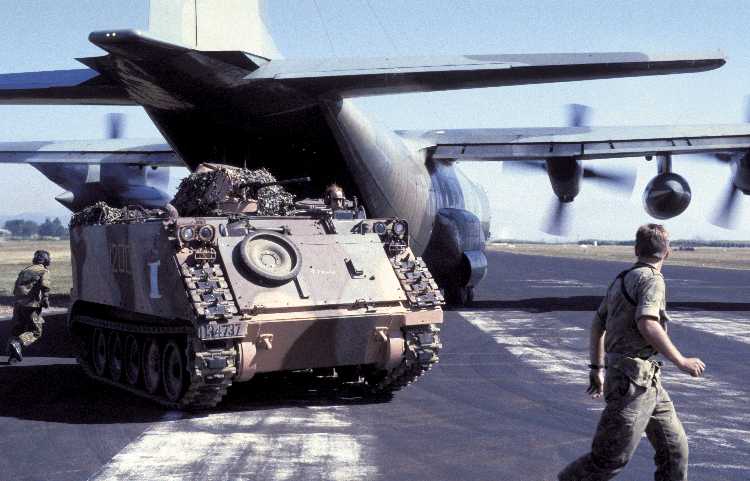
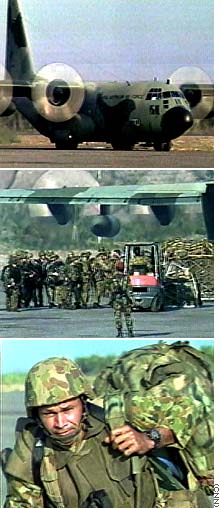
 www.youtube.com/watch?v=GbBg3dk-l3U
www.youtube.com/watch?v=GbBg3dk-l3U
Date: September 20, 1999
Unit: Australian Airborne SAS, Para-Commandos, New Zealanders, British Gurkhas
Operation: Stabilize
Troopers: 2,500 Peacekeepers
Country: East Timor, Indonesia
Dropzone: Dili airport
Aircraft: Airfield secured by UH-60 Blackhawks carry SAS troops, 37 sorties x 6 C-130 RAAF Hercules
Equipment/supplies air-delivered: Ammunition, Food (MREs), water, medical supplies
Type Air delivery: STOL airland troops, M113 Gavin Armored Personnel Carriers, airdrop of foodstuffs to refugees in mountains
An international peace force airlifted more than 1,000 Soldiers to East Timor by nightfall today, seeking to take control of the provincial capital from pro-Indonesian militias who burned, looted and killed in a rampage that left Dili in smoking in ruins.
Dozens of Hercules transport planes from northern Australia landed at 20-minute intervals carrying the tools of war - vehicles and tons of ammunition, explosives, land mines and supplies.
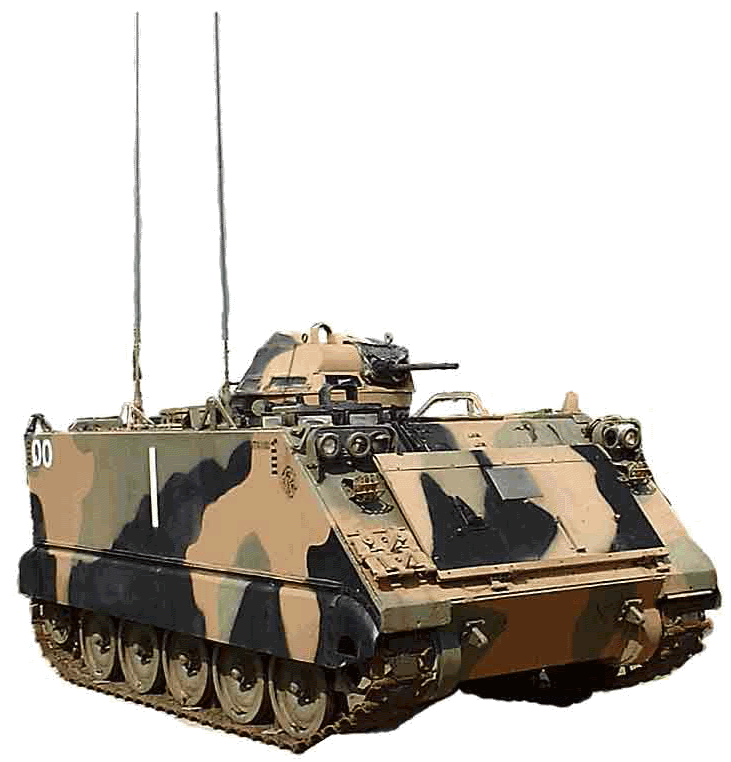
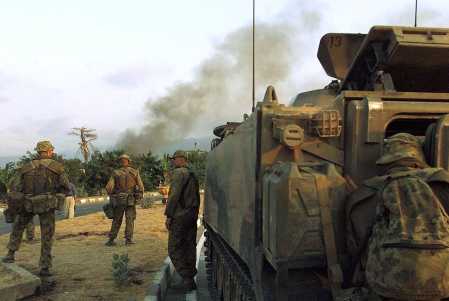
"Soldiers are moving around everywhere, Hercs are flying in every, you know, within half an hour sometimes, they're offloading quickly, they're walking off in full combat gear and then I've just seen two armoured personnel carriers, quite imposing vehicles, driving out of the airport, which is the first serious armoury we've seen turn up in Dili today."
Securing the airport, some commandos waded into high grass and palm trees and others crouched near the tarmac, guns at the ready, while the planes landed, swiftly unloaded, and took off for another sortie.
As the peacekeeping force spread across Dili toward the wharf, columns of black smoke from burning houses billowed over the city, apparently from fresh fires. Despite the arrival of the peacekeepers, it was still too dangerous to walk freely around the capital to investigate. More fires could be seen outside Dili and along the coast.
Flights were to continue through the night, and 500 more troops set sail from Darwin, Australia, aboard the Australian navy's seacat HMAS Jervis Bay. By daybreak Tuesday, operation commanders said they hoped to have 2,300 troops in East Timor.
Within hours of beginning the operation at dawn, heavily armed combat troops from Australia, New Zealand and Britain were in control of the airport and the harbor, the two vital links to Dili.
Indonesian soldiers watched in apparent bemusement as the force moved into position, outfitted in heavy battle fatigues, armored vests, packs and ammunition belts in the sweltering tropical heat.
Men wearing the red and white bandanas of anti-independence militias were among hundreds of people at the garbage-strewn harbor who watched the armed and helmeted soldiers take positions near destroyed warehouses.
The chaotic port area was crowded with thousands of refugees waiting to escape after more than two weeks of violence. Throngs of people tried to clamber aboard a passenger ferry and Indonesian naval supply ship, which many believed were the last ships out.
Pro-Indonesia militias rejected East Timor's overwhelming vote for independence on Aug. 30 and went on a rampage in collusion with Indonesian security forces. Indonesia invaded the former Portuguese colony in 1975.
As the peacekeeping forces poured into East Timor, the militia groups opposed to independence have banded together to form a coalition called the United Nation Front, a news report said today.
''We won't attack the U.N. peacekeeping troops. We only want to defend our ground,'' coalition chief Joao da Silva Tavares said in a report broadcast on Indonesia's SCTV television.
The coalition was formed Sunday near the East Timorese town of Balibo. Indonesian military veterans from East Timor are also among the members, SCTV said.
So far, the troops ''met absolutely no resistance'' as they spread through the shattered capital, according to the peacekeeping force commander, Australian Maj. Gen. Peter Cosgrove. Despite reports of shooting Sunday night, ''by and large it has been a cordial reception,'' he said in Dili.
Peacekeeping officers shook hands with the Indonesian commanders, but the Indonesian presence at the airstrip was light, and it quickly became obvious who was in charge.
Before the first plane approached, Indonesian forces chased a herd of goats off the airstrip.
Peacekeepers disarmed two men who rode into the port area on a motorbike. They offered no resistance and sped away after troops ordered them to leave.
Many of the Australian troops took an intensive language program and speak Indonesian. A large majority of Dili's residents speak no English.
The peacekeeping mission, named Operation Stabilize, got under way five days after the U.N. Security Council unanimously approved the force under Australia's command to quell the chaos.
The huge air operation deprived the United Nations of the planes it was using to drop of food to starving refugees in East Timor's mountains.
''There's a massive amount of relief ready to go,'' said David Wimhurst, spokesman for the U.N. Mission to East Timor, or UNAMET. ''The question is getting it in as soon as possible.''
In a report made available today, the U.N. Children's Fund estimated 190,000 to 300,000 refugees were hiding in East Timor, in addition to 141,000 who fled to West Timor. Fears were rising of epidemics in overcrowded refugee camps from the lack of water and sanitation, UNICEF said.
Sadako Ogata, the U.N. High Commissioner for Refugees, met Indonesian President B.J. Habibie to discuss her visit Sunday to camps in West Timor, where independence supporters were herded by the militias in an attempt to evict the secessionists from East Timor and nullify the referendum.
She said she had to trust the Indonesian police to safeguard the refugees in West Timor, as well as operations the UNHCR hopes to set up there.
Date: April 18, 2000
Unit: Russian Paratroopers
Operation: ?
Troopers: 3,000
Country: Chechnya
Drop zones: South of Chechnyas Shatoi province
Aircraft: IL-76 Candid
Date: Late 2003
Unit: Indonesian Paratroopers
Operation: ?
Troopers: 600
Country: Aceh
Drop zones: ?
Aircraft: C-130 Hercules
Indonesia dropped paratroopers on Aceh to fight the GAM guerillas. This operation was done by about 600 paratroopers dropped by C-130s backed with Hawk-209s and OV-10Fs. The ground element of Army troops backed with Scorpion-90 light tanks and marines backed by PT-90s (upgraded PT-76s with a 90mm gun) mopped up afterwards.
Date: 2003
Unit: British SAS Air Troop
Operation: ?
Troopers: 16
Country: Iraq
Drop zones: Mosul
Aircraft: C-130 Hercules and CH-47 Chinook
Equipment/supplies air-delivered: 4 x "Pinkie" Land Rovers later air-landed by CH-47s to mobilize the Air Troop
http://findarticles.com/p/articles/mi_qn4161/is_20030420/ai_n12868809/pg_1
GULF WAR II: DROPPED INTO HELL
Sunday Mirror, Apr 20, 2003
EXCLUSIVE By RUPERT HAMER
FOR Britain's military top brass it was the moment they had dreaded. Beamed around the world was the unmistakable image of a captured SAS jeep surrounded by dancing Iraqi troops jubilantly firing their AK-47s in the air.
Then came the reassurances from the stern faces of senior officers - briefed to offer the barest of explanations to a waiting world.
Yes, a small number of British Special Forces had been extracted from the desert. There were no casualties and no one missing, we were told.
Today, at the end of the war, we can reveal that two SAS Soldiers from the mission WERE missing in action for 72 hours, being relentlessly hunted day and night across the desert by Iraqi death squads.
In a near mirror-image of the ill-fated Bravo Two Zero mission during the first Gulf War in which three SAS Soldiers died, the men had to draw on their highly-skilled training and incredible bravery to survive against all the odds before being dramatically rescued.
The two heroes are both known only by their nicknames - "Big", who is only 5ft 7in tall, and "Monty", the spitting image of the hero of El-Alamein. They were caught in a crisis that was to test every ounce of their endurance as they battled hunger, thirst, exhaustion and fear.
It is a remarkable story of heroism - but also of an embarrassing military blunder which has led to deep and possibly lasting divisions between British and American special forces.
It began on March 26, Day Six of the war, as 16 men from the SAS's Air Troop detachment clambered aboard an American C-130 aircraft.
At the time British forces were in the process of taking Umm Qasr, approaching Basra while the Americans headed towards Baghdad.
The SAS patrol's mission was to parachute into the desert 100 miles south west of the city of Mosul and, acting on U.S. intelligence, probe the Republican Guard defences.
They were to call in an RAF Chinook helicopter which would drop them four Land Rovers - "pinkies" - armed with machine guns. U.S. Special Forces command insisted that intelligence gathered from satellites and unmanned Predator drones reported no troops in the drop zone. The intelligence was wrong.
Last night an SAS insider said: "We hated having to rely solely on U.S. intelligence."
The error proved disastrous. Within hours of moving northwards towards Mosul the 16 troops - drawn from "B" and "D" SAS squadrons - were taken by surprise by a 50-strong Iraqi force and four members of the patrol were caught away from their Land Rover.
As their comrades returned fire the men were left stranded. Two were picked up safely - but Big and Monty, unable to cover themselves, had to flee into the desert.
It was the beginning of a nightmare three days for the Soldiers who were trailed mercilessly by Saddam's fanatical hitmen.
Meanwhile their comrades powered into the desert in their pinkies to an emergency rendezvous point and called for help, before being flown out of the desert. The two men's jeep was captured by the Iraqis and driven to Mosul and the waiting cameras of al Jazeera.
The Soldiers were now privately listed as Missing In Action. Publicly, desperate to protect the men from Saddam Hussein, the MoD insisted all troops were accounted for.
Equipped with M16 rifles, pistols and knives, the two Soldiers began fighting a series of running nightime battles in an effort to break free from Iraqi forces. Using a traditional SAS method known as "shoot and scoot" they lay down heavy fire followed by swift withdrawal into the night - leaving the enemy disorientated.
An SAS insider said: "It is one of the things the SAS do best. By hitting the enemy with a fearsome amount of fire they believe they are tackling a larger force than they think."
It had not been the first mission that Big and Monty had been on together. They trained in Belize and Oman and served in the same squadron in Afghanistan.
They realised that their one chance of escape was to make their way towards the deserts in west Iraq hundreds of miles away - the farther away from Mosul, the fewer enemy forces.
By day they struggled to remain hidden. Being in the desert presented profound problems - mostly flat, it offered pitiful cover. It was only at night that they dared to move on. Stopping only briefly to plot their progress with E and E (escape and evasion) maps and a hi-tech global positioning system (GPS), they traveled a total of 60 miles in 72 hours.
They lived off minimal cold army rations. Each had three pints of water and had to discipline themselves to a small daily ration.
Meanwhile, their abandoned pinkie made its guest appearance on TV sets worldwide and military chiefs back in Britain waited for the dreaded news that the men had been captured or killed by the Iraqis.
By the end of the second night they were nearing the end of their physical endurance.
Finally, on their third night, the pair decided to use their SARBE communication equipment - a search and rescue beacon which sends out an electronic signal revealing their position which can be picked up by Coalition forces. Later, crouching in the darkness, the two men heard a distant sound they had hoped and prayed for - the whirring sound of a Chinook.
A medical officer tended to them as the aircraft sped to the command centre at a secret location where they were taken to a field hospital to be checked and allowed to rest before their debriefing.
Shortly, both men will fly back to Britain and return to their headquarters in Hereford. But it will not be to a hero's welcome. Already there is an inquiry into how they came to leave behind valuable equipment - which as well as the jeep included a quad bike and rockets.
The episode is set to go down as a sorry one - part of a conflict being dubbed by the SAS as "what war?" because of the unglamorous tasks given to British special forces.
Along with this there is bitterness that it was U.S. intelligence that let down the Mosul mission which made the SAS appear amateur.
Last night an SAS source said: "This is the kind of cock-up you get when you work from U.S. intelligence. We got poor tasks in Iraq, there were no scuds or weapons of mass destruction for us to find in the desert and we got ordered to drop into an area that was enemy- controlled. We just did the backroom stuff and nearly lost two guys in the process."
"The Regiment is far better off working on its own tasks, not getting what the Americans don't fancy because it is not a glory job."
In a twist that will not be lost on the black humour of SAS Soldiers, it was the Iraqi's Minister of Information dubbed "Comical Ali" who perhaps for the first time accurately summed up the situation.
With a characteristic, dismissive wave of his arms he said: "Amazingly the Americans have pushed the British to do that. They pushed them ahead as an experiment. It is very tragic for the British."
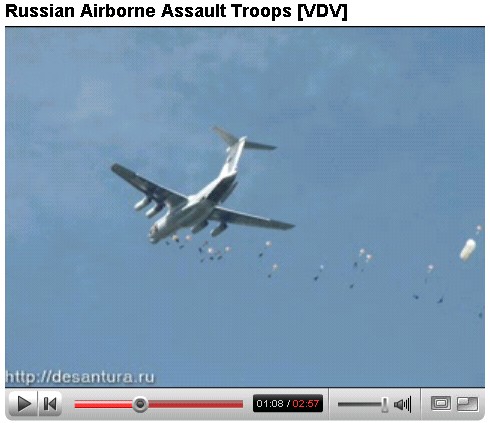
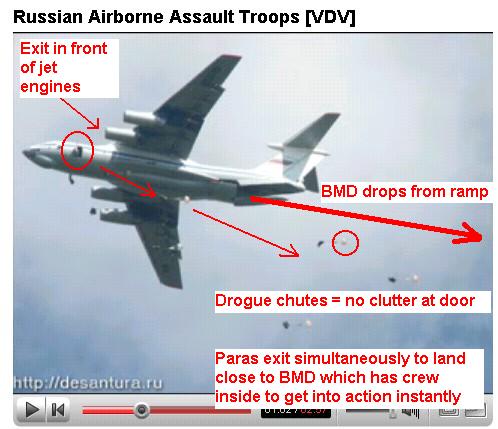
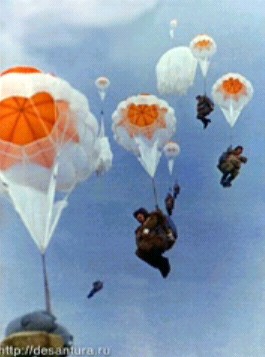
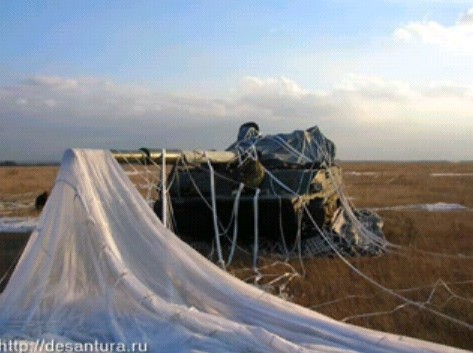
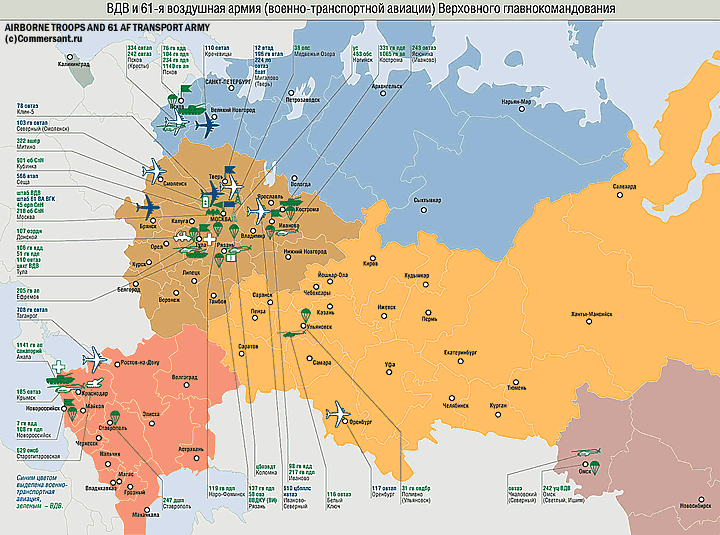
Date:August 11, 2008
Unit: 4th VDV Russian Paratroopers
Operation: ?
Troopers: 1,000
Country: Break-away Abkhazia Republic of Georgia
Drop/Landing zones: South Abkhazia
Aircraft: IL-76 Candid jet transports
Equipment/supplies air-delivered: 150 x BMD-type light tracked armored fighting vehicles, ammunition, food, water, medical supplies
Type Air delivery: Round parachute airdrop followed by STOL airland
www.boston.com/bigpicture/2008/08/war_in_south_ossetia.html
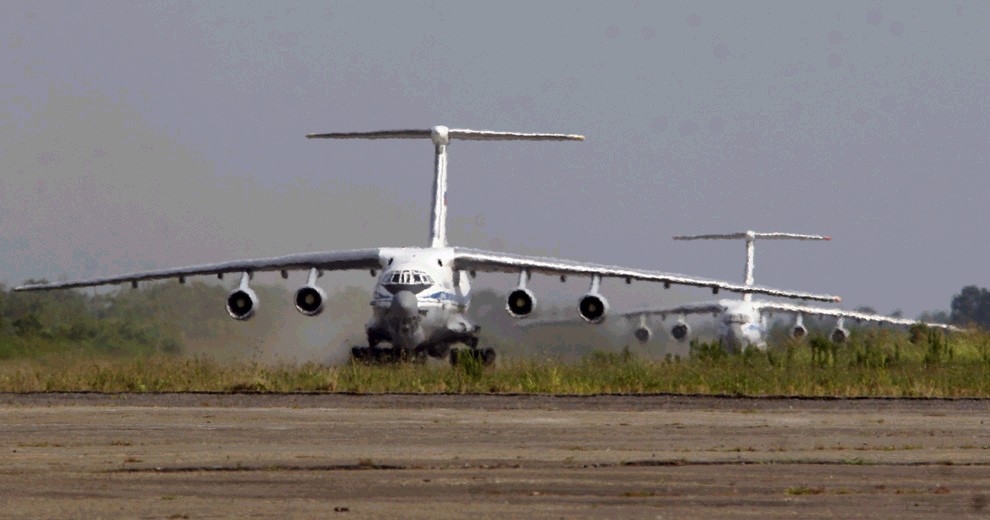
 www.youtube.com/watch?v=aT6XP0pYCAA
www.youtube.com/watch?v=aT6XP0pYCAA
Russian military transport planes land in Sukhumi airport in Sukhumi, Georgia, Sunday, Aug. 10, 2008. More Russian troops arrived in the capital of Georgia's breakaway province of Abkhazia in addition to peacekeepers deployed there for more than a decade, heading toward the border with Georgia. In a potential widening of the conflict in nearby South Ossetia, separatist authorities in Abkhazia have mobilized the army and called up reservists to drive Georgian government forces from a small part of the province still under Georgian control. (AP Photo/Vladimir Popov)
1, 0000 Russian paratroopers and 150 x light armored BMDs were airlifted to Abkhazia on August 11, 2008 to provide support for a counter-attack by Abkhazian self-defense force against Georgian troops in the Kodori gorge during the Georgian war.
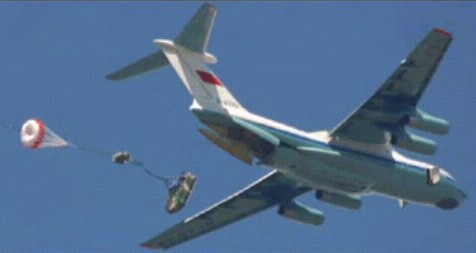
Date: 2009?
Unit: Chinese Communist Paratroopers
Operation: Be-Communist-Butchers
Troopers: 40,000
Country: Taiwan
Drop zones: Taiwanese air bases, landing beaches for CHICOM Army
Aircraft: AN-2 Colt wooden, radar-invisible aircraft, Chinese-copied IL-76 jet transports
Equipment/supplies air-delivered: BMD-type light tracked armored fighting vehicles, ammunition, food, water, medical supplies
Type Air delivery: Round parachute airdrop followed by STOL airland
Asymmetric threat in action. Western conventional military minds cannot comprehend anything but a Western sea-based consumerist logistical invasion. We need all kinds of comforts delivered so we assume the more hardy enemy needs the same.
The Fisher Report: Beware of Red Chinese Air-Mech and Sea-Mech
www.uscc.gov/researchreports/2004/04fisher_report/04_01_01fisherreport.htm
THE IMPACT OF FOREIGN WEAPONS AND TECHNOLOGY ON THE MODERNIZATION OF CHINA'S PEOPLE'S LIBERATION ARMY
A Report for the U.S.-China Economic and Security Review Commission
January 2004
by Richard D. Fisher, Jr.
Center for Security Policy
EDITOR: While we are fumbling instead of adapting and getting stronger from Iraq, Red China is putting together a dangerous Surveillance Strike Maneuver Capability to do nation-state warfare with a sophistication of fire, maneuver and deception we are not even close to matching.
We better get our heads out of our tails and stop our RMA Jesus computer crap and start building for decisive 2D/3D air/ground maneuver using our existing M113 Gavin light tracks, which need to be in our Airborne/Air Assault/Light Infantry units ASAP.
Details: www.geocities.com/strategicmaneuver
FAS REPORT ON BMD-3
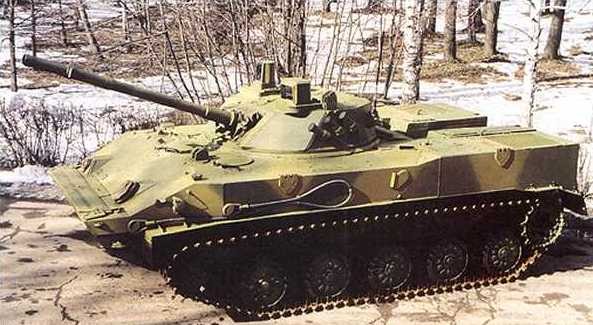
www.fas.org/man/dod-101/sys/land/row/bmd-3.htm
BMD-3 Airborne Infantry Fighting Vehicle
The BMD-3, which rectifies many of the faults of the BMD-1 and BMD-2 AIFVs, is more rugged (and heavier) than previous BMDs and can be airdropped with its crew in the vehicle. The IL-76M can carry 3 BMD-3s ready for airdrop. All BMDs have an adjustable suspension to raise or lower the vehicle's height and cushion it better for airdrop. The BMD-3 features an entirely new chassis fitted with the two-man turret of the BMP-2 infantry fighting vehicle. While retaining the boat-shaped hull of the earlier vehicles, the BMD-3 has improved amphibious capability and a significant increase in firepower. And unlike its predecessors, the BMD-3 can be airdropped with its complement of of seven men inside the vehicle, enhancing the element of surprise associated with airborne operations. Previously the crew of other vehicles would be dropped separately, requring additional time to marry up with their fighting vehicle. The all-welded construction of the BMD-3 provides the crew with protection from small arms fire and shell splinters. The crew consists of commander, gunner, driver, and four infantrymen, with the commander normally dismounting with the squad. Three additional infantrymen may be carried in an emergency in the rear. The two-man power operated turret is armed with a 30-mm 2A42 dual feed cannon and a 7.62-mm PKT machine-gun mounted coaxially to the right. The roof-mounted ATGM launcher can fire either the AT-4 SPIGOT or AT-5 SPANDREL. The bow-mounted AG-17 30-mm automatic grenade launcher and 5.45-mm RPKS machine-gun are operated by the infantrymen seated in the front of the BMD-3. The automatic grenade launcher has 290 ready rounds and 261 in the rack. The ATGM launcher has 3 ready rounds (one on the launcher), and two stowed. The Russian SANOET-1 thermal gunner's sight is available. Thermal sights are available for the ATGM launcher. The Russian Trakt/1PN65 thermal imaging ATGM night sight is optional. Acquisition range is 2,500 m (NFI). For the ATGM launcher in dismount configuration, the Russian Mulat/1PN86 lightweight thermal ATGM night sight has 3,600 m detection range and 2,000 m identification range. French-German Flame-V adapter kit permits the BMD-3 to launch Milan, Milan-2 and Milan-3 ATGMs. Russian KBP offers a drop-in one-man turret, called Kliver, with a stabilized 2A72 30-mm gun, a 4 Kornet ATGM launcher, thermal sights, a coaxial 7.62-mm MG and improved fire control system. The BMD-3 is powered by a rear-mounted 2V-06 water-cooled diesel which provides a high power-to-weight ratio of 34 hp/ton. The hydroneumatic suspension has variable height control. Propelled by two water jets at the rear of the vehicle, the BMD-3 is fully amphibious. A French SNPE explosive reactive armor (ERA) kit and others are available for use on the BMD-3. However, during dismounted troop movement, ERA would be a hazard. Thus, passive armor is more likely and ERA application is doubtful. For amphibious use, additional armor application is unlikely. Other options are spall liners, air conditioning, and a more powerful engine.
Specifications
Alternative Designations N/A
Date of Introduction 1992
Proliferation At least 1 country
Description
Crew 3
Troop Capacity 4 (+3) passengers
Combat Weight (mt) 12.9
Length Overall (m) 6.00
Height Overall (m) 2.25
Width Overall (m) 3.13
Ground Pressure (kg/cm 2 ) 0.32 (wide track) / .48 (standard track)
Automotive Performance
Engine Type 450-hp Diesel
Cruising Range (km) 500
Speed (km/h)
Max Road 70
Max Off-Road 45
Average Cross-Country INA
Max Swim 10
Fording Depth (m) Amphibious
Radio R-173
Protection
Armor, Turret Front (mm) "Antibullet" (7.62mm)
Applique Armor (mm) N/A
Explosive Reactive Armor (mm) Available
Active Protective System N/A
Mine-clearing Equipment KMT-8 plow or -10 roller
Self-Entrenching Blade N/A
NBC Protection System Collective
Smoke Equipment Smoke grenade launchers, 3 x each side of turret Vehicle engine exhaust smoke system (VEESS)
ARMAMENT
Main Armament
Caliber, Type, Name 30mm automatic gun, 2A42 or 100mm gun
Rate of Fire (rd/min) 550 cyclic in bursts/ 200-300 practical
Loader Type Dual-belt feed
Ready/Stowed Rounds 500/ 360
Elevation (°) -5 to +74
Fire-on-Move Yes
Auxiliary Weapons
Caliber, Type, Name 30-mm automatic grenade launcher, AG-17
Mount Type Bow left side
Maximum Aimed Range (m) 1,700
Max Effective Range (m)
Day 1,200
Night N/A
Fire-on-Move Yes
Rate of Fire (rd/min) 60-100 practical in short (< 5 rds) or long (6-10 rd) bursts.
Caliber, Type, Name 7.62-mm (7.62mm x 54mm rimmed) machinegun, PKT
Mount Type Turret coax
Maximum Aimed Range (m) 2,000
Max Effective Range (m)
Day 1,000
Night 1,000
Fire-on-Move Yes
Rate of Fire (rd/min) 250 practical / 650 cyclic, 2-10 round bursts
Caliber, Type, Name 5.45-mm light machinegun, RPK-74
Mount Type Bow right side
Maximum Aimed Range (m) 1,000
Max Effective Range (m)
Day 800
Night INA
Fire-on-Move Yes
Rate of Fire (rd/min) 150 automatic/ 50 semiautomatic
ATGM Launcher
Name 9P135
Launch Method Tube-launched
Guidance SACLOS
Command Link Wire
Launcher Dismountable Yes
FIRE CONTROL
FCS Name INA
Main Gun Stabilization 2-plane
Rangefinder Laser
Infrared Searchlight Yes
Sights w/Magnification
Gunner
Day BPK-2-42
Field of View (°) 8
Acquisition Range (m) INA
Night BPK-2-42 II/IR
Field of View (°) INA
Acquisition Range (m) INA
Commander Fire Main Gun No
MAIN ARMAMENT AMMUNITION
Caliber, Type, Name 30-mm AP-T or 100mm AP-T, APFSDS, ATGM
Maximum Aimed Range (m) 2,500
Max Effective Range (m)
Day 1,500
Night INA
Tactical AA Range 4,000
Armor Penetration (mm) 18 (RHA) at 1,500m
30-mm APDS
Maximum Aimed Range (m) 2,500
Max Effective Range (m)
Day 2,000
Night INA
Tactical AA Range 4,000
Armor Penetration (mm) 25 (RHA) at 1,500m
30-mm APFSDS-T M929
Maximum Aimed Range (m) 2,500
Max Effective Range (m)
Day 2,000+
Night INA
Tactical AA Range 4,000
Armor penetration (mm) 55 (RHA) at 1,000m, 45 at 2,000m
30-mm Frag-HE
Maximum Aimed Range (m) 4,000
Max Effective Range (m)
Day 4,000
Night INA
Tactical AA Range 4,000
Armor Penetration (mm) INA
Other Ammunition Types 30-mm HEI-T
Antitank Guided Missiles
Name AT-5B/Konkurs-M
Warhead Type Tandem shaped charge (HEAT)
Armor Penetration (mm) 925 (RHA)
Range (m) 4,000
Name AT-5/Spandrel
Warhead Type Shaped charge (HEAT)
Armor Penetration (mm) 650 (RHA)
Range (m) 4,000
DISTURBING EXCERPTS FROM THE FISHER REPORT
www.uscc.gov/researchreports/2004/04fisher_report/9armysystems.htm
Russian BMD-3 or BMD-1P Airborne Combat Vehicle
Status: reported sale to Chinas airborne forces around 1995
Weight: BMD-3, 13.2 tons; BMD-1P, 8 tons
Performance: BMD-3, speed, 71 km/h, range, 500 km, can carry up to 5 extra soldiers; BMD-1P, speed, 61 km/h, range 500 km, can carry up to 6 soldiers
Armament: BMD-3: 4x AT-4/AT-5 anti-tank missile, 1x 30 mm gun with up to 500 rounds, 1x 7.62 mm machine gun, 1x 5.45 mm machine gun; BMD-1P, AT-3/ AT-4 anti-tank missile, 1x 73 mm gun with 50 rounds, machine guns; BMD-3M: 1x 100mm gun, w/ 18x unguided and 4x ARKAN missiles w/ 5.5km range; 1x 30mm gun w/ 350 rounds
A 1997 report out of Hong Kong noted that since 1995 the PLA Airborne forces had been equipped with a paratroop combat vehicle...light tank...12 metric tons...uses anti-tank bombs...large-caliber artillery...used to be exclusively owned by Russias paratroops.... [20] While the combat weight mentioned in this article is less than but closer to the BMD-3, the mention of the large-caliber gun also raises the possibility the PLA purchased the older BMD-1P. Both BMD models are amphibious and three can be airdropped from an Il-76 heavy transport. Russians did not like the BMD-1 inasmuch as it tended to break down in rough terrain.[21] The latest version offered by Russia is the BMD-3M, which incorporates a smaller and lighter version of the 100mm gun and missile launcher used on the BMP-3.
While it is not possible from available information to confirm the exact type of BMD employed by the PLA Airborne forces, it logical to speculate that the PLA will be buying more of the most recent BMD-3M version if, as recent reports indicate, the PLA is in the process of forming another Airborne army to build up for possible conflict over Taiwan.[22] In the BMD the PLA Airborne forces received a significant increase in combat capability by providing them with a respectable light-weight infantry fighting vehicle. But even more than that, should the BMD-3M version be acquired then PLA Airborne forces will immediately have a tank gun that can out-range Taiwans tanks and handily penetrate their armor. The ability of the ARKAN missile to shoot down helicopters only further complicates Taiwans defensive response.
www.atimes.com China
The year to fear for Taiwan: 2006
By Wendell Minnick
TAIPEI- If China ever makes the decision to invade Taiwan it is unlikely to be a large-scale Normandy-style amphibious assault. The reality is that China is more likely to use a decapitation strategy. Decapitation strategies short circuit command and control systems, wipe out nationwide nerve centers, and leave the opponent hopelessly lost. As the old saying goes, "Kill the head and the body dies." All China needs to do is seize the center of power, the capital and its leaders.
If China decides to use force to reunify the mainland with what it terms a breakaway province, the window of opportunity is believed to be 2006. This would give China a couple of years to clean up the mess before the 2008 Summer Olympics. Most analysts estimate that China's military strength will surpass Taiwan's defense capabilities by 2005. So 2006 - the Year of the Dog - is clearly the year to fear.
United States Defense Department officials now are reexamining China's military threat to Taiwan. This rethink has caused a dramatic shift in the way many think of defending Taiwan. Traditionally, Taiwan had always feared an amphibious assault - the Normandy scenario - and its defense strategy was always designed to stop such an attack. Now with a potential decapitation strategy believed to be in the works, U.S. defense officials are beginning to think what had once been unthinkable: losing Taiwan in only seven days.
The Taiwan takeover scenario
China's deployment of its special forces and rapid-deployment forces, combined with air power and missile strikes, is the most likely formula for successfully taking Taiwan with the least amount of effort and damage. The military acronym KISS (Keep It Simple, Stupid!) is in full force here. Special forces, which blend strength with deception and flair, offer China laser cutters rather than sledge hammers for defeating Taiwan's armed forces.
An airborne assault directly on Taipei by China's 15th Airborne Corps (Changchun), with three divisions (43rd, 44th, 45th) would be the first phase of the assault, with additional paratroopers being dropped in Linkou, Taoyuan and Ilian, to tie up Taiwan's four divisions assigned to the 6th Army (North). A Chinese airborne division contains 11,000 men with light tanks and self-propelled artillery. Some intelligence reports have indicated that China was able to airlift one airborne division to Tibet in less than 48 hours in 1988. Today, China's ability to transport troops has greatly improved. China is expected to be able to deliver twice that number - 22,000 - in two days.
Taiwan's 6th Army has seven infantry brigades: 106, 116, 118, 152, 153, 176, and 178. The 152/153 Dragons and the the 176/178 Tigers are said to be the best. Also a direct assault on the 6th Army's 269th motorized brigade, 351st armored infantry brigade, and the 542nd armored brigade would be mandatory for Chinese forces.
Most of the initial fighting would be in the Zhong Zheng District, Taipei, which contains the Presidential Building, the Ministry of National Defense, and the Legislative Yuan. As soon as China's troops hit the ground they would have to deal with Taiwan's Military Police Command (MPC). The MPC is responsible for protecting key government buildings and military installations. Its personnel are the gatekeepers, holding all the keys and guarding all the doors. They are considered no-nonsense and are humorless when approached. China's airborne forces would meet immediate resistance from these Taipei forces. Regular army units, all based outside of Taipei, would take hours, perhaps days, to respond. It would be up to the MPC to hold the Chinese back until reinforcements arrived - which might be never.
Assassins, saboteurs would be pre-positioned
Pre-positioned special forces, smuggled into Taiwan months before, would assassinate key leaders, and attack radar and communication facilities around Taiwan a few hours before the main attack. Infiltrators might receive some assistance from sympathetic elements within Taiwan's military and police, who are believed to be at least 75 percent pro-Kuomintang (KMT), and hence, pro-unification. Many could use taxis to move about the city unnoticed. Mainland Chinese prostitutes, already in abundance in Taiwan, could be recruited by Chinese intelligence to serveas femme fatales, supplying critical intelligence on the locations of key government and military leaders at odd hours of the night; death is the ultimate aphrodisiac.
The second phase would begin after airborne forces captured Sungshan Airport. With a secure landing strip, China would fly in elements of its 14 divisions of "rapid reaction" troops using Ilyushin Il-76, Shaanxi Y-8, Antonov 26, and Xian Y-7 troop transports, with air support from China's 1,000 bombers and fighters. China's 10 Il-76 transports can carry 130 troops apiece, though this limitation could be overcome by commandeering aircraft belonging to commercial courier and passenger airlines. China has about 500 Boeings and Airbuses from which to choose. Some of China's heavy-lift transports would bring in BMD-2 Airborne Combat Vehicles and an assortment of armored vehicles. These air-lifted troops would spread throughout the city, securing bridges and key intersections. In addition, China has 200 transport helicopters capable of carrying commandos to Taiwan.
China might encounter opposition from Taiwan's new rapid deployment force. The newly created Aviation and Special Forces Command (ASFC) has united three aviation helicopter brigades, the 601st, 602nd, and 603rd, with the 862nd Special Warfare Brigade under one command. The 862nd is Taiwan's elite paratrooper brigade and modeled after the U.S. Army Rangers. The helicopter brigades are made up of a combination of CH-47SD Chinook transport helicopters, AH-1W SuperCobra attack helicopters, OH-58D Kiowa armed observation helicopters, and UH-1H Huey transport helicopters.
Taiwan also has some noteworthy smaller commando units. There are two marine corps units: the Amphibious Reconnaissance Patrol (ARP) and the Special Services Company (SSC). The army also has two: the 101st Amphibious Reconnaissance Battalion (ARB) or "Army Frogmen", and the Airborne Special Services Company (ASSC). The ASSC is a new unit modeled after the U.S. Delta Force. ASSC recruits from the 862nd and performs counter-terrorism and other special missions. The question of whether these forces could, or would, be moved into the conflict area intime is another matter.
Except for special forces and the marines, it is unlikely that the rest of Taiwan's infantry brigades scattered across the island would do much. As the saying goes, "It's not the size of the dog in the fight, but the size of the fight in the dog that matters." Taiwan's military is rife with lethargic and ineffectual troops just begging for their 20-month tour of duty to end so they can go back to their girlfriends and jobs. Many call Taiwan's youth, including its young soldiers, the "strawberry generation" because they are soft and spoiled by the good life. U.S. military officials visiting Taiwan often complain that the military's boot camps are too lax. The military appears more afraid of angering the parents of the conscripts than confronting a Chinese invasion, say visiting U.S. Soldiers. One politically correct legislator recently complained to Asia Times Online, "Taiwan has to do something about violence in the military." The correspondent reminded him, "The military is a violent institution." The conversation was over; the lesson lost.
Identity crisis within Taiwan's military
Taiwan'smilitary also faces an identity crisis. The idea that Taiwan is part ofChina still resonates strongly within the military. For example, unit patches worn by soldiers often bear the outline of China, not Taiwan. The 6th Army, 8th Army, 46th Division, and Marine Corps have the image of China on their patches. The 117th Infantry Brigade has an eagle landing on mainland China. The 34th Division, 157th Infantry Brigade, and 200th Motorized Brigade display the Great Wall of China. None of the unit patches or emblems bears the image of Taiwan. In fact, visitors to military bases see no evidence whatsoever that they are located in Taiwan. China is the central theme of the whole military experience for Taiwan's conscripts. Even the names of naval vessels have Chinese themes.
Taiwan's navy would have little to do in this war scenario, except sink like rocks. A few would shoot down a small number of the Chinese planes heading to Taiwan, but most would be taken out of action by China's numerous anti-ship missiles. Of particular annoyance is the nasty Russian-made Sunburn anti-ship missile (ASM). Three times as fast as the U.S. Harpoon ASM, the Sunburn does not slam into the side of a ship like the Harpoon; instead, as it nears the target it rises above it and then dives straight down through the deck of the ship. The speed and angle of the attack make it nearly impossible to shoot down or to disable by electronic countermeasures or jamming.
Taiwan's air force would be kept busy trying to repair runway damage caused by the estimated 500 short-range ballistic missiles deployed along China's coast and targeting Taiwan. China's Second Artillery Corps would launch Dong Feng 11 (M-11) and DF-15 (M-9) in multiple-wave and multi-directional saturation attacks on air bases, port facilities and other strategic locations. Only a small number would be intercepted by Taiwan's three Patriot (PAC-2 Plus) anti-missile defense batteries located around Taipei. The PACs will only be able to hit missiles coming down on northern Taiwan. The south is totally unprotected from ballistic missiles. China's special forces, infiltrated to Taiwan, would take a keen interest in locating and destroying the PACs. Everyone knows where they are, so it would not be too difficult.
Even if Taiwan could dispatch some of its fighter aircraft, China would meet them in the air with some of its brand new Sukhoi 30, Su-27 and JH-7 fighters. China took delivery of 154 Russian Su-27 fighters earlier this year. By the end of 2004 China is expected to have 273 advanced Sukhoi fighters. Those fighter pilots able to take off before their bases were destroyed would give the Chinese a hell of a fight, but once their aircraft began to run out of fuel they would have no where to land. Many would simply fight to the bitter end and eject if they cared enough.
In the meantime, China's 100 Xian H-6 (Tu-16) Badger and approximately 500 Harbin H-5 (Il-28) Beagle bombers would clean up those areas not destroyed by the initial missile attack. Of particular concern to the Chinese are two "secret" air bases located within hollowed-out mountains in eastern Taiwan, Chiashan in Hualien and Chihhang in Taitung. These would probably survive the initial missile strike, and require a little more effort from China's air force.
New pro-Beijing government swiftly sworn in
Once Taipei was captured, a new government chosen by Beijing would besworn into office. There would be plenty of Taiwanese politicians to choose from. It is well known there are many pro-China legislators who have investments in China and more than a few who have had private meetings with Beijing officials. The inauguration would be conducted in the spotlight of the international media, giving it some psychological legitimacy in the eyes of the international community. There would be too many pro-China people in the U.S. State Department -privately relieved the Taiwan issue was finally settled - to say anything in Taiwan's defense.
With the new government inaugurated, the new president would declare an end to all hostilities with China. During a nationwide televised speech, the new president would order all military forces to stand down. With the pro-China sentiments running high in the Taiwan military, it is likely that most would grudgingly accept the new president.
The new president would contact the U.S. Department of Defense via the new hotline installed by the U.S. government in 2002 and warn against any U.S. military actions taken on behalf of Taiwan or against Taiwan's new guests, the Chinese military. Using the hotline would demonstrate to the U.S. that the new president and his people have access to the codes necessary to transmit an encrypted message, and also validate that the new president has the authority to access the hotline within Taiwan's Ministry of National Defense - a demonstration of power and control.
U.S. military forces could respond in this scenario if so ordered. The question is, how committed is the U.S. to Taiwan's defense? Given the speed of the Chinese attack, it is unlikely that U.S. aircraft carriers would initially be involved, except for the USS Kitty Hawk. The closest U.S. military support that could act quickly is only 20 minutes away in Okinawa.
Under the 5th Air Force based in Japan, Okinawa's Kadena Air Force Base has two fighter squadrons of F-15 Strike Eagle fighter aircraft (44th FS Vampires and 67th FS Fighting Cocks). In addition, the Misawa Air Base in Japan has two fighter squadrons of F-16 Falcon fighter aircraft (13th FS Panthers and 14th FS Samurais). The 7th Air Force in Korea has three squadrons of F-16s and the 11th Air Force in Alaska has three squadrons of F-15s and one squadron of F-16s.
Call in the U.S. marines?
The U.S. marine Corps is another potential thorn in China's side. Under the marine Aircraft Group 12 in Iwakuni, Japan, the marines have three squadrons of F/A-18 Hornets, one squadron of EA-6B Prowlers, and one squadron of AV-8 Harrier fighter aircraft (Okinawa).
China has every reason to fear U.S. air power. U.S. pilots are far better trained than the Chinese. China has been lax in its training programs, so it would not be surprising to see TV images of Chinese aircraft plummeting to earth in flames. One can understand why China fervently hopes U.S. military forces will be pulling out of South Korea and Japan.
If the U.S. were able to send aircraft carriers to the scene, the U.S. Navy's Pacific Fleet has six aircraft carriers in its arsenal: USS Kitty Hawk, Carl Vinson, Nimitz, Abraham Lincoln, John C. Stennis, and Ronald Reagan. These ships carry F-14 Tomcat, F/A-18, and EA-6B aircraft. The Kitty Hawk is the only permanently forward-deployed aircraft carrier in the U.S. military. Based at Yokosuka, Japan, it recently visited Hong Kong and is often mentioned in media reports regarding potential conflicts involving Taiwan.
The U.S. marine corps has seven amphibious assault ships in the Pacific equipped with a variety of helicopters, fighter aircraft and assault troops. These are basically self-contained invasion forces. There are the USS Tarawa, Belleau Wood, Peleliu, Essex, Boxer, Bon Homme Richard, and Iwo Jima. Basically mini-aircraft carriers with an attitude, the Tarawa, for example, can carry four AH-1 Sea Cobra attack helicopters, six heavy-lift CH-53 Stallion transport helicopters, 20 M-60 tanks, 29 light armored vehicles, 29 AAV-7 amphibious assault vehicles, and 1,900 men of a Reinforced marine battalion.
U.S. aircraft carrier strike group may move to Guam
China may also have to consider the newest arrivals to Andersen Air Force Base in nearby Guam. In February, six B-52s Stratofortresses arrived from the 5th Bomb Wing based at Minot, North Dakota, at the request of the U.S. Pacific Command (PACOM) in Hawaii. PACOM requested a "rotational bomber force" on the island until it's no longer needed.
PACOM argues that the move is in response to North Korea, but others are suggesting that Taiwan is the basis of much of the move. This is a common theme in U.S. military planning in Asia: the overt reason used is North Korea, but the covert one is Taiwan. Guam is now being considered for possible placement of an aircraft-carrier strike group to be moved from Hawaii.
Japan is another element in the equation, and it could intervene. Many argue that if China takes Taiwan, both Japan and South Korea would quickly develop and deploy nuclear weapons - probably in a few months. Losing the Taiwan Strait to China and facing a militarily adventuresome Beijing would send shock waves throughout the region. If Japan chose to intervene, it has nine squadrons of F-15 fighters to throw into the fight. Japan's naval arm could engage Chinese naval forces with close to 50 destroyers, 10 frigates, and 16 submarines.
However, in an escalating conflict involving the U.S., there is a possibility that China would attack U.S. military bases in the region. Slamming DF-21C Terminal Guided Missiles on Okinawa could be a start. Beijing would consider this to be an option only after U.S. forces have engaged Chinese naval vessels and aircraft crossing the Taiwan Strait, according to analysts. China might even get more aggressive by using special forces against U.S. military bases in Japan, Alaska and Hawaii. All these options would give China more time to consolidate forces on Taiwan, and forestall U.S. intervention.
Why is Taiwan worth fighting for?
To anyone who looks at a map of the region, the reasons are obvious. Taiwan's strategic location makes it extremely valuable. The Taiwan Strait is a critical sea lane, and taking Taiwan would allow China to choke off international commercial shipping, especially oil, to Japan and South Korea, should it ever decide to do so. In addition, Taiwan serves as a vital window for U.S. intelligence collection. Taiwan's National Security Bureau and the U.S. National Security Agency jointly run a Signal Intelligence facility on Yangmingshan Mountain just north of Taipei (see Spook Mountain: How U.S. spies on China, March 6, 2003). Taiwan's inclusion into China's military power structure would be unthinkable for Japan.
Of course, this is only a scenario based on selected facts and seasoned with conjecture. Speculation about what China could do and what it will do are rarely comparable. Too many media pundits make mention of a Normandy-style invasion, or an apocalyptic-style missile strike, without seriously considering the fastest way between two points. Of course, China, be warned: "No plan survives the first seconds of combat".
Wendell Minnick is the Jane's Defence Weekly correspondent for Taiwan and the author of Spies and Provocateurs: A Worldwide Encyclopedia of Persons Conducting Espionage and Covert Action (McFarland 1992). He can be contacted at janesroc@yahoo.com.
Send in the Paratroopers!
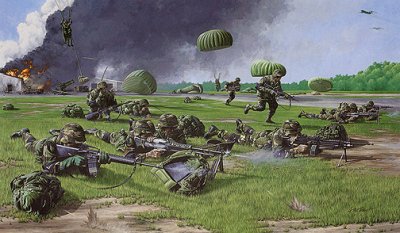
Let they be American, and the day will be won...
NEED MORE INFORMATION?
1st TSG (A) recommends:
Don Lassen, Editor
Static Line
POB 87518
College Park, Ga 30337-0518
Voice: (770) 478-5301
FAX: 961-2838
Airborne Quarterly of the American Airborne Association, Inc.
Mckinstry Mill Road
New Windsor, MD, 21776-7903
Phone (410) 775-7733
Fax: (410) 775-7760
Editor: Col. William E. Weber USA (Ret)
E-mail: weber187@prodigy.com
Private Murphy's View
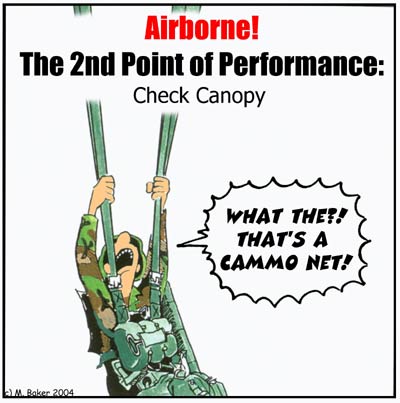
Want Pvt Murphy in your pocket?
FEEDBACK!
"You have a great site here, and it's good to see that someone is keeping up on all the latest airborne operations that the U.S. Army continues to conduct, despite the feeling in some circles that whatever last jump we had was going to be "the last parachute jump in the U.S. Army". (By the way, CSMA (Ret) (Gage? Short, wiry Ranger. I'm going brain dead) said those very words to me one night at CSM Tom Berry's house in Panama, in 1988!) There are, however, a few errors.
First, Grenada. The Ranger regiment did not yet exist, so no LRS from Regimental headquarters could have dropped in. Yes, there was a 75th Infantry CARS Regiment on the books for lineage purposes, but the Ranger Regiment of today did not exist then. In fact, Grenada was the operation that justified raising another Ranger Battalion (the 3rd), and forming the 75th Ranger Regiment. If you have any doubts about that, ask the 'WAD' (Wayne A. Downing). I was one of the staff weenies in 1st SOCOM G-3 then, helping push the idea of a ranger regiment through. Now, the fact that no Ranger Regiment LRS unit, per se, existed, does not mean that recon elements were not dropped in. (I'm assuming that they were, but at the time I believed that the first people on the ground from the Rangers were the Bn CP of the 2nd Ranger Bat.) Your credit lines should therefore read 1st and 2nd Ranger (Airborne) battalions.
Second, the French jumps. You credit the 10th French Airborne Division for Indochina jumps. In fact, the French conducted over 248 combat drops in Indochina, ranging from SOE teams, to platoons, to brigade-sized forces. None of these, however, were from the 10th DAP (or airborne division). In fact, the French did not have an airborne division structure in Indochina, although they certainly had enough battalions to make a division. The best source for this in Jean-Pierre Pissardy's 'Paras d'Indochine', a two volume series, the second of which contains a table outlining the basics of their 248 known combat jumps, along with maps and photos. The absolute highest that the French ever got, tactical formation speaking, in Indochina was the Airborne Battle Groups (GAPs), of which there were three by 1954. There was an overall "airborne staff", but they should be viewed as a "command less opcon" arrangement, providing training, parachutes, etc. Actual tactical airborne operations in Indochina were planned up and down the operational and tactical chain of command. The Legion, Metropolitan, Colonial, and Vietnamese paratroop battalions all operated as components of the Demi-Brigades (early days) and GAPs (latter period). These were located in Hanoi (the most important) and Saigon, with occasional deployments to temporary airborne task forces set up at Danang, and in 1954, Nha Trang (GAP 3, by then the 'Vietnamese GAP'). Unlike other French Army units, the French Para's deployed to Indochina as battalion packages, although two notes are in order. First, the Foreign Legion did not rotate battalions like the Para's did, so their parachute units generally came in by reinforcement packets. There were two BEPs in Indochina, so upon arrival the legion replacement company would further break these down into 1st and 2nd BEP packages. The exception to this was the arrival of (the only remaining Legion para unit from North Africa) the 3rd BEP in the wake of Dien Bien Phu, which was re-flagged the 2nd BEP en-masse.
Not everyone in the 'French' Para's was 'French'. Vietnamese and other Indochinese, served in 'Indochinese Parachute Companies', which got attached to the arriving Metro, Colonial, or Mountain (Chasseur de Pied, only 1 served, the 10th) para units. In 1951-52, there was one 'CIP' or CIPLE (Foreign legion) per parachute battalion, and by 1953-54, there were two. Bigeard's famous 6th Colonial Parachute Battalion arrived with only two combat companies, and picked up two CIPs to fill out their four combat company structure. Within weeks, they performed their famous combat jump at Tu Le. The 'tour' for all non-Indochinese units was 24 months, which added up to 27 when transport in and out were figured in.
The French did have airborne divisions back in France, of which the 10th was one. It was soon shipped to Algeria, where it served throughout the war. There was also a 25th Airborne Division in Algeria. One operated in sector, while the other constituted the General Army Reserve. Legion, Metro, and Colonial para units were distributed among both. In 1955-56 the French parachute battalions became 'regiments' by adding combat support and reconnaissance elements to their 4 combat company structure. There were no '1st battalions' of any umptee-umpth regiment. Each 'regiment', in essence a battalion task force, carried the colors and honors of a single regiment. No mickey-mouse musical flag exercise that makes the 187th Inf the 503rd, while the 509th, reflagged 325th, reflagged 509th becomes the major element of the 173rd Abn Bde, whose Vietnam battalions were from the 503rd.
Sounds like as much as we criticize the French, there's something we could learn. Imagine an 82nd Abn Div with 9 airborne infantry battalions, numbered 501st through 509th, and a 101st Air Assault Division with all the historical glider infantry units, with maybe one or two historical para units in the 511 series to keep their traditions alive. Come to think of it, if we are going to do away with divisions, why not resurrect the WWII airborne divisions as brigades. 11th, 13th, 17th, 82nd, and 101st Airborne or Air Assault Brigades, and throw in the 187th (with the Korean War patch) and 173rd Airborne?
Probably a dumb idea. Probably as stupid as doing away with the crest and 'flash', and resurrecting the old 'glider patch' as a metal beret badge similar to the French sword and dagger.
Ah, come to think of it, another error. The bloody beret story is just that, a story. The Brit airborne colors come from Boy Brownings alma mater, Cambridge: Claret and Blue. The airborne beret was awarded by the King when a unit had demonstrated the requisite airborne standards during combat operations. For a while in 1944, it was even awarded to the SAS, but that regiment never completelyt abandoned its sand colored beret from the Desert War, and photos of the period show SAS units in formation with a mix of both berets. The French component of the SAS Brigade (the 3rd and 4th SAS Regiments, or French 2nd and 3rd Chasseur parachute Regiments), however did very much like the claret colored beret, and adopted it wholesale (Damned wogs, eh wot?). French Metro para's wore blue, while the 'Shock' (choc) para's and commandos wore black. The French SAS, returned from British control, soon formed a parachute battalion for Indochina, and were the first post-war paras into Indochina, where they grew to become the SAS Demibrigade, before being restructured into the Colonial Paracommandos, later the Colonial Parachutusts. This claret color beret became the norm for Colonial paratroops throughout French territories, and in the wake of Dien Bien Phu it was adopted by the French Metro paratroop as well. The Legion (Jawohl, ve like our green, danke) declined to adopt it. Don't know if it is true, but when I was a young trooper (65 timeframe), I heard stories that the 509th had been awarded the red beret by King George in WWII, and had actually worn it for a short time, before being told to remove it. Don't know if that is true or not.
Enough! Again, great site."
A Military Researcher writes in:
"Excellent website I just want to say that. I enjoy your work on airborne warfare. I have studied airborne warfare since I was 14 and am now 21 and I do so like your site.
I research militaries in SE Asia and a good deal of airborne operations have happened there. Indonesia leads the pack and I am surprised you do not mention them as more then a footnote in East Timor in relation to the LAV and M-113. Indonesia took East Timor with a large airborne assault (for the region) during Operation Seroja in 1975. KOSTRAD (Indonesian Strategic Reserve which has 2 Infantry Divisions and 2 Airborne regiments along with armored cavalry units) and KOPASSANDHA (now called KOPASSUS) dropped in waves from AURI (Air Force) C-130s over the capital city of East Timor (Dili) and took on the left wing fighters of the Fretilin in close combat at night. The Fretilin had expected a round offensive to go through the rough territory of East Timor and hope to bog them down but the Indonesians out maneuvered them through a large airborne drop. The mission was a massive risk as the Indonesians only had 2 AC-47s (with 3 M-2HBs) to support the assault and had enough C-130s (9) to move about 2 battalions at once but little support weapons. 4 C-130s carried the KOPASSANDHA commands and 5 carried the KOSTRAD paratroopers of the 501st battalion. One C-130 was damaged from ground fire during the drop and had to return to base with 72 commandos on board. The second and third waves brought in the KOSTRAD 502nd battalion and the Brigade staff of the 18th Airborne Brigade. The fighting was up close and savage and worse at night. The commander of the 501st got lost and the battalion was unable to close to the lines of retreat for the Fretilin.
At the same time Marines landed in BTR-50s and backed by PT-76s drove for the capital. They were landed a distance away to keep their ships safe and used their armor to move fast while Special Forces and local allies lead the way. There were problems as the second wave of the 502nd upon hearing the heavy fighting the first wave of KOPASSANDHA commandos had suffered during the drop began firing at the ground with their AK-47s and throwing grenades. At the same time the Marines had arrived on the drop zone and had to duck for cover and worse some Marines fired into the air knowing the KOSTRAD's 502nd battalion were in the air. None was hurt but many were shaken up. Hell KOPASSANDA forces actually used "captured" horses to provide mobility for a unit which backed by local forces move on the capital.
Air Force commandos of the PASKHAS were used to bring the nation's airfield to service to airland in more troops A platoon leader of the 328th KOSTRAD airborne battalion (of the 17th Airborne Brigade) had been dropped in the water as well. The 328th arrived in from the air to reinforce the units on the ground. The 401st KOSTRAD airborne battalion was airlanded to move on the town of Baucua. Seroja was the bloodiest day since independence for the Indonesian armed forces but allowed a quick take over of the capital. Around 50 airborne troops had died with more wounded but they had quickly taken the capital.
After the operation the 328th battalion had 2 PT-76s and 2 BTR-50s attached to them and seized Baucua. After the capture of Dili they had to go around the nation and defeat Fretilin strongholds. More airborne operations were done during this fighting. What followed by 24 years of war which lead to thousands dying and a vote on independence. Indonesia did not lose in Timor they were forced to leave which led to scars in their military. By the time they left in 1999 10,000 of their troops had died and an estimated 200,000 Timorese were killed.
Even as late as 2003, Indonesia dropped paratroopers on Aceh to fight the GAM guerillas. This operation was done by about 600 paratroopers dropped by C-130s backed with Hawk-209s and OV-10Fs. The ground element of Army troops backed with Scorpion-90 light tanks and Marines backed by PT-90s (upgraded PT-76s with a 90mm gun) mopped up afterwards.
They also used paratroopers during the fighting in 1961 with the Dutch in Irain Jaya. They dropped in para-commandos from C-130s, An-12s and C-47s to raid Dutch targets. Many of these raids failed but in the end America and Russia forced the Dutch to turn over the Island. They used the RPKAD (now called KOPASSUS) and the Air Force commandos the PGT (now called PASKHAS). Also in the late 1950s the RPKAD was used to take rebel airfields held by an American backed movement the PERMESTA. The RPKAD did several combat jumps from C-47s to take airfields and block the retreat. This was the operation which eventually lead to the shoot down of Alan Pope a CIA B-26 pilot by an AURI (air force) F-51D and his capture. The American government more or less paid a ransom for his release. Airborne forces have been used also in Irian Jaya to fight the OPM.
It is hard to find a nation crazier about airborne operations then Indonesia. Unlike many other poor nations their paratroopers actually train for airborne operations and jump from planes in combat. Their Special Forces (KOPASSUS) wear a red beret as they used to be "just" paratroopers and the KOSTRAD units were green berets. Still these are light units with rifles, machine guns and light mortars but are able to hit quick and hard. You shuld get the book "Kopassus inside indonesian Special Forces" for more reading. The book goes into detail about different parachutes and different planes they used to jump from such as the C-47, An-12 and C-130 and how the different chutes acted. It's an excellent read for anyone. It also goes in depth about airborne operations across the nation.
About mortars for combat;
I agree the 81mm has a much bigger punch then the 60mm but the 60mm more then has a role. During the fight for Balibo in 1975 which was a small town in East Timor with a stone fort the KOPASSANDA was ordered to take the fort and were backed by local guerillas. The commandos had AK-47s, 90mm rocket launchers and 60mm mortars. The fort had about 20-35 fighters backed with machine guns, G-3 rifles and an 81mm mortar. The 90mm rockets went fired within 200 meters were unable to punch a whole in the stone walls so the commandos brought up the 60mms, which took out the fort and the 81mm mortar. Of course Fretilin 81mm's did cause losses during the border fight which came before the massive invasion. Fretilin even put some on barrages and tried to attack the coast of Indonesian held West Timor before being stopped by marine PT-76s.
Also the NVA/VS used the Type-63 (M-2 60mm) very well as it was light and they could bring it into service fast and move out before the enemy could fire back. The ARVN also found the M-2 great at the company level during the later phases of the war. From what I have read the Afghans also found it good as one guy could hold the mortar and move it around quicker then heavier systems.
Yes I am familiar with the fact the marine Raiders who used M-2s in WW-2 had massive problems in large set piece battles because it lacked the power of the 81mm though far more mobile by guys on foot.
I more then respect what you do on this site and keep up the good work."
Private Murphy's Epilogue: Beetle Bailey CAN Jump, He Just Can't Get the Girl (he's FUBAR like marines)
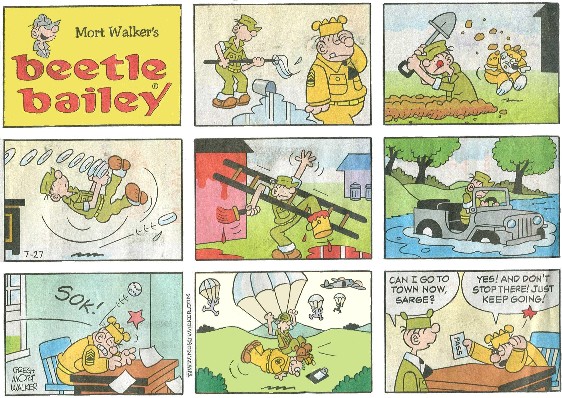
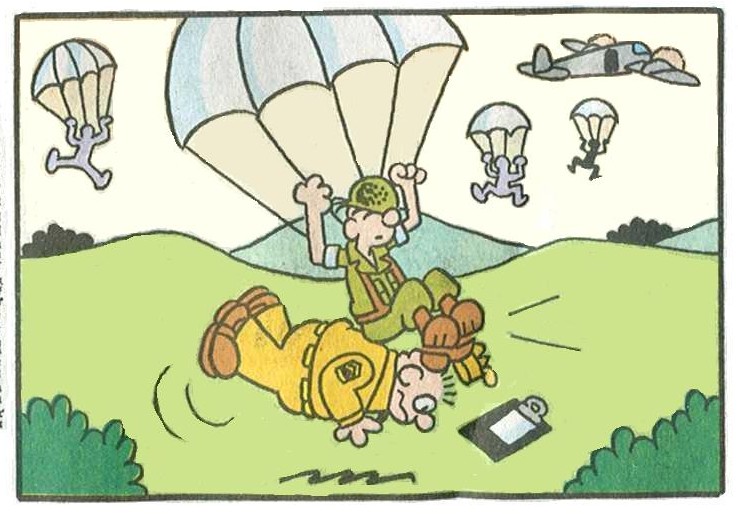
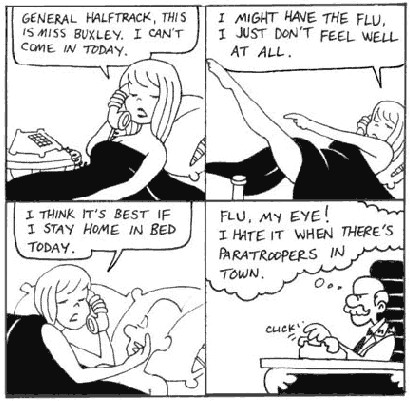
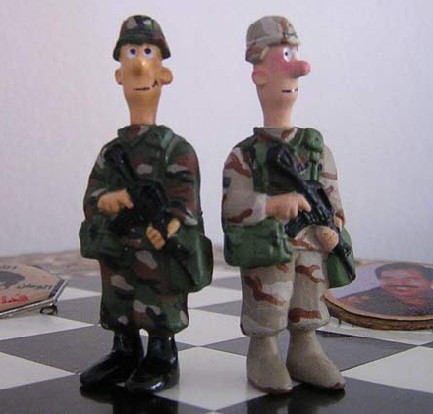 On your desk?
On your desk?
Music from film "A Bridge Too Far" by Market-Garden combat veteran, John Addison; film was advised by General Gavin

 Return to U.S. Army Airborne Equipment Shop
Return to U.S. Army Airborne Equipment Shop
